Que faire à Séville en 4 jours | Nos coups de coeur et bonnes adresses
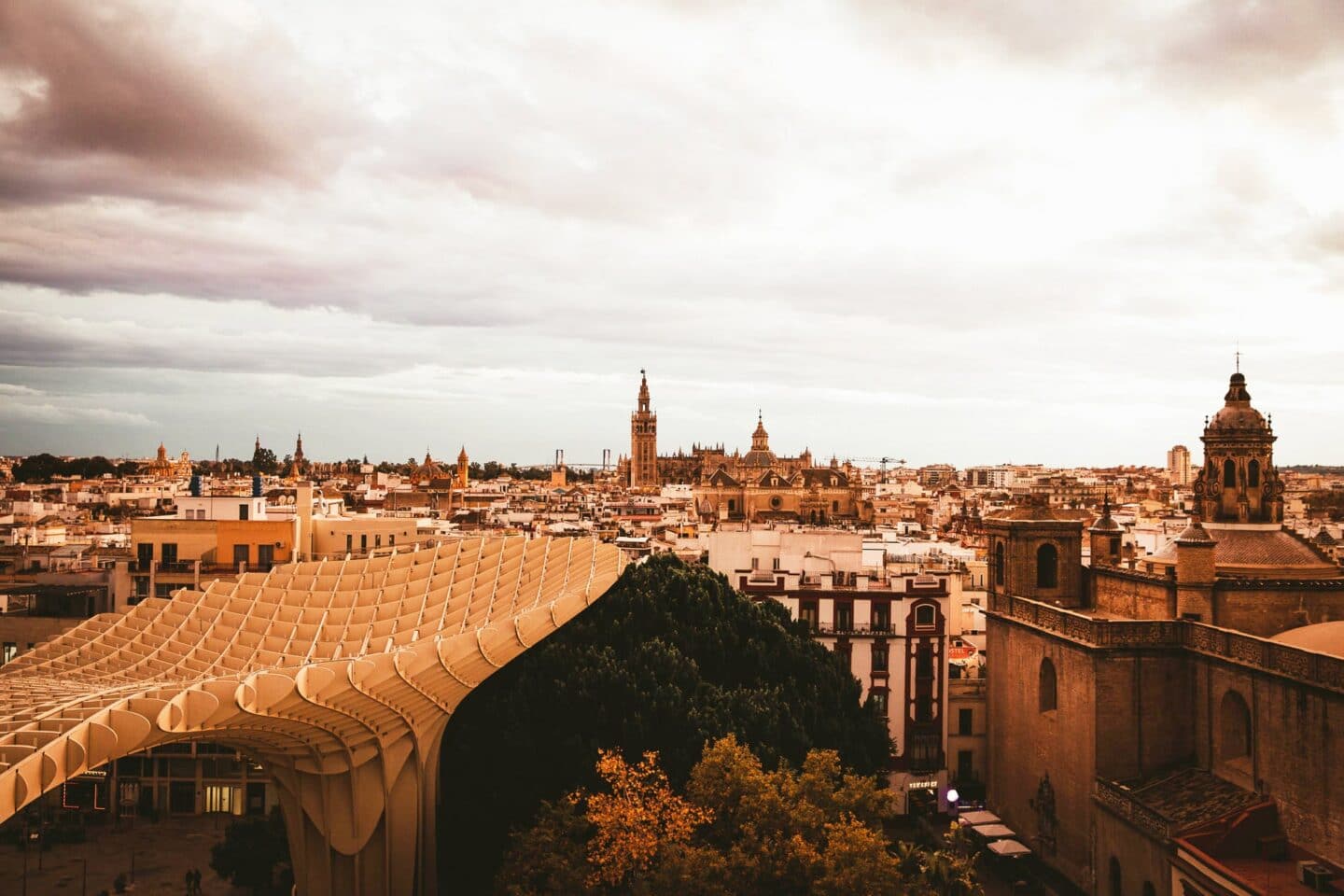
A la découverte de Séville en 4 jours. Je vous propose un itinéraire détaillé pour découvrir cette une ville bourrée de charme dans une véritable ambiance espagnole. Découvrez nos coups de cœur, nos bonnes adresses et mes conseils pour ce premier voyage en famille.
Comme dans toutes villes, ce que nous aimons par dessus tout, c’est flâner dans les quartiers pittoresques mas aussi nous laisser porter en déambulant les rues pour y trouver un magasin d’artisanat, un café ou encore un restaurant. A Séville, nous avons découvert plusieurs quartiers plus ou moins touristiques où vous pourrez sentir la vie à la Sévillanne.
SOMMAIRE DE L'ARTICLE :

QUE FAIRE A SÉVILLE EN 4 JOURS
Il y a une multitudes de lieux à visiter à Séville et si comme nous, vous ne savez pas trop par où commencer, vous pourrez opter par une approche guidée pour vous présenter la ville. Une visite de 3h à travers les rues de Séville : de la Puerta Jerez à La plaza de España en passant par l’Alcazar, la cathédrale et la Giralda, les arènes et les bords du Guadalquivir. Une très bonne option pour avoir les clefs de compréhension de la ville pour ceux qui ne sont pas friands de visites guidées de monuments. Certains guides sont francophones comme Ghislaine, notre jeune et dynamique guide Marocaine qui n’a pas manqué d’ enrichir la visite de multiples anecdotes intéressantes et de bonnes adresses . C’est la première fois que je testais ce genre de visite gratuite et je vous le conseille. Attention, visite gratuite signifie qu’à la fin de cette visite guidée, vous devrez tout de même laisser un pourboire en fonction de votre degré de satisfaction.
➡️ Vérifiez ici les disponibilités de cette visite guidée et réserver à l’avance
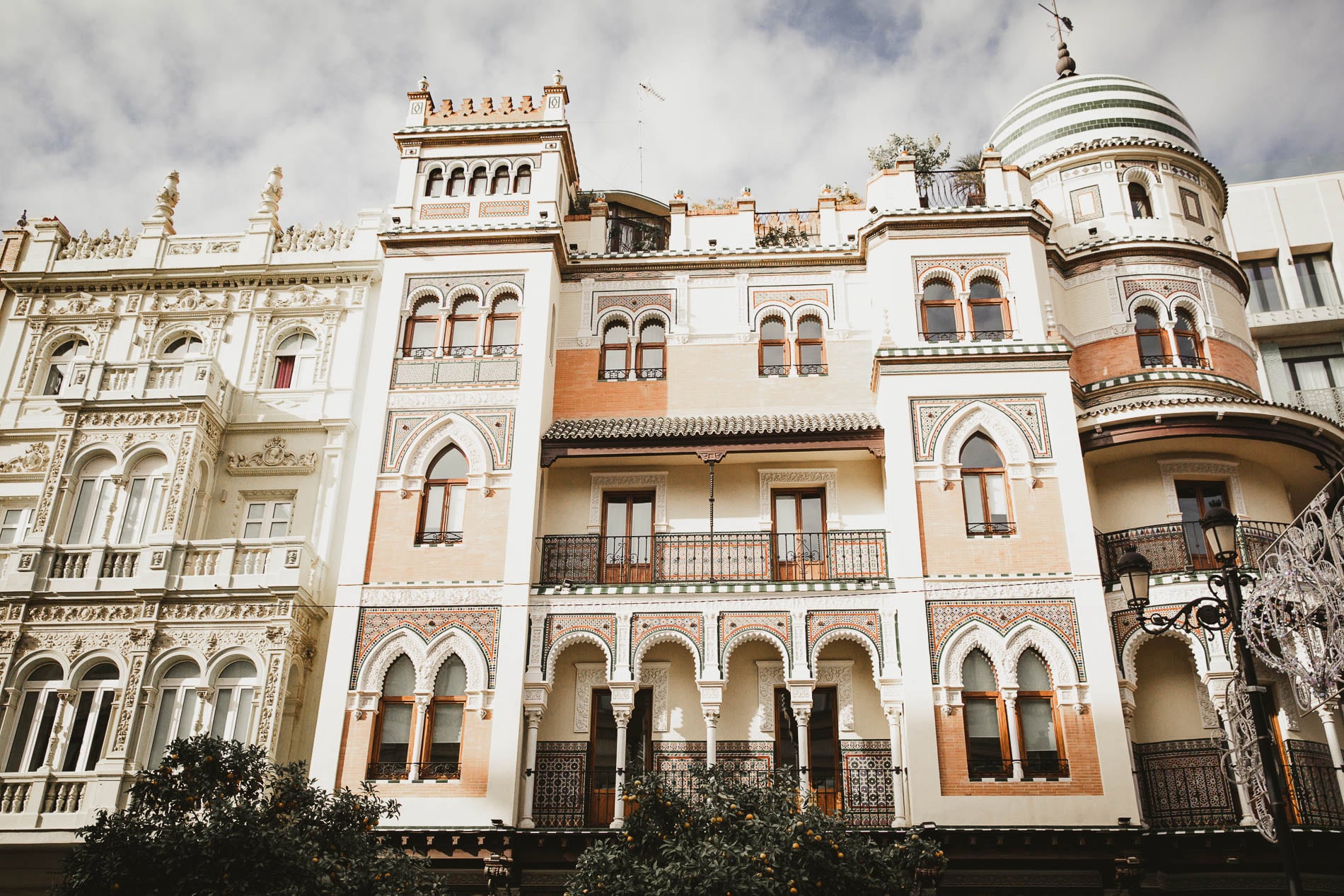
| LE QUARTIER DE SANTA CRUZ
Les monuments les plus emblématiques de Séville se situent dans le quartier de Santa Cruz à savoir la Cathédrale, la Giralda, la Plaza de Cabildo, les Archives des Indes et le Palais de l’Alcazar . Si vous n’avez que peu de temps devant vous et que vous souhaitez découvrir de manière proche, les principales attractions touristiques de Séville, c’est un quartier que je vous recommande pour sa localisation et son charme. En effet, vous serez plus tranquilles en fin de journée, début de soirée et tôt le matin pour photographier les monuments en évitant le flux touristique.
LA CATHÉDRALE ET LA GIRALDA
La cathédrale est remplie de pièces d’orfèvreries, de peintures, de sculptures et vous y trouverez l’atypique mausolée de Christophe Colomb porté par les représentants des 4 royaumes d’Espagne car c’est de Séville que parti Christophe Colomb lorsqu’il découvrit les Amériques.
Pour déjeuner, rendez-vous au restaurant bar « la Catedral », C. Mateos Gago, 5 .
Entrée 10€ / adulte 5€ / étudiant et personnes de plus de 65 ans 5€ / audioguide Horaires 10h45 – 17h du lundi au samedi 14h30-18h le dimanche
Si vous voulez éviter les longues files d’attente, vous pouvez sélectionner des visites seules, guidées ou combinées que je vous propose, pour tout simplement gagner du temps, en apprendre davantage sur l’histoire et ou connaître les anecdotes des monuments de Séville. Pour plus de bons plans, cliquez sur l’une des activités ci-dessous.
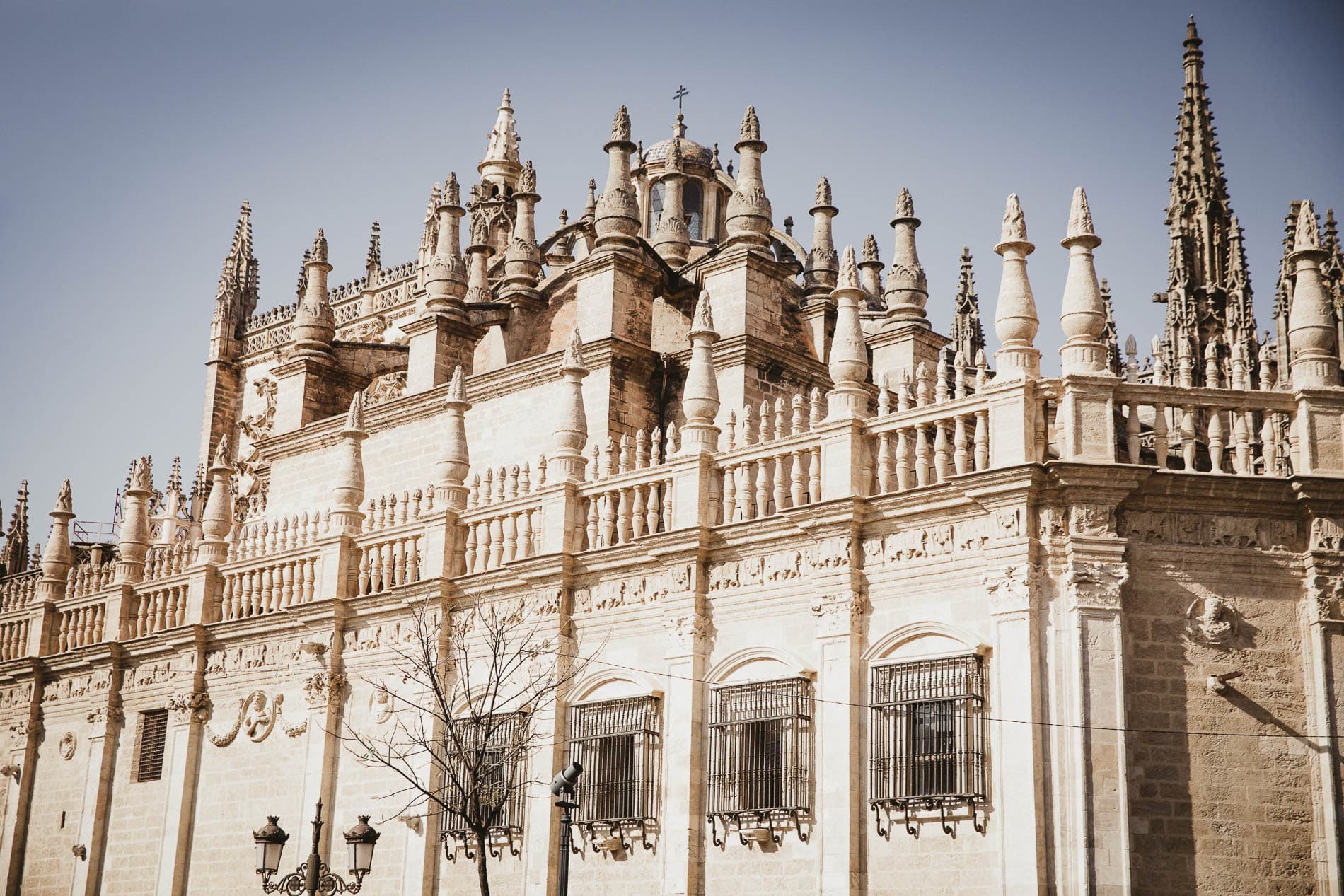
Pour la pause repas, vous pouvez vous arrêter déjeuner à « Casa Morales » Calle Garcia de Vinuesa 11 , un bar à tapas à la décoration originale avec ses cuves d’antan apparentes. Pour prendre un café dans un cadre historique, il faut se rendre à l’intérieur de la « Cerveceria Giralda », Calle Mateos Gago . En effet, en enlevant le placo pendant les travaux, les ouvriers sont tombés sur d’anciens bâtiments arabes et ont décidé de restaurer les murs. Le lieu est donc très beau et mérite un détour.
Le rooftop « Pura Vida Terrazza », Calle Segovias est un endroit parfait pour un apéro en fin de journée car il n’ouvre qu’à partir de 15h.
D’autres adresses m’ont été recommandées comme le « Mama Bistro » C. Mateos Gago , un restaurant qui propose une cuisine andalouse traditionnelle dans un cadre plutôt joli, mais aussi le restaurant « La Cueva » , Calle Rodrigo Caro 18.
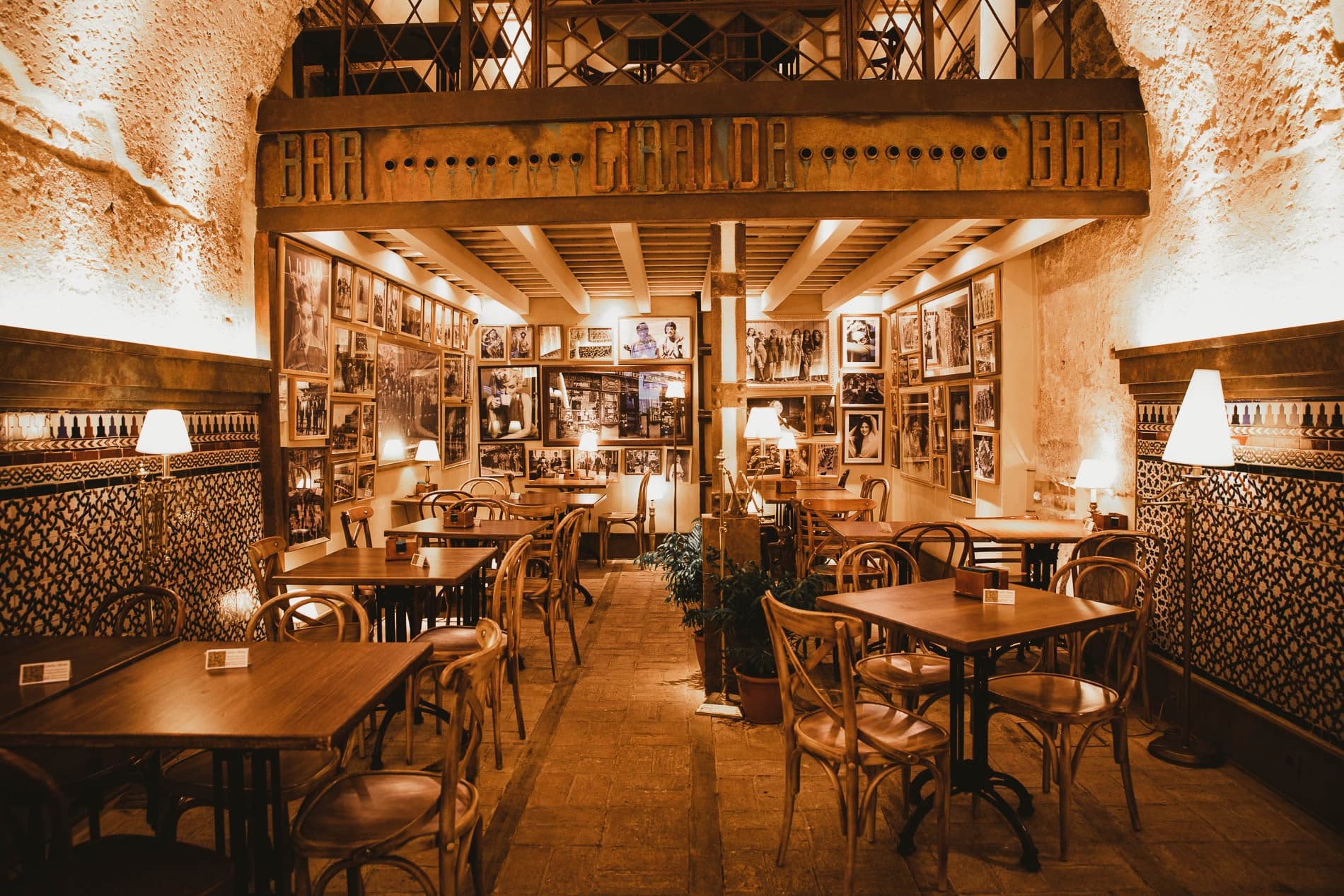
PLAZA DEL CABILDO
Non loin de la Giralda et les Archives des Indes, se trouve cette jolie « Plaza del Calbido » , une petite p lace pittoresque avec une fontaine, bordée de bâtiments aux arcades ornées de peintures artistiques. Vous la traverserez furtivement mais elle est très jolie à voir lorsque le soleil est un peu haut donc à partir de 11h.
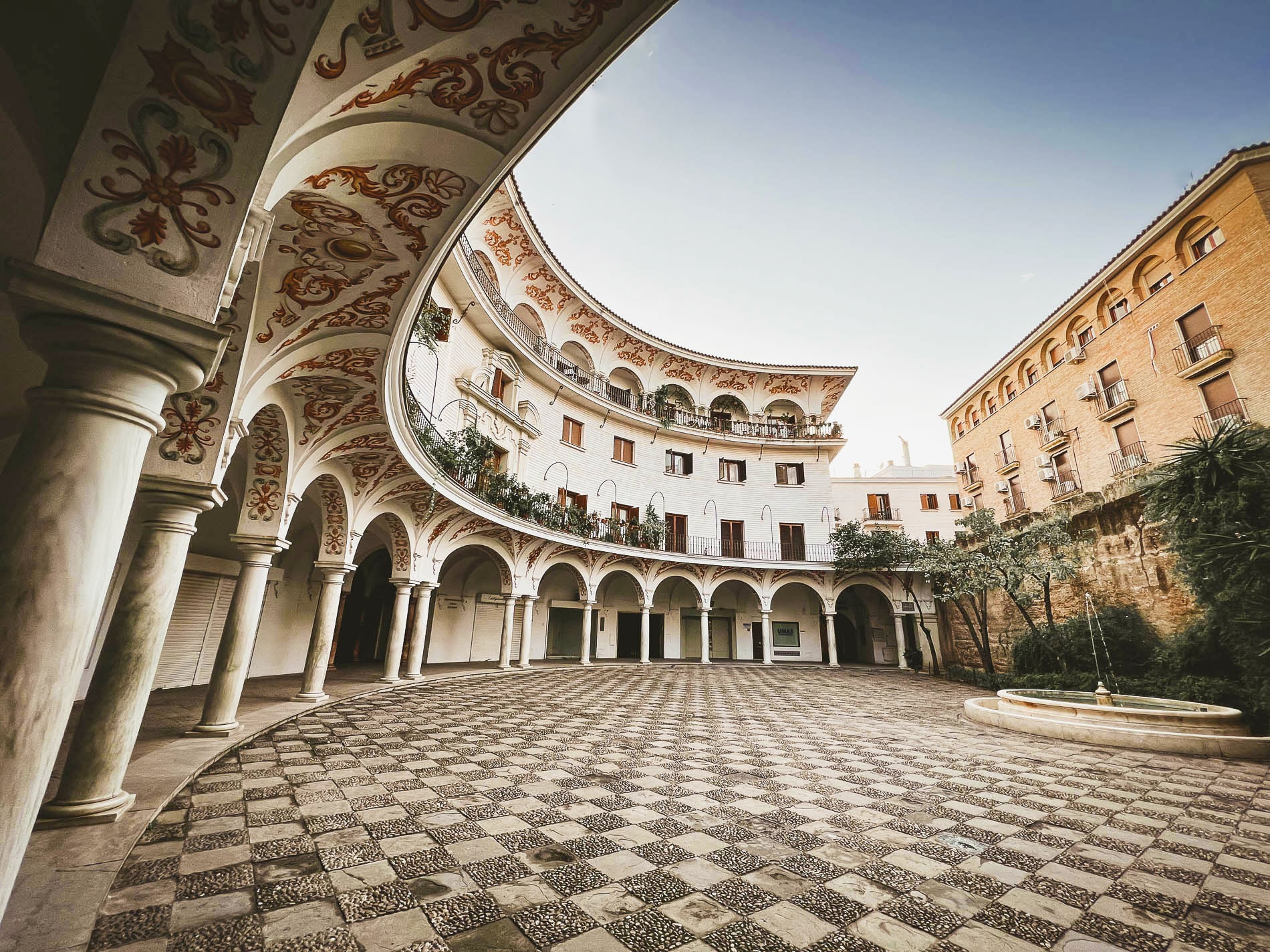
LES ARCHIVES DES INDES
Situé entre l’Alcazar et la cathédrale, c’est l’emblème économique de la ville. C’est ici qu’on été conservé les différents documents relatifs à la conquête des Amériques, des centaines de cartes et des milliers de registres. Si ce n’est pas le plus beau des bâtiments de la ville, il vaut tout de même un coup d’œil rapide d’autant que le visiter ne prend pas beaucoup de temps et que l’entrée est gratuite.
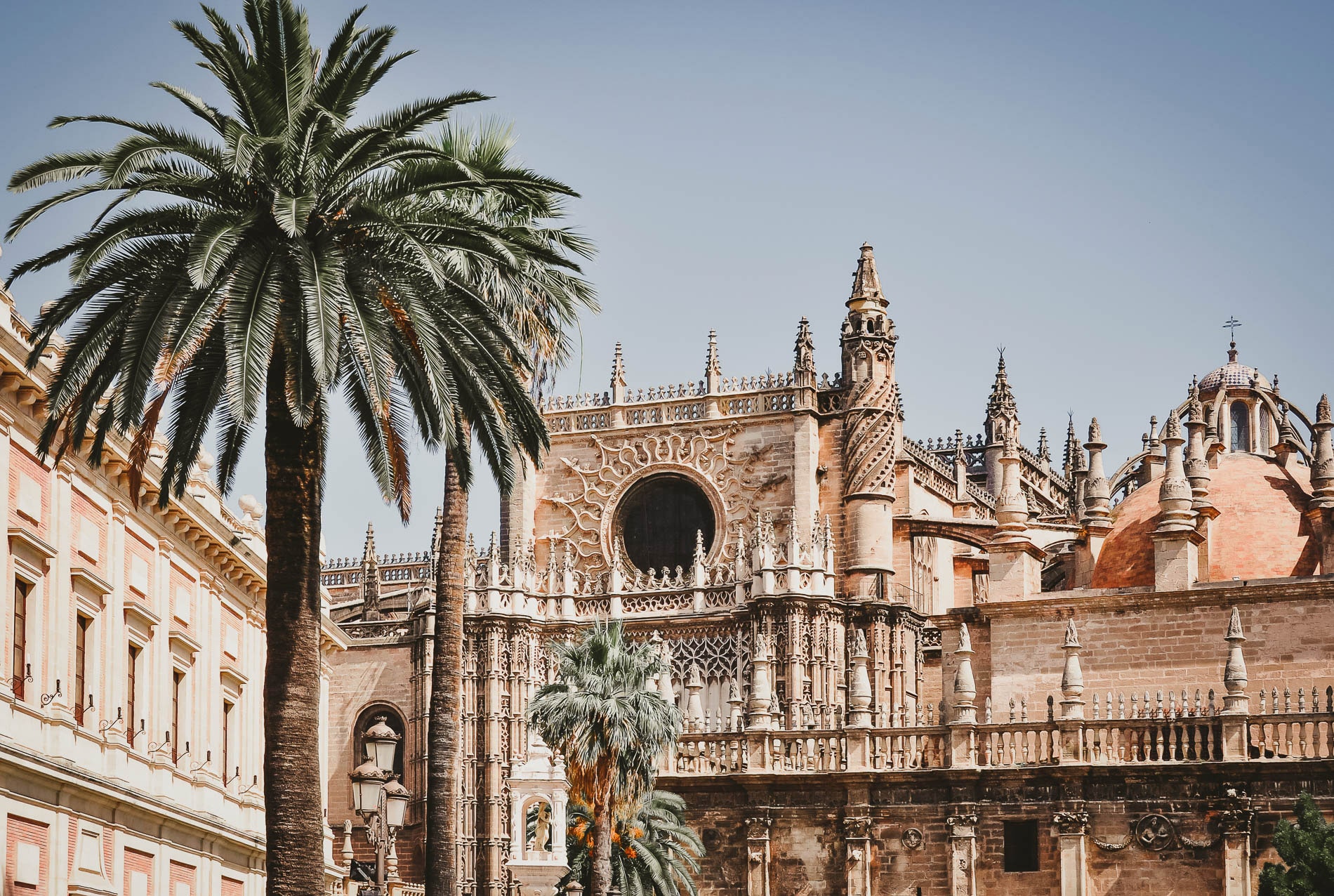
LE PALAIS DE L’ALCAZAR
Emblème politique de la ville, l’Alcazar (traduit par Château ou forteresse en français) appartient à la famille royale d’Espagne qui y réside toujours lorsqu’ils sont en déplacement à Séville. C’est un incontournable lorsque l’on vient à Séville, vous ne pouvez pas passer à côté! Ce bâtiment de 4 hectares ut fortement influencé par l’époque musulmanes des Almohades. Ne manquez pas le patio des demoiselles, la chambres des ambassadeurs, l’art de la mosaïque présent dans beaucoup de pièces et de flâner dans les magnifiques jardins du palais.
Ce lieu est très photogénique, du coup, pour profiter sereinement, éviter la foule et les longues attentes, je vous conseille d’y aller soit à l’ouverture soit en fin de journée . Les lumières de fin de journées sont assez belles pour photographier l’Alcazar, notamment les 4 hectares de jardins, le labyrinthe végétal et le grand patio. Il vous faudra être très patient et prêt pour le photographier sans avoir trop de monde.
En fin de matinée ou de journée, prenez un petit café à « l’hôtel Alfonso », Calle San Fernando 23, l’un des hôtels les plus prestigieux d’Espagne situé non loin du Palais de l’Alcazar.
Selon les périodes de l’année, le Palais de l’Alcazar est pris d’assaut. Le nombre d’entrées est limité à 700 personnes par jour. Il faut donc impérativement réserver ses tickets en ligne pour vous assurer d’y rentrer. Si vous ne faites pas de visite guidée, prévoyez facilement 2h de visite.
Infos pratiques | Palais de l’Alcazar
Entrée 13,5€ / adulte 20,5€/ adultes avec audio guide (l’audio guide n’est pas très ludique) 6€/ étudiants et personnes de plus de 65 ans
Gratuit le lundi mais sur réservation depuis le site de l’Alcazar: d’avril à septembre de 18h à 19h , d’octobre à mars de 16h à 17h
Horaires Octobre à Mars – 9h30 à 17h Avril à Septembre – 9h30 à 19h
Si vous voulez éviter les longues files d’attente, vous pouvez sélectionner directement des visites seules, guidées ou combinées que je vous propose, pour découvrir le Palais de l’Alcazar mais aussi Séville. Pour plus de bons plans, cliquez sur l’une des activités ci-dessous.
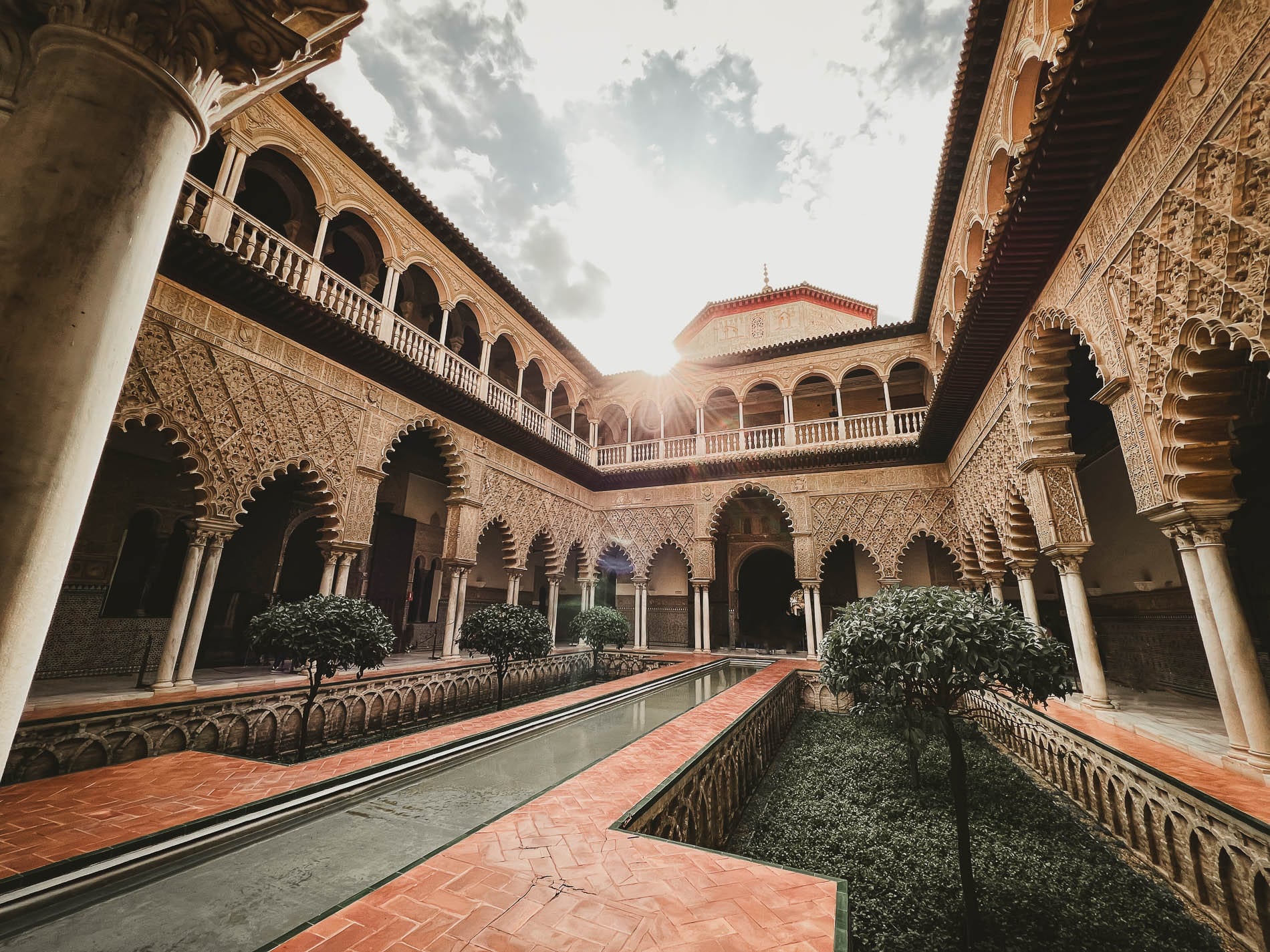
LE QUARTIER JUIF
Le quartier de Santa Cruz est l’ancien quartier juif de la ville. Situé juste derrière l’Alcazar et la cathédrale, c’est un quartier certes touristique aux niveaux de la rue principale, mais un quartier assez calme à l’abri du soleil qui ne manque pas de charme. Perdez-vous dans ses ruelles pavées perpendiculaires et vous tomberez sur de belles petites places ornées de fontaines et bordées par du jasmin et des orangers comme la Plaza Venerables, Plaza Doña Elvira, Plaza de la Allianza et Plaza del Triunfo . Des lieux idéaux au frais, pour prendre un café ou un apéro. Arrêtez-vous également dans les « Jardins de Murillo », gratuits et situés à côté du Paseo de Catalina de Ribera pour y voir et humer les espèces végétales présentes telles que les Magnolias, orangers, ficus et jasmin de nuit.
Parlons justement des orangers de Séville, car c’est une spécificité de la ville qui possède un nombre incalculable d’orangers (40 000 oranges amers) dégageant une odeur extrêmement agréable au printemps lorsqu’ils sont en fleurs. C’est très photogénique en fin d’année lorsque les oranges arrivent à maturité dans les arbres. Vous pourrez déjeuner paisiblement à « l’hosteria Del Laurel » Plaza de los Venerables 5 , une petite taverne servant des plats typiques andalous, des assiettes de charcuteries et de fromages, des poissons ou bien des paellas en ayant la patience d’attendre 1h à 2h pour cela. (c’est certainement le prix de la qualité). Pour une table plus raffiné, vous trouverez le restaurant « Corral del Agua » avec son petit patio verdoyant et une cuisine andalouse plus travaillée.
C’est également ici que j’ai déniché un fabricant de céramique chez Cerámicas Sevilla , C/Gloria 5. J’y ai trouvé des dessous de plats absolument beaux et raffinés. Une jolie idée de cadeau à ramener à vos proches. Vous avez également non loin, le magasin Cerámica Nazaret , C/Feria N°15.
Enfin, vous pourrez découvrir ici l’une des rues les plus singulières de Séville à savoir, la « ruelle de l’eau » (Callejón del Agua) longue de 140 mètres qui commence sur la place d’Alfaro et débouche sur la rue Vida. Autrefois appelée « mur de l’eau » (Muro el Agua), car il s’agissait d’un chemin de ronde, c’est-à-dire, d’une rue qui passe collée à la muraille de la ville.
Enfin, il y a un endroit que j’aurai aimé testé mais avec Gabriel notre bébé de 5 mois, mais il fallait impérativement réserver et cela nous semblait très compliqué car les enfants ne sont pas autorisés. Si vous souhaitez un endroit pour vous détendre dans un endroit sublime et enchanteur, rendez-vous dans les anciens bains de la ville « Aire Ancien Baths de Sevilla ». Le nombre de personnes est limité à 10 personnes dans l es thermes à chaque horaire ce qui fait que vous pouvez profiter tranquillement des divers bains répartis sur plusieurs étages et du hammam . Le lieu possède également un rooftop pour prendre un verre au bord de la piscine à débordement avec vue sur les toits de la cathédrale de Séville. Cet endroit est très convoité donc il faut impérativement réserver un créneau à l’avance !
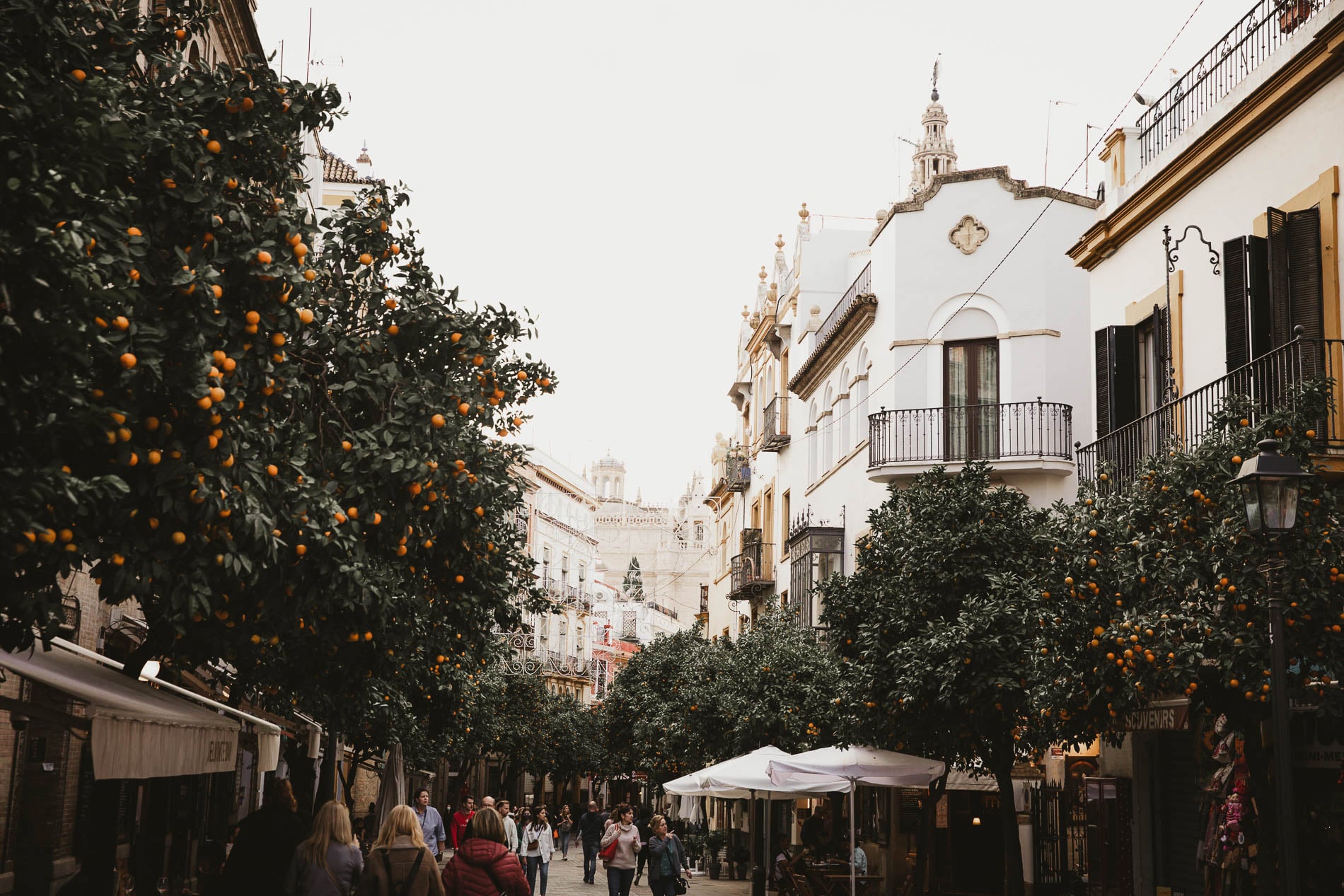
| LE QUARTIER DE FERIA ET ALAMEDA DE HERCULES
Le quartier de Feria se situe plus au nord de la vieille ville. C’est un quartier qui nous a semblé être en plein changement, comme le nouveau quartier tendance de la ville mais c’est surtout un quartier fréquenté par les Sévillans. Vous y trouverez des bodegas à quasi tous les coins de rue, des friperies, des magasins de céramiques mais aussi un super marché « el Mercado de Abastos » ainsi que le Palacio de Las Dueñas .
Le quartier d’Alameda de Hércules est devenu le paradis de l’alternatif à Séville qui attire une foule de jeunes branchés et bohèmes mais aussi d’artistes. Les bars et restaurants design cohabitent avec les petits troquets et les bars à tapas de quartier. Vous pourrez y faire vos emplettes pour rapporter des spécialités andalouses ou bien y déjeuner.
La longue place « Alameda de Hercules » vaut le détour avec ses nombreux cafés et restaurants ainsi que le marché animé de Feria et la Basilique de La Macarena, un temple catholique situé au numéro 1 de la rue Bécque r, dans le quartier de La Macarena plus au nord. Dans le quartier de San Lorenzo non loin, nous avons adoré la petite et charmante Plaza de San Lorenzo plein de vie et à côté des rues Spinola, Martinez Montanez et Eslava. C’est également dans ce quartier que nous avons posé nos valises dans un appartement hôtel très sympa , le Feria Pool & Luxury . Des chambres spacieuses avec une super literie, équipées d’une cuisine (très pratique quand on voyage avec des enfants). L’hôtel possède également un roof top très agréable avec une petite piscine permettant d’accéder à un peu de fraîcheur en saison chaude. L’emplacement est idéal car il est dans un quartier vivant à proximité des points d’intérêts du centre historique. Vous serez néanmoins toujours obligés de marcher car les ruelles pavés étroites de la vieille ville ne permettent pas d’être desservies par le réseau de transport en commun. En moyenne, nous marchions 10km par jour et sans problème avec notre poussette yoyo.
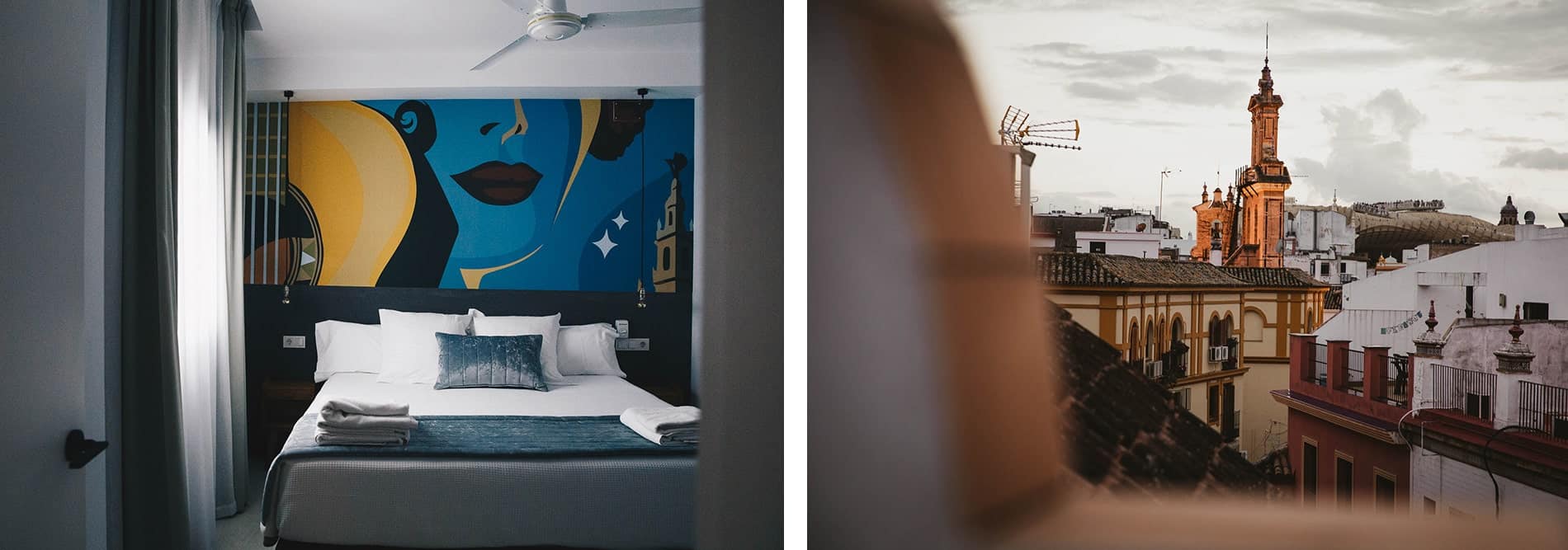
Côté restaurant, vous pourrez également vous arrêter au bar à tapas « Duo Tapas » au 10 Calle Calatrava qui propose des tapas revisités dans un cadre moderne. Il y a également le restaurant « Eslava » et « le Lumbreras » qui propose lui une cuisine fusion Japonaise/Andalouse. Pour un petit goûter, ne manquer pas d’aller au café « Mo Ma » avec une belle sélection de pâtisseries maison absolument délicieuses et une belle carte de cafés.
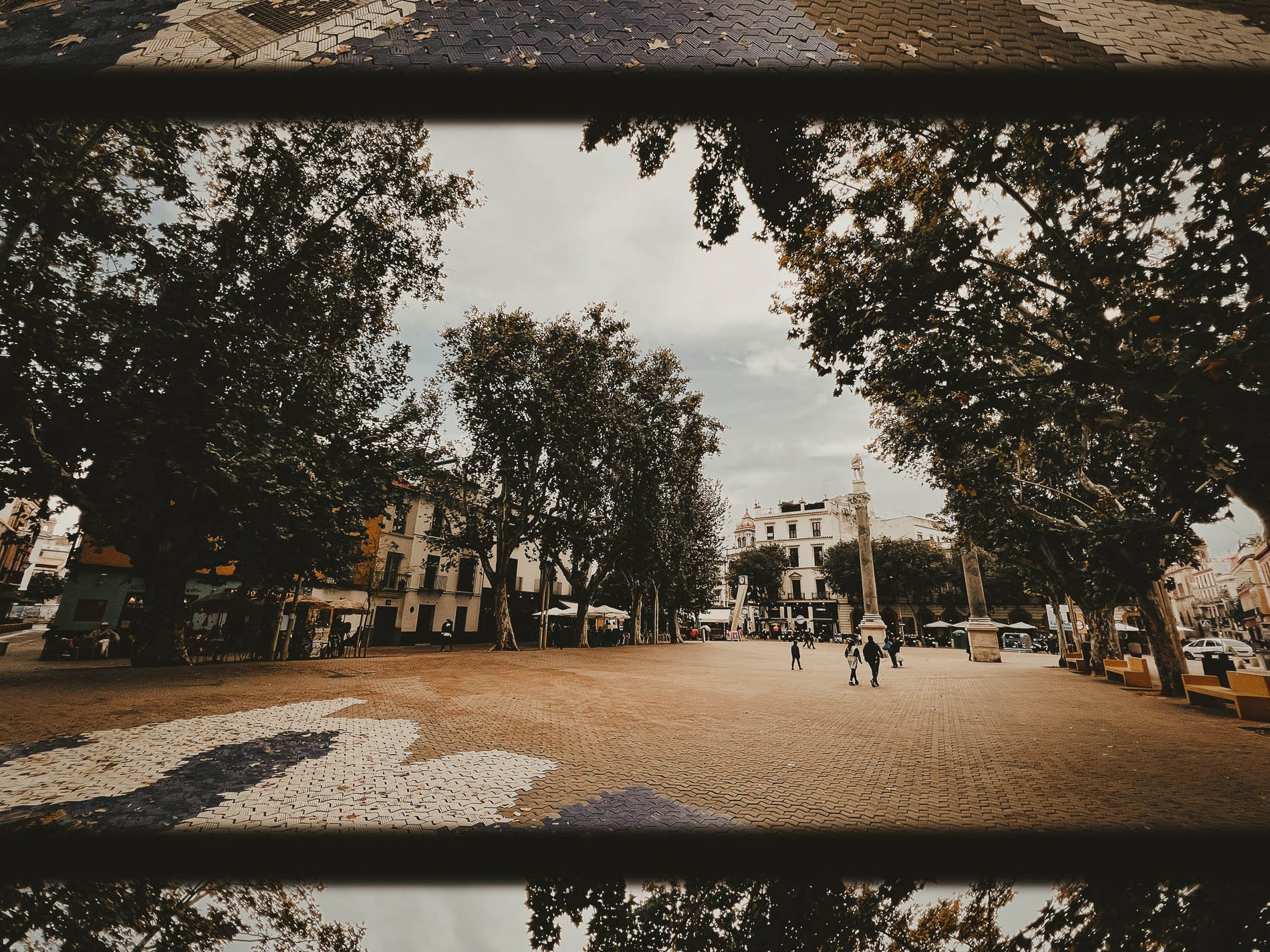
PALACIO DE LAS DUEÑAS
Ce palais est ouvert au public depuis seulement 2016. C’est un très bel exemple de l’architecture Sevillanne qui appartient encore au duc d’Albe qui l’occupe à l’étage. Vous y découvrirez un palais à l’architecture influencé par la période renaissance avec une collection de mobilier classé bien d’intérêt culturel. Un superbe jardin orné de plantes importées en partie des Amériques et des écuries d’époques tout à fait étonnantes. Une visite enchantante dans un décor qui vous fera penser à l’Espagne de Zorro. Un immanquable selon nous. Non loin du Palacio de las Dueñas, se trouve « la jolie Plaza de los Terceros », où vous trouverez un large choix de bars et restaurants traditionnels, où se rendent les locaux.
➡️ Vérifiez ici les disponibilités du Palacio de las Dueñas et réserver à l’avance
Infos pratiques | Palacio de las Dueñas
Entrée 10€ / adulte 6€ / étudiant Horaires Tous les jours de 10h à 18h
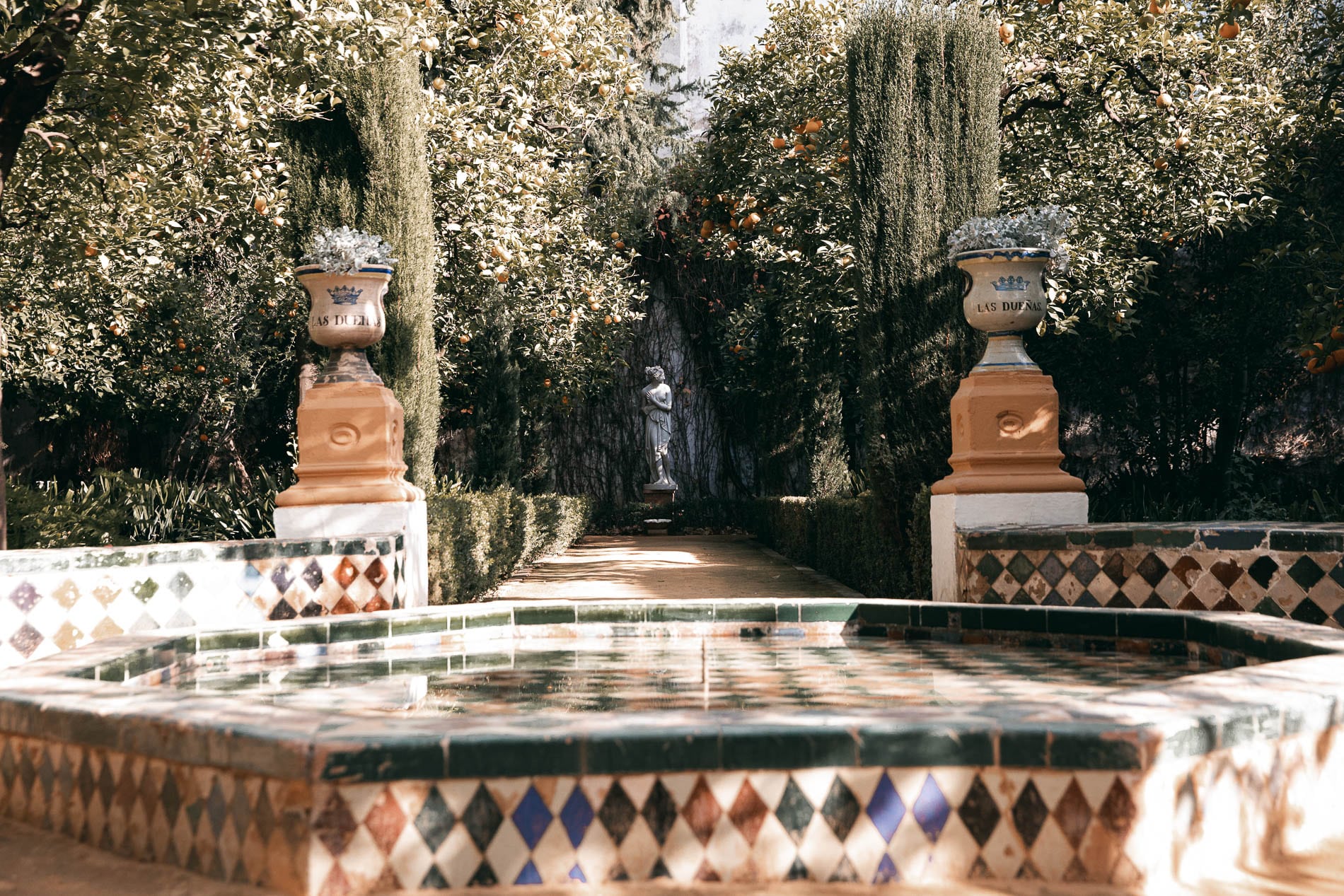
| QUARTIER SUR AU SUD DE LA VIEILLE VILLE
La plaza de españa.
Crée à l’occasion de l’exposition ibéro-américaine de 1929, ce bâtiment imposant et cette place en demi-cercle est absolument majestueux et le plus connu de Séville. Le choix d’organiser cet événement à Séville et non à Madrid est certainement du au fait que Séville était le point de départ des expéditions parties pour l’Amérique et surtout la porte d’entrée des marchandises venues des colonies. Ce site de 170 mètres de diamètre, est bordé de bancs en céramique peinte représentant l’Espagne avec ses 4 royaumes et ses différentes provinces accueillant ses anciennes colonies. On y retrouve les codes de l’architecture andalouse avec notamment la céramique qui est beaucoup utilisé. La place commence à se remplir à partir de 10h le matin par des voyageurs étrangers venus des 4 coins du monde mais les plus belles lumières sont surtout en fin de journée, principalement si vous venez en été. Un choix sera donc à faire entre la fréquentation et la lumière pour vos photos. Autour de cette place se trouve un canal décoré en faïence, et de 515 mètres de long, que l’on peut parcourir en barque, c’est assez touristique et n’a pas vraiment d’intérêt majeur à mon sens.
En vous rendant à la Plaza de España en matinée, vous pouvez avoir de la chance de tomber sur des spectacles de rue de Flamenco sous les arcades. Le lieu s’y prête vraiment bien alors prenez le temps d’écouter ces groupes locaux passionnés et habités par la musique !
Prenez le temps également de vous promenez dans le très beau jardin botanique, le « Parc Maria Luisa » faisant face à la P laza de España et abritant une grande diversité d’espèces d’arbres notamment puis terminez par la « Manufacture royale des tabacs » devant l’Université.
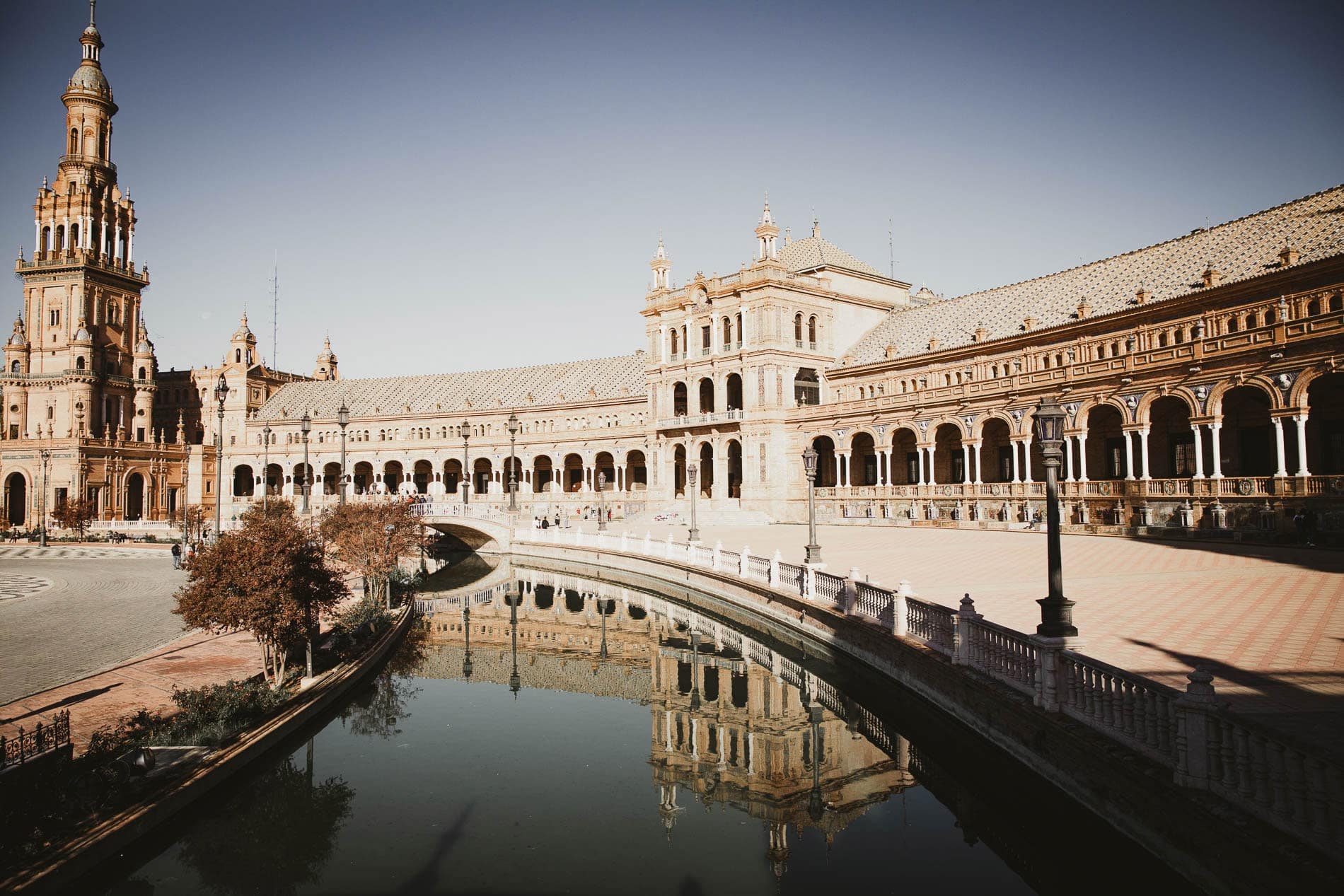
| LE QUARTIER D’ALFAFA
C’est le dernier quartier de la ville dont nous vous parlerons. Un quartier très commerçant où se situe las « Setas de Sevilla ». Vous pourrez manger quelques tapas assez appréciés chez « Agustin & Company Bar » calle Alvarez Quintero à moins de 10 minutes à pied de Las Setas mais aussi le restaurant « Los Coloniales », calle Pl. Cristo de Burgos, 19 ,
Las Setas ou le Metropol parasol
Las Setas, qui signifie « champignon » en espagnol, est le bâtiment qui ancre Séville dans la modernité et l’avenir. Un bâtiment qui se veut être un lègue aux générations futures car construit essentiellement en bois. C’est un lieu de vie avec son marché au rez de chaussée, des restaurants tout autour, et sa dalle au 1er niveau qui est l’antre des riders Sévillans. Las Setas est un lieu très controversé auprès des Sévillans car l’architecture moderne est complètement en décalage avec le centre historique. On l’aime ou on le déteste !
L’intérêt majeur de ce lieu est de monter sur son toit, le mirador, pour y observer la vague qu’il projette sur la ville. Nous vous conseillons d’ailleurs de le visiter de nuit car le bâtiment se mue alors de toutes les couleurs par un spectacle de son et lumière donnant vie au bâtiment et offrant de magnifiques vues sur la ville. Il y avait autrefois un bar au niveau du mirador mais avec le COVID, en novembre 2021, il a disparu !
Sachez qu’en venant entre 17h30 et 18h30, le tarif est moins élevé. C ela vous permet d’attendre la tombée de la nuit en profitant du coucher du soleil sur les toits de Séville tout en attendant la féerie des éclairages de nuit. Bien évidemment, cela est uniquement possible en hiver car à Séville, la nuit tombe plutôt vers 18h alors qu’en plein été il faudra attendre environ 22h.
Pour les amateurs d’art, je vous propose une visite mêlant Art et Traditions pour découvrir las Setas mais aussi le développement artistique de la ville de mudéjar à nos jours, couvrant les styles Renaissance, baroque et régionaliste et contemporain
➡️ Vérifiez ici les disponibilités de la visite et réserver à l’avance
Infos pratiques | Las Setas
Entrée au mirador 10€/personne en journée à partir de 9h30 et 15€/p pour l’immersion nocturne à partir de 18h
Bon plan: Si vous venez un peu avant 18h soit vers pour 17h30, vous paierez le tarif de 10€/p et vous aurez le coucher du soleil ainsi que l’expérience nocturne son et lumière ! Horaires Tous les jours de 9h30 à minuit
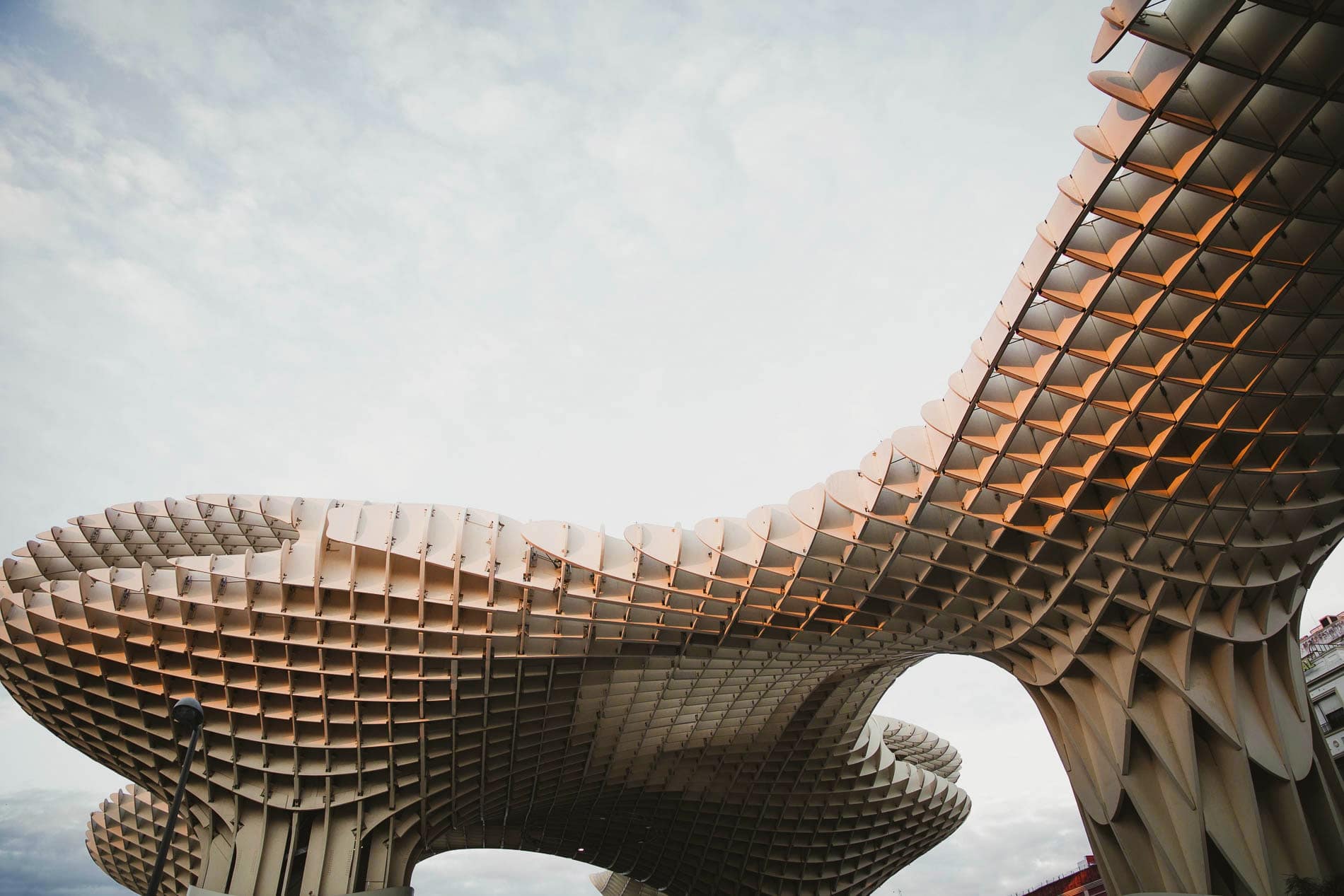
Le Flamenco
C’est également dans le quartier d’Alfalfa, que vous trouverez le musée du Flamenco ainsi que la petite et intime salle « Tablao flamenco la Cantaora, Calle Albareda 22 » où nous avons pu voir un véritable spectacle de Flamenco authentique. Le show dure 1h et se compose d’un guitariste, d’une chanteuse, d’un danseur et d’une danseuse. Voir la passion dans les regards, l’intensité dans la danse est une expérience absolument époustouflante. On sent la culture andalouse qui transpire dans les veines de ses artistes. Tout simplement magnifique ! Je vous conseille d’être au premier rang pour sentir les vibrations de ce spectacle. On y a emmené notre Gabriel alors âgé de 5 mois. Je vous recommande de prendre avec vous un petit casque pour étouffer le bruit et protéger ses petites oreilles.
Infos pratiques | Tablao flamenco la Cantaora 20€/personne comprenant une boisson, placement libre Horaires Une représentation à 19h et une autre à 21h
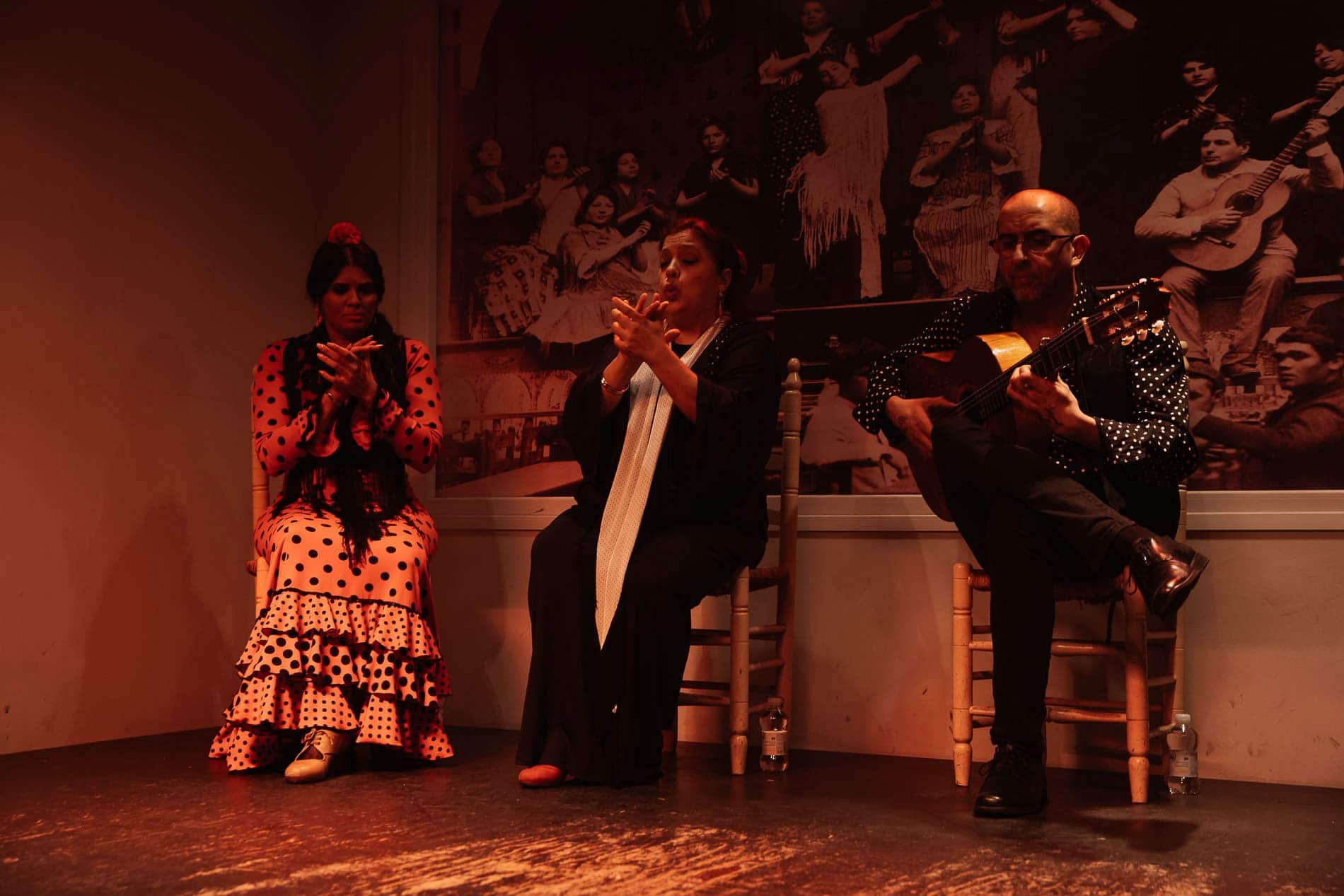
Si vous voulez éviter les longues files d’attente, vous pouvez sélectionner directement des visites seules, guidées ou combinées que je vous propose, pour assister à un spectacle de flamenco ou vous essayer à un cours de Flamenco. Pour plus de bons plans, cliquez sur l’une des activités ci-dessous.
Nous avons repéré par ici quelques adresses sympas dans le quartier d’Alfafa . Vous pouvez débuter la journée en vous rendant à la « Confiteria La Campana » au C. Sierpes, 1, 3, 41004 , pour manger un Tocino de cielo , un dessert typique andalou à base de sucre et d’œuf qui ressemble à un flanc sans lait. Je l’ai goûté mais pour moi c’est trop sucré donc un peu écœurant ! L’endroit reste très authentique avec une belle sélection de pâtisseries. Attention, ils n’en ont pas tous les jours et il faut vous y rendre assez tôt le matin car cette spécialité est très apprécié ! Continuez votre chemin par un petit café au comptoir du « bar El comercio » très fréquenté par les locaux, calle Lineros 7 . On adoré son ambiance d’antan et café comptoir.
Nous vous conseillons également d’aller dîner au restaurant « El Pinton » Calle Alvarez Quitero 42 , qui sert des tapas retravaillés comme la salade d’épinard avec sa boule de glace à la moutarde ou bien l’œuf en tempura , un vrai régal! Si vous en avez marre des tapas (et oui, c’est bon, mais au bout d’un moment on peut en avoir marre ☺️), vous pourrez goûter le restaurant gastronomique « Casa Robles ».
Si vous avez le temps, voici quelques bodegas qui m’ont été recommandées: la Bodega de la Alfafa , calle Alfafa 4, et la Bodega La Aurora , Calle Pérez Galdos 9 dont la spécialité est le Chorizo al infierno. Nous avons également testé Empanadas Malvón , C. San Jacinto, 5, les empanadas étaient délicieux et faciles à emporter.
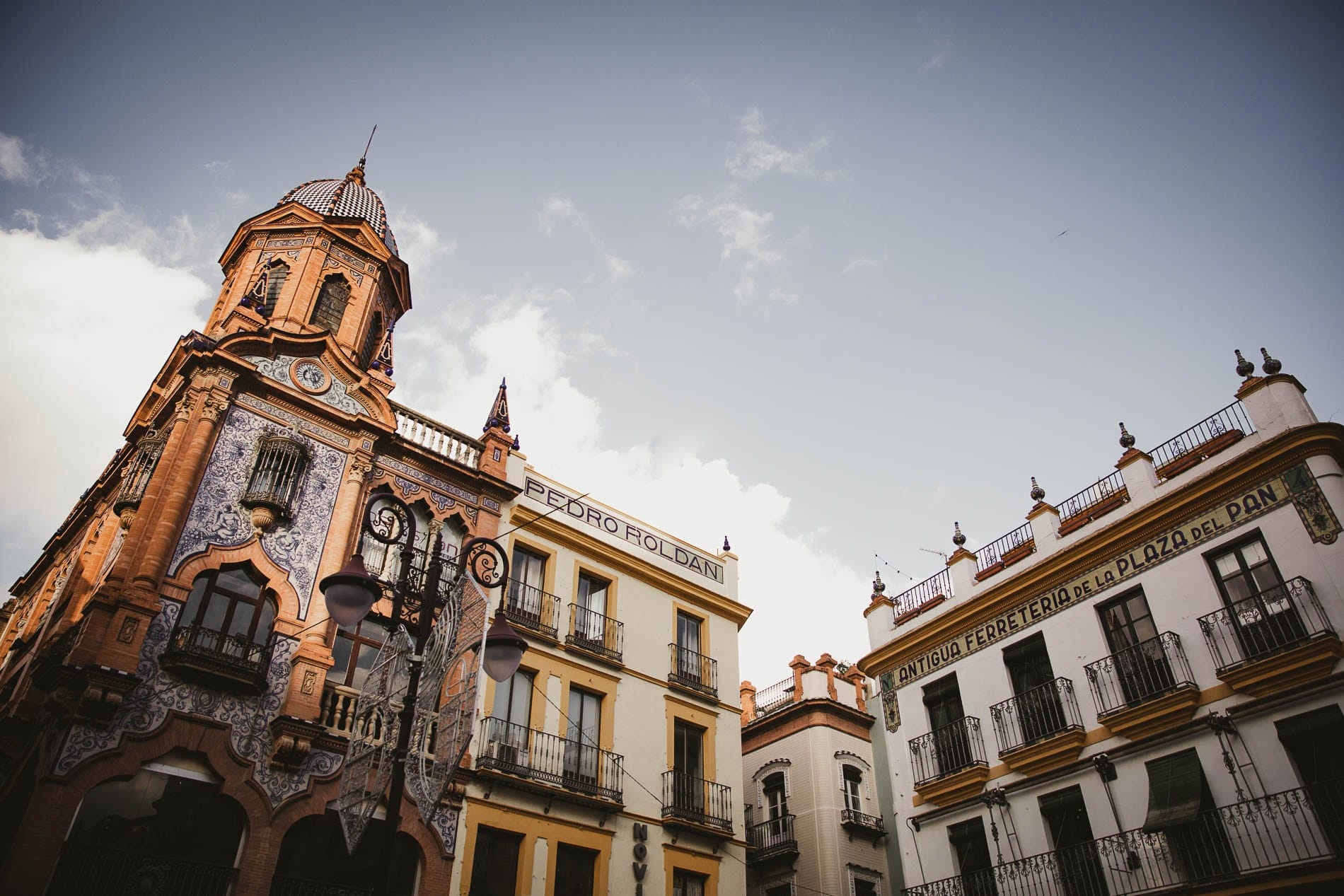
| LE QUARTIER DE L’ARENAL
C’est dans ce quartier que se situent les arènes et les berges aménagées du fleuve Guadalquivir avec la fameuse Tour de l’or « La Torre del Oro » . Vous y trouverez également le « marché de l’Arenal » ainsi que la « Plaza Del Cabildo », une petite place en demi-cercle atypique qui vaut le coup d’œil.
CROISIÈRE SUR LE FLEUVE GUADALQUIVIR
Le Guadalquivir est le fleuve de Séville, le seul navigable d’Espagne. Il a accueilli des compétitions internationales du plus haut niveau mais il a aussi joué un rôle important à de nombreux moments de l’histoire de la ville: sièges, défenses et conquêtes se sont négociés sur ses eaux. Le Guadalquivir est visible en vous rendant vers le quartier de Triana donc face à la « Torre del Oro » .
Il vous sera possible de profiter de ce canal en journée faisant du canoë-kayak, du paddle ou une croisière par exemple. Je réserve ma séance de paddle en journée ici et je vérifie les disponibilités.
Bon plan : Découvrez des charmants qui bordent le fleuve Guadalquivir lors de ce circuit écologique à vélo à Séville. Au cours de la visite de 3 heures, suivez votre guide local sur les pistes cyclables, tout en profitant de la tranquillité de la rivière et des jardins, loin des foules de touristes typiques. Je réserve ma visite à vélo maintenant.
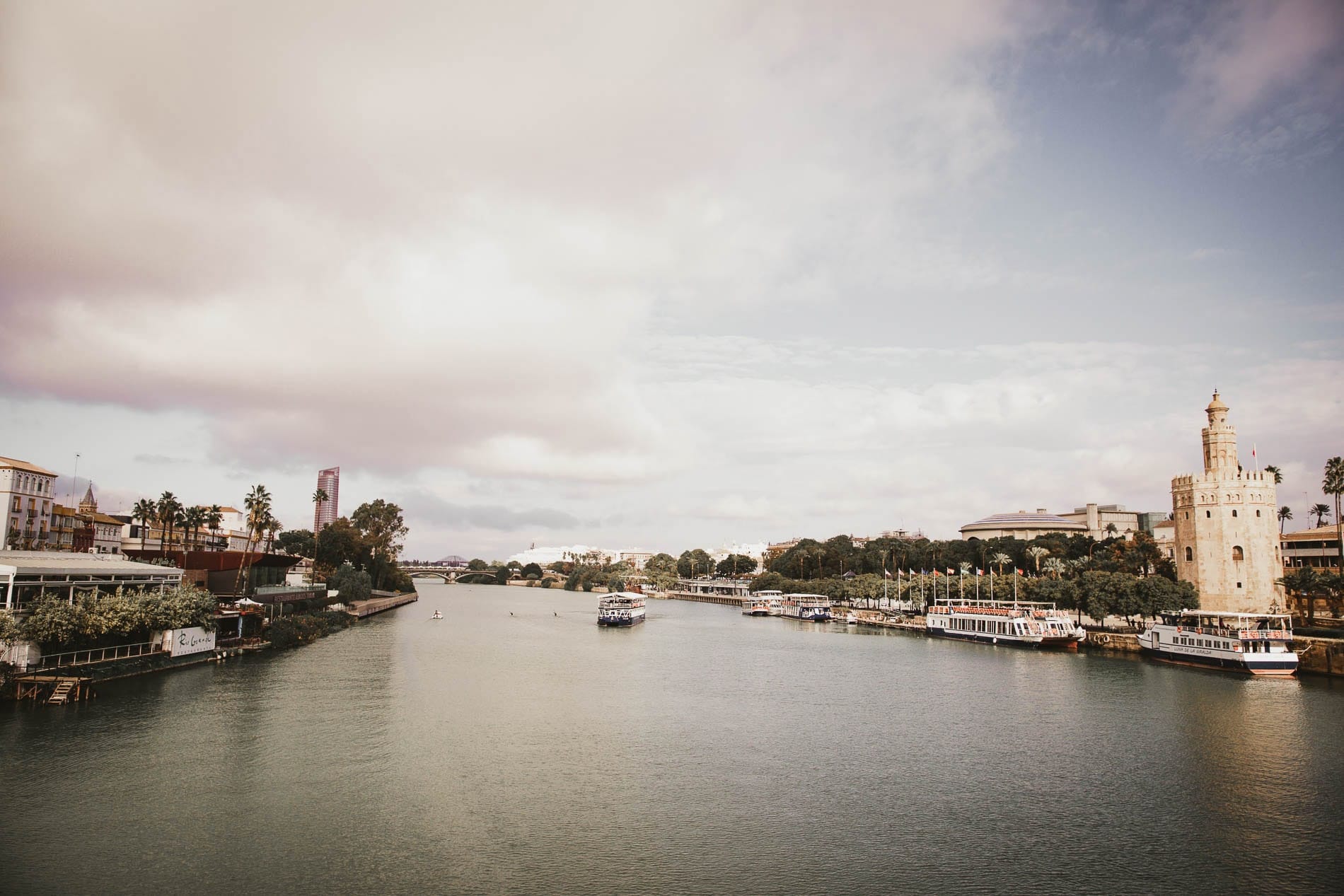
Si vous voulez gagner du temps, vous pouvez sélectionner directement des visites seules, guidées ou combinées que je vous propose, pour découvrir le fleuve Guadalquivir autrement. Pour plus de bons plans, cliquez sur l’une des activités ci-dessous.
LA TORRE DEL ORO
La tour de l’or « Torre del Oro » est une tour d’observation militaire, construite au XIII ème siècle qui permettait de contrôler l’accès à la ville. Ce n’est pas le monument le plus impressionnant de Séville, mais elle est assez jolie à photographier, surtout en fin de journée et au coucher du soleil. Aujourd’hui, cette tour abrite un musée maritime (gratuit tous les lundis) et la vue depuis son sommet permet d’admirer la Cathédrale de Séville, le canal et le quartier de Triana. Comptez environ 3€ l’entrée par personne et gratuit le lundi.
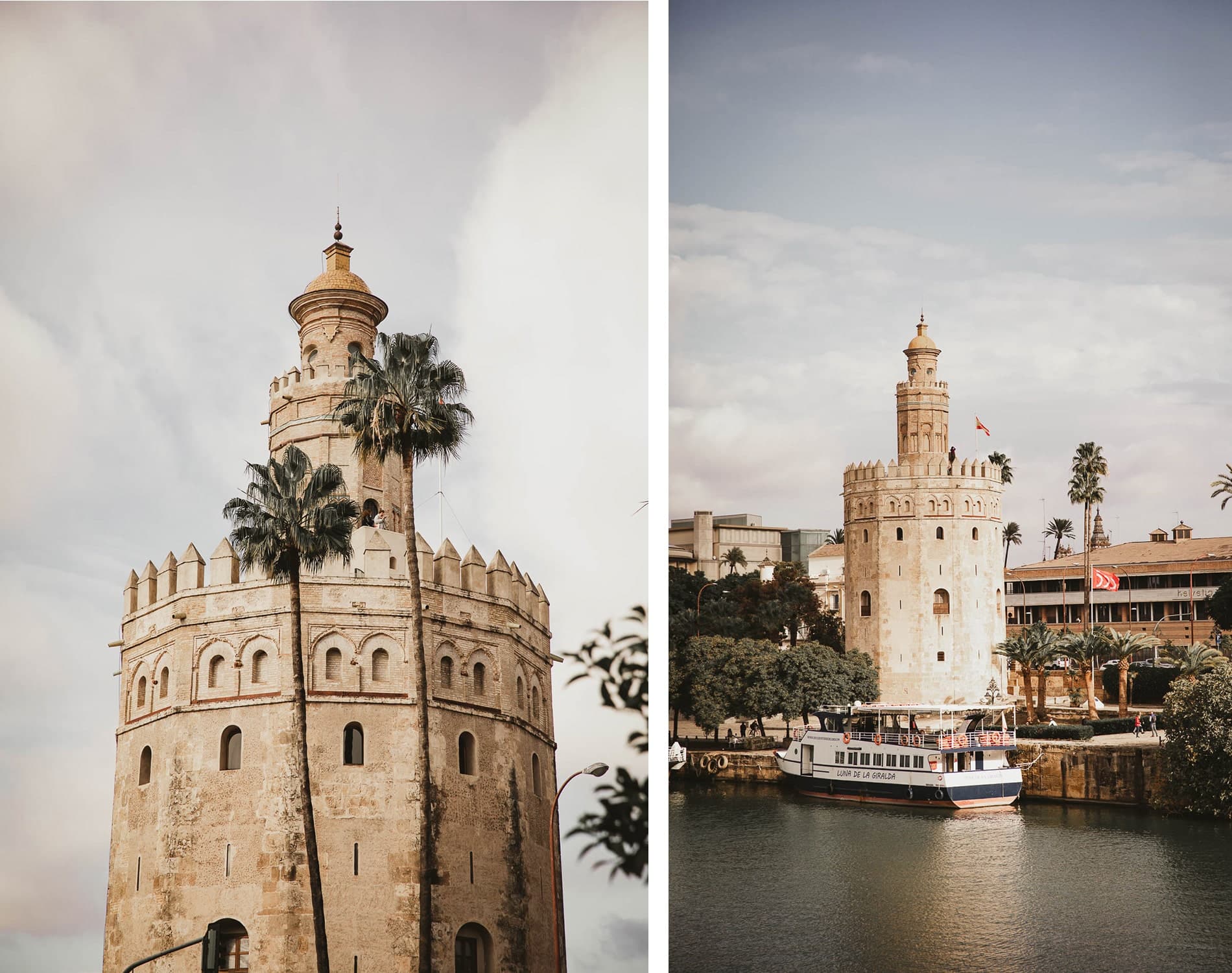
LES ARÈNES DE SÉVILLE
En Andalousie, la tauromachie fait partie intégrante de la culture locale. Mais les critiques de cette pratique sont comme chez nous de plus en plus importantes et l’activité des arts taurins tend à se réduire peu à peu. La tauromachie est encore à la main de la famille royale qui subventionne encore largement ce secteur économique pour faire durer la tradition. N’étant pas pro corrida, nous ne vous inciterons pas à aller voir une corrida mais il est possible de visiter gratuitement les pourtours des arènes et si vous le souhaitez, l’intérieur des arènes.
Pour y déjeuner, on ne peut que vous conseiller d’aller déjeuner au restaurant « El baratillo » ( C. Adriano, 20 ) situé juste en face des arènes. Rentrez à l’intérieur pour y voir les têtes de taureaux accrochées au mur. Ils servent tous types de tapas dont la spécialité de Séville, la queue de taureau . C’est ici qu’elle serait la meilleure de la ville et nous l’avons testé (enfin Antoine !). Une pièce de viande sur son os à la texture proche de la daube cuite dans une sauce au vin rouge. Apparemment un très bon plat traditionnel à goûter au moins une fois dans sa vie, si on est amateur de viande.
➡️ Je réserve mon billet coupe-file pour les arènes maintenant
Infos pratiques | Arènes de Séville
Entrée 10€ / adulte 6€ / étudiant, adolescents et personnes de plus de 65 ans 3,5€ / enfants Horaires Tous les jours de 9h30 à 19h30
Les spectacles de corridas sont d’avril à octobre
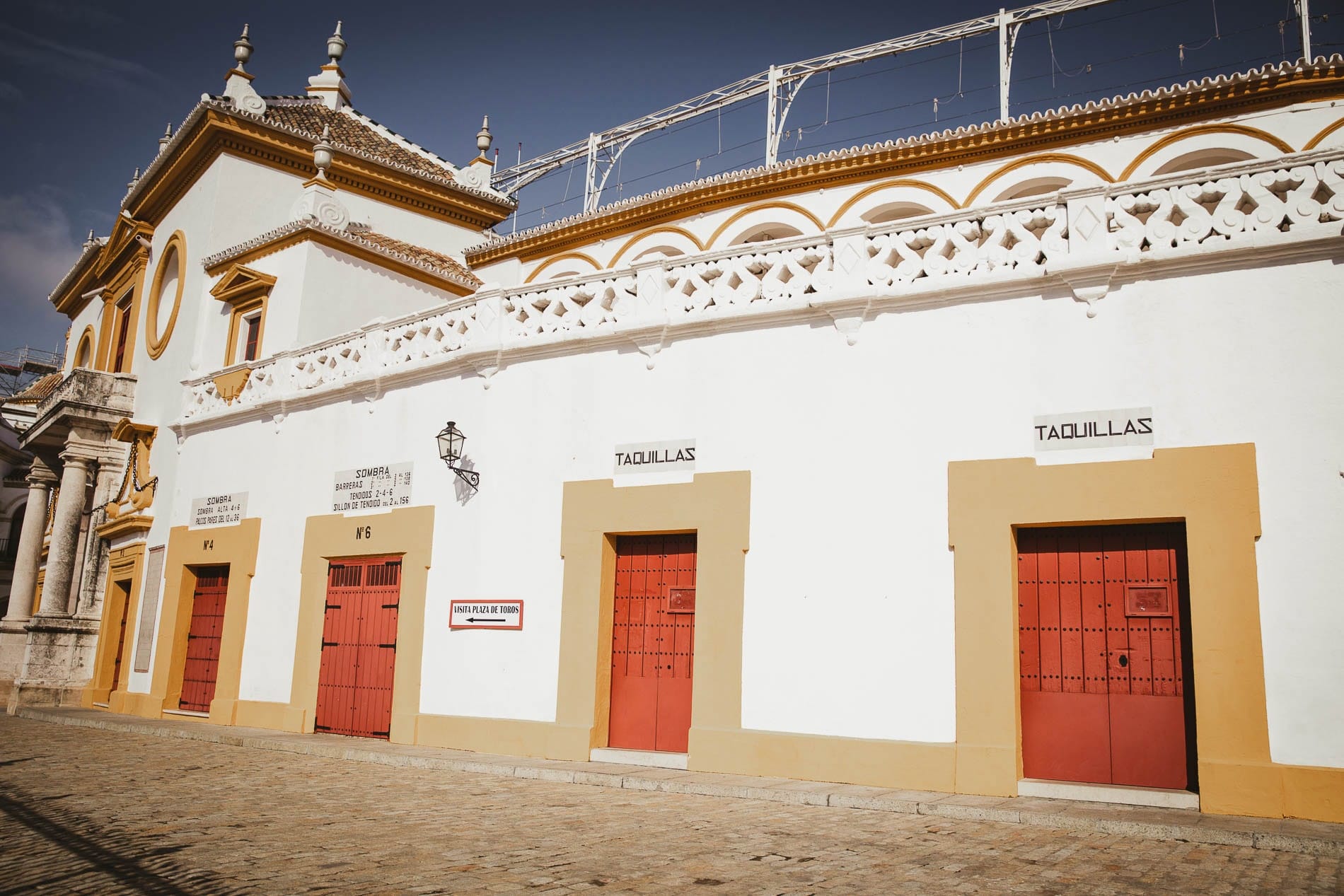
| LE QUARTIER DE TRIANA
Triana est un quartier situé sur la rive droite du Guadalquivir. C’est le quartier du flamenco où vous pourrez trouver beaucoup de spectacles. Je vous conseille la « Tablao Flamenco Pura Esencia » pour assister à un spectacle authentique. Les rues y sont très colorées par les façades des maisons ce qui donne un charme fou à ce quartier. La calle Betis le long des berges du fleuve en est un parfait exemple mais il ne faut pas hésiter à s’enfoncer quelques rues derrière. On y a trouvé un petit café très sympa sur une petite place à côté de l’Église Santa Ana, « le Bazar » et le « le Bar Bistec » pour une cuisine Sévillane traditionnelle.
L’autre intérêt de ce quartier est son marché, « el Mercado de Triana » l’un des plus anciens de la ville, situé au pied du pont de Triana et facilement reconnaissable avec ses devantures et dômes en céramiques. Vous pourrez y déguster au numéro 59, le fameux bocadillo (sandwich et au jambon ibérique) mais également du chorizo, des fromages, des chicharones en sirotant un vin rouge andalou ou une bonne bière. On a trouvé le meilleur endroit pour goûter à toutes ces spécialités, rendez vous sur le stand à côté de Pescaderia el Pipa. Les tables mange debout partent assez vite aux heures de pointe.
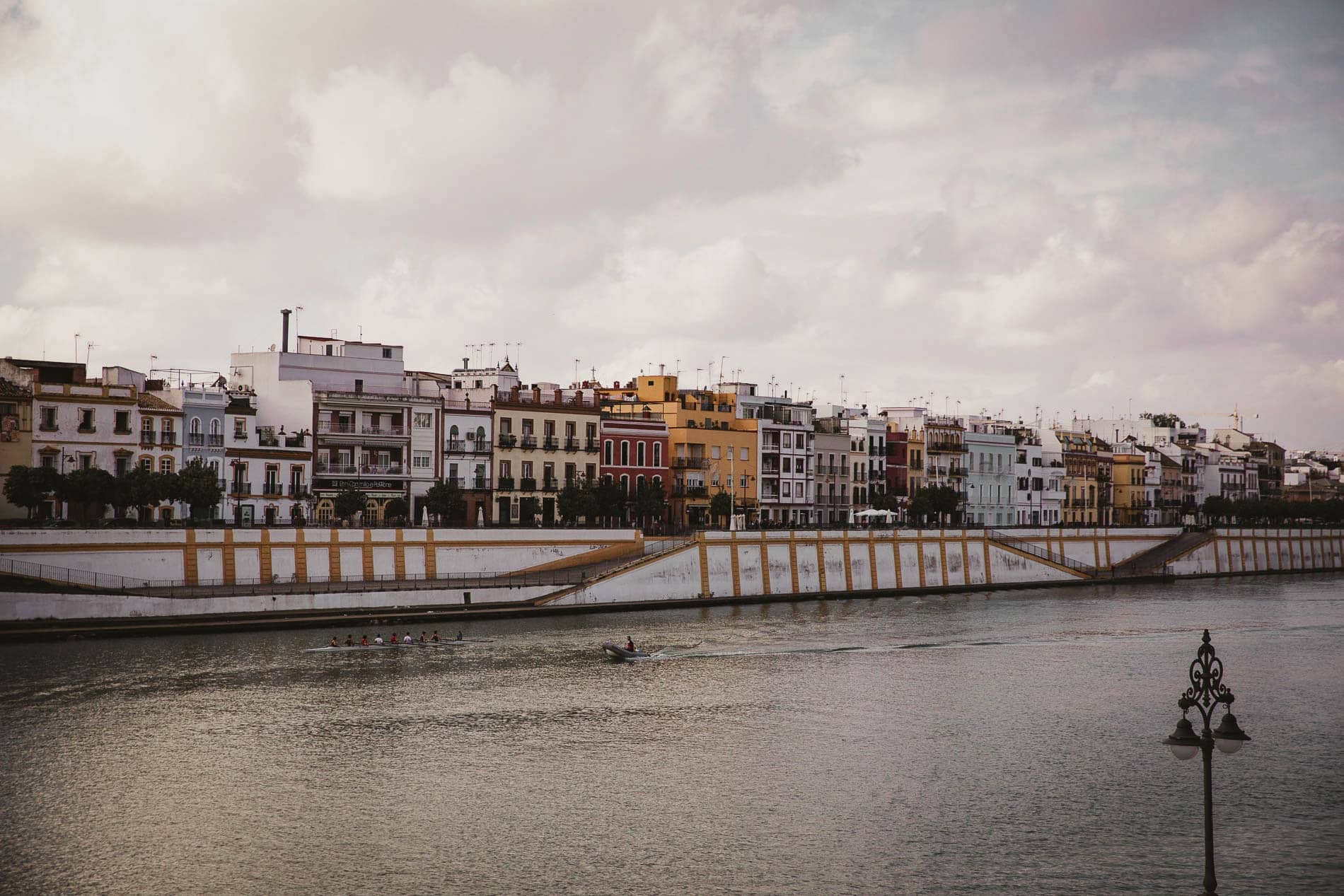
| VOYAGER AVEC UN BÉBÉ A SÉVILLE
Voici mon retour d’expérience après avoir passé 4 jours à Séville avec notre bébé alors âgé de 4 mois. Il est très facile de voyager à Séville avec un bébé. Pour le logement, nous avons privilégié un appartement hôtel, le Feria Pool & Luxury dans le quartier d’Alameda et nous ne regrettons pas ce choix car on s’y est senti comme à la maison avec toutes les commodités nécessaires : petite cuisine aménagée, coin salon, grande salle de bain, grande chambre avec lit bébé sur demande.
Côté nourriture, nous voyagions pour 10 jours en roadtrip en Andalousie. J’allaitais uniquement le matin et Gabriel commençait à boire au biberon donc nous avions emporté avec nous, qu’une seule boite de lait maternel et cela nous a suffit pour la durée du séjour. Sur place, vous trouverez dans tous les supermarchés, le nécessaire bébé à savoir des couches, de l’eau adaptée pour nourrissons, du lait, des lingettes, etc.
Pour les visites, même si les ruelles sont pavées, la poussette n’a pas été gênante. Nous avons une poussette babyzen, la Yoyo , qui est vraiment pratique pour se faufiler partout, que ce soit dans un musée, un restaurant, un bar ou encore des transports en commun.
Il y a 2/ 3 choses que nous n’avons pas pu faire avec notre bébé: les anciens bains de Séville où l’accès est interdit aux enfants et quelques rooftops car les endroits étaient trop exigus et remplis de monde. Mis à part ça, nous nous sommes jamais privés de quoi que ce soit et Gabriel nous a suivi sans trop rien dire ! J’ai quand même culpabilisé de l’avoir emmené au spectacle de Flamenco. Même si la durée du show était assez courte (et c’était voulu), nous étions assis tout devant, face à la scène. J’avais sous estimé la puissance et la force des chants ainsi que toutes les vibrations liées à la danse. Un petit casque audio pour protéger ses oreilles aurait été le bienvenu mais bon, j’en n’avais pas sous la main et je n’y ai pas pensé ! Je vous rassure tout s’est très bien passé et Gabriel n’est pas devenu sourd !
Infos pratiques | Avant de partir
N’oubliez pas les assurances voyages .
Avant de partir, assurez-vous d’avoir souscrit à une assurance voyage pour éviter tous les désagréments qui pourraient vous arriver ! Si vous avez pour projet de voyager sur un court séjour, un voyage à longue durée ou même un Tour du monde, une assurance voyage vous permet de bénéficier de certaines garanties essentielles pour passer un séjour en toute sérénité: annulation, bagages, assistance, frais médicaux, hospitalisation, décès, rapatriement et toutes ces galères que vous pourriez éviter. Opter aussi pour l’ assurance annulation en cas de Covid et fermetures des frontières. Plus d’infos dans notre article dédié pour vous aider à trouver la meilleur assurance et sur le site de Chapka, notre partenaire de voyage depuis notre Tour du Monde
| QUAND PARTIR A SÉVILLE
La ville de Séville compte 40 000 orangers donc le printemps reste une très belle période. La ville sent la fleur d’oranger donc rien que pour ces odeurs, je vous conseillerai d’y aller à partir d’avril mais aussi de septembre à novembre. Évitez absolument les mois de juillet et août en raison des offres chaleurs et des températures avoisinant les 40 degrés !
| ARRIVER A SÉVILLE
Pour vous rendre à Séville en avion depuis Paris, il y a un vol direct qui ne vous prendra que 2h30 environ . Si vous vous y prenez à l’avance, comptez une centaine d’euros l’aller retour depuis Paris. Trouvez votre vol au meilleur prix avec le comparateur de vol Skyscanner et le comparateur Ulysse
Pour ceux qui doivent prendre un préacheminement pour vous rendre à Paris, regarder sur Ouigo car vous pouvez trouver des touts petits prix. Trouvez des billets de train pour Paris à petits prix
Le TGV reste une bonne option rapide pour rejoindre Paris, avec des prix très attractifs si vous vous y prenez à l’avance. Trouvez votre billet de train pour Paris au meilleur prix !
| LOCATION DE VOITURE
En arrivant à Séville, pensez à louer une voiture à l’aéroport ou dans le centre ville pour découvrir les villages blancs d’Andalousie. Trouvez ici votre location de voiture au meilleur prix avec skyscanner
| SE RENDRE A SÉVILLE DEPUIS L’AÉROPORT
Depuis l’aéroport de San Pablo qui se trouve à environ 10 kilomètres au nord-est de la ville, deux options s’offrent à vous pour vous rendre à Séville:
EN BUS
Si vous devez rejoindre Séville en bus depuis l’aéroport, prenez la ligne EA ou le bus 1501 – 8 Tussam (à droite à la sortie de l’aérogare) mais attention, elle ne va pas jusqu’au centre historique et s’arrête à Plaza de Armas. Comptez 35 minutes de trajet et 4€/personne le trajet simple, 6€ le trajet aller retour. Cette option reste très abordable mais ne soyez pas trop chargés en bagages.
Cliquez ici pour connaître les horaires & tarifs du bus depuis l’aéroport
Le taxi reste la solution la plus rapide et simple mais sans doute la plus coûteuse (sauf si vous partagez votre taxi à plusieurs personnes). Comptez environ 25€ pour un trajet de 15 à 20 minutes et entre 10€ et 20€ si vous prenez des VTC .
La station de taxi se trouve à droite, en sortant de l’aérogare et de nombreux taxis vous attendent. Attention, c’est à Séville et dès le premier jour, que nous avons oublié notre porté bébé dans le coffre. En effet, en plein cœur de Séville, les taxis sont souvent klaxonnés par les particuliers conduisant leur voiture et dans l’agitation, le chauffeur peut vous descendre les bagages précipitamment. Vérifiez bien que vous avez avec vous toutes vos affaires avant de quitter le taxi ! Pour plus de sécurité et en cas d’oubli, passez par une compagnie agrée où vous aurez un numéro de téléphone à contacter en cas de perte.
Pour ceux qui ont une voiture de location, si vous recherchez un parking proche de l’aéroport de départ ou non loin, je vous invite à jeter un oeil sur le site de Onepark
Cette plateforme permet aux voyageurs de comparer et réserver en ligne, leur place de parking et d’accéder à plus de 2000 parkings dans 9 pays d’Europe. C’est le leader du marché et vous pouvez faire jusqu’à – 60% d’économies . Pensez à vous y prendre à l’avance pour vérifier les disponibilités.
Je réserve maintenant mon prochain parking
| SE DÉPLACER A SÉVILLE
Le centre historique de Séville où se concentre les principaux intérêts historiques de la ville est constitué essentiellement de ruelles pavées et se fait très facilement à pied. En revanche, les transports en commun n’y passent que très peu car peu accessible. La ville propose des pass transport de 1 jour ou 3 jours et nous avions fait le choix de prendre une carte de transport pour les 3 jours trop hâtivement que nous avons finalement peu utilisé. Si votre logement se situe dans le cœur historique, inutile de prendre un pass. Achetez uniquement des tickets unitaires car vous ferez l’essentiel de vos trajets à pied.
Nous avons adoré déambuler dans tous les quartiers et les rues de Séville car on y a découvert une ambiance locale à l’espagnole, de jolies façades colorées, des cafés d’époque et une ville bourrée de charme. Et vous, quel quartier aimez-vous de cette ville ? Avez vous de bonnes adresses à nous conseiller pour une prochaine fois ?
Avant de partir, je vous invite à lire notre article sur notre roadtrip dans les plus beaux villages blancs d’Andalousie pour un roadtrip incroyable en couple ou en famille.

YOU MAY ALSO LIKE!
Que faire sur 4 jours à amsterdam, l’automne en finlande | découvrez jyvaskylä et lahti dans la région des grands lacs, les plus beaux marchés de noël d’alsace, montréal en hiver: 3 jours à la découverte des activités hivernales, 10 commentaires.
merci pour cet article richissime en informations
Bonsoir Nous envisageons de nous rendre en Espagne Andalousie courant Octobre 2023 afin de voir SEVILLE, CORDOUE , GRENADE Les villages blancs dont RONDA ou autres. Puis se rendre vers CONIL et VEJER DE LA FRONTERA puis retour à SEVILLE le tout en 10 jours environ . Pouvez-vous nous programmer ce périple indépendant ainsi que son montant avec les logements. Bien cordialement DANIEL
Merci Marion pour cette mine d’information ! Je pars dans 10 jours pour 4 jours à Seville et je suis impatiente de découvrir tes lieux conseillés Merci pour ces belles prises de vue
Merci Sylvie c’est adorable votre commentaire. Profitez-en bien
Un magnifique article à lire ! Merci pour cette mine d’informations et de couleurs à travers les photos. Mon séjour est prévu dans quelques jours et je pars avec de bonnes adresses de lieux qui semblent somptueux. Merci pour ce partage 🙂
Merci Julie pour votre retour Vous me direz si cet article vous a bien aidé ? vous allez voir c’est magnifique ! Bon voyage
Quel merveilleux article 🙂 Je suis en pleine préparation d’un city-trip pour le mois de septembre et votre article est une mine d’or. Vos photos donnent toutes + envie les unes que les autres. Un grand merci pour le partage de vos bons plans et toutes ces infos.
Bonjour Delphine
Merci infiniment pour votre retour, c’est très appréciable car je passe beaucoup de temps à écrire mes articles donc cela me fait vraiment plaisir. J’espère que toutes ces infos vous aideront pour votre séjour à Séville Bon voyage
Merci Marion pour toutes ces recommandations et infos pratiques. Ton article est très complet et m’a aidée à peaufiner mon séjour à Séville 😉 Et en regardant tes belles photos après coup, ça me replonge dans l’ambiance de la ville. J’ai quelques infos complémentaires concernant le bus depuis/pour l’aéroport si ça peut être utile à d’autres lecteurs 😉
Oh merci Jessica pour ce message et ce retour c’est adorable ! Je veux bien les infos concernant le bus oui avec grand plaisir, je le rajouterai à l’article. C’est très sympa. Bonne soirée
Laisser un commentaire Annuler la réponse
Votre adresse e-mail ne sera pas publiée. Les champs obligatoires sont indiqués avec *
Commentaire *
Enregistrer mon nom, mon e-mail et mon site dans le navigateur pour mon prochain commentaire.
For security, use of Google's reCAPTCHA service is required which is subject to the Google Privacy Policy and Terms of Use .
I agree to these terms (required).
Ce site utilise Akismet pour réduire les indésirables. En savoir plus sur comment les données de vos commentaires sont utilisées .
Vous recherchez quelque chose ?
Liens professionnels.
- BLOG VOYAGE
- VOYAGE SUR MESURE
- OFFRES DE VOYAGES
- LA BOUTIQUE
- METIERS DU VOYAGE
- PARTENARIAT
- COLLABORATIONS
MENU BLOG VOYAGE
- REPUBLIQUE TCHEQUE
- AFRIQUE DU SUD
- RÉPUBLIQUE DOMINICAINE
- INDE DU NORD
- INDE DU SUD
- NOUVELLE CALEDONIE
- NOUVELLE ZELANDE
- CODE PROMO AIRBNB – 40€
- ECONOMIES SUR VOS RESERVATION DE PARKING
- – 5% SUR LES ASSURANCES VOYAGE
- BIEN ETRE ET SPA
- TOUR DU MONDE
- VOYAGER AUTREMENT
- HIVER ET NEIGE
- PLAGES ET CRIQUES
- ACCESSOIRES DE PLAGE
- IDÉES CADEAUX
- Ma DECO & MES INSPIRATIONS
- MES LOOKS DE VOYAGE
- RECETTES DE CUISINE
- RESTAURANTS ET EXPÉRIENCES CULINAIRES

VOTRE VOYAGE À SÉVILLE COMMENCE ICI
Votre voyage
Tout savoir sur Séville
Vous partez bientôt à Séville ? Super ! Notre blog vous aidera à préparer votre voyage et à découvrir tous les recoins de Séville.
Quand partir à Séville?
Découvrez avec nous les meilleurs mois pour partir à Séville. Faut-il éviter les mois d’été ? On vous explique tout dans cet article !
Billets d’avion, réservation d’un hôtel et des activités sur place, il vaut mieux bien prévoir votre voyage à Séville pour ne pas perdre de temps une fois sur place.
Où dormir ?
Vous ne savez pas quel hôtel choisir ? On vous explique tout dans cet article et on vous donne nos quartiers et adresses préférées pour bien dormir à Séville.
LA MISSION DE CE BLOG ?
Vous faire voyager à Séville
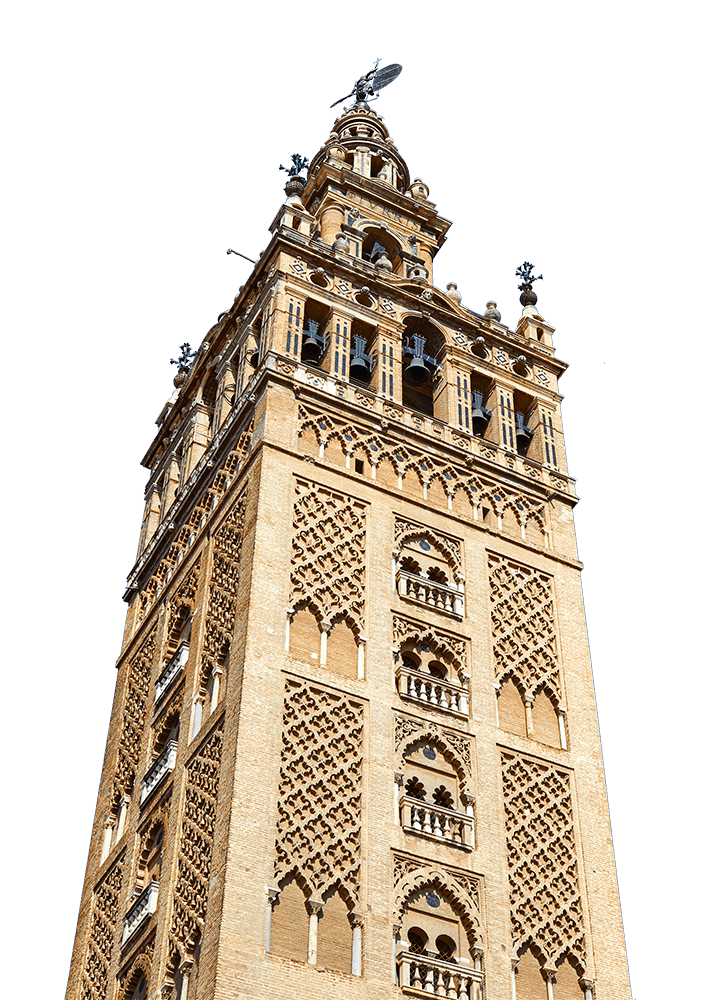
Nos conseils
Les activités incontournables
Il y a beaucoup de choses à faire à Séville, mais pour un premier voyage, on vous conseille de rester sur les grands classiques.
Le palais Real Alcazar
La Plaza de los Toros de la Maestranza
Le Metropol Parasol
La Cathédrale de Séville et la Giralda
Les derniers articles
Vous trouverez les derniers contenus que j’ai rédigés sur Séville directement dans cette rubrique
Où voir du flamenco à Séville ?
Lire la suite
Quels musées visiter à Séville ?
Louer une voiture à séville, quelles sont les activités gratuites à séville , où manger à séville , que ramener d’un voyage à séville .

BIENVENUE sur mon blog voyage
En quelques chiffres.

VISITER SÉVILLE FACILEMENT AVEC BONJOUR SÉVILLE
On parle de moi.

- La newsletter de Claironyva !

4 jours à Séville, une escapade pleine de surprises !
4 jours à séville, une escapade andalouse pleine de surprises .
Comment résister à l’appel du vol direct pour Séville , le temps d’un grand week end ? Je n’y étais d’ailleurs pas encore arrivée que je m’imaginais déjà revenir en Andalousie, sur un séjour un peu plus long pour aller visiter Cordoba et Grenade.
A Séville, j’ai eu des hauts et des bas, la météo se l’est jouée capricieuse, mais m’a quand même laissé entrevoir des monuments magnifiques, des jolies petites rues, visiter les arènes et faire quelques chouettes rencontres ! Allez, on y va !!
N’oubliez pas de lire le bilan budget de ces 4 jours à Séville à la fin de cet article !

Pour vous donner une idée des distances et emplacements des lieux que j’ai pu voir lors de mon séjour à Séville, je vous livre une petite carte dynamique :
Voir en plein écran
1 ère journée courte mais pleine d’émotions avec une belle vue sur Séville au coucher du soleil
Arrivée et installation dans mon quartier : la macarena .
Ah la Macarena, une chorégraphie bien connue, toute ma jeunesse… Mais même si l’envie d’esquisser un petit pas de danse me prend, il faut dire que je suis d’abord pressée de rejoindre mon studio loué avec Airbnb qui se trouve à 20 minutes de marche de l’arrêt de bus final de la navette aéroport. Je vous invite d’ailleurs à ne pas louper la fin de cet article pour retrouver toutes les informations et le budget de ce grand week end à Séville !
Avec un vol en milieu d’après-midi, j’arrive au studio à 17h45, où je suis super bien accueillie par mon hôte Silvia ! Elle a pris le temps de m’expliquer quoi faire dans les environs et me suggère quelques endroits où manger. Nous sommes donc dans le quartier populaire de Séville au nord du centre-ville, un endroit vivant, près d’un joli marché couvert. J’ai pu visiter toute la ville à pieds, même sans réellement être dans le cœur du centre.

Coucher de soleil au Metropol Parasol
Vers 18h30, je quitte mon appart super mignon pour aller admirer le coucher de soleil depuis le Metropol Parasol, aussi appelé, « le champignon ». C’est une œuvre architecturale moderne en bois qui tranche plutôt pas mal dans le quartier et est devenue un des symboles de Séville.
Il me faut à peine 5 minutes pour rejoindre le Metropol Parasol, l’entrée pour l’ascenseur se trouve en sous-sol, c’est également là que vous pourrez voir des vestiges archéologiques. Mon objectif à moi, c’était de grimper, je dépense donc 3 euros et obtient 1 euro de réduction sur le bar (où je siroterai une sangria à 2 euros après ma balade).
La vue est juste superbe , il n’y avait pas grand monde, nous sommes à la mi-mars et hors vacances scolaires. J’aperçois tout plein de clochers, et les toits de la cathédrale au loin. Au fur et à mesure que le soleil se couche, je ne peux m’empêcher de prendre photos sur photos, même si un gros nuage noir au loin vient nous gâcher un peu la fête.
J’aperçois aussi une tour, seule, plantée là comme si elle s’était perdue, je crois qu’elle n’est d’ailleurs pas vraiment très appréciée des Sévillans, on peut comprendre pourquoi !
Une fois que j’ai fini ma sangria, la nuit est bien tombée et je profite des éclairages pour refaire une petite photo !

Repas du côté d’Alameda, le quartier parfait pour manger et prendre un verre le soir !
Mon estomac crie famine, alors sur les conseils de Silvia, je me rends au restaurant Arte y Sabor , du côté de Alameda, également à 5 minutes à pieds du studio. C’est un restaurant vegan et végétarien friendly, qui a bonne réputation. Au moment où j’arrive, une table de 2 se libère à l’intérieur, c’est bien ma chance car plus tard, les gens feront la queue à l’extérieur ! Le cadre est agréable et la carte alléchante, avec des prix plutôt raisonnables. C’est les vacances, alors même en étant en solo, je commence par commander un tinto de verano pour l’apéro ! Pour la suite, je me choisis quelques tapas : des croquetas de bacalao, des falafels et des tempuras de légumes et crevettes. Autant vous dire que j’avais le ventre plein, mais je trouve quand même la place de me caler un brownie au chocolat pour au total : 15,30 euros de note !
Si vous avez le cœur à la fête, tout autour de Alameda de Herculès : une grande esplanade délimitée par les statues de César et Hercule, vous trouverez de nombreux bars. Dans mon cas, direction dodo car demain une rude journée s’annonce !
2 ème journée : grandes expectations et petites déceptions, du Real Alcazar à la Cantina, quand Séville est sous la pluie, voire même, la tempête !
Visite du real alcazar de bon matin, comme une envie de revoir les épisodes de game of thrones.
C’est sous la pluie que je pars ce matin-là, heureusement, j’avais prévu le coup avec un mini parapluie. Sur les conseils de pas mal de monde, j’avais réservé la visite sur Internet ce qui a ses avantages et inconvénients. L’avantage certain, c’est le temps gagné à faire la queue, il y avait déjà du monde malgré le temps maussade 20 minutes avant l’ouverture des portes. L’inconvénient, c’est qu’une fois qu’on a réservé, on ne peut plus modifier. Hors, quatre jours avant, la météo me disait que ce serait le plus beau jour du week end… et elle a changé d’avis l’avant-veille en décrétant que ce serait la journée la plus pourrie du week end.
Après m’être cramponnée au parapluie sous une pluie torrentielle juste avant l’ouverture du Real Alcazar , je savoure enfin la beauté des lieux. C’est un vrai labyrinthe de cours intérieures charmantes, et je me dégote un patio avec un banc tout mignon contre un mur d’azulejos où personne n’a encore mis les pieds de la journée.
Alors ni une ni deux, je sors mon trépied que je me trimballe à chaque voyage sans jamais l’utiliser, et je me dépêche de me faire un selfie en mode avancé… Je suis plutôt mauvaise en selfie avec le téléphone, et le trépied est quand même un super ami quand vous voyagez en solo et que vous n’osez pas trop demander au gens de vous prendre en photo.

Ceci étant fait, je me retrouve vite dans The Patio, celui le plus joli du Real Alcazar, et ça en jette !! J’enchaîne alors des pièces recouvertes d’azulejos et de belles décorations, mais je suis en fait à la recherche de quelque chose : les jardins !
Ces fameux jardins dont j’ai pu voir la beauté dans GOT et moultes photos un peu partout sur le net. Le point d’orgue de la visite si je puis dire, me restera complètement inaccessible. Là est la grosse déception de la journée, à cause du vent, les jardins sont fermés, et aucune indication à l’entrée à ce sujet : surpriiiise ! C’est donc un peu, non en fait c’est carrément la douche froide, je n’en verrai qu’un petit bout à travers les grilles.

Pause réconfort et balade le long du Guadalquivir alors que la tempête frappe Séville
Alors à la question que faire à Séville lorsque qu’il pleut, je répondrai : la même chose que quand il ne pleut pas mais avec un parapluie ! Enfin pour en arriver à cette conclusion, j’ai commencé par me poser dans un café à 11h pour un chocolate con churros, ça aide toujours à se remettre les idées en place !
Le long du Guadalquivir jusqu’à la Plaza de Armas : on y va !
Cette balade m’entraîne jusqu’à la Torre del Oro, dans laquelle je pensais pouvoir monter. Mais ce sont les pompiers qui y font un exercice ce jour-là, pour le coup ils testent aussi les conditions pourries. Mon parapluie commence à se retourner coup sur coup, non seulement c’est le déluge mais en plus, le vent s’en mêle ! Je pense que mon parapluie a du se retourner une trentaine de fois et le soir même je lui ferai mes adieux.
Sans m’en rendre compte, je dépasse les arènes, que j’avais dans l’idée de visiter… Avec ce temps j’ai totalement la flemme de faire demi-tour et je continue jusqu’à la plaza de Armas, terminus du bus express de l’aéroport et également superbe site pour admirer des graffs.
C’est l’heure de la pause Street Art !!
Avant même de traverser le pont, quelques œuvres se dessinent, et même si les éléments se déchaînent, je suis aux anges ! Plusieurs styles se partagent l’espace. L’œuvre majeure est celle d’un enfant endormi qui est à tomber, au-dessus de lui, une sorte d’ange démoniaque, je prends tout mon temps pour faire les photos avant de faire une pause séchage au studio.

Repas, rencontres et bonne ambiance à la Cantina
Toujours sur les conseils de mon hôte, je file à deux pas de l’appartement pour aller manger à la Cantina , une des échoppes du marché couvert. Malgré le mauvais temps, il y a foule, il faut dire que nous sommes un samedi. Je commande des croquetas avec une mini tortilla et un peu de fromage, sans oublier un tinto de verano. Je teste même le vin d’oranges, c’est liquoreux et moi qui aime le vin doux, j’adore. L’ambiance y est bon enfant et j’exerce mon espagnol avec un couple calé juste à côté de moi au comptoir. Je passe quasiment tout l’après-midi là-bas, il faut dire que l’on voit des trombes d’eau tomber sur la place, alors pourquoi bouger ?
Le soir, je réserve mon billet pour visiter la cathédrale le surlendemain et sors l’imprimer dans un cybercafé car apparemment, l’avoir sur le téléphone ne suffit pas. J’en profite pour prendre à manger chez un indien à côté.

3 ème jour : quand Séville se la joue ascenseur émotionnel
Parcs fermés, place d’espagne aussi, la matinée commence bien….
Ce matin-là, je me lève à 7h30 pour être le plus tôt possible à la plaza de España parce que la météo indiquait qu’on allait avoir un peu de soleil une partie de la matinée. Et en effet, sur le trajet, je profite d’un peu de ciel bleu ! Mais avant même d’atteindre mon but, les nuages commencent à prendre place. Il faut 30 minutes de marche pour rallier la Place d’Espagne depuis le quartier de la Macarena.

Enfin j’y arrive, et je trouve les grilles closes. Comme moi, quelques touristes se posent des questions. Mon hôte m’avait prévenue de la fermeture des parcs à mon arrivée à cause du mauvais temps prévu, mais je pensais que seule la journée de la veille était concernée. Niveau communication par contre, impossible de trouver l’info sur internet, pas un panneau devant les grilles… Dommage.
Comme je suis de nature plutôt persévérante, je fais même le tour de l’immense parc en pensant que le musée d’archéologie ou des coutumes seraient ouverts, mais non… c’est bien dommage encore une fois, surtout que l’air de rien ça fait une trotte ! J’admire donc les bâtiments depuis l’extérieur, ils avaient servi lors de l’Exposition de 1929 et sont vraiment magnifiques.
Du coup, je me suis sentie vraiment démoralisée : pas de jardins au Real Alcazar la veille, pas de Plaza de España, les joyaux de la ville de Séville sur lesquels je misais pas mal.

L’ascenseur commence à grimper aux Arènes de la Maestranza
Séville ne compte pas me laisser d’humeur maussade bien longtemps, car c’est bien plus que le Real Alcazar et la Place d’Espagne. Je file donc visiter les Arènes , considérées comme l’une des plus belles arènes au monde.
Elles ont été construites à partir de 1761 et achevées 120 ans plus tard ! Les arènes peuvent accueillir 12 000 spectateurs, je me contente d’une visite car je ne suis pas vraiment branchée corrida. Sachez que pour 8 euros, vous disposerez de votre ticket d’entrée et d’un audioguide compris. Tout commence par des salles d’expositions : peintures, sculptures, costumes, maquettes, vous saurez tout de ce lieu emblématique de Séville.
Le petit bonus pour moi, l’autorisation d’utiliser mon trépied dans l’arène, histoire de m’immortaliser sans embêter les autres touristes (ou être déçue du cadrage). Cette visite m’a reboostée ! Et alors qu’il n’est que 11h30, j’ai déjà faim… Comme les Espagnols ne mangent pas avant au moins 13h, je me mets en quête d’un chocolate con churros.

Le joli petit marché couvert de Lonja del Barranco
Alors que j’aperçois un kiosque vendant des churros avec un chocolat chaud, je ne peux m’empêcher de m’approcher du marché couvert situé juste à côté. J’y étais passée devant la veille, mais j’étais trop occupée à tenter de maîtriser mon parapluie.
Plutôt que de me laisser aller à la gourmandise, j’entre dans le marché. Il est adorable avec des stands pour tous les goûts. Tout n’est pas encore ouvert, mais les stands se mettent en place, et j’en repère un qui propose un risotto de champignons, je suis fan et en plus j’ai vraiment envie de manger quelque chose qui ne soit pas frit !
Je me suis donc régalée, toujours avec un tinto de verano qui m’a aidée à patienter ! Le risotto valait le coup : 11€ et avec de vrais champignons entiers dedans.

Traversée du Guadalquivir à la rencontre de lieux moins touristiques à Séville
Le pavillon de la navigation.
Même si dans un coin de ma tête j’ai envie de retourner voir si la place d’Espagne est ouverte, je préfère traverser le Guadalquivir en direction du Pabellon de la Navegacion. J’avais lu dans mon guide Un Grand Week End à Séville que l’entrée coûtait 4,9€ et qu’il s’agissait d’un grand espace culturel pour entrer dans une aventure maritime et au final monter dans la tour mirador pour avoir une belle vue sur la ville. Bon, j’ai du mal tomber ou alors, ils se sont un peu plantés dans le bouquin car ce jour-là, c’était une grande exposition dédiée à Van Gogh. Ca avait l’air très intéressant, avec des reproductions grandeur nature de peinture, sauf que le prix était de 13€. Je n’avais déjà pas fait le pas à Amsterdam d’aller visiter son musée, donc cette fois encore, j’ai passé mon chemin.

Le CAAC : Centro Andaluz de Arte Contemporano
Le soleil est de retour et j’arrive dans ce lieu chargé d’histoire. Au commencement, c’était un monastère, puis ce fut une fabrique de céramiques, et enfin, un musée d’art !
Avant même d’entrer à proprement parler dans l’enceinte du musée, vous pouvez vous balader dans les jardins. Puis près de l’entrée, une œuvre attire mon attention. A vrai dire, il faudrait vraiment être distrait pour ne pas la voir ! Il s’agit d’une sorte de géant coincé à l’intérieur d’un bâtiment, vous en voyez la tête à une fenêtre et son bras sort par une autre. Et là, j’ai eu une idée : celle de m’intégrer dans ce tableau ! Le trépied me fut encore une fois utile, même si au final, l’aide d’une gentille dame fut essentiel à la réussite de mon petit projet !
Le musée coûte 1,80 euros, ce qui permet de voir les cheminées dans la cour intérieures. Une seule expo sur trois était ouverte, j’ai eu un peu de mal à comprendre car mon esprit artistique n’est pas vraiment super aiguisé. Si vous avez du temps sur Séville, je dis pourquoi pas, sinon, je pense qu’il y a quand même de quoi faire en ville qui vaut plus le coup, comme visiter des palais, ce que je n’ai pas fait au final (une 2 ème visite s’imposera).

Direction les remparts du quartier Macarena, c’est la journée « grand tour de Séville » au final !
Je pense que j’ai bien dû marcher 20 kilomètres ce jour-là, mais aucun regret car sous le soleil et sans vent. Je disais donc : les remparts ! De beaux vestiges que l’on peut longer, avec deux ou trois tours en bon état. Dommage qu’on ne puisse pas y grimper !
Une porte se trouve en face de la Basilica de la Macarena qui vaut totalement le détour. En pleine préparation de la Semana Santa, des chars pour la procession sont exposés ! Je suis du coup entrée dans une autre église un peu plus loin pour en voir d’autres.

Quand je vous parlais du grand tour de Séville : goûter dans le centre
Point fatiguée, mais un poil affamée à l’heure du goûter, je décide d’aller me déguster un petit quelque chose à la Campana, une des plus anciennes pâtisseries de la ville. Pour commander, il faut choper un bout de comptoir : sur la droite de la pièce si vous voulez aussi une boisson et sur la gauche sans boisson. Pas pressée, je suis restée à droite et me suis commandée un chocolat chaud et une pâtisserie typique de la Semana Santa : la torrija . C’est l’équivalent du pain perdu mais bien baigné dans du miel, j’ai bien aimé !

Plaza de San Francisco et Plaza Nueva
Je me retrouve un peu au hasard Plaza de San Francisco, où des gradins sont déjà installés pour les événements de la semaine Sainte. Alors let’s go de l’autre côté, sur la Plaza Nueva avec l’entrée de l’hôtel de ville et tout plein de bâtiments super jolis. C’est le week end, il fait beau, les gens sont de sortie et les musiciens aussi. Je reste environ 45 minutes à écouter un groupe qui joue superbement bien.

J’apprécie toujours autant l’architecture de nombreux bâtiments de la ville, des petits immeubles aux balcons fleuris aux belles bâtisses imposantes du centre.
Et pour finir cette journée riche en émotions et en kilomètres marchés, je grimpe (enfin je prends les escalators) jusqu’au dernier étage du centre commercial le Corte Ingles pour faire quelques photos de la vue depuis leur rooftop. Je suis un peu trop en avance pour le coucher du soleil mais je profite bien quand même le temps de quelques clichés alors que le soleil commence un peu à décliner.

Un accueil chaleureux et une bonne cuisine au Fullero : mon restaurant coup de cœur du voyage
On est dimanche soir et le quartier est calme. J’avais repéré le restaurant El Fullero la veille et un petit tour sur le net m’a permis de voir qu’il avait bonne réputation, du coup, même s’il est complètement vide ce soir-là, j’y vais !
L’accueil est excellent, le serveur Flavio repère mon accent français et tente de tout m’expliquer dans ma langue. Pour l’apéro, je teste un vin semi-doux, que j’ai beaucoup aimé ! Comme d’habitude, je ne peux m’empêcher de commander des croquetas, qui sont excellentes, je teste ensuite un niguiri andaluz (un maki avec du jambon délicieux) et un cannelloni de queue de taureau soit le mélange italien/andalou, qui fonctionne à merveille.
Pour le dessert, le chef et propriétaire, Jesus, me fait un petit cadeau, je n’ai pas besoin de choisir entre le chocolat et la mangue, j’ai des deux ! Je me suis sentie un peu comme à la maison, d’ailleurs j’y reste boire un coup de plus et en apprend plus sur le restaurant. Son nom, El Fullero, a deux origines, d’un côté, c’est l’homme qui a plus d’un tour dans son sac, peut-être un peu tricheur, difficile de traduire, et d’un autre côté, c’est le nom d’un pirate qui après avoir parcouru le monde s’est arrêté à Séville pour finir sa vie, un peu comme les propriétaires qui ont bien voyagé aussi.
C’est sans suspense que je vous dis que j’y suis retournée le lendemain, je vous en reparle dans quelques paragraphes !
4 ème et dernier jour à Séville, de belles visites et rencontres !
La place d’espagne, tout une histoire .
Allez ce matin, j’y crois, on est lundi, et je file directement à la plaza de España. Et les grilles sont… fermées !! Je suis déconfite, mais avant de partir, je tente de glaner quelques informations à un conducteur de calèche et je fais bien ! En effet, il me dit de faire un peu le tour et grimper les premiers escaliers que je verrai, pour normalement avoir une vue depuis une terrasse du bâtiment. Et j’ai eu beaucoup mieux ! Une bonne partie de la place avait été ré-ouverte, interdiction cependant de traverser les jolis petits ponts, dont l’accès était barré par des bandeaux orange fluo. Croyez-vous que cela a arrêté les chinois ? Non bien sûr… et bien plus tard, tout le monde les imitait… je me suis abstenue.

Le truc sympa en dehors de l’architecture admirable de la place, c’est la rencontre avec Reuben, un philippin qui bosse en Europe. Nous nous prenons mutuellement en photo, ce qui me permet de ranger mon trépied. Il est super sympa et il se trouve qu’il a visité la cathédrale la veille. Nous nous accordons une pause chocolat (et croissant au chocolat pour moi) et il me file une bonne astuce pour entrer dans la Catedral!
La Cathédrale – Catedral – , un incontournable de Séville
Construite à l’emplacement de la Grande Mosquée, elle en conserve le minaret : la Giralda. Une chose est sûre, j’ai bien fait de réserver sur Internet parce qu’il y a une queue de dingue ! Reuben m’explique alors que je dois aller directement parler au garde à l’entrée en doublant tout le monde. Je n’aurais pas forcément osé sans son aide, et hop me voici passée directement à l’intérieur, sans même le passage à la fouille.

Le site venait d’ouvrir, du coup, il n’y avait pas encore grand monde à l’intérieur, et c’est monumental ! J’ai pu voir le tombeau de Christophe Colomb ! J’avoue que je ne m’attendais pas vraiment à le trouver à Séville. La suite de la visite tient tout autant ses promesses : des orgues gigantesques, une coupole, le patio des orangers… et surtout j’ai pu grimper tout en haut de la Giralda.

Alors ne vous inquiétez pas si vous n’aimez pas les escaliers, il y a seulement 17 marches pour atteindre le haut de la tour, le chemin qui mène au sommet est en fait une pente ! Ca tire légèrement sur les mollets quand même ! J’apprécie vraiment la vue sur la ville, le Real Alcazar…

Un mystère reste entier pour moi, celui d’une statue que j’ai trouvée assez horrible dans la cour des orangers, peut-être que vous pourrez m’aider à en savoir plus ! Qui est ce curieux personnage ?

Je quitte la Catedral juste au moment où les groupes commencent à entrer, autant vous dire : au bon moment !
L’Eglise San Salvador, un vrai bijou
Je ne suis habituellement pas très églises, mais ceux qui j’ai rencontrés à Séville m’ont tous dit qu’ils avaient trouvé l’Eglise San Salvador encore plus belle que la cathédrale. En plus ça tombe bien, le ticket d’entrée de la Catedral me permet aussi de visiter l’église !
Elle est bien plus petite mais en même temps très impressionnante. Elle est entièrement décorée, les sculptures sont omniprésentes. De nombreuses personnes sont également à l’oeuvre pour la construction de chars de la procession de la Semaine Sainte, appelés pasos. Cela me permet d’en voir à différents stades de construction. La veille au restaurant, Flavio m’a d’ailleurs donné quelques explications à leur sujet : non ils ne roulent pas, ils sont portés ! Il faut une quarantaine d’hommes pour les porter car ils pèsent plusieurs centaines de kilos !!

Venir à Séville et faire l’impasse sur le Flamenco : j’ai failli !
Mes options pour l’après-midi étaient variées. Le lundi en fin d’après-midi, vous pouvez entrer gratuitement au Real Alcazar, mais c’est un nombre de place limitée et il faut être là au bon moment, difficile de jauger à quelle heure arriver pour être à la caisse au moment de l’heure gratuite.
J’ai eu plus d’informations au point d’infos touristique du marché couvert où j’ai décidé de retourner manger le midi. Les jardins du Real Alcazar étaient apparemment encore fermés, pas d’intérêt pour moi d’y retourner pour le coup. D’ailleurs, le temps se gâte, alors je décide de me réserver une place au spectacle de Flamenco avec l’entrée au musée (24€). Le flamenco est d’ailleurs présent partout en ville, qui le célèbre particulièrement durant la feria qui se déroule en général deux semaines après la semaine sainte.

Le musée est intéressant, avec des vidéos sur les différents sentiments transmis via le Flamenco, son histoire, ses costumes et le spectacle est un très bon moment, dommage que les photos et vidéos soient interdites !
C’est une bonne activité à faire lorsque le temps n’est pas au beau fixe. Il avait commencé à pleuvoir avant mon entrée dans le musée, et c’est une vraie averse qui m’est tombée sur la tête en sortant !

Fin de séjour au Fullero, discussions sur les processions et bilan de mon séjour à Séville
Comme je vous le disais plus haut, j’ai tellement aimé ce restaurant, à deux pas de mon studio, avec un super accueil et une bonne cuisine que j’y suis retournée pour mon dernier repas à Séville. Nous avons discuté des processions et débattu de leur évolution à un statut de « spectacle ».
Avant, les porteurs des « chars » étaient payés, maintenant, certains payent pour être porteur, il s’agit plus d’être dans le show qu’une procession de foi pour quelques-uns.
Passons à table ! Au menu, des croquetas bien sûr, puis la soupe de poisson et pois-chiches, suivi d’un ravioli épinard au poulet et asperges avec une sauce au foie gras : j’adore ! Le tiramisu, présenté dans un pot de fleurs est également une réussite. Après un verre de vin de plus et une bonne conversation, je les quitte à regret, il est sûr que je reviendrai les voir lors d’un prochain séjour à Séville !

Petit bilan : j’ai déjà envie d’y retourner ! Je n’ai pas pu découvrir les parcs et ne suis pas passée par le quartier Triana. J’aimerais aussi visiter quelques palais et explorer un peu plus l’Andalousie !!
Quel est le budget de ce grand week end de 4 jours à Séville ?
Vols direct Toulouse-Séville : 45€ avec Easyjet
Transferts aéroport : 4€ l’aller, pensez à avoir du cash, l’achat se fait en montant dans le bus.
L’hébergement : j’ai choisi un studio sur Airbnb dans le quartier de la Macarena pour 206€ les 4 nuits (avec des petites choses à manger le matin, jus d’orange, thé et café). Sinon rendez-vous également sur booking, il y a pas mal de logements autour de 50€ la nuit bien notés et bien placés (comme l’hôtel Patio de las Cruces en suivant le lien).
Visites :
Le Metropol Parasol : 3€
Le Real Alcazar : 11€ (réservation en ligne conseillée 10+1 euros de frais). Je vous mets le lien du site officiel qui affiche d’ailleurs un pop up expliquant qu’il s’agit du seul site habilité à ventre des tickets (test le 21/07/19).
Les Arènes de la Maestranza : 8€
La Catedral :10€ (réservation en ligne conseillée, contient une entrée pour l’église San Salvador). Le site est en espagnol, à droite de l’écran, vous verrez comme un petit marque page entradas & tickets et par la suite vous pourrez mettre en français.
Le CAAC : 1,8€
Musée du Flamenco avec le spectacle d’une heure : 24€
Arte y Sabor : 15,30€ – Alameda de Hércules, 85, 41002 Sevilla
La Cantina : 9,60€ – Mercado de la Feria
Desi (naan kebab) : 5€ – Calle Trajano, 45, 41002 Sevilla
Mercado Lonja del Barranco : 13,50€ et 13€ – Calle Arjona, s/n, 41001 Sevilla
Goûter à la Campana : 4,50€ – Calle Sierpes, 1-3, 41004 Sevilla
Dunkin Coffee : 5,10€ – Av. de la Constitución, 27, 41004 Sevilla
El Fullero : 17,30€ et 21,30€ – Calle Calderón de la Barca, 7, 41003 Sevilla
Au total, avec un chocolate con churros dont je ne trouve plus le ticket et quelques souvenirs, ce séjour m’est revenu à environ 440€. En partant à deux, ce séjour aurait coûté 100€ de moins soit 340€ par personne en divisant le logement par 2.
Cet article contient des liens affiliés (booking). Sachez que si vous réservez via ce lien, il ne vous en coûtera pas plus cher, mais cela me rapportera une commission. Merci pour votre soutien !
Vous avez aimé cet article ? Epinglez- le sur Pinterest !

- Cliquez pour partager sur Twitter(ouvre dans une nouvelle fenêtre)
- Cliquez pour partager sur Facebook(ouvre dans une nouvelle fenêtre)
- Cliquez pour partager sur Pinterest(ouvre dans une nouvelle fenêtre)
J’aime ça :
Grand week end de 4 jours à madrid , quelques jours en catalogne : la garrotxa, vous aimerez aussi, où voir du street art à barcelone , visite de barcelone en un grand week end, grand week end de 4 jours à madrid..., quelques jours à tenerife en janvier , 21 commentaires.
cette ville est vraiment magnifique :))
Oui elle est pleine de charme même dans la tempête !!
Bravo, ma belle ! Un voyage de ma rêve ! J’adore bien le Street Art de cette ville. Ton article intéressant me donne envie d’y visiter en 2019. Merci pour ton partage ! Bonne journée ♥
Avec plaisir !! Je suis ravie que ça t’ait plu et j’espère que tu pourras y aller bientôt ! Bonne journée !
Bonjour merci pour cet article très intéressant. Sur le site de l alcazar et de la cathédrale doit on imprimer les billets ou les montrer sur le téléphone suffira. Merci pour votre réponse Sandrine
Bonjour et merci pour votre retour 😊, j’avais personnellement tout imprimé. Je pense que c’est plus sûr!
ça m rapelle des souvenirs saut moi en plein août c t 42 degrés sans vent j m interessais pas au street art à l époque du coups j en ai pas vu ah la sangria c la vie cool le vin orange t as bien manger
Oui les gens m’ont dit que c’était horrible la chaleur l’été !! Du coup tu m’étonnes que tu as bu quelques verres bieb frais ! Quand j’ai commencé à voyager, je ne pensais pas trop au street art, maintenant je fais meme quelques recherches avant de partir !
[…] 4 jours à Séville, une escapade pleine de surprises ! […]
Super cet article! Plein de bonnes idées, comme à chacun de tes posts 🙂 Justement je compte aller à Séville fin Octobre, 2 jours pleins. J’ai peur que ce soit trop court. Qu’en penses-tu? Merci!
Merci beaucoup Julie !! En effet ça va être un peu court ! Si tu peux rallonger ca serait chouette ^^ sinon il va falloir faire quelques choix !
[…] certaines visites font que j’improvise toujours un peu sur place. C’était le cas à Séville, en mars 2018, où il a fait un vrai temps de chien : les parcs étaient fermés, mon parapluie […]
bonjour avez vous les coordonnées de la dame qui vous a loué le studio ? il a l’air plein de charme j’adore merci beaucoup et
Bonjour, voici le lien de l’annonce Airbnb! https://abnb.me/HMF3HVF8KZ Vous allez adorer!!
[…] Ctity trips / week ends Que visiter à Singapour en 4 jours ? Un week end dans le Tarn : détente… Le Sidobre et Castres le temps d’un week… Week end dans le Tarn : d’Albi à… Kuala Lumpur & Malacca : 5 jours en… Milan en 3 jours et le Lac de… Tours : vieille ville, street art et bord… Reims le temps d’un week end : champagne… Gérone en un week end : fleurs, médiéval… 4 jours à Séville, une escapade pleine de… […]
Article très intéressant, félicitations pour ta persévérance ! Les photos sont chouettes en + 😁
Merci beaucoup, c’est super gentil 😘😘
Merci pour cet article ! Je serai à Séville le week-end prochain, ça me donne des idées de visites.
Je suis contente de voir qu’il aide !! Merci à toi pour ce petit mot qui fait chaud au coeur !! Profite bien !!
J ai lu avec attention tous vos filons et anecdotes…merci👍 Nous partons 5 j à Séville en juin prochain ,j’ ai hâte
Merci beaucoup !!! J’aimerais beaucoup y retourner !
Laisser un commentaire Annuler la réponse.
Ce site utilise Akismet pour réduire les indésirables. En savoir plus sur comment les données de vos commentaires sont utilisées .
- ↠ Costa Rica
- ↠ Dominique
- ↠ Etats-Unis
- ↠ Guadeloupe
- ↠ Martinique
- ↠ République Dominicaine
- ↠ Abu Dhabi
- ↠ Philippines
- ↠ Sri Lanka
- ↠ Thaïlande
- ↠ France 🇫🇷
- ↠ Îles Françaises 🏝
- ↠ Angleterre
- ↠ Finlande - Laponie
- ↠ République Tchèque
- Code promo Ector : -15€ sur votre parking aéroport
- Code Promo Chapka, votre assurance voyage
- Carte bancaire pour voyager
- Code Promo Ulysse, -10€ sur vos billets d’avion
- Économisez sur vos voyages
- Formation langue étrangère
- Conseils : Dans nos Valises
- Conseils Photo
- Qui sommes-nous
- Confidences

Que faire à Séville pour le week-end ?
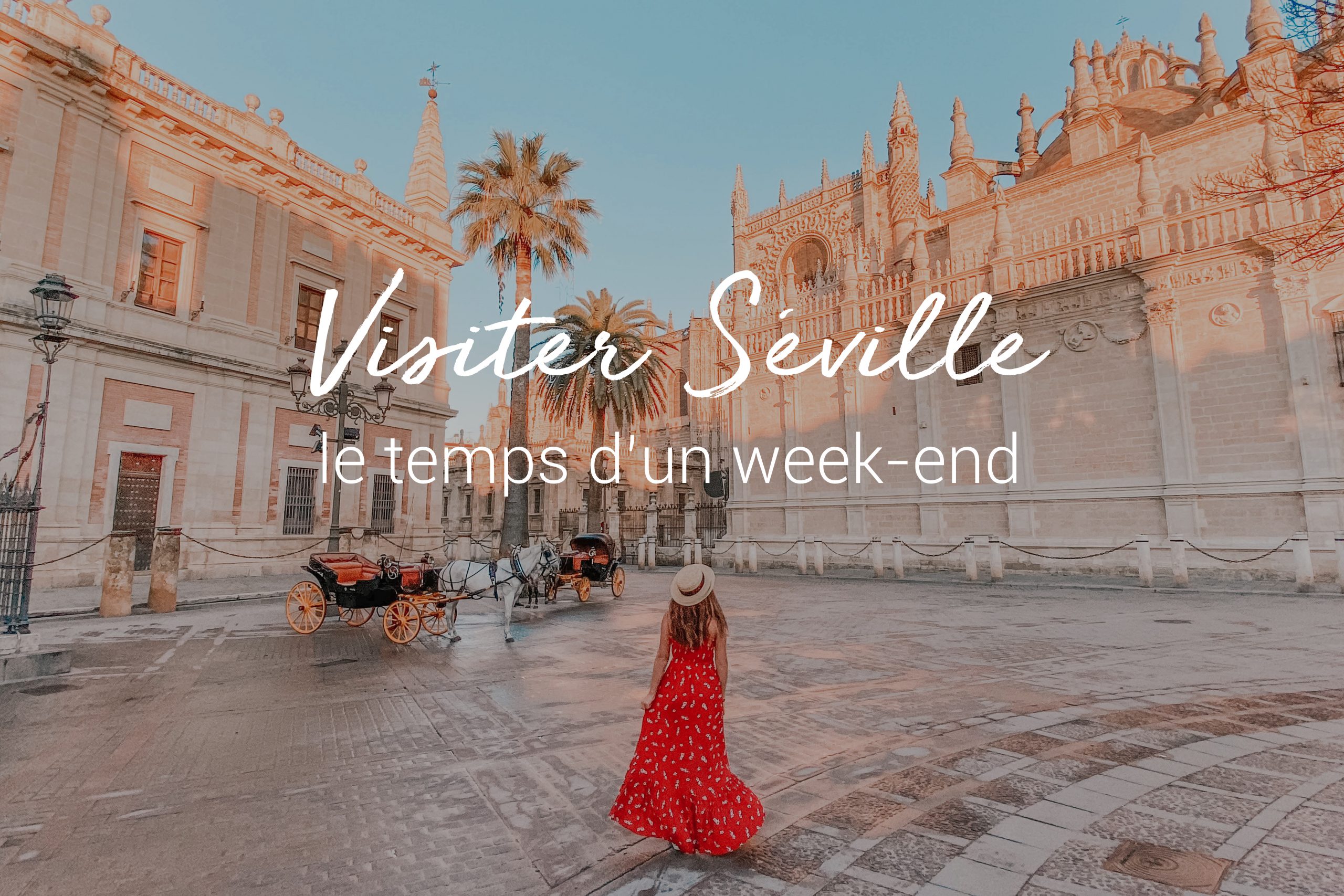
Que faire à Séville ? Notre itinéraire de 3 jours
Séville est une ville pleine de charme, avec de nombreux monuments à visiter et une ambiance espagnole comme on l’aime. Comment visiter Séville en 3 jours ? Nous vous proposons un itinéraire détaillé pour découvrir que faire à Séville !
Voyage à Séville pour le week-end : que faire ?
Comment préparer son voyage à séville .
Quel budget prévoir pour visiter Séville en 3 jours ? Faut-il acheter des tickets en ligne pour visiter les monuments incontournables ? Où se loger à Séville ? Comment aller à Séville centre depuis l’aéroport ? Nous vous donnons toutes les réponses pour organiser au mieux votre séjour . Vous avez juste à aller lire notre article avec toutes les Informations Pratiques !
Où dormir à Séville ?
- Dans le centre historique : appartement Le Feria Pool & Luxury ( cliquez ici pour réserver ) Situé en plein centre-ville, nous recommandons vivement cette adresse. L’accueil est top, nous avons pu tout faire à pied. En plus de cela, v ous pourrez profiter d’un rooftop avec piscine ! Prix : entre 50 et 100€ la nuit selon la période.
- Logement à moins de 50€ la nuit : le Hostal Museo : l’un des moins chers du centre-ville avec d’excellents avis et une terrasse sur le toit !
Haut de gamme : Le Cathedrale Apartment : Pour se faire plaisir ou pour une occasion spéciale, offrez-vous une magnifique piscine sur le toit donnant sur le clocher de la cathédrale !
✈️ Où prendre son billet d’avion ?
Pour trouver de bons prix sur nos billets d’avion, nous utilisons toujours le comparateur Ulysse (bénéficiez de 10€ de remise sur votre première réservation avec ce lien ). Nous avons écrit un article dédié à ce sujet avec plus d’informations.
- Pour réserver votre parking à l’aéroport : Vous pouvez économiser 10% sur votre réservation en passant par OnePark .
Que faire à Séville pendant 3 jours ?
Rentrons dans le vif du sujet ! Nous allons vous dévoiler notre itinéraire pour visiter Séville en 3 jours .
Et si vous êtes plus adepte des visites guidés, et que vous souhaitez en apprendre plus sur Séville et son centre historique : ce free tour de la ville devrais vous intéresser.

Jour 1 : découvrir la vieille ville de Séville
Si l’horaire d’arrivée de votre vol le permet, nous vous conseillons de vous balader dans les petites ruelles de la vieille ville pour vous imprégner de l’ambiance. Pas de visites prévues le jour 1, car il est préférable de les faire tôt le matin avec vos tickets achetés en ligne.
Les alentours de la Cathédrale de Séville :
Au cœur de la vieille ville, la Cathédrale de Séville est le monument le plus imposant du centre-ville. Impossible de le manquer ! Nous sommes tombés sous le charme de cet édifice et avons fait tout le tour pour l’admirer sous différents angles. Les rues adjacentes offrent des magnifiques vues sur La Giralda (clocher de la cathédrale) culminant à 104 mètres de haut.
Point culture : Construite au XVème siècle, sachez que Séville abrite la plus grande cathédrale catholique d’Espagne et l’une des plus grande du monde. Elle mesure tout de même 132 mètres de long et 83 mètres de large. Sa construction a demandé 100 années de travaux… rien que ça !
Las Setas :
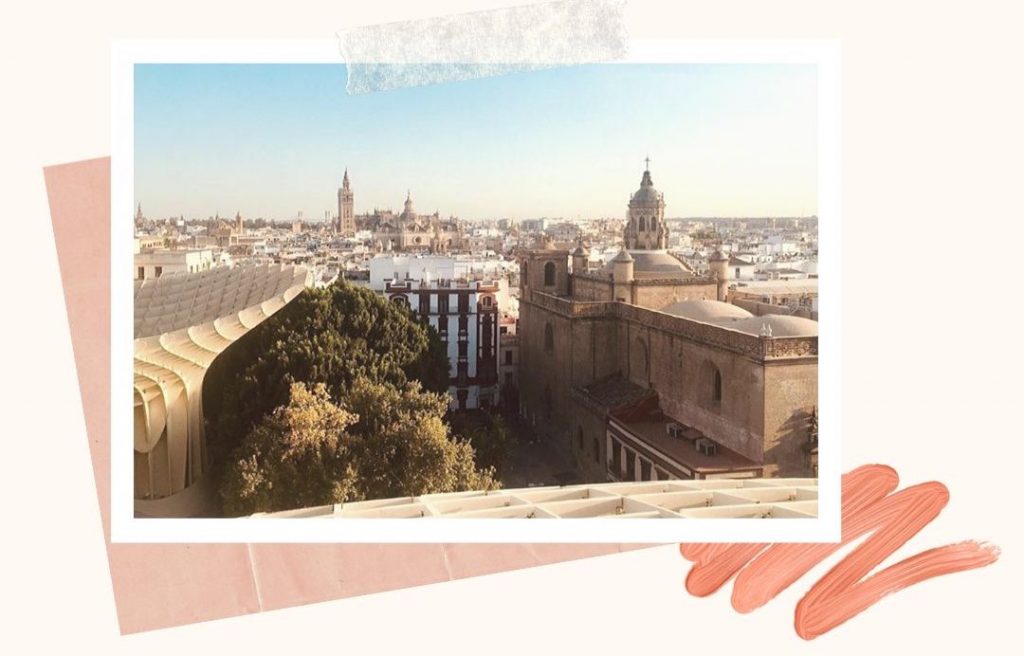
Pura Vida Terraza :
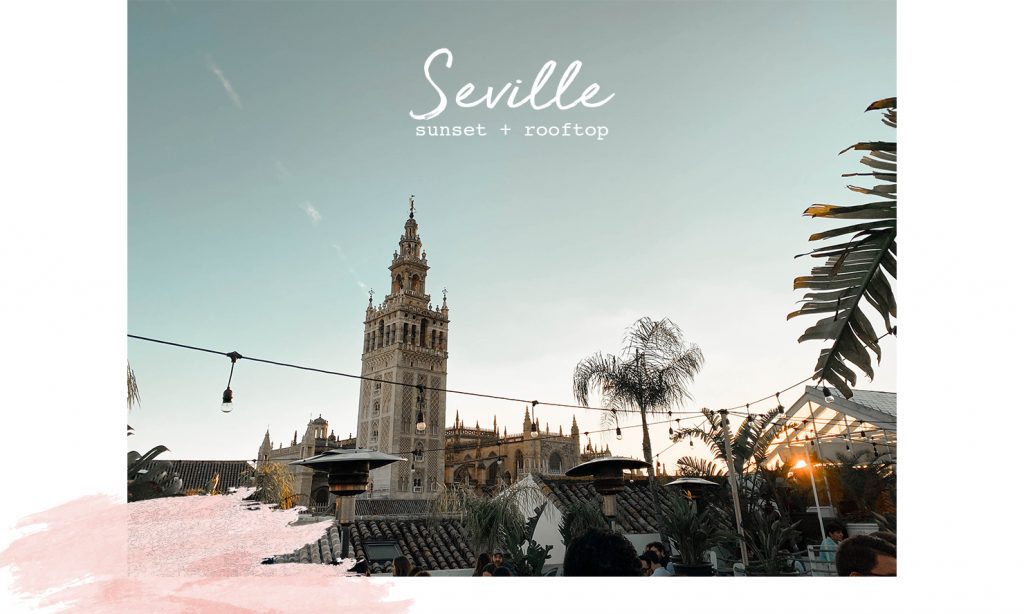
Diner dans l’un des meilleurs restaurants à tapas de Séville :

Pour les questions pratiques : où dormir à Séville , comment venir depuis l’aéroport, le budget etc. Retrouvez les réponses dans cet article ! Nous vous donnons tous nos conseils pour organiser votre voyage à Séville.
Jour 2 : Visite des monuments de Séville
❤️ real alcázar.
Vous allez visiter Séville en 3 jours , vous ne pouvez pas passer à côté de l’Alcázar . Pour cette visite, nous vous recommandons vivement de prendre vos tickets en ligne . Plusieurs options s’offrent à vous :
- un ticket d’entrée simple : à réserver sur ce site .
- un ticket d’entrée avec un guide : réservation ici . On vous conseille cette option, on a regretté de ne pas avoir eu d’explications sur le lieu et l’histoire durant la visite.
- un Pass pour plusieurs activités et faire des économies : informations et réservation .
Pour une visite non-accompagnée, prévoyez environ 2h sur place . Le lieu est immense et tout est photogénique. L’idéal est de choisir le premier créneau au moment de la réservation (9H30-10H). Ainsi, vous profiterez du lieu sereinement. En effet, nous avions l’impression d’être seuls pendant la première heure, alors que nous étions déjà plus d’une centaine dans la rue avant l’ouverture.
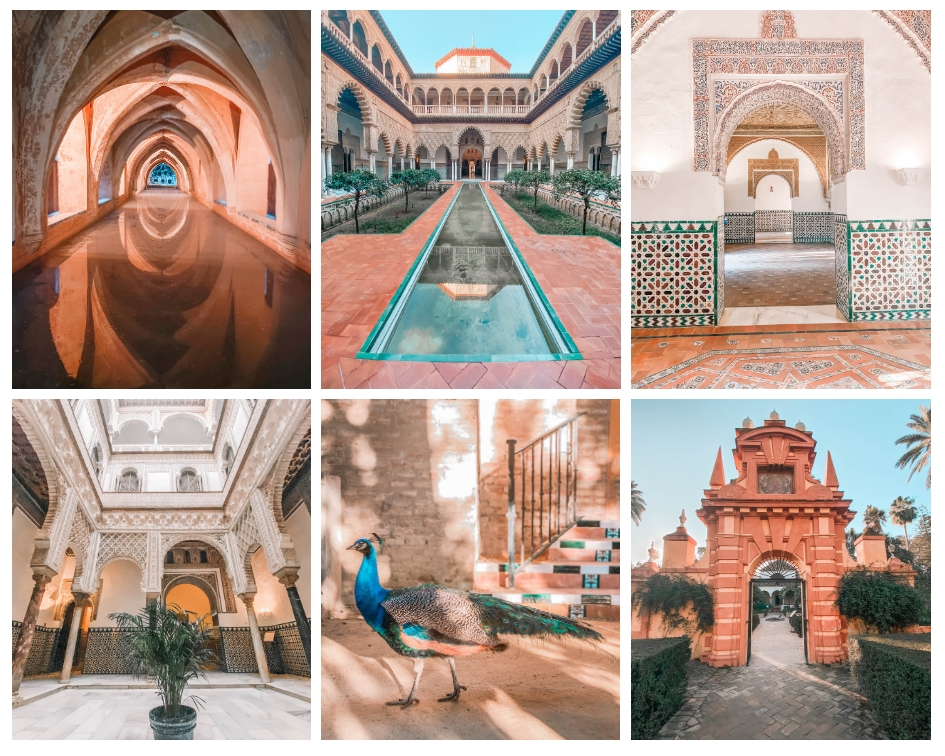
Brunch / déjeuner healthy chez Jester
Après une belle visite, direction Jester pour reprendre des forces. Nous avons passé un super moment dans ce café, tout était excellent et l’acceuil est top. Nous y sommes allés vers 11 heures pour brancher. Au menu : on a choisi deux délicieux bagels, un açai bowl, deux jus et du banana bread !
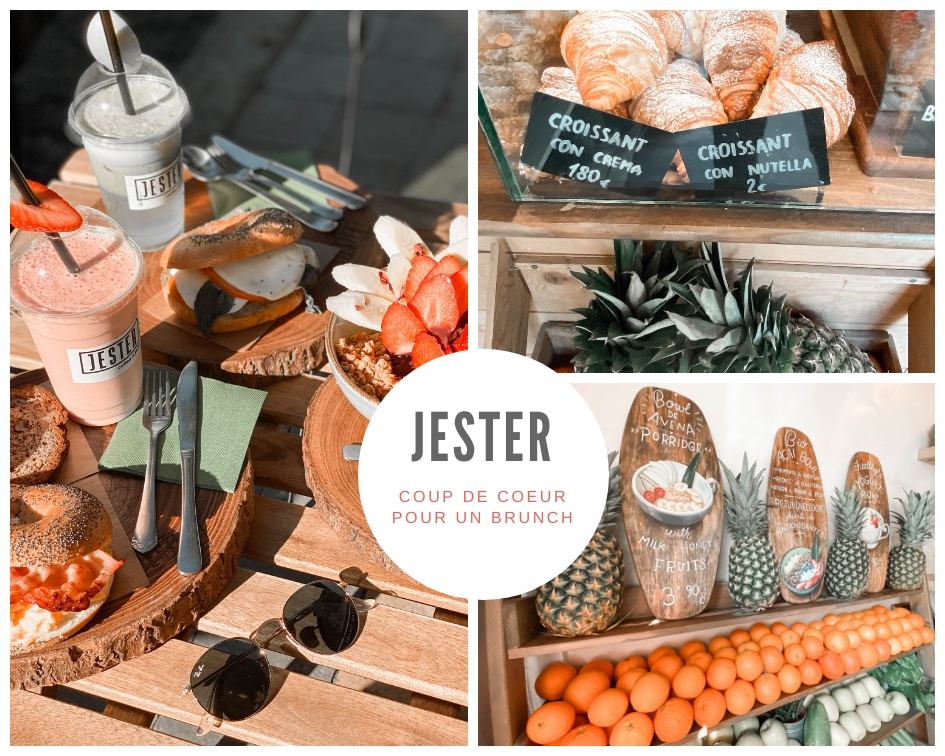
Torre del Oro
Cette tour d’observation militaire, construite au XIIIème, siècle se situe sur les quais au sud de la vieille ville de Séville . Vous pouvez visiter la Torre del Oro et contempler la vue depuis son sommet (prix: 3€). De là-haut, il est possible d’admirer la Cathédrale de Séville, le fleuve et le quartier de Triana.
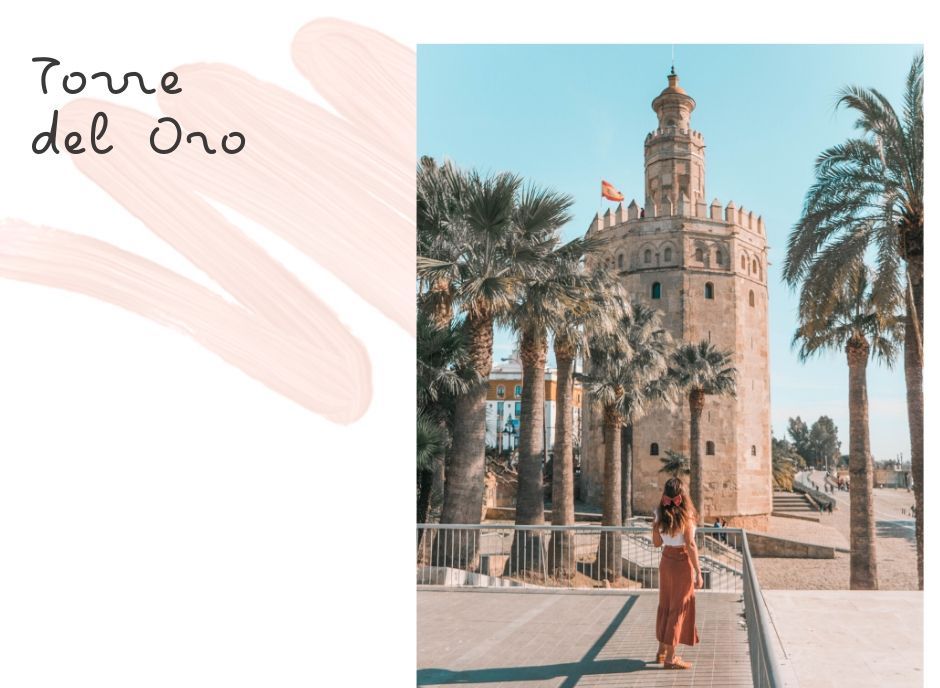
Croisière sur le fleuve Guadalquivir
Le temps nous a manqué pour faire cette activité mais de nombreuses personnes nous l’ont recommandée. Aucun doute, nous le ferons la prochaine fois. L’idéal est de faire la croisière après la Torre del Oro ! Trois options se présentent à vous :
- Pour les sportifs : balade d’1h en kayak, réservation ici
- Pour ceux qui aiment prendre le temps : 3h sur un yacht de 20 mètres avec du vin et des spécialités ibériques, prix et réservation
- Une visite rapide : 1h de balade en bateau avec un pont panoramique, billets ici
Spectacle de flamenco
Assister à un spectacle de Flamenco est un des incontournables d’un voyage à Séville . En effet, la danse et le genre musical qui l’accompagne ont vu le jour au XVIIIème siècle en Andalousie. Séville est donc la capitale du flamenco !
Nous vous conseillons de réserver en avance pour être certain d’avoir vos places. Voici deux options :
- Spectacle de Flamenco au musée du Flamenco . Le lieu est magnifique et 3 horaires sont proposés chaque jour (17h, 20H45 et 22h15) – Prix : 22€ – Réservation ici
- Spectacle de Flamenco dans le quartier typique de Triana . Vous aurez également le droit à une boisson (bière, vin ou sangria). Fermé le lundi, vous pouvez choisir parmi 3 horaires les autre jours (18h30 / 20H30 et 22H30) – Prix : 25€ – Réservez votre place

Dîner dans le quartier Alfalfa
Si vous êtes à la recherche d’un lieu authentique dans un quartier animé, vous pouvez faire confiance au Bar Alfalfa . Nous avons eu un gros coup de cœur pour cette adresse ! La nourriture est excellente et l’ambiance très chaleureuse. De plus, le rapport qualité-prix est top. Seul petit bémol : il n’y a pas de terrasse.
N’hésitez pas à tester d’autres adresses du quartier, suivez votre intuition. Nous avons fait un barathon dans plusieurs adresses à tapas… on a passé une très bonne soirée !
Que faire à Séville : suite et fin de l’itinéraire
Jour 3 de votre voyage à séville, place d’espagne.
Si vous visitez Séville en 3 jours , vous devrez consacrer une partie d’une matinée à la place d’Espagne . Elle est magnifique ! C’est un des lieux les plus touristiques de la ville et on comprend pourquoi.
Nous l’avons découverte une fois en pleine journée et une fois le matin assez tôt. On vous conseille vivement de visiter la place d’Espagne le matin pour être plus tranquille. Vous aurez une magnifique lumière sur les bâtisses.
Conseil : faites un tour de barque sur le petit canal qui fait le tour de la place d’Espagne ! Encore une fois, c’est plus agréable le matin. Le canal est assez petit et ce n’est pas top de naviguer quand il y a trop de barques en même temps. Cette activité ne coûte que 6€ par bateau pour 30 minutes et offre de beaux points de vue.
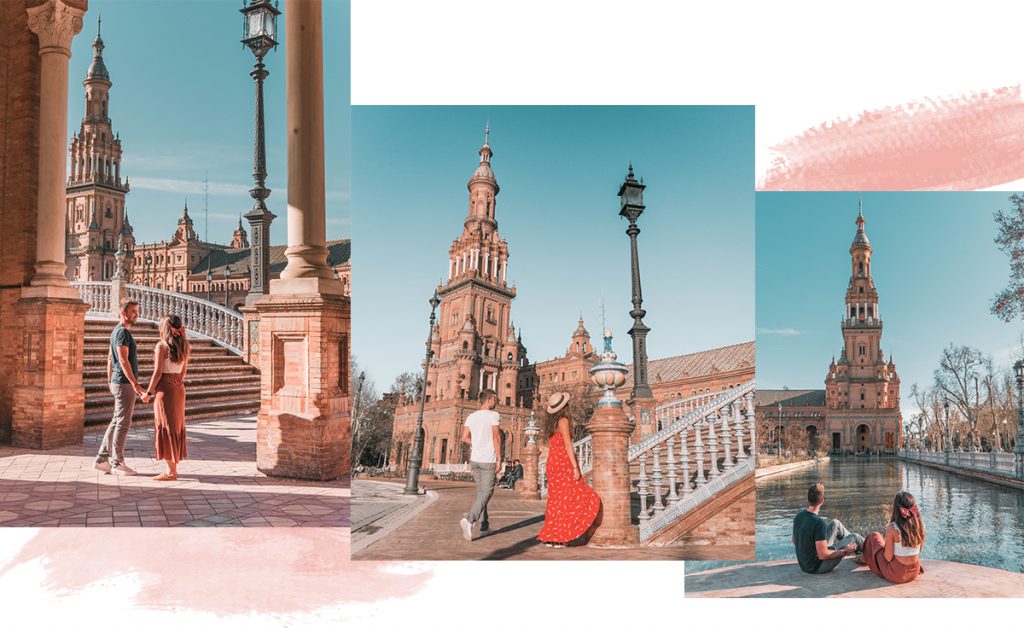
La Casa de Pilatos
Nous avons voulu visiter la Casa de Pilatos un lundi en fin de journée, car l’entrée est gratuite pour les européens. Cependant, l’attente fût très longue. Si c’était à refaire, nous préférerions payer 12€ chacun plutôt que d’attendre 1h30. Ce prix comprend uniquement la visite du rez-de-chaussée. Vous pouvez visiter le premier étage moyennant un supplément, mais il ne nous semblait pas intéressant.
D’après plusieurs témoignages, il est préférable d’y aller en fin de journée pour ne pas faire la queue. À noter : cet endroit est similaire à Alcázar , en moins beau et beaucoup plus petit.
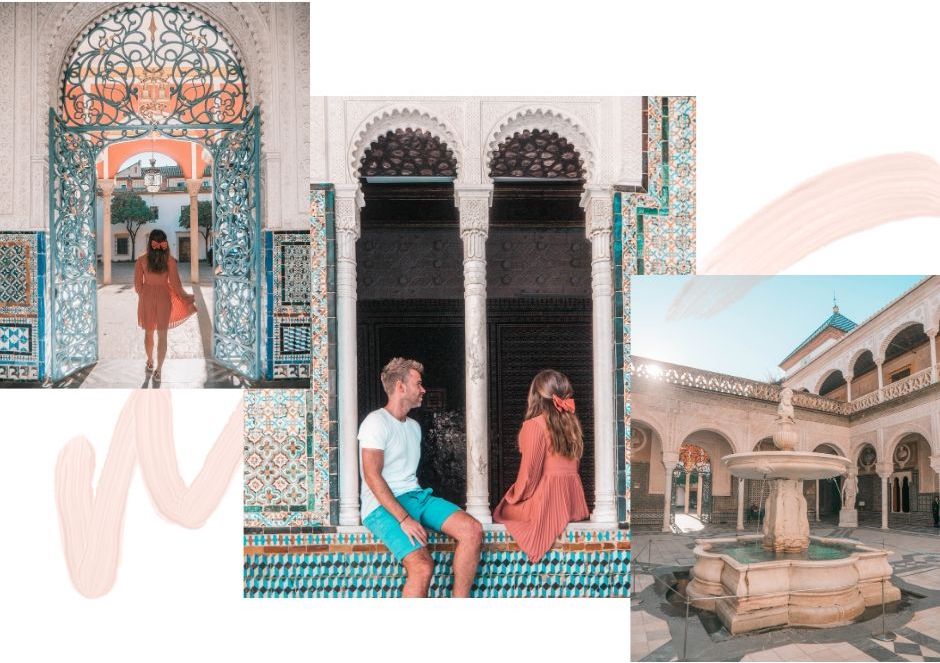
Visite du musée des beaux-arts
Nous ne sommes pas des grands fans de musée mais celui de Séville possède un jardin magnifique. L’ entrée est gratuite pour les européens et le lieu n’est pas très fréqeunté.
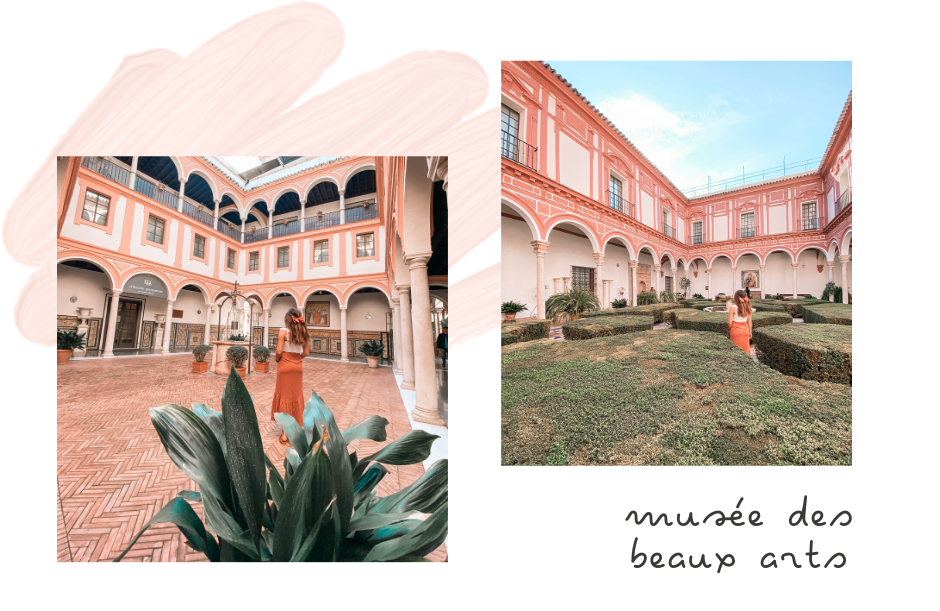
Autres activités sympas pour votre week-end à Séville
S’il vous reste du temps, voici une sélection d’activités à envisager :
- Cours de cuisine andalouse , avec visite du marché couvert traditionnel de Triana
- Visite de la place d’Espagne et des quais en Segway : réservez votre tour ici
- Pour les amateurs de sensations fortes : le saut en parachute : réservez-ici !
- Louer un vélo pour parcourir la ville
- Visite nocturne des meilleures bars à tapas
Voici quelques spécialités culinaires à ne pas manquer lors de votre visite (mise à jour 2023):
Gazpacho : Le gazpacho est une soupe froide à base de tomates, de poivrons, de concombres, d’oignons, d’ail, de vinaigre et d’huile d’olive. C’est une option rafraîchissante, parfaite pour les chaudes journées d’été.
- Salmorejo : Le salmorejo est une autre soupe froide originaire d’Andalousie. Il est plus épais que le gazpacho et est principalement préparé à partir de tomates, de pain, d’huile d’olive, d’ail et de vinaigre. Il est souvent garni d’œufs durs et de jambon ibérique.
- Tapas : Séville est célèbre pour sa culture des tapas. Les bars à tapas proposent une variété de petites assiettes contenant des plats tels que des croquettes, des calamars frits, des olives, des fromages et des fruits de mer. L’expérience de manger des tapas est un incontournable lors d’une visite à Séville.
- Paella : Bien que la paella soit originaire de la région de Valence, elle est largement disponible à Séville et dans toute l’Espagne. C’est un plat de riz cuit avec du safran et garni de divers fruits de mer, de viandes et de légumes. Il existe de nombreuses variations de paella, alors assurez-vous de trouver celle qui convient le mieux à vos goûts.
Pestiños : Les pestiños sont des pâtisseries sucrées originaires de l’Andalousie. Elles sont généralement consommées pendant la Semaine Sainte (Semana Santa) mais peuvent être trouvées dans les pâtisseries tout au long de l’année. Ces petits gâteaux sont frits, puis trempés dans du miel et saupoudrés de sucre, ce qui leur donne une saveur sucrée et délicieuse.
Nous espérons que vous êtes désormais prêts pour votre visite de Séville en 3 jours . Dans l’article Organiser votre voyage à Séville , vous trouverez tous les détails pratiques pour organiser votre week-end à Séville . Nous nous tenons à votre disposition si vous avez besoin d’autres informations ! A très vite !
D’autres idées de week-end en Europe :
Cet article contient des liens affiliés. Si nous vous avons aidé à organiser votre voyage ou que vous souhaitez simplement nous soutenir, pensez à réserver vos activités et hôtels à Séville en cliquant sur nos liens . Nous toucherons une petite commission et le prix reste inchangé pour vous bien évidemment. 🤍
Further Reading...

Itinéraire de 2 semaines au Costa Rica

Que faire à Paros en 3 jours ?

Organiser son voyage à Bali : Informations Pratiques
Merci pour les infos ! En revanche je pense qu’il y a erreur sur les spécialités culinaires à la fin de larticle ^^
Amoureux du Monde
Avec grand plaisir ! Merci à toi pour la remarque, je viens de faire la modification 😀
La Parenthèse niçoise
J’ai eu la chance d’y aller il y a un an et je retrouve totalement l’ambiance et la beauté de Séville à travers votre article et les photos ! ? Un vrai coup de cœur pour cette ville ! Merci pour cet article très complet ?
Merci beaucoup ! ?
Merci pour cet article j’y vais en mars pour 4 jours, ça permet d’avoir une idée de l’organisation 🙂
Merci Nathalie ! Bonne découverte 🙂
Yolanda Perez
Magnifique article !! ? Nous y sommes allés 5 jours en avril 2018 et sommes tombés amoureux de cette merveilleuse ville et ce, malgré 3 jours de pluie sur les 5 ??? C’est une ville à taille humaine avec des monuments historiques, plus impressionnants les uns que les autres, à chaque coin de rue. Les sévillans vous accueillent les bras ouverts et vous transmettent une joie de vivre inégalable ?? Nos filles, âgées alors de 7 et 12 ans, ont été émervéillées par cette ville et nous ont fait promettre d’y retourner. On y retournera une fois pendant “La Feria de abril”, une des plus grandes manifestations populaires qui se déroulent tous les ans en Espagne.
Merci Yolanda ! Nous sommes contents de lire que vous avez aimé Séville. Nous avons adoré l’ambiance et l’accueil chaleureux des habitants également ? J’espère que vous pourrez y retourner en famille très bientôt.
Bonne journée
Leave a Reply Cancel Reply
Save my name, email, and website in this browser for the next time I comment.
Ce site utilise Akismet pour réduire les indésirables. En savoir plus sur comment les données de vos commentaires sont utilisées .
Préparer votre voyage à Séville
Road trip - voyage au maroc.
Article mis à jour le 22 avril 2024 par Amoureux du Monde
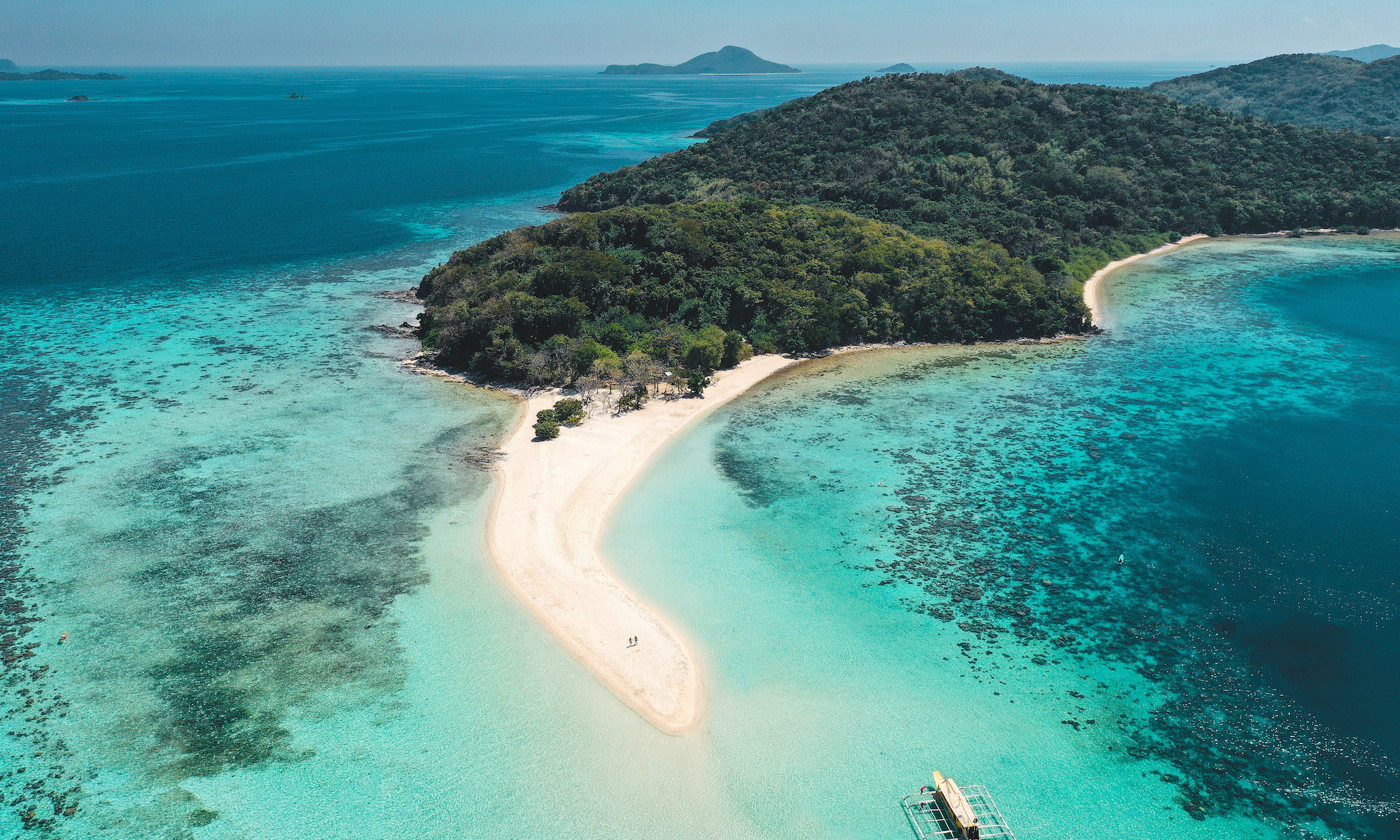
On met les voiles | Blog voyage en France et autour du monde
Blog voyage | Conseils pour voyager, photographie de voyage et vidéo de voyage
- Espagne , Europe
Visiter Séville en 3 jours: les 9 lieux incontournables à faire
Visiter Séville est une expérience géniale. Car c’est l’une des plus belles villes d’Europe. C’est mon avis, mais je pense que beaucoup de monde partage ce ressenti. Les ruelles authentiquement andalouses ou la vie animée avec les restaurants et les bars y font pour beaucoup dans la renommée de Séville, notamment pour le tourisme.
Que dire de l’Alcazar? Ce magnifique palais inscrit au patrimoine mondial de l’Unesco… Ou encore la cathédrale et la Giralda, héritée de l’époque musulmane. Sans oublier les nombreux palais disséminés un peu partout dans Séville, ou encore la célèbre place d’Espagne, la Torre del Oro…
Bref, tous ces éléments en font une destination idéale pour un week-end entre amis ou en amoureux , et que vous souhaitez visiter Séville en 2, 3 ou 4 jours. Vous vous demandez que faire à Séville et que visiter? Alors vous trouverez dans cet article de blog un programme complet pour visiter Séville en 3 jours, avec 9 lieux incontournables à voir absolument.

Par ailleurs, j’ai un bon plan pour vous. Sachez, pour vos visites, que la majorité des sites touristiques de Séville (Alcazar, cathédrale, Las Duenas…) proposent des entrées gratuites le lundi, en fin de journée. N’hésitez pas à aller sur les sites officiels pour en savoir plus.
Visiter Séville: Jour 1
La cathédrale de séville et la giralda.
Pour ce premier jour à Séville, direction la Cathédrale Notre-Dame du Siège et la Giralda . Certainement l’un des incontournables de Séville pour le tourisme, avec l’Alcazar (dont je parle un peu après).
Située au centre, la cathédrale Séville est impressionnante de par son architecture et sa taille. Elle est même classée au patrimoine mondial de l’Unesco!
Sur place, impossible de louper la Giralda, l’ancien minaret de la mosquée préexistante, devenue un clocher. La Giralda s’élève très haut dans le ciel andalou, à plus de 100 mètres. Si haut, qu’il est évidemment possible d’y monter pour admirer le panorama.

Pour visiter la cathédrale et voir la Giralda, vous pouvez réserver sur le site officiel ici . Attention aux horaires car les heures d’ouverture et de fermeture varient en fonction des jours de la semaine.
Le bon plan: le lundi, à certaines périodes, la visite est gratuite entre 16h30 et 18h (mais le nombre de places est limité à 50). Infos et renseignements sur le site de la cathédrale .
Le quartier de Santa Cruz
C’est en quelque sorte le centre historique de Séville. Il se trouve autour de la cathédrale et de l’Alcazar, là où se trouve la majorité des restaurants pour touristes.

Ce quartier est célèbre pour ses petites rues charmantes, ses églises mais aussi ses places comme la place de Santa Cruz ou encore la Plaza de Cabildo, proche de la cathédrale et un peu cachée… Un bon résumé de ce qu’est Séville en quelques pas seulement.
Visiter l’Alcazar de Séville
L’Alcazar est le lieu incontournable pour lorsqu’on vient en Espagne pour visiter Séville . C’est le lieu ne pas manquer sous aucun prétexte. À l’image de l’Alhambra à Grenade par exemple, en Andalousie, dont je vous parle dans un autre article.
Comme moi, il y a de fortes chances que soyez émerveillé par l’Alcazar, ce palais dont l’architecture témoigne de l’évolution de la ville et de ses influences, depuis la domination arabe, en passant par le Mudéjar, la Renaissance ou le Baroque.

Entre ses jardins, ses plafonds magnifiques, ses cours superbes, vous en prendrez plein les yeux. Ce n’est d’ailleurs par pour rien que des séries comme Game of Thrones y ont tourné plusieurs scènes.

Malheureusement, l’Alcazar est forcément victime de son succès . La foule peut y être nombreuse, notamment le matin avec des groupes de touristes. Je vous conseille donc de réserver à l’avance sur le site officiel . Ceci afin de ne pas faire la queue pour acheter les billets et de plutôt prendre un ticket pour l’après-midi.

Visiter Séville : Jour 2
Voir le palacio de las duenas.
Le palacio de Las Duenas n’est pas le lieu le plus connu, mais je vous le conseille particulièrement si vous venez visiter Séville en 3 jours. Alors certes, le prix d’entrée est élevé (10€) par rapport à la taille du lieu, mais la beauté du palais vaut le déplacement.

Les cours, notamment, sont magnifiques entre les couleurs, les hauts palmiers ou encore l’architecture remarquable. De plus, lorsque j’y suis allée un après-midi d’octobre, il y avait quasiment personne à l’intérieur. Et on peut dire que c’est plutôt agréable quand on voit la foule à l’Alcazar ou à la place d’Espagne…

La plaza de Espa ñ a ou place d’Espagne
La place d’Espagne justement, est un autre lieu incontournable si vous découvrez Séville en 3 jours. Construite en 1929 pour l’exposition hispano-américaine, la Plaza de Espa ñ a est connue en particulier pour ses bancs en céramique, représentant 48 des 50 provinces espagnoles. Vous passerez peut-être de longues minutes à trouver chacune d’elles!

Cette place immense (la superficie est de 50 000m2 avec le palais), est très agréable avec ses quatre ponts qui passe au dessus du canal. La balade peut se poursuivre sous les magnifiques galeries couvertes du palais, qui donnent de belles perspectives. Ne manquez pas, pour finir, la jolie fontaine, au centre de la place d’Espagne.

À noter que la place d’Espagne se trouve un peu à l’écart du centre historique et de la cathédrale, vers le sud de Séville. Comptez entre 15 et 20 minutes de marche depuis la cathédrale.
Le parc Maria Luisa de Séville
Le parc Maria Luisa est intéressant car il se trouve juste à côté de la place d’Espagne. Et comme vous avez certainement un peu marché pour venir jusque-là, autant en profiter pour découvrir ce parc.

Il peut constituer une halte très agréable, qui plus est lorsque les températures sont élevées (ce qui n’est pas rare à Séville). Les fontaines et les plantes sont très jolies, alors que les bancs sont une invitation à l’observation des nombreux oiseaux qui colonisent le parc Maria Luisa.

Enfin, si vous en avez le courage, marchez jusqu’à l’extrémité sud du parc, où se trouve le musée archéologique de Séville. Si vous n’avez pas le temps ou l’envie de le visiter, l’extérieur mérite un petit détour (photo ci-dessus à droite)!
Visiter Séville : Jour 3
Le metropol parasol ou las setas (les champignons).
Le Metropol Parasol est l’une des nouvelles « attractions » de Séville pour le tourisme. En effet, sa construction est très récente puisque cette structure en bois a été inaugurée en 2011. Surnommé las setas (les champignons), pour sa forme originale, le Metropol Parasol recouvre la place de la Encarnacion-Regina.

Cette oeuvre a permis de réhabiliter la place, où l’on trouve désormais nombre de commerces et de cafés. Avec sa hauteur de 28 mètres, le Metropol Parasol offre une vue superbe sur la ville de Séville. L’accès est payant (3€). À noter qu’il existe aussi un bar au sommet (je vous en parle dans mon article sur les bonnes adresses de Séville ).

La Torre del Oro
La Torre del Oro n’est, certes, pas le plus impressionnant monument de Séville. Mais cette tour mérite d’être vue selon moi. Déjà, de par son histoire… Car à l’origine, la Torre del Oro était une tour d’observation militaire, construite au XIIIe siècle pendant la domination Almohade.
Érigée en bordure du canal Alfonso XIII (l’ancien tracé du fleuve Guadalquivir), la Torre del Oro permettait de contrôler l’accès à la ville. Aujourd’hui, elle abrite un musée maritime, qui ravira les passionnés d’histoire.

Sinon, pour les amoureux de belles images, je vous conseille vivement d’y venir au moment du coucher du soleil. La lumière y est vraiment splendide!

Non loin, se trouve aussi la Maestranza, les arènes de Séville. Même si vous n’aimez pas la tauromachie, vous pouvez y faire un saut pour admirer sa magnifique façade.
Dans le même secteur, de l’autre côté du canal, se trouve aussi le quartier de Triana, authentique et animé.
Que faire à Séville? Découvrir ses places et ses églises
Si vous prévoyez de passer vos prochaines vacances à Séville, et qu’il s’agit d’une première, vous risquez d’être ébahis par la multitude d’églises présentes dans la ville!
Il y en a à tous les coins de rue, aussi belles les unes que les autres. Et l’on pourrait dire la même chose des places, où se retrouvent à n’importe quel moment de la journée les Sévillans pour boire un verre et parler.

La liste des édifices religieux est interminable. Citons la basilique de la Macarena à Séville (oui comme la chanson), par exemple. Ou encore l’église del Salvador, proche de la place de la Alfalfa, dans un quartier sympathique.
Ou encore la très jolie place San Lorenzo et l’église éponyme, à la façade rouge. Sans oublier la basilique Jesus del Gran Poder (et oui ils ne font pas semblant pour les noms!). Bref, vous l’aurez compris, les églises et les jolies places ne manquent pas, et même plus qu’ailleurs en Espagne!

Où sortir le soir à Séville ?
Vous vous demandez où sortir à Séville pour manger ou boire un verre? Alors je serais tentée de vous dire dans toute la ville! Tellement les adresses de restaurants et de bars branchés (ou plus traditionnels) sont nombreuses.
Pour les plus jeunes, foncez dans le quartier de l’Alameda, où les bars le long de la promenade d’Hercule sont nombreux, tous en terrasse (ou presque)! Vous trouverez quelques adresses dans les rues alentours aussi, pour les moins jeunes.

Le quartier de l’Alfalfa avec la rue Perez Galdos est aussi bien connue pour sa vie animée. Sinon, je n’ai pas eu le courage d’y aller, mais des Sévillans m’ont parlé des quartiers El Arenal et Triana. Les bars sont visiblement nombreux au bord du canal, en particulier dans la Calle Betis, à Triana.
Sinon, pour manger plus tranquillement, vous trouverez une quantité importante de restaurants dans le quartier de Santa Cruz.
Quel quartier choisir pour dormir à Séville ?
C’est la grande question que l’on se pose lorsqu’on ne connaît pas une ville et que l’on y vient pour du tourisme. Quel quartier choisir, où dormir? Alors, à l’image des bars et des restaurants, il existe plusieurs quartiers sympathiques où loger pendant vos vacances à Séville. À vous de voir si vous optez pour un hôtel ou un appartement en fonction de la durée du séjour.

Le quartier de Santa Cruz : le mieux placé mais le plus cher
Le quartier de Santa Cruz est évidemment l’idéal pour visiter Séville. Notamment si vous cherchez un hôtel ou un appartement à louer dans le centre pendant vos vacances. C’est là, dans la vieille ville, que se situe la plupart des centres d’intérêts, mais aussi nombre de restaurants, de cafés, de boutiques, etc.
Évidemment, ces avantages ont un coût: ce quartier sera donc le plus cher pour dormir à Séville . À vous de voir en fonction de vos exigences en matière de confort et d’emplacement, si vous préférez un hôtel simple mais très bien placé ou quelque chose de plus joli…
- L’hôtel Fernando III : un hôtel très bien placé dans le centre de Séville, avec une magnifique vue depuis la piscine sur le toit et des chambres très jolies… Si vous voulez en voir plus, c’est ici . En réservant un peu à l’avance, vous obtiendrez un prix raisonnable pour les prestations de l’établissement.

- Si vous cherchez un appartement, je vous conseille par exemple celui-ci. Il est particulièrement bien placé, en plein centre de Séville, l’intérieur est bien décoré et le prix n’est pas excessif . Vous pourrez trouver d’autres logements car le choix ne manque pas dans la ville andalouse.

Alfalfa et El Arenal : proche du centre et moins cher
Ces deux quartiers se situent à proximité du centre de Séville, à quelques minutes de marche de Santa Cruz et de la cathédrale. L’Alfalfa se situant juste au nord du quartier de Santa Cruz autour de la Casa de Pilatos, alors qu’El Arenal se trouve de l’autre côté, près du canal et des arènes.
Les deux quartiers sont plutôt sympathiques et un peu moins cher que les établissements de Santa Cruz.
Exemple de logement à l’Alfalfa :
- Un appartement idéalement placé avec des espaces intérieurs vraiment très beaux. Un logement parfait si vous restez au moins deux nuits, avec, là-encore, un prix plutôt correct ( voir ici pour les détails ).

Exemple de logement à El Arenal :
Du côté d’El Arenal et de la Maestranza (les arènes de Séville), vous trouverez également des appartements ou des hôtels intéressants. J’ai sélectionné un appartement que je trouvais vraiment très beau.
- Il s’agit du Slow Suites Maestranza , avec de belles chambres et un petit bassin sur le toit! Il est idéalement situé.

Alameda : un bon compromis entre emplacement et coût
Personnellement, c’est dans ce quartier que j’ai dormi lorsque je suis venue en octobre dernier pour du tourisme. Je suis restée 2 semaines, donc j’étais à la recherche de location à prix doux. Et j’ai trouvé ce quartier vraiment parfait: il y a pas mal de commerces, d’animation près de la Alameda, et le centre est facilement accessible à pied en à peine 15-20 minutes.
- Sur la Alameda de Hercules, voici un petit boutique hôtel très sympa, avec un superbe patio, des chambres décorées avec goût. Le tout à moins de 100€ la nuit. Plus de détails ici .

- À noter aussi que si jamais vous venez en famille ou entre amis, l’option de l’appartement peut être particulièrement intéressante, comme ce logement avec deux chambres , à un prix correct.

Ensuite, libre à vous d’opter pour les quartiers de Triana ou de la place d’Espagne. Les tarifs seront peut-être moins élevé, mais vous serez bien moins placé puisque la cathédrale et les rues animées seront à plus de 20-25 minutes de marche, voire plutôt 30 minutes. De plus, le quartier de la place d’Espagne manque cruellement de bars et restaurants.
En revanche, si Séville constitue une étape dans un road-trip en Andalousie, je vous propose quelques logements vraiment canons dans mon article sur les bonnes adresses. Des locations de maisons typiquement andalouses à moins de 1 heure de Séville.
Quelle est la meilleure période pour visiter Séville ?
Par expérience, je dirais qu’ il faut surtout éviter de visiter Séville l’été (notamment juillet-août). Les touristes sont nombreux, et, surtout, la chaleur est étouffante! Vraiment, il devient difficile de sortir avant 18 heures, même si la ville a placé des genre de draps au dessus des rues commerçantes pour faire de l’ombre.
Donc, si vous le pouvez, je vous conseille donc vraiment d’y aller au printemps ou en automne . Je suis partie visiter Séville la dernière fois début octobre et c’était tout simplement parfait. J’étais en short et débardeur la journée et j’avais un tout petit gilet le soir. L’hiver, les températures se rafraîchissent un peu mais cela reste très raisonnable.

Pour terminer, si vous aimez Séville ou que l’Andalousie vous intéresse, n’hésitez pas un jeter un coup d’oeil sur mes articles de blog concernant les bonnes adresses à Séville , mais aussi l’Alhambra à Grenade .
Une réponse sur “Visiter Séville en 3 jours: les 9 lieux incontournables à faire”
Ah la belle Séville. J’ai eu un véritable coup de cœur pour cette ville. Son ambiance, son architecture, sa douceur de vivre en font vraiment une superbe ville. Nous y étions mi-février et les températures étaient vraiment clémentes. Une destination à conseiller aussi en hiver 🙂 http://danslavalisedegwen.com/2019/03/09/visiter-seville/
Laisser un commentaire (Ça fait toujours plaisir!) Annuler la réponse.
Aperçu de la politique de confidentialité.
Regroupe les cookies absolument nécessaires pour l'utilisation du site de manière optimale. Cela inclut des cookies qui assurent des fonctions de sécurité ou de connexion au compte. Aucunes données n'est conservées dans ces cookies.
Tous les cookies non indispensables au fonctionnement du site qui collectent via des outils d'analyse votre façon d'utiliser ce site afin d'en améliorer sa qualité.
Bienvenue sur le blog Le Prochain Voyage
Suivez le blog sur facebook .
Le Prochain Voyage sur Twitter
Contactez-moi.
Articles récents
- L’hébergement en plein air 4 et 5 étoiles sur l’île de Ré : une escapade luxueuse au cœur de la nature
- Anniversaire de rêve : les cadeaux pour elle qui marqueront l’événement
- Voyage de luxe au Panama : complexes hôteliers et expériences exclusifs
- Pourquoi faire confiance à une agence de visa voyage ?
- Préparation d’un voyage printemps-été dans les châteaux de la Loire
- Blog voyage
- Récits de voyage en France
- Récits de voyage en Europe
- Récits de voyage en Asie
- Récits de voyage en Afrique
- Tour du monde de Quentin
Mon carnet de voyage à Séville
J’ai eu la chance, courant décembre dernier, de découvrir la jolie ville de Séville. Cela faisait quelques mois que l’idée de passer un long week-end à Séville me trottait dans la tête.
J’avais prévu de partir en septembre, mais j’ai décalé la date et réservé un billet d’avion pour décembre car les prix étaient bien plus intéressants. J’ai trouvé un aller/retour pour environ 80€. D’une manière générale, il est possible de trouver un vol pas cher avec Liligo . Utiliser un comparateur de vol et être libre de choisir ses dates de voyages sont idéaux pour bénéficier des meilleurs prix. Sur cette page, liligo recense les meilleures offres.
Et en ce qui concerne le logement, je l’ai également réservé en avance, dans un hôtel proche du centre, doté d’un joli patio intérieur typique de l’Andalousie. Visiter Séville en décembre est idéal car les températures sont très agréables, et nous n’avons pas eu particulièrement d’attente avant de pouvoir accéder aux principaux lieux d’intérêts.
J’ai beaucoup apprécié la capitale de l’Andalousie, aussi bien pour son ambiance, sa chaleur de vivre, son caractère, ses monuments historiques, ainsi que sa gastronomie. Voici plus en détail mon récit de voyage à Séville.
Jour 1 : arrivée à Séville, spectacle de flamenco
Le jeudi, nous arrivons à l’aéroport de Séville en milieu d’après-midi. Nous prenons la navette qui nous conduit en une petite trentaine de minutes dans le centre de Séville, à proximité du fleuve Guadalquivir. Les ruelles du centre-ville de Séville sont animées. L’architecture des bâtiments est très intéressante.
Nous déposons nos affaires à l’hôtel puis participons en début de soirée à un spectacle de flamenco au Tablao Flamenco El Arenal réservé quelques jours plus tôt sur internet. Le spectacle était très sympa. Une vraie découverte en directe du flamenco, pratiqué par des chanteurs et des danseurs pros. Il faut avouer que le flamenco est assez impressionnant, et intense. Nous passons le reste de la soirée à nous promener dans les ruelles de Séville.
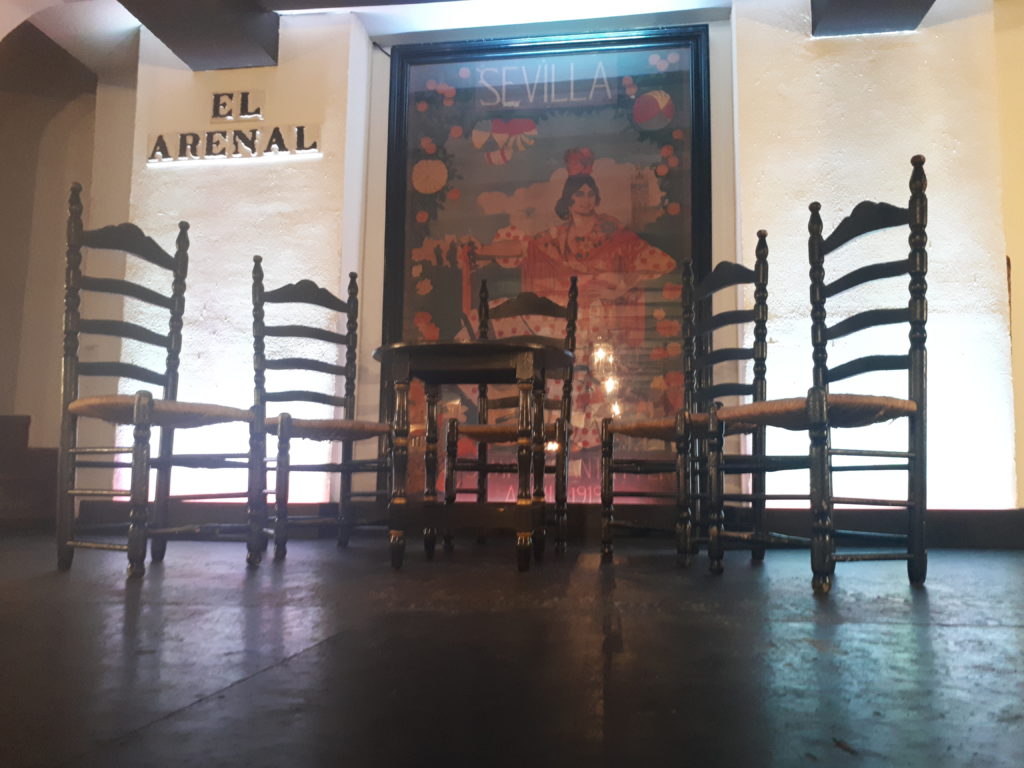
Tablao Flamenco El Arenal – Séville
Jour 2 : visite du centre-ville de Séville, l’Alcazar de Séville, le quartier Santa Cruz, la Cathédrale Notre-Dame du Siège de Séville et la Giralda
Le vendredi, en quittant notre hôtel le matin, nous nous arrêtons quelques minutes pour observer le Metropol Parasol. Cette très grande structure de bois est soutenue par six imposants piliers. L’architecture est très originale, et la vue intéressante depuis les hauteurs.
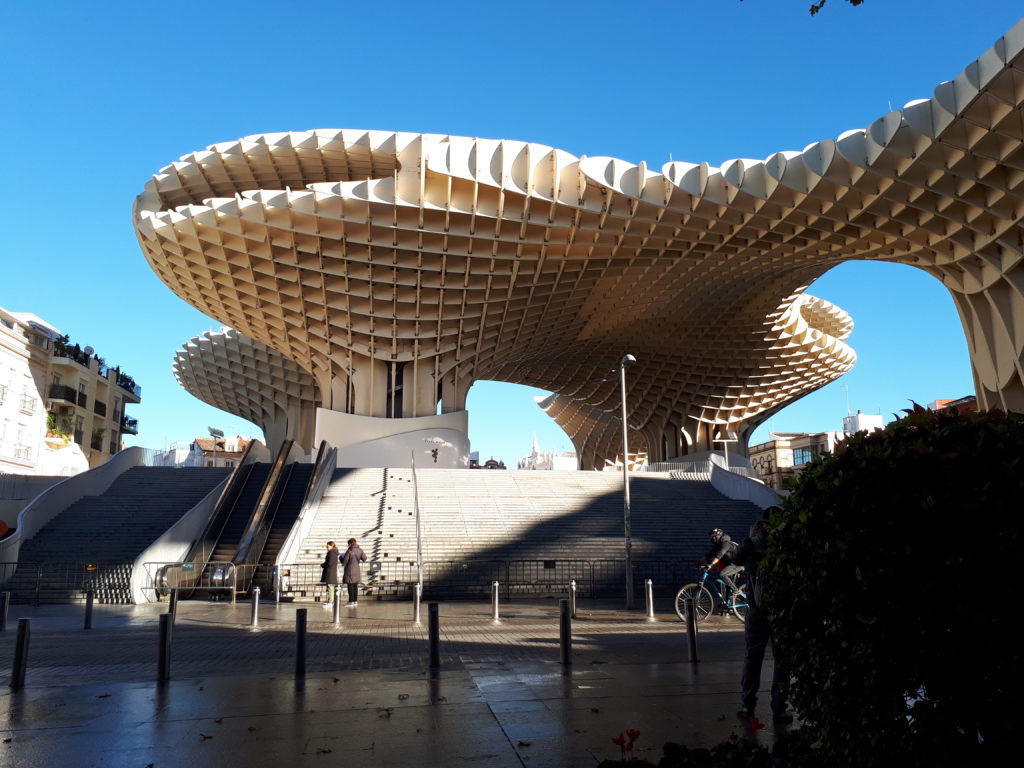
Metropol Parasol – Séville
Nous visitons ensuite l’Alcazar de Séville. Ce palais royal est très beau, et l’architecture intéressante à découvrir. Le mélange des styles permet de bien comprendre l’histoire de Séville, et la succession des civilisations qui y virent. En effet, l’intérieur est un mélange de style mudéjar, gothique, baroque et Renaissance. Les salles sont très bien décorées. Les murs et plafonds sont riches en azulejos, arabesques, céramique, stuc… L’histoire racontée par le guide audio est très intéressante (bien qu’un peu longue parfois). Il faut prévoir 2 bonnes heures sur place, et plus pour ceux qui souhaitent lézarder dans les jolis jardins du palais, à l’ombre des orangers et des arbres centenaires. Un incontournable à visiter à Séville !
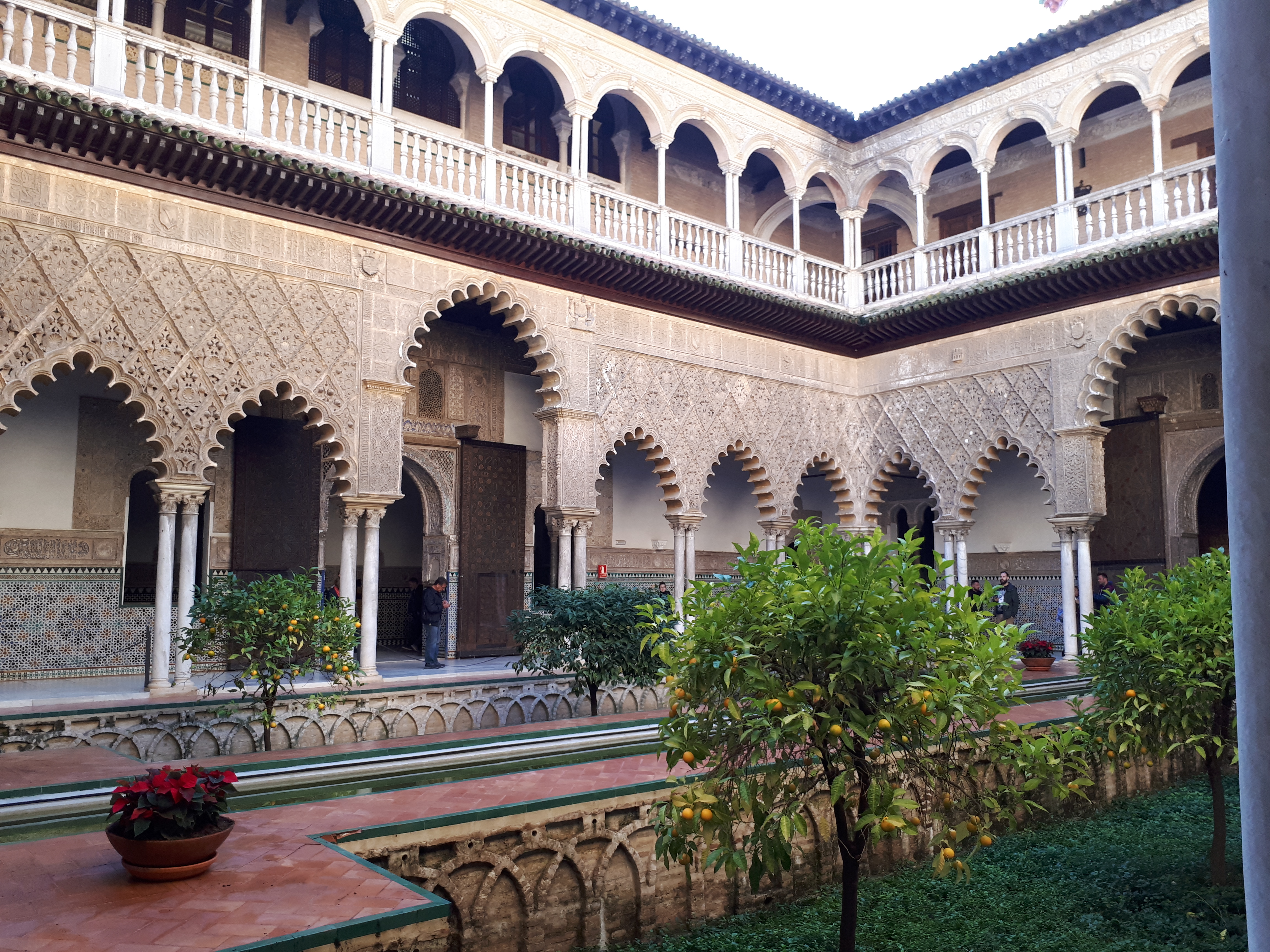
Après avoir mangé des tapas, nous nous promenons dans le quartier historique de Santa Cruz. Les ruelles sont étroites et pavées. Les bâtiments sont d’époque. Le quartier est très agréable pour se promener et observer l’architecture sévillane, ainsi que pour découvrir l’artisanat du coin. Les orangers plantés à chaque coin de rue sont bien garnis et apportent de jolies couleurs orangées à la ville.
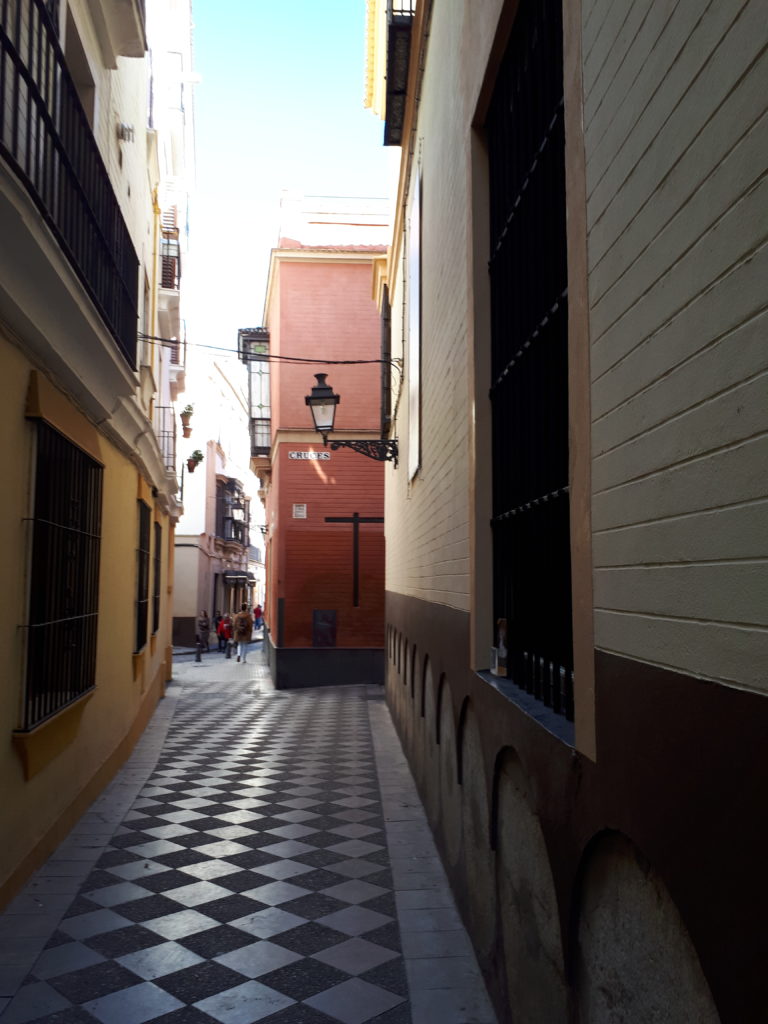
Une ruelle du quartier Santa Cruz – Séville
Nous poursuivons notre chemin puis découvrons depuis l’extérieur l’immense Cathédrale Notre-Dame du Siège de Séville. La cathédrale est de style gothique ; alors que son clocher « la Giralda » est un ancien minaret de style hispano-mauresque. La visite est à faire, aussi bien pour observer la beauté de l’intérieur de la cathédrale, de ses collections de tableaux et d’objets, et de son orgue. Le tombeau de Christophe Colomb est situé à l’intérieur de cette cathédrale. La vue sur la ville de Séville depuis le clocher est très sympa. Attention quand la cloche retentit, ça surprend !
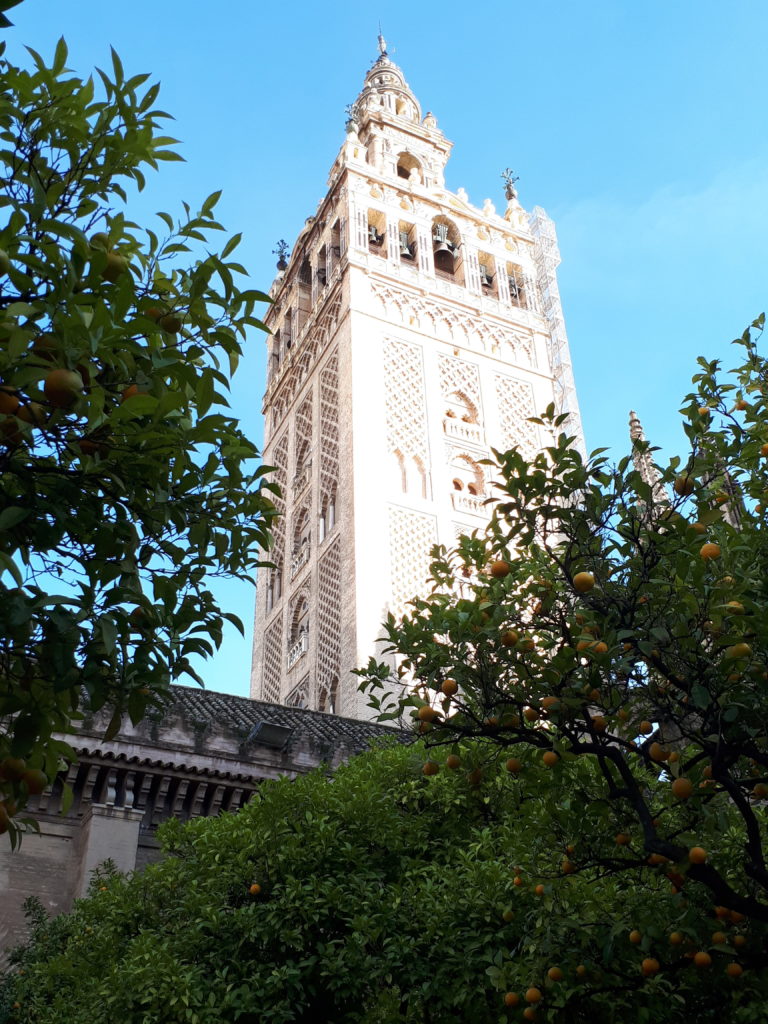
Le soir, nous mangeons (par hasard) des tapas au bar « El Baratillo ». Le rapport qualité/prix est excellent, et l’ambiance est très sympa, à recommander !
Jour 3 : visite de la Place d’Espagne, Torre del Oro, Casa de Pilatos, shopping
Le matin, nous rejoignons la Place d’Espagne. Une belle découverte, la place est très étendue, le bâtiment impressionnant de par sa taille et son architecture. La canal sillonne cette place. On prend le temps de se promener et de prendre quelques photos. Les azulejos des gardes corps des escaliers valent le coup d’œil ! La Plaza de España est un lieu à visiter absolument lors d’un voyage à Séville.
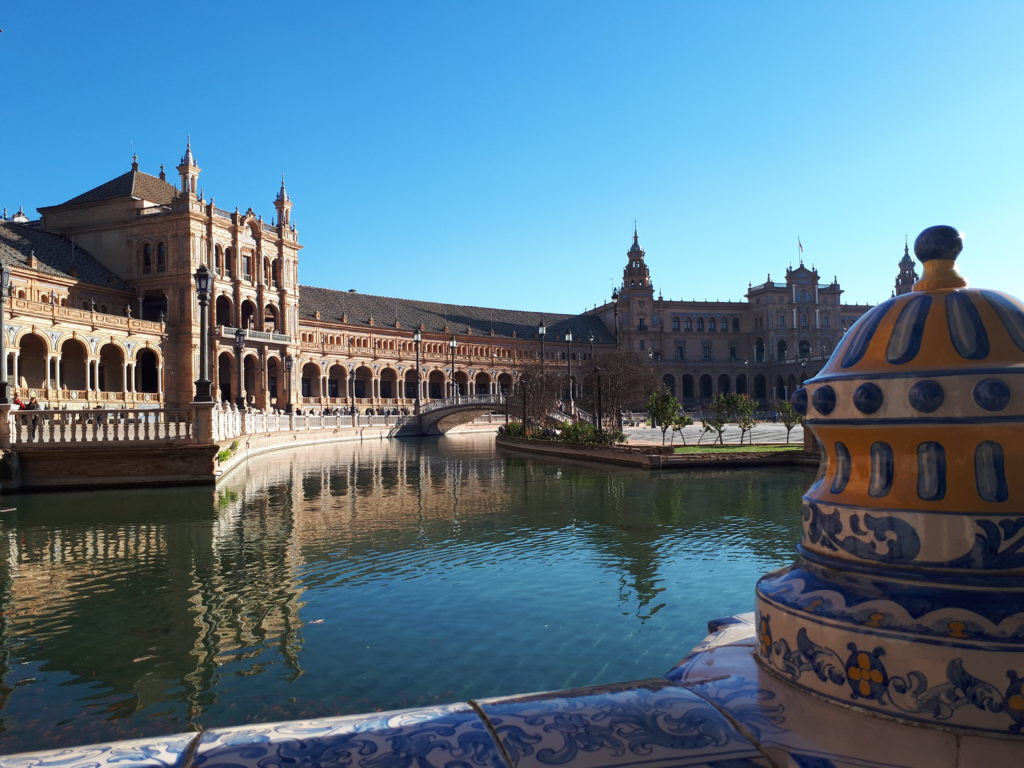
Puis nous rejoignons à nouveau le centre de Séville, et passons par le parc qui longe l’Alcazar. On y observe des oiseaux ainsi qu’une flore « exotique ». Nous faisons ensuite un peu de shopping dans le centre-ville, puis mangeons à nouveau des tapas.
L’après-midi, nous continuons de nous promener au cœur de Séville, à travers les différentes ruelles de la ville. Puis nous visitons la Torre del Oro au bord du Guadalquivir. La vue depuis le haut de la tour est assez sympa (mais pas incontournable).
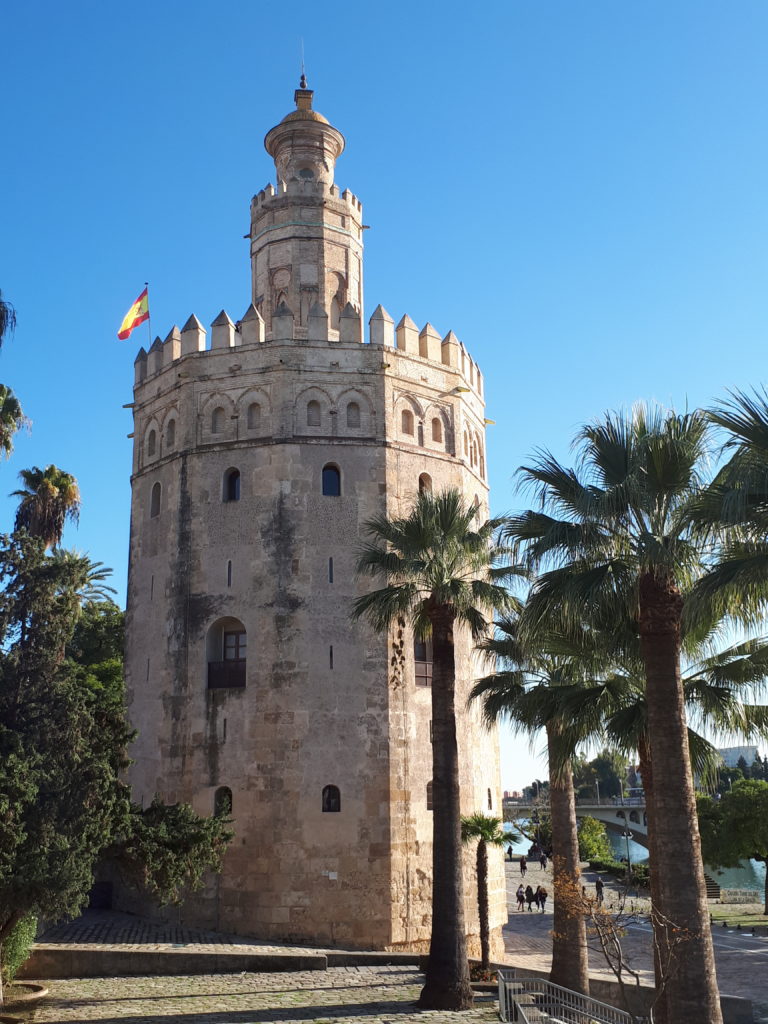
Nous nous dirigeons ensuite vers la Casa de Pilatos. Le lieu est très beau. Cette visite permet de découvrir un très beau palais aristocratique riche en histoire, et à la très belle architecture. En effet, les patios et jardins de style mudéjar, gothique et renaissance, sont intéressants. Les azulejos sont encore très bien conservés. La visite complète permet également de voir une « reconstitution » des principales pièces de vie d’époque. Je recommande de visiter ce lieu. Cependant, le prix de la visite est un peu élevé (c’est plus cher que l’Alcazar, et moins impressionnant).
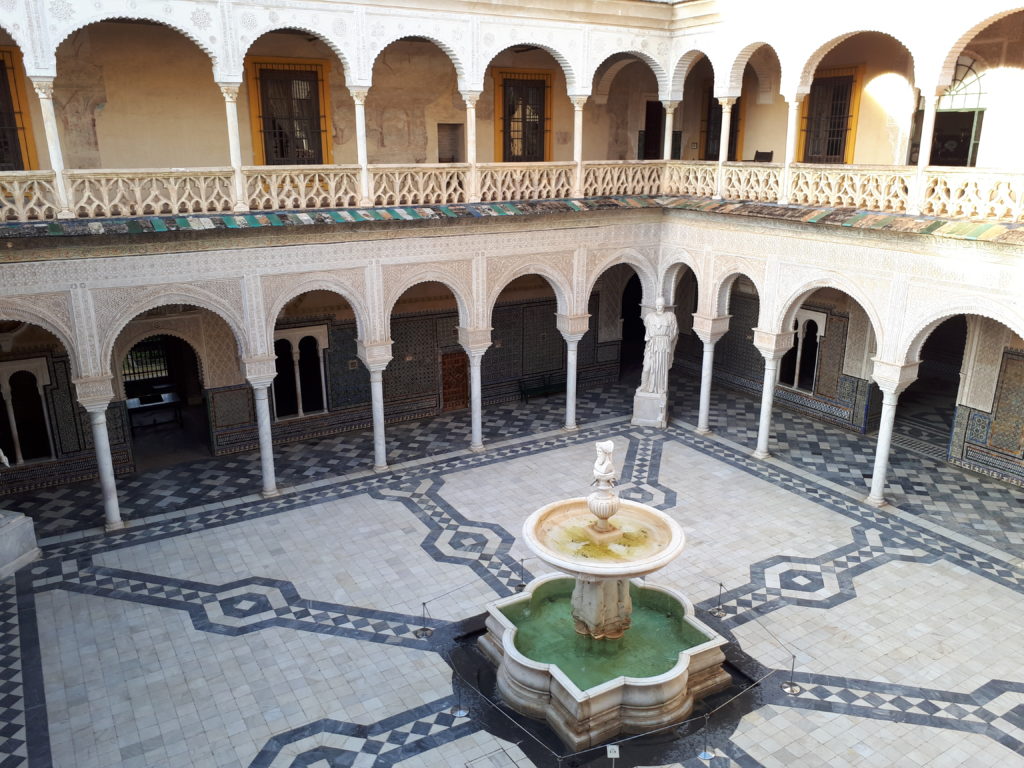
Casa de Pilatos – Séville
Le soir, les ruelles sont bondées. C’est vendredi, et tous les habitants de Séville sont de sortie. C’est également le soir où les lumières de noël sont allumées. La ville est très animée.
Jour 4 : visite du quartier de la Macarena, puis retour à l’aéroport
La visite du quartier de la Macarena ne faisait pas parti de l’itinéraire que nous avions prévu initialement, mais il est intéressant de découvrir ce coin de Séville et de s’y promener, c’est donc sans regret. On a le sentiment de traverser un village, loin de l’agitation du centre. Le quartier est authentique et coloré. Impossible de rater l’entrée du quartier, et notamment les murailles ainsi que la Basilique de la Macarena.
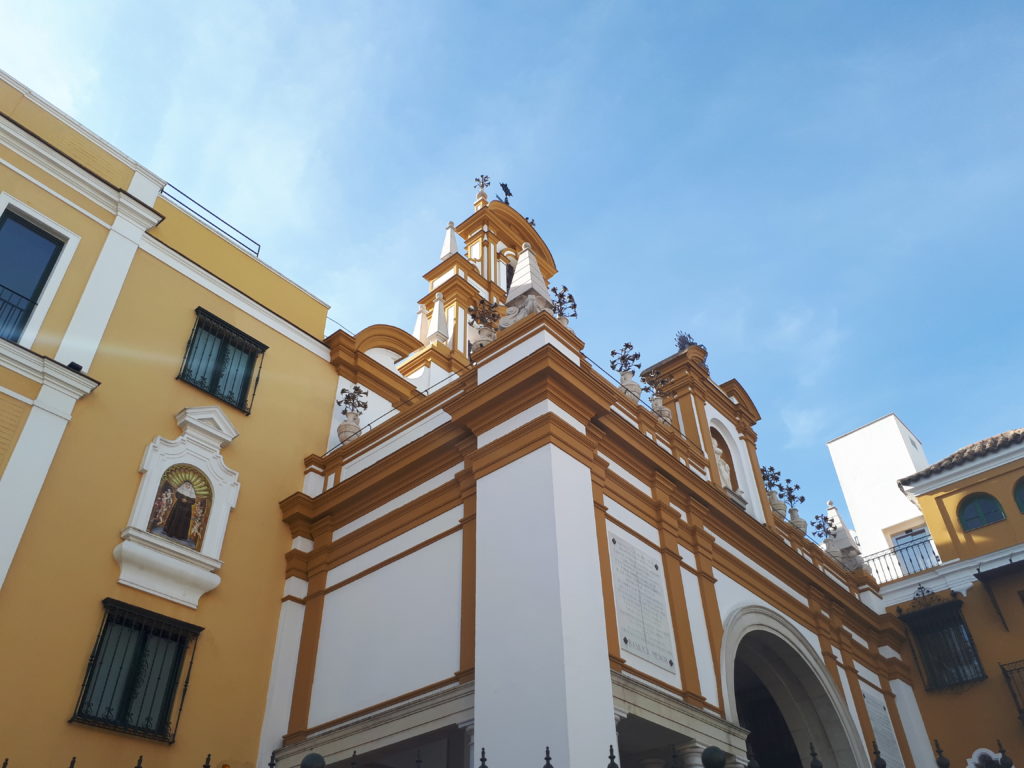
Basilique de la Macarena – Séville
Nous rejoignons ensuite la gare routière, afin de prendre la navette qui nous conduit ensuite jusqu’à l’aéroport. Notre voyage à Séville touche à sa fin.
Que visiter à Séville en 3 jours ? J’espère que ce récit de voyage vous aide à découvrir les choses à faire et à voir sur place, ainsi qu’à organiser votre prochain voyage à Séville.
Articles relatifs :

J’ai toujours rêvé de partir en voyage en Espagne, car je fantasme sur la ville de Madrid et de Barcelone. Cependant, je ne savais pas que Séville était aussi intéressante.
Oui, Séville change un peu des célèbres « Barcelone » et « Madrid ». A recommander !!
Super article ! Nous avons eu un véritable coup de coeur pour Séville et cet article nous replonge dans de superbes souvenirs. La place d’Espagne, la cathédrale… Ça donne envie d’y retourner !
À notre retour, nous avions écrit un article avec nos bonnes adresses pour dormir à Séville 🙂 Alors n’hésitez pas à jeter un oeil pour préparer votre prochaine escapade à Séville !
https://www.les-escapades.fr/ou-dormir-hotels-seville/
Bonjour, merci ! Contente que cet article vous replonge dans de bons souvenirs ! Et bravo pour cet article sur les lieux où dormir, ça donne des idées 😉
Séville c’est une ville vraiment magnifique. Par contre il fait tellement chaud, que vaut mieux ne pas oublier sa crème solaire, sinon c’est l’insolation assuré… Je parle en état de cause.
Culturellement parlant, la ville est au rendez-vous. Les gens sont très agréables !
Bonjour, oui la ville mérite vraiment d’être visitée (en dehors de l’été ou il fait trop chaud…)
Laisser un commentaire Annuler la réponse
Votre adresse e-mail ne sera pas publiée. Les champs obligatoires sont indiqués avec *
Commentaire
Enregistrer mon nom, mon e-mail et mon site dans le navigateur pour mon prochain commentaire.
Ce site utilise Akismet pour réduire les indésirables. En savoir plus sur comment les données de vos commentaires sont utilisées .
Copyright ©2020 www.leprochainvoyage.com. Tous droits réservés. Aucune reproduction, même partielle, ne peut être faite de ce site et de l’ensemble de son contenu ( textes, documents et images) sans l’autorisation expresse de l’auteure de ce blog.
- Résumé de la politique de confidentialité
Nous utilisons des cookies pour vous offrir la meilleure expérience sur le site. En naviguant sur ce blog, nous considérons que vous acceptez les cookies.

Séville : le city guide
26 mars 2021
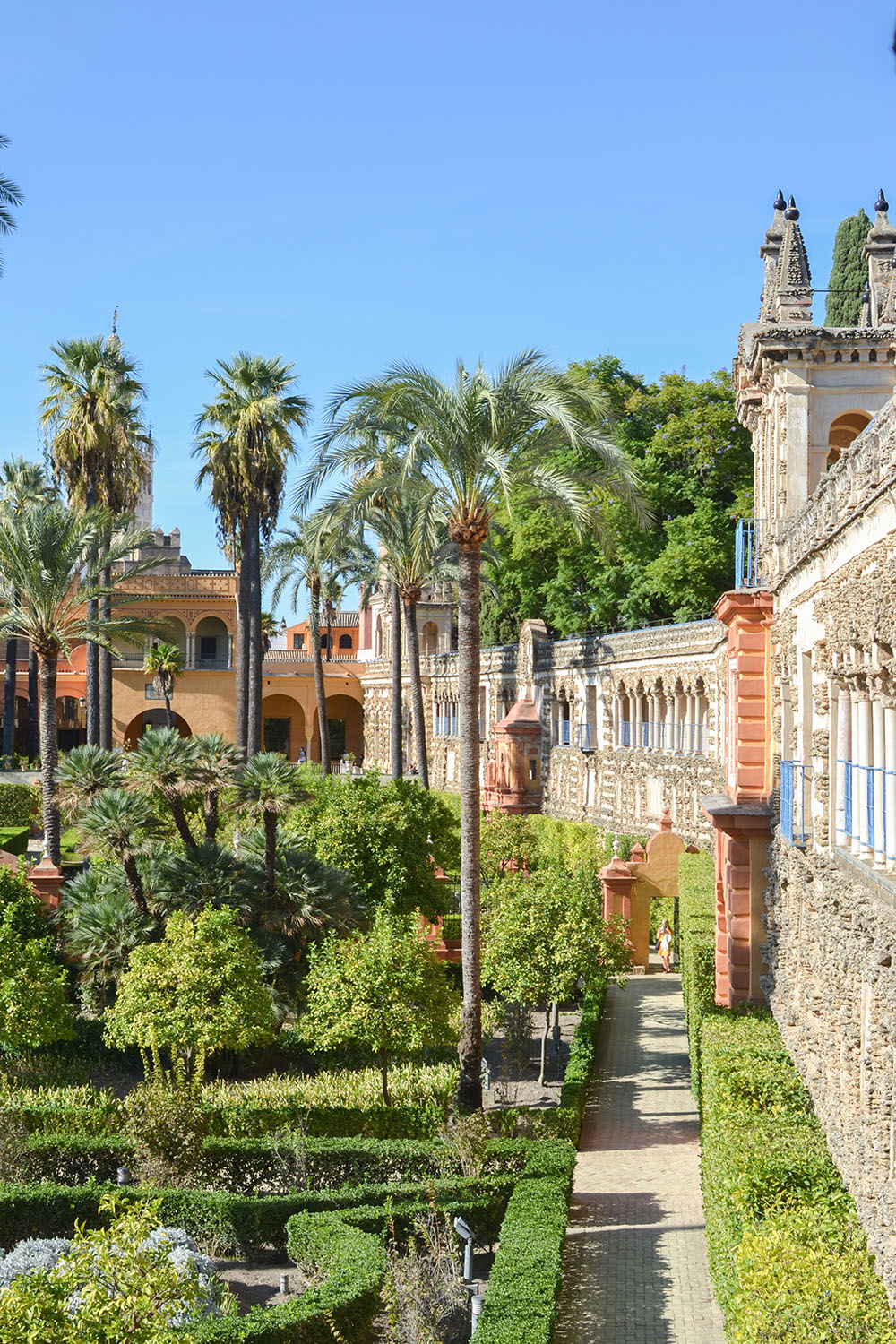
LA BELLE SÉVILLE
Nous avons passé 1 semaine en Espagne : 4 jours à Séville avant de partir pour une escapade de 2 jours à Grenade . Retrouvez ici toutes les infos pratiques (logement, conseils, bonnes adresses…). Si vous avez des questions, n’hésitez pas à me les laisser en commentaire, j’y répondrai avec plaisir. Alors, que voir et que faire dans la si belle Séville ?
Séville est une ville où il fait bon vivre. Soleil et grand ciel bleu, chaleur et végétation luxuriante, façades colorées et influences arabes : j’ai eu un véritable coup de coeur pour cette si jolie ville andalouse (on rêve maintenant d’avoir une maison avec jardin et piscine là-bas. Véritable paradis sur Terre). Si vous souhaitez aller la découvrir à votre tour, voici ce que vous ne devez surtout pas manquer !
REAL ALCÁZAR
Mon endroit préféré à Séville. Je n’avais plus envie de partir et on a attendu la fermeture pour quitter les lieux à contre coeur. On avait même envie d’y retourner une deuxième fois et y rester la journée pour y lire, pique-niquer et admirer à nouveau ce Jardin d’Eden si paisible et majestueux .
Le palais fortifié ( alcazar ) est somptueux et son architecture est à couper le souffle. La verrière, la coupole dorée, les arcades, les sculptures, les détails, les mosaïques, les couleurs… J’ai une énorme affection pour l’ architecture arabe que je trouve sublime et en flânant au sein de ce palais, j’avais l’impression d’être de retour à Marrakech .
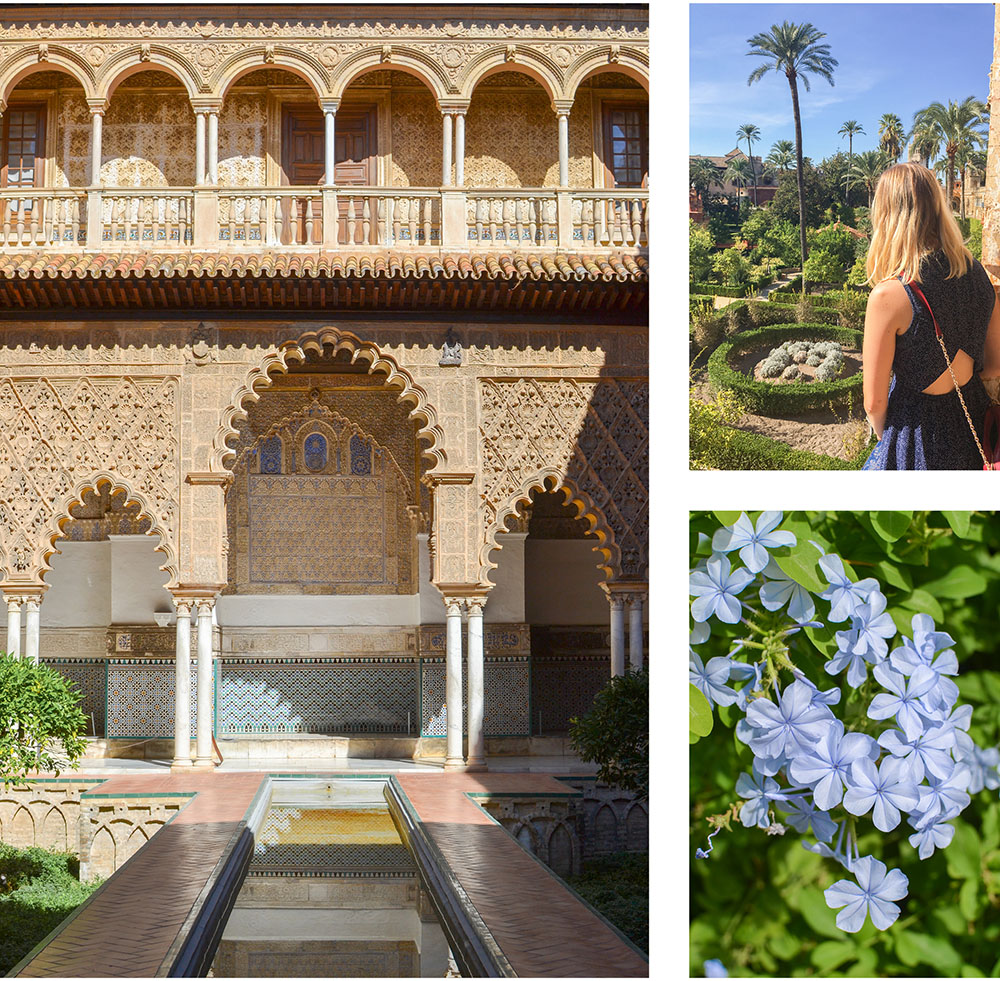
Les jardins sont quant à eux immenses, avec différentes ambiances. Les fontaines et points d’eau apportent de la fraîcheur et sont une invitation à la détente. Des paons se promènent librement et nous ravissent de leurs couleurs chatoyantes. Cet endroit est un véritable paradis sur Terre (à part pour les moustiques qui m’ont dévorée – pensez au spray anti-moustiques !) et on aimerait y rester indéfiniment.
Comme je vous le disais également ici , nous étions quasiment les seuls touristes à cause de cette période de corona + notre départ hors-saison (octobre). Nous étions les plus chanceux du monde et avions d’avoir le Real Alcazar rien que pour nous !
prix : 12,50€ / personne. Bon à savoir : entrée gratuite le lundi de 18h à 19h d’avril à septembre et de 16h à 17h d’octobre à mars (c’est très rapide 1h mais ça peut être un petit bonus pour retourner y faire un tour ;).
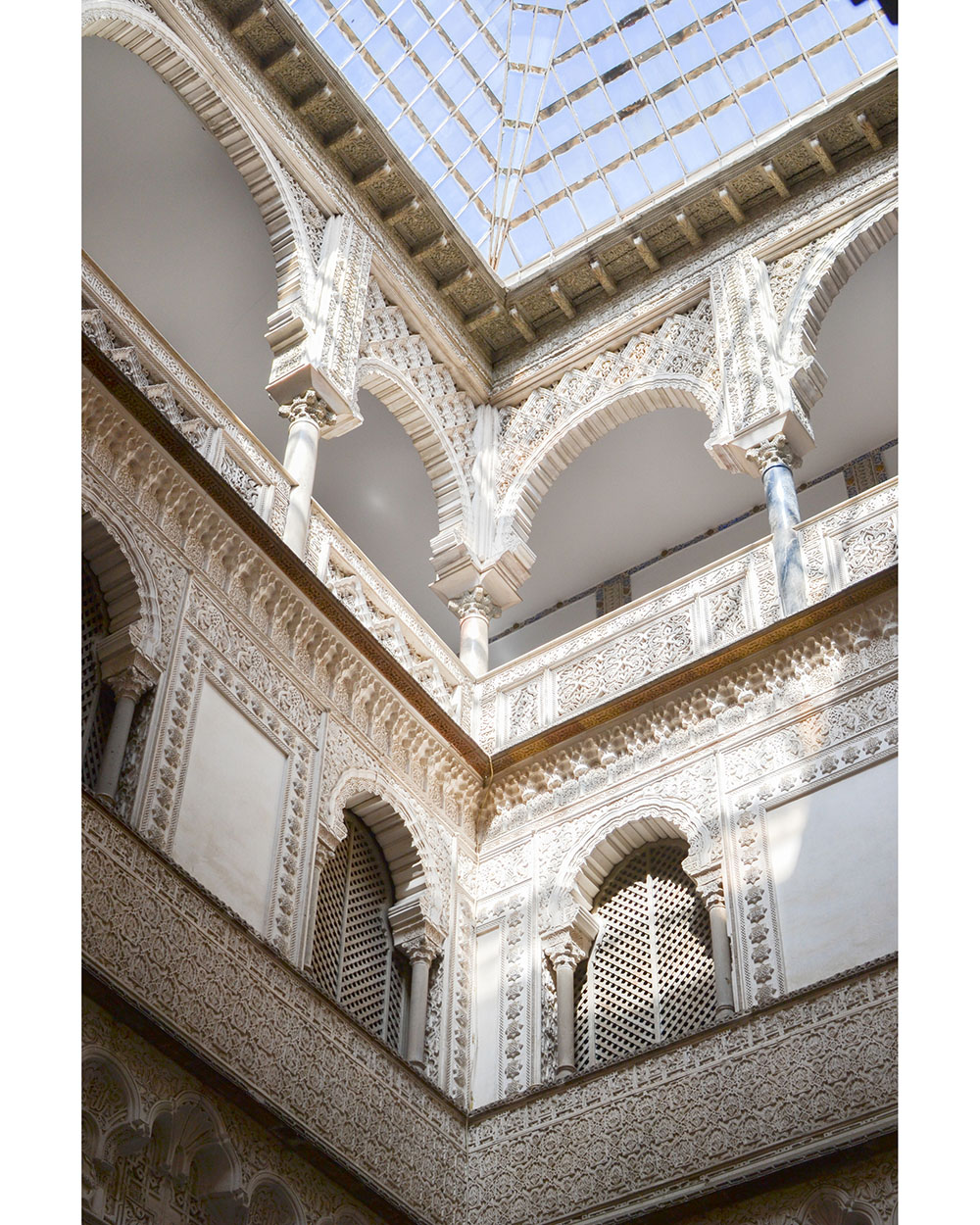
PLAZA DE ESPAÑA
Wow wow wow ! Je ne m’attendais pas à une place et à un bâtiment si monumentaux ! Nous sommes arrivés en fin de journée, alors que le soleil commençait à caresser de ses rayons dorés cette architecture si impressionnante aux mille détails. Saviez-vous d’ailleurs que la place a servi de lieu de tournage dans Star Wars ?

Je ne peux que vous recommander d’y aller en fin de journée afin de découvrir la Place d’Espagne entre ombre et lumière, avec sa façade qui se teinte d’oranger et ses détails dorés qui rayonnent au soleil. Vous pourrez d’ailleurs assister à des représentations de flamenco avec des danseuses et des musiciens énergiques et envoutants.
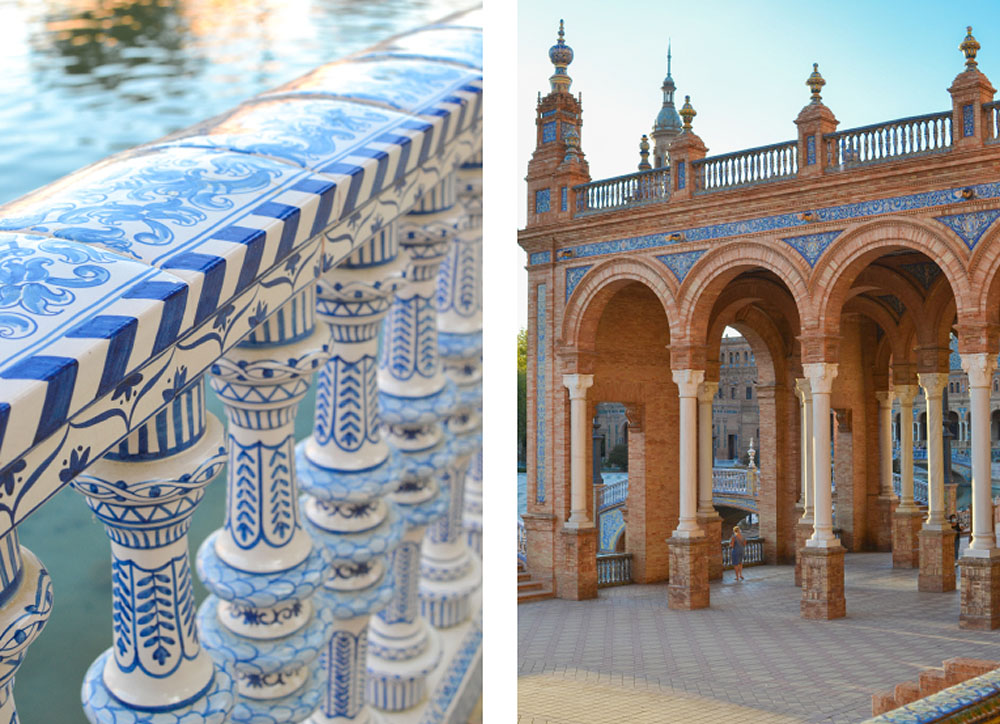
PARC DE MARÍA LUISA
L’un des plus beaux parcs que j’ai eu la chance de voir dans ma vie. Une véritable jungle en pleine ville ! Il se situe en face de la Place d’Espagne et est immense. Ce que j’ai beaucoup aimé, c’est qu’il y a différents types de jardins : étang avec des cygnes, palmiers par milliers, fontaines et bassins, bougainvilliers…
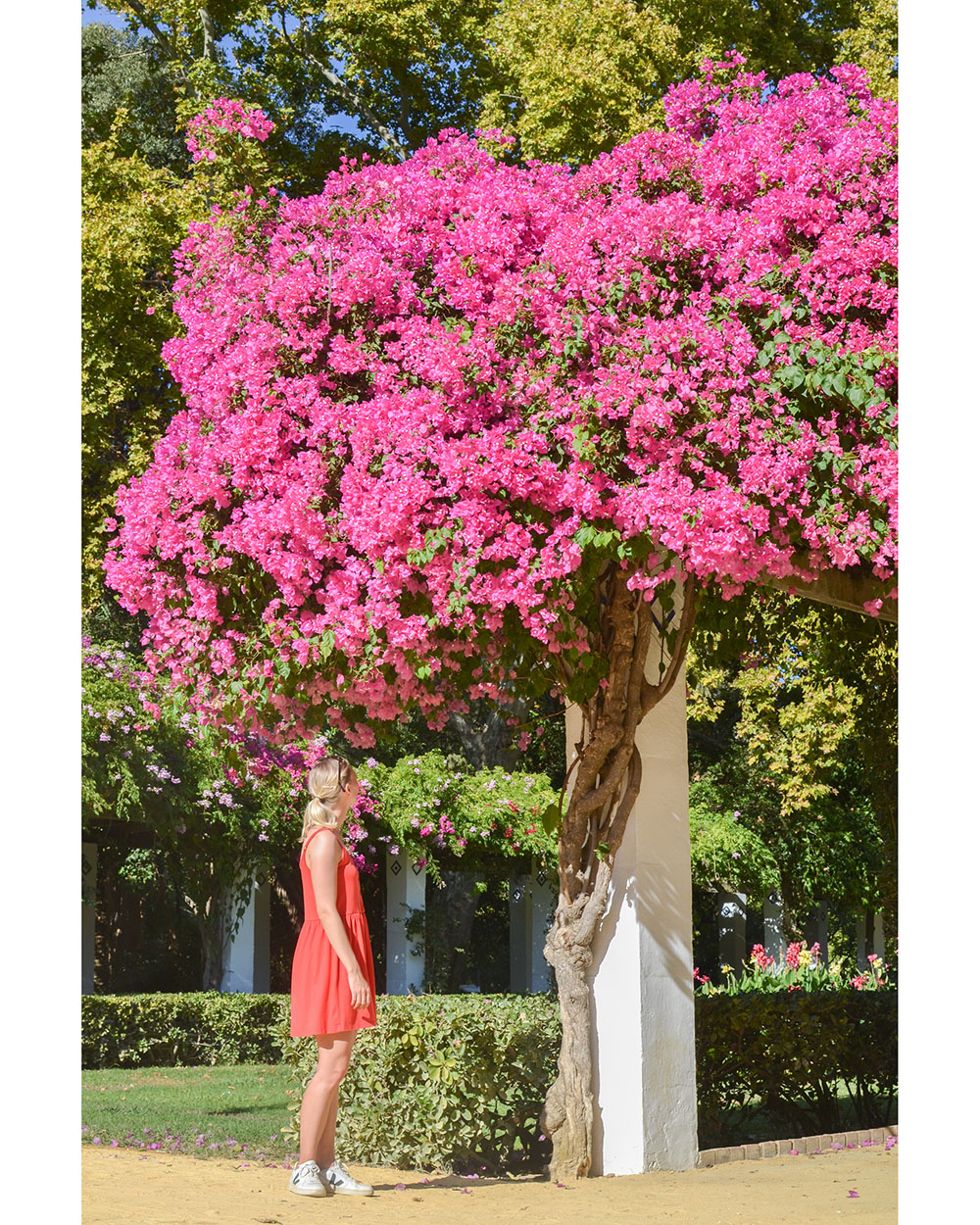
LAS SETAS DE SEVILLA
Las Setas de Sevilla = les champignons de Séville = metropol parasol (oui tous ces noms pour la même chose ;). Notre airbnb se situait juste à côté et nous avons eu l’occasion de voir cette oeuvre architecturale de jour (elle permet d’ombrager la place et beaucoup d’enfants y jouent, des ados y font du skate…) ainsi qu’au coucher du soleil. L’entrée est à 5€/pers. et permet de prendre de la hauteur et ainsi découvrir un superbe panorama à 360° sur la ville . Magnifique !
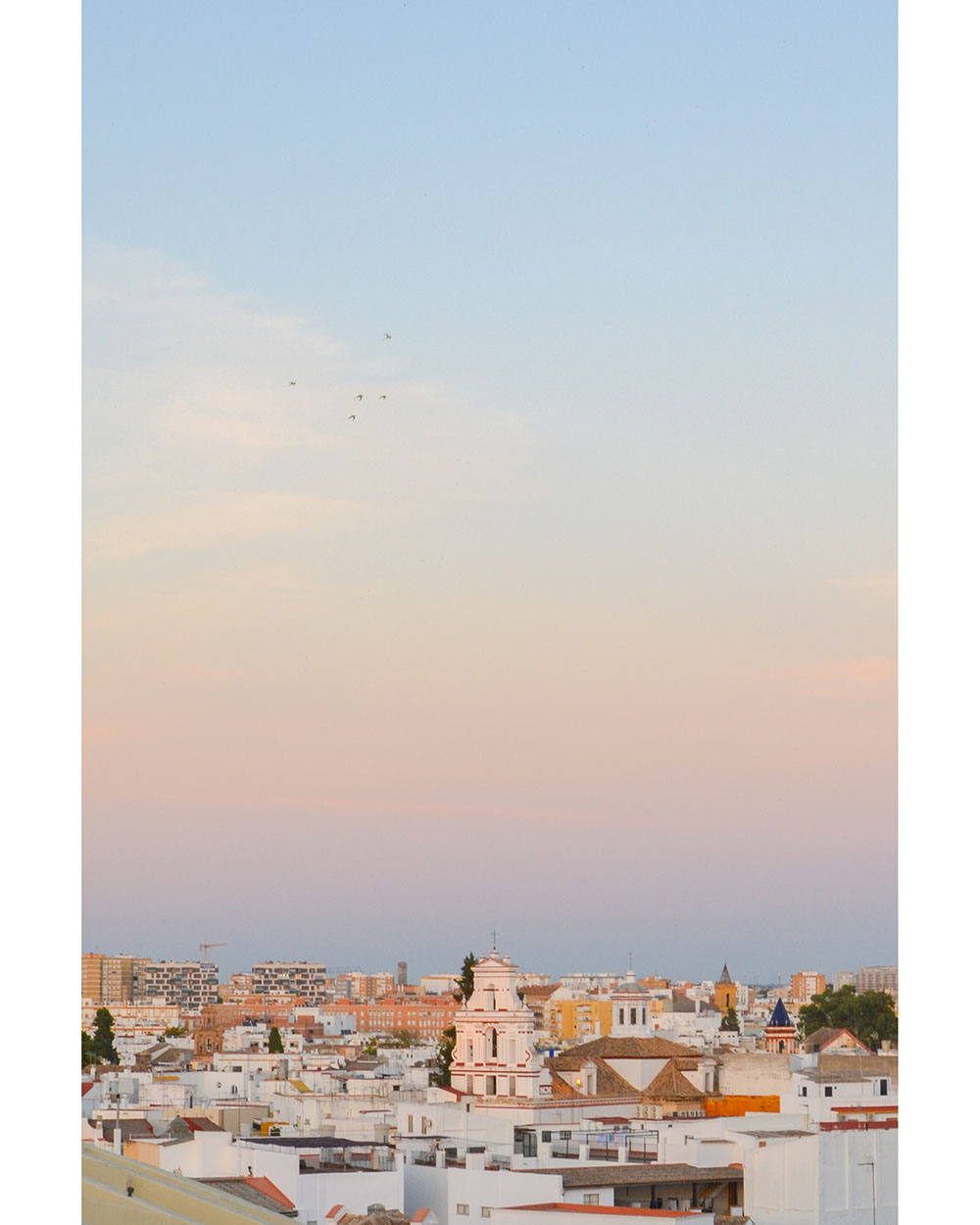
LA CATHÉDRALE ET LA GIRALDA
La cathédrale est gigantesque mais ce qui m’a le plus plu, c’est l’ascension de la giralda ! Après cette montée un peu sportive, on est récompensés par une superbe vue à 360° sur les alentours et sur les toits de la majestueuse cathédrale . On voit aussi les superbes appartements avec piscine qui nous font rêver 😉 et la jolie cour des orangers (nous y avons pique-niqué ensuite : le bonheur). 14,50€/pers.

LES RUELLES COLORÉES DE SÉVILLE
Nous avons tout fait à pied à Séville , et comme pour Rome , c’est une visite à part entière. Les ruelles sont si jolies, tellement colorées, végétalisées et ensoleillées que c’est un plaisir de les parcourir. Je vous recommande également de traverser le pont et de découvrir le quartier Triana . Ca sera aussi l’occasion d’admirer les quais d’un nouveau point de vue.
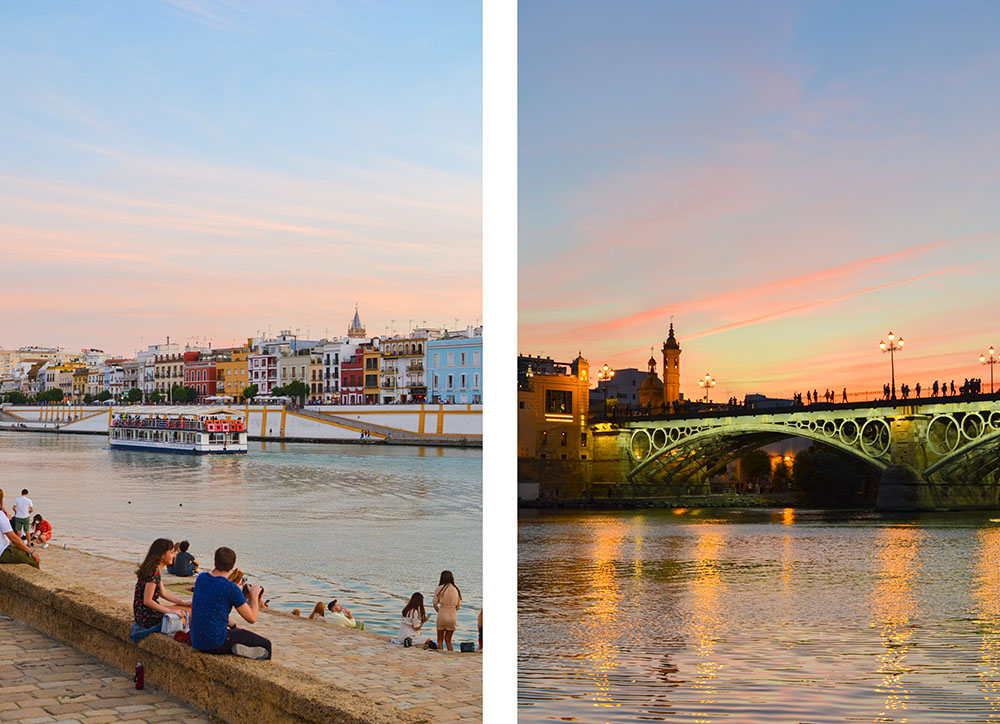
Séville regorge de jolies ruelles et de passages qu’on croirait presque secrets . Parfois, on s’y perd et on se laisse porter dans ce labyrinthe coloré avec plaisir. On y découvre des petites cours et fontaines, toutes plus ravissantes les unes que les autres. L’un de mes endroits préférés : la plaza de Cabildo , une place arrondie en demi-ovale, avec de grandes arches et de chouettes passages autour.

Les articles voyage sont les plus longs à écrire et j’espère qu’il pourra vous être utile, ou au moins, à vous faire voyager à travers les photos. N’hésitez pas à me laisser un message en commentaire si c’est le cas, ça me fera chaud au coeur 🙂 Retrouvez également ici ma story Instaram sur Séville, avec d’autres photos et vidéos.
Commentaire
You might also like....
29 mars 2021 at 8 h 20 min
Canon ! J’ai eu un véritable coup de coeur pour el « REAL ALCÁZAR » et la « PLAZA DE ESPANA ». J’ai également beaucoup aimé la « CASA DE PILATOS ». https://thecosmicsam.com/2015/11/11/sevilla/
29 mars 2021 at 11 h 57 min
Merci pour ton partage d’article, c’est très chouette de voir d’autres photos et de voir que pour une même ville, chacun à son point de vue et sa sensibilité 🙂 Et du coup, je veux y retourner pour voir la Casa de Pilatos !!!
- Regards croisés sur l’Asie
- 15 jours : Itinéraire et conseils
- Les temples d’Angkor
- 15 jours dans le Yunnan : itinéraire
- 4 raisons d’adorer le Yunnan
- Entre tradition, modernité et originalité
- Le Japan Rail Pass
- L’île de Bornéo
- Thailande du Nord
- Où dormir à Chiang Mai
- Notre itinéraire de 15 jours
- Cayo Guillermo – Playa Pilar
- La vallée de Viñales
- Cuba face à l’essor touristique
- La Guadeloupe
- La Martinique en 15 jours
- Week-end à Bruges
- Ile de Skye
- La vallée de Glen Coe
- Les îles Baléares : Minorque
- 3 jours à Madrid
- Séville et ses incontournables
- Les Cyclades : quelles îles choisir ?
- Îles Grecques : nos coups de coeur
- Les Cyclades : comment y aller ?
- Cyclades : voyager avec un bébé
- 15 jours en Crète : Itinéraire et conseils
- Serifos, la belle méconnue
- Sifnos, l’île délicieuse
- Une semaine en Irlande
- Où manger à Florence ?
- #1 Amsterdam
- #2 Hello Amsterdam, welcome back !
- Algarve Sud : Itinéraire
- Ouest de l’Algarve
- Porto et la Vallée du Douro
- Où manger à Porto ?
- Prague en 5 jours
- Cancale à la Pointe du Grouin
- Dinan et la vallée de la Rance
- Balade à Saint-Suliac
- Week-end dans les Ardennes
- Week-end à Reims
- Île d’Aix et Fouras les Bains
- Plus belles plages de Corse du sud
- Week-end dans le Périgord blanc
- Une semaine dans le Périgord noir
- Escapade à Chartres
- Week-end dans l’Oise
- Week-end sur la Côte d’Opale
- Week-end en Haute-Vienne
- Week-end au Cap Ferret
- Virée normande à Rouen
- Etretat et Veules-les-Roses
- Angers et la Loire en vélo
- Nantes et Clisson
- 5 jours sur la Côte d’Azur
- île de Porquerolles
- La Presqu’île de Giens et Hyères
- Le Luberon et la Provence
- Nos idées de visites
- La forêt de Fontainebleau en famille
- En Baie de Somme
- Tolar Grande
- Ouest canadien : notre Itinéraire
- Parc national de Banff
- Promenade des Glaciers
- New York City
- Cuba 2 minutes 30
- Notre road trip en Algarve
- Porquerolles
- Comment choisir sa destination et organiser son voyage ?
- Guadeloupe ou Martinique : quelle île choisir ?
- Nos conseils pour voyager en famille et entre amis
- Touristes chinois : nos 4 leçons pour apprendre à les aimer
- Expatriation en Polynésie Française
- Partenariat

Séville, Que faire ? Que voir ? Nos incontournables
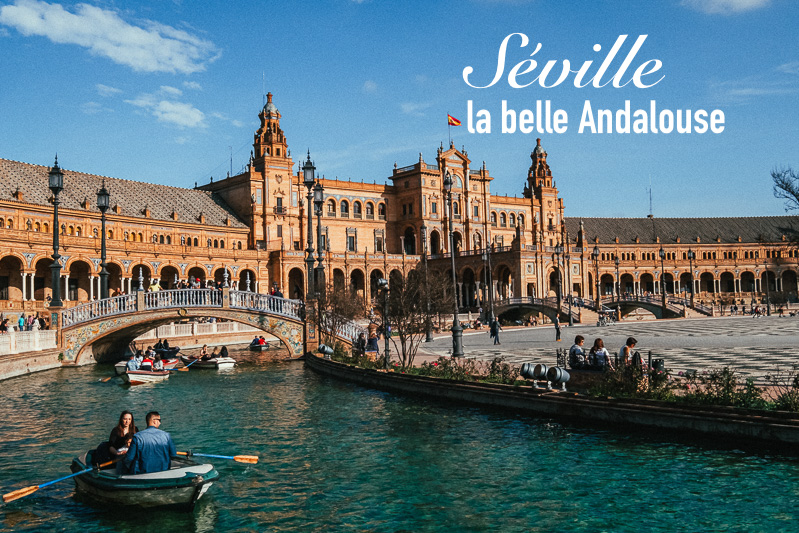
Pour le premier voyage à l’étranger en famille, nous nous sommes envolés vers la belle andalouse, Séville . Sans doute, la pépite de l’Espagne tant par la beauté et la richesse de ses édifices aux influences arabes que par sa douceur de vivre. Et puis, elle semblait tellement faire l’unanimité auprès de vous. Pour savourer au mieux ce séjour, nous y sommes restés 4 jours, durée idéale même si nous serions bien restés une journée de plus. Avec Hanaé, on a eu le temps de visiter les édifices et les quartiers incontournables mais pas plus. On vous indique toutefois les visites que nous aurions pu faire si nous avions eu plus de temps.
Informations pratiques :
La belle andalouse Séville se situe à seulement 2h30 de vol depuis Paris . Plusieurs compagnies aériennes la desservent comme Vueling ou Transavia depuis Paris Orly.
Pour le côté pratique, nous avons décidé de garer notre voiture à proximité de l’aéroport (plus simple d’avoir le siège auto d’Hanaé dans notre voiture). Pour l’occasion, nous avons testé le service de réservation de place de parking dans les hôtels des aéroports One Park.
Comment ça marche ? C’est simple, allez sur le site OnePark , choisissez votre parking parmi les 2000 parkings proposés en France et en Europe (parking des hôtels, parking aéroport officiels ou voiturier) en indiquant votre dates et heures d’arrivée et de départ, réservez et payez votre place de parking. Vous recevrez ensuite un code qui vous permettra d’entrer et de sortir du parking en toute autonomie.
Les avantages :
- la réservation peut être annulée jusqu’à la veille du départ heure avant la date prévue.
- vous bénéficiez de tarifs négociés moins cher qu’en payant directement le parking sur place.
Réserver votre place de parking et bénéficiez de 10% de remise pour votre première réservation !
Gagnez du temps avec les billets coupes-file :
Pour gagner du temps et éviter les longues files d’attente aux différents sites, nous vous conseillons vivement de réserver directement vos e-billets sur le site de notre partenaire Tiqets ou via leur application smartphone et ainsi gagner un temps précieux pour accéder aux différents sites de Séville !
Tiqets propose des billets électronique et des coupes-file aux différents musées comme l’Alcazar, la cathédrale et Giralda, la Casa de la Duenas, etc. L’expérience d’achat est très simple et rapide : vous choisissez votre jour et éventuellement votre créneau horaire de visite puis une fois vos billets achetés, vous recevrez quelques minutes après vos e-billets sur votre smartphone ou directement dans l’application Tiqets. Et pas besoin d’imprimer vos billets, il suffit de présenter vos e-billets accessible depuis votre smartphone à l’entrée des sites.
On vous conseille d’ailleurs le Pass Séville qui combine des billets :
- coupe-file au Real Alcazar,
- coupe-file à la cathédrale de Séville et son Giralda,
- au bus Hop on/hop off de Séville pendant 24h.
Pensez à réserver votre hébergement pour votre séjour à Séville !
La majestueuse place d’Espagne : c’est ici qu’on prend la pose !
La place d’Espagne, c’est l’attrait emblématique de Séville . Créée au début du XXème siècle par l’architecture Gonzales, elle est devenue un lieu principalement visitée par les touristes du monde entier. On y admire son palais en forme de demi-ovale, son cours d’eau et sa place. Ici, la brique, le marbre et le céramique se conjuguent à merveille. Pour les plus romantiques, c’est ici que le tour de barque est possible.
A vrai dire, un seul petit regret : ne pas y retrouver un peu de vie locale ou de terrasses permettant de siroter un verre Ici, principalement que des touristes.
Pour une pause verdoyante, nous nous sommes rendus au Parc de Maria Luisa (situé en face de la place d’Espagne) qui est le poumon vert de Séville. Une balade au vert très agréable que nous avons du écourter car le ciel se chargeait de nuages.
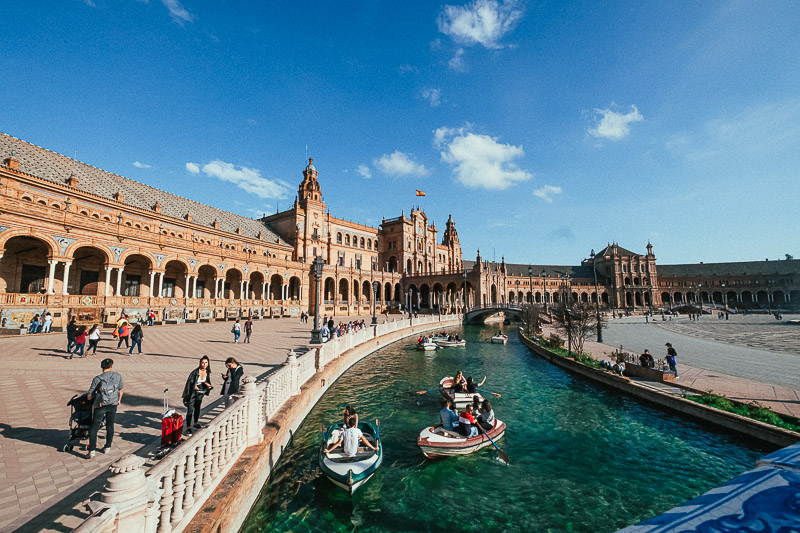
Bon à savoir : quelques des danseurs de flamenco y viennent faire des représentations dans l’après-midi.
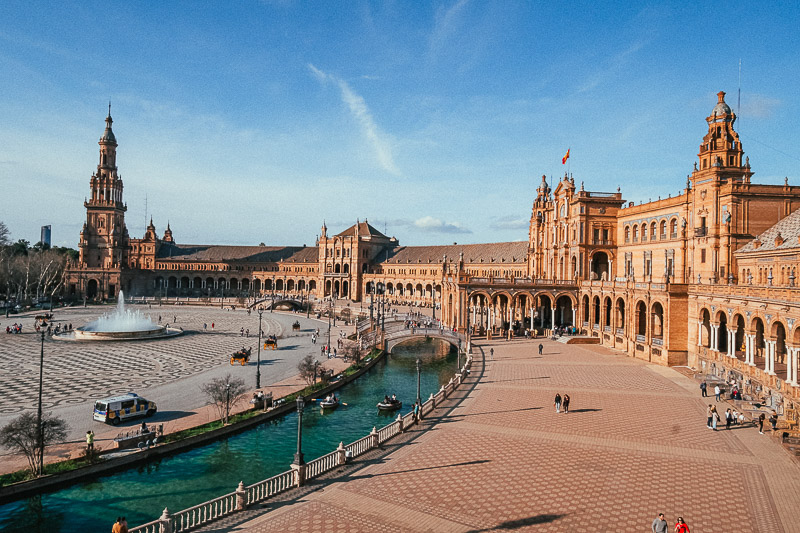
Pour les parents : c’est ici, installés sur les bas reliefs représentant les 48 provinces d’Espagne qu’Hanaé a eu le chance de boire son biberon. Sinon l’accès au palais n’est pas très pratique en poussette, de par les nombreux escaliers. Il faudra opter pour le porte-bébé, porter la poussette ou que l’un des deux restent à quai pendant que l’autre accède à la terrasse du palais.
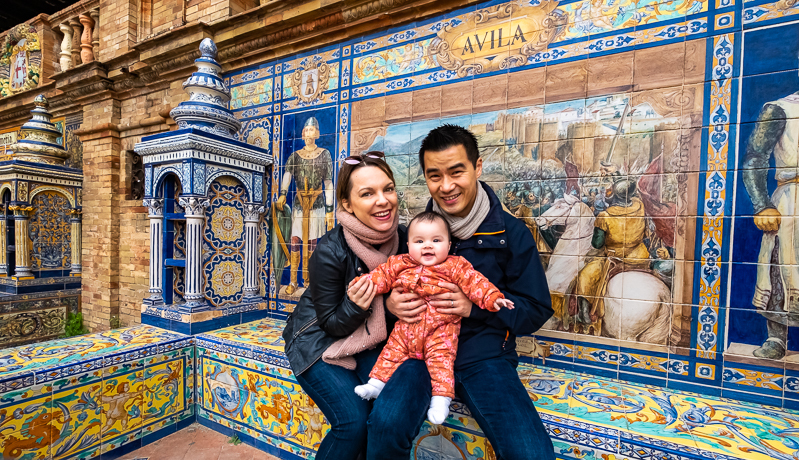
Real Alcazar : le palais fortifié aux somptueux jardins et patios
Découverte du palais fortifié Real Alcazar , un autre édifice de Séville à ne pas manquer principalement pour ses patios et ses jardins. Nous avons réservé notre billet, conseil que nous avions lu ici et là. Finalement ce fut une bonne idée, car à la première heure de visite, soit 9h30, Il y avait déjà beaucoup de monde. La seule contrainte de réserver en amont est de faire avec la météo du jour qui fut pour nous très mitigée. Nous avons pris l’audio guide afin de connaître l’histoire et surtout l’architecture mudéjar. Un endroit superbe mais l’afflux de touriste empêche de profiter pleinement du lieu et d’admirer ses multitudes de détail.
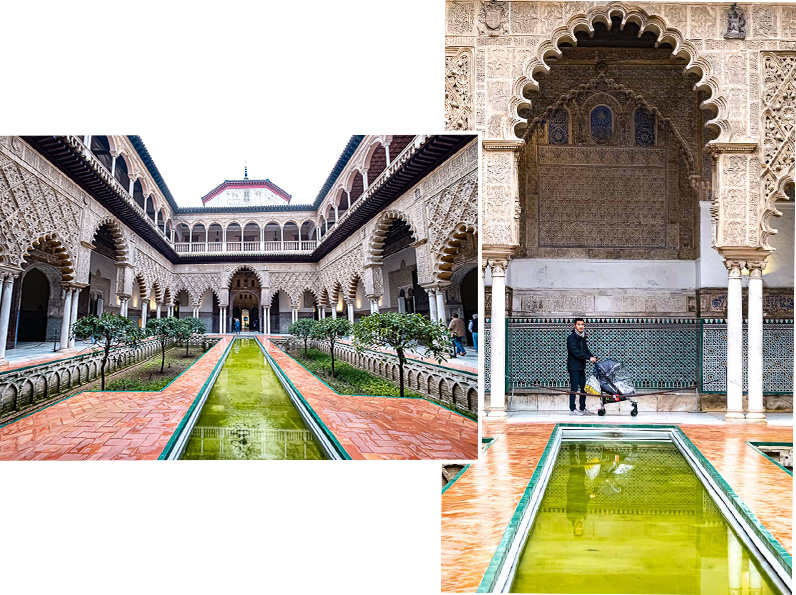
Le palais est à la fois mauresque, gothique, renaissance et baroque. Les moindres détails sont à scruter !
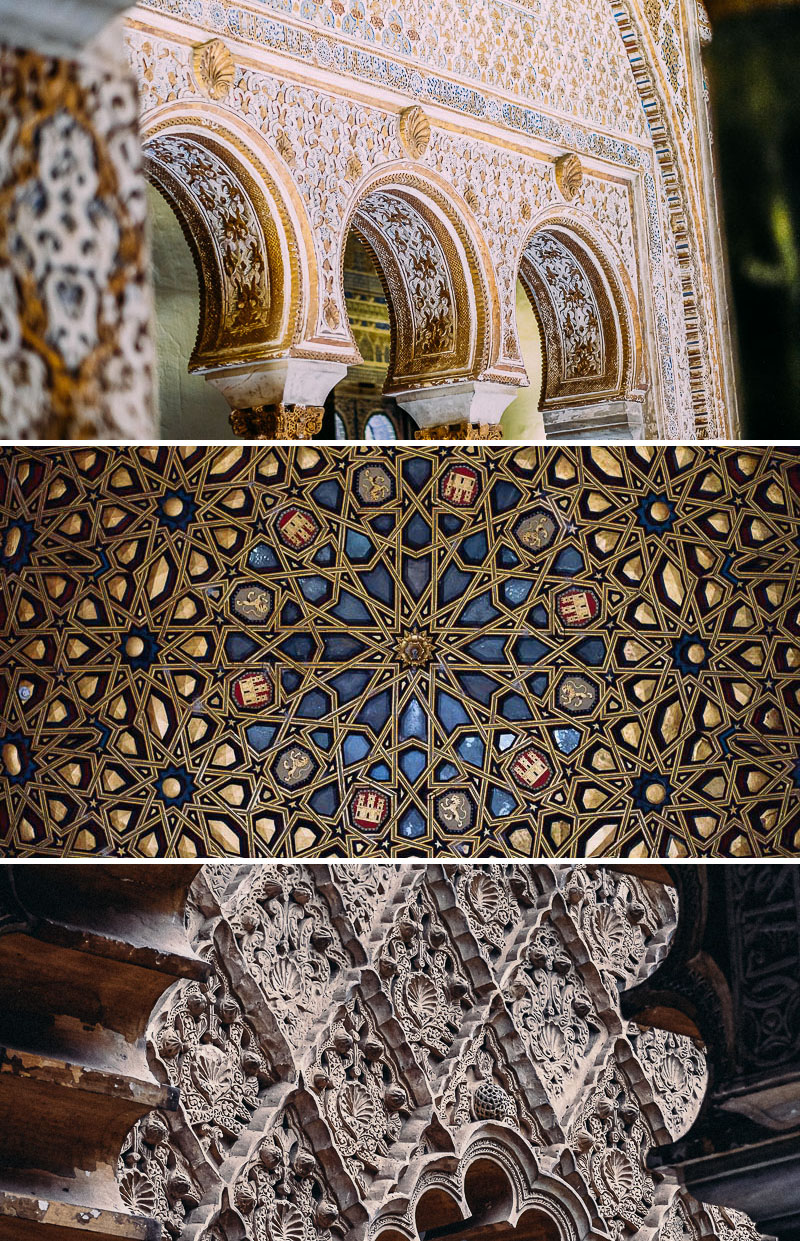
Les superbes jardins offrent une succession d’allées de cyprès, de palmiers et de magnolias. De jolies fontaines et statues agrémentent ce joli labyrinthe verdoyant !
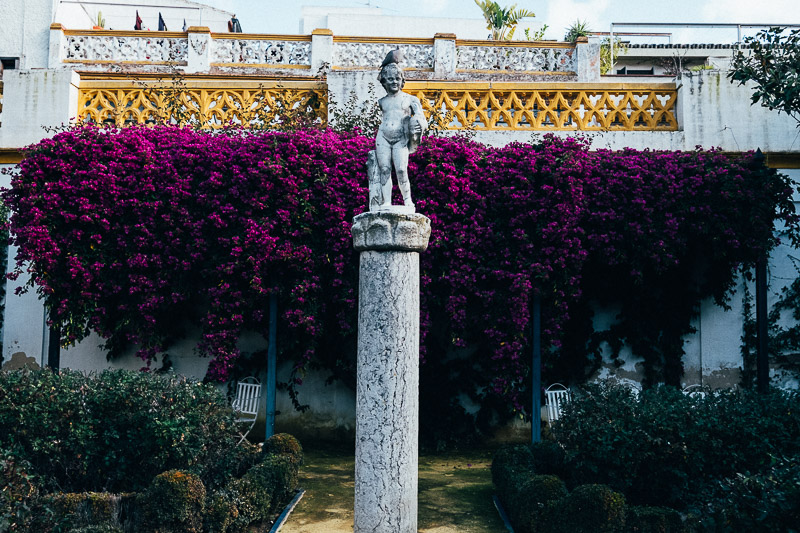
La Cathédrale de Séville et son Giralda : vertige et oranger !
La Cathédrale Notre Dame du Siège de Séville est un superbe monument religieux d’art mauresque. Elle est la plus grande d’Espagne et l’une des plus grandes cathédrales du monde. Lorsqu’on pénètre dans ce haut lieu, on ne peut qu’être scotché par les ornements du lieu et son envergure. Le Giralda , ici à gauche de la photo, est un ancien minaret d’une mosquée qui mesure 97 mètres de haut. A savoir que la cathédrale est installée en lieu et place d’une mosquée. Pour y accéder, il faut emprunter des rampes et escaliers assez larges. Après l’effort, on écarquille les yeux pour profiter d’une superbe vue 360° sur toute la ville. Eviter toutefois de monter avec un bébé.
Nous avons une nouvelle fois réservé en avance nos billets pour visiter la cathédrale et le Giralda. L’entrée pour les enfants de moins de 14 ans est gratuite, il faut néanmoins demandé au guichet un ticket d’entrée pour l’enfant. Vous pouvez facilement circuler avec la poussette.
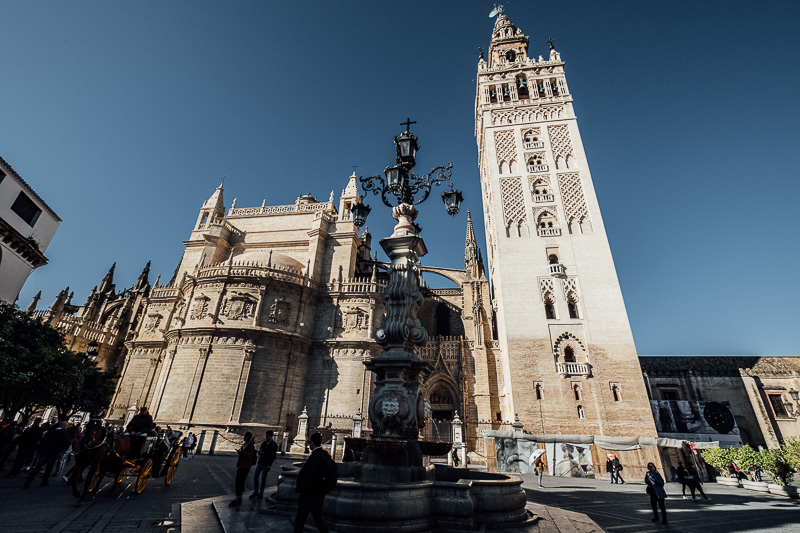
L’impressionnant retable gothique qui est le tableau d’autel le plus grand et le plus riche du monde !
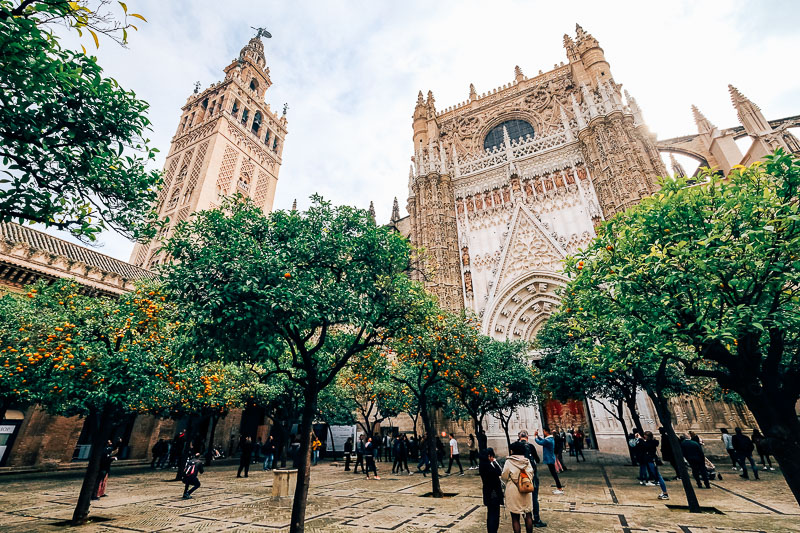
Cours des orangers au sein de la cathédrale de Séville
Non loin de la cathédrale, découvrez une endroit préservé du vieux Séville : la plaza de Cabildo. Une belle place en arc de cercle originale avec ses habitations et ses patios avec au centre sa fontaine.
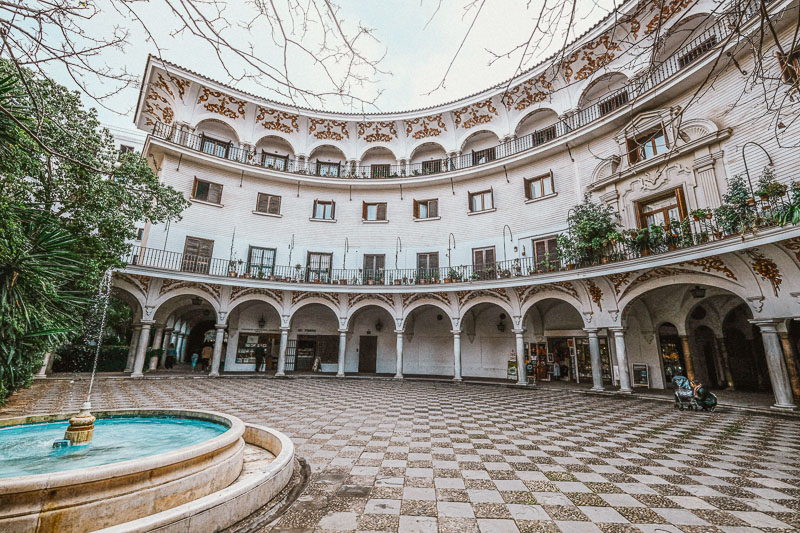
Le Metropol Parasol : le champignon de Séville !
Nous rejoignons l’étonnante infrastructure en bois au cœur de Séville . Le Metropol Parasol appelé aussi Setas de Sevila en référence à sa forme de champignon, est en quelque sorte la curiosité de la ville. L’ambiance du quartier Encarnacua Regina est d’ailleurs très vivante ! Ici les enfants se retrouvent pour faire du skate ou jouer entre jeunes. Avec Hanaé, difficile d’y venir au coucher du soleil mais on vous invite à y aller.
A ne pas manquer : venez découvrir cette infrastructure et ses formes géométriques aux lueurs du coucher de soleil.
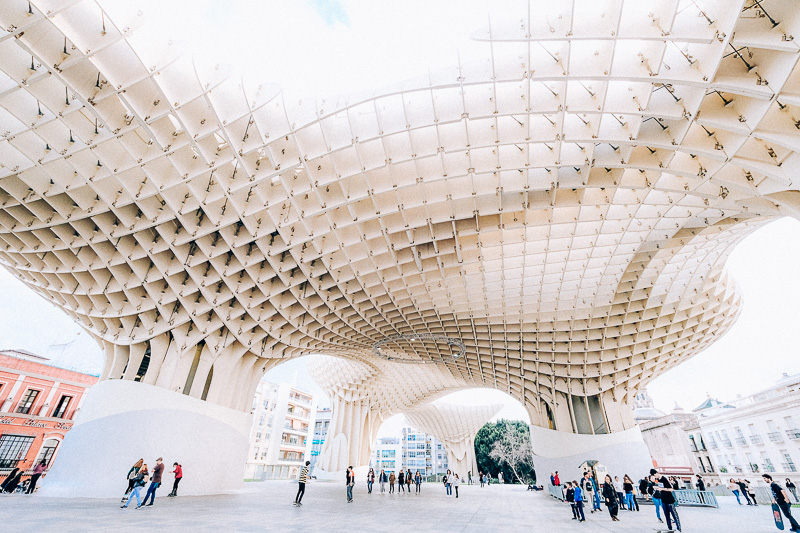
La Casa de Pilatos, austérité et simplicité
Nous logions juste à côté de la casa de Pilatos, un autre palais sévillan construit à la fin du moyen âge et au début de la renaissance. Nous découvrons un palais plus austère et simple que le Palacio Las Duenas. Il est joli mais ce n’est pas notre préféré !
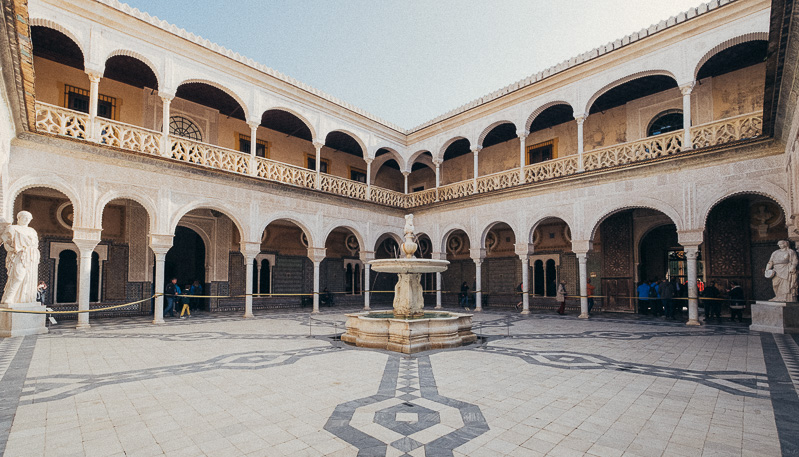
Le Palacio de La Duenas, le palais sévillan coup de coeur
Le Palacio de la Duenas est le palais sévillan pour lequel nous avons eu un coup de coeur . Les patios et ses jardins sont vraiment très agréables, surtout que le palais n’est pas bondé surtout à l’ouverture. Il a été construit entre le 15 et 16 ème siècle dans un style mêlant à la fois l’art mudéjrar et le style renaissance. Le mélange des influences est vraiment superbe, c’est ici que nous l’avons davantage ressenti. Les textures et formes des portes et des ornements, les couleurs chaudes et chaleureuses des pièces et l’exotisme des jardins ont participé à ce que ce palais soit notre préféré ! On s’y est senti vraiment bien, à tel point d’avoir un petit pincement en quittant ce sublime lieu.
Réservez vos e-billets
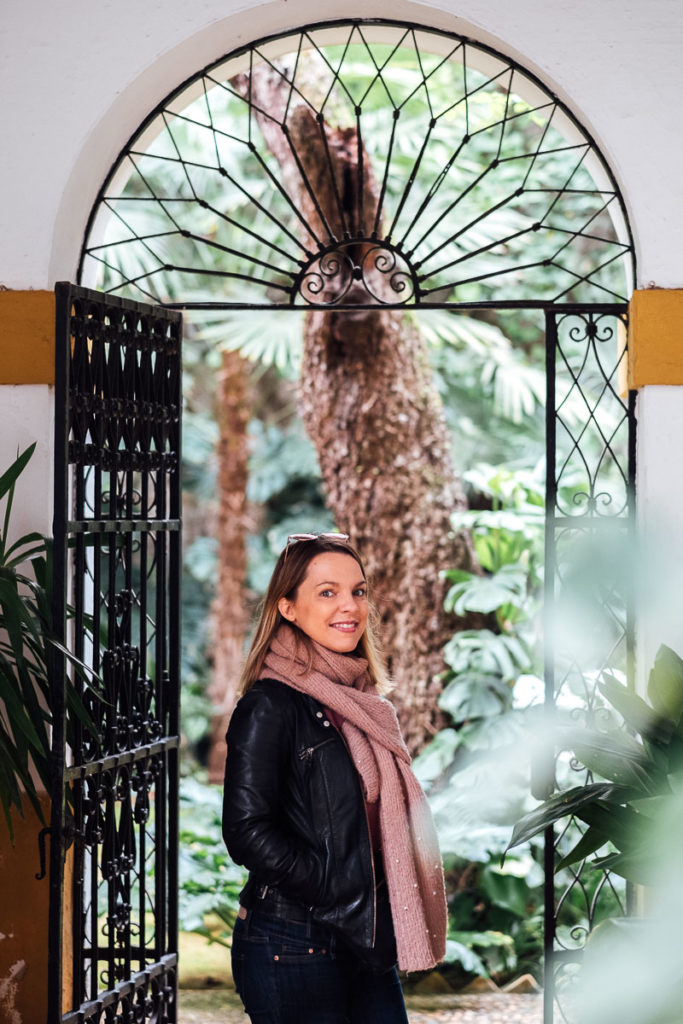
La Casa Salinas, le petit palais sévillan
Un autre palais sévillan construit au XVI ème siècle -qui combine l’art mudéjar et le style renaissance. Pas un chat ici ! La visite est intéressante et moins touristique. Il est moins imposant mais plus intimiste. On s’imagine davantage vivre dans ce joli petit palais sévillan !
Réservez vos e-billets
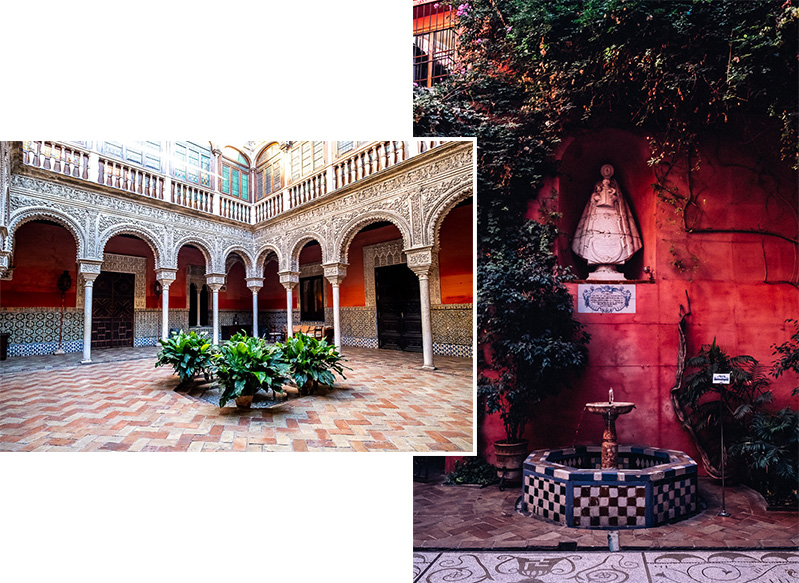
Toro del Oro, petite mais costaud !
Toro del Oro est une tour militaire, nous y sommes juste passés devant mais il est possible de monter et surtout de venir à l’approche du coucher du soleil.
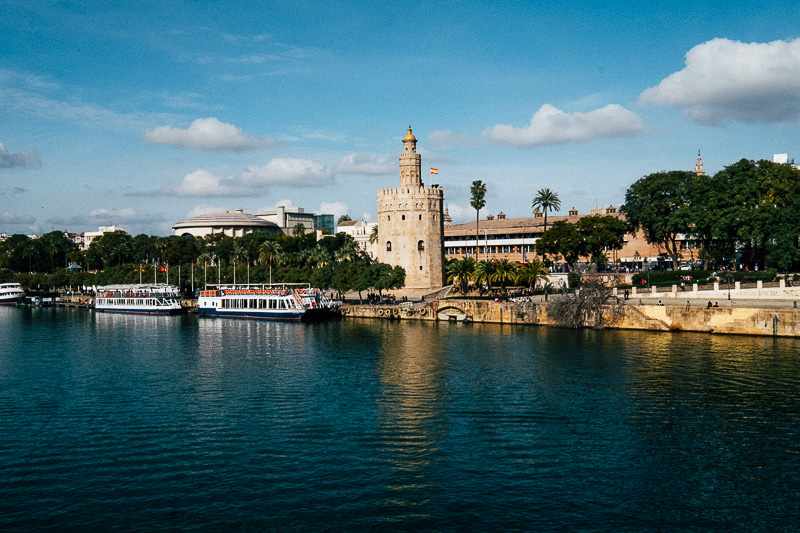
Le quartier Triana : berceau du flamenco olé !
Nous traversons le pont Isabel II pour rejoindre l’autre rive et son quartier Triana, berceau du flamenco et quartier gitan. On part dans les ruelles et notamment la rue Pureza jusqu’à atteindre l’église Santa Ana et son superbe clocher. Le quartier est également très réputé pour son marché « le mercado de Triana » mais attention ce dernier n’est pas ouvert le dimanche .
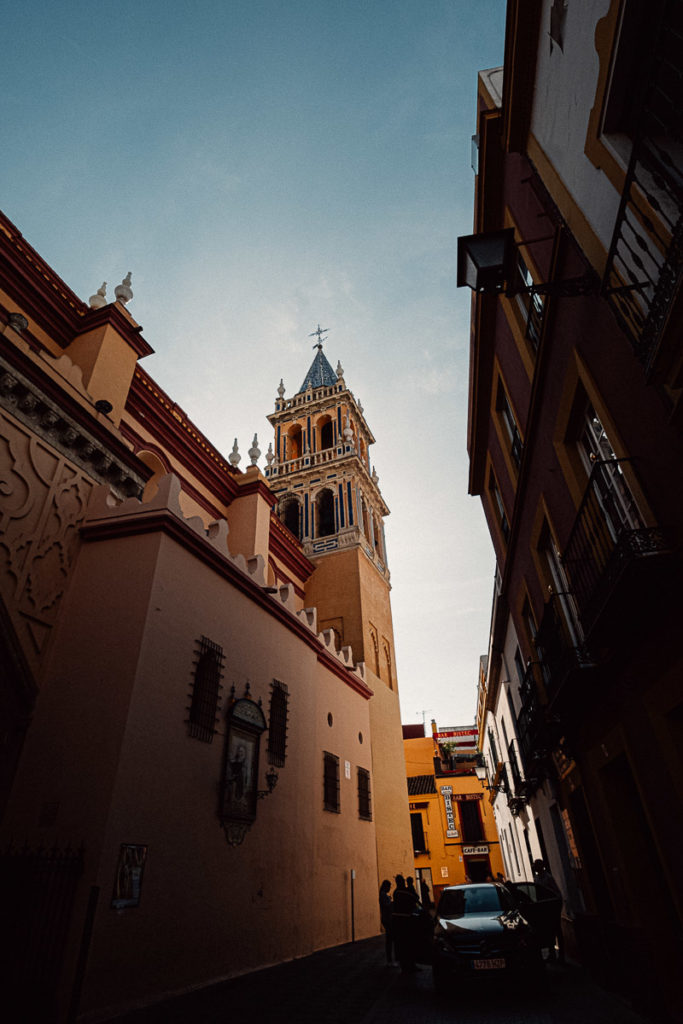
Le quartier Alfalfa, lieu de notre résidence
On a adoré flaner dans notre quartier. A vrai dire, l’ensemble du centre historique est à découvrir au gré des balades pour rejoindre les principaux édifices de la ville. On ne peut que vous conseiller d’y séjourner.
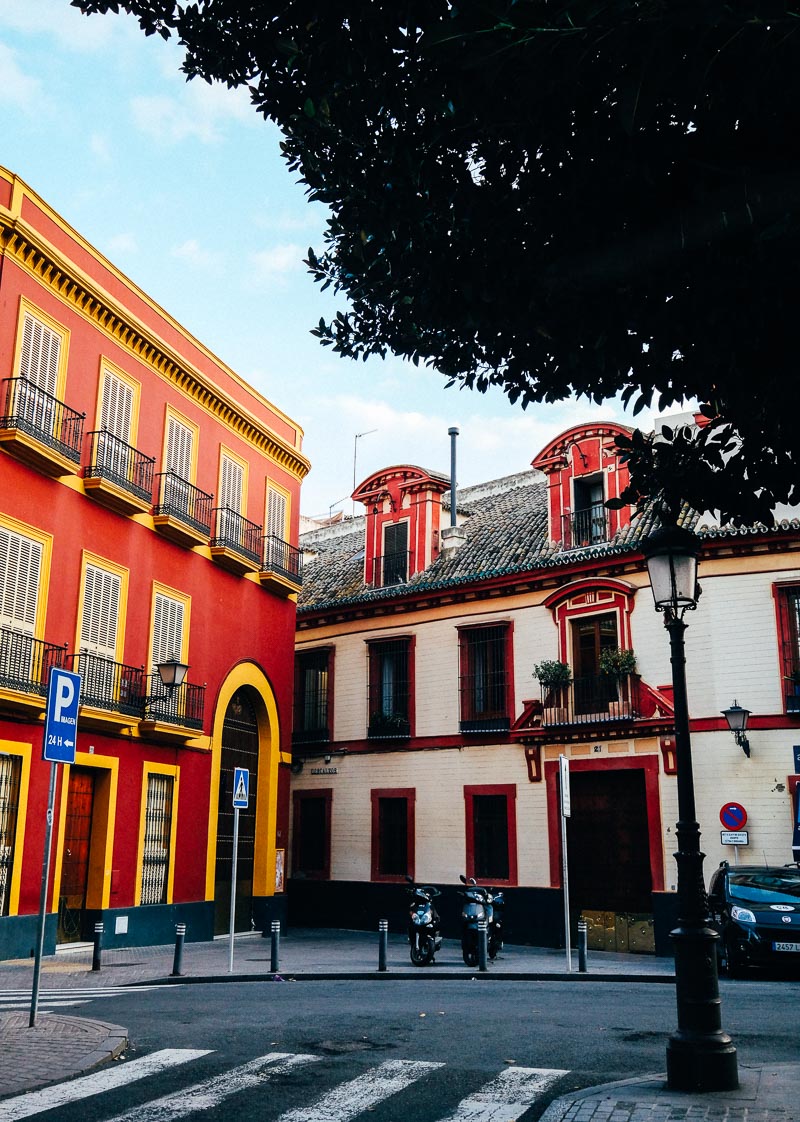
Quartier Santa Cruz, faites y votre shopping
Si vous cherchez un endroit pour faire quelques emplettes, rendez-vous dans le quartier très sympa de Santa Cruz
Bon à savoir pour visiter Séville :
- Essayez de venir hors saison. En février, les touristes étaient principalement des espagnols mais les trottoirs étaient déjà bien bondés.
- Réservez vos visites à l’avance pour gagner du temps même en hors saison.
- Choisissez votre hébergement dans le centre, tout se fait à pied.
- La capitale se visite à pied, en vélo, en trottinette ou en segway.
- Le porte bébé est pratique car il y a pas mal de pavés mais finalement nous avons utilisé la poussette comme bon nombre de touristes espagnols. Très peu de parents en porte bébé étonnamment.
- Les autres lieux que nous aurions aimé faire : une soirée flamenco et le Museo de Bellas Artes
Nos liens utiles :
- Réservez votre hébergement à Séville parmi les meilleures offres de notre partenaire Booking .
Vous aimerez peut-être aussi
3 commentaires.
Quelle jolie ville, les photos donnent vraiment envie d’y aller ! 🙂
Superbe article, richement illustré. Nous devons justement partir a Seville en avril. Nous avons grace à vous plein d’idées.
Bonjour, Superbe compte rendu de séjour comme d’habitude! J’adore votre blog et votre philosophie de voyage qui me donnent toujours plein d’idées! Petite question relative à votre logement: dans quel hôtel avez-vous logé? Je cherche désespérément un établissement, ce n’est vraiment pas évident à Séville, malgré le choix! Merci pour votre réponse et continuez à nous faire rêver!
Laisser un commentaire Annuler la réponse
Votre adresse e-mail ne sera pas publiée. Les champs obligatoires sont indiqués avec *
En utilisant ce formulaire, vous acceptez le stockage et le traitement de vos données par ce site Web. *
Prévenez-moi de tous les nouveaux commentaires par e-mail.
Ce site utilise Akismet pour réduire les indésirables. En savoir plus sur comment les données de vos commentaires sont utilisées .
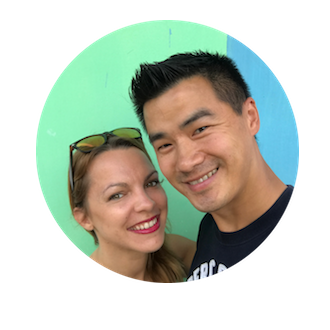
Suivez nous sur @
Instagram @leslovetrotteurs.

Articles les plus lus
Nos destinations
On vous recommande.
Visiter Séville en 4 jours : Itinéraire pour tout découvrir !
Située au cœur de l’ Andalousie , dans le sud de l’Espagne, la ville de Séville est difficilement définissable en un seul mot. Riche de son patrimoine historique, architectural et culturel, cette cité internationale a su mêler tradition et modernité. Embrassez la belle Andalouse avec mon programme d’activités pour visiter Séville en 4 jours et ne rien manquer des trésors sévillans.
Avant de vous partager mon itinéraire pour visiter Séville en 4 jours , je vous propose de découvrir les activités à absolument faire lors de votre séjour.
ACTIVITÉS À FAIRE À SÉVILLE :
Avertissement : Cet article peut contenir des liens affiliés, ce qui signifie que je reçois une petite commission si vous décidez d’effectuer un achat via mes liens, sans frais pour vous. Veuillez lire les mentions légales pour plus d’informations.
- Billet coupe-file pour la Cathédrale de Séville et la Giralda – 4,5/5 (sur + de 10 000 avis). Réservez sans faute votre billet pour découvrir deux des monuments sévillans les plus visités. À acheter ici en français .
- Visite de l’Alcazar, de la Cathédrale et de la Giralda – 8,5/10 (sur + de 200 avis). Partez à la découverte de trois des plus importants monuments de Séville lors d’une visite guidée en français de 2 h 30. À réserver ici .
- Billet coupe-file pour l’Alcazar royal — 4,6/5 (sur + de 8400 avis). Réservez votre passage prioritaire pour ce monument incontournable de Séville. Billet ici en français .
- Billet pour la Casa de Pilatos – 4,5/5 (sur + de 1400 avis). Admirez l’un des plus beaux palais sévillans de style mudéjar gothique. À réserver ici .
- Billet pour le Palais de las Dueñas – 4,7/5 (sur près de 600 avis). Découvrez un autre palais d’exception au cœur de la cité sévillane. À réserver ici .
- Free Tour dans Séville – 9,7/10 (sur + de 1000 avis). Découvrez le centre historique sévillan auprès d’une guide francophone passionnée durant une visite gratuite d’une à deux heures. À réserver ici .
- Visite guidée de Séville à vélo – 4,7/5 (sur + de 600 avis). Explorez la capitale andalouse en vélo électrique lors d’une excursion animée par un guide francophone. À réserver ici.
- Bus touristique de Séville — 8/10 (sur + de 500 avis). Profitez d’un moyen ludique et pratique pour découvrir la cité sévillane à votre rythme (montée et descente du bus à votre guise auprès des 14 arrêts de la ligne). Billet à acheter ici.
- Navette fluviale de Séville – 7,8/10 (sur + de 3000 avis). Que diriez-vous de découvrir la ville à bord d’un bateau le long du fleuve Guadalquivir ? À réserver ici .
- Spectacle de flamenco à Triana — 9,3/10 (sur + de 550 avis). Assistez à une superbe représentation du Baraka Sala Flamenco au cœur du tablao flamenco Cava de Triana ( à réserver ici ).
- Spectacle de danse flamenco du Teatro Flamenco Madrid – 4,7/5 (sur + de 4500 avis) – à réserver ici ou spectacle de flamenco au sein de la Casa de la Memoria , l’un des plus authentiques tablaos flamenco – 4,7/5 (sur + de 5300 avis) – à réserver ici .
- Transfert dans Séville – 9,6/10 (sur + de 2800 avis). Profitez d’un service de transfert depuis votre hôtel ou depuis votre lieu d’arrivée à Séville (gare ferroviaire ou aéroport). À réserver ici.
ACTIVITÉS À FAIRE AU DÉPART DE SÉVILLE :
- Excursion à Grenade, l’Alhambra et l’Albaicín depuis Séville – 4,5/5 (sur près de 900 avis). Vous séjournez dans la cité sévillane, mais vous souhaitez découvrir en une journée les plus importants trésors andalous à proximité ? Profitez de cette visite guidée en français depuis Séville pour visiter le superbe palais de l’Alhambra (palais nasrides, l’Alcazaba et les jardins du Généralife) et l’authentique quartier maure médiéval de l’Albaicín à Grenade. Réservez votre excursion ici.
- Visite de la ville de Cordoue et de Carmona – 4,5/5 (sur + de 700 avis). Quittez Séville le temps d’une excursion guidée en français vers la superbe ville de Cordoue et sa cathédrale-mosquée après la découverte du pittoresque village de Carmona. À réserver ici .
- Explorez le Caminito del Rey depuis Séville ! — 4,6/5 (sur plus de 400 avis). Partez pour une journée de marche au cœur des Gorges de Los Gaitanes et El Chorro et empruntez le sentier de randonnée considéré pendant longtemps comme le plus dangereux au monde ! À réserver ici.
- Ville romaine d’Italica – 4,6/5 (sur plus de 300 avis). Découvrez l’antique cité romaine d’Italica et le monastère médiéval lors d’une excursion d’une demi-journée au départ de Séville. À réserver ici.
- Visite des villages blancs et de Ronda – 4,9/5 (sur 50 avis). Quittez Séville pour découvrir les superbes pueblos blancos de Zahara de la Sierra et de Grazalema (Setenil de la Bodegas et Arcos de la Frontera sur demande) ainsi que la très belle ville de Ronda. Une journée d’excursion accompagnée d’un guide francophone à ne pas manquer. À réserver ici.
Je vous conseille de réserver les activités en avance (vous pouvez les annuler sans frais jusqu’à 24 h avant le début de l’activité), pour avoir des prix plus intéressants (il y a souvent des promotions) et pour être sûr de ne rien manquer des incontournables lors de votre séjour à Séville .
Le quartier de Santa Cruz ou ancien quartier juif
La casa de pilatos, le real alcazar et ses célèbres jardins, la cathédrale notre-dame du siège de séville et la tour de la giralda, la plaza de españa, le parc maria luisa, la fabrique royale de tabac de séville, la plaza del salvador, le metropol parasol, le quartier et la basilique de la macarena, les arènes de séville, la torre del oro, l’isla de cartuja, triana ou l’ancien quartier gitan, explorer séville en 4 jours : jour 4 — ronda, les villages blancs et le flamenco, visiter séville en 4 jours : jour 1 — découverte de la vieille ville.
Pour cette première journée au rythme sévillan, direction la vieille ville composée du quartier de Santa Cruz , cœur historique de Séville, du quartier d’Arenal , site de l’ancien port et du Centre-ville . Construite sur les vestiges de l’ancienne cité antique, Séville regorge de sites d’intérêt à découvrir. Plusieurs de ses monuments sont inscrits au Patrimoine mondial de l’Unesco.
Le quartier de Santa Cruz est l’ancien quartier juif de Séville . En vous promenant à travers les étroites ruelles piétonnes, vous aurez l’occasion d’admirer les boutiques accolées les unes aux autres. L’ambiance y est calme et vous mènera à la promenade de Catalina de Ribera et aux Jardins de Murillo . Situé à proximité des murailles des jardins de l’Alcazar, ce parc historique est considéré comme un bien d’intérêt culturel.
Datant du 16 e siècle, la Casa de Pilatos est l’une des plus belles demeures aristocratiques de Séville. Symbole de la Renaissance, l’architecture du palais marie les styles mudéjar, Renaissance et gothique. Il abrite de nombreux patios, des sols et colonnes de marbre, des murs décorés d’azulejos, des plafonds à caissons et plusieurs jardins aux délicates senteurs de jasmin et de fleur d’oranger. Sa superficie et la qualité de son architecture en font le deuxième palais le plus prestigieux de Séville après l’Alcazar.
Réservez votre billet pour la visite du rez-de-chaussée de la Casa de Pilatos ici.
L’Alcazar de Séville est un palais fortifié, construit en 844 par les Omeyyades d’Espagne. Considéré comme un symbole de l’architecture mudéjar, art hispano-musulman, l’Alcazar est un ensemble de palais de différentes époques et influences. Les styles maure, mudéjar, gothique, de la Renaissance et baroque se mêlent avec brio et témoignent des différents peuples et rois qui ont occupé la ville.
Le palais est habité par la famille royale d’Espagne quelques fois par an. Inscrit au Patrimoine mondial de l’UNESCO depuis 1987, ce site d’exception dispose également de magnifiques jardins où vous pourrez flâner et respirer les différents parfums floraux.
Si vous séjournez à Séville en été , visitez le palais de nuit et profitez des spectacles nocturnes organisés dans les jardins. Je vous conseille de réserver une visite guidée afin de ne manquer aucune des richesses de l’Alcazar. Il existe des formules avec guide, comprenant la découverte des monuments de l’Alcazar et de la Cathédrale de Séville .
Profitez de cette visite guidée et du billet coupe-file pour la visite de l’Alcazar de Séville
À LIRE AUSSI : Visiter le Real Alcázar de Séville : toutes les informations ( histoire, horaires, tarifs)
Située à proximité de l’Alcazar, la Cathédrale de Séville ou « Catedral de Santa María de la Sede » est l’une des plus grandes églises chrétiennes mondiales et la plus grande cathédrale gothique au monde. Anciennement mosquée almohade, le site fût transformé entre le 15e et le 16e siècle en temple chrétien.
Composée de plus de trente chapelles, la cathédrale est également connue pour abriter le tombeau de Christophe Colomb et le plus grand retable chrétien au niveau mondial. Inscrite au Patrimoine mondial de l’UNESCO en 1987, elle contient également l’une des plus grandes collections de peintures d’Espagne, la classant comme troisième musée national de peinture.
Poursuivez votre visite de la Cathédrale par la découverte de l’ancien minaret : la tour Giralda, symbole sévillan. Pour accéder au sommet, haut de 98 mètres, vous devrez emprunter une rampe et gravir plus de 35 paliers. La vue sur l’ensemble de l’édifice, sur les allées d’orangers et sur la ville termine en beauté l’exploration de ce lieu d’exception à Séville.
Réserver votre billet coupe-file ici pour éviter de perdre du temps !
À LIRE AUSSI : Poussez les portes de la Cathédrale de Séville et de sa Giralda, deux visites sévillanes incontournables
Parcourir Séville en 4 jours : Jour 2 — La Ville Moderne
La ville de Séville allie de façon homogène et naturelle, tradition et modernité. Les monuments et sites plus récents s’inscrivent également dans la liste des lieux sévillans à découvrir absolument. Des exceptionnelles constructions réalisées à l’occasion de l’Exposition de 1929 aux « Las Setas » de Séville, place au programme de ce deuxième jour.
Direction la Place d’Espagne. Construit à l’occasion de l’Exposition ibéro-américaine de 1929, ce bâtiment semi-circulaire est l’œuvre de l’architecte sévillan Aníbal González. La place possède 48 bancs décorés d’azulejos, un canal et quatre superbes ponts représentant chacun des anciens royaumes : Navarre, Léon, Castille et Aragon.
Comme de nombreux monuments andalous, le Palais est inspiré de différents styles architecturaux : néo-renaissance, gothique et mudéjar. La place d’Espagne est l’une des plus impressionnantes places de Séville.
Après la visite de la Place d’Espagne, prenez le temps de découvrir le plus grand parc urbain de Séville . L’espace vert fut réaménagé par le paysagiste français Jean-Claude Nicolas Forestier à l’occasion de l’Exposition latino-américaine de 1929. Il comprend tous les pavillons de l’Exposition et abrite de nombreux étangs et fontaines.
C’est également un superbe jardin botanique. Vous y découvrirez une multitude d’espèces végétales, locales ou exotiques. Petite particularité encore : flânez à travers les allées et observez différents oiseaux ayant élus domicile au sein du parc, dont des perroquets verts au sommet des palmiers.
À LIRE AUSSI : Flâner dans le parc Maria Luisa à Séville, le poumon vert où trouver la Plaza de España
Avant de regagner le centre-ville, passez par l’ancienne manufacture de tabac de Séville . Construite au XVIIIe siècle afin de satisfaire la demande croissante, cette imposante bâtisse est le deuxième plus grand monument d’Espagne. Elle est classée depuis 1959 comme Monument national. Depuis l’arrêt des productions en 1950, la Fabrique royale accueille les services de l’ Université de Séville .
Elle se compose de plusieurs patios et d’une chapelle, abritant aujourd’hui la Confrérie religieuse de la « Hermandad de Los Estudiantes ». Fondée en 1924 par des étudiants et professeurs, elle participe chaque année à la Semaine sainte. La visite de la Fabrique est gratuite et permet de déambuler tout en admirant l’architecture.
La fin de journée s’annonçant, direction la Plaza Del Salvador . C’est sur cette place entièrement piétonne que se trouve l’Église du Salvador , la plus grande église après la Cathédrale. Vous pourrez vous détendre dans l’un des nombreux bars de la place, baigné dans l’ambiance sévillane. Poursuivez votre chemin vers la Place San Francisco pour savourer les spécialités de la cuisine andalouse.
Terminez votre deuxième journée à Séville, par la visite du Metropol Parasol . Surnommé « Las Setas » (les Champignons), cette œuvre organique est la plus grande structure en bois au monde. Dessiné par l’architecte allemand Jürgen Mayer, l’édifice fut inauguré en 2011. Haut de 26 mètres, il se compose de six grands parasols et d’une passerelle-belvédère offrant une vue à 360 degrés de la ville, accessible en ascenseur.
À LIRE AUSSI : Visiter le Metropol Parasol, les étonnants « champignons de Séville »
Lors de sa construction, des vestiges archéologiques des époques romaine et arabe ont été retrouvés. Ils sont visibles dans l’ Antiquarium situé au sous-sol du monument. N’hésitez pas à visiter les parasols en fin de journée pour profiter de magnifiques couchers de soleil sur la ville.
Découvrir Séville en 4 jours : Jour 3 — Autour du fleuve Guadalquivir
Bien qu’il soit possible d’opter pour une excursion sur le fleuve Guadalquivir, je vous propose de poursuivre les découvertes des lieux d’intérêt de la ville à pied.
En route vers le quartier alternatif et festif de La Macarena et sa basilique . Construite en 1949, la basilique de la Macarena est une église colorée de style néo-baroque. Elle fut édifiée en l’honneur de la « Virgen de la Esperanza Macarena ». Cette statue de la Sainte-Vierge s’avère remarquable en raison de sa beauté et de la richesse de ses ornements réalisés à partir d’or, d’émeraudes et de diamants.
Après avoir visité la Basilique, pourquoi ne pas profiter de l’ambiance qui règne sur la Plaza Alameda de Hercules, le temps d’un verre en terrasse. Au cœur du « quartier des Artistes », cette place est emblématique de la vie festive sévillane.
En plein centre du quartier de l’Arenal , se situent les Arènes de Séville ou la Plaza de Toros de la Real Maestranza de Caballería de Sevilla. Construites en 1761, berceau de la tauromachie, elles sont considérées comme les plus importantes arènes d’Espagne. Elles accueillent notamment l’une des plus célèbres fêtes andalouses, la Feria de Abril.
Promenez-vous le long du fleuve jusqu’à la Tour de l’Or . La Torre del Oro est située sur la rivière Guadalquivir, près de la Plaza de Toros. Haute de 36 mètres, cette tour de guet fut construite par les Almohades au XIIIe siècle. Elle constituait l’un des remparts maures, entre le palais fortifié d’Alcázar et le reste de la ville. Le dernier étage de la Tour d’Or abrite le Musée Maritime (Museo Naval).
À LIRE AUSSI : Tout savoir de la Torre del Oro | Histoire et modalités pratiques pour la visiter
C’est sur le site de Cartuja que s’est tenue l’Exposition universelle de 1992 , autour de la chartreuse de Séville. La chartreuse Notre-Dame de las Cuevas est un ancien monastère chartreux, rénové à cette occasion. Une légende raconte que la Sainte Vierge serait apparue sur le site au XIIIe siècle. Le Monastère est classé bien d’intérêt culturel depuis 1964. Depuis 1997, elle abrite le Centre andalou d’Art contemporain .
Le quartier est célèbre pour son artisanat traditionnel : ses carreaux de céramique (azulejos) . Emerveillez-vous en visitant le Centre de Céramique et devant les façades colorées du boulevard de Triana. C’est aussi l’endroit idéal pour faire la fête avec les sévillans dans l’un des nombreux bars animés.
Promenez-vous dans le quartier de Triana , réputé pour ses artisans et ses spectacles de Flamenco . Situé de l’autre côté du fleuve Guadalquivir, le quartier p opulaire de Séville est accessible par le superbe Puente de Isabel II . Il s’agit de l’ancien quartier gitan où s’établirent les premiers Tziganes nomades venus de l’Est.
Voici une proposition de visite guidée du quartier, où vous aurez l’occasion d’entendre son histoire et de profiter d’une dégustation de tapas : réservation ici
Pour ce quatrième jour, il faudra louer une voiture ou faire des excursions au départ de Séville. Si vous souhaitez louer une voiture, pensez à réserver le plus tôt possible pour bénéficier de meilleurs tarifs et d’un plus large choix de véhicules, surtout si vous souhaitez partir en saison estivale.
Pour ce dernier jour au sein de la capitale andalouse, partez explorer les alentours de Séville à la découverte des villages blancs . Baladez-vous sur les traces des poètes et artistes dans la magnifique ville de Ronda , perchée au-dessus d’un impressionnant canyon. Aux alentours de Ronda, découvrez les villages blancs de Zahara de la Sierra et de Setenil de las Bodegas . Emblématiques de l’architecture andalouse , ces villages sont composés de maisons recouvertes annuellement à la chaux.
Si vous souhaitez profiter d’une excursion organisée autour de la découverte des villages blancs d’Andalousie depuis Séville, réservez ici vos billets
Enfin, terminez votre séjour en musique sur les airs envoutants du Flamenco. Assister à un spectacle dans un tablao de qualité comme la Casa de Memoria où se produisent les plus grands artistes. Situé dans le centre-ville, le patio dispose d’une capacité de 100 places. Aussi, je vous conseille de réserver 24 heures à l’avance.
Réservez vos billets ici pour le spectacle de flamenco organisé à la Casa de Memoria
À LIRE AUSSI : Où voir le meilleur spectacle de Flamenco à Séville ? Les 12 lieux à connaître
Impossible de rester indifférent au charme de la cité andalouse : les ruelles de la vieille ville, les parfums de jasmin et de fleur d’oranger, les incontournables tapas, les édifices exceptionnels, le son enivrant du flamenco ou encore l’ambiance chaleureuse des bars sévillans. Autant d’expériences à vivre lors de votre visite de Séville en 4 jours .
Consultez également mon article sur les 9 plus beaux musées de Séville à ne surtout pas manquer ! Retrouvez aussi les marchés de Séville les plus intéressants selon moi et mes conseils pour vous garer gratuitement dans le centre de Séville .
N’hésitez pas à réserver votre hôtel, votre voiture et vos activités à Séville, en passant par les liens ci-dessous. Cela me permettra de continuer à vous fournir gratuitement des conseils et astuces. Merci !
Vous aimerez aussi :
- Les meilleures visites et activités à Séville
- Métro à Séville : toutes les informations utiles
- Tramway à Séville : toutes les informations indispensables
- Se déplacer à Séville : tous les moyens pour circuler dans la capitale andalouse
- Top 12 des plus belles plages à proximité de Séville
- Top 10 des Édifices Incontournables de Capitale Andalouse
- Visiter le Parc National de Doñana : 10 façons de découvrir les trésors de cette réserve naturelle d’exception en Espagne
- Quels sont les meilleurs Parcs Aquatiques andalous ?
- Les plus beaux bords de mer de la Costa de la Luz (Huelva)
A propos de l'auteur
- South Africa
- Afghanistan
- North Korea
- Adventure + Outdoors
- Amusement Parks
- Backpacking Trips
- Boating + Cruises
- Budget Travel
- Bus + Train Travel
- Coasts + Islands
- Country Trips
- Fall Vacations
- Family Vacations
- Green Travel
- Heritage + History
- Honeymoons + Romance
- Inspiration + Guide
- Landmarks + Attractions
- LGBT Travel
- Markets + Bazaars
- National Parks + Reserves
- Nature + Wildlife
- Parks + Gardens
- Pets + Animals
- Photography
- Airlines + Airports
- Budgeting + Currency
- Business Travel
- Celebrity Travel
- Customs + Immigration
- Deals + Rewards
- Family Travel
- Hotels + Resorts
- Luggage + Packing Tips
- Offbeat News
- Photography Tips
- Responsible Travel
- Solo Travel
- Tech + Gear
- Travel Etiquette
- Travel Warnings
- Bars + Clubs
- Celebrity Chefs
- Restaurants + Cafés
- Wine + Vineyards
- Beach Hotels
- Boutique Hotels
- Hotel Openings
- Hotel Reviews
- Luxury Hotels
- Mountain + Ski Resorts
- Spa Resorts
- Vacation Rentals
- Asia Cruises
- European Cruises
- Festivals + Events
- Museums + Galleries
- Style + Design
- Travel’s Best
- Hotel with Agoda.com
- Hotel with Booking.com

Leh Ladakh bike trip blog — Ladakh bike trip guide &…

Guide to Shenzhen nightlife — Top 5 things & what to…

Ladakh trip cost per person from Delhi — How much does…
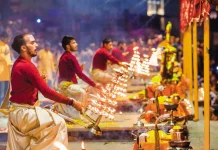
India travel tips — 25+ what & things to know before…

India trip tips — 9+ things to know before going to…

All about tips in Nepal — How much to tip in…

Cambodia travel tips — 15+ what to know & things to…

When is the best time to visit Kyoto? — The best,…

Must eat in Hong Kong — 7+ must eat & must…

Must eat in Georgetown — 10+ famous, must-eat & best street…

Must eat in Melaka — 10+ famous Malacca street food &…

Hong Kong Soya sauce Chicken Rice and Noodles — The first…

Top hotels in Siem Reap — 8+ best places to stay…

Top hotels in shanghai — 15+ best hotels in Shanghai

Top hotels in Malacca — 10+ good & best hotels in…

Top places to stay in Bali — Top 10 best areas…

10 must-know things for your best first time European river cruise

Top 3 best luxury cruises in Halong Bay, Vietnam

Cherry blossom festival Korea 2024 — Top 5 cherry blossom festivals…

Ghibli museum blog — The fullest Ghibli museum guide for first-timers

Kyoto festival — Top 10 best events & most famous festivals…

National Palace Museum Taipei blog — What to see in National…

Japanese waterfall — Top 10 most beautiful waterfalls in Japan in…

19+ most beautiful towns in Europe every tourist need to visit…

Georgia travel photos — 20+ captivating photos show Georgia is heaven…

Explore Damnoen Floating Market — The oldest floating market of Thailand

Visiting Fenghuang Ancient Town — One of the most charming ancient…

Mekong Delta travel blog — Beyond rivers of Southwestern Vietnam

14 reasons why you should travel when you are young

Shigaraki Tanuki – An animal symbol of good luck in Japan

Living in the charms of cave houses in Andalucia, Southern Spain

20+ jaw-dropping tiny homes around the world
Seville blog — the fullest seville travel guide & suggested seville itinerary 3 days for first-timers.
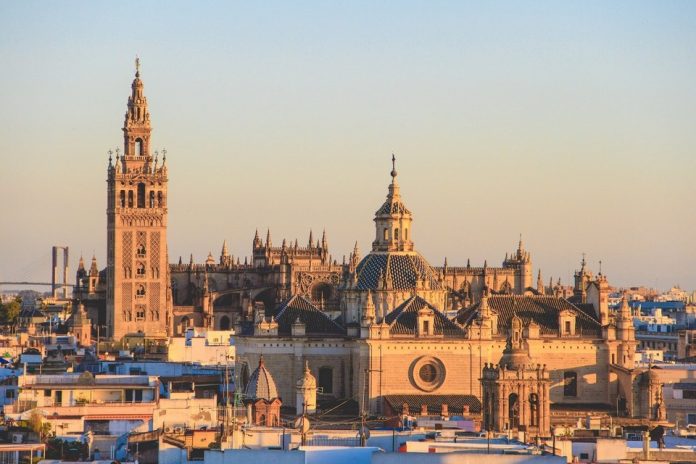
Seville (Spanish Sevilla) is known as the capital of the ancient and tranquil Andalusia (Andalucía in Spanish) region of Spain. If you think Seville is not as famous and not worth a visit as Madrid or Barcelona, then you are wrong. This is the convergence of the quintessence of the beautiful and prosperous Andalucia. The city of Seville always attracts visitors with ancient beautiful architecture with hundred years of history. Among them stand out with winding streets, famous churches and the home to the legendary flamenco dance.
- Where to eat in Seville? — 10 must & best place to eat in Seville
- What to buy in Barcelona? — 15+ must buy souvenirs, gifts & best things to buy in Barcelona
- Ronda blog — The fullest Ronda travel guide for first-timers
- Barcelona itinerary 1 day — How to spend 1 day in Barcelona & what to do in Barcelona in one day
- Park Guell guide — The fullest information on how to visit Park Guell
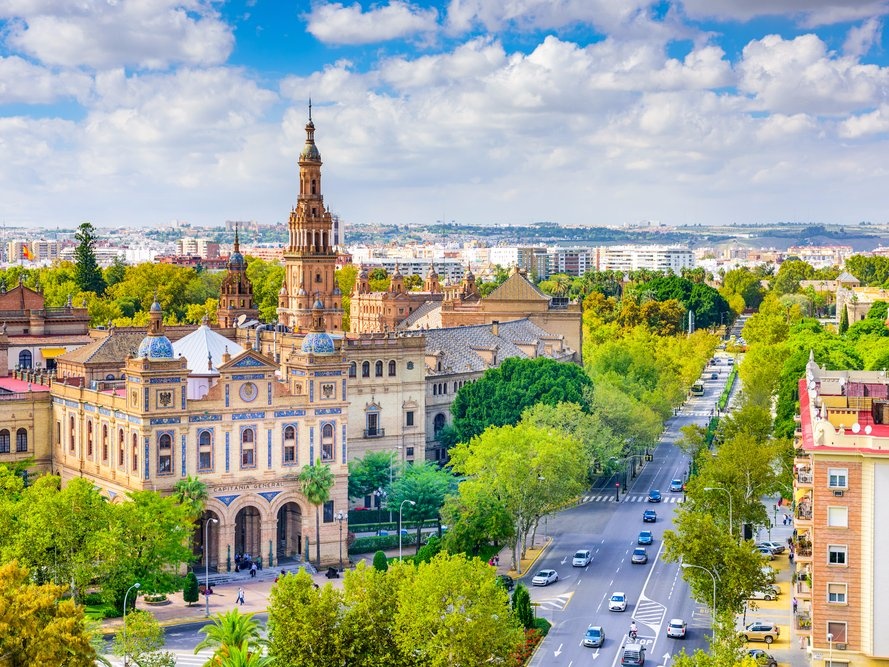
So, what to do and how to plan a budget perfect trip to Seville for the first-time? Let’s check out our Seville travel blog (Seville blog) with the fullest Seville travel guide (Seville guide, Seville tourist guide) from how to get, best time to come, where to stay, best places to visit and top things to do as well as suggested Seville itinerary for 3 days to find out the answer!

Overview of Seville (#seville blog)
Known for its charming flamenco dance, tapas and endless sunshine with an area of 140.8 km² and a population of 702,386 people (March, 2021), Seville is one of Spain’s top destinations. Seville with its Moorish history and diverse architectural styles influenced by a variety of cultures that sometimes will make you wondering whether you’re still in Spain or in North Africa. With a lot of things see and do, Seville is the perfect destination for any type of traveler.
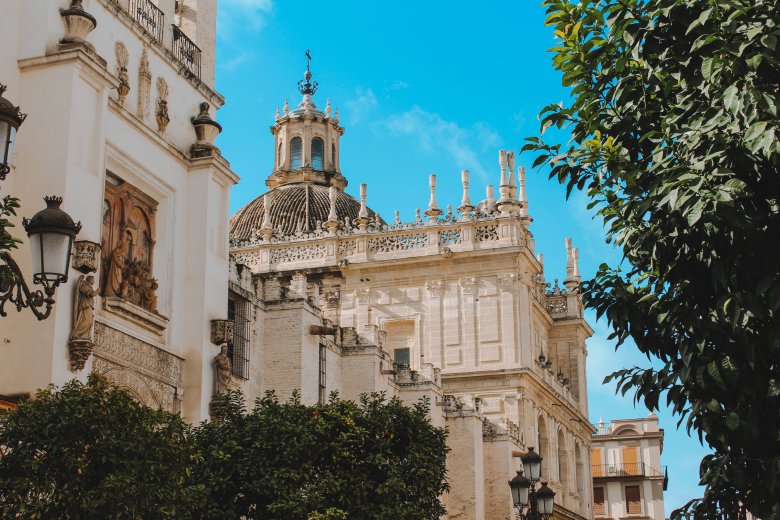
Seville is the fourth largest city in Spain and is a city with impressive historical value due to its long history dating back to the ancient Roman Empire 2000 years ago. From exploring a giant palace, take part in street festivals to learning bullfighting history, Seville offers a multitude of activities for you to do.
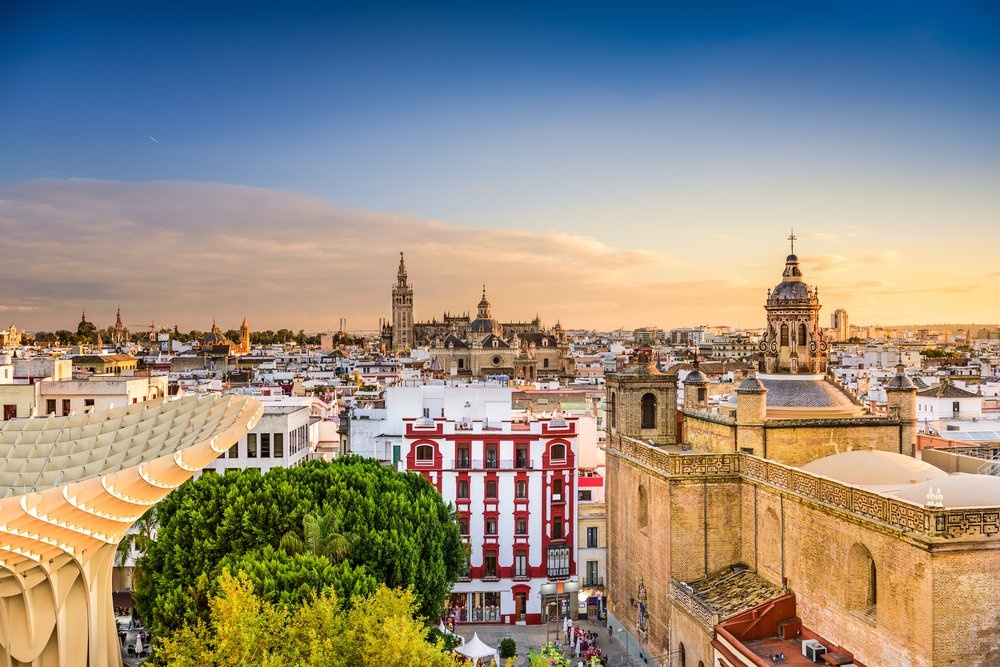
Besides important monuments and rich in history and culture, Seville is also known as a fun city. The Sevilla people are known for their for their wit, enthusiastic and sparkle and the city itself is vibrant and stands out for its vitality. It can be said that Seville is the city that embodies all the quintessence of Spain.
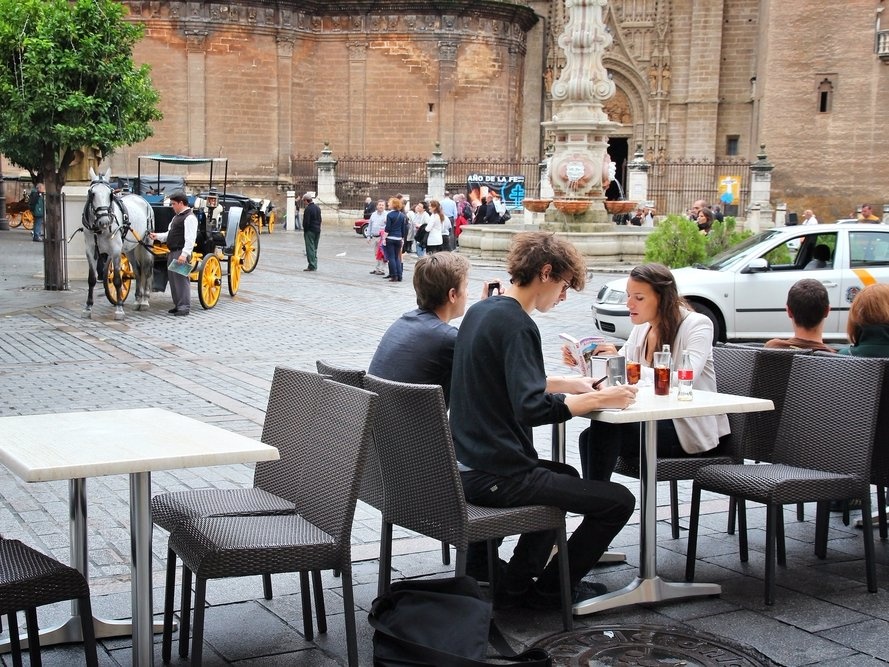
Seville travel guide: When to visit?
Seville is influenced by a subtropical Mediterranean climate with wet winters and long, dry summers. The best time to visit Seville is from late March, when the rainy season ends, until early June, when temperatures fluctuate between 24 degrees Celsius and 29 degrees Celsius. April is the best month with Semana Santa (Holy Week) and Feria de Abril de Sevilla (Seville’s April Fair), when residents wear colorful flamenco dresses and celebrate for six consecutive days.
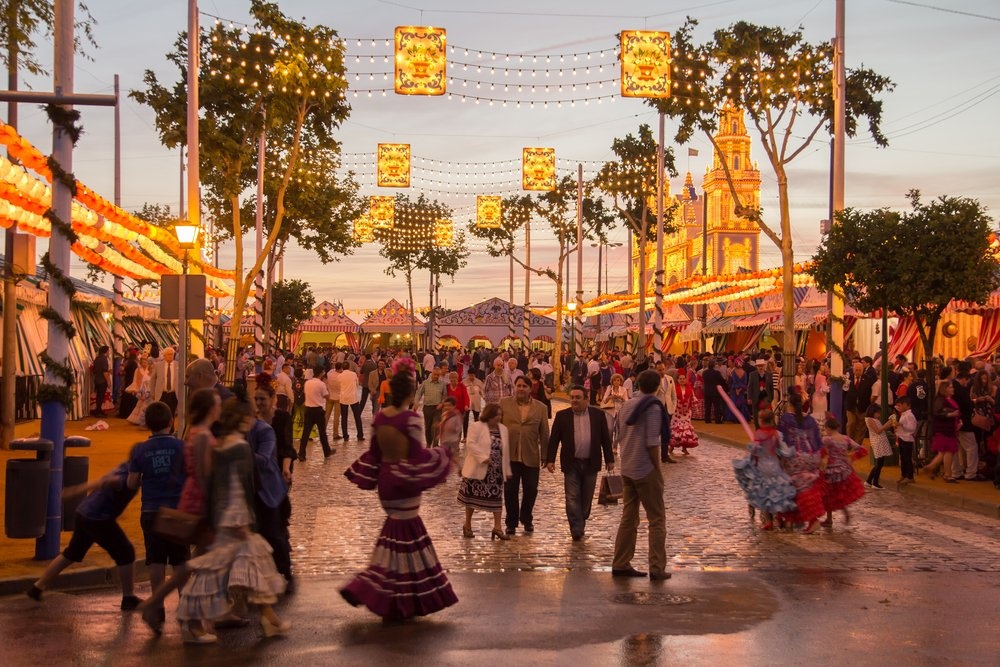
How to get to Seville?
From Madrid or Barcelona, if you’re looking for a cheap and reliable way to get to Seville, you can take a direct bus to Seville with no more than 6 hours of riding. Otherwise, an express train or a flight is another good option but it will be more expensive.
Airplane (#seville blog)
If you choose to fly with low-cost carrier such as Vueling from Madrid , you’ll probably arrive at Seville airport . A taxi to the city center costs about 25-30 euros/way. The EA bus will also take you to the city center in about 35 minutes for 4 Euros/way and 6 Euros/round-trip and you can take a taxi from its last stop to the hotel. Details see here.
From Barcelona you can also fly to Seville with Vueling, the airfare costs about EUR 20/one-way.
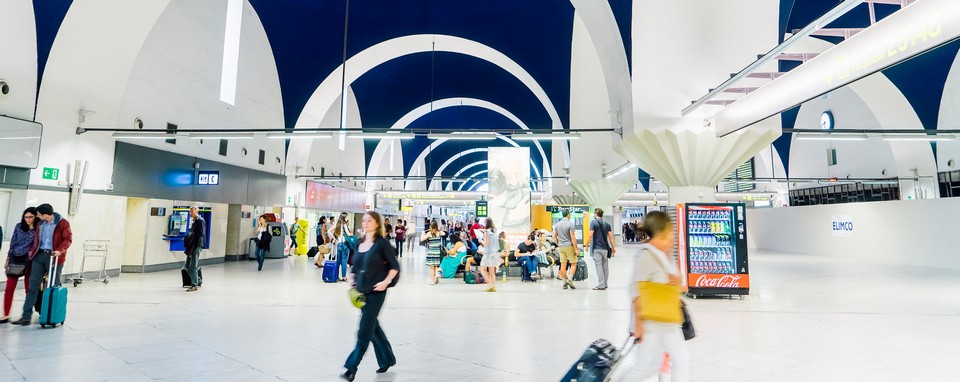
Spain has an efficient high-speed train system called Renfe AVE and is well worth the money when traveling around Spain. The Seville Santa Justa train station is the main station and likely the one you would pass by. It’s very crowded, so get here early if you’ve never been there as it may take time to find way.
The train from Madrid to Seville takes about 2 hours and 40 minutes of riding with covering a distance of approximately 390 km with the fare from EUR 23.35 while the train from Barcelona to Seville takes an average of 7 hours and 3 minutes of riding over a distance of around 830 km with the fare from EUR 19.12.
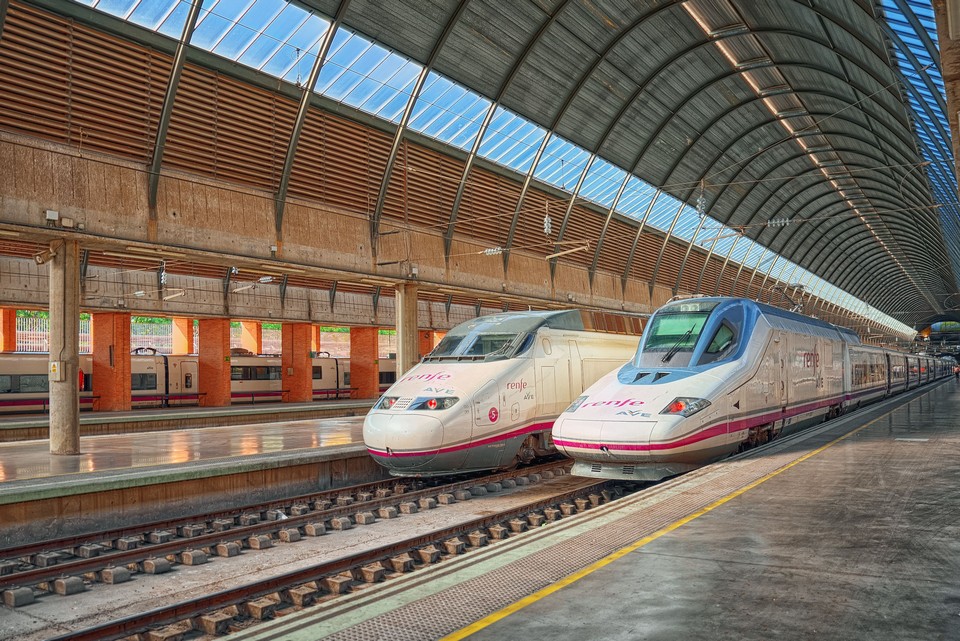
Read more: Guide to rail transport in Spain — How to travel around Spain by train & travel by train in Spain .
You can also take a bus from Madrid to Seville with traveling time from 5 to 7 hours and bus fare from EUR 38. Or take a bus from Barcelona with traveling time about 14 hours and 40 minutes and bus fare from EUR 40.
There are two bus stations in Seville, the Prado de San Sebastian Station and the Plaza de Armas Station. Check your ticket again to make sure you’re on the right way!
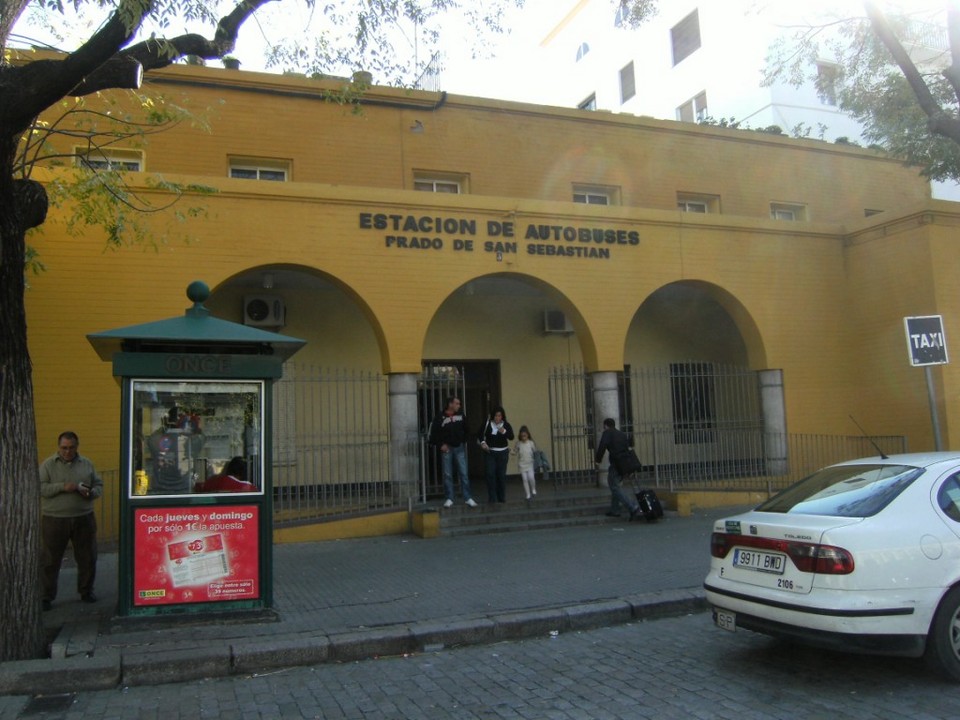
Seville guide: Getting around Seville
Besides the means to help you traveling between the attractions quickly and conveniently, are taxis, in Seville you can choose public transport such as buses, metro at much cheaper prices.
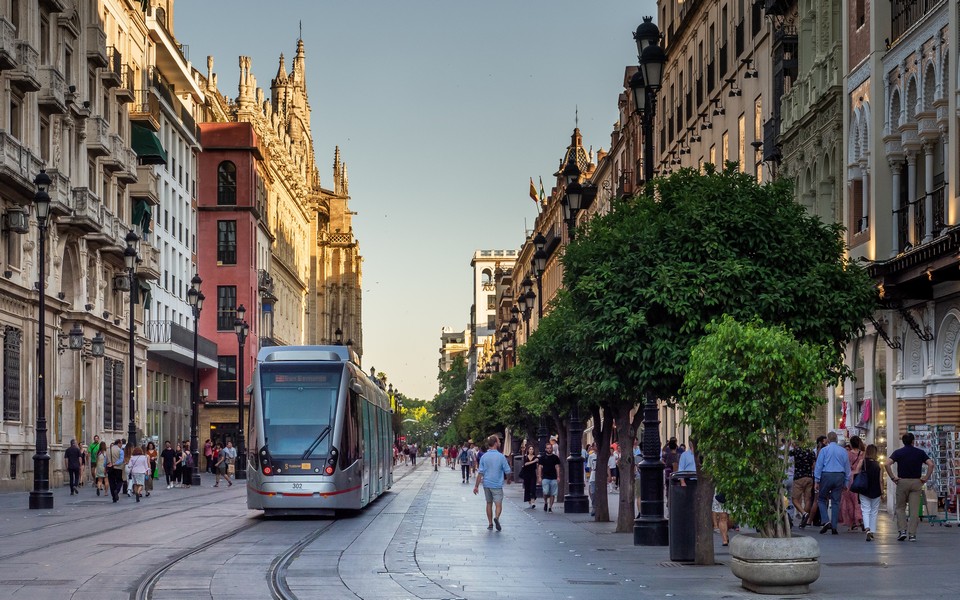
As mentioned above, the residents of Seville city have a very environmentally friendly lifestyle. Therefore, their means of transport are mainly “walking”, bicycles or electric bikes. You can follow them and walking on the streets of Seville. This is also a great way for you to discover the amazing architecture of this city.
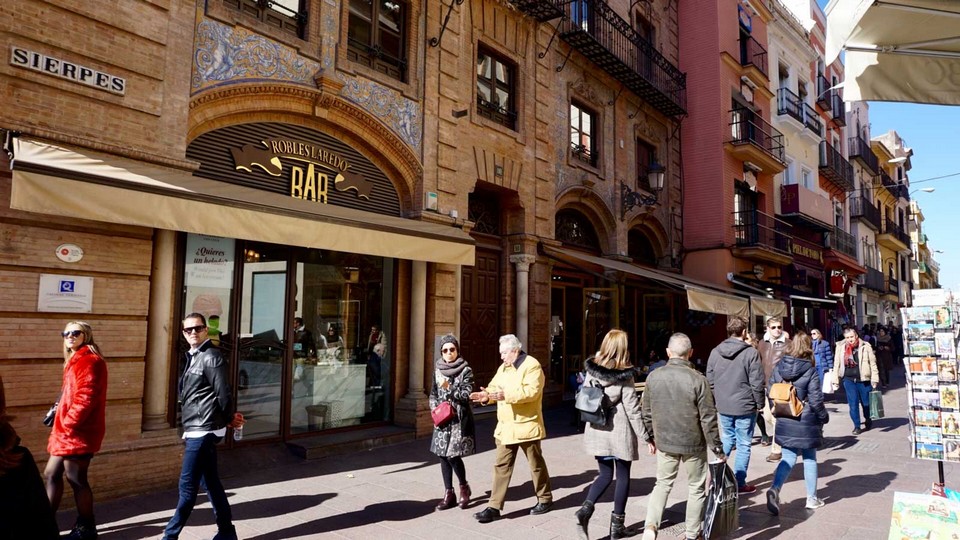
In addition, you also can experience Hop on – Hop off sightseeing bus with price of only EUR 20/trip or horse-rawn carriage.
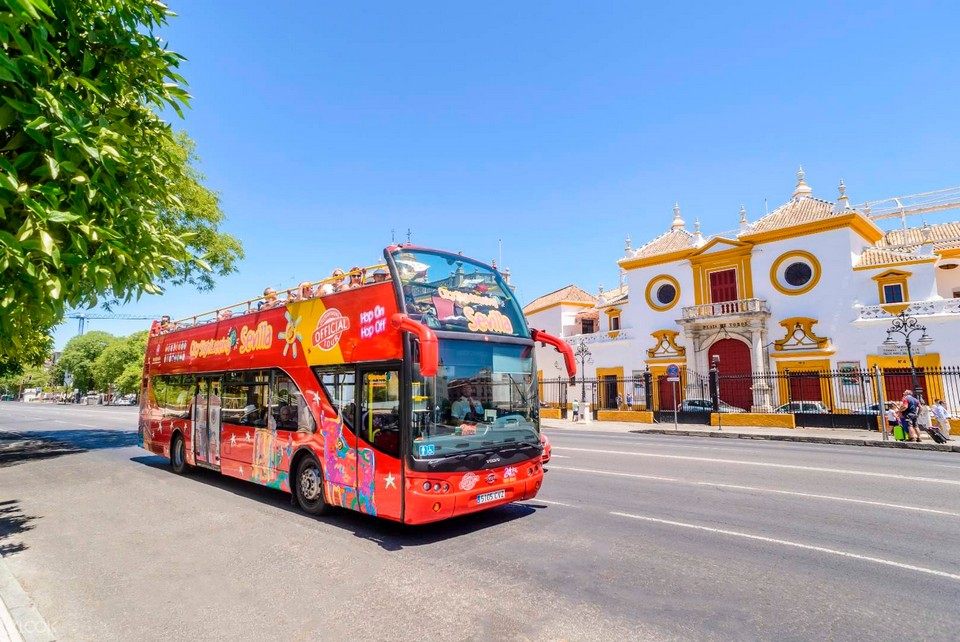
Seville Hop On Hop Off City Sightseeing Bus Tour
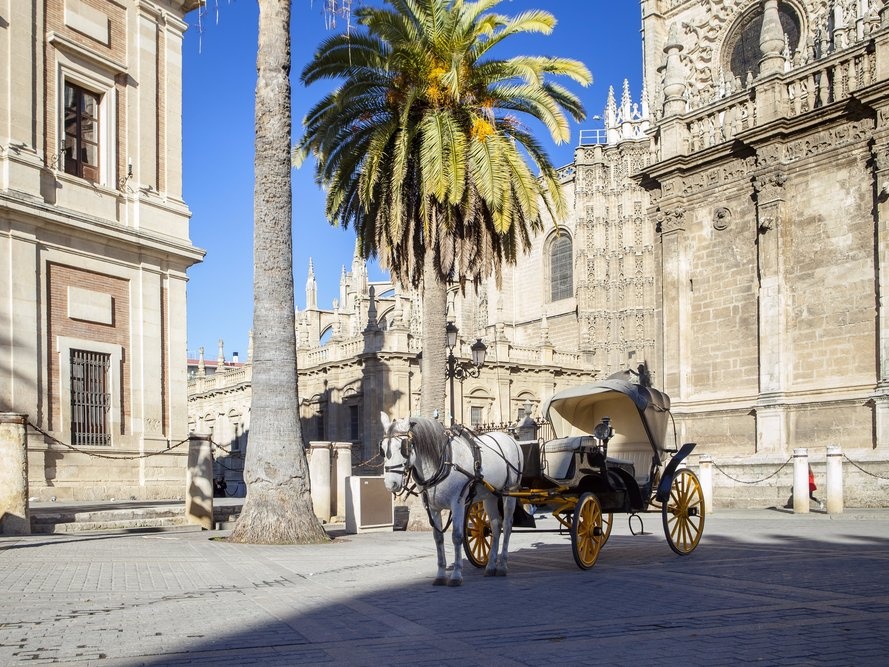
Seville travel blog: What to do and where to go?

Santa Cruz Old Town
Located in the heart of Seville city and is one of the primary tourist neighbourhoods of Seville. The streets with ancient architecture, stretching and still remain the tranquil though annually welcome a large number of tourists coming to Seville. Along the streets are cafes of true Mediterranean style and at the streets corners the painters are leisurely painting. The Santa Cruz streets also lead to the most beautiful squares of Seville called Plaza de Espana, one of the best places to watch the outstanding Giralda bell tower in Baroque style.
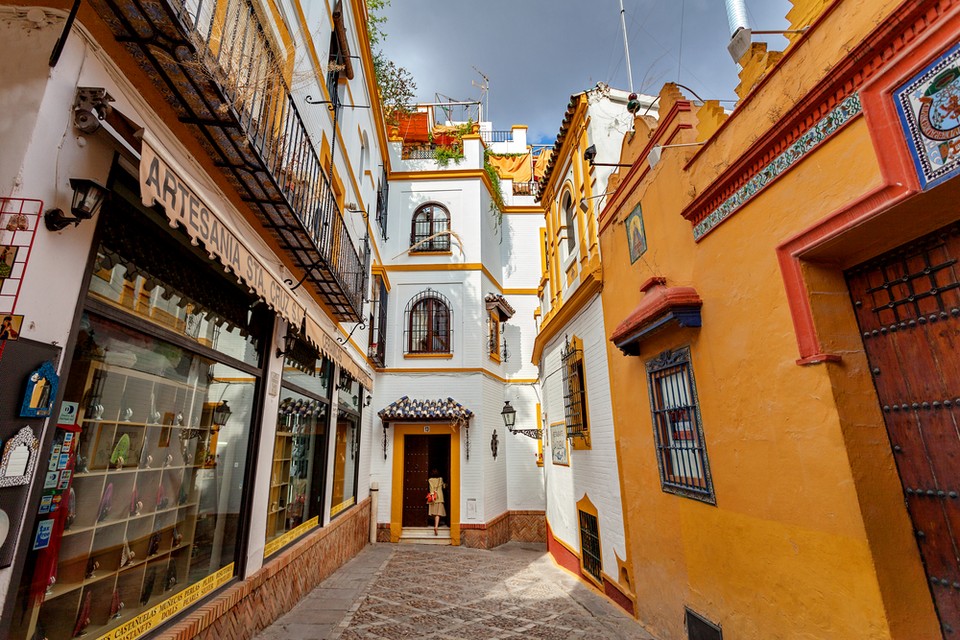
Plaza de Espana
Plaza de Espana Square is one of the most famous and must-visit landmarks in Seville, having been the filming location for many blockbuster movies such as Star Wars II – Attack of the Clones (2002), The Dictator (2012) and Lawrence of Arabia (1962), the square designed by the great Seville architect Aníbal González.
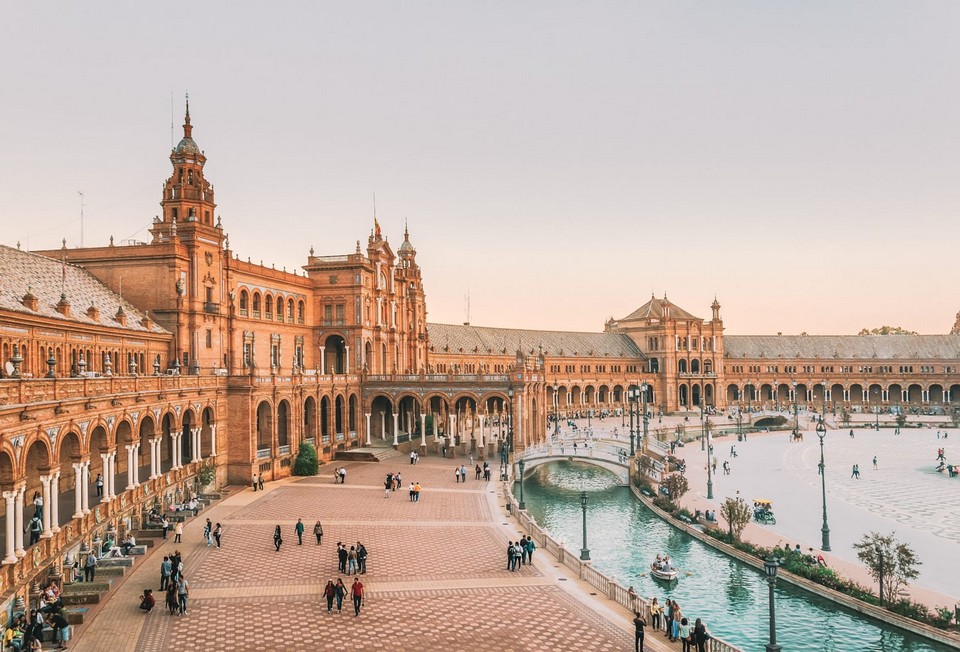
This square located in Maria Luisa Park was completed in 1928 with a beautiful view with semicircular buildings on one side and an artificial canal 515 meters long running along the tiled alcoves. You can take a boat tour, it’s truly romantic experience. Many tiled alcoves also were built around the plaza, they representing for provinces of Spain. The plaza is designed in combination of many architectural styles including Art Deco and Spanish Renaissance Revival, Spanish Baroque Revival and Neo-Mudéjar styles.
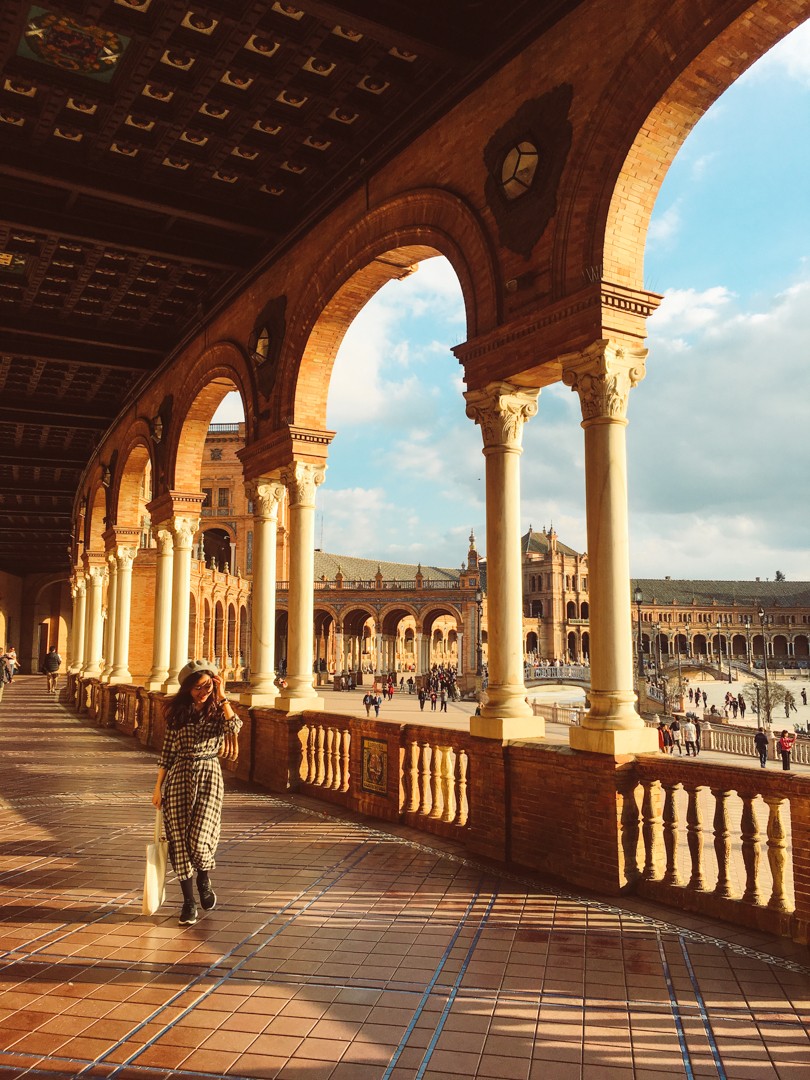
Plaza de Espana is the most epic squares of the city of Seville. This site was built for the Ibero-American Exposition of 1929 – A world fair aimed at strengthening links between Spain and other countries in 1929.
Address: Av. Isabel la Católica, 41004 Sevilla, Spain Hours: Open 24 hours
Maria Luisa Park
Across from Plaza de Espana square is the beautiful Maria Luisa park, where you can hide in the sun and enjoy the beautiful nature and chirping birds. Be sure to observe every detail of the structures when you step inside the park, from beautiful bridges on small canalsto a stopover that looks like it was inspired by a fairy tale.

Address: Paseo de las Delicias, s/n, 41013 Sevilla, Spain Hours: 8AM–10PM
Seville Cathedral
It is not only a famous tourist place in Seville but also a familiar name on all European tourist maps of all visitors. Dubbed the symbol of the city, always appearing on every advertising page, postcard about the city of Seville. The church was built from a platform of an old mosque in 1402, so it partly is influenced by the meticulous design of Islamic architecture, especially the famous Giralda bell tower. The inside of the church is beautifully decorated with a large amount of gold and many Gothic sculptures. Even without going inside, you can still appreciate the intricate details and the hard working efforts that made up this massive, beautiful cathedral.
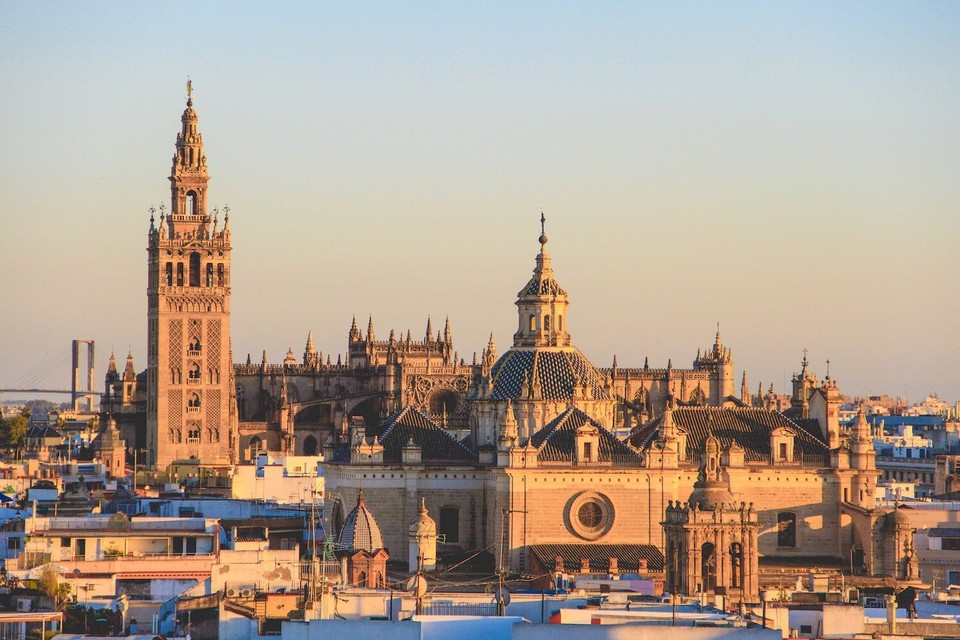
- Cathedral, Alcazar, and Giralda Guided Tour Combo Tickets in Seville
In terms of size, this church is ranked 3rd in Europe with an area of 11,520 square meters. This is also the final resting place of the great explorer Christopher Columbus, you can go insiden and admire his tomb.
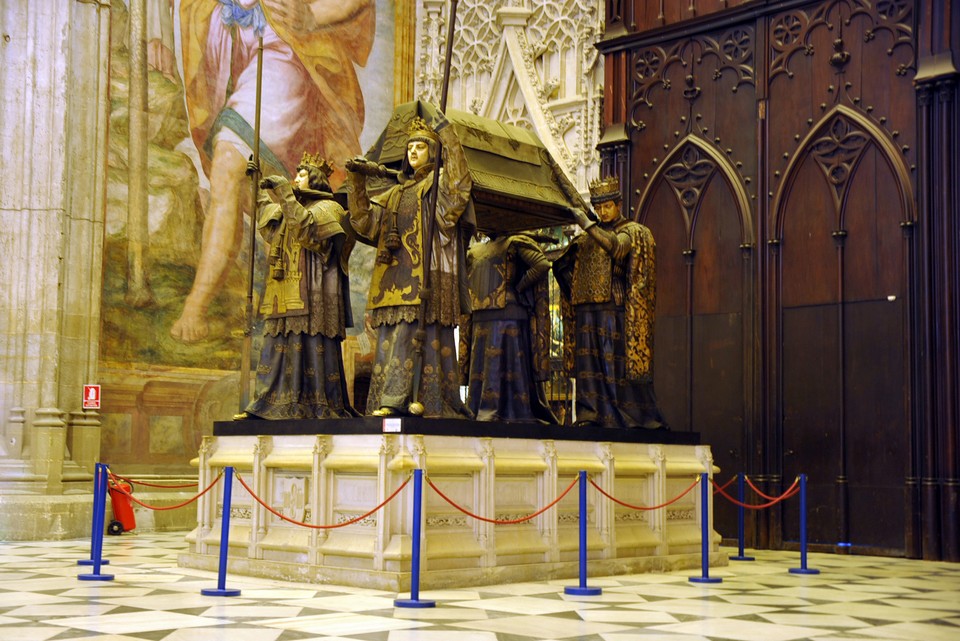
Address: Av. de la Constitución, s/n, 41004 Sevilla, Spain Hours: 8AM–2PM, 4–7PM Architectural style: Gothic architecture
Palace of the Dukes of Alba (Palacio de las Duenas)
Full convergence of beautiful features that make visitors delighted at first sight. This historic building is a national monument of Spain. It was built in 15th century and influenced by mix architectural styles such as Renaissance, Gothic and Moorish. It also a birthplace of the great poet Antonio Machado. It owns many courtyards and buildings with local influences in the bricks, shingles, tiles, whitewashed walls and pottery. It also houses a chapel.
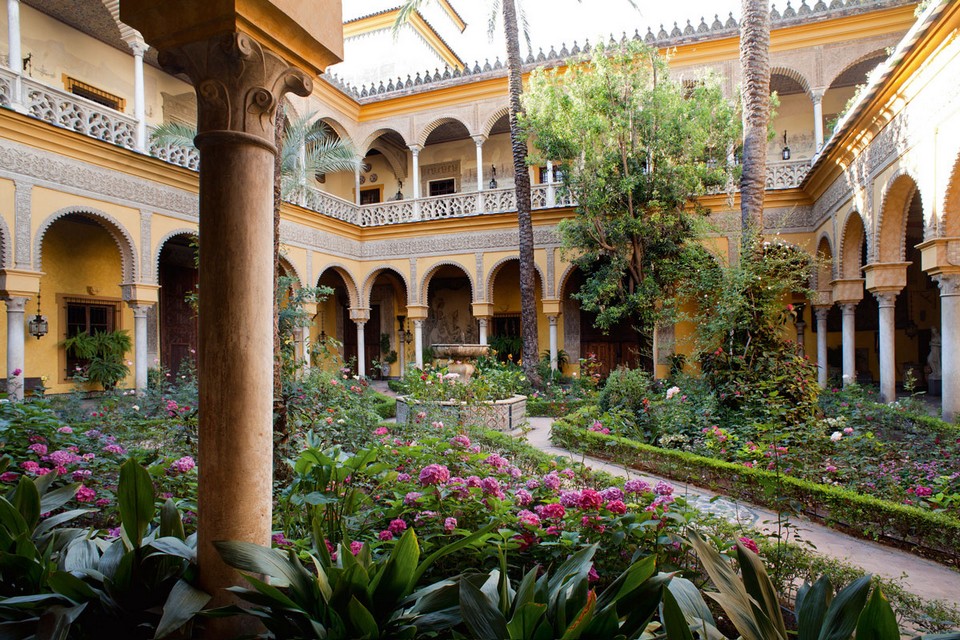
Address: Calle Dueñas, 5, 41003 Sevilla, Spain Hours: Saturday, Sunday: 10AM–2:15PM
The old town of Macarena
Another Seville’s hidden gem is the old town of Macarena. Although it is still part of the historic center of Seville, it is lesser known to visitors. This working-class neighborhood retains some of its original charm and is currently being recreated as Seville’s arts center. In addition to wandering around the back streets and drinking at one of the many local bars in this neighborhood, you can also enjoy Spanish cuisine here.
Located in the north of Seville, walking around the old town, you will have the opportunity to admire the vast squares, beautiful architectural works, notably the Basílica de la Macarena Church.
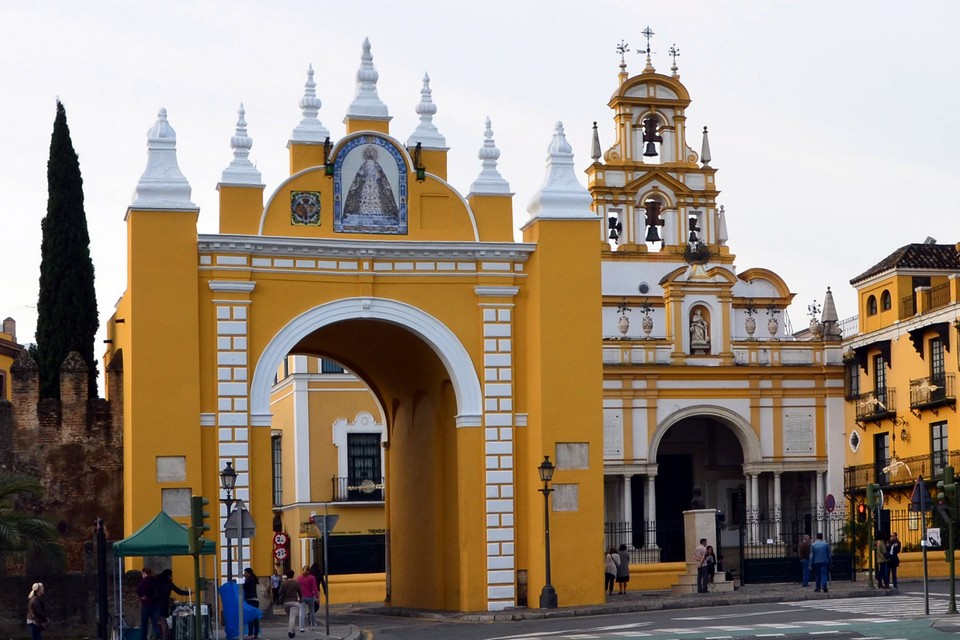
Seville Museum of Fine Arts
If you are an art lover, the Museum of Fine Arts of Seville (Museo de Bellas Artes) is the paradise for you. Not only is the ancient building very well preserved, but the museum also preserves many collections of paintings from the Renaissance to the present day.
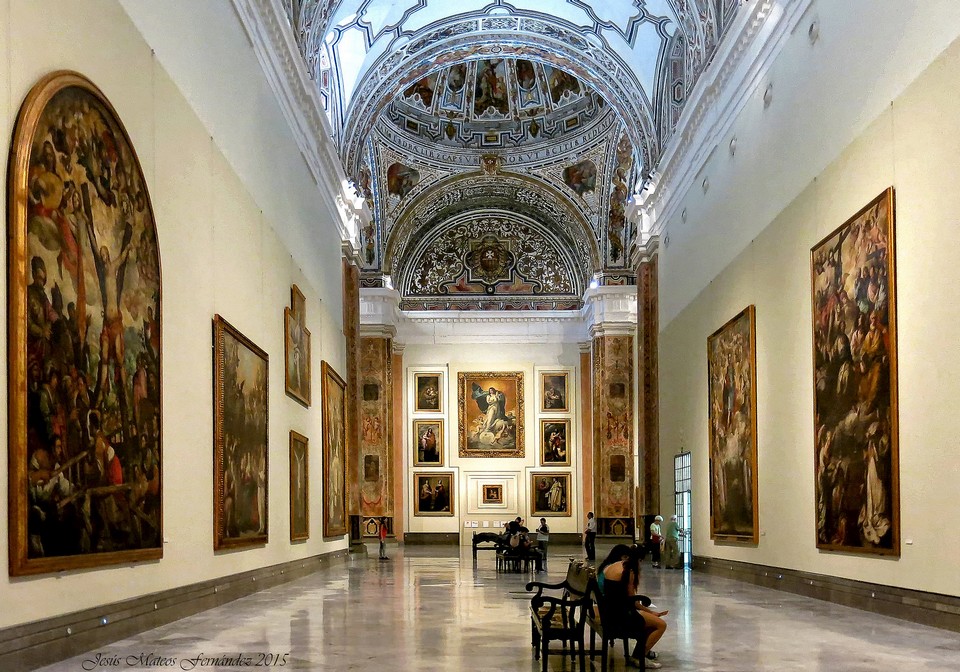
Address: Pl. del Museo, 9, 41001 Sevilla, Spain Hours: 9AM–3PM/Monday: Closed Founded: September 16, 1835
The Royal Alcázars of Seville (Alcázar Palace)
Alcázar Palace is one of the outstanding architectural achievements in Europe. This is a mixed-style garden palace that dates back to the Moorish period of the 11th century and still exists today. The lush vegetation, white walls and beautiful flowers contradict the palace’s exterior. The architectural complex of Alcazár castle, palace and park is typical of Mudéjar architectural style that is best preserved in Europe.
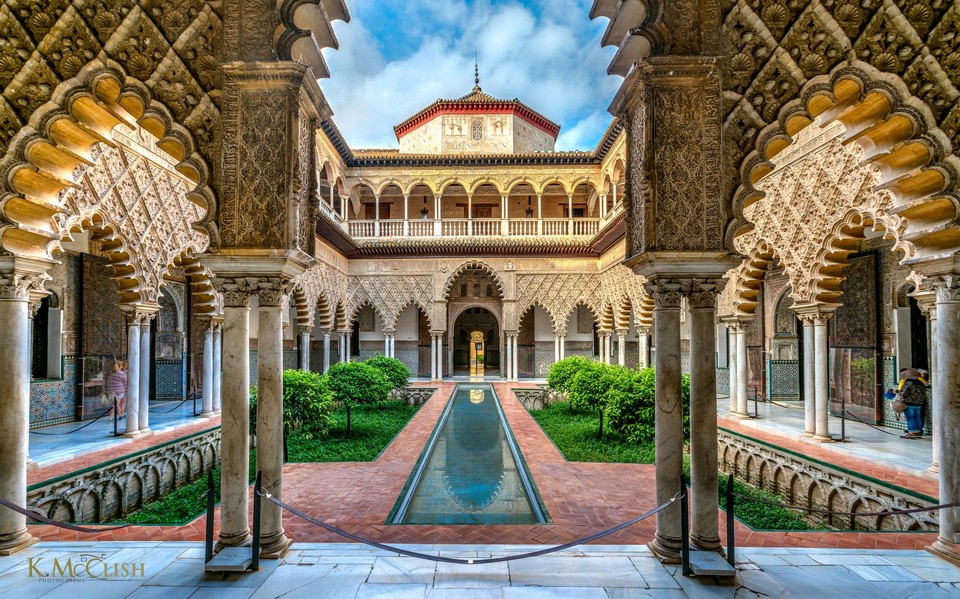
In Spain, Alcazár palace is very famous, not only appearing in the movie “Game of Thrones” but also because it is the oldest palace in the world still used by the Royal family. Through each reign of the king, along with the ups and downs of history, new architectural styles and decorations were applied to the palace, creating a spendid palace with many mixed-styles from Mudéjar Islam to Gothic, Renaissance, Baroque …
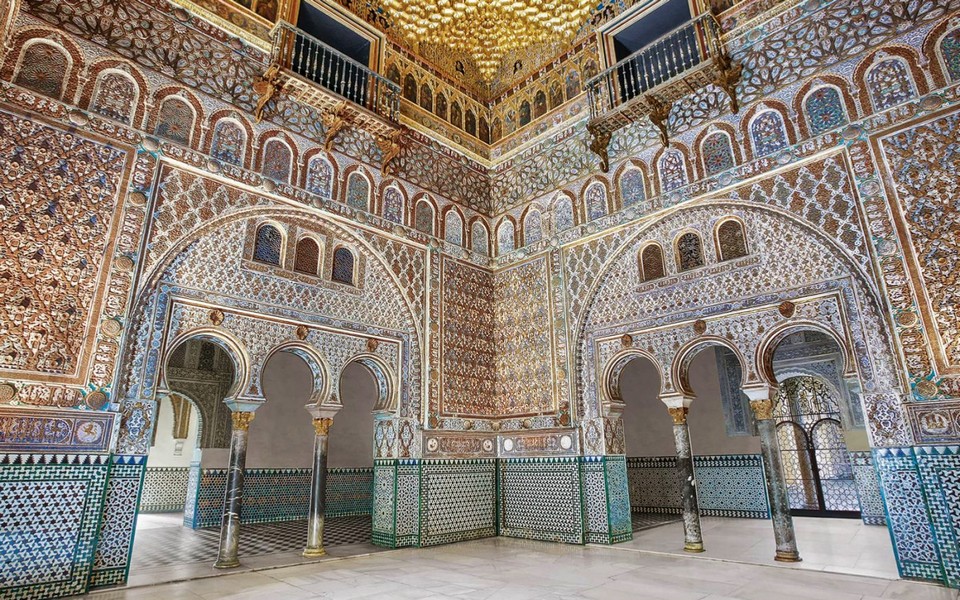
- Seville Alcazar, Cathedral and Giralda Tower Half Day Tour
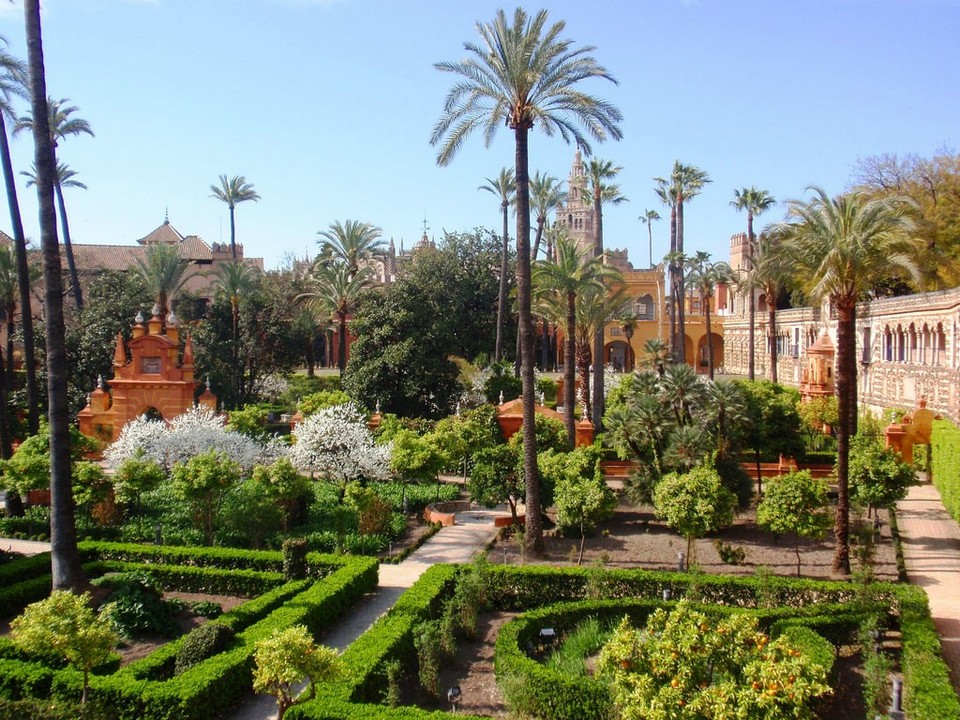
- The Alcázar of Seville Guided Tour with Fast Track Access
With a variety of beauty in architecture, decoration and landscape, this palace has become a World Cultural Heritage since 1987, making it an ideal attraction when coming to the city of Seville.
Setas de Sevilla (Metropol Parasol)
The world’s largest wooden structure, very artistic and impressive, also known as “las setas” (mushrooms), was designed by German architect Jürgen Hermann Mayer and opened in April 2011. Based on an image of giant mushrooms 4-storey high includes: A museum displaying the remains of Roman and Moors in the basement; Central market on the first floor; A cafe and concert area; A scenic view area on the rooftop. Metropol Parasol is becoming a new symbol of Seville.
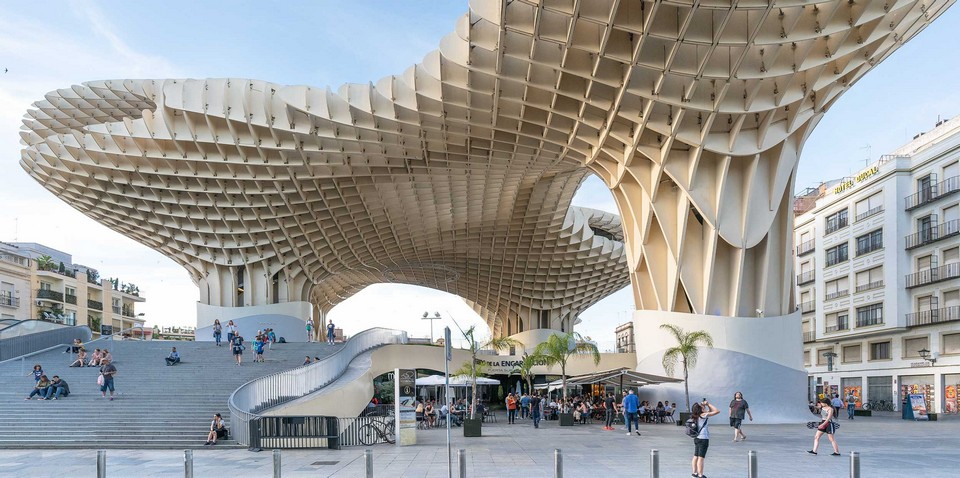
Address: Pl. de la Encarnación, s/n, 41003 Sevilla, Spain Construction started: 2005 Hours: 9:30AM–9:30PM
La Plaza de Toros de la Real Maestranza de Caballería de Sevilla
The arena of bullfights has the splendor of the eighteenth century. The mixed feelings of tension with bustle that matches bring has helped this place keep its “soul” beside the rush of time flow. However, like a double-edged sword, because of the violent drama of the matches, today the arena is limiting traditional bullfights. Instead, in the future, this place may become a place to perform special art performances but still retain the spiritual beauty of the country.
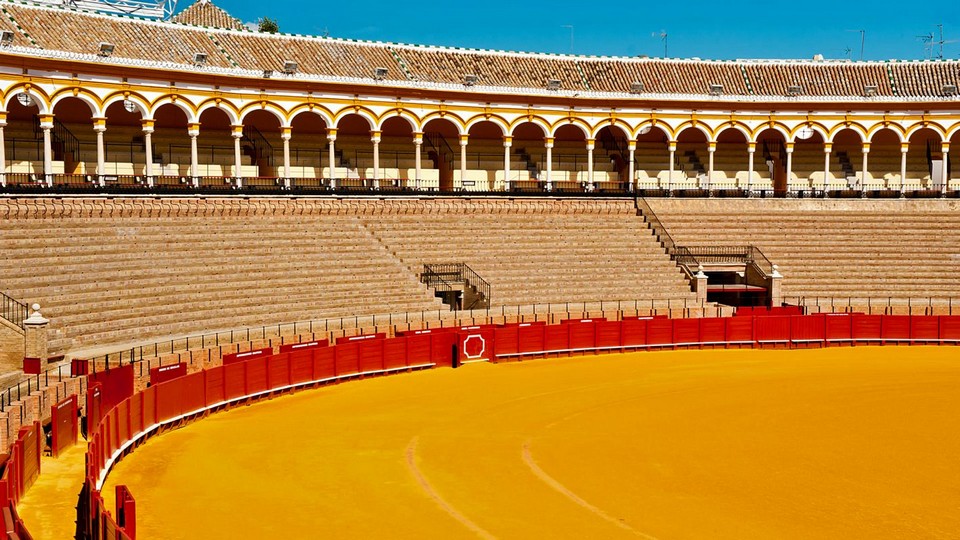
Address: Paseo de Cristóbal Colón, 12, 41001 Sevilla, Spain Opened: 1881 Architectural style: Baroque architecture
And finally Andalusia is home to the flamenco and where’s the better place to experience this vibrant, incredible dances than in its birthplace, Seville?! Appearing in the 18th century in the Triana neighborhood where the Gypsy people were concentrated, the flamenco has now become a UNESCO intangible culture heritage. At the corners of Sevilla streets, there are dancers who regularly perform flamenco mixed with Arabic, Oriental and Gypsy dances. Sevilla is also the only city in the world to have a flamenco museum.
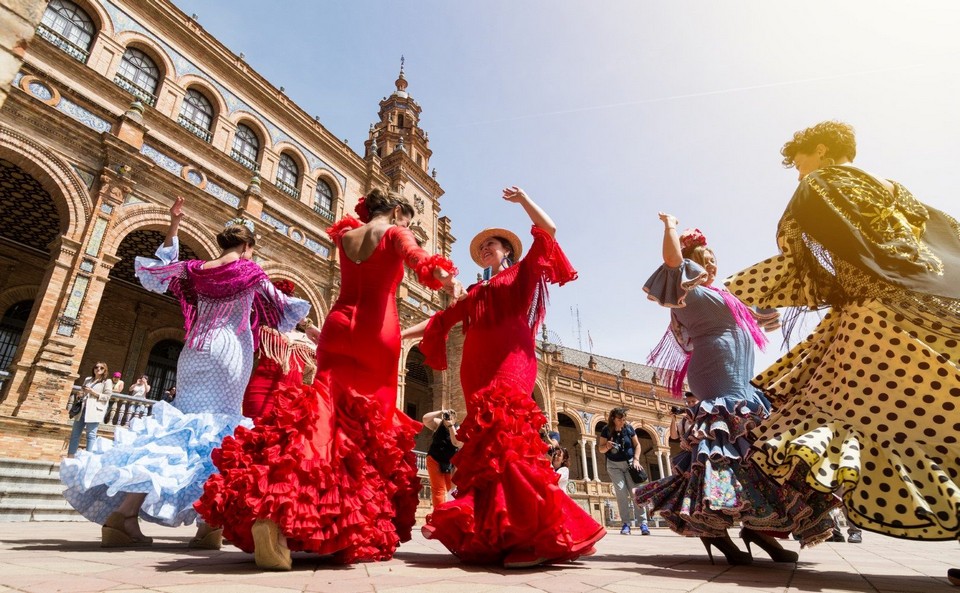
Flamenco performances always attract visitors, so you can see these sexy dancers everywhere in the city. Some flamenco shows require payment but many performances are completely free.
The city also organizes many flamenco festivals during the year to both honor this culture and serving roughly 3 million visitors to Sevilla each year. And flamenco performances in auditoriums like El Arenal and Los Gallos often run out of space.
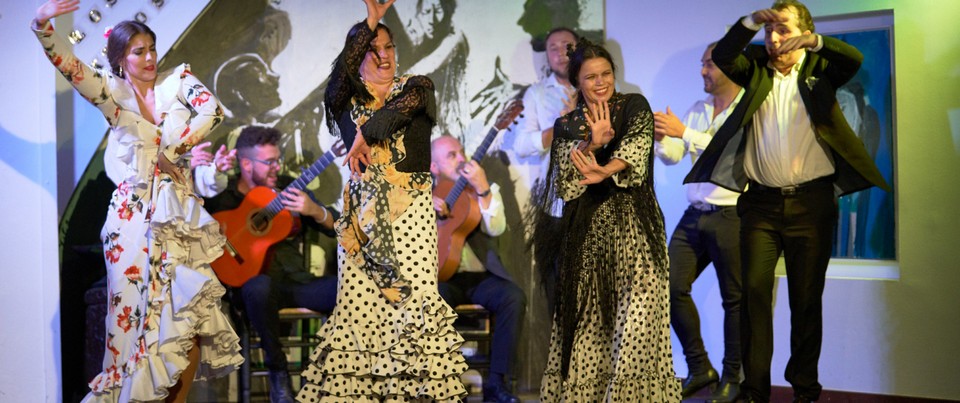
Seville travel blog: What to eat?
Tapas is a Spanish creation, you should definitely have to try Tapas once when you come to Spain. Tapas are small pieces of food of snacks, canapés or small savoury dishes in various forms and ingredients. Tapas can be cold or hot food. Popular as cheese mixed with olive oil, cold foods like sausages, ham, bacon or hot foods – like fried foods (squid, fish …). For Spanish, in addition to Sangria fruit cocktail, Paella rice, Tapas is an indispensable dish in every meal.
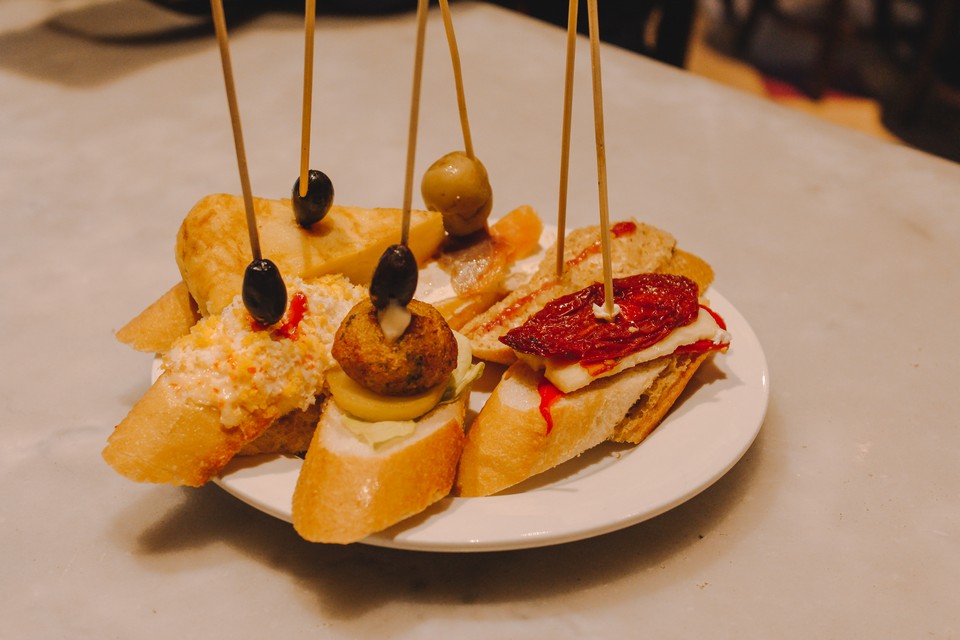
For the sweet lovers, it is impossible to ignore the crispy, fragrant churros sold in many street food vendors. It is a type of fried dough made from flour, butter, white sugar, cinnamon, eggs. Then fried in hot oil and then coated in cinnamon sugar. These delicious crispy churros is the perfect combination when it comes with a warm cup of chocolate.

Sangria (fruit cocktail)
This drink does not have a fixed recipe, but it is varied in different regions with the basic ingredients of red wine, fruit and sugar and sometimes liquor. The fresh fruits are soaked in red wine for about 1 night to reduce the acrid taste of the wine, adding the delicious, sweet taste of fresh fruit. It is serve in red-wine glasses with fresh berries.

Huevos a la Flamenca (Flamenco-style Eggs)
This is an attractive traditional dish in Seville. Although it is just a simple dish with eggs, it is sold everywhere from luxury restaurants to popular, cheap eateries. You can choose from many dishes with eggs such as: Eggs with potatoes, fried eggs, … but the most typical is still fried eggs with bacon, tomatoes, vegetables then sprinkled with salt and pepper and chopped parsley and adding some slices of chorizo sausage.

Tortilla Española (Spanish Egg and Potato Omelette)
To fully explore Seville’s cuisine, you must definitely not miss Tortilla Espanola, an omelette dish and national dish of Spain which made simply from potatoes, eggs, onions and spices, then mix well, fried in olive oil.
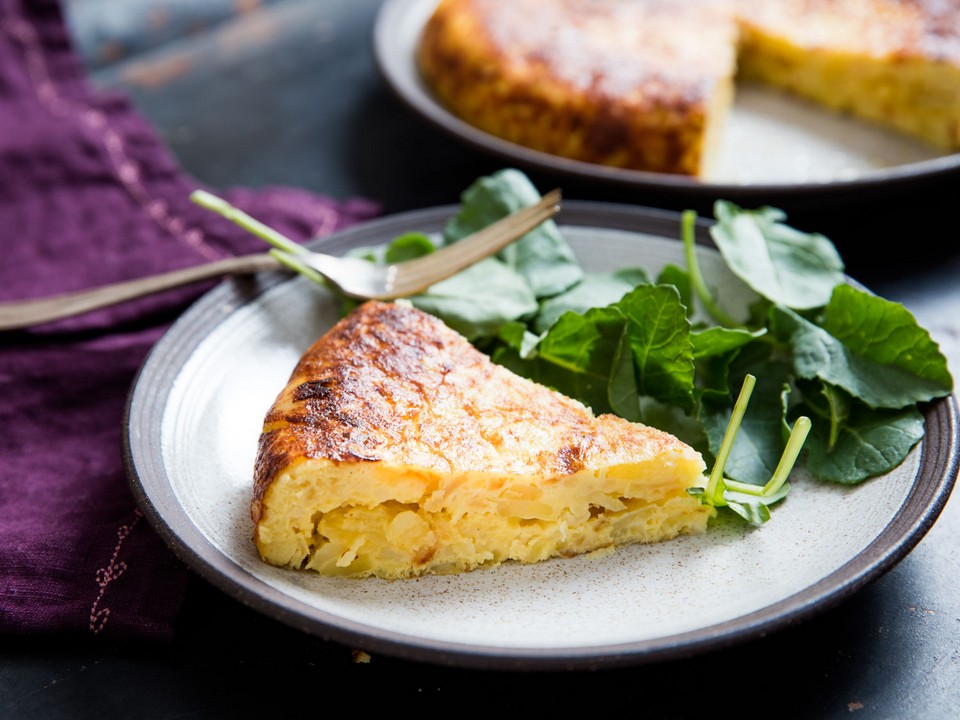
Bacalao (Dried and salted cod)
The dish is with a unique recipe using ingredients from dried and salted codand cooked with onion, pepper, cream, and olive oil. Or simply you can also enjoy the dried cod dish simmered with garlic.
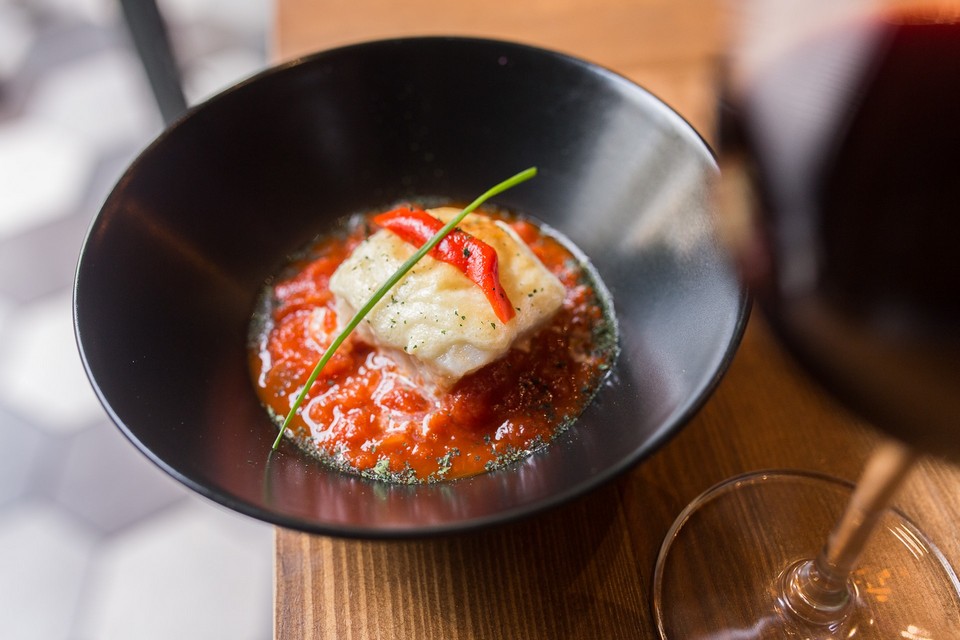
In addition, you should also not miss the street snacks in Seville such as: Patatas bravas (potatoes in bravas sauce, Crispy Potatoes with Spicy Garlic & Chili Aioli), Calamares Fritos Recipe (Spanish Fried Squid), Boquerones fritos (Fried anchovies), Chorizo (Spicy pork sausage), Paella (Spanish spicy fried rice with mussels, shrimp, squid, seafood)…
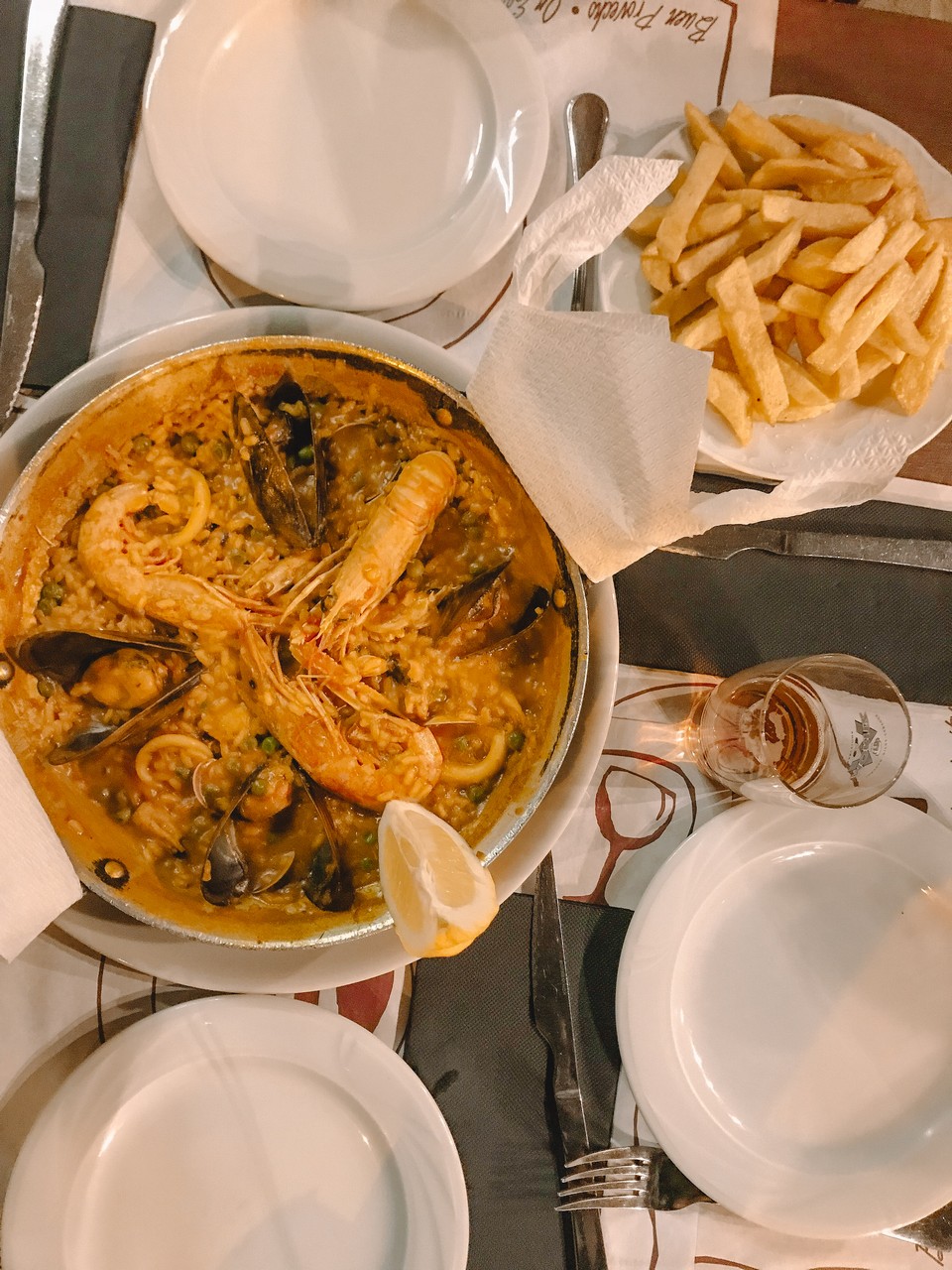
Seville blog: Suggested Seville itinerary for 3 days 2 nights
Here’s my itinerary for 3 days in Seville:
Flying from Barcelona to Seville with Ryan Air – Check-in at Pension Virgen de la Luz – Wandering to explore the small streets of Seville – Plaza de Espana – Seville Old Town – Return Pension (Homestay).
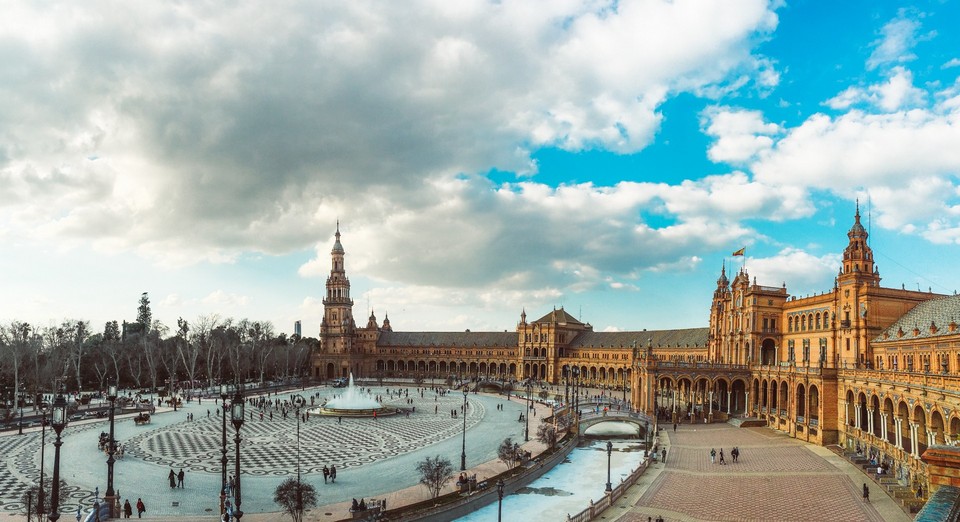
Starting from Pension – Seville Old Town – Breakfast at a restaurant on the way – Royal Alcázar of Seville – Lunch at Royal Alcázar of Seville – Catedral de Sevilla – La Giralda Bell Tower – Dinner in Old Town.
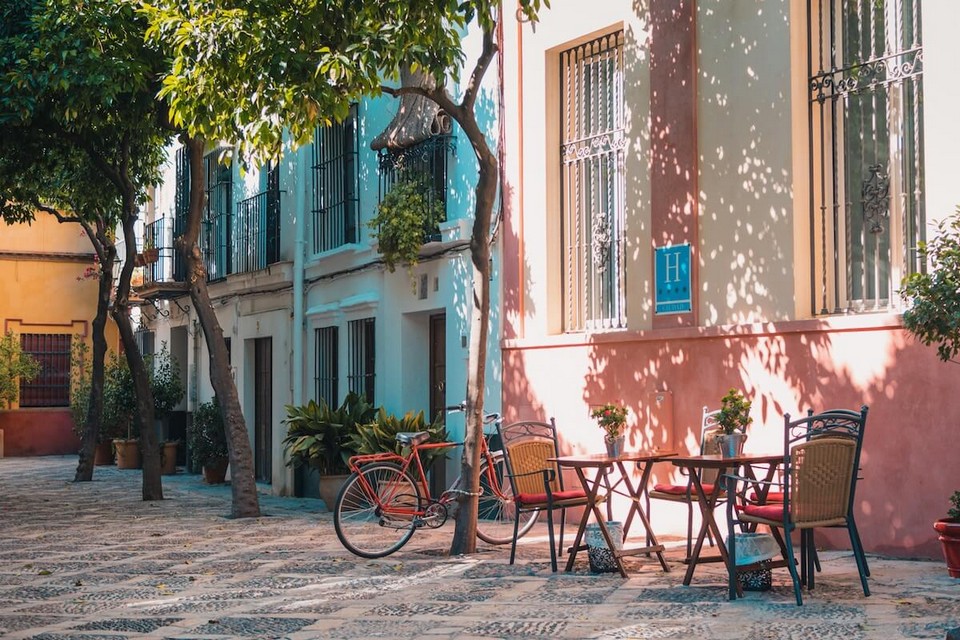
Starting from Pension – Seville Old Town – Breakfast at a restaurant on the way – Seville Metropol Parasol – Palace of the Countess of Lebrija – El Arenal Old Quarter – Dinner in Old Town.

Personally, I think my itinerary is quite typical and easy to explore and covering all main tourist attractions of Seville. I got a lot of experiences even though I only stayed for 3 days 2 nights. The trip cost for a single day in Seville (excluding the cost of renting rooms and tickets) is about 70 euros / day.
I often choose to walk as the main “means” during my trip, even though I have lost my way countless times. Because every time I walk, I gain more interesting experiences for my trip. By walking, sometimes I met new friends, sometimes I turned around beautiful street corners, or sometimes I found a secret place that only locals knew.
If you want to choose my itinerary as above for your upcoming trip to Seville, there are a few things you should consider to make sure your trip is truly memorable:
- Walking: In fact, you can take a bus, metro or tram to traveling around Seville, but if so, you will miss out on quite a lot of cool things in this peaceful city. Seville is not as bustling as Barcelona, also not as trendy as Madrid but Seville still attracts the eyes of many visitors thanks to its own secret glamorous beauty but also extremely bold.
- Watching time: You can visit a lot of places in Seville. However, each place will have a different opening hour, so to not miss any beautiful places, be sure to arrive on time. I was not able to climb the tallest church in Seville to see the whole city because of this.
- Relaxing: The common mentality of everyone is to go as much as possible, check-in as much as possible, so they will want to go quickly to get to all the places. But I think this is a bit wrong and really no need in Seville. The city is not too big, most of the attractions are close to each other and most of the architecture is similar. Instead of going all out, you should choose some unique places to visit and experience in-depth.
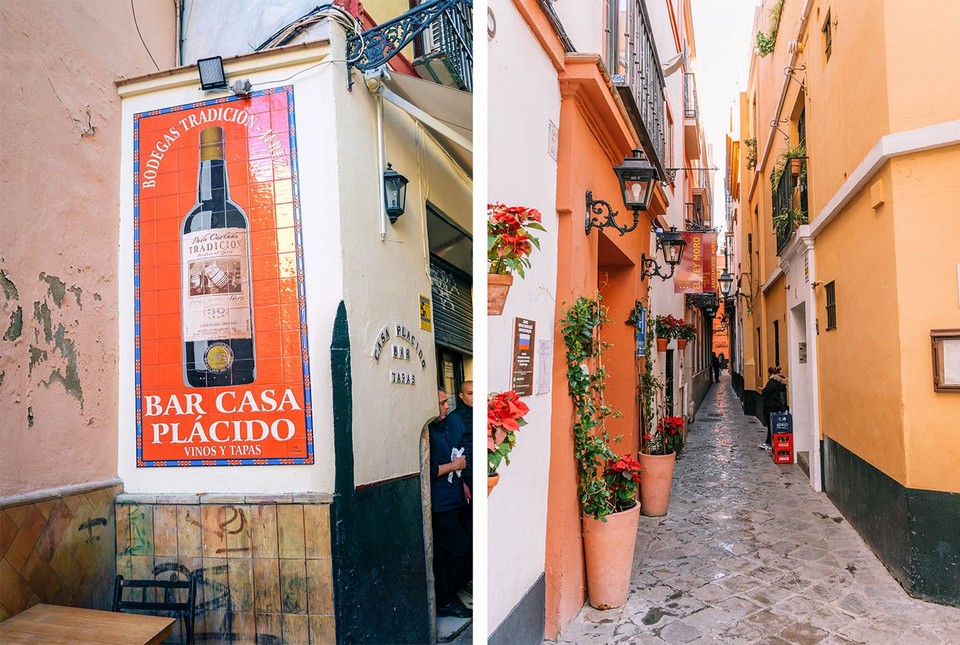
Total costs for the Seville trip
My 3-day and 2-night trip in Seville costs around 350 euros per person, the details as follows:
- Flight tickets for Barcelona – Seville: About 50 euros including 20 kg of luggage.
- Room cost: About 30 euros / night; for 2 nights are 60 euros.
- Food cost: About 70 euros / day, for 3 days are 210 euros.
- The cost of the bus from the airport to the center: 5 euros / way.
The cost of trams / buses in the city: You can buy a pass called Seville Travel Card to take trains and buses in the city for cheap. This card can be bought at newspaper stalls, grocery stores, cost about 8 euros (including a hard card and money in it to travel). After spending all the money in the card you can go to the newspaper / souvenir stalls on the streets to buy.
In addition, you also can consider to buy a similar card called Seville City Pass .
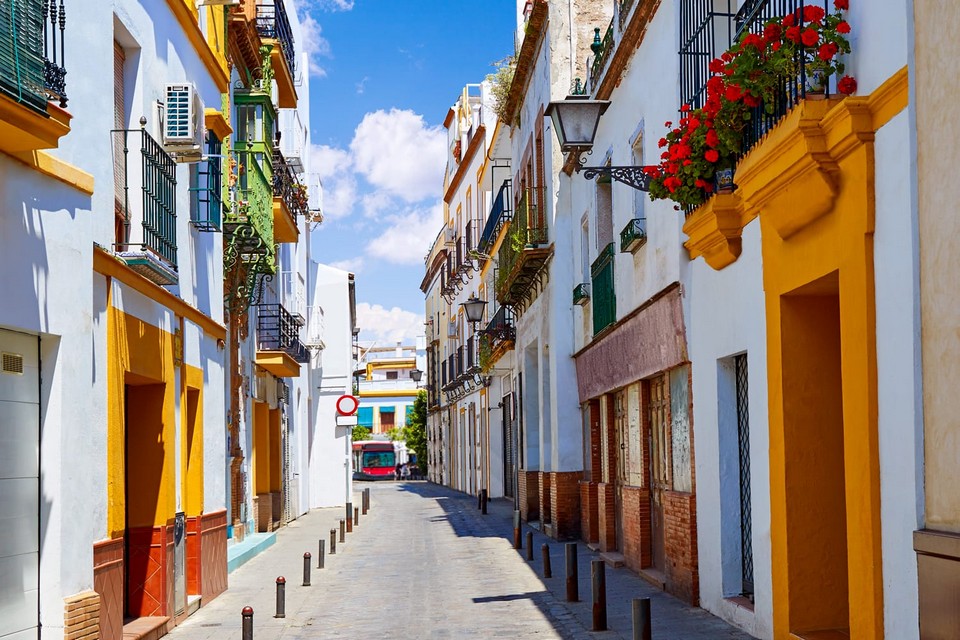
Seville travel guide: Where to stay?
For the full experience in Seville, choose a Seville style accommodation called Pension. Hotels in Spain are also a bit expensive so I decided to choose a pension (a type of homestay in Seville) to better suit for my budget. Also, I think the pension with a unique, bold décor will give me a little experience of the beautiful “space and culture” of Seville. The Charming, CENTRAL with TERRACE has all what I need.
This pension is nestled in a small alley of Seville, about 1.2km from Old Town. For me this distance is quite good, you can walk into the center while viewing streets. In addition, this location also allows the Pension a quieter space and more peaceful than other places.
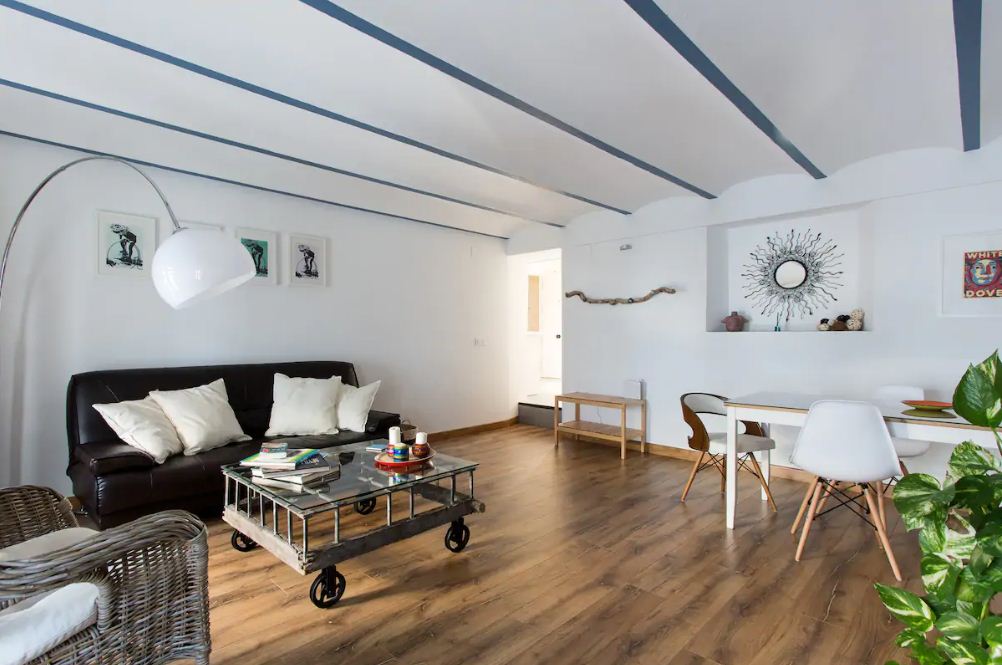
Pension’s main colors are white and blue (which reminds me a little of Santorini). White walls are tiled with blue tiles and blue motifs create an open and peaceful space. Plants are decorated in most floors. Pension also has a terrace for those who want to go up and see a part of the city. The price per night here is about 80 euros for two. You can see ratings and consider to book here .
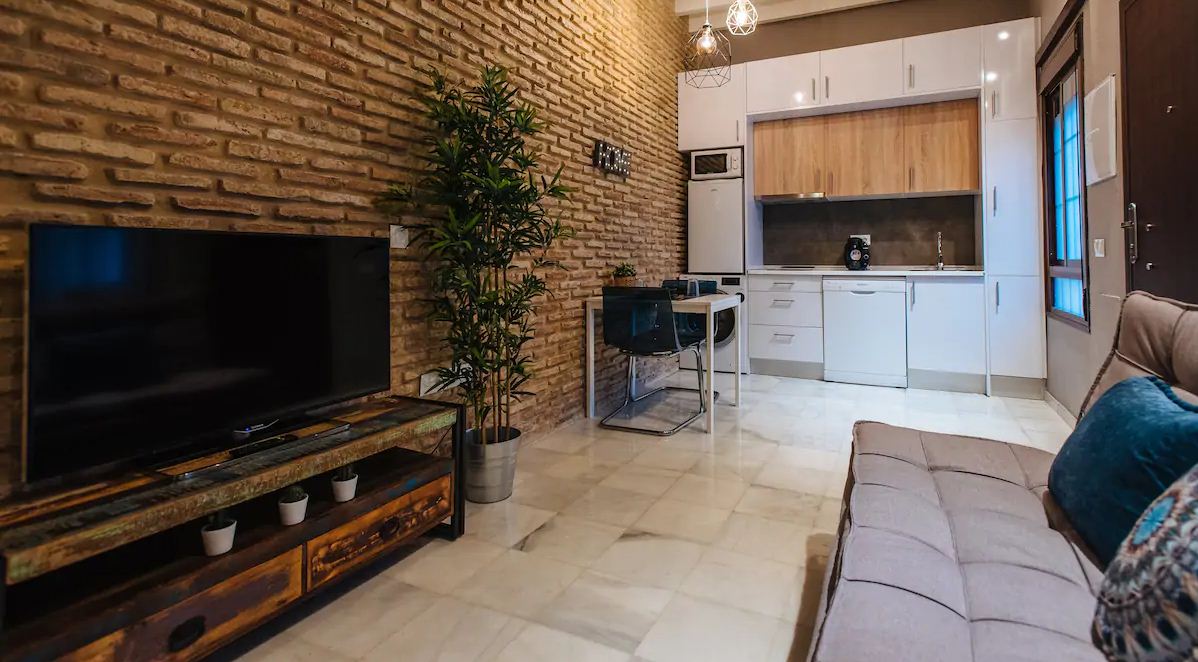
Below we recommend more best cheap, budget, mid-range and upscale hotels with good ratings and reviews you can refer to.
- NH Sevilla Plaza de Armas , a top rated 4-star hotel with room rates from $90/night (Check rates on Agoda.com or Booking.com ).
- Hotel Alfonso XIII , a top rated 5-star hotel with room rates from $318/night (Check rates on Agoda.com or Booking.com ).
- Silken Al-Andalus Palace Hotel , a top rated 4-star hotel with room rates from $75/night (Check rates on Agoda.com or Booking.com ).
- Hotel Posada del Lucero , a top rated 4-star hotel with room rates from $106/night (Check rates on Agoda.com or Booking.com ).
- El Rey Moro Hotel Boutique , a top rated 4-star hotel with room rates from $101/night (Check rates on Agoda.com or Booking.com ).
- Hotel Amadeus , a top rated 4-star hotel with room rates from $192/night (Check rates on Agoda.com or Booking.com ).
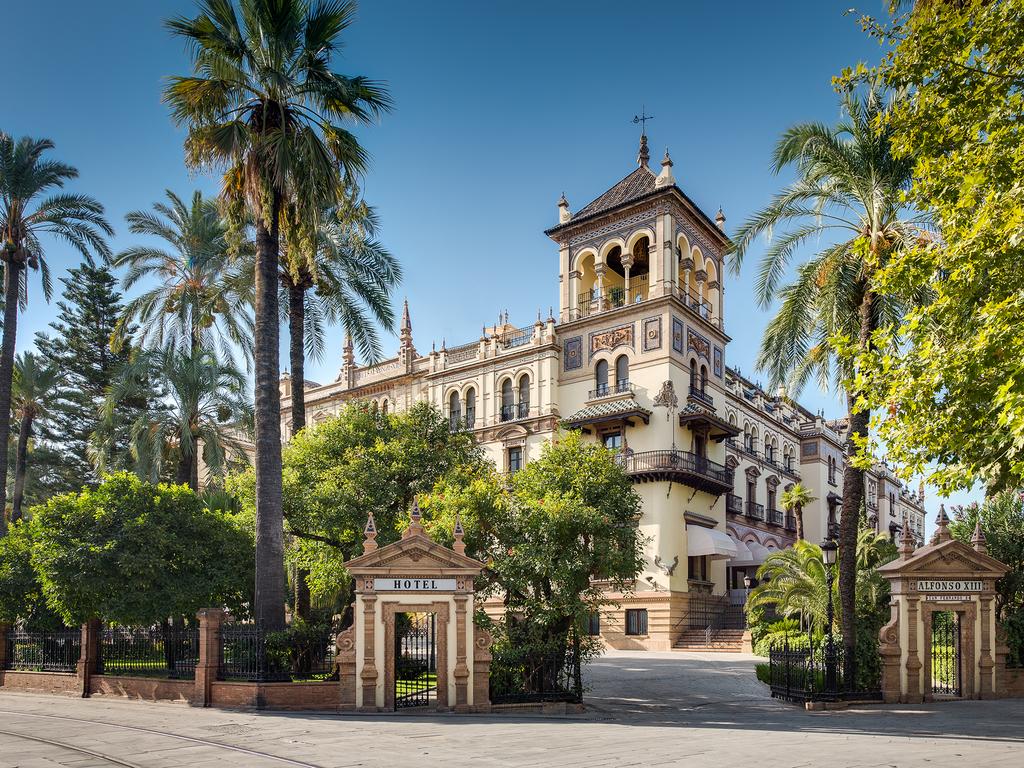
Seville guide: Some best day tours, trips, activities and transfer services, tickets in, from and to Seville you can refer to
- Flamenco Show at El Palacio Andaluz in Seville
- The Flamenco Dance Museum Admission Ticket in Seville
- Cathedral of Seville Guided Tour with Fast Track Access
- Cordoba Guided Day Tour from Seville
- Seville Segway Tour
- UNPUBLISH Seville Guided Walking Half Day Tour of the Monuments
- Seville Night Walking Tour and Flamenco Show
- Seville: Royal Alcázar Skip-the-Line Entry Ticket
- Seville Cathedral and Giralda: Skip-the-Line Ticket
- Seville: Guadalquivir 1-Hour City Cruise
- Seville: Alcazar, Cathedral, and Giralda Guided Tour Combo
- Seville: Royal Alcazar, Cathedral, and Giralda Guided Tour
- Seville: Casa de la Memoria Flamenco Show

Are you looking for more top things to do in Seville: Tours, activities, attractions and other things? Let’s check it out here . And how to spend 10 days in Spain . And Spain guide here .
Related articles

RELATED ARTICLES MORE FROM AUTHOR
Leh ladakh bike trip blog — ladakh bike trip guide & tips for first-timers, guide to shenzhen nightlife — top 5 things & what to do in shenzhen at night, ladakh trip cost per person from delhi — how much does ladakh trip by bike cost, india travel tips — 25+ what & things to know before traveling to india.

Coron itinerary 5 days — What to do & how to spend 5 days in Coron?

Arashiyama travel blog — The fullest Arashiyama travel guide with top things to do in Arashiyama
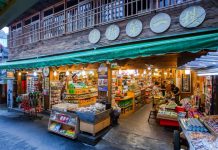
Explore Fenqihu old street — What to do in Fenqihu in a day trip?

Where to go in Kunming? — 15+ top Kunming attractions & best places to visit in Kunming
Must eat in melaka — 10+ famous malacca street food & must try food in melaka, editor picks.

Leh Ladakh bike trip blog — Ladakh bike trip guide &...

Guide to Shenzhen nightlife — Top 5 things & what to...

Ladakh trip cost per person from Delhi — How much does...
Popular posts.

What to buy in USA? — 17+ must buy in USA...

Must buy souvenir in Taiwan — Top 17+ most famous, cheap...

Must buy in Korea — Top 23 cheap, famous & best...
Popular category.
- Inspiration + Guide 1460
- Trip Inspiration 468
- Thailand 209
- Food + Drink 208
- Coasts + Islands 193
- South Korea 168
- Vietnam 166
- Travel Photos 144
- Work for Us
- Terms & Conditions
- Privacy Policy
- Qui sommes-nous ?

- Où partir ?
- Emirats Arabes Unis
- Nouvelle-Zélande
- Nouvelle-Calédonie
Visiter Séville : Que faire et que voir à Séville ?
Aujourd’hui, je vais vous parler d’une ville que j’ai pu visiter lors de mon récent road trip en Andalousie et qui m’a vraiment marquée : Séville. Véritable coup de cœur de mon voyage en Andalousie, j’ai séjourné quelques jours dans cette ville magnifique et ai pu vivre au rythme de l’Andalousie. Dans cet article, je vous donnerai tous mes conseils pour bien visiter Séville . Nous commencerons tout d’abord avec une question pratique : comment rejoindre le centre de Séville depuis l’aéroport. Puis nous passerons en revue les incontournables à voir à Séville. Nous terminerons par quelques conseils pratiques pour bien préparer votre séjour et surtout, nos bonnes adresses à découvrir à Séville et quelques idées d’itinéraires de visite sur plusieurs jours. Alors c’est parti pour une découverte de Séville, probablement ma ville préférée en Europe !
Préparer sa visite de Séville
Conseils pratiques pour visiter séville, visiter séville en 1 jour, 2 jours, 3 jours ou plus, mon avis sur séville.
Avant de rentrer dans le vif du sujet, je vous propose ici quelques conseils pour préparer votre séjour. Dans cette partie, nous allons surtout parler des étapes à prévoir en amont de votre voyage dans la capitale andalouse. Voici donc une liste des principales étapes vous permettant de bien préparer votre visite de Séville.
Réserver votre vol pour Séville
Principales activités à réserver à séville, rejoindre le centre ville de séville depuis son aéroport, réserver votre logement à séville.
Séville est une ville particulièrement bien desservie en matière de vols depuis la France. De nombreuses villes françaises permettent de rejoindre Séville grâce à des liaisons régulières comme les villes de Paris, Marseille, Nantes, Toulouse ou encore Bordeaux. Vous pouvez trouver l’ensemble des vols à destination de Séville sur le site Ulysse.com qui se chargera de vous proposer la meilleure offre possible.
Voir tous les vols pour Séville grâce au comparateur Ulysse.com !
Passons maintenant aux activités que vous êtes susceptibles de faire durant votre séjour à Séville. Certaines sont très prisées, il est donc recommandé de vous y prendre un peu en avance pour réserver votre entrée ou votre visite guidée. Voici une liste des principales activités que nous vous conseillons de réserver à Séville. Vous retrouverez plus de détails dans la suite de cet article. (Les prix indiqués sont par personne sur une base de deux personnes par visite.)
La première étape de votre séjour à Séville sera, bien entendu, de regagner le centre ville de Séville et votre logement depuis l’aéroport. Pour cela plusieurs solutions s’offrent à vous, la première, et la plus économique, est d’opter pour le bus.
Rien de plus simple, sortez de l’aéroport et dirigez-vous sur votre gauche, l’arrêt de bus se trouve juste là, devant l’entrée de l’aéroport. L’achat des tickets s’effectue auprès d’un agent situé au niveau de l’arrêt. Rejoindre le centre ville de Séville depuis l’aéroport en bus vous coûtera 4€. Une seule ligne de bus passe à cet endroit, impossible de vous tromper. De plus, les bus reliant l’aéroport au centre ville de Séville sont facilement reconnaissables avec un grand « Aeropuerto » inscrit dessus, la ligne se nomme « EA ». Il faudra compter environ 35 à 50 minutes pour rejoindre le centre ville depuis l’aéroport en fonction de la circulation.
Le bus ne rentre pas dans le centre historique de la ville mais le contourne par les boulevards périphériques. L’arrêt le plus proche de la cathédrale (et donc de l’hyper centre) est l’arrêt Paséo Colón, au pied de la Torre del Oro.

En navette privée
Autre solution pour rejoindre le centre ville de Séville depuis l’aéroport, optez pour une navette. Plus chère, elle s’avère également plus pratique puisque celle-ci vous déposera où bon vous semble dans le centre ville de Séville. Si vous voyagez à plusieurs ou avec des enfants et que vous souhaitez perdre un minimum de temps dans les transports alors cela peut-être une bonne solution.
Plusieurs solutions s’offrent à vous en terme de quartiers où loger à Séville. Le centre historique sera l’un des quartiers à favoriser pour loger proche des lieux d’intérêt mais des quartiers comme Macarena et Alameda de Hércules ou extramuros et parque de Maria Luisa ou encore Triana ne sont pas à exclure. Vous pourrez retrouver un grand nombre de logements sur le site de Booking.com .
Rentrons maintenant dans le vif du sujet avec cette partie dédiée aux incontournables à visiter à Séville. En effet, Séville est parsemée de lieux à visiter. C’est une ville riche architecturalement et culturellement parlant. Voici les immanquables d’une visite de Séville.
La Cathédrale Notre Dame du Siège
L’alcazar de séville, les arènes de la real maestranza de caballería de séville, le metropol parasol, antiquarium de séville, la plaza de espana.
- L’aquarium de Séville
- Parc Maria Luisa
La Plaza de America
Musée des arts et traditions populaires.
- Musée archéologique de Séville
La Torre del Oro
Fabrique de tabac, marché et castillo de san jorge.
- Musée de la Céramique
- Spectacle de Flamenco
Point central de la ville, la cathédrale Notre Dame du Siège de Séville est véritablement l’incontournable numéro 1 (avec l’Alcazar) de Séville. Visiter Séville rime avec visiter sa cathédrale. Celle-ci est l’une des plus grandes d’Europe. Elle a la particularité d’être érigée à l’emplacement même de la mosquée Almohade dont elle a conservé le minaret, rénové aujourd’hui en clocher. Il est possible de monter en haut de ce clocher à l’aide d’une rampe qui permettait, à l’époque, d’accéder en haut du minaret à cheval. A l’intérieur de l’édifice, vous trouverez de nombreux tableaux, des sculptures ornées d’or, des joyaux, des tombeaux, dont certains sont très célèbres comme par exemple celui de Christophe Colomb, originaire de la ville, ou encore l’un des plus grands ostensoirs du monde. Si vous souhaitez en savoir plus sur la cathédrale, je vous invite à lire notre article dédié à la visite de la cathédrale de Séville . Vous y retrouverez toutes les informations sur la réservation d’une visite guidée et son déroulement mais aussi des informations sur l’histoire de la cathédrale.

L’Alcazar de Séville est un ancien palais fortifié construit au IXe siècle. Modifié de nombreuses fois au fil du temps et des envahisseurs, l’Alcazar se compose de différents palais, patios et d’un immense jardin fleuri où il est fort agréable de flâner. Si vous optez pour une visite guidée de l’Alcazar , vous en apprendrez d’avantage sur ce lieu emblématique de la ville. Son histoire est fascinante comme en témoigne son architecture unique issue d’un mélange de styles incroyable. L’Alcazar est le plus vieux palais d’Europe encore habité. En effet, l’une des parties de l’Alcazar reste fermée au public car, deux à trois fois par an, le roi d’Espagne y prend ses quartiers lors de ses séjours à Séville. Nous avons dédié un article à cet emblématique lieu incontournable d’une visite de Séville, si vous souhaitez en savoir d’avantage sur l’Alcazar de Séville , je vous invite à y jeter un oeil.

A noter que durant l’été, du mois de Juin au mois de Septembre, vous pourrez assister aux nuits de l’Alcazar : spectacles, musique et histoires au milieu de l’Alcazar.
Les arènes de Séville sont également l’un des lieux emblématiques à visiter à Séville. Ces arènes sont classées monument historique depuis 1984. Elles abritent l’une des plus célèbres corridas d’Espagne. Les arènes se situent dans le quartier El Arenal, à 10 petites minutes à pied du centre de la ville. Ces arènes se visitent, il vous en coûtera 6,50 €. Les arènes de Séville sont ouvertes chaque jour, de 9h30 à 20h. La visite dure environ 45 minutes, elle comprend la visite des arènes et également du musée de la real Maestranza. Je vous conseille de venir réserver votre entrée tôt dans la journée. En effet, les visites sont à heures fixes. Lors de notre visite, toutes les places étaient réservées pour la prochaine visite, nous avons du réserver et revenir quelques heures plus tard. Une autre possibilité pour visiter les arènes de Séville : opter pour une visite privée guidée en petit groupe.
Si vous souhaitez voir une corrida, il faudra vous y prendre à l’avance et regarder les dates des représentations. Pour les moins connues, pas besoin de réserver à l’avance, les billets s’achètent sur place, cependant si vous souhaitez assister à certaines corridas réputées, il vous faudra réserver votre place plusieurs mois à l’avance.

Le Metropol Parasol de Séville est, à l’origine, une volonté de la municipalité de réhabiliter la place de la Encarnación. En 2004, la ville de Séville organise un appel d’offre public afin d’élire l’un des projets qui leur sera présenté. C’est donc le projet du Metropol Parasol qui remporta le marché. Le projet comprenait une place publique, un marché couvert ainsi qu’un musée archéologique. C’est donc en 2011, après plusieurs arrêts et un dépassement assez large du budget (passant de 30 millions à plus de 100 millions d’euros) que fût inauguré le Metropol Parasol. Ses dimensions sont de 150 mètres sur 70 et sa hauteur est d’approximativement 28 mètres pour une surface totale de 11 000 m2.

Le Metropol Parasol est donc devenu l’un des monuments emblématiques de la ville. Outre cette structure en bois unique et originale, le Metropol Parasol possède aussi un musée archéologique appelé l’Antiquarium, en sous sol, avec plusieurs bars autour de la structure. Je vous présente plus en détails ce musée juste après. Le Metropol Parasol se compose de 6 gros piliers et 5 niveaux. Vous trouverez dans l’un de ces piliers un restaurant à tapas. Deux ascenseurs vous permettent de monter en haut de la structure et ainsi de vous balader le long du petit parcours long d’une centaine de mètres. Outre une agréable balade, vous aurez l’occasion de profiter du restaurant ainsi que des nombreux commerces situés sous la place de la Encarnación, au niveau du marché couvert.
La visite vous coûtera 3€ avec une boisson offerte. Comptez une petite heure pour profiter de la vue et vous rafraîchir avec la boisson incluse.
Le soir, le quartier est également agréable, plusieurs bars à tapas se situent à proximité du Metropol Parasol, vous pourrez ainsi profiter de l’éclairage de la structure et du coucher de soleil sur la ville.

Si vous vous rendez du côté du Metropol Parasol, alors vous ne pourrez louper, sous celui-ci, les vestiges archéologiques retrouvés lors de la construction de ce dernier. Comme dans de nombreux endroits à Séville, des ruines antiques furent retrouvées au moment de la construction. Une partie a donc été conservée et se découvre dans un lieu nommé Antiquarium, situé juste en dessous de la place de la Encarnación, elle-même située sous le Metropol Parasol.

La Plaza de Espana est, de loin, le monument qui m’a le plus impressionné de Séville. Cet immense monument en arc de cercle, situé autour de la place est tout simplement surprenant ! La Plaza de Espana a été construite à l’occasion de l’exposition ibero-américaine de 1929. L’architecte de la Plaza de España est Aníbal González. Il a réalisé cet ouvrage en 1929, pour l’Exposition ibéro-américaine. La superficie totale du parc est de 50 000 m2 qui se répartissent comme suit :
- 19 000 m2 sont occupés par le palais de la place. Ce palais majestueux est un seul et unique édifice de taille impressionnante. Il longe le demi-cercle de la place et aujourd’hui, il abrite la Junta de Andalucia, c’est à dire le gouvernement régional d’Andalousie ;
- 31 000 m2 sont occupés par la place elle-même et ses canaux.
La Plaza de Espana a la forme d’un hémicycle de 200 mètres de diamètre. Elle représente l’Espagne qui accueille ses anciennes colonies. Elle est orientée vers le Guadalquivir. En prenant l’avenue Rodriguez de Casso à partir de la place, on arrive directement sur les berges de ce célèbre fleuve espagnol, qui se jette dans l’océan Atlantique à l’ouest du détroit de Gibraltar. L’orientation de la place en direction du fleuve, signifie le chemin vers l’océan Atlantique et bien sûr les Amériques.

Au centre de la Plaza de Espana, il y a une fontaine qui a été conçue par Vicente Traver, un architecte espagnol décédé en 1966 et connu pour avoir fait d’autres réalisations notables à Seville entre 1915 et 1933. Entre le centre de la place et le palais, on trouve des canaux, en demi-cercle également. Quatre ponts décorés de céramique enjambent les canaux.
La Plaza de Espana est en accès libre aux visiteurs, elle accueille de nombreux touristes tout au long de l’année. Mais en été, à cause des fortes chaleurs, il est plutôt conseillé de venir la visiter le matin ou en fin d’après-midi plutôt que dans le courant de la journée
En face de la Plaza vous trouverez l’un des plus grands parcs de Séville, le parc Maria Luisa.

Visiter l’aquarium de Séville
Construit en 2014 l’aquarium de Séville est l’un des plus importants d’Espagne. Il abrite plus de 7 000 animaux de 400 espèces différentes. L’aquarium comprend 40 bassins dont un de plus de 9 mètres de profondeur qui accueille des requins ou des tortues de mer. La visite de l’aquarium s’articule autour du voyage de Magellan, l’explorateur portugais parti en mer pour faire le tour du monde. Si vous voyagez avec des enfants, je vous recommande cette visite, que j’ai moi-même trouvée très intéressante. De plus, visiter l’aquarium de Séville permet d’échapper quelques temps à la chaleur parfois étouffante de Séville en plein été. Si cette visite vous intéresse, je vous invite à lire mon article sur la visite de l’aquarium de Séville .

La parc Maria Luisa
À pied, en calèche ou à vélo, découvrez le plus important et le plus prestigieux parc de la ville. Arpentez ses grandes allées et perdez-vous dans ses 40 hectares. Non seulement un lieu de paix et de quiétude au milieu de la ville, mais c’est aussi un peu d’histoire de Séville qui s’invite à la balade. Il faut savoir qu’à l’origine, le parc faisait partie des jardins du Palais de San Telmo, lieu de résidence des ducs de Montpensier. Au cours du 19 ème siècle, ces derniers ont joué un rôle considérable dans l’urbanisation de Séville ; notamment en donnant naissance au parc María Luisa, en hommage à la duchesse de Montpensier qui décida de l’offrir à la ville.
Plus tard, le parc fut aménagé par un paysagiste français, Jean Claude Nicolas Forestier, qui créa un parc inspiré des « jardins hispaniques » dont les modèles sont les jardins de l’Alhambra de Grenade ou ceux de l’Alcazar de Séville. Un défi plus que réussi !

De grands arbres centenaires côtoient des jardins botaniques, des places, des fontaines et des petits ronds-points très charmants pour former un espace vert harmonieux et poétique. La variété d’espèces végétales y est surprenante, à l’image des différents types de palmiers, certains venus des Amériques à l’occasion de l’exposition ibéro-américaine de 1929. C’est d’ailleurs à cette occasion que se sont construits les différents « pabellones » (pavillons), comme celui du Portugal, du Chili ou encore du Mexique aux abords du parc ; sans oublier la grandiose place d’Espagne ouverte sur le parc, que nous avons présentée un peu plus haut.
Autre curiosité : les typiques bancs d’azuleros, endroit idéal pour s’arrêter admirer le décor qui vous entoure ou la faune qui anime les lieux. Car en effet, vous apercevrez sûrement les fameux perroquets verts ou quelques colombes passer d’un arbre à l’autre. Les canards et les cygnes se donnent eux aussi en spectacle sous le regard amusé des promeneurs qui les nourrissent de graines vendues par des marchands ambulants installés dans le parc.
De l’autre côté du parc Maria Luisa, à l’opposé de la place d’Espagne, se dresse la place d’Amérique : Plaza de America, construite elle aussi, vous vous en doutez, pour l’exposition ibéro-américaine de 1929. Sur la Place d’Amérique, place centrale du parc, les enfants s’amusent à nourrir les pigeons qui affluent ; cet endroit est affectueusement appelé par les sévillans « la place des pigeons ». Le parc abrite aussi plusieurs monuments : monument à Adolfo Béquer, à Miguel de Cervantes et autres figures littéraires. Notons aussi la présence de deux musées : le musée des Arts et Coutumes Populaires ; et le musée archéologique. Pour clôturer la balade, rien de tel qu’un rafraîchissement ou quelques tapas dans un bar ou café qui se trouvent au sein du parc.

Ce musée, situé sur la place d’Amérique, est logé dans l’un des anciens bâtiments construits pour l’exposition ibera-américaine de 1929, tout comme le musée archéologique dont nous parlerons plus bas. Ce musée abrite un tas d’objets de la vie quotidienne andalouse, des derniers siècles à nos jours. Ces collections permettent d’en apprendre plus sur la vie des habitants de la région. Le musée est gratuit et ouvert tous les jours à l’exception du lundi.

Musée archéologique
Situé en face du musée des arts et traditions populaires de Séville, le musée archéologique s’est, lui aussi, installé dans l’un des pavillons créés pour l’exposition ibéro américaine de 1929. Vous trouverez dans ce musée, différentes salles exposant des objets de plusieurs périodes : antiquité, période romaine ou encore Moyen-Âge. De nombreuses pièces de ce musée proviennent de l’impressionnant site archéologique situé à quelques kilomètres de Séville : Italicà. L’entrée de ce musée est gratuite pour les citoyens européens. Le musée est ouvert tous les jours à l’exception du lundi.

La Torre del Oro est une ancienne tour d’observation de Séville, placée à côté du Guadalquivir, le fleuve qui traverse la ville. Cette tour était utilisée autrefois pour stocker l’or ramené par les conquistadors au XV ème siècle. L’origine du nom de cette tour n’est pas très claire. Il pourrait être tiré de sa fonction (stocker l’or) mais également de son apparence dorée qu’elle avait à l’époque. La tour accueille aujourd’hui le musée de la marine. Il vous coûtera 3€ pour la visite du musée incluant l’ascension jusqu’au en haut de la tour. Depuis le haut de la tour, vous pourrez profiter d’une jolie vue sur Séville et sur le Guadalquivir. Concernant le musée maritime, celui-ci retrace l’histoire, entre autre, de la construction de la tour et présente différents objets utilisés sur les navires à l’époque comme des canons.

En allant de l’hyper centre de Séville à la place d’Espagne, vous ne pourrez manquer un impressionnant bâtiment de style renaissance. Ce bâtiment, aujourd’hui utilisé comme université, était autrefois une fabrique de tabac. Cette fabrique de tabac fut l’une des premières du genre en Europe. Celle de Séville est particulièrement célèbre puisque c’est dans cette même fabrique que travaillait Carmen, personnage principal de l’opéra du même nom. Vous pouvez entrer gratuitement dans l’enceinte de l’université et même vous procurer un audio guide à l’entrée du bâtiment.

Visiter Séville c’est aussi traverser le Guadalquivir pour découvrir l’un de ses quartiers phares : le quartier de Triana . Vous y trouverez de nombreux lieux incontournables de Séville dont le Castillo de San Jorge et son marché. C’est également le quartier où serait né le Flamenco, danse typique de la région. Le Castillo de San Jorge est un ancien château, ancienne forteresse musulmane du X ème siècle. Il fût, entre 1481 et 1785, utilisé comme siège pendant l’Inquisition. Il servit également de prison avant d’être transformé, plus récemment, en centre thématique de la tolérance. Le château est, aujourd’hui, en grande partie détruit. Il a laissé place au marché alimentaire du quartier de Triana que je vous recommande fortement. En effet, un petit tour au marché de Triana, pour y déguster les spécialités de la région, est une chose à faire à Séville. Sous celui-ci, vous trouverez un petit musée dans lequel vous pourrez contempler les vestiges du château.

Musée de la céramique
Restons encore quelques temps dans le quartier de Triana pour découvrir le musée de la céramique. A quelques pas du marché couvert, se trouve une part de l’histoire de Séville : le musée de la céramique. En effet, le quartier de Triana abritait autrefois des fabriques de céramiques, ces azulejos que l’on retrouve dans de nombreuses régions d’Espagne et du Portugal. Le musée de la céramique vous en apprendra plus sur la confection et l’utilisation de ces petits carreaux de carrelage.

Assister à un spectacle de Flamenco
Visiter Séville c’est aussi découvrir sa culture, et cela commence par l’un des incontournables de Séville : assister à un spectacle de Flamenco. Pour cela, plusieurs endroits proposent des spectacles et représentations de Flamenco. Vous pouvez vous rendre dans certains musées, dédiés à la culture Flamenco, des théâtres mais aussi des bars qui proposent de temps en temps des représentations. Le plus célèbre de ces lieux est le Museo del Baile Flamenco. Ce musée, fondé par une ancienne grande danseuse de Flamenco, offre des représentations quotidiennes. L’autre lieu prisé pour assister à un spectacle de Flamenco est la casa de la Guitarra. Du côté des bars, les plus célèbres sont « La Carbonería » ainsi que : el tableo « El Arenal ». Pour en savoir plus, je vous invite à lire mon article sur les spectacles de Flamenco à Séville .

Visiter les stades de Séville
La ville de Séville compte deux équipes de foot jouant toutes les deux en Liga, la première division espagnole. Il s’agit du FC Séville et du Betis Séville. Le FC Séville évolue dans le Stade Ramón Sánchez Pizjuán d’une capacité de 43 000 places quant au Betis Séville, il évolue dans le stade Benito Villamarin. Il est possible de visiter ce dernier en réservant vos billets en ligne .
Maintenant que vous savez quoi visiter à Séville, je vous propose de faire un point sur quelques informations pratiques qui pourraient vous être utiles avant ou pendant votre séjour. N’hésitez pas à nous laisser un commentaire si vous avez une question à laquelle nous n’avons pas répondu ici.
Quelle est la météo à Séville ?
Quelle est la meilleure période pour visiter séville , visiter séville en plein été, comment venir à séville , combien de temps pour visiter séville , comment visiter séville en 3 jours , existe-il un city pass pour visiter séville , quels sont les lieux à ne pas manquer à séville , comment se déplacer à séville , où dormir à séville , que faire autour de séville , nos bonnes adresses à séville.

- le City pass de Séville : celui-ci inclut des billets coupe-file pour l’Alcazar et la cathédrale ; un accès au bus touristique ; un audio-guide pour visiter Séville ; et des réductions sur d’autres activités. C’est le plus complet. Voir ce pass .
- le Séville Super Combi : il propose les mêmes avantages que le précédent sauf que vous n’aurez pas accès au bus touristique de la ville. Voir ce pass .
- le Best of Andalusia : ce pass propose des billets coupe-file pour l’Alcazar de Séville et l’Alhambra de Grenade ; une visite guidée de la mosquée cathédrale de Cordoue ; et des audio-guides pour visiter Séville et Grenade. Voir ce pass .
- La cathédrale de Séville et sa Giralda
- L’Alcazar et ses jardins
- La Plaza de España
- Les arènes de Séville
- Le Métropol Parasol
- Le quartier de Triana, berceau du flamenco

- Cadix : une des plus anciennes villes d’Europe, Cadix se visite facilement depuis Séville. Vous découvrirez une cité à l’histoire et au patrimoine riche.
- Cordoue : une des villes les plus touristiques de l’Andalousie, Cordoue vaut le détour pour son centre historique mais aussi pour sa célèbre Mosquée-Cathédrale.
- Grenade : un peu plus éloignée de Séville, Grenade vaut tout de même le coup. Un des monuments incontournables à visiter est l’Alhambra et les fameux Palais Nasrides.
- Malaga : entre belles plages et jolie ville, Malaga est à découvrir non loin de Séville.
- Caminito del Rey : une des randonnées les plus réputées de la région. Rénovée il y a quelques années, cette randonnée est entièrement sécurisée et vous offre des paysages splendides.
- Gibraltar : partez aux portes de l’Afrique le temps d’une journée. Au programme, visite des grottes de San Miguel, rencontre avec les macaques à Gibraltar et montée en haut du sommet de Gibraltar.
- Les Villages Blancs : probablement les villages les plus célèbres d’Espagne ! Réputés pour leur beauté, il vous faudra sillonner leurs ruelles étroites pour découvrir tout le charme des lieux. Certains offrent des poins de vue à couper le souffle. Parmi eux, vous trouverez Ronda, mais aussi Grazamela ou encore Zahara de la Sierra.

Alhambra, Grenade

Mosquée-Cathédrale, Cordoue

Caminito del Rey

Après plusieurs séjours à Séville, j’ai pu tester et repérer quelques bonnes adresses. Voici donc mes coups de coeur à tester lors de votre visite de Séville !
Antigua Cilla del Cabildo – Petits déjeuners
Cette adresse est l’une de mes favorites pour un petit-déjeuner local. Située dans la rue Santo Tomàs, à droite du bâtiment des archives des Indes, cette adresse possède une terrasse qui vous permet de déguster les spécialités locales du petit-déjeuner et du déjeuner, le tout à très bon prix.
Bar Eslava – Tapas d’excellence
Le bar Eslava s’est bâti une solide réputation grâce à sa cuisine raffinée et innovante. Du mariage entre tradition et création naissent des plats exquis tels que les croquetas ou le cigarro de Bequer, une préparation à base de sèche et béchamel. Attention, l’affluence y est très importante et il est recommandé d’y prendre place assez tôt.
Bar Dos de Mayo – 100% cuisine andalouse
En plein centre de la ville, le bar « Dos de Mayo » vous offre les classiques de la cuisine andalouse. La manière dont les serveurs vous appellent une fois que vos plats sont prêts vous surprendra sûrement ; mais si vous cherchez de l’authenticité et une ambiance « très espagnole », c’est l’endroit parfait !

Bodega Coloniales – Tapas à bon prix
Voilà une bonne adresse pour commander des tapas traditionnels, plutôt généreux et à un bon prix. Au choix : plats de viande en sauce, comme le poulet aux amandes ou le porc au vin de Porto, mais aussi viande grillée, poisson frit, crudités, omelettes en tout genre et les fameuses « tablas » à partager. Ces dernières, présentées sur un plat rectangulaire, se composent de grandes tartines de pain garnies selon vos envies : salmorejo et jambon ibérique, œufs de caille ou encore fromage et anchois. Le rapport qualité-prix y est assuré.

El Rinconcillo – Une institution à ne pas manquer
Fondé en 1670, c’est le bar le plus ancien de Séville. Depuis plus de trois siècles, des générations de sévillans côtoient les touristes du monde entier qui s’étonnent de ce décor de vieille bodega. Les spécialités : la tapa de espinacas con garbanzos (épinards et pois chiche) et de pavía de bacalao (filet pané de morue) ; accompagnez le tout d’un vin à l’orange.

Mercado Lonja de Barranco – L’endroit à la mode
Face au fleuve Guadalquivir, s’érige un édifice de fer forgé attribué à Gustave Eiffel. C’est là que se trouve le marché gastronomique chic et tendance de « Barranco ». Comme au marché, promenez-vous entre les différents étals et profitez des offres culinaires, tant régionales, nationales qu’internationales. Outre les plaisirs culinaires, la vue sur le fleuve Guadalquivir et les amples de terrasses assurent le succès de l’escapade.

Nous arrivons maintenant à notre dernier sujet de cet article. Dans cette dernière partie, je vais vous proposer quelques idées de programmes pour visiter Séville en quelques jours. Que vous soyez de passage seulement une journée ou que vous restiez plusieurs jours, vous trouverez tous nos conseils pour ne rien louper de Séville !
1 journée pour visiter Séville
Visiter séville en 2 jours, rester 3 jours ou plus à séville.
Pour toutes les visites ou activités présentées ci-dessous, vous pourrez retrouver les liens de réservation en début d’article. Pour certaines visites, il est fortement recommandé de vous y prendre en avance, surtout si vous n’êtes à Séville que 1 ou 2 journée(s). Voir toutes les activités à réserver
Si vous ne disposez que d’une journée pour visiter Séville, cela va être court, certes, mais si vous allez à l’essentiel, vous aurez le temps tout de même de voir les principaux monuments de la ville. Je vous propose donc le programme suivant :
- Le matin : réservez une visite guidée combinée de la cathédrale de Séville et de l’Alcazar . Ces deux monuments se situent sur la même place, ce qui simplifie grandement la visite. Cette visite guidée dure 2h30 et vous aurez vu les deux monuments les plus importants de la ville.
- L’après-midi : promenez-vous du côté de la Plaza de España et du Parque de Maria Luisa . Selon si vous êtes avec des enfants, ou si vous appréciez les musées, plusieurs choses sont à visiter ici : l’Aquarium de Séville, le musée archéologique ou encore le musée des arts et des traditions populaires. Sinon, vous pouvez longer le Guadalquivir pour remonter en direction de la Torre del Oro et des Arènes de Séville . Encore une fois, ces deux lieux se visitent, à vous de voir l’intérêt de rentrer à l’intérieur. Attention, pour les arènes, si vous souhaitez les visiter, réservez en amont votre visite pour être certain d’avoir de la place à l’horaire souhaité.
- En fin de journée : si vous avez prévu de passer la soirée à Séville, alors je vous recommande d’aller du côté du Métropol Parasol . Ce dernier se visite jusque tard dans la soirée. Si vous y êtes au coucher de soleil, le panorama sur la ville sera sublime. Passez ensuite la soirée dans ce quartier. Il est très agréable et dispose de petites adresses intéressantes !
Si vous avez la chance de pouvoir rester au moins 2 jours, vous aurez plus de temps pour visiter la ville, mais il faudra tout de même faire quelques choix.
- Le matin : comme pour l’itinéraire précédent, commencez votre séjour par une visite de l’Alcazar et de la Cathédrale de Séville , vous pouvez opter pour une visite libre ou une visite guidée. Prenez le temps de déjeuner dans ce quartier historique où se trouvent de belles adresses.
- L’après-midi : faites un arrêt au petit musée des Archives des Indes , le monument est joli et intéressant. Prenez ensuite la direction de la Plaza de España et du Parc Maria Luisa . Sur votre chemin, vous passerez non loin de l’ ancienne Fabrique de Tabac . Comme pour la journée précédente, vous pourrez faire les visites situées dans cette partie de la ville. Puis rejoignez la Torre del Oro et les Arènes . Retournez dans le centre historique de Séville pour profiter d’une soirée typique dans un bar à tapas.
- Le matin : pour cette deuxième matinée, direction le quartier de Triana , berceau du flamenco. Débutez votre visite par le musée de la Céramique qui est très intéressant. Baladez-vous dans les ruelles autour et découvrez les artisans du quartier. Rendez-vous ensuite au Castillo San Jorge où vous pourrez visiter un petit musée. Pour le déjeuner, vous pouvez vous mettre en appétit en faisant un tour au marché couvert de Triana .
- L’après-midi : prévoyez ensuite la visite du Metropol Parasol et de l’Antiquarium , situé juste en dessous. Selon le temps dont vous disposez ensuite, vous pouvez très bien prévoir de retourner visiter un lieu que vous n’auriez pas eu le temps de visiter en jour 1 (aquarium de Séville, musée archéologique, arènes, … par exemple).
- Le soir : pour cette dernière soirée, je vous recommande de prévoir d’assister à un spectacle de flamenco . Certains lieux proposent même des tapas ou une boisson durant le spectacle.
Nous arrivons maintenant à la dernière proposition d’itinéraire pour visiter Séville en plusieurs jours. Là, différentes options sont possibles :
Option 1 – Le bus touristique :
Pour cette première option, je vous propose, la première journée, d’opter pour le bus touristique à arrêts multiples . Ce pass est valable toute une journée. Il représente deux avantages :
- il vous permet de faire une première découverte globale de la ville. Vous aurez un aperçu des différents quartiers à visiter, des lieux à ne pas manquer, …
- vous pouvez descendre quand vous le souhaitez et prendre le bus suivant. Cela vous permet donc de visiter des quartiers un peu excentrés comme sur l’île de la Cartuja où s’est tenue l’Exposition Universelle de 92.
Vous pouvez donc consacrer votre première journée à cette visite de Séville en bus. Pour les deux journées suivantes, vous pouvez reprendre le déroulé du programme de 2 jours présenté juste avant.
Option 2 – Les excursions :
Dans cette deuxième proposition, vous pouvez reprendre le parcours précédent sur 2 jours (ou 3 jours si le bus touristique vous intéresse), et vous pouvez ajouter ensuite une ou plusieurs journée(s) d’excursion . En effet, nous avons vu qu’il y a une multitude de choses à visiter autour de Séville. Ces excursions sont bien souvent sur la journée. Vous pouvez donc aisément rajouter une ou deux journées et faire ces visites au départ de Séville, notamment l’excursion à Cordoue ou dans les Villages Blancs par exemple. Cette option vous permet de conserver un seul et même hôtel durant tout votre séjour en Andalousie ; de sortir un peu de Séville ; mais sans louer de voiture pour autant. De plus, vous profiterez des commentaires d’un guide, ce qui est toujours intéressant pour découvrir une nouvelle région.
Option 3 – Les musées :
Et voici la dernière suggestion de visite à faire sur 3 jours ou plus à Séville. Vous pouvez reprendre le déroulé du parcours précédent de 2 jours. Mais si vous visitez l’ensemble des musées cités, alors il vous faudra bien une journée supplémentaire dans la ville. Et si vous êtes vraiment adeptes des visites de musées, sachez qu’il y en a bien d’autres à Séville comme par exemple le musée des Beaux-Arts, la Casa de Pilatos, le centre Andalou d’Art Contemporain, la Casa de la Ciencia, le musée militaire de Séville ou encore le musée des Calèches ou la Casa Murillo. Et si vous avez encore un peu de temps, alors termiez votre séjour avec une croisière sur le Guadalquivir, une splendeur !
Séville est véritablement ma ville coup de coeur en Europe. Pour moi, cette ville est parfaite pour un city trip de 2 à 5 jours. La ville est des plus agréables, le climat y est plaisant, en dehors des mois de juillet et août, et les activités y sont nombreuses. Cathédrale, Alcazar, Place d’Espagne, arènes,… la ville possède également un grand nombre de parcs où il est agréable de se reposer lorsque la chaleur est un peu trop présente. L’ambiance des rues de Séville est incroyable : sortez et trouvez une terrasse pour passer la soirée et y déguster de délicieux tapas. Que ce soit lors d’un city trip ou lors d’une étape d’un road-trip en Andalousie, je vous recommande vivement de visiter Séville, vous ne serez pas déçu de votre séjour, promis !
16 Replies to “Visiter Séville : Que faire et que voir à Séville ?”
Séville est vraiment une ville magnifique. J’y suis allé récemment et j’ai vraiment aimer y passer ces quelques jours, L’ambiance y est très plaisante, les monuments sont magnifiques et que dire des bars à tapas.
Merci pour cet article très détaillé qui va mettre bien utile pour préparer notre visite de Séville. Nous somme logés dans la Province de Cadix depuis mi septembre et jusqu’au 15 novembre. Au vu de tout ce q’il y a avoir à Séville je pense prendre un hotel pour 2 jours car cela serait gâcher de n’y venir que pour une journée non ?
Oui c’est une bonne chose. Il faut minimum deux jours pour pouvoir profiter pleinement de la ville. Pas mal de chose à visiter. Passer une soirée à Séville vaut vraiment le coup.
Serville est l’une des plus magnifiques villes, il y a tant à visiter et les gens sont trés sympas
Bonjour, nous partons pour seville fin novembre pour 4jours pour un anniversaire de mariage… Nous logeons quartier santa Cruz. En vue de vos commentaires j’ai hâte de m y rendre. Pouvez vous me donner quelques info sur le stade de foot (car je vis avec un fan de foot) . J ai sélectionné les sites à visiter il me reste plus qu’à faire un repérage pour les restaurants et bars à tapas.
Si vous en avez trouvé de bons à des prix abordables, je suis preneuse
superbe article sur Séville, venez la découvrir, une des plus belles villes d’Espagne!!!!!
Cela ne donne qu’une envie – refaire un petit séjour dans cette belle ville !
Trop belle ville Séville, j’ai adoré mon séjour. Mon financé avait reservé un superbe loft situé en plein centre ville ce qui nous a permis de tout visiter à pied et d’être proches de toutes les attractions touristiques !
Merci pour tous ces conseils qui me seront précieux lors de mon séjour à Séville dans quelques semaines. Tant de choses à faire et à voir à Séville, je ne suis pas sur que mes 4 jours prévus sur place seront suffisants !
Merci pour cette précieuse mine d’informations sur Séville. Un grand bravo pour la qualité des articles et le partage. Michel
Sympa la première photo du centre céramique ! 🙂
J’avais adoré Séville ! Je suis totalement en accord avec vous sur les incontournables de la ville ! Bravo pour les belles photos !
Super votre article, nous cherchons moi et mon mari un guide francophone privé, avez vous un contact s’il vous plaît ? Merci, Corinne de Nantes
Très belle surprise pour moi que cette ville de Séville, que j’ai visitée par 20 degrés en février (!) Beaucoup plus dynamique et moderne que je l’imaginais, plein de choses à faire et à manger. Il y a aussi de belles balades en vélo à faire en s’éloignant un tout petit peu du centre pour aller vers le site de l’expo universelle de 1992 (assez marrante en elle-même, avec ses pavillons fantômes…) Merci pour cet article hyper complet !
Nous avons adoré Séville ! C’est vraiment l’une des plus belles villes d’Andalousie. Nous avons eu l’occasion de la découvrir lors d’un road-trip à travers le sud du Portugal et l’Andalousie, c’était vraiment fabuleux !
Laisser un commentaire Annuler la réponse
Votre adresse e-mail ne sera pas publiée. Les champs obligatoires sont indiqués avec *
Enregistrer mon nom, mon e-mail et mon site dans le navigateur pour mon prochain commentaire.
Ce site utilise Akismet pour réduire les indésirables. En savoir plus sur comment les données de vos commentaires sont utilisées .
- > Où dormir à Séville
- > Visiter l'Alcazar de Séville
- > Visiter la cathédrale de Séville
- > Assister à un spectacle de Flamenco à Séville


3 Days in Seville: The Perfect Itinerary (First Time Visit)
How to spend 3 days in seville: the best itinerary + where to stay.
You want to spend 3 days in Seville and you’re looking for the best things to do?
You’re at the right place!
In order to help you plan your stay , I have prepared for you this 3-day itinerary in Seville.
It’s perfectly optimized to allow you to discover the city’s must-see attractions .
In addition to the best places to visit and activities for each stage of your itinerary, I will also give you all my best tips and accommodation suggestions depending on your budget.
So, what are the best places to visit in Seville in 3 days? Where to stay?
Let’s find out!
1. The Seville Pass
2. the andalusia pass, 3 days in seville: must-see attractions:, one last tip for a perfect 3-day stay in seville, a. the cathedral of seville, b. the indies archive, c. barrio de santa cruz, d. the plaza de españa, e. maria luisa park, a. the alcazar of seville, b. casa de pilatos, c. the metropol parasol, d. shopping in seville, e. attend a flamenco show, a. triana district, b. the gold tower, c. the bullring of seville, d. cruise on the guadalquivir, e. cooking class and typical dinner, where to stay in seville, visit seville in 3 days with your family, more things to do during your 3 days in seville, map of your 3-day itinerary in seville, find the best flight prices for your 3 days in seville, you’re traveling in spain these articles will help you, how to avoid waiting in line (and save a lot of time) at seville’s tourist attractions.
Every year millions of people visit Seville and Andalusia.
And of course everyone wants to visit the 2 emblematic monuments of the city: Seville Cathedral and the Alcazar of Seville . So as you’ve guessed, there is always a very long waiting line to purchase entrance tickets.
Hopefully, there are a few simple solutions that will allow you to save a lot of time during your 3-day trip to Seville:
The first solution to save time during your 3-day stay in Seville is to get the Seville City Pass .
This Pass is very convenient as it will grant you priority access to the 2 most famous monuments of the city .
Another advantage: the Seville Pass is 100% digital . After ordering, you will receive an email with your tickets, and you can present them directly on your smartphone at the entrance of the monuments!
Included in Seville Digital Pass:
- Skip-the-line ticket for Seville Cathedral (day 1 of your itinerary)
- Priority entrance ticket for the Alcázar of Seville (2nd day)
- Ticket for a multi-stop bus tour (can be used whenever you want)
- An audio guide to visit Seville
- 10% discount on other activities during your 3-day stay in Seville.
This is simply the most complete pass to visit Seville in 72 hours!
To buy your Seville City Pass, just click on the button below:
Another option to visit Seville in 3 days and get priority access to the main tourist attractions is to buy the Andalusia pass, also called “Best Of Andalusia Card”.
This Pass will allow you to save time and money if you plan to extend your tour in Andalusia by visiting Cordoba and Granada !
Here is what’s included in the Andalusia Pass:
- Priority ticket for the Alcázar (2nd day of your 3-day stay in Seville)
- Priority entrance to the Alhambra of Granada and the Nasrid palaces
- Guided tour of the Mosque Cathedral of Cordoba
- Audio guide of Seville
- Audio guide of Granada.
Just like the Seville Pass I mentioned above, this pass is 100% digital , so you will receive all your tickets by email . At the time of booking, you will have to choose a date and a time slot for each visit.
To buy your Andalusia Pass , simply click on the button below:
If you’re interested in the Andalusia pass, you should also read my detailed itineraries in Andalusia . They will for sure help you to plan your trip!
- Itinerary: 4-5 days in Andalusia
- Itinerary : One week in Andalusia
- Itinerary : 10 days in Andalusia
- Itinerary: 2 weeks in Andalusia
3. Priority entrances for Seville’s tourist attractions
Third and last solution : you can buy your skip the line tickets one by one according to the visits you have planned for your 3-day stay in Seville.
You will find tickets online for the main historical monuments as well as guided visits and activities. Simply click on the orange links for more information and to book:
- The Cathedral of Seville
- Guided tour in of the cathedral
- The Alcazar of Seville
- Guided tour of the Alcazar
- Barrio of Santa Cruz guided visit
- Guided visit of Seville with the tourist bus
- Flamenco show at the Casa de la Memoria
- Flamenco evening with drinks and tapas at the Palacio Andaluz
- The Aquarium of Seville
- A 4-hour guided walking tour
- A 1-hour guided cruise on the Guadalquivir River
- A one-hour flamenco class
- A Spanish cooking class
If you already know your travel dates (or as soon as you will have them!) , you should really book your accommodation.
As Seville is one of the most touristic cities in the world , the hotels offering the best value for money are often fully booked months in advance.
As a seasoned traveler, I can assure you that it’s always by planning as far in advance as possible that I’ve found the best hotels or apartments deals.
You agree that it would be a shame to somewhat ruin your stay in Seville by ending up in a not-so-great hotel that costed you a fortune, right? 😅
So your best bet is to take 5 minutes now to have a look at traveler’s favorite hotels in Seville.
And if you like one of the hotels you find, book it!
It’s fast, it’s easy and most accommodation offer free cancellation. That’s the best way to protect yourself from the inconvenience of finding nothing but mediocre rooms at exorbitant prices.
To check the best hotels deals in Seville, simply click on the green button below:
After securing your dream stay, it’s time to continue reading this guide!
Seville in 3 days: the best itinerary
Now let’s see what you can do during your 3-day itinerary in Seville.
For each day of your stay, I will give you all the details you need to organize your visits , as well as a map showing the attractions of the day.
I assume that you’ll be spending 3 full days in Seville and that you’ve purchased your Seville Pass , Andalusia Pass or Skip-the-Line tickets .
This way, you won’t waste time waiting in line to buy tickets and will be able to see as many places as possible during your 3 day stay.
And if you have any questions or just need help planning your holiday, don’t hesitate to ask me in the comments section located at the end of this article.
So, what should you see during your 3 days in Seville?
Day 1 – The must-sees in the city center
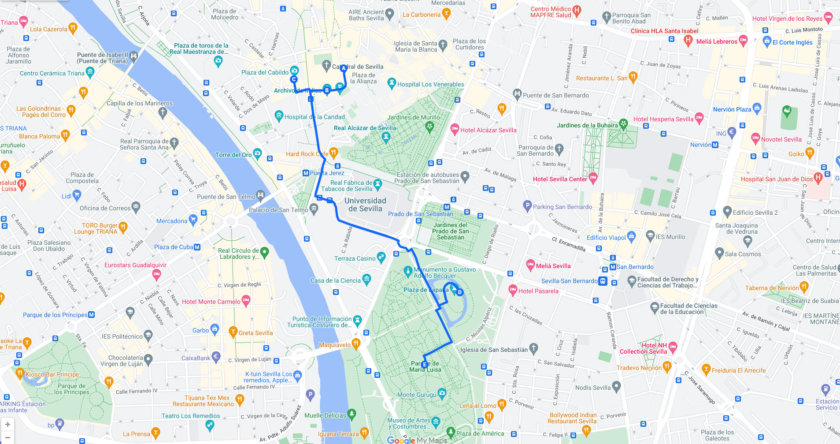
Day 1 visits:
A. Seville Cathedral B. The Indies Archives C. Barrio de Santa Cruz D. Plaza de España E. Maria Luisa Park
You should start your 3-day trip to Seville with a visit to the cathedral, the city’s emblematic monument .
Listed as a UNESCO World Heritage Site , the cathedral, whose construction began in the 15th century , is ranked among the three largest in the world.
You will for sure love its remarkable exterior architecture as much as its interior, where you can see the tomb of Christopher Columbus and the graves of several Spanish kings.
The Sacristia Mayor and the great chapel are also worth a look for the many works of art they contain.
With your ticket to visit the cathedral, you will also have access to the Giralda, the cathedral’s bell tower. From there you can enjoy a very beautiful view over Seville!
As I mentioned earlier in this guide, I strongly recommend you to take the Seville City Pass to avoid queuing in front of the cathedral.
If you don’t want to take the City Pass , here are 3 other options that will allow you to get priority access . For history lovers, the guided tours offered are also very interesting!
- Ticket to the Cathedral – Click here to book
- Guided tour of the cathedral
- Guided tour of the cathedral + Alcazar
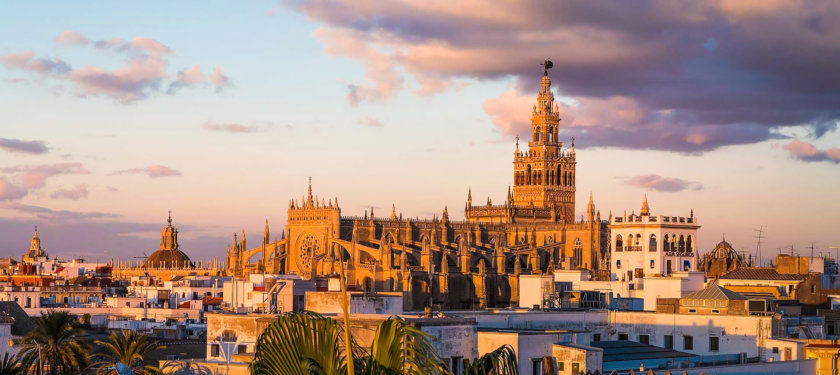
The second stop on your first day in Seville is the Archive of the Indies , located right next to the cathedral.
This UNESCO World Heritage Site contains documents relating to the Spanish colonies.
Although the original files are kept out of sight (the boxes you see on the shelves are empty), you should go have a look to admire the interior architecture .
It would be a shame not to visit the Indies archives as the visit is free and will only take you 15 minutes!
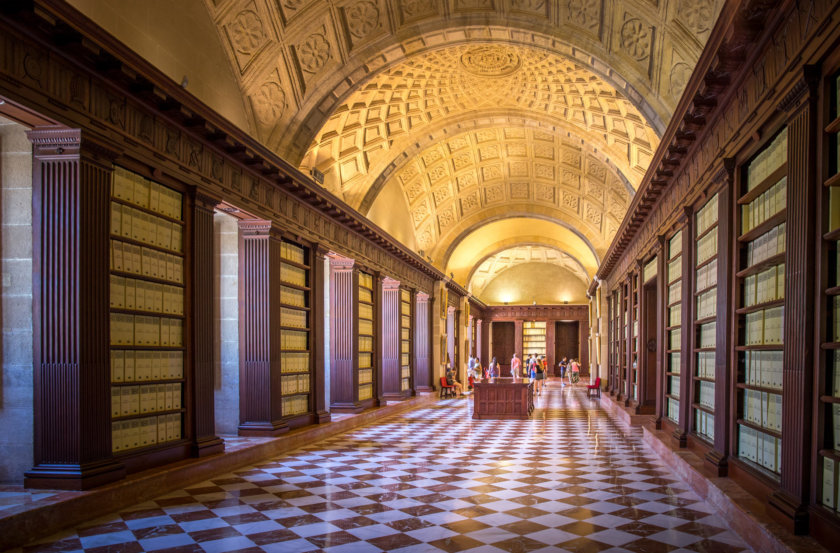
After this short visit, you can enjoy a walk in Seville old town: the Barrio de Santa Cruz .
This historic neighborhood is home to some of Seville’s most iconic landmarks , such as the cathedral and the Alcazar.
You will also find very pretty squares such as the plaza del Cabildo and its arcades, the patio of Banderas (featuring a great view on the Giralda) or the plaza Nueva, where the town hall of Seville is located.
In the maze of pedestrian streets lined with whitewashed houses , you will also have the opportunity to discover many nice small shops and to stop for a drink or a bite to eat in one of the numerous bars and restaurants.
And if you want to learn more about the history of the barrio de Santa Cruz , you should book this one-hour guided tour:
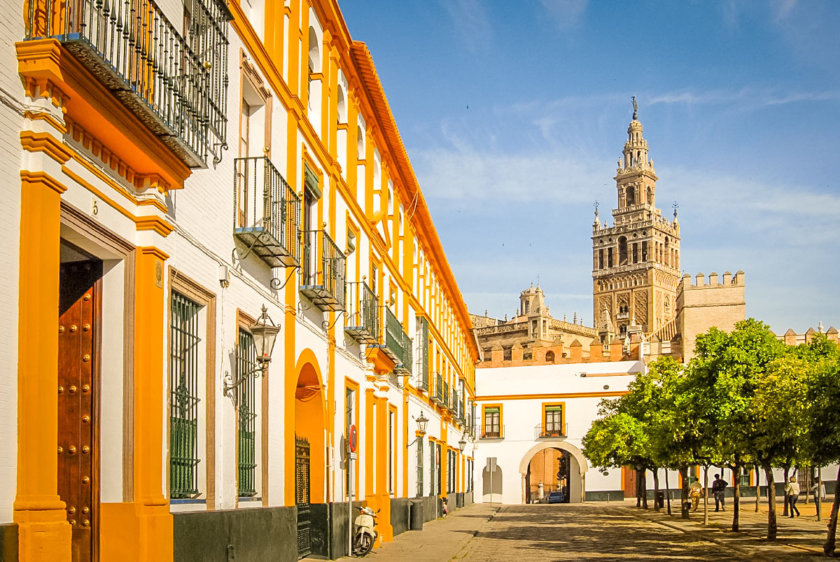
After a few tapas and a bit of relaxing time on a terrace, your 3-day trip to Seville will now take you to the Plaza de España, about fifteen minutes walk from the cathedral.
And the least I can say is that this huge square is really beautiful!
On the Plaza de España , you can admire:
- Canals (you can rent a boat to cross them) reflecting the superb architecture of the palaces.
- 4 bridges symbolizing the 4 ancient kingdoms of Spain
- Arcades, fountains and the famous 48 azulejos benches , each representing a province of Spain.
Instagram pros will be delighted to take pictures in this incredible setting and Star Wars fans will recognize one of the filming locations of Attack of the Clones.
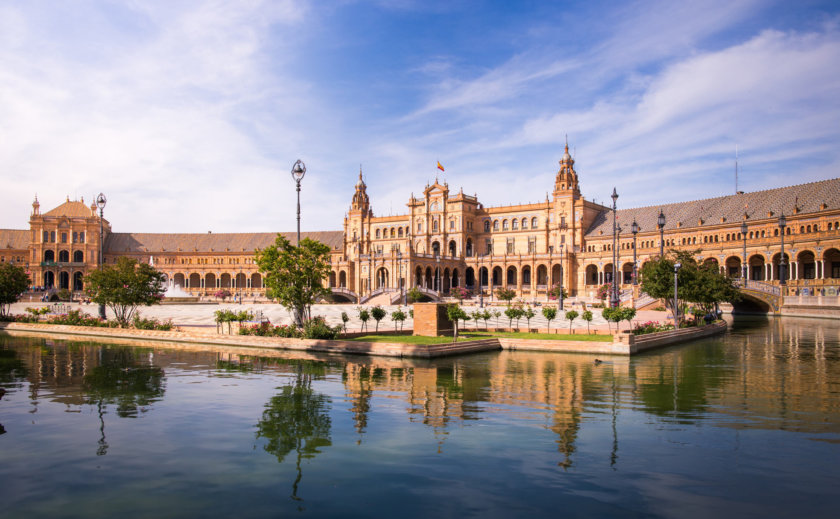
Once you’re done taking pictures of the Plaza de España from every angle (as I did 😅), you should head to Maria Luisa Park located nearby.
There, you can enjoy a leisurely stroll along the shaded paths , or relax near the fountains and pools . If you have chosen to do this 3-day trip to Seville in the summer, I can assure you that you will really appreciate a bit of greenery and coolness!
The park is also home to the Archaeological Museum and the Museum of Popular Arts and Customs , both of which are located in the Plaza America .
That’s it for the first day of visits, so enjoy a good dinner, go back to your hotel and be ready for the next day!
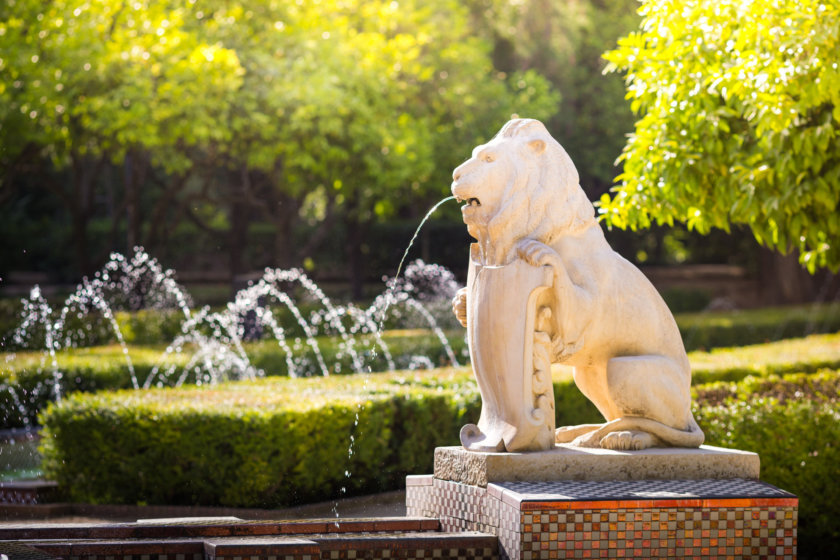
Day 2 – What to do and see in 3 days in Seville?
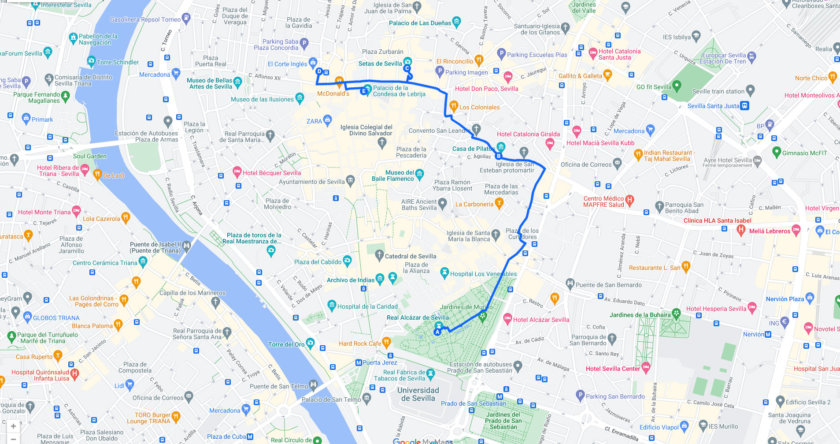
Day 2 visits:
A. Real Alcazar of Seville B. House of Pilatos C. The Metropol Parasol D. Shopping in Seville E. Flamenco show
For the second day of your 3-day itinerary in Seville, you should start with the Alcázar of Seville , located in the old town, next to the cathedral.
This palace, which still serves as the official residence of the King of Spain when he visits Seville, houses sumptuous rooms and patios in the Arabic and Moorish style .
Everything is finely worked, sculpted and in some parts covered with azulejos , decorated tiles typical of Spain and Portugal.
During your visit to the Alcazar, in addition to visiting the inside, you will also have the opportunity to take a stroll in the gardens housing magnificent flower beds and fountains.
To visit the Alcázar, you really need to book your tickets online in advance if you don’t want to start the day with a 2-hour long waiting line!
Access to the Alcazar is included in both the Seville City Pass and the Andalusia Pass . If you haven’t bought one of these passes, you need to make a reservation by clicking on one of the following orange links:
- Priority access ticket to the Alcazar
- Guided tour of the Cathedral + Alcazar
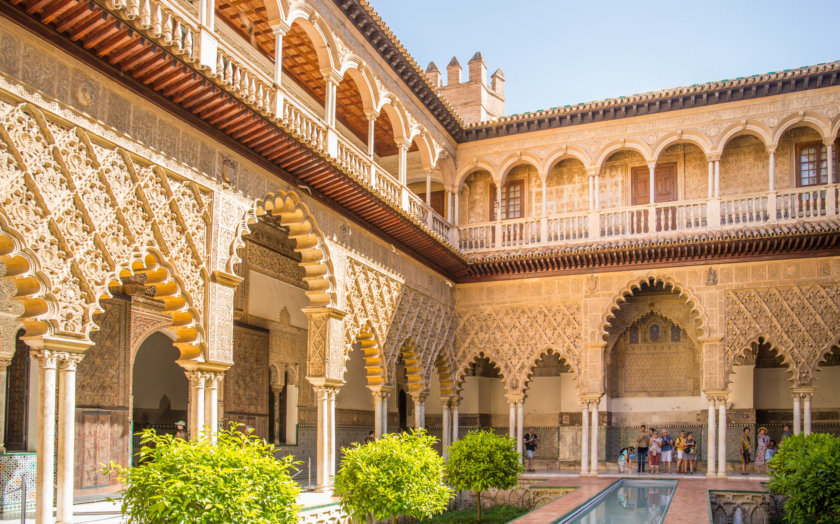
After your visit, you should head to the Casa de Pilatos, only 10 minute walk from the Alcázar.
This beautiful aristocratic palace skillfully blends several architectural styles: renaissance, gothic and Mudejar.
During your visit, you will be able to admire the patio and its fountain, as well as the surrounding rooms with their beautiful coffered ceilings and azulejos.
You can then take a tour of the gardens for a short break in the shade.
When you buy your ticket for the casa de Pilatos , you can opt for the audio guide. There are no explanatory panels on site, so if you want to learn more about this atypical place, this is your only solution.
Not far from the casa de Pilatos, you can also visit another beautiful house, the palace of Las Duenas (it’s up to you if you want to visit one or the other, or both – it fits into the schedule).
You will for sure love the classic patio and gardens, many works of art and richly furnished ground floor rooms .
The entrance ticket needs to be bought in advance by clicking on the link below:
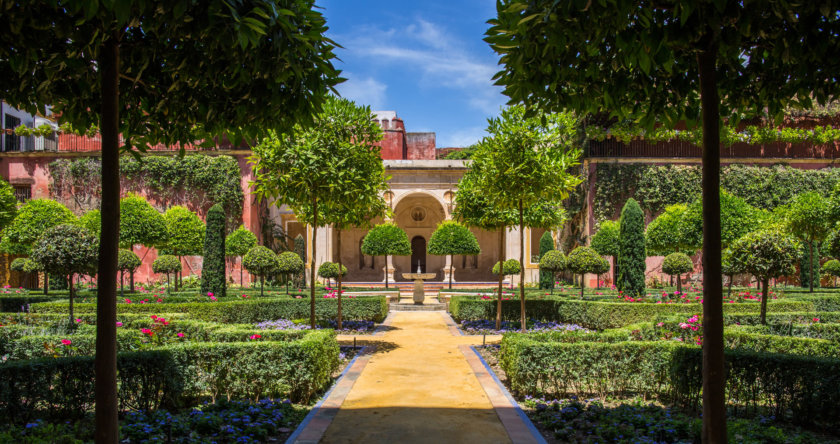
Leaving the Casa de Pilatos or the Palace of Las Duenas, you will now go to the Metropol Parasol , about 10 minutes walk from both palaces.
This strange wooden structure , looking like giant mushrooms is also known as “Las Setas” (“mushrooms”).
The foot of the mushroom houses a market and the antiquarium , a museum of archaeological remains discovered during the construction of the Metropol Parasol.
You can take an elevator and access the top of the structure: up there, the walkways will allow you to enjoy a splendid panoramic view of Seville.
The ticket for the viewpoint costs 5€ during day time (8€ for sunset and 10€ at night) and entitles you to a €1 discount on a drink at the bar located at the top.
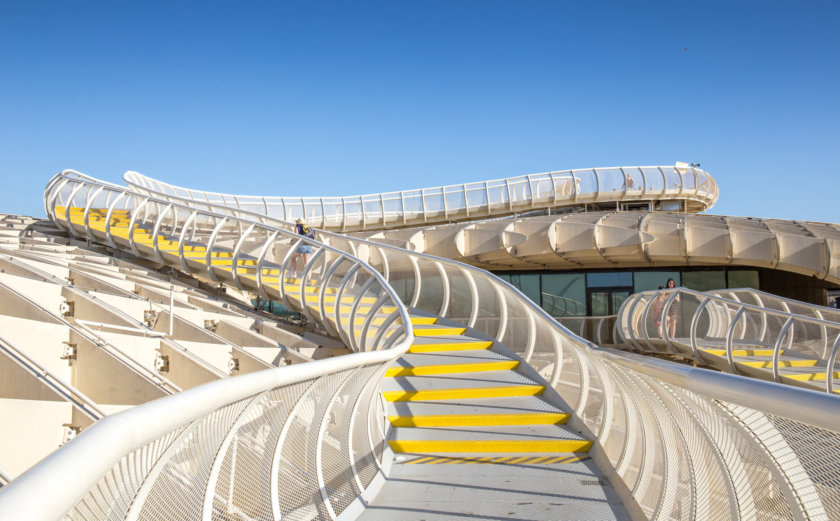
As you are in the city center, you can take the opportunity to do a bit of shopping during your 3-day trip to Seville!
From the Metropol Parasol, you should take Calle Imagen and Calle Martin Villa , to reach a shopping area with the classic fashion stores such as Zara or H&M.
In the same area, you can also go to El Corte Inglès shopping centre.
To end the day in style, you should go see a flamenco show.
Yes, a good trip to Andalusia must include this typical activity!
In Seville , there are many flamenco shows to choose from, some clearly better than the others. So here is my suggestion of the best shows:
- La Casa de la Memoria, next to the Metropol Parasol. This small theatre offers an intimate show with only 2 dancers and a musician.
But due to the size of the place, you have to book your seats quite much in advance. To check the availability and book, simply click on the button below:
- La Flamenqueria Sevilla: similar to La Casa de la Memoria. Located in Triana district, you need to click here to book.
- For a more spectacular show, including more dancers and musicians, as well as a dinner or an aperitif with tapas, you should go to the Palacio Andaluz.
To book your flamenco evening in Seville at the Palacio Andaluz , you just have to click on the green button below:
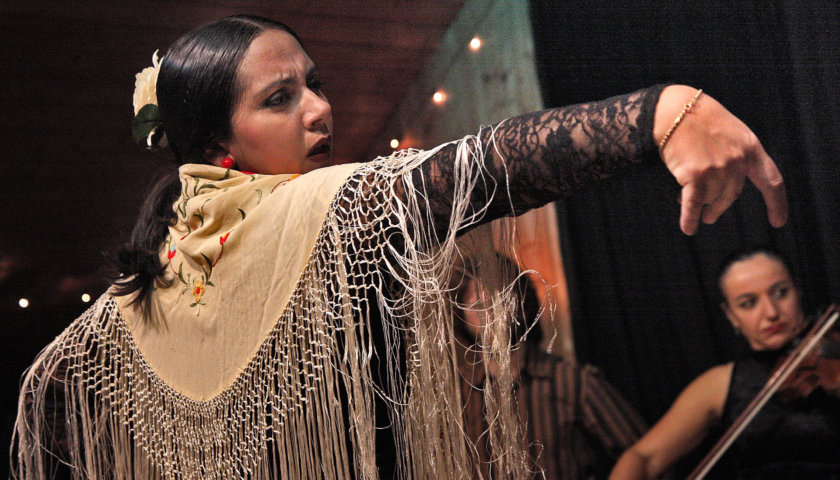
Day 3 – Stroll in Seville
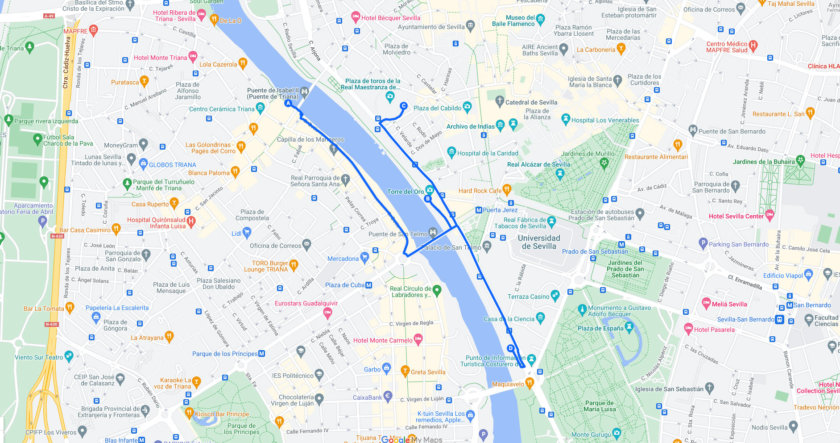
Day 3 visits:
A. Triana district B. The Gold Tower C. Seville Bullring D. Cruise on the Guadalquivir E. Cooking class + dinner
For the third (and last) day of your 3-day stay in Seville, you should start with a stroll through Triana district .
Located on the other side of the Alfonso XIII canal , opposite the historic centre, you only have to cross the Isabel II bridge to reach it.
First, head to Triana covered market , where you can find high quality Spanish products such as sausages and cheeses.
Next to the market, you can also visit the Triana ceramics centre, featuring several ceramic workshops .
Then, walk along Calle Betis to enjoy the view over the Gold Tower located on the opposite bank of the Guadalquivir river.
You should then turn right to see the Iglesia de Santa Ana , wander through the narrow streets and then cross the river back over San Telmo bridge .
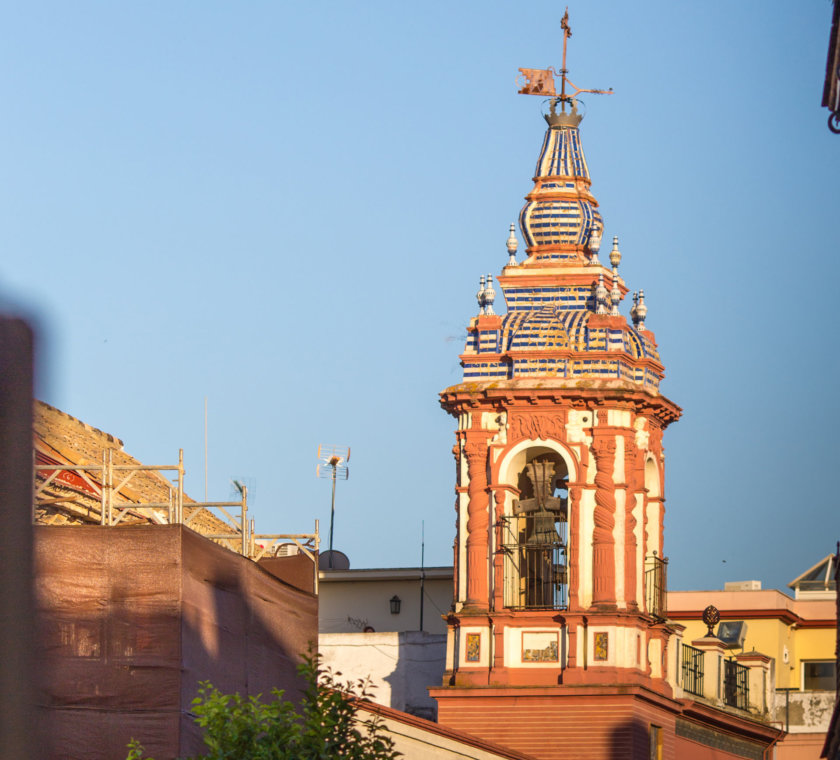
You will find yourself at the foot of the Golden Tower or Torre del Oro in Spanish.
Built in the 13th century , the tower played a military defence role: a chain stretched between the Golden Tower and another tower on the opposite bank blocked access to the river for enemy ships.
It was named “Torre del Oro” because ships stopped here to unload their cargo of gold.
Today, it houses the Seville Naval Museum . During the visit, you can see navigation instruments and scale models of ships .
From the top of the Gold Tower, you can also enjoy a beautiful view over Triana district , located on the other side of the Guadalquivir.
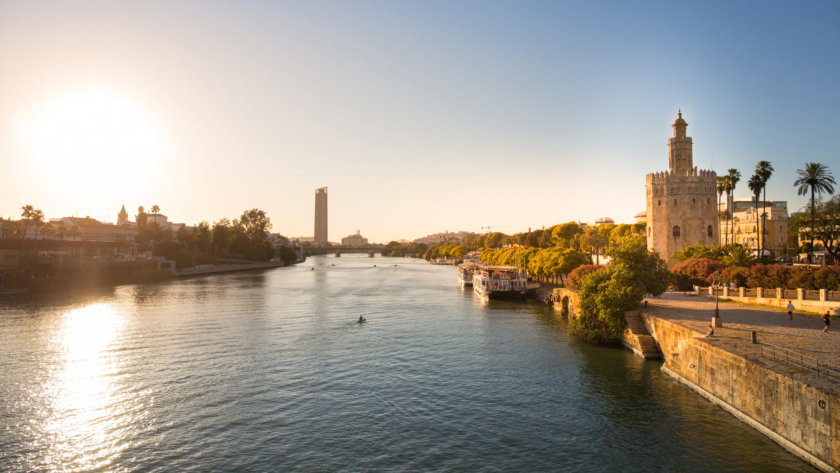
Continue your walk to the bullring of Seville (“Plaza de Toros de la Maestranza”) , located 200 metres from the Torre del Oro .
Depending on your convictions, you can choose to visit or not, however it’s important to know that bullfighting is still a very popular tradition in Andalusia.
The visit to the bullring is only guided, in Spanish or English and lasts one hour. It needs to be booked in advance by clicking on the button below:

Visiting Seville in 3 days gives you time to enjoy a very pleasant activity: a short cruise on the Guadalquivir . It’s perfect to discover the city from another angle!
And what’s great is that you can choose between 3 different cruises (don’t hesitate to click on the orange links for more info and to book):
- One hour cruise with commentary (click here!) available in several languages. Departures every hour between 11am and 8pm.
- One hour eco cruise – Remember to book in advance as there are only 5 departures per day.
- A 1h30 yacht cruise, in small group : the tour includes a drink. There is also a 2-hour version with dinner. You can find more information by clicking on the orange link.
To end your 3-day stay in Seville, why not opt for a fun activity?
Tonight, you will have the opportunity to cook an authentic paella!
During your cooking class, you will also discover the secrets of making a good gazpacho and excellent tapas .
And of course you will end up enjoying all the dishes you’ve made with sangria and a good glass of wine!
The course starts at 6pm and lasts about 3 hours. Book your Spanish cooking class in Seville now by clicking on the button below:
After this last activity, your 3 days in Seville are now almost over. Spend one last night at your hotel before your flight home the next day.
You now know all the best places to visit during your 3-day trip to Seville!
However, you still need to do 1 important thing before leaving: booking your hotel.
In order to help you out, I have prepared a list of the best hotels in Seville depending on your budget .
As always, you should book as early as possible to get the best prices. The hotels that offers the best value for money in Seville are often fully booked months in advance!
- Black Swan Hostel : Youth hostel located within 10 minutes walking distance from the Cathedral and the Alcazar. Very stylish and contemporary dormitory bed from 17€ per night, breakfast included! Strong points: the relaxed atmosphere, the friendly staff, the free dinners cooked by volunteers. This is the best choice if you are looking for a youth hostel.
- Hotel Don Paco : Located in the centre of Seville, at 10 minutes on foot from the Cathedral. Spacious room and comfortable bedding from 60€ per night, breakfast at 10€. Strong points: excellent breakfast, the peaceful atmosphere and the swimming pool on the roof. My favorite in Seville for its great value for money!
- Hotel Fernando III : Located in the historic district of Santa Cruz and therefore close to the Cathedral and the Alcazar. Modern and spacious room from 106€ per night, breakfast included. Strong points: the excellent location, the pool on the roof, the very helpful staff.
- EME Catedral Hotel: Located right next to the Cathedral and the Giralda. Very modern double room from 180€ per night, breakfast at 20€. Strong points: The best location in town, the hotel design, the swimming pool with the view on the Cathedral, the amazing breakfast, the very helpful staff. Don’t hesitate, it’s the best luxury hotel in town!
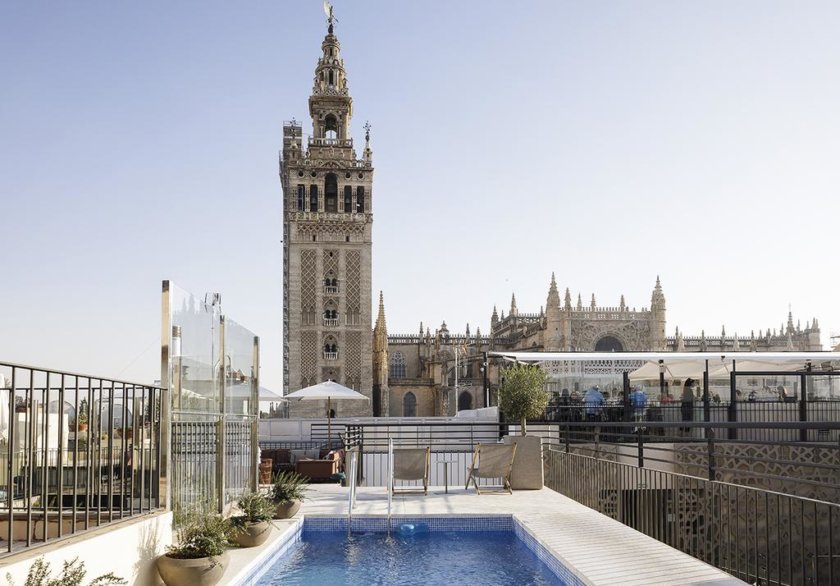
You’re planning to visit Seville with your children for 3 days?
Well, even with kids, you can easily follow my 3-day itinerary.
It’s optimized to avoid walking too much between the places you will visit each day, so it shouldn’t be too tiring, even with young children.
However, in order to keep them motivated, I would add an extra activity especially for them: the aquarium of Seville . It takes about an hour to visit , and your kids will for sure enjoy it!
Tickets for the aquarium need to be bought in advance by clicking here.
If you want to adjust this 3-day itinerary in Seville and would like to include different tours or activities , you should read my detailed guide of the city: The 22 best things to do in Seville.
It might even make you want to extend your stay in Seville by a few days so you have enough time to fit it all in. In that case, you should check my other itineraries right there!
To help you visualize your daily itineraries during your 3 days in Seville, I have created this map with all the places to visit day by day . You can view the legend of the map by clicking on the top left button, the one with a little arrow.
You can thus see the suggested itineraries for each day.
As always, you should book your plane tickets as early as possible to get the best prices.
To check the rates and schedules for flights to Seville, you can use our flight comparator, in partnership with Skyscanner:
If after reading this guide you still need help to plan your 3-day trip to Seville, don’t hesitate to ask me your questions in the comments section below.
Andalucia travel Guides
- Buy the DK Eyewitness Andalusia guide on Amazon.com or on Amazon.co.uk
- Buy the Lonely Planet Andalusia guide on Amazon.com or on Amazon.co.uk
- Buy the Rick Steves Snapshot Andalusia guide on Amazon.com
Discover all my articles about Spain : All my articles to help you plan your trip to Spain are listed there.
The 20 Best Things to Do in Andalucia : The ultimate bucket list!
- Itinerary: 4-5 days in Andalucia – The perfect itinerary for a short stay in Andalucia !
- Itinerary: 1 week in Andalucia – With all my best tips + accommodation suggestions!
- Itinerary: 10 days in Andalucia – Discover how to visit Andalucia in 10 days, with all my best tips!
- Itinerary: 2 weeks in Andalucia – The best itinerary to visit Andalucia in 14-15 days
- Cadiz: The 12 things you must-see in town!
- Cordoba: Top 15 best things to do and must-see attractions
- Granada: Top 15 best things to do
- Malaga: The 15 best places to visit
- Ronda: The 10 best things to do
- Seville: Top 15 best things to do and places to visit
- 2 days in Seville – The perfect itinerary for 48h!
- 3 Days in Seville – The best 72h itinerary to visit the city
- Where to stay in Seville? My guide to the best hotels for an epic stay!
You’re using Pinterest? Here is the picture to pin!
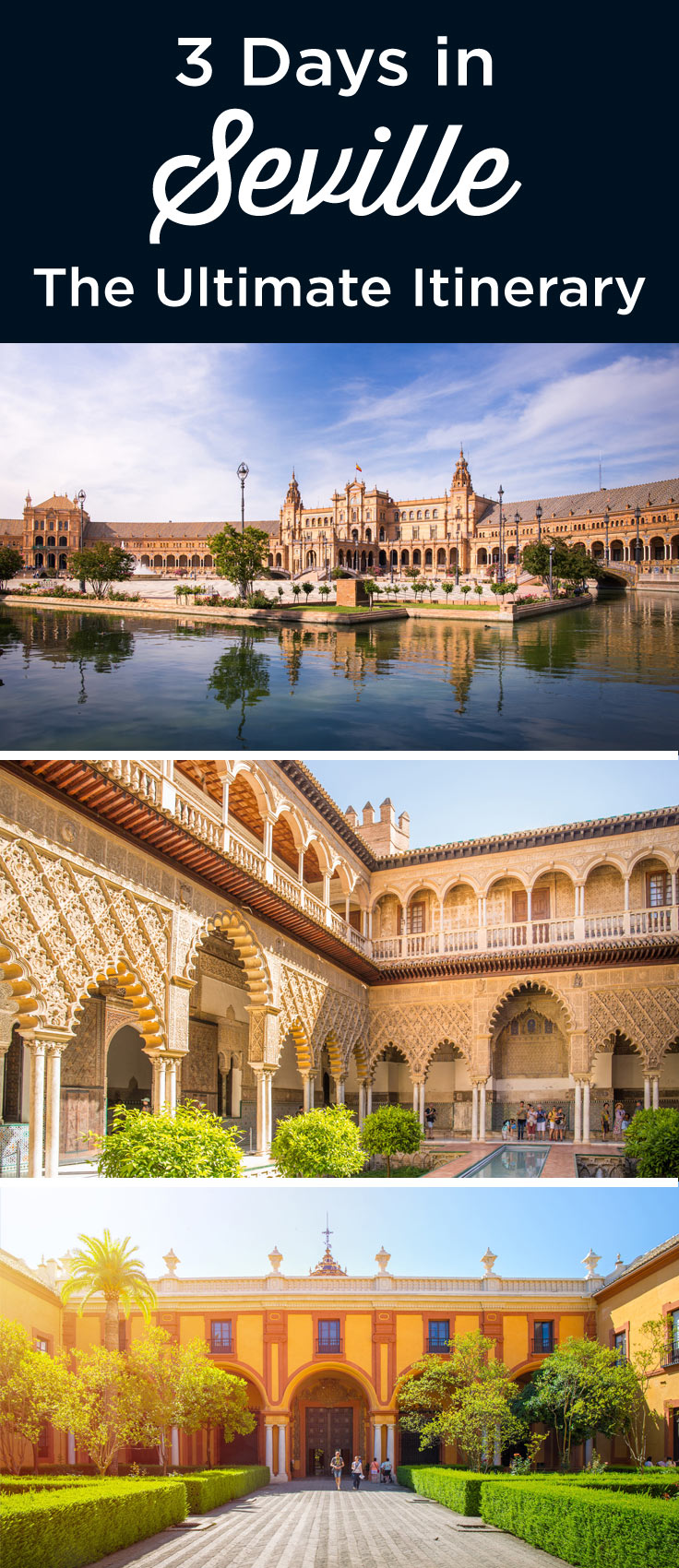
Creator of the Voyage Tips blog, travel and photography lover. I give you all my best tips to plan your next trip.
Related Stories
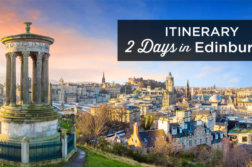
2 days in Edinburgh: Itinerary for your weekend +my best tips
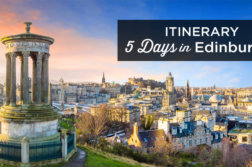
5 days in Edinburgh: the perfect Itinerary (first time visit)

Gozo quad rental: The definitive guide
Leave a reply cancel reply.
Your Name (required)
Your Email (required)
Your Website (optional)
Save my name, email, and website in this browser for the next time I comment.
- Middle East
- North America
- Cheap car rentals: my best advice
- Back to Homepage

- Visites et découvertes
- Loisirs et détente
- Bonnes adresses
- Hébergements
- Hautes-Pyrénées
- Lozère & Aveyron
- Tarn-et-Garonne
- Tarn & Hérault
- Provence / Côte d’Azur
- Au delà du Sud
- Belgique & Pays-Bas
- Danemark & Îles Féroé
- Espagne & Catalunya
- Amérique du Nord
- Amérique du Sud
- Kiki Inspirations
- Travaillons ensemble
- Team Kiki Mag
- Nous contacter
Visiter Séville, mes 8 incontournables
- 24 mars 2022
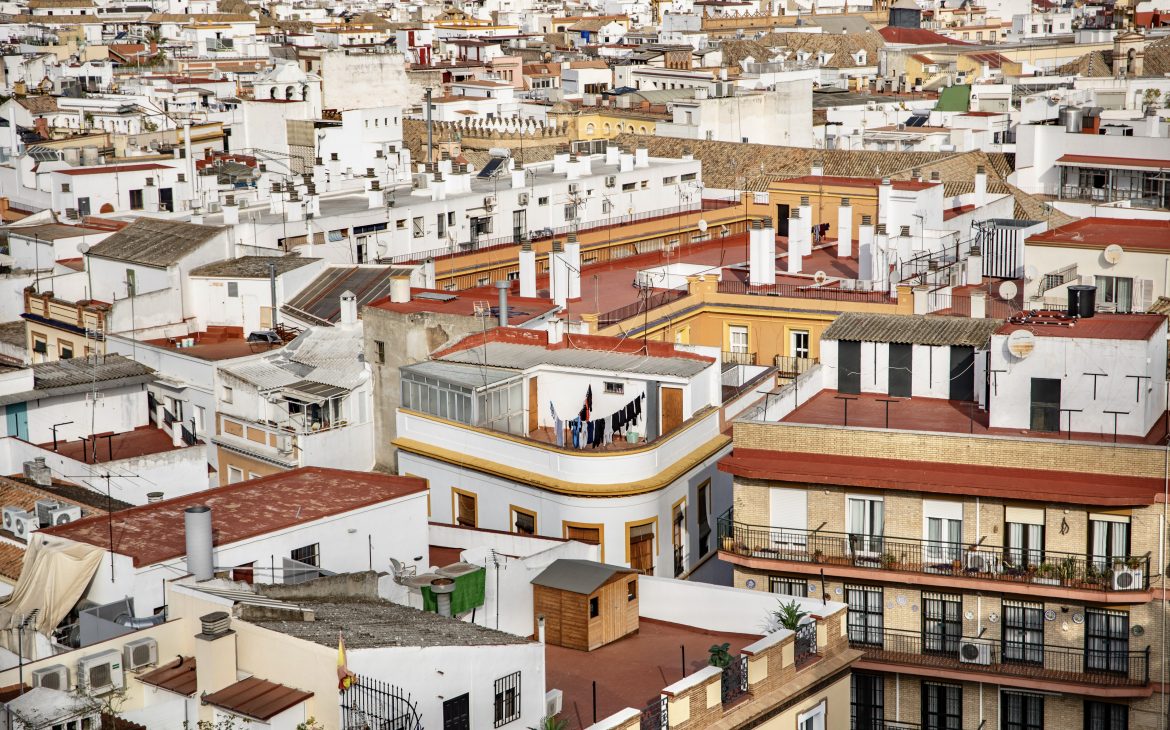
« En Espagne, dès le matin, c’est café Olé ! » Gaëtan Faucer
Capitale de l’Andalousie, terre d’histoire et de culture, Séville est une ville bouillonnante et trépidante célèbre pour son flamenco, ses monuments historiques, sa douceur de vivre et sa gastronomie. Visiter Séville, c’est visiter une ville à la renommée internationale, un haut lieu du tourisme espagnol. On ne peut que l’apprécier au même titre qu’on apprécie son plaid un jour de pluie avec un bol de pipas. Spectacles de rues, façades aux mille couleurs, orangers et maisons blanchies à la chaux… un tas de raisons vous feront aimer cette ville qui cesse de surprendre, de charmer et d’émerveiller.
VISITER SEVILLE : FOIRE AUX QUESTIONS
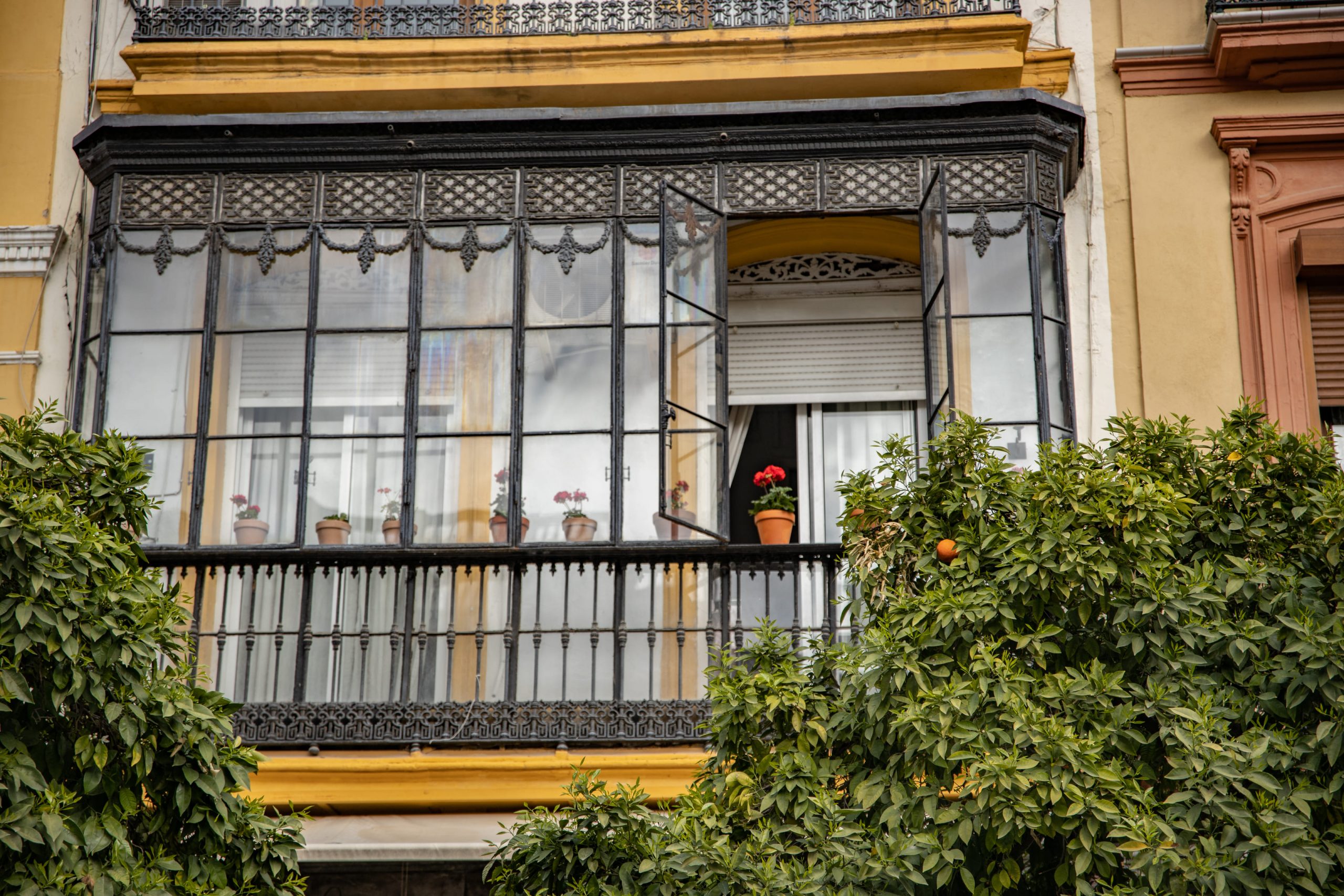
- Comment rejoindre le centre-ville de Séville depuis l’aéroport ? Pour rejoindre le coeur de ville, vous avez le choix entre le taxi ou le bus. Si vous choisissez l’option bus, le ticket s’achète directement au chauffeur.
- Quel est le budget total pour un séjour de 4 jours à Séville ? Avion : 63€ par personne, hôtel + petit déjeuner : 190€ par personne, repas : environ 150€ pour deux personnes (repas midi et soir), activités et visites : environ 50€ par personne. Ce qui fait un total approximatif de 378€ pour 3 nuits et 4 jours par personne tout compris (cela peut varier en fonction des hébergements choisis, des restaurants et des activités sur place)
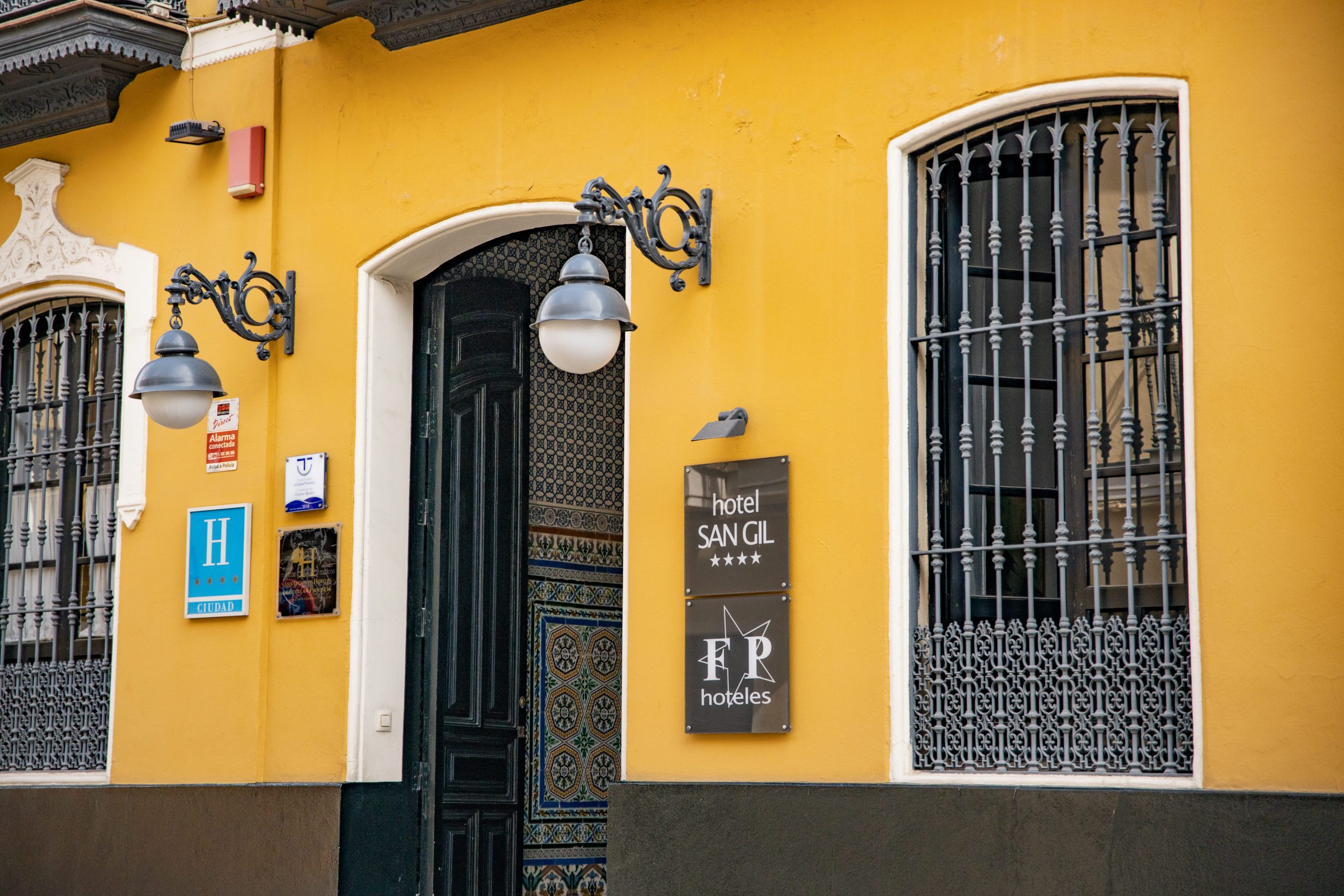
- Où dormir à Séville ? Pour ce séjour, j’ai logé à l’hôtel San Gil dans le quartier Alameda l’un des plus animés de la ville. Un petit havre de paix à 20 minutes à pied du coeur de ville. Petit-déjeuner au top, accueil chaleureux, cadre très cosy et piscine sur le toit (avec une jolie vue). Nous avons payé 381€ les 3 nuits soit 127€ la nuit pour deux avec petit-déjeuner (il existe des hôtels moins onéreux). Si vous avez des enfants, je vous conseille un quartier plus proche comme le Centro, le quartier Alfalfa, d’Arsenal ou Santa Cruz.
- Est-ce une destination familiale ? Un grand OUI ! Séville est une destination pour petits et grands.
- À quelle période visiter Séville ? Évitez les périodes estivales Juillet/Août, car les températures avoisinent les 40 degrés.
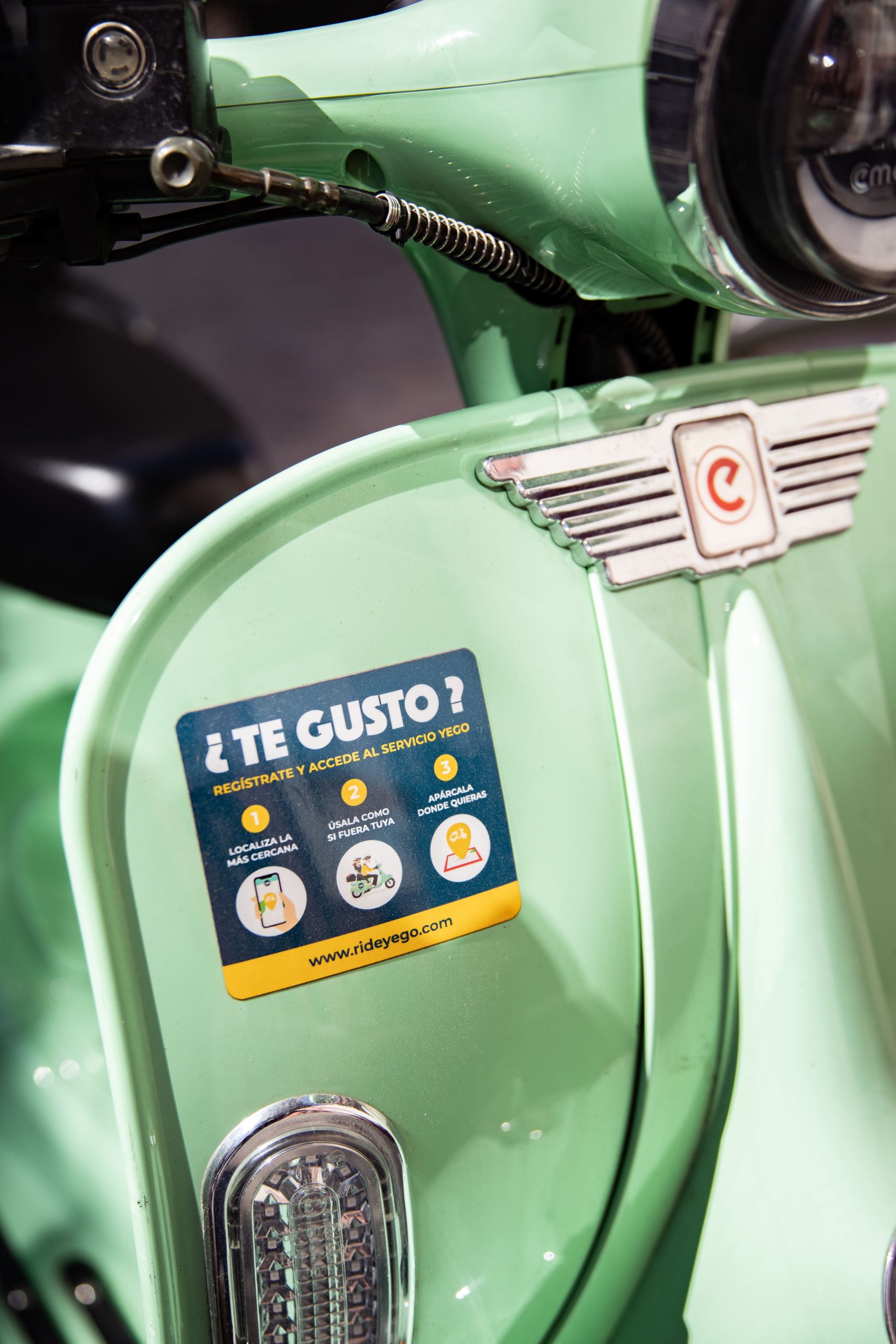
- Comment se déplacer à l’intérieur de la ville ? Tout peut se visiter à pied, les lieux emblématiques se concentrent au même endroit. La ville met à disposition des vélos, trottinettes et scooters électriques (façon Vespa) en location via l’application Yego . Si je ne me trompe pas, le tarif est de 0,22 centimes la minute.
VISITER SEVILLE : MES 8 INCONTOURNABLES
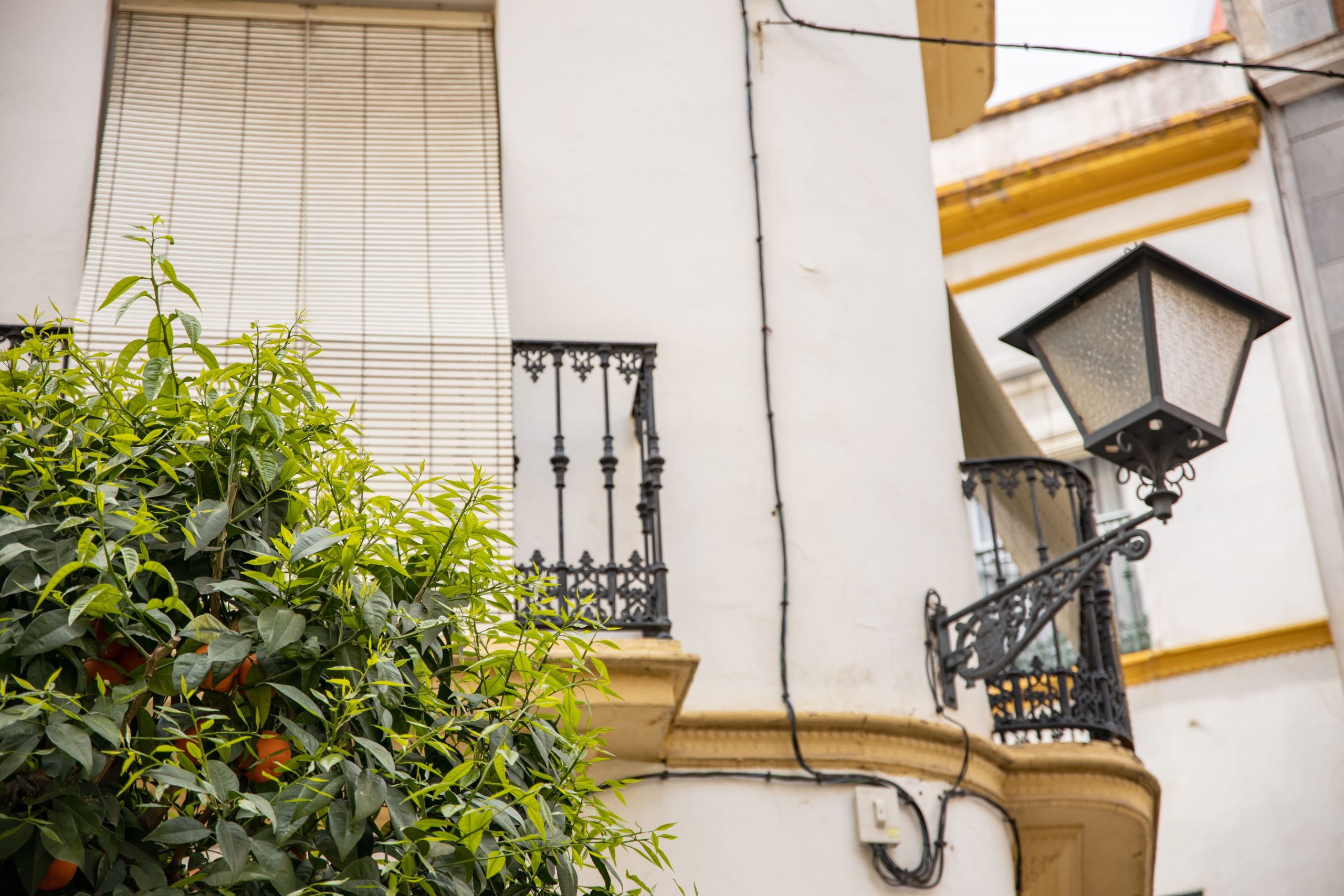
« La force de Séville est dans chacun de ses détails… »
1- Découvrir les Mercados de Séville
Les Mercados, ce sont pour moi des étapes gourmandes incontournables où l’on plonge dans l’authenticité et la convivialité de Séville. Une atmosphère populaire et vivante où il fait bon vivre et bon manger :p. Voici mes trois chouchous :
Le Mercado de Feria, gourmand, authentique et vivant
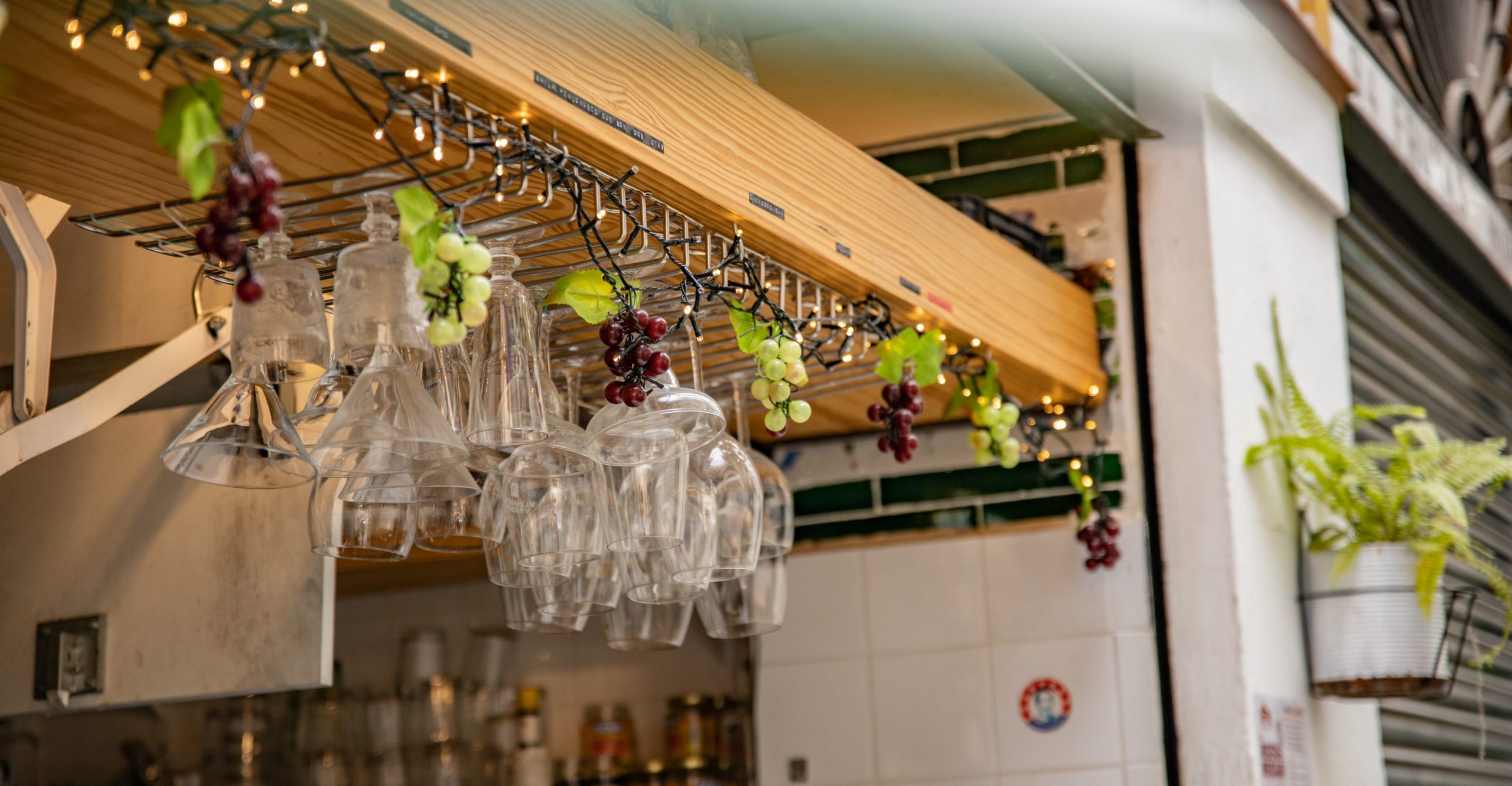
Pour moi, visiter Séville passe obligatoirement par le Mercado de Feria , l’un des plus anciens marchés de la ville. J’ai adoré ce lieu qui regroupe des halles et des petits restaurants comme Jalio, mon coup de coeur culinaire du séjour. Ce marché au charme singulier est à l’image de cette belle ville espagnole : conviviale et attachante.
- À voir dans le coin : l’église d’Omium Santorum, le quartier San Gil et la basilique de Jesus del Gran poder.
Le Mercado de triana, traditionnel et convivial
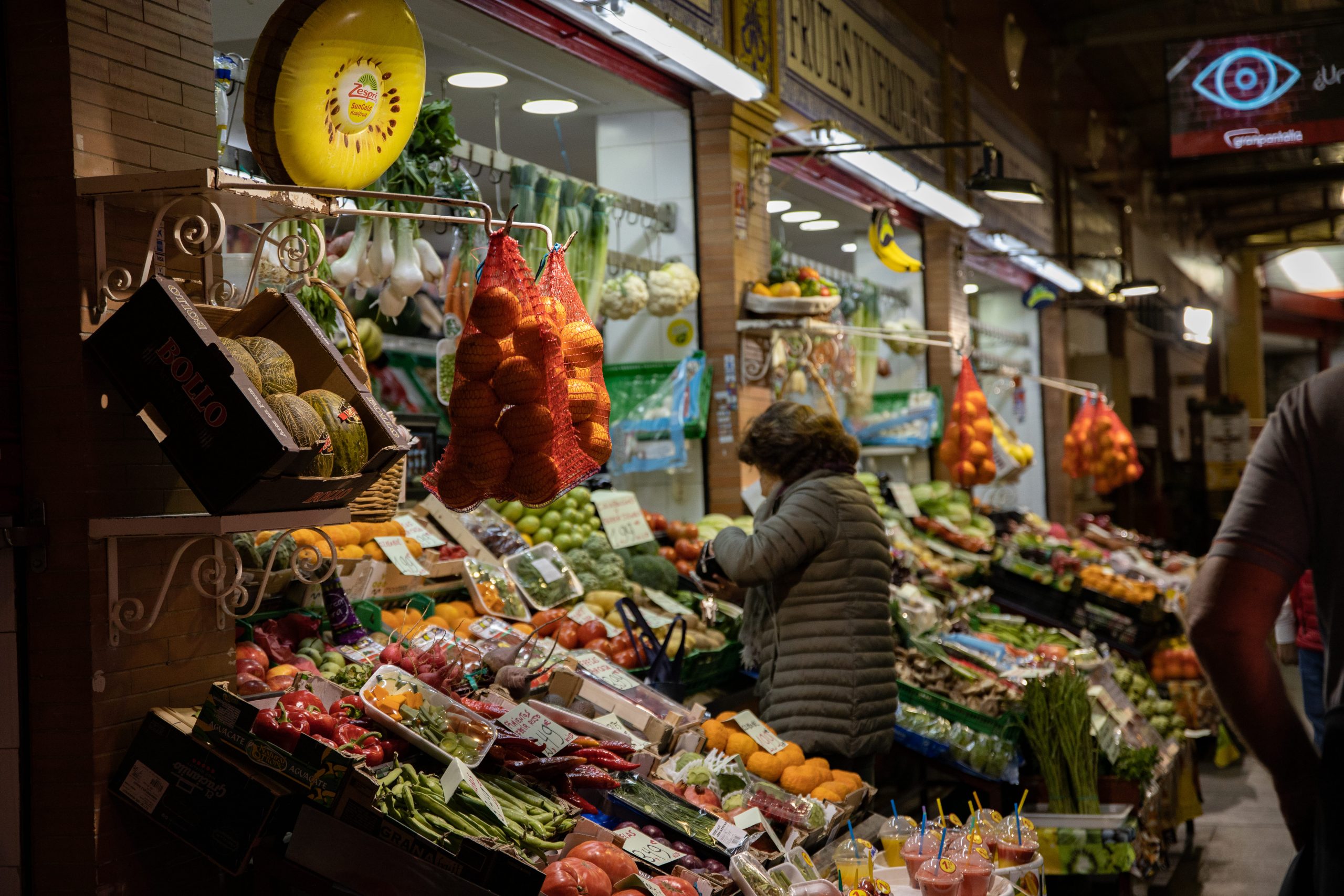
Le Marché du Triana est une halle couverte située dans le quartier portant le même nom. On y trouve des stands de fruits et légumes, des fromagers, des poissonniers, des bouchers et les meilleures charcuteries de la ville. Si vous êtes comme moi, des fans de jambon bellota, alors c’est ici que vous régalerez vos papilles.
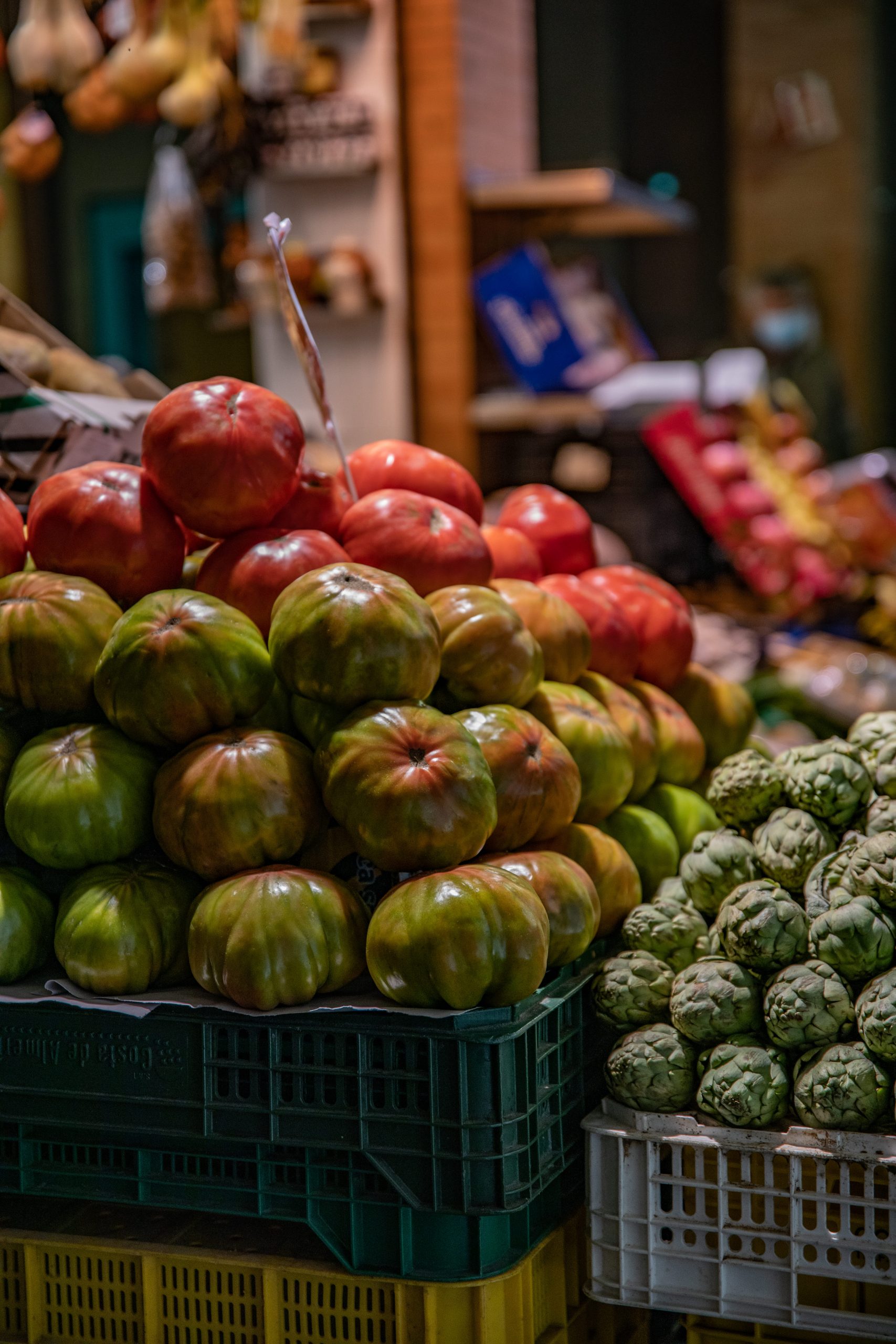
- Le petit détail qui tue : sous le marché se trouve les vestiges du Château de Saint-Georges qui a été le siège de l’Inquisition à partir de 1481.
Le Mercado de Lonja del Barranco, moderne et inventif
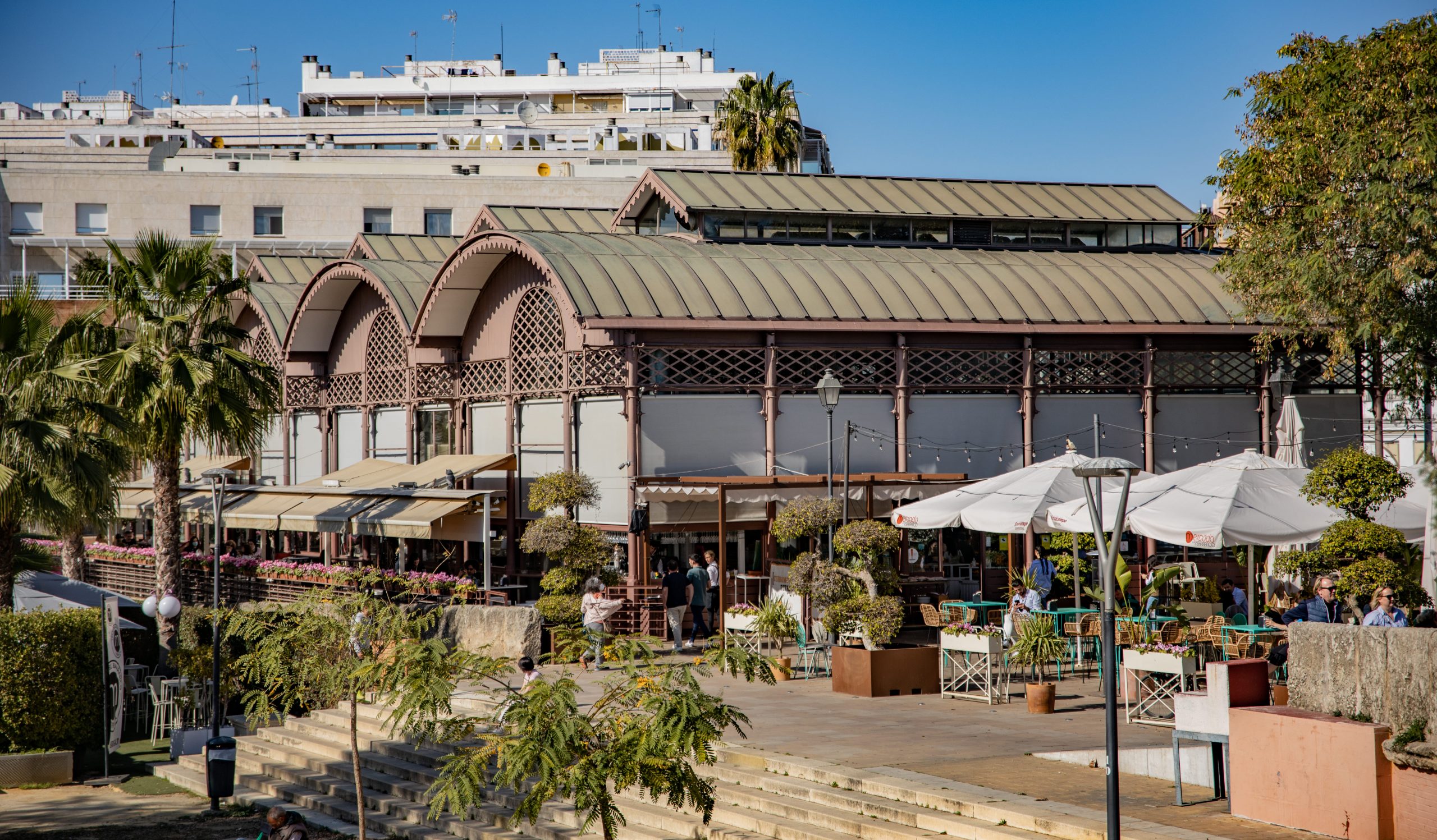
Le marché de Lonja del Barranco se situe sur les berges du fleuve Guadalquivir (nom impossible à retenir). Il s’agit d’un espace gastronomique qui s’étend sur 1200 m2 et qui compte plus de 20 stands de restauration. Ancien marché aux poissons, il est devenu aujourd’hui un haut lieu de la gastronomie sévillane.
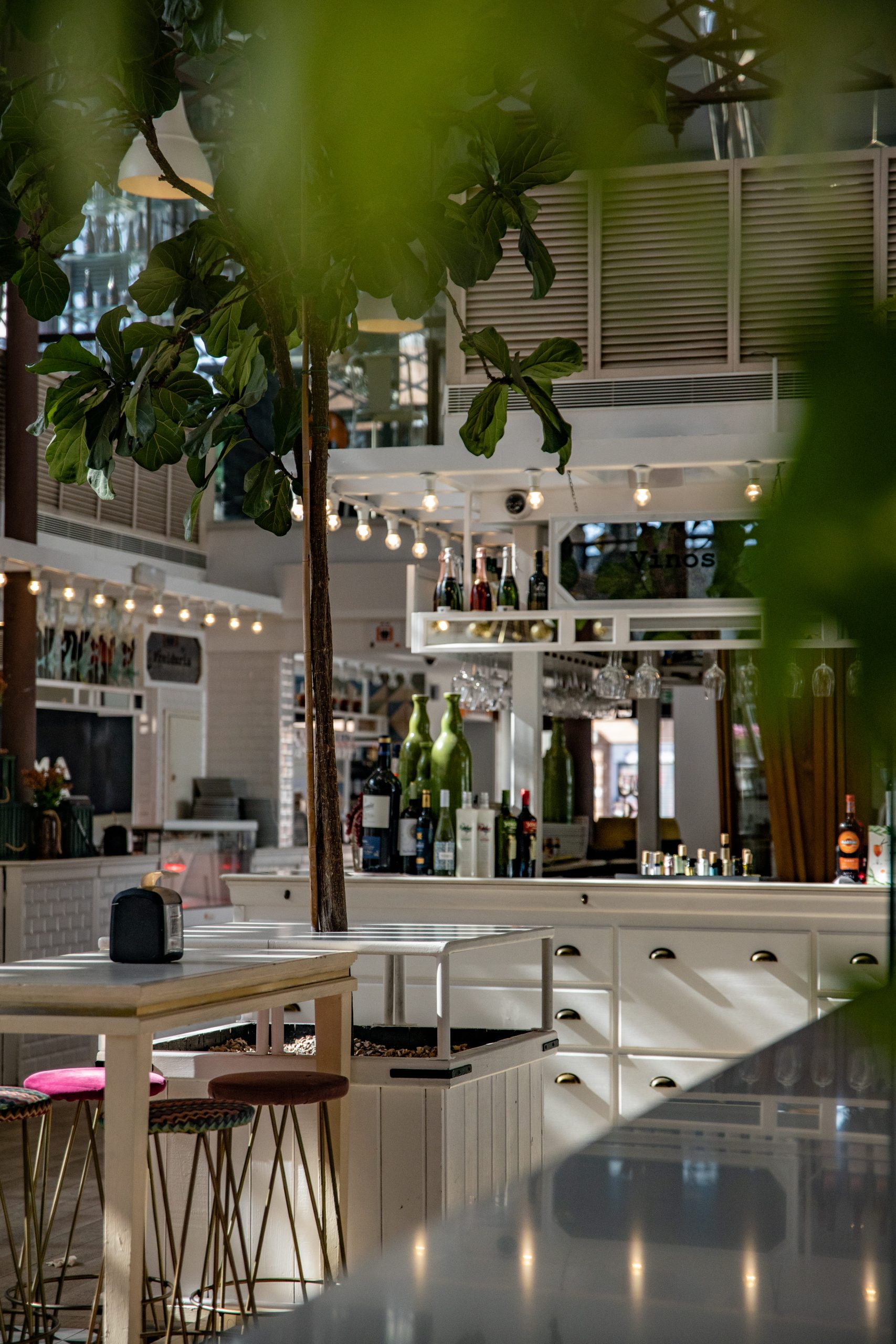
Ici, on ne retrouve pas du tout l’ambiance traditionnelle des mercados typiquement espagnols, mais l’atmosphère reste toutefois très conviviale. De la charcuterie, de la paëlla à toutes les sauces et des gourmandises, c’est un vrai petit paradis qui séduira tous les épicuriens de ce vaste monde.
- Bon à savoir : cette ancienne criée a été conçue par le célèbre Gustave Eiffel.
2- Santa Cruz, l’ancien quartier juif
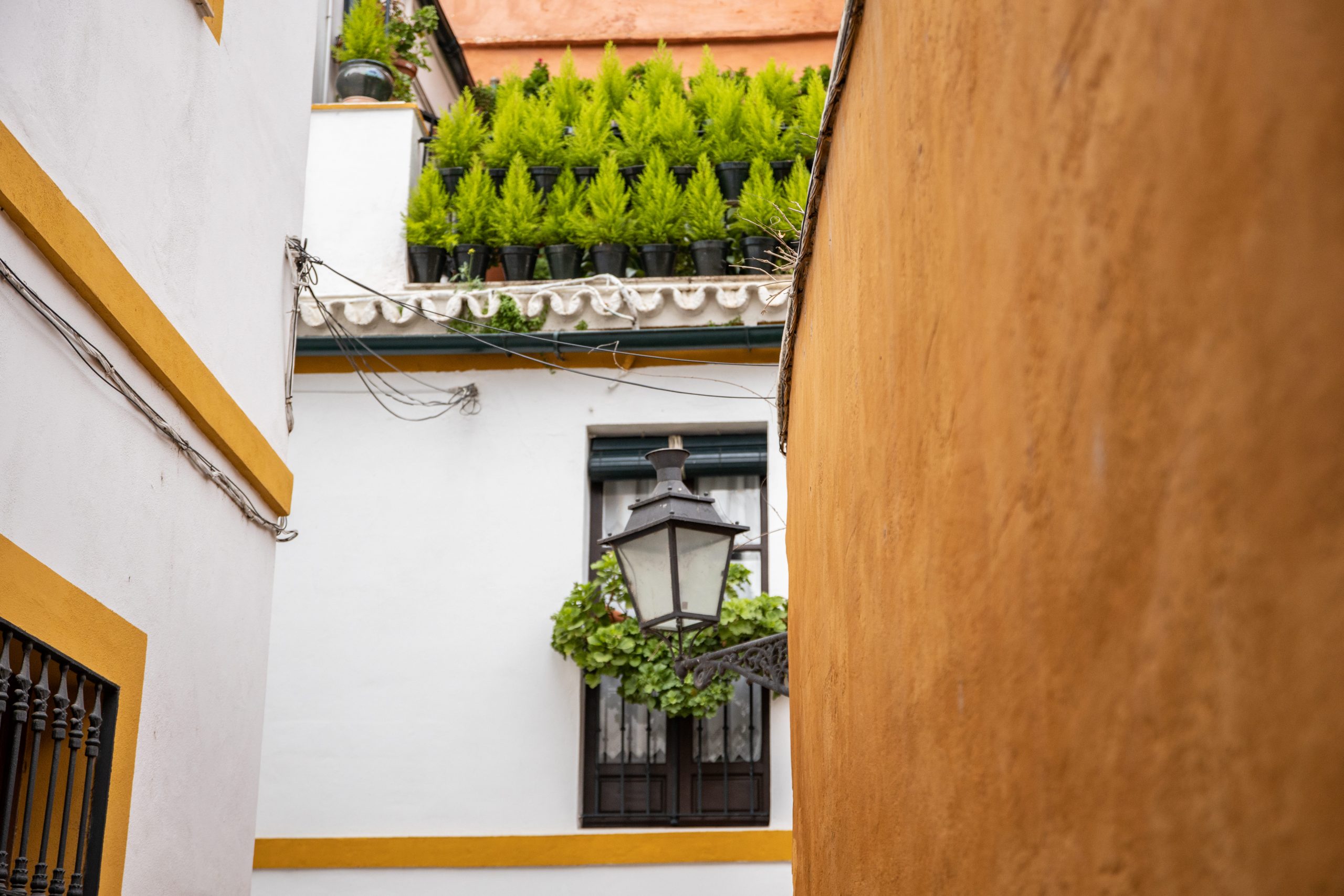
Le quartier Santa Cruz abrite aujourd’hui le cœur touristique de Séville. Non seulement c’est le quartier le plus animé de la ville mais c’est aussi l’endroit qui regroupe les lieux les plus emblématiques tels que la cathédrale de Séville, la Giralda ou encore l’Alcázar, le palais aux 1001 jardins.
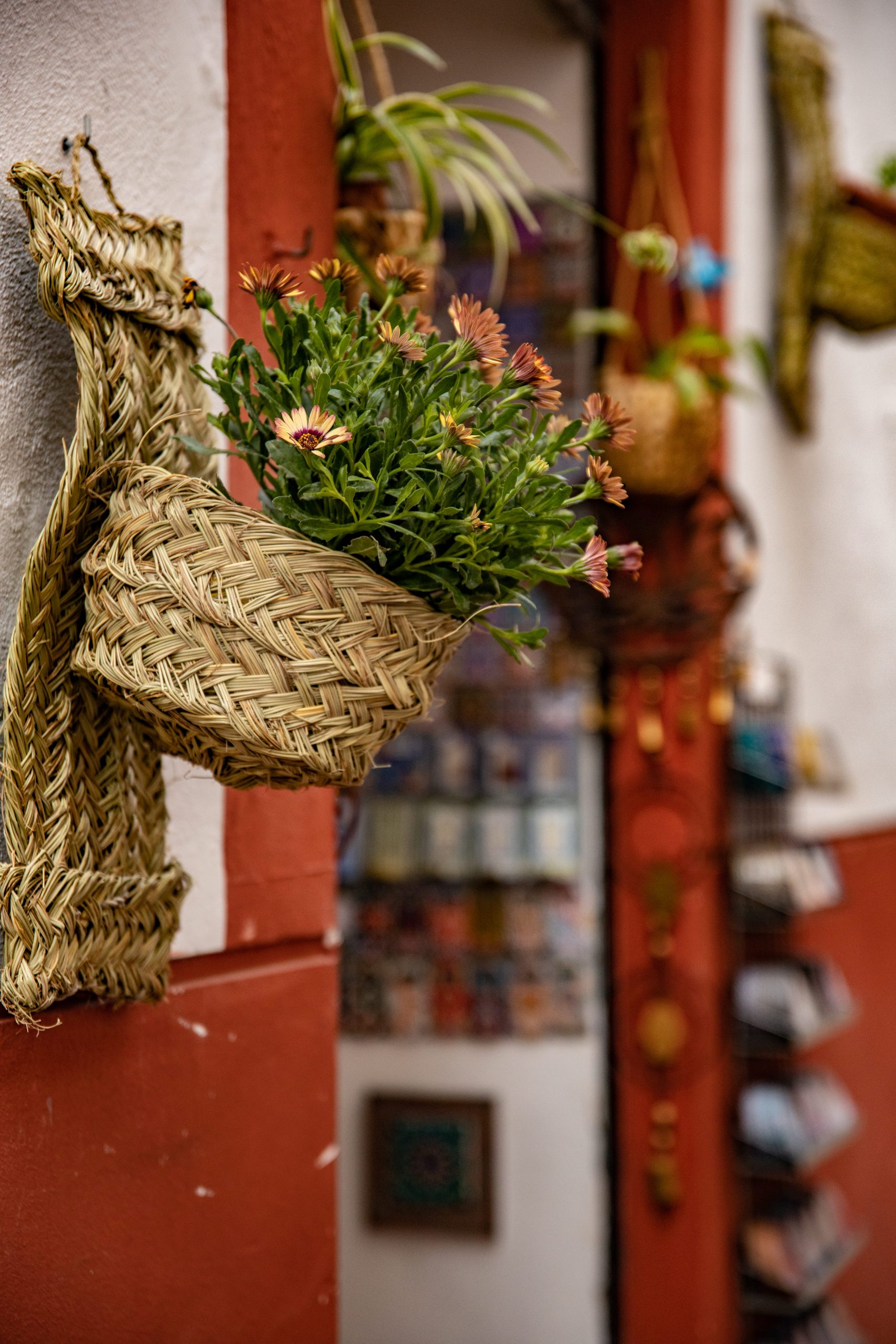
Ce que j’ai le plus apprécié ici? Son labyrinthe de ruelles médiévales qui se prête parfaitement à la balade. Une véritable mine d’or de façades colorées, de maisons blanchies à la chaux et de placettes cachées jonchées d’orangers. Et que dire des bars à tapas, des boutiques de souvenirs et d’objets artisanaux ? Ces petits rien qui forment un tout font de Santa Cruz, l’un des quartiers les plus photogéniques. Un voyage parmi mille curiosités et merveilles.
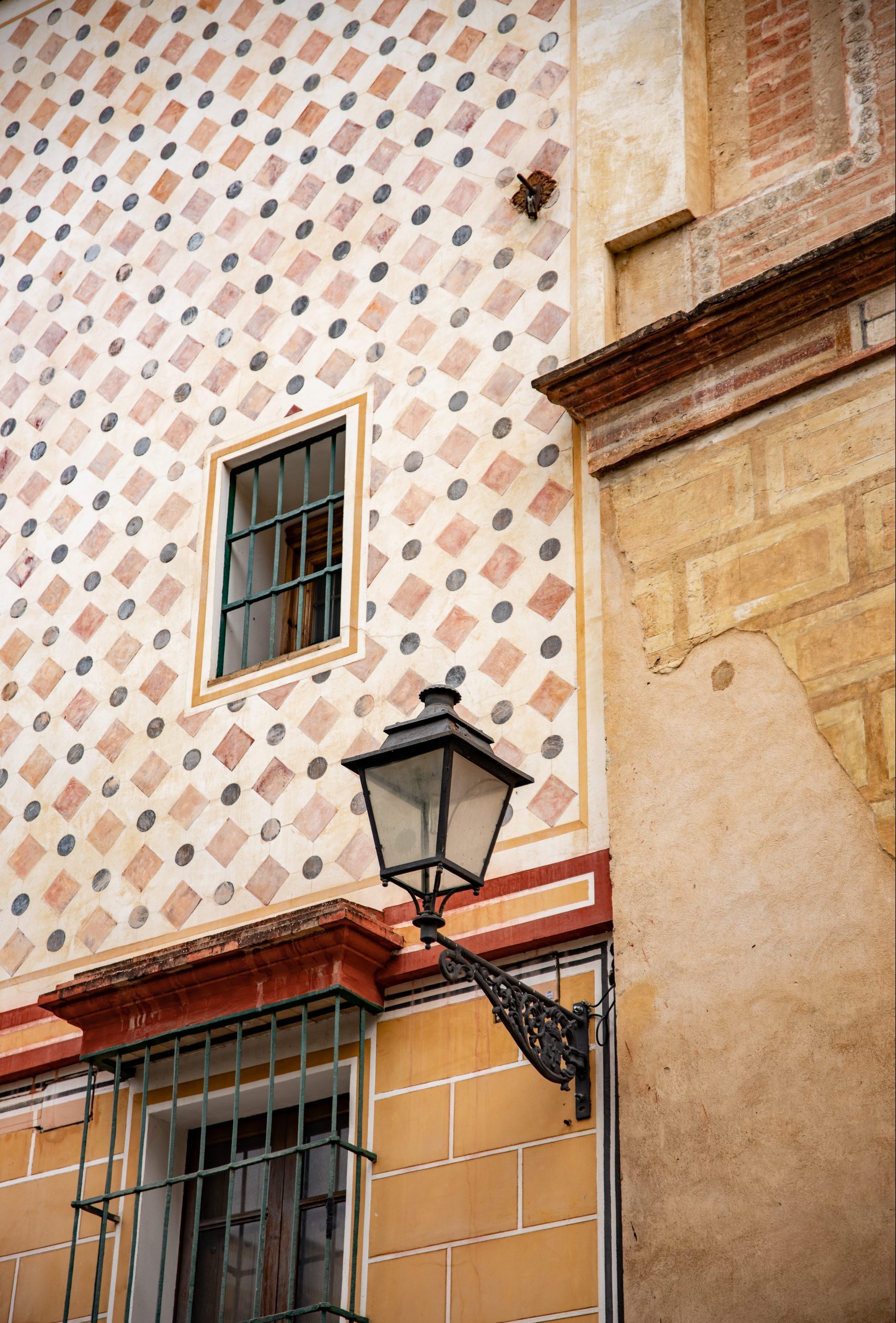
- À ne pas manquer dans le quartier Santa Cruz : la casa de Pilatos, l’une des meilleures pâtisseries de Séville « la Campana », l’église Santa Maria de la Blanca et bien entendu tous les emblématiques que vous trouverez ci-dessous.
3- Assister à un spectacle de flamenco
Si je devais retenir une seule expérience de ce séjour, ce serait le Flamenco sans hésitation. Cette danse puissante issue de rencontres et de métissages s’articule autour de trois grands piliers : la danse, le chant et la guitare. Tout ça dans une ambiance intimiste et une atmosphère hors du commun. Une expérience unique à vivre, à la découverte du symbole de l’Espagne. Comme on dit si bien, on ne peut pas dire qu’on a vu Séville sans regarder un spectacle de flamenco.
- Où voir du Flamenco à Séville ? Il existe de nombreux lieux à Séville où l’on peut découvrir le Flamenco. Mais attention aux attrapes-touristes. Demandez conseil avant toute réservation. Nous avons choisi « la Casa du Flamenco ». La réservation est plus que conseillée, vous pouvez réserver directement sur leur site internet ici : la casa du Flamenco . Je n’ai aucun point de comparaison, mais le spectacle était de qualité sans enceinte, ni horde de touristes. Si vous avez de chouettes adresses à partager, n’hésitez pas à les laisser via les commentaire :).
- Attention après un spectacle de Flamenco, vous aurez envie de tout quitter pour vivre votre meilleure vie en tant que danseu(r)use de Flamenco.
4- Flâner sur la place d’Espagne et le Parc de María Luisa
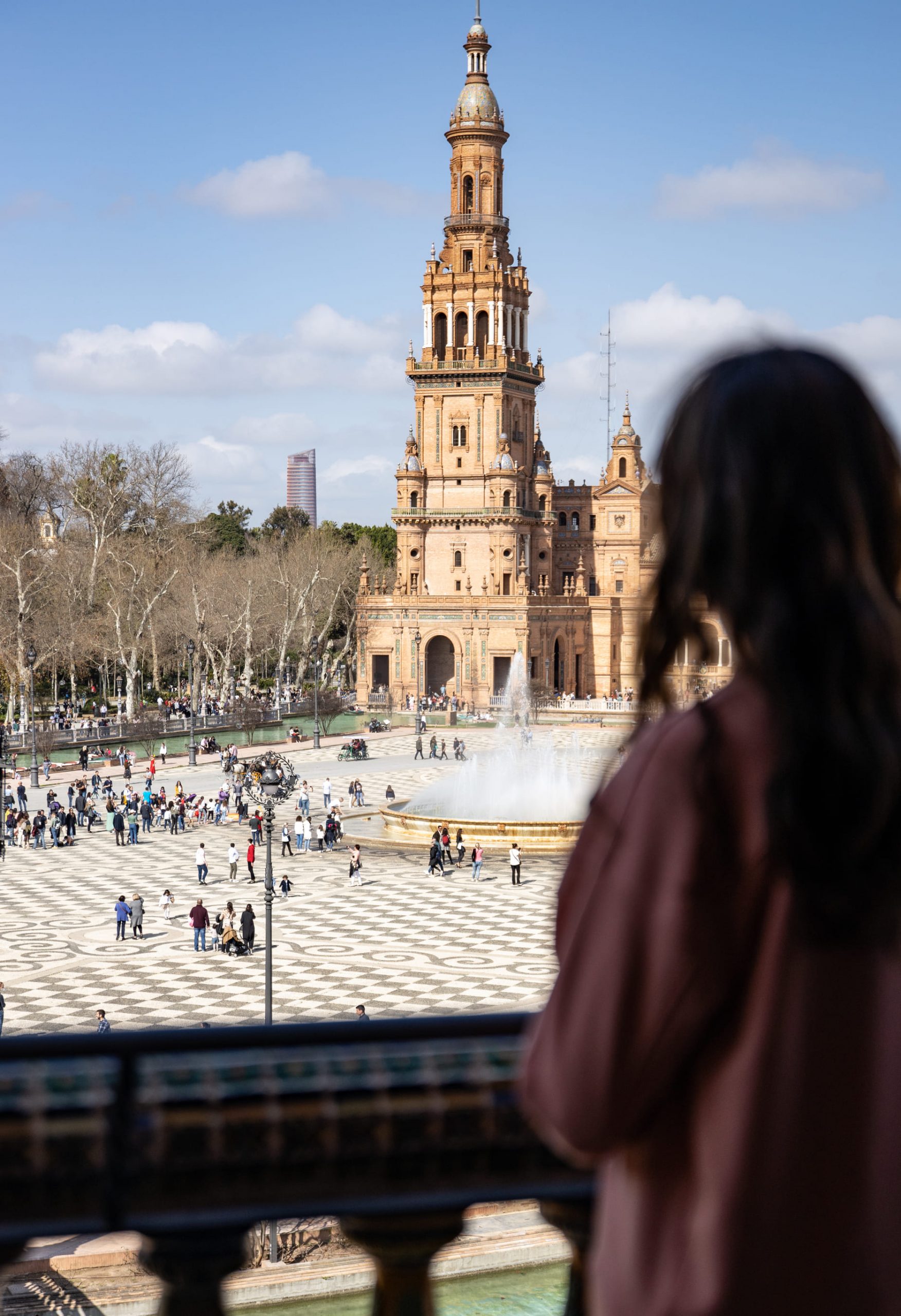
La Place d’Espagne fait partie des plus belles places que j’ai vu au monde. C’est un spectacle à elle toute seule, de couleurs, de lumières et de convivialité. Une symphonie visuelle située au sein du Parc de María Luisa, l’un des plus beaux parcs du monde. Cette place qui a vu naître 1001 histoires s’étale sur 50 000 m2 et s’impose comme étant l’une des places les plus impressionnantes d’Espagne.
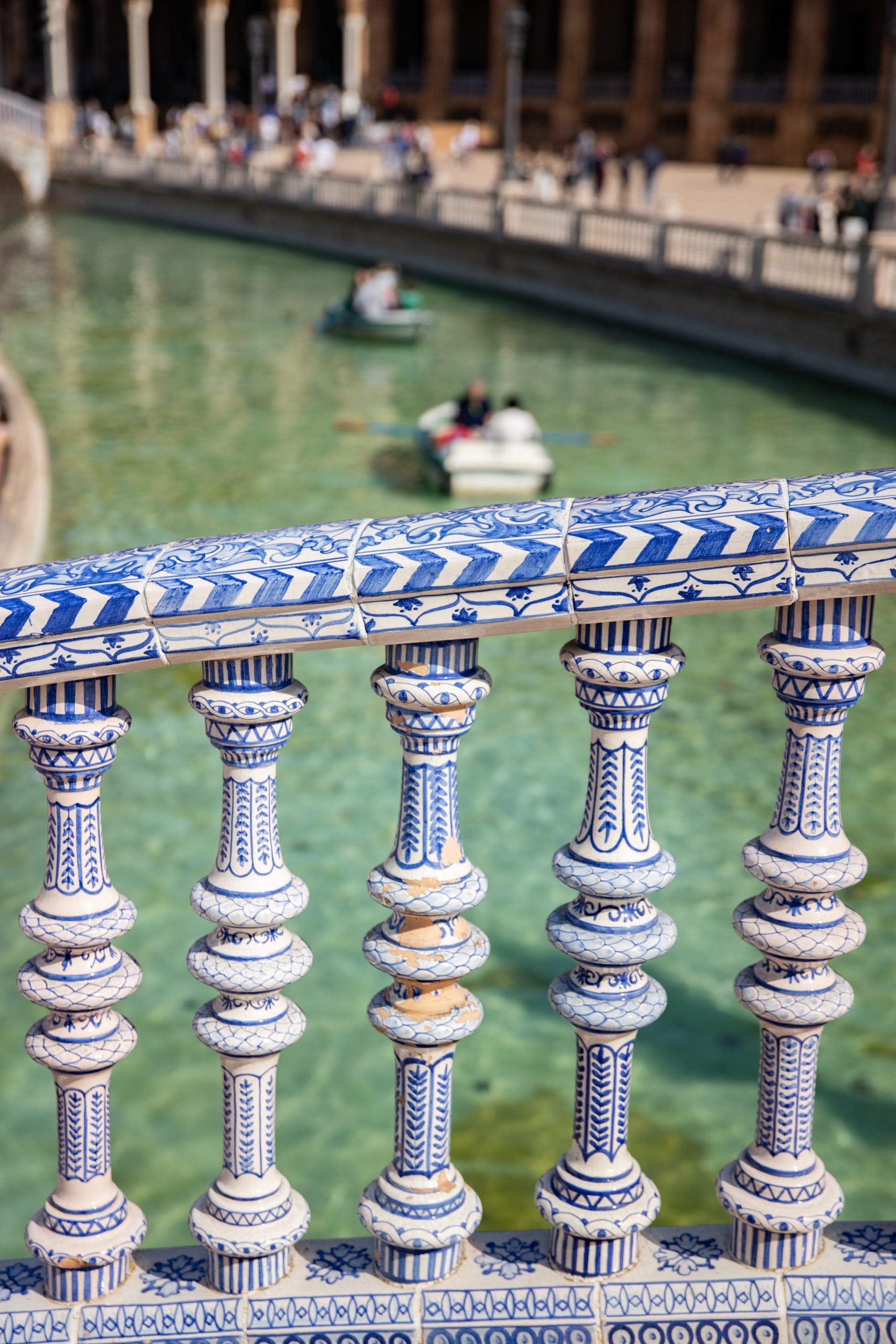
La place d’Espagne c’est aussi une architecture saisissante composée de marbre, de brique, de fer forgé et de céramique. Un canal de 515 mètres de long fait également partie intégrante du décor. Vous pouvez le traverser en barque, une expérience assez touristique qui ne m’a pas trop emballée, mais l’idée faire de la barque sur une des plus belles places du monde, ça ne court pas tous les jours au portillon.
- Accolée à la place d’Espagne, on découvre le Parc de Maria Luisa . Ces jardins ont été rénovés par un ingénieur français qui s’est inspiré des jardins du Généralife, de l’Alhambra et de l’Alcazar de Séville.
- Le petit détail qui fait la différence : Il a fallut 15 années pour construire cette place dont plus de 1000 ouvriers par jour.
5- Prendre de la hauteur pour découvrir Séville sous toutes ces coutures
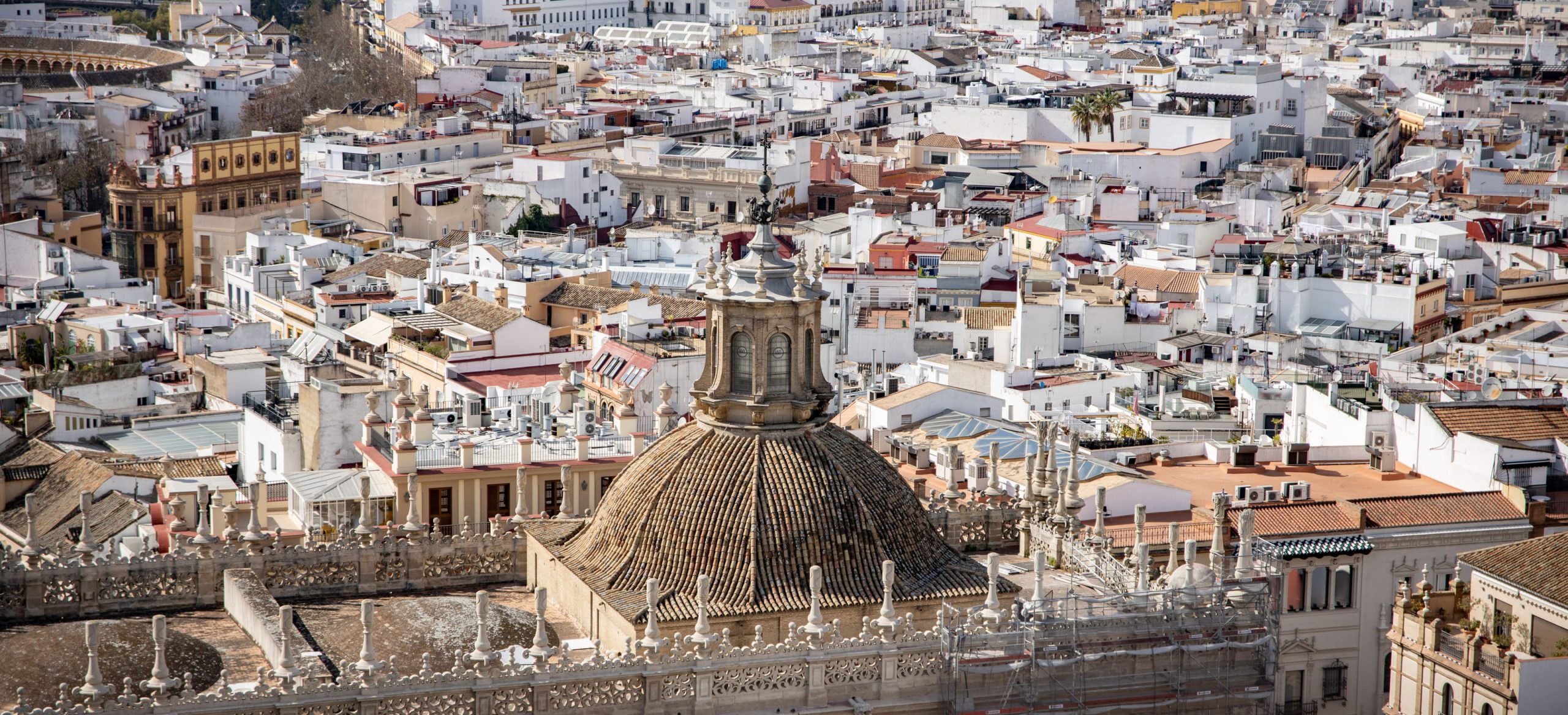
Visiter Séville, c’est aussi prendre de la hauteur pour observer la ville tels des oiseaux. C’est mon activité favorite quand je visite une ville, il faut impérativement que je passe par la case « panorama à décoller la rétine ». Voici les trois lieux incontournables à ne pas rater lors de votre week-end.
Le Metropol Parasol, entre histoire et modernité
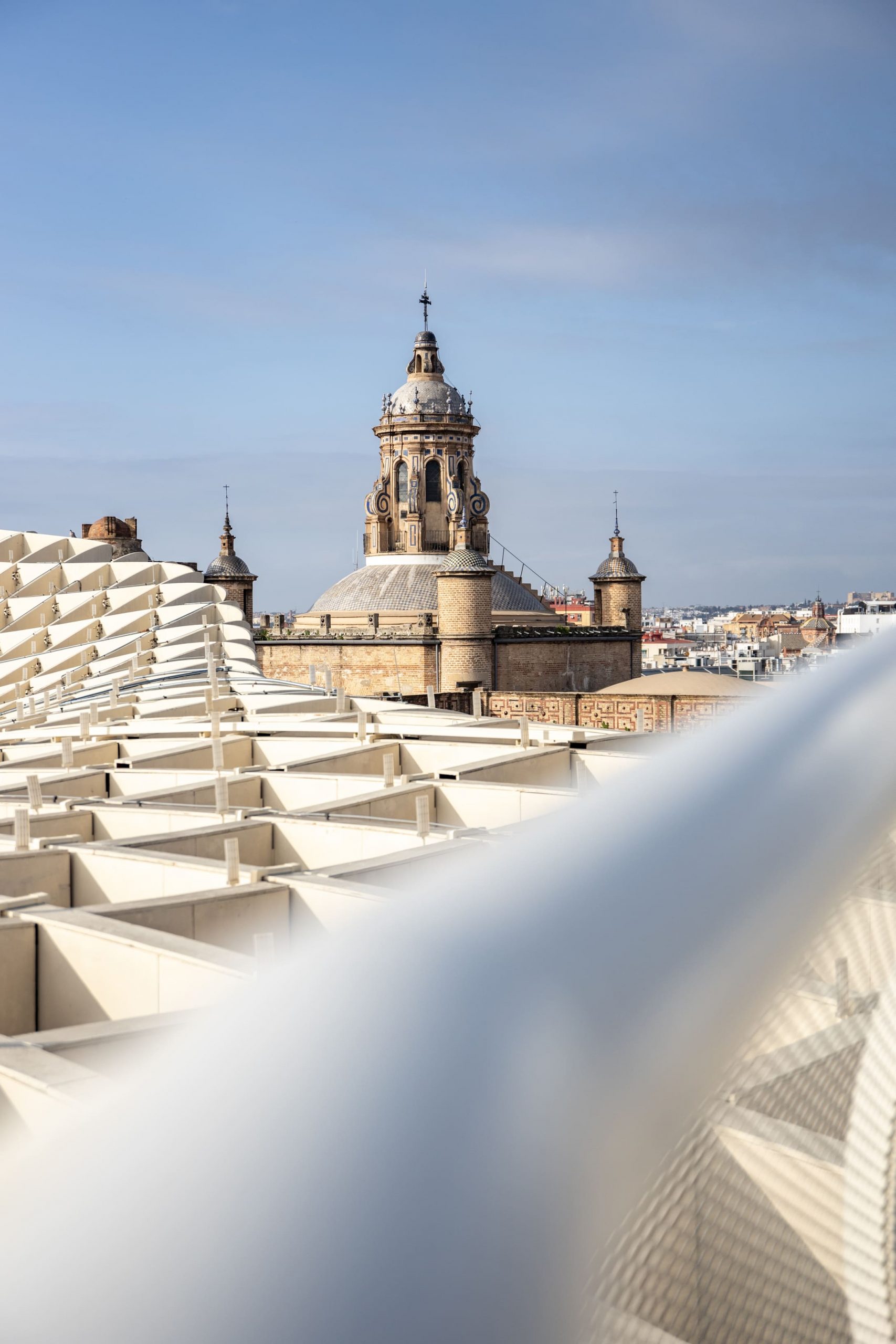
Pour profiter d’une vue exceptionnelle sur Séville, direction le Setas de Sevilla aussi appelé Métropol Parasol . C’est un bâtiment assez fou qui ressemble à la fois à un champignon géant ou à un immense parasol (tout dépend si vous avez l’estomac qui gargouille ou non). Un parcours de passerelles sur ses hauteurs vous permet de profiter d’un point de vue 360º.
- Bon à savoir pour les fans de photographie : Il est ouvert de 09h30 le matin jusqu’à environ minuit le soir ce qui permet de contempler Séville au coucher du soleil ou même de nuit.
- Pour ceux qui apprécient l’histoire : le Métropol parasol abrite l’antiquarium, l’espace le plus important de l’époque romaine à Séville.
La tour Giralda (et sa cathédrale)
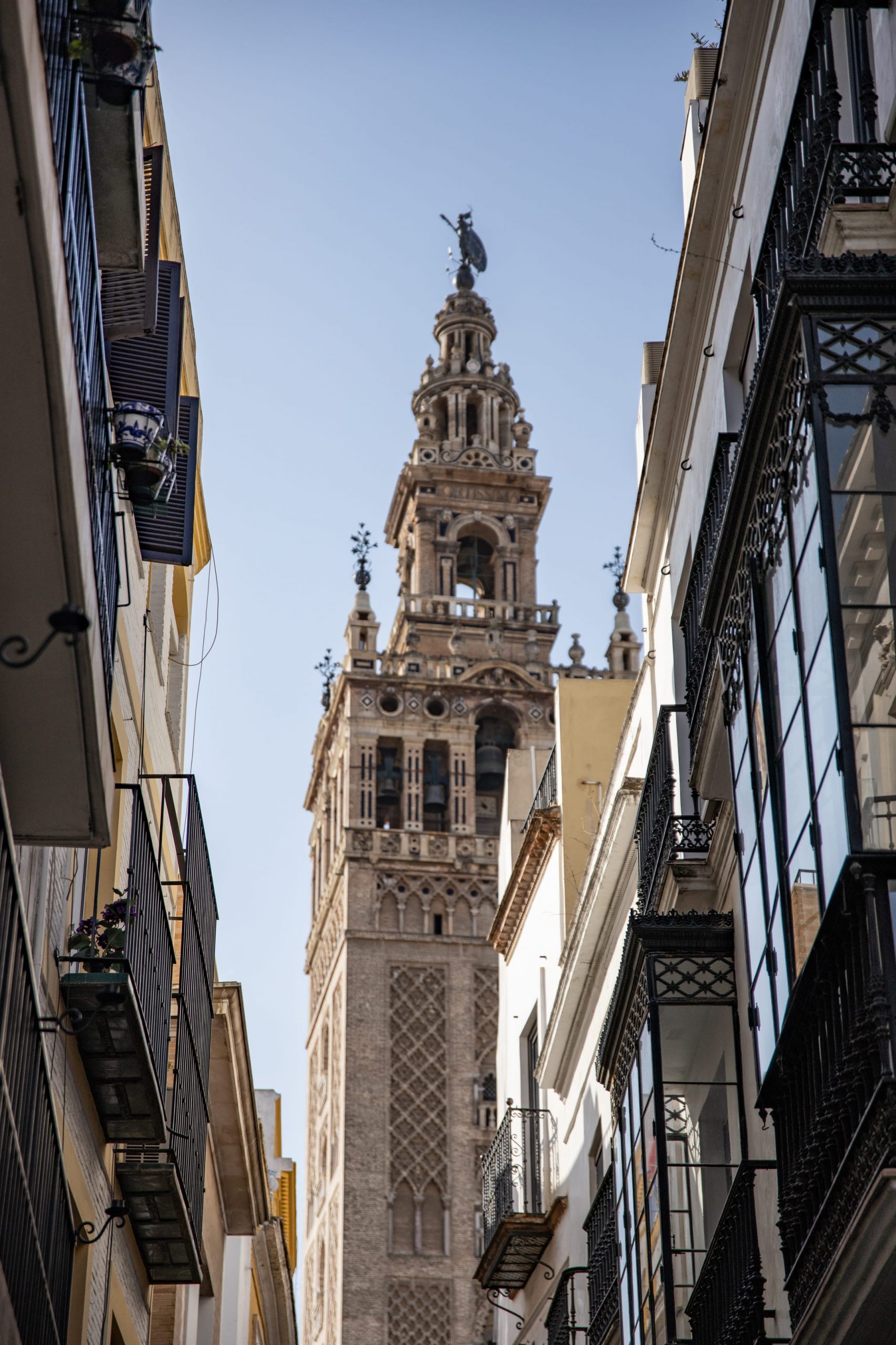
S’il y a bien un monument à ne pas rater, c’est la Tour Giralda. Tout comme ses frères l’Archivo de Indias, la cathédrale et le Réal Alcazar, elle est inscrite au Patrimoine de l’Humanité par l’UNESCO . La Giralda de Séville a été pendant longtemps la construction la plus haute au monde. Depuis son sommet, vous pourrez contempler une vue sur toute la ville, et à ses pieds, la Cour des Orangers et la plus grande cathédrale gothique du monde . (C’est moi où j’ai répété le mot « monde » 106 fois dans l’article ?)
Depuis le Pont Elisabeth II qui mène au quartier de Triana
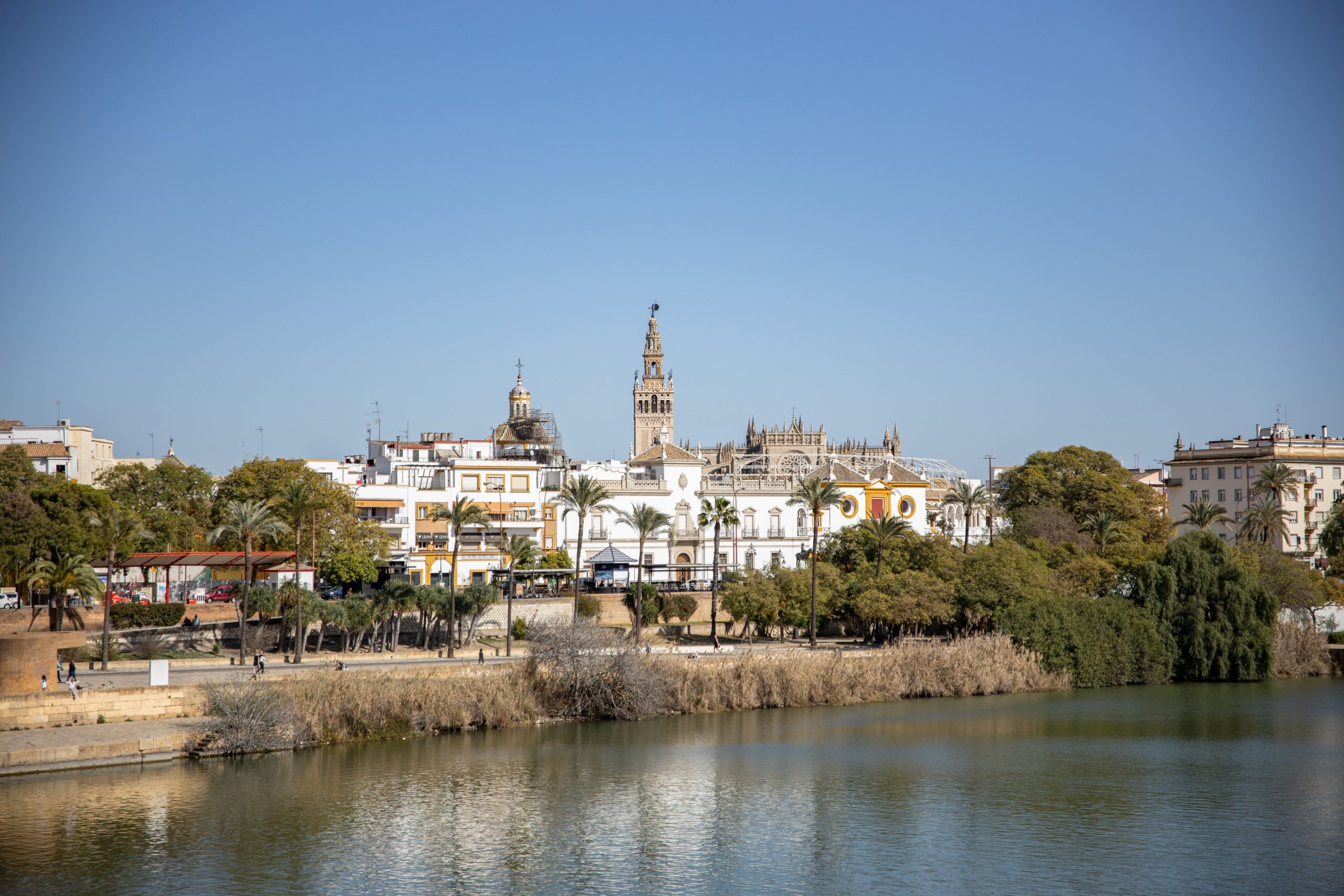
Le Pont Elisabeth II c’est un peu la carte postale de Séville où l’on profite d’une vue à couper le souffle, mais aussi de la douceur des berges du Guadalquivir, le seul fleuve navigable d’Espagne. Un long fleuve qui collectionne de grandes histoires et traversées.
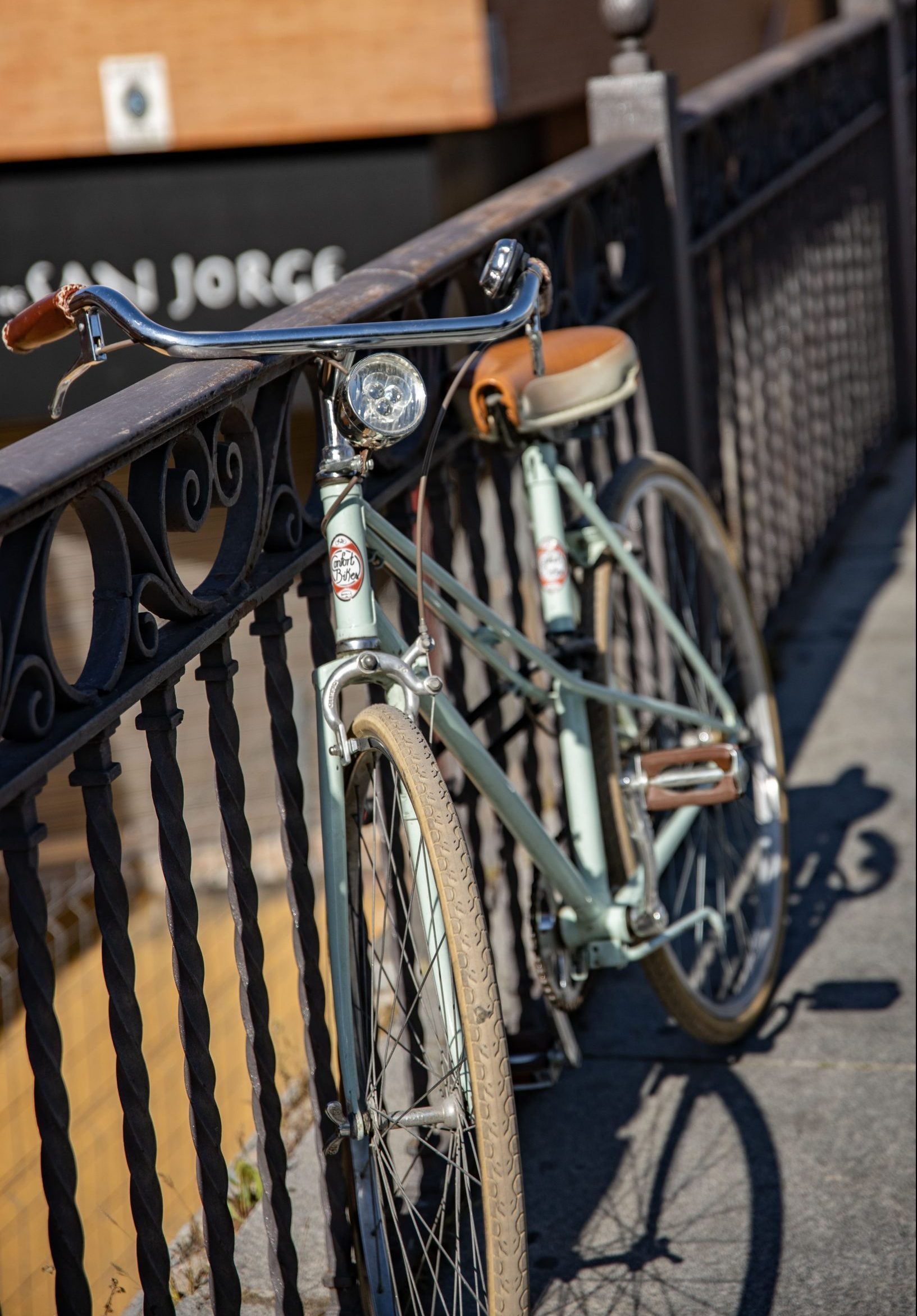
- Le pont Elisabeth II permet de rejoindre le quartier de Triana.
- Il est possible de découvrir Séville en bateau mouche . Nous n’avons pas fait cette activité, mais l’idée est à garder dans un coin de sa tête si vous avez du temps devant vous.
- À ne pas manquer sur les bords du fleuve : la tour de l’Or (la Torre del Oro) qui fait partie intégrante de l’histoire de la ville.
6- Visiter Séville, c’est manger des tapas, pardi !
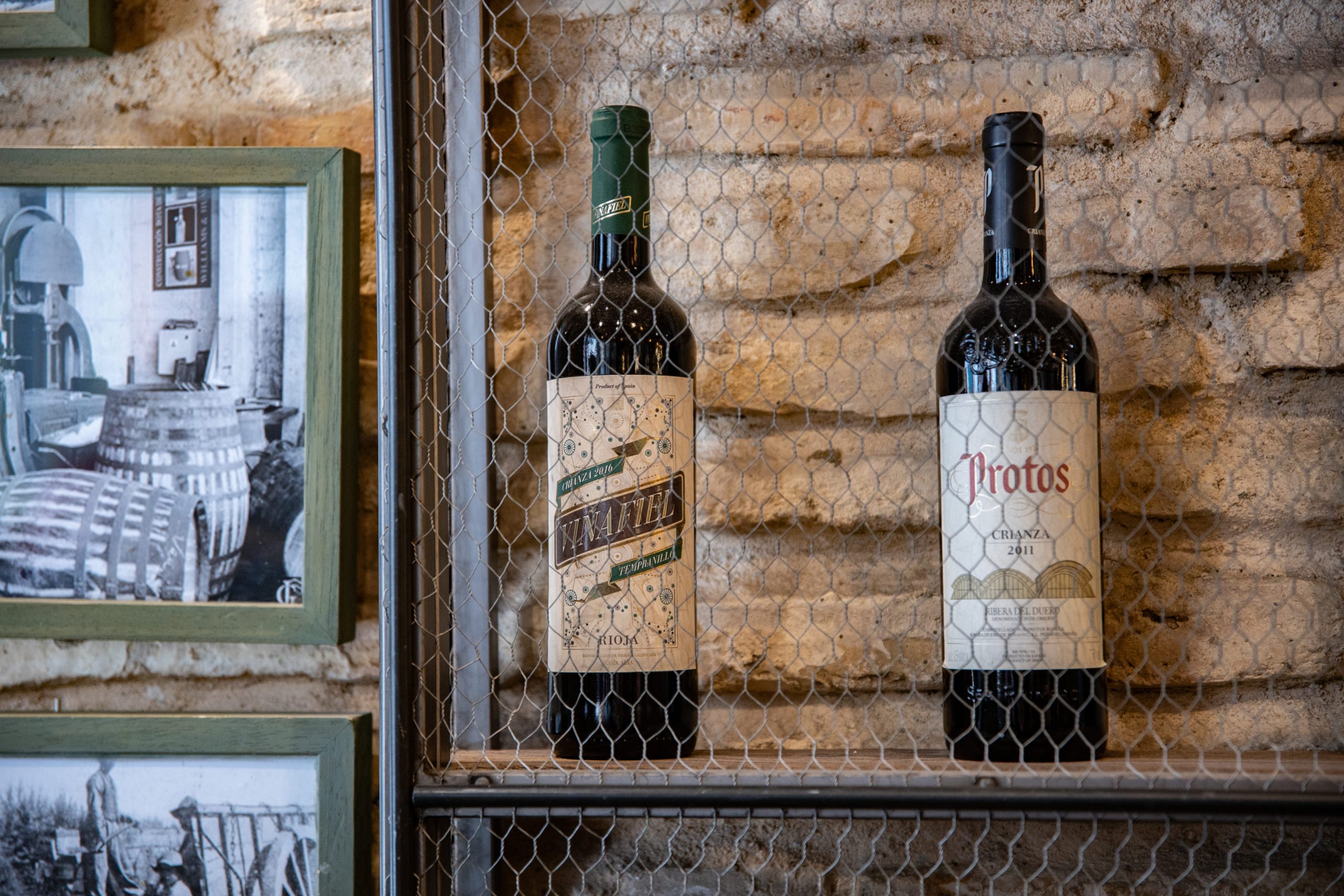
Enfin je parle de choses sérieuses, il était temps, je commençais à vous perdre en chemin. Pour les fans de tapas, voici mes bonnes adresses du séjour, mais entre vous et moi, sachez qu’à Séville il est difficile de mal tomber, il y a des bonnes adresses à chaque coin de rue.
Quelques bonnes adresses à ne pas manquer à Séville :
- Jaleo au mercado de feria dans le quartier Alameda. C’est mon coup de coeur du séjour, j’ai adoré cet endroit convivial et gourmand. Une immersion dans la vie locale tant au niveau de l’ambiance que des saveurs.
- El passaje tapas . C’est un restaurant très prisé, n’y allez pas trop tard si vous souhaitez avoir une table. Force de persévérance, nous avons réussi à y manger le dernier soir. Et nous n’avons pas été déçu du voyage ! Cette adresse est divine et les saveurs au rendez-vous.
- Pelayo à deux pas de la cathédrale. Ce que j’ai apprécié : les tapas et l’ambiance conviviale. Ce que j’ai moins apprécié : l’emplacement assez touristique et la carte bien trop généreuse à mon gout. Cela reste quand même une valeur sûre.
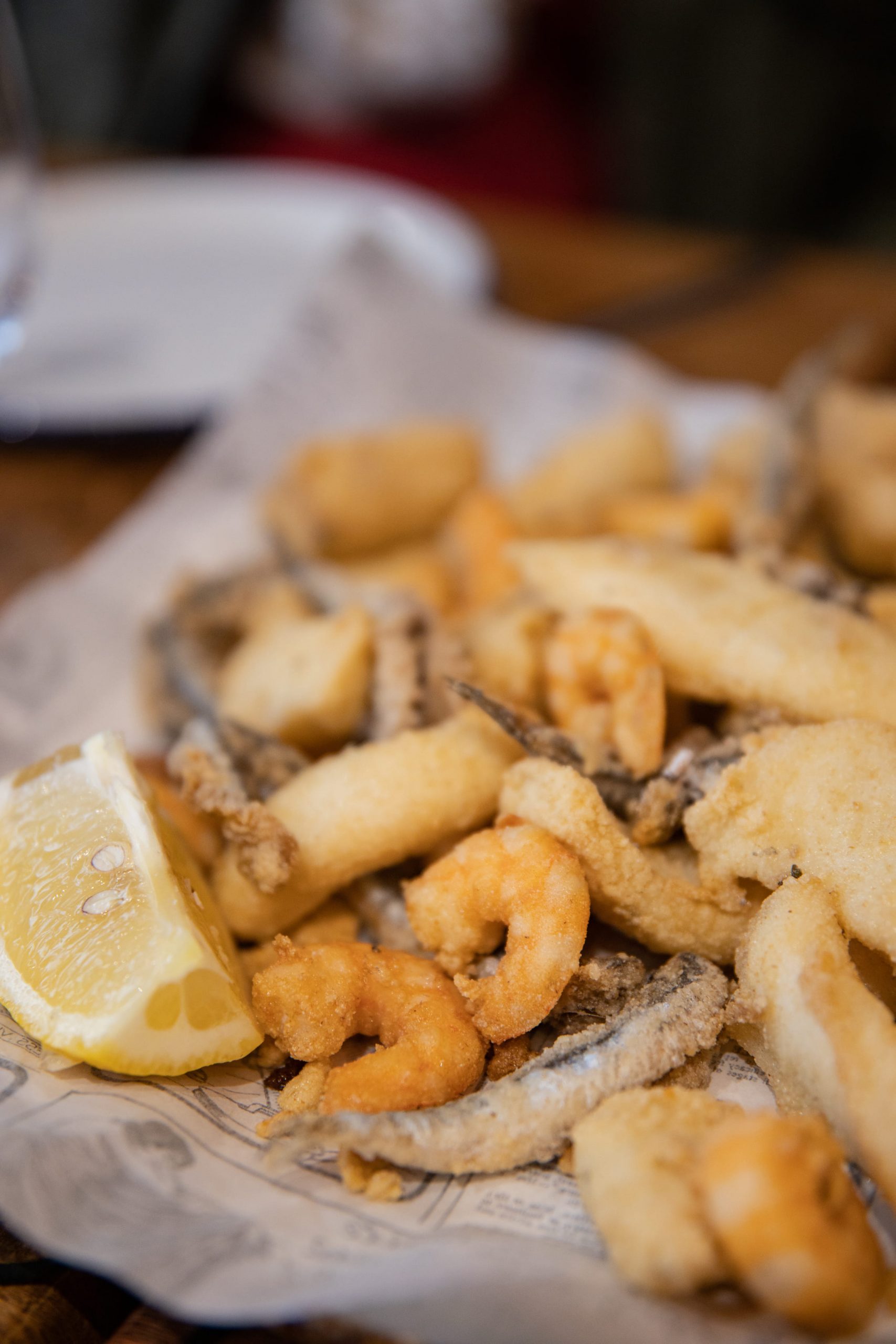
- La Bartola . Ce petit restaurant se situe entre la casa de Pilatos et le Réal Alcazar. J’adore la déco, l’ambiance et les tapas revisités façon Bartola :p. Petit plus : il y a pas mal de choix veggie en terme de tapas, et ça c’est chouette !
- Les spécialités qu’il faut tester absolument : le gazpacho andalou, la soupe froide de tomate (salmorejo) et le jambon bien entendu un met très apprécié ici ainsi que les vins d’Andalousie.
7- Visiter l’Alcazar, le Palais Royal de Séville
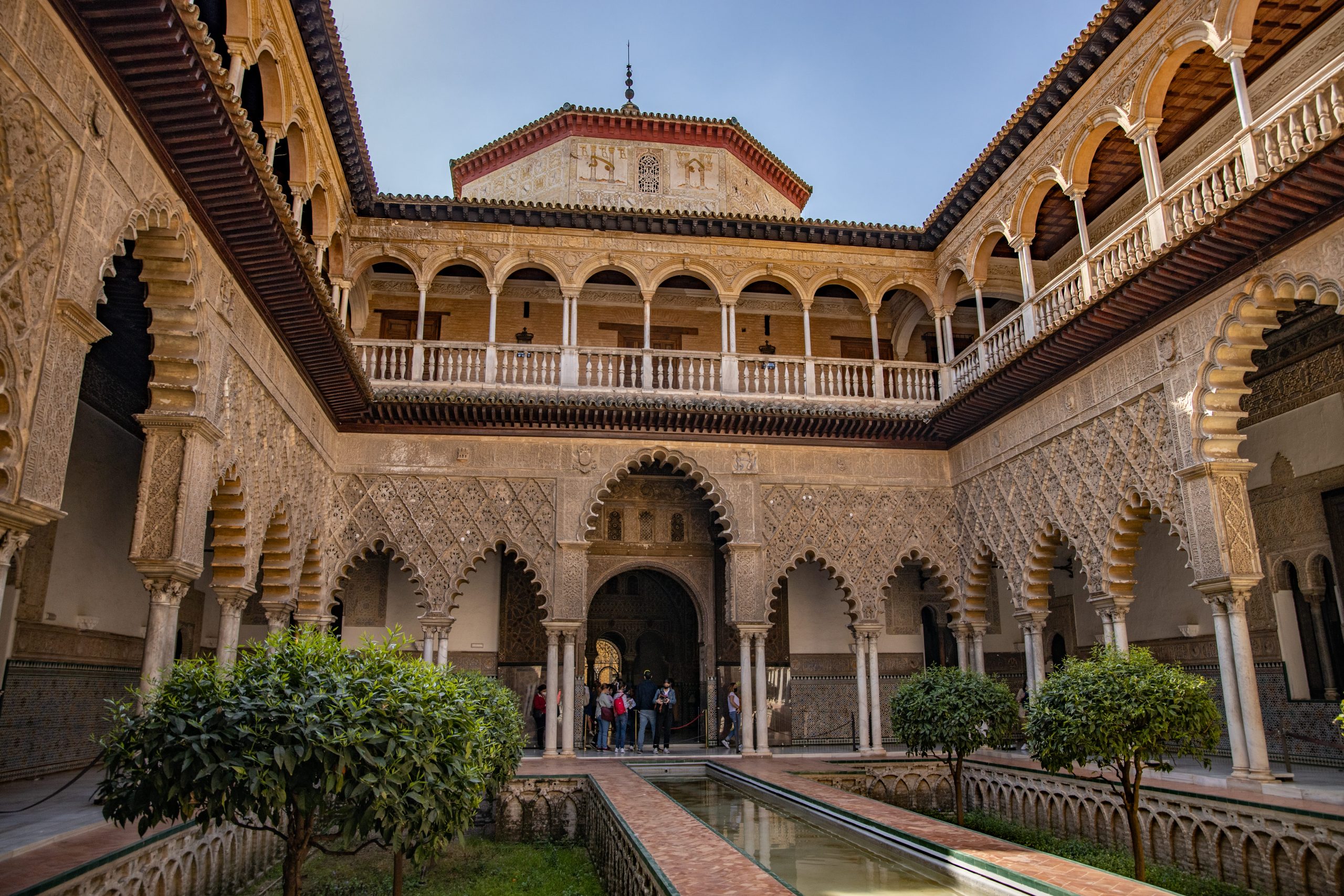
Votre attention s’il vous plait. Lâchez votre bol de pipas, arrêtez de respirer, éteignez votre téléphone, fermez toutes les fenêtres de votre navigateur et concentrez-vous sur ce lieu abracadabrant tant au niveau historique qu’architectural. On parle d’un lieu qui était utilisé comme logement pour les rois et les hautes personnalités d’Espagne et qui a servi de décor pour de nombreux films tels que Games of Thrones ou encore Kingdom of Heaven. Ca y est j’ai capté votre attention ?
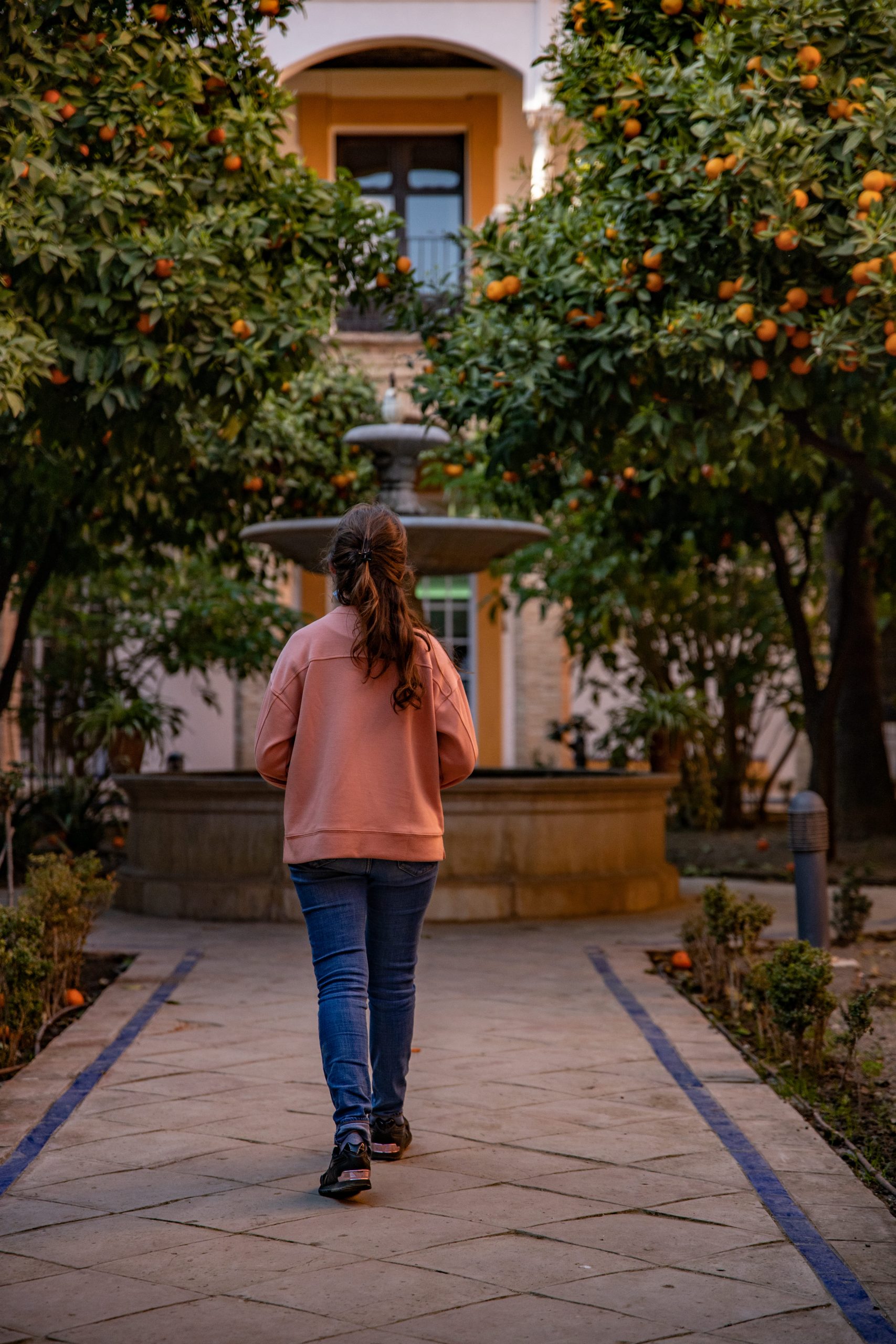
Alors continuons la visite de ce palais inscrit au patrimoine mondial de l’UNESCO. Il se compose de plusieurs bâtiments de différentes époques et de jardins idylliques aux allées jonchées d’orangers, de paons, de palmiers, de fontaines et de kikis pavillons. Ces derniers ont commencé à être cultivés il y a plus de 1000 ans et contiennent plus de 20 000 plantes. Ce qui vous donne une idée de la beauté des lieux. L’intérieur de ce monument est tout aussi somptueux : petit coup de coeur pour l’immense coupole de la salle des ambassadeurs ainsi que la cour des demoiselles.
- Attention : l’Alcázar a une capacité maximale de 750 visiteurs par jour. À la haute saison, le temps d’attente peut être très long. Afin d’éviter les files d’attente, vous pouvez réserver vos billets en ligne. Attention, je vous déconseille de réserver vos billets via une plateforme, car nos billets ont été annulés deux heures avant. Passez uniquement par la billetterie officielle .
8- Visiter l’authentique quartier Triana
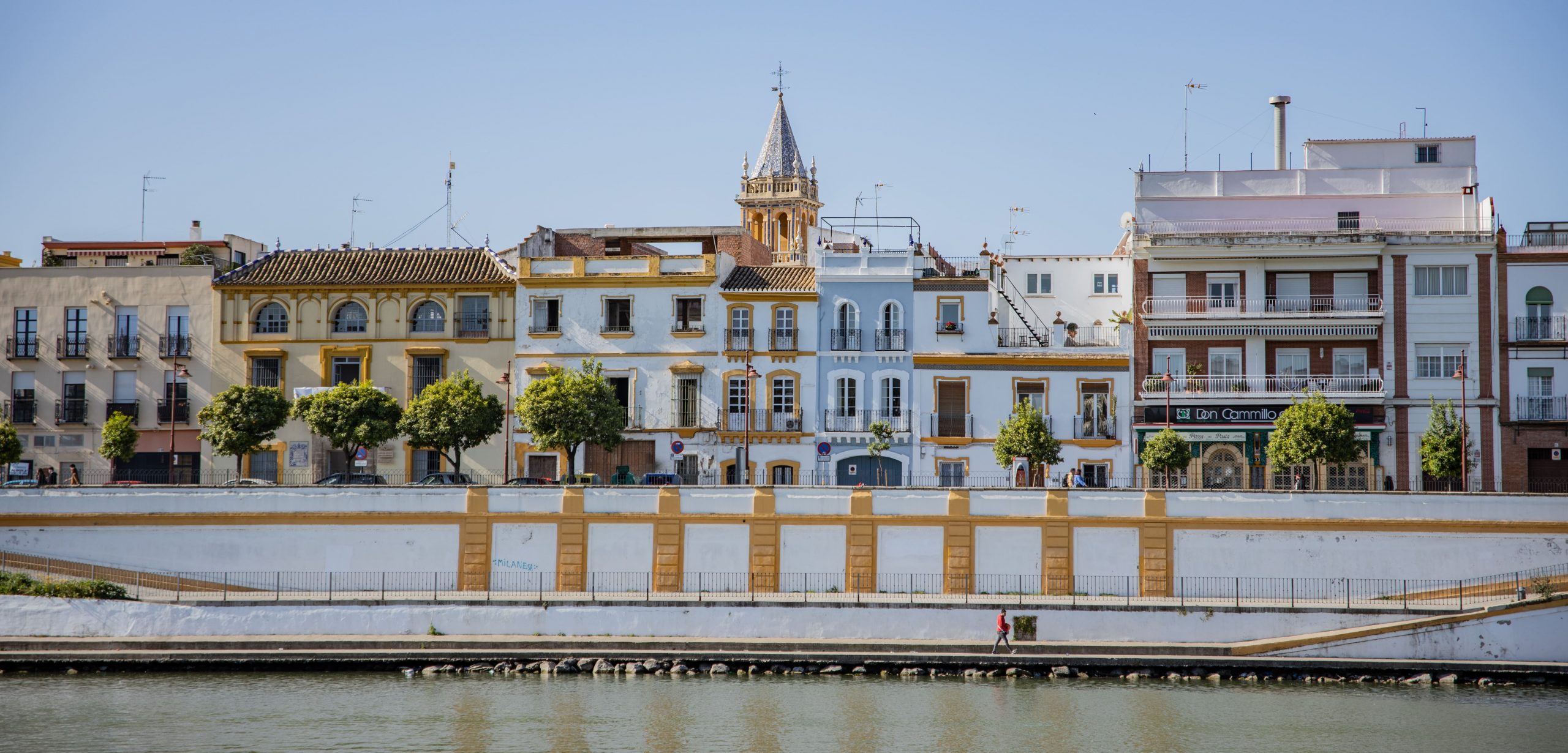
Le quartier Triana se situe de l’autre côté du fleuve Guadalquivir (toujours ce nom qu’on arrive pas à mémoriser). C’est un quartier populaire et peu touristique pourtant autrefois, c’était le quartier le plus important de Séville.
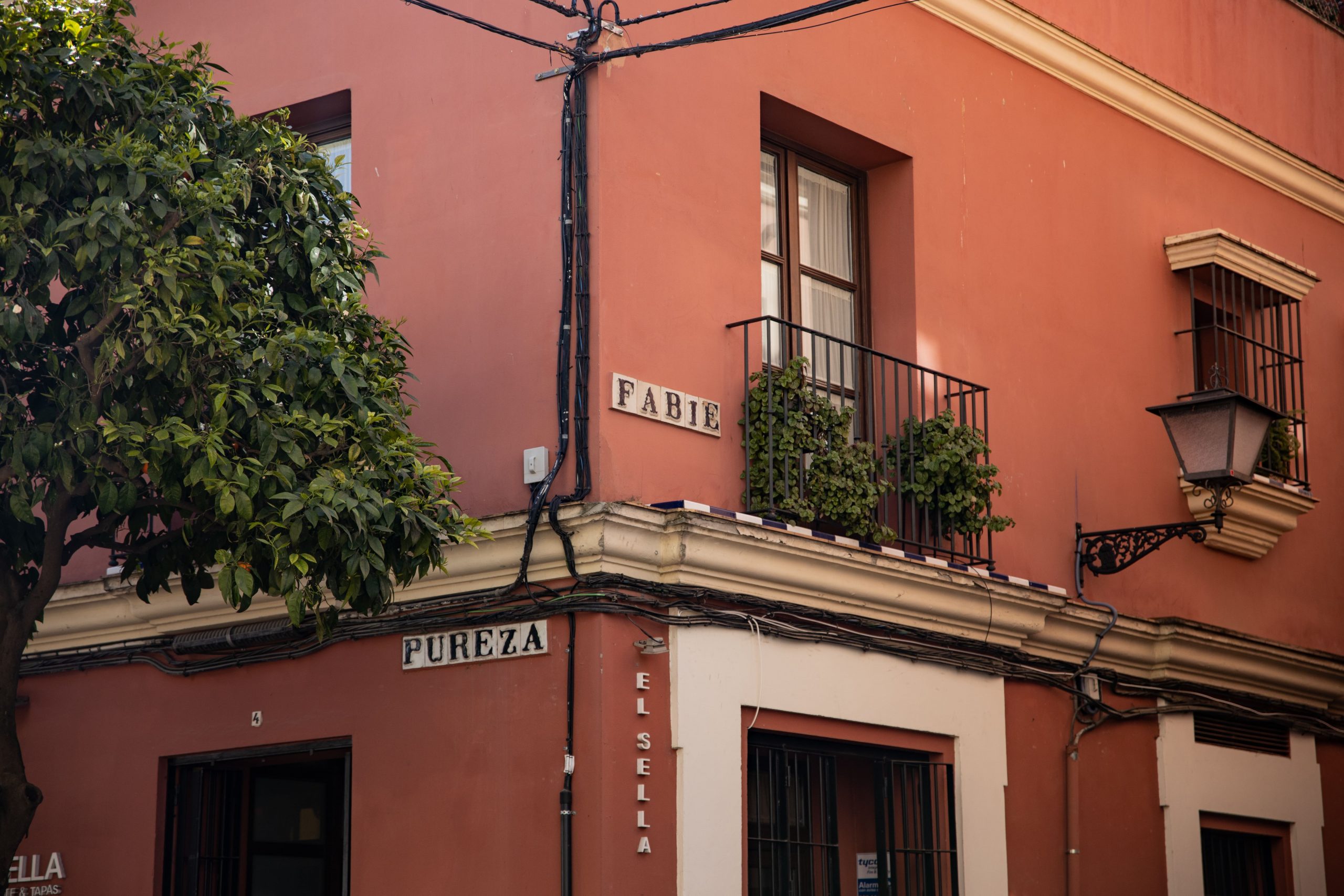
Triana fût longtemps le quartier des manufactures de céramiques, d’azulejos et de poterie . C’est ici que vous trouverez de nombreuses boutiques aux 1001 créations colorées et comme toujours des tapas à tous les coins de rues :p
- À ne pas manquer dans le quartier triana : les boutiques de céramique, la Chapelle des Marins et le mercado de Triana.
9- Visiter Séville, c’est aussi …
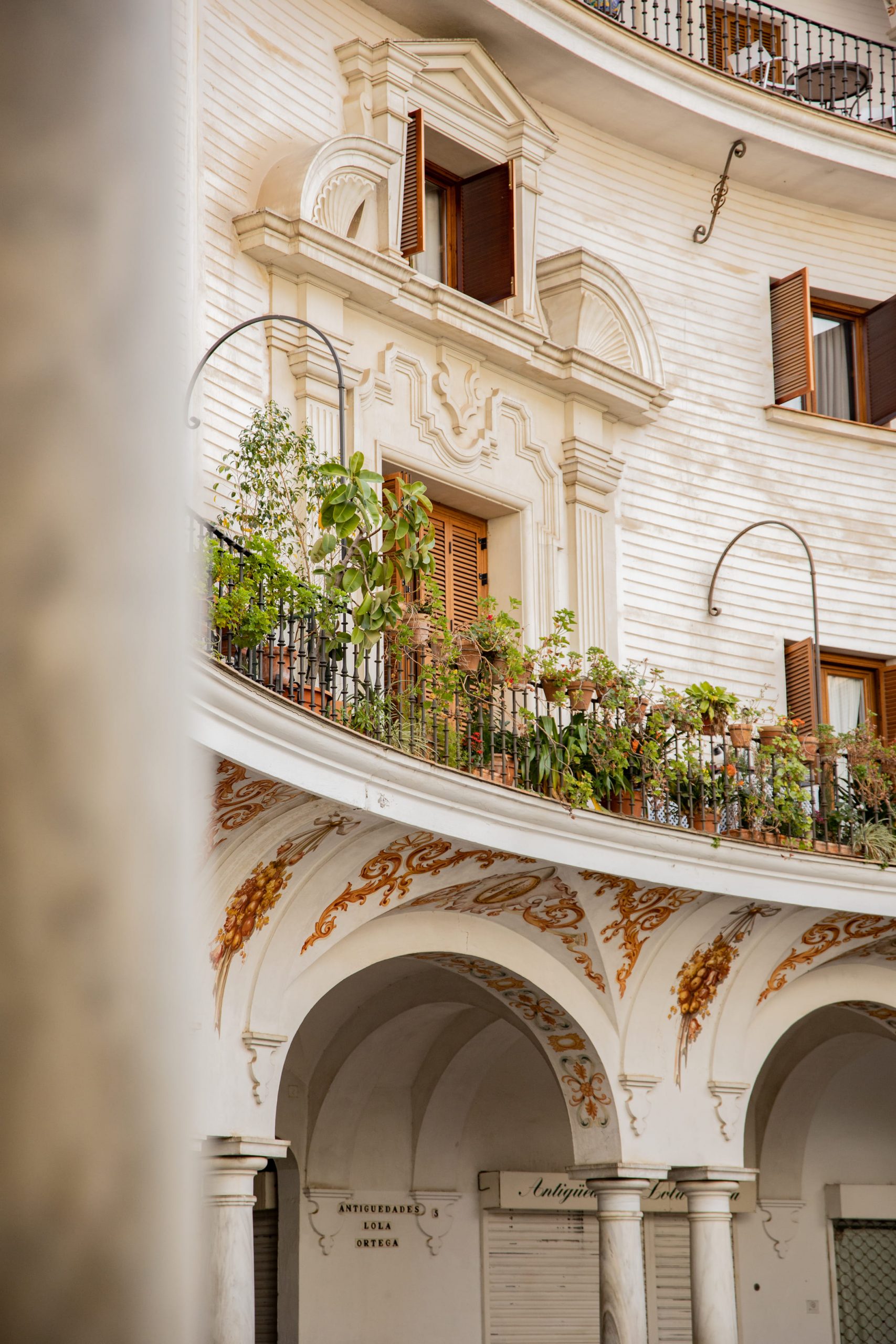
- De nombreuses places conviviales . Mes coups de coeur : la Plaza del Cabildo, la Plaza de San Francisco, la Plaza de America et la Plaza del Triunfo.
- La visite de nombreux musées. Pour les familles, je vous conseille le musée de l’illusion pour un moment de partage en famille. Le musée n’est pas très grand, mais ça permet de faire une pause, surtout si vos enfants en ont assez des monuments andalous :p. Pour les fans d’Art, ne manquez pas le musée des beaux arts qui est sublime.
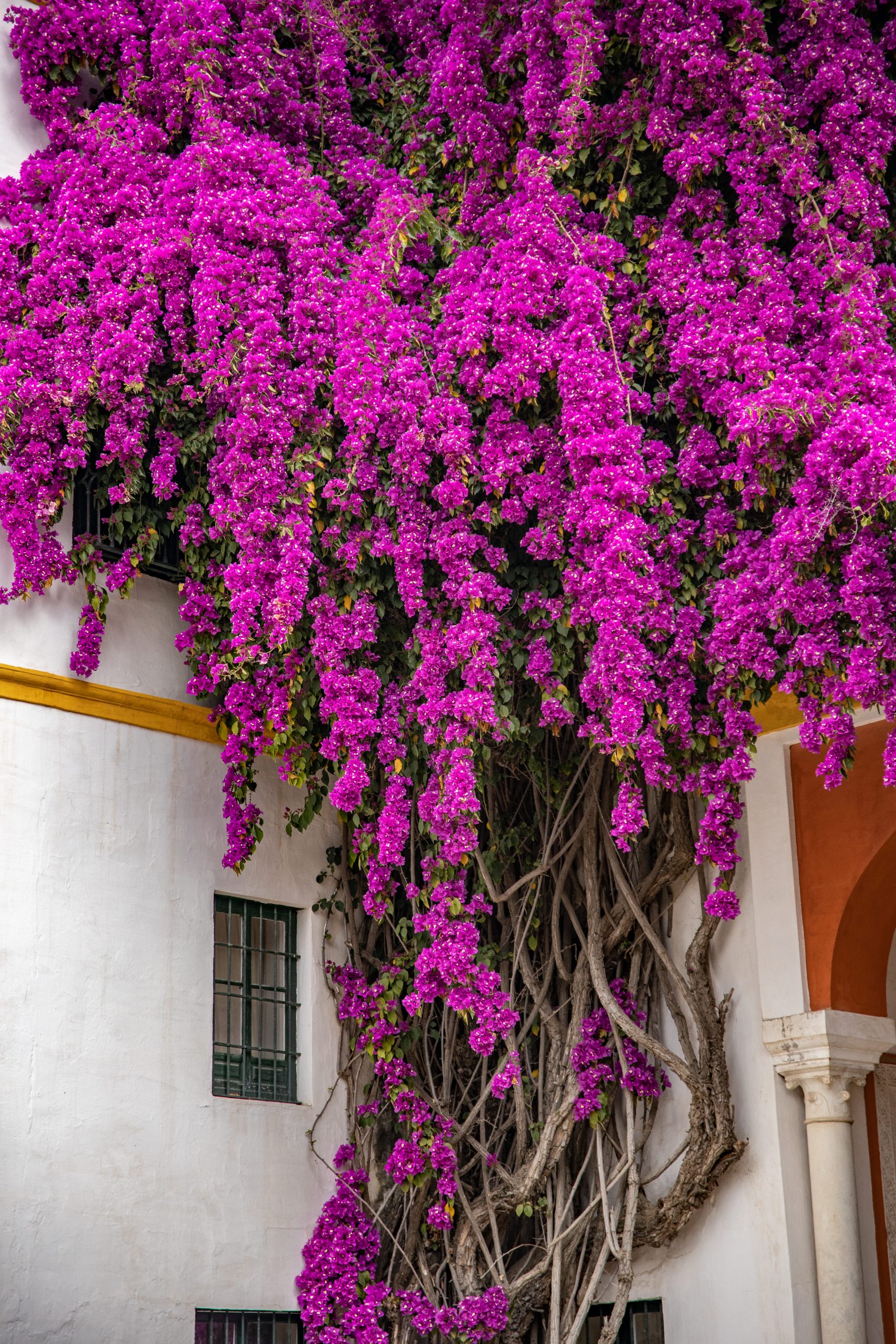
- La basilique de la Macarena qui abrite l’une des icônes religieuses les plus vénérées de Séville.
- Des spectacles de rues. Séville c’est tous les jours des spectacles haut en couleur où la danse, la musique et les prouesses tiennent la vedette. Des moments qui rendent Séville plus vivante que jamais.
LES MOTS DE LA FIN
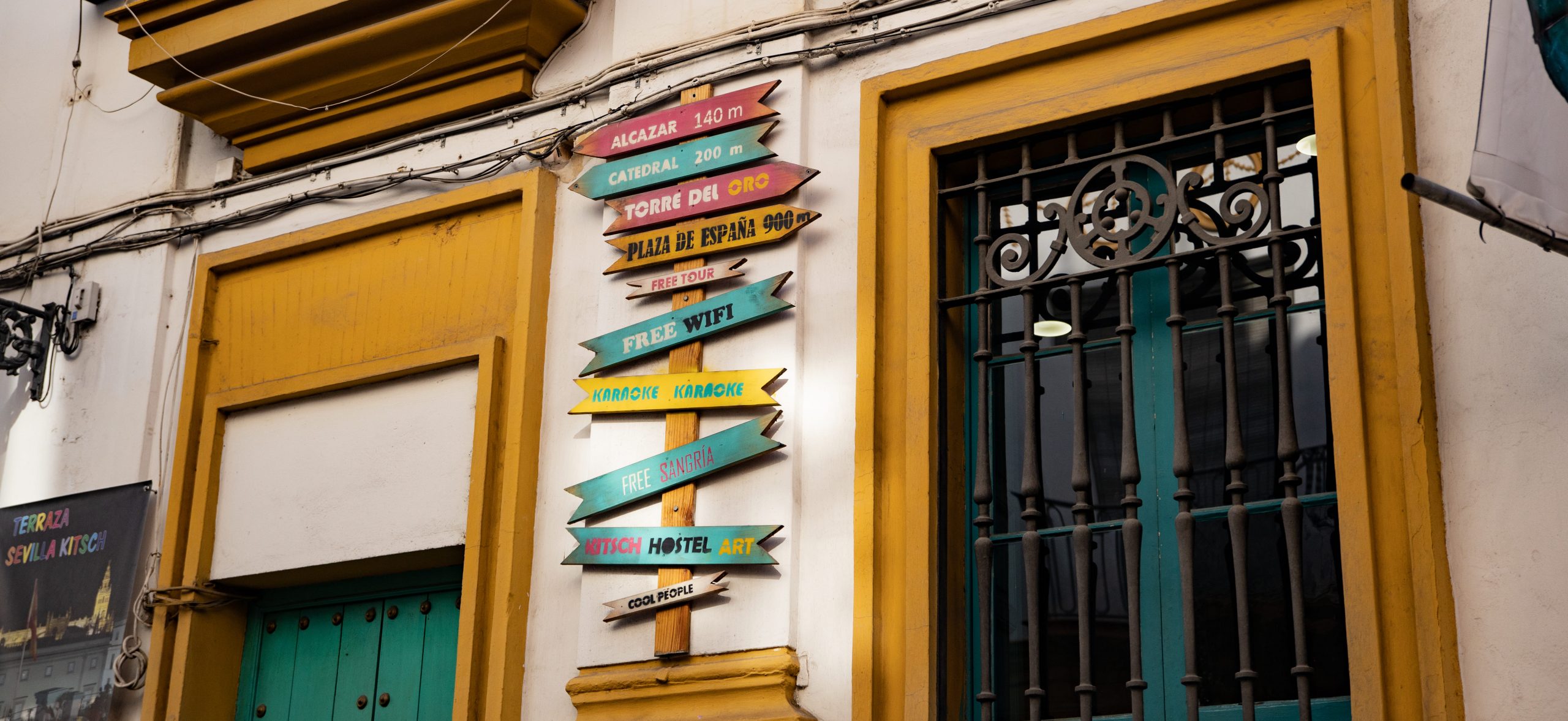
Séville et moi, c’est le début d’une grande histoire d’amour. Tellement passionnelle que je pourrai en faire une série Netflix romantique où les tapas se marieraient avec les danseurs de Flamenco (je vois déjà la scène). Mais en attendant de devenir une productrice de grande renommée, je vous souhaite de tout coeur de visiter Séville si ce n’est pas déjà chose faite. Vous en reviendrez charmer, j’en mets ma main à couper !
- À lire aussi : visiter la fascinante Saragosse .
- 3 commentaires
Commentaires
Trop bien cette petite virée à Séville ! Comme tu le sais, j’espère y retourner pour flâner un peu plus, car quand nous y étions il pleuvait, pleuvait… Souvenir du copain de ma sœur qui s’est fait entièrement tremper par une voiture qui a roulé dans une énorme flaque juste à côté de nous 😅 le bad ! Je me rends compte que ça fera 6 ans déjà, donc il est grand temps d’y retourner 😃 Tes adresses et conseils donnent envie… J’avais adoré l’Alcazar (qu’on avait visité juste avant de quitter la ville, car ce jour-là il faisait beau !), mais aussi la cathédrale, hyper impressionnante. Et c’est drôle car nous avons vu un spectacle de flamenco exactement au même endroit ! Une expérience qu’on a beaucoup aimé aussi !
Encore un superbe article ! Nous partons pour quelques jours à Seville la semaine prochaine, et ton blog est une vraie source d’inspiration ! Petite question, pour Alcazar tu as pris l’entrée simple ou avec la visite du cuarto real alto ? Merci 🙂
kikimagtravel
Merci beaucoup pour ce retour 🙂 Oui j’ai pris la visiter du Cuarto réal alto elle fait partie intégrante de la visite 🙂 a faire absolument ! Je te souhaite un très beau séjour, vous allez vous régaler !
Laissez votre kiki commentaire Annuler la réponse
Sauvergarder mes informations pour les prochains commentaires.
Nomadic Matt's Travel Site
Travel Better, Cheaper, Longer
Seville Travel Guide
Last Updated: January 5, 2024
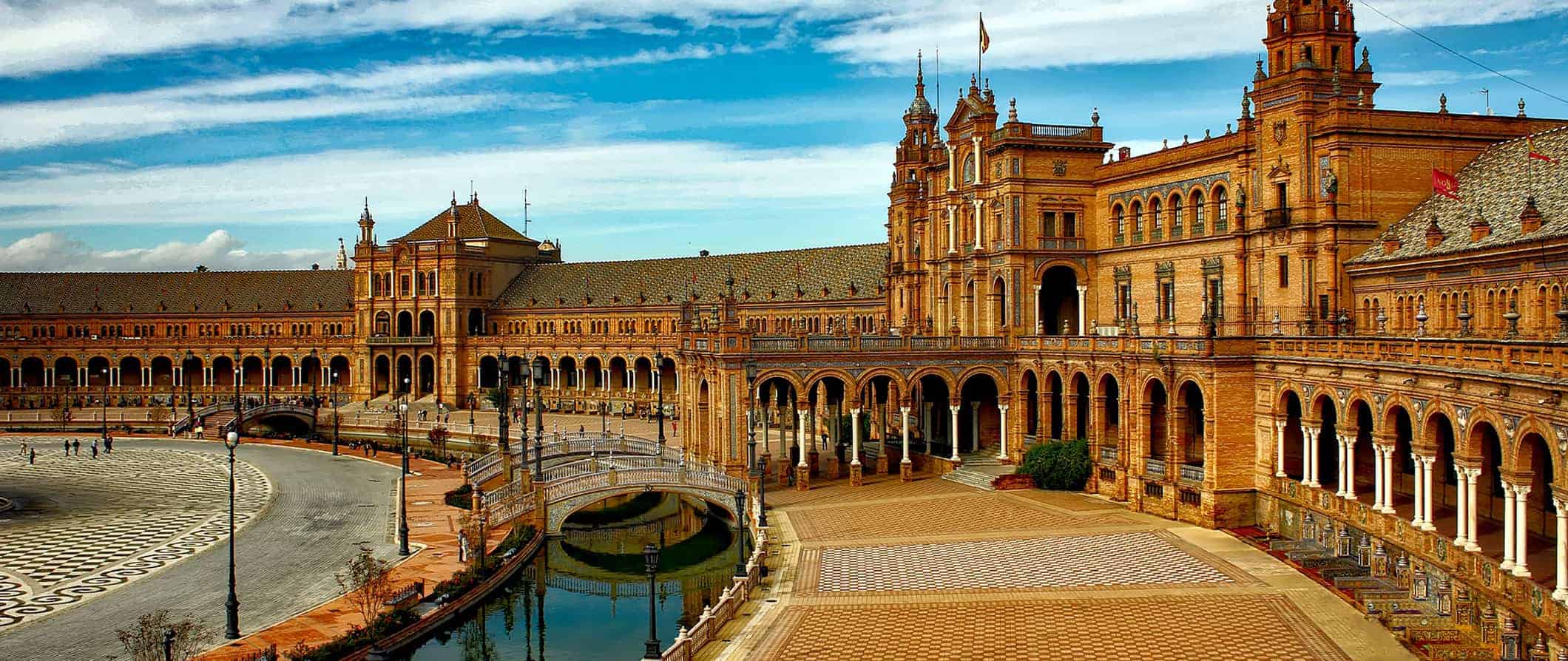
Originally founded as a Roman city, Seville came to prominence after the Islamic conquest in 711. Today, the city is known for its flamenco dancing (which originated in Andalucía), its beautiful architecture that blends Islamic and European styles, and its scorching summers.
Seville is a big university town and is extremely popular with people studying abroad, making it a more affordable destination than cities like Barcelona or Madrid (it’s not as crowded either).
This Seville travel guide will give you everything you need to know to eat well, save money, and see the best sights Seville has to offer!
Table of Contents
- Things to See and Do
- Typical Costs
- Suggested Budget
- Money-Saving Tips
- Where to Stay
- How to Get Around
- How to Stay Safe
- Best Places to Book Your Trip
- Related Blogs on Seville
Top 5 Things to See and Do in Seville

1. Tour Casa de Pilatos
Built in the 16th century, this beautiful Andalusian palace is a mix of Italian Renaissance and Spanish Mudejar styles. It houses a collection of 16th and 19th-century paintings, as well as a sculpture garden of Greek mythological figures. It’s also the permanent residence of the Dukes of Medinaceli (a hereditary title in Spain) and boasts the world’s largest collection of azulejo (a traditional glazed tile artwork). Numerous films have also been shot here, including Lawrence of Arabia, Kingdom of Heaven , and Knight and Day to name a few. Admission is 12 EUR.
2. Explore Parque de Maria Luisa
Located just in front of the iconic Plaza de España, this 100-acre public park offers the opportunity to browse gardens, patios, and sculptures. The park is Seville’s main greenspace and is situated near the Guadalquivir River. Created in 1911, it’s a relaxing place to lounge, picnic, and people watch. Don’t miss the monument to Miguel de Cervantes, who wrote Don Quixote (the monument used to include statues of Don Quixote on his horse and Sancho Panza on his donkey but they have since disappeared).
3. Visit the Royal Alcázar
The Royal Alcázar of Seville (also known as al-Qasr al-Muriq) is the oldest residential palace in Europe still in use today. Dating to the 14th century, it’s an important example of Moorish architecture. There are giant galleries, ornate rooms, and beautiful gardens. The palace was built for the Christian king Peter of Castile atop a Muslim fort after Christian armies reconquered the city in 1248. It’s also a UNESCO World Heritage Site. General admission is 14.50 EUR. Free admission is available on Monday afternoons/evenings. Check the website for specific times.

4. Walk through the historic Jewish Quarter
Seville’s Jewish Quarter is filled with small winding streets and is generally regarded as the most charming part of the city. The area gets pretty crowded but there are numerous small alleys and streets to explore where you can escape the crowds. Don’t miss this part of town.
5. Take a food tour
To learn more about the history and culture behind Seville’s cuisine, take a food tour. It’s the best way to eat your way around the city sampling the best eats Seville has to offer while learning what makes the cuisine unique. Devour Tours runs in-depth food tours led by expert local guides that will introduce you to the food culture and its history. If you’re a foodie like me who wants to learn more about the history and culture behind each dish, this tour is for you! Tours start at 89 EUR.
Other Things to See and Do in Seville
1. visit the catedral of sevilla.
This Roman Catholic cathedral dominates much of Seville’s skyline. Surrounded by Andalusian orange trees, the Cathedral (also known as the Cathedral of Saint Mary of the Sea) is one of Seville’s top tourist attractions. Lines can get long, partially because hours are limited around church services, so get there early. While you can just admire the stunning design and stained glass from outside, the Cathedral is where Christopher Columbus is buried, so it’s worth going inside. The bell tower also offers a panoramic view of the city. Admission is 11 EUR if you purchase online and 12 EUR in person. The audio guide costs 5 EUR (4 EUR if you use the app).
2. Check out Plaza de España
One of Seville’s most picturesque spots, Plaza de España was built at the northern edge of the Parque de María Luísa in the 1920s for the Ibero-American Exposition. The unique building mixes Baroque, Renaissance, and Moorish architectural styles, and there’s a small canal with Venetian-like bridges and gondolas. The Plaza has gotten a lot of attention in the past few years because it has served as a backdrop in film and TV, such as Star Wars and Game of Thrones . The murals along the sweeping arc of the building depict the various regions and municipalities of Spain. It also has benches that depict the 49 provinces of Spain in ceramic tiles. Admission is free.
3. Visit the Iglesia de San Isidoro
While this church is less popular than the Catedral de Sevilla, the Iglesia de San Isidoro is considered one of Seville’s most impressive churches. The 14th-century church was built on top of a former Arabic fortification and its fusion of Gothic and Mudejar styles is a common example of unique architecture in Andalucía. The intricate design makes this worth a visit. Admission is free but be sure to dress respectfully as it is a place of worship.
4. Enjoy some contemporary art
The Centro Andaluz de Arte Contemporáneo (CAAC) is a contemporary art museum located just across the river from the city center. Housed in a former Franciscan monastery that dates to the 15th century (and was later a ceramic tile factory), today the museum hosts a collection of Andalusian artists. There are rotating exhibitions so check the website to see what’s on during your visit. Admission is 3.01 EUR, though there is free entry Tuesday-Friday from 7pm-9pm and on Saturdays from 11am-9pm
5. Learn about Spain’s colonial history
The General Archives of the Indies is a 16th-century building and UNESCO World Heritage Site. Built in the Spanish Renaissance style, it contains a large collection of documents and artifacts related to Spain’s colonization of the New World. Highlights include the personal diary of Columbus and the Treaty of Tordesillas, which divided the New World between Spain and Portugal. Admission is free.
6. Visit the Flamenco Museum
Flamenco music and dance is an important cultural element of southern Spanish culture, and the Flamenco Museum in Seville is a great way to learn more about this unique style of performance. The museum features many intricately designed flamenco dresses and illuminates the history behind the dance’s origins. Admission to the museum is 10 EUR while live flamenco shows in the museum’s theater are 25 EUR.
7. Admire fine art
The Museo de Bellas Artes is a fine arts museum with works from the Middle Ages through to the 20th century. The museum lies in the Macarena neighborhood in a building that dates to 1594. Two floors in the building are full of paintings, sculptures, furniture, and crafts — many by artists from Seville or Andalucía. Admission is 1.50 EUR and free if you’re an EU citizen.
8. Take a Spanish class
Seville is a popular study abroad location for international students and there are a number of language schools catering to students from around the world. You can take Spanish courses for just a single week or longer. Many students choose Seville to study because of the big student population of the city, the affordability of the city, and the unique Andalusian culture. The CLIC language school offers a variety of courses for any number of weeks or months, plus affordable housing for those that want to stay with other students or in a homestay. A one-week intensive Spanish language course at CLIC costs as little as 205 EUR, though discounts are available depending upon a package or multi-week course.
9. Take in the view from the top of a mushroom
This large sculptural platform in the Plaza de la Encarnación used to be a car park but, in 2011, it was transformed into a massive public art project called Las Setas De Sevilla, or the Metropol Parasol. Resembling mushrooms (or more like a beehive in my opinion), the structure provides shade to the plaza below and there are two 85-foot panoramic platforms where you can take in the view. Admission to the platform is 10 EUR.
10. Hang out in Alameda
The best nightlife spot in Seville is in and around the Alameda de Hercules. The large, open-air plaza attracts many students and creative artist types who relax here drinking, playing music, and enjoying any of the tapas bars and outdoor seating that line the mall. Many of the restaurants and bars in the area offer live music and great deals on food & drinks too.
11. Relax on the Guadalquivir River
The first trip around the world originated in Seville when Portuguese explorer Ferdinand Magellan sailed out along the Guadalquivir River in 1519. The river was the main maritime route for Atlantic traffic for over 200 years, making Seville the mercantile center of the western world in the 16th century. These days you can enjoy rowing and canoeing on the river or just simply relax by the shore and take in the scene.
12. Take a bike tour
For more information on other cities in Spain, check out these guides:
- Barcelona Travel Guide
- Granada Travel Guide
- Madrid Travel Guide
- Valencia Travel Guide
Seville Travel Costs
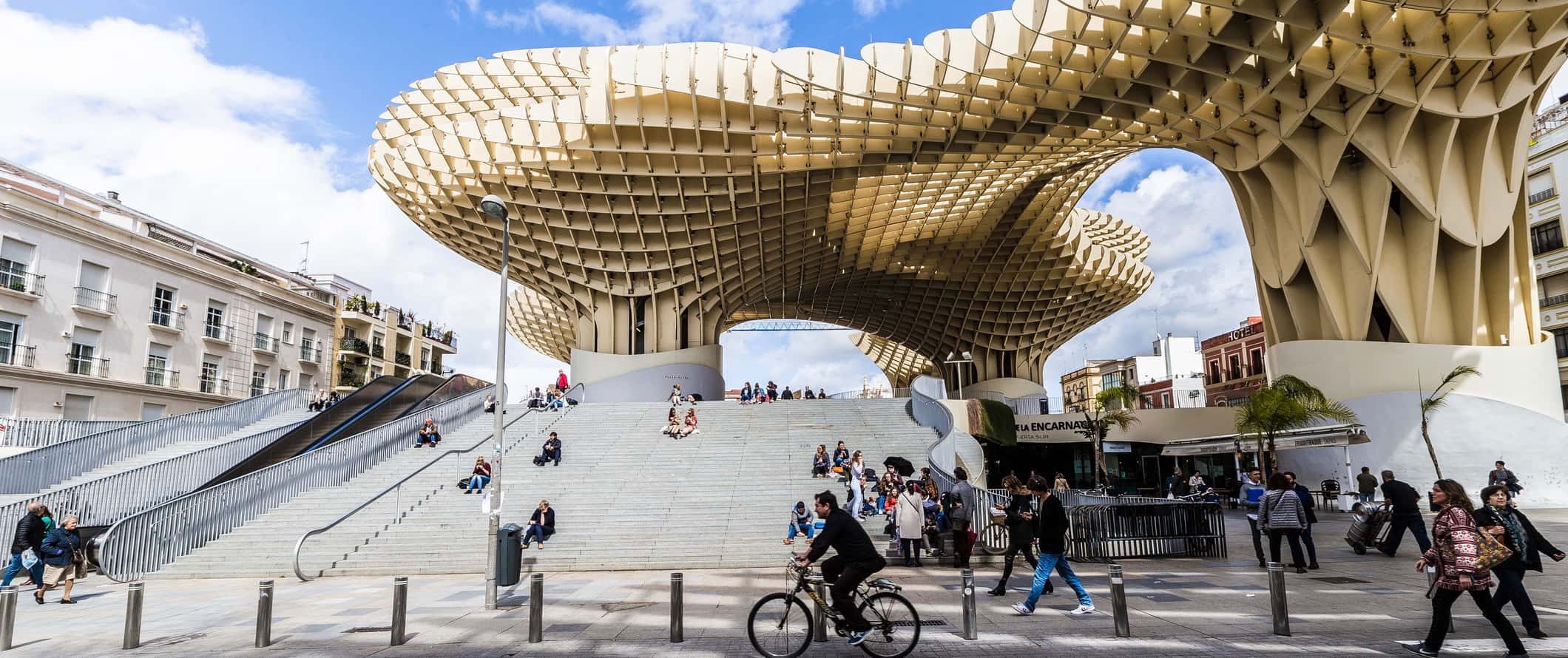
There are a few campgrounds outside the city, some offering private cabins with swimming pools for 40 EUR. For those with a tent, a basic plot for one person costs 5 EUR.
Budget hotel prices – Budget hotels cost 40-60 EUR per night, though prices are slightly higher (around 50-100 EUR per night) in peak tourist season and around Easter. Continental breakfast is usually included, as are basic amenities like TV and Wi-Fi.
Airbnb is available here as well, with private rooms starting at 30 EUR per night (but averaging double that). An entire apartment goes for at least 70 EUR per night though prices double if you don’t book early. Many include air-conditioning — useful to have for the hot summer season.
Food – Spain has a strong food culture, where meals can last hours and dinner often isn’t served until after 8pm. Each region in the country has its own local dishes and food culture, and Andalucía is no exception. Owing to its location on the coast, seafood is huge in this region, including shellfish and pescaito frito (fried fish). Gazpacho is also super common here, as is Iberian ham. Don’t miss trying some of the local sherry too (William Shakespeare apparently loved it).
You can eat very cheap in Seville. Tapas bars offer great deals and a number of takeaway stands with falafel, shawarma, or other late-night snacks can be found for under 10 EUR. Most tapas bars offer small plates for anywhere from 5-10 EUR depending upon the type of dish.
If you want to splurge, there are many nicer tapas restaurants with more elaborate meals and innovative takes on typical Andalusian-style foods. Mid-range tapas restaurants serve small plates between 7-15 EUR and, again, two or three plates is usually enough food for one person.
For a mid-range meal including an appetizer and drink, expect to pay at least 20 EUR. For cheap fast food (think McDonald’s), a combo meal costs around 8 EUR.
Beer costs as little as 2-3 EUR. A glass of sangria or wine costs 5 EUR. A latte/cappuccino is around 1.50 EUR while bottled water is under 1 EUR.
If you plan on cooking your own meals, expect to spend about 40-45 EUR for a week’s worth of groceries. This gets you basic staples like pasta, rice, seasonal produce, and some meat.
Backpacking Seville Suggested Budgets
If you’re backpacking Seville, expect to spend around 50 EUR per day. This budget covers a hostel dorm, cooking most of your meals, limiting your drinking, taking public transportation, and doing mostly free activities like relaxing in the park and seeing some of the churches. Add 10-15 EUR per day to your budget if you plan on drinking or partying a lot.
On a mid-range budget of about 135 EUR per day, you can stay in a private Airbnb or private hostel room, eat out at cheap restaurants for most meals, enjoy a few drinks, take the occasional taxi to get around, and do more paid activities like and museum visits or Spanish classes.
On a “luxury” budget of 250 EUR or more per day, you can stay in a hotel, eat out anywhere you want, drink as much as you’d like, take more taxis, and do as many guided tours as you want. This is just the ground floor for luxury though. The sky is the limit!
You can use the chart below to get an idea of how much you need to budget daily. Keep in mind these are daily averages – some days you spend more, some days you spend less (you might spend less every day). We just want to give you a general idea of how to make your budget. Prices are in EUR.
Seville Travel Guide: Money-Saving Tips
Food, drinks, and tours can add up in Seville if you aren’t watching your spending. This is one of the more expensive cities in Spain. Fortunately, there are plenty of ways to take advantage of free things to do here. Here’s how to save money in Seville:
- Get the Tarjeta TurÍstica pass – If you plan on using the bus or tram often, get this pass. A one-day pass costs 5 EUR and provides unlimited access to all public transport. A three-day pass costs 10 EUR.
- Visit the Royal Alcázar on Monday – The Royal Alcázar has free admission on Mondays, so plan accordingly to save money. Specific times vary by season so check the website for an up-to-date schedule.
- Buy your own alcohol – While drinks are hardly expensive at bars and restaurants in Seville (and in Spain as a whole), you can save yourself a lot of money if you buy your own beer and wine. Many locals buy their own bottles and drink in public at the Alameda de Hercules in the evenings, taking advantage of the street performers, buskers, and musicians that crowd the plaza on weekends.
- Stay with a local – Couchsurfing is a great way to save money on accommodation while also getting some insight from a local. While hostels aren’t too expensive in the city, this is still the best way to save money and deepen your travel experience.
- Go on a free walking tour – Like most of Spain, there are many opportunities to take advantage of free walking tours. Seville has a number and many depart from Plaza del Salvador. You just need to tip your guide. My favorite is New Europe. Just remember to tip your guide at the end!
- Visit the markets for groceries & cheap tapas – The Triana Market is one of the main food markets in Seville and has many fruit and vegetable vendors. There are food markets in each of the major Seville neighborhoods, and sometimes the smaller ones outside the main tourist trails even have small, local restaurants with great food deals. The Mercado de Feria is a favorite. Buying snacks, small meals, and groceries at the local neighborhood markets can cut down on your food budget.
- Bring a water bottle – The tap water here is safe to drink so bring a reusable water bottle to save money and reduce your plastic use. LifeStraw is my go-to brand as their bottles have built-in filters to ensure your water is always clean and safe.
Where to Stay in Seville
Seville has a ton of hostel choices for any budget. My recommended places to stay are the following:
- Triana Hostel
- Black Swan Hostel
- Oasis Backpakcers Palace
- Sevilla Kitsch Hostel Art
- Onefam Catedral
How to Get Around Seville
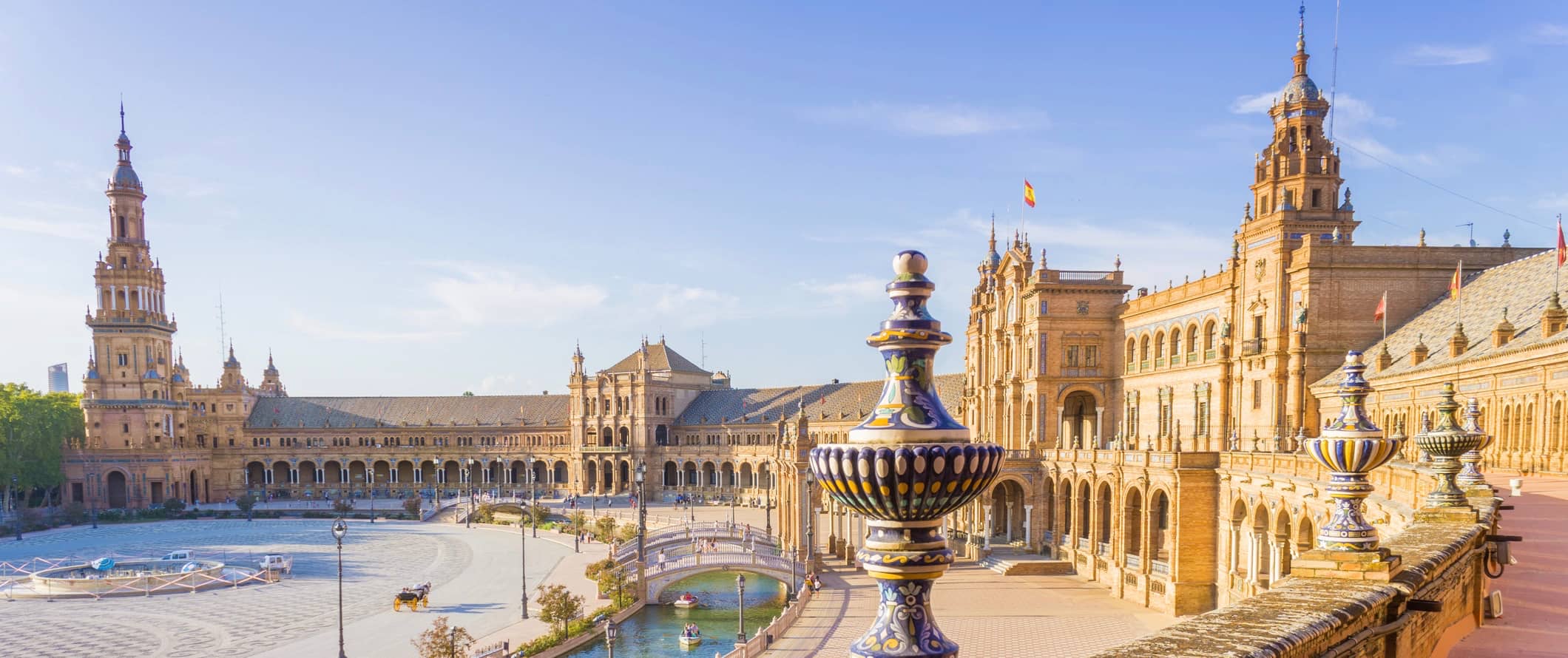
Public transportation – There is an extensive bus network that operates in Seville and can help you get from one edge of the city to another. Tickets can be bought on board and cost 1.40 EUR per trip. A one-day travel card, the Tarjeta TurÍstica, costs 5 EUR (10 EUR for a 3-day card).
Seville’s tram system connects to some of the further out areas of the city (and it’s air-conditioned). The tram is part of the same public bus system so tickets are the same price.
Bicycle Rental – Bike rentals are a great way to save money while seeing the sights from a new perspective. Rentals in Seville cost around 15 EUR per day.
Taxis – Taxis start at 2.50 EUR, with normal tariff being 1 EUR per additional kilometer. Skip them if you can as the prices add up fast!
Ridesharing – Uber is available in Seville but it won’t save you a ton so skip it and stick to the bus.
When to Go to Seville
Like most of southern Spain in Andalucía, Seville gets a lot of sunshine and has hot summers. I think the best time to visit is between March and May when crowds haven’t peaked but the weather is still warm and sunny.
The Easter season is especially popular in Seville because of the famous Feria (a large fair), which attracts hundreds of thousands of tourists and religious pilgrims. Part of the Semana Santa holy week, it’s a beautiful time to visit because of the colorful dresses and the many street activities and parades, but it does get crowded and expensive during the holy week.
In the summer (June-August), the weather is hot and sunny, with daily highs reaching upwards of 38°C (100°F). While the city is lively during the summer, it can be very taxing to explore in the heat.
The winter months (December-February) offer more comfortable temperatures, usually around 7-18°C (45-65°F). The city is much quieter, making it a nice time to visit if you want to beat the crowds and don’t mind some chilly days.
How to Stay Safe in Seville
Like most Spanish cities, Seville has a problem with pickpocketing and petty theft. The area around the Alameda de Hercules, a popular nightlife spot, was once very seedy and rife with crime and drug use, but that’s been cleaned up a lot in the past decade. Still, watch your bags when going out at night and avoid dark, empty streets if alone. Always keep an eye on your possessions when on public transportation as well.
If you go out at night, only bring the money you need and leave the rest locked up in your accommodation.
Tourist scams are prevalent as well so keep an eye out for groups of kids trying to distract you, as they’re probably trying to take your money. Additionally, be wary of people offering to carry your luggage. They may try to charge you a large fee.
When dining, keep your bags and belongings close and secure (especially when outside). Don’t leave your things on the table when going up to order. They can disappear quickly.
Read more about common travel scams to avoid here if you’re worried about getting ripped off.
Solo female travelers should feel safe here, however, the standard precautions apply (always keep an eye on your drink at the bar, never walk home alone intoxicated, etc.)
If you do experience an emergency, dial 112 for assistance.
Always trust your gut instinct and make extra copies of your important documents.
The most important piece of advice I can offer is to purchase good travel insurance. Travel insurance protects you against illness, injury, theft, and cancellations. It’s comprehensive protection in case anything goes wrong. I never go on a trip without it as I’ve had to use it many times in the past. You can use the widget below to find the policy right for you:
Seville Travel Guide: The Best Booking Resources
These are my favorite companies to use when I travel. They consistently have the best deals, offer world-class customer service and great value, and overall, are better than their competitors. They are the companies I use the most and are always the starting point in my search for travel deals.
- Skyscanner – Skyscanner is my favorite flight search engine. They search small websites and budget airlines that larger search sites tend to miss. They are hands down the number one place to start.
- Hostelworld – This is the best hostel accommodation site out there with the largest inventory, best search interface, and widest availability.
- Booking.com – The best all around booking site that constantly provides the cheapest and lowest rates. They have the widest selection of budget accommodation. In all my tests, they’ve always had the cheapest rates out of all the booking websites.
- HostelPass – This new card gives you up to 20% off hostels throughout Europe. It’s a great way to save money. They’re constantly adding new hostels too. I’ve always wanted something like this and glad it finallt exists.
- Get Your Guide – Get Your Guide is a huge online marketplace for tours and excursions. They have tons of tour options available in cities all around the world, including everything from cooking classes, walking tours, street art lessons, and more!
- The Man in Seat 61 – This website is the ultimate guide to train travel anywhere in the world. They have the most comprehensive information on routes, times, prices, and train conditions. If you are planning a long train journey or some epic train trip, consult this site.
- Rome2Rio – This website allows you to see how to get from point A to point B the best and cheapest way possible. It will give you all the bus, train, plane, or boat routes that can get you there as well as how much they cost.
- FlixBus – Flixbus has routes between 20 European countries with prices starting as low 5 EUR! Their buses include WiFi, electrical outlets, a free checked bag.
- SafetyWing – Safety Wing offers convenient and affordable plans tailored to digital nomads and long-term travelers. They have cheap monthly plans, great customer service, and an easy-to-use claims process that makes it perfect for those on the road.
- LifeStraw – My go-to company for reusable water bottles with built-in filters so you can ensure your drinking water is always clean and safe.
- Unbound Merino – They make lightweight, durable, easy-to-clean travel clothing.
- Top Travel Credit Cards – Points are the best way to cut down travel expenses. Here’s my favorite point earning credit cards so you can get free travel!
- BlaBlaCar – BlaBlaCar is a ridesharing website that lets you share rides with vetted local drivers by pitching in for gas. You simply request a seat, they approve, and off you go! It’s a cheaper and more interesting way to travel than by bus or train!
Seville Travel Guide: Related Articles
Want more info? Check out all the articles I’ve written on Spain travel and continue planning your trip:

The 7 Best Hotels in Madrid
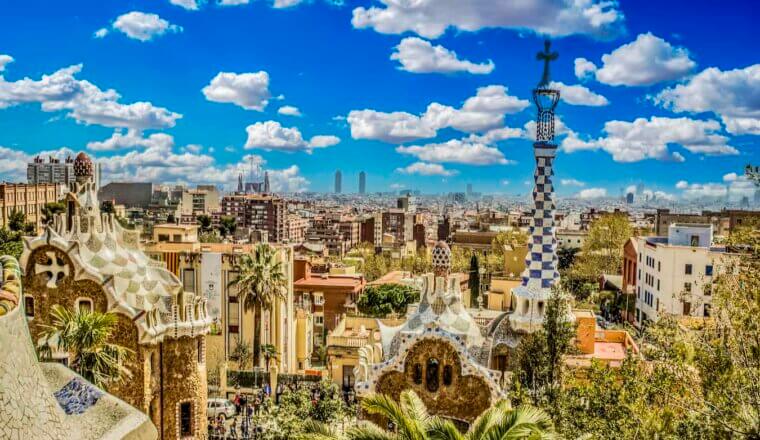
The 7 Best Hotels in Barcelona

The Best Walking Tours in Barcelona
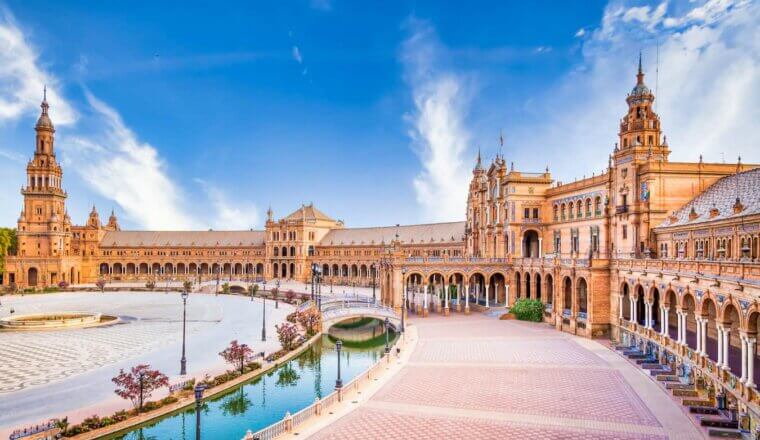
The Best Walking Tours in Seville
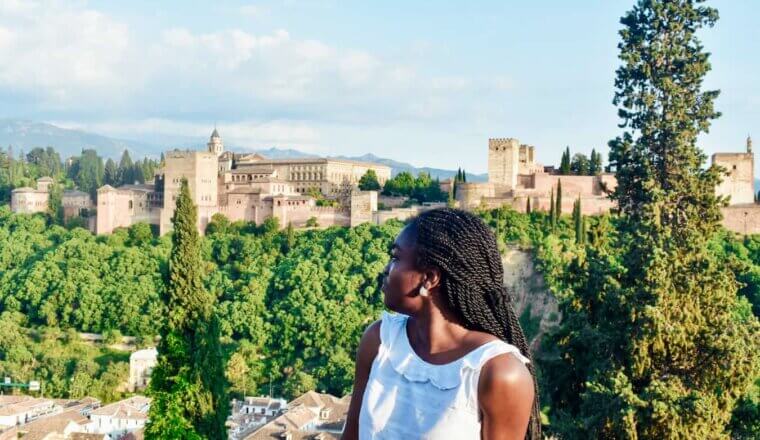
The Perfect 3 Day Granada Itinerary
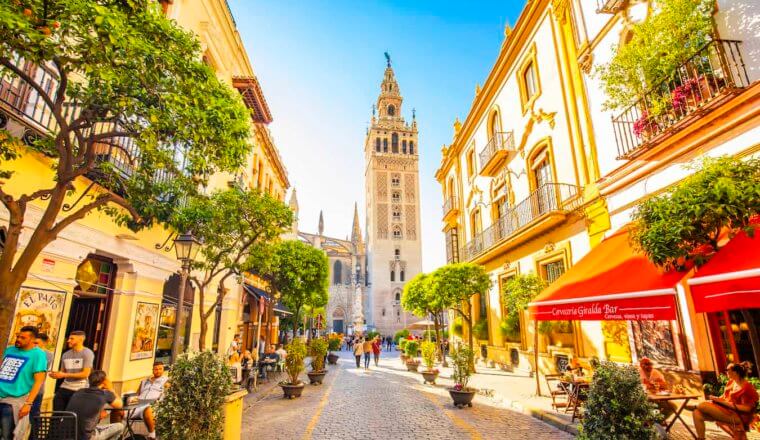
The 7 Best Hostels in Seville
Get my best stuff sent straight to you, pin it on pinterest.
- Where To Stay
- Transportation
- Booking Resources
- Related Blogs
- United Kingdom
- Curated Stays
- Wine Travel
- About Isabelle
- Work with Us
2 Days in Seville Itinerary 2024: Insider’s Soulful City Guide
- Isabelle Hoyne
- February 15, 2024
** Disclosure: some of the links on this site are affiliate links and should you make a purchase through these, I may receive a small commission at no extra cost to you. Thank you for your support!**
Craft the perfect 2 days in Seville itinerary using this guide for the perfect visit to Andalusia’s lively capital city.
Many arrive in Seville and head straight to its headline attractions, drawn like flies to the mystically evocative Real Alcazar or the picture-perfect Plaza de Espana and its rainbow of azulejos tiles.
There are certainly worse ways to spend 2 days in Seville.
I for one, however, think that the real draw of Seville lies in its labyrinth of streets; palpating with character and often sizzling in the intense heat of the Andalusian summers.
I’ve been to many cities that I’ve loved, but here is a city in which I could live .
( Editor’s note : in fact, since writing this post I did just that – spending a number of months living in Seville getting to know just what makes it tick. This 2 day Seville itinerary will help you get under the skin of this vibrant city , with a mix of historical sights, must-visit eateries and off-the-radar gems).
For Seville possess a spirit that I wish I could bottle up and sell. A place that is made for lazy ambling, slow living and gorging oneself on tapas , Seville’s character bursts forth to meet you at every given encounter.
This is not, however, particularly surprising as Seville is the home of flamenco, a stirring dance that entwines its performers in passionate embraces and emotive flourishes.
Present too, however, is the great legacy of Seville’s fortuitous position during the Golden Age of Discoveries, when it served as a gateway to the New World in the 16th and 17th centuries.
A period that bestowed great riches upon the city, this wealth left its mark on Seville, none so more evident than in the gloriously gigantic Seville Cathedral .
Intertwined with the vestiges of Spain’s glory days as a colonial superpower, are a fascinating web of those Moorish and Jewish influences that are so common to the region of Andalusia .
By-products of this are the magnificently Mudéjar Real Alcazar and the winding alleyways of Seville’s Santa Cruz district that are so perfect to get lost in.
Whether you spend a weekend in Seville, or an entire week, its atmosphere is completely inescapable. Read on to learn the best ways to discover Seville in two days , and build a Seville itinerary that helps you get to the core of the spirited, beating heart of Andalusia’s capital city.
Essential links for your Seville city break
Getting to Seville : Search for flights // Find train routes // Find bus routes // Book an airport transfer Editor’s choice : ✩ Tastes, Tapas & Traditions food tour (perfect for foodies – read my review here ) ✩ Seville in a Day Tour with VIP Alcazar Access (Iconic sights) Top tours and experiences in Seville: ✩ Alcázar and Cathedral Guided Tour & Priority Access (must-see) ✩ Seville Tapas Crawl with Flamenco Show ✩ Seville: Sunset Paddle Surfing on Guadalquivir river ✩ Seville By Boat – Guadalquivir 1-Hour City Cruise Best places to stay in Seville : H10 Casa de la Plata (rooftop pool + terrace at superb price point) // Casa Romana Hotel Boutique (quaint boutique) // Soho Boutique Sevilla (stylish, luxe for less) Best Seville vacation rentals : luxury apartments on Plum Guide Best day trips from Seville ✩ White Villages and Ronda Tour ✩ Granada’s Alhambra and Albaicin Full Day Tour
Table of Contents Hide
A brief overview of this seville 2 day itinerary, where to stay in seville, day 1 in seville, day 2 in seville, alternative activities for your 2 days in seville, where to eat during your seville 2 day itinerary, map of this 2-day itinerary in seville, what is the best time to visit seville, is 2 days enough in seville, getting in to seville, how to get around seville, day trips from seville, is 2 days in seville enough, what are the must-visit attractions in seville, what to do in seville on sunday, how do i plan a 2-day trip to seville, what are the best neighbourhoods to explore in seville during a 2-day visit, what are some other recommended activities in seville, related reading for seville, like this post please share and pin for later.
Here is an outline of what to do in Seville in 2 days, which will be detailed fully further in this post.
In summary, this 2 day Seville itinerary explores Seville’s delectable culinary traditions , its most famous historical sites and includes a smattering of its more contemporary trappings .
Day 1 of 2 day Seville Itinerary
- Morning : take a food tour (or other tour of your interest) as an introduction to Seville
- Afternoon : visit the big hitters; the Real Alcazar, Seville Cathedral and the Giralda. Walk through the streets of the Barrio Santa Cruz
- Sunset : go for sundowners at a Seville rooftop bar
- Evening : go for tapas at El Rinconcillo or Eslava
Day 2 of 2 day Seville Itinerary
- Early morning : start early and visit the Plaza de Espana and Maria Luisa Park
- Mid-morning : head for brunch at La Cacharreria. Afterwards, explore the Metropol Parasol and wander around Seville’s city centre streets (or hit the shops)!
- Lunch : go for a tapas lunch at Bar Alfalfa, or head to Mercado de Feria
- Afternoon : visit Casa de los Pilatos and the Museum of Fine Arts
- Sunset : take in the riverfront and have a drink at Mercado Lonja del Barranco
- Evening : attend a Flamenco Show or go on a tapas crawl of Seville
To make the most of your 2 days in Seville, do yourself a favour and book some accommodation in Seville that is in or very close to the city centre, meaning that you will be able to walk everywhere. The following are my recommendations.
Hotel Alfonso XIII – A Luxury Collection Hotel
Lap of luxury.
If you want to splash out on a spectacular luxury hotel in Seville, then look no further than the emblematic Hotel Alfonso XIII. Situated right beside Seville’s Royal Alcazar, the architecture and design of this 5 star luxury hotel in Seville borrows heavily from its Mudejar-themed neighbour. Comes with every amenity that you would expect a hotel of this ilk to offer.
Casa Romana Hotel Boutique
Boutique bolthole.
I had a lovely stay at this 4 star boutique hotel in Seville. Rooms are set around a delightful outdoor courtyard (like a Roman villa) that features a lovely, trickling water feature. There is also a rooftop terrace with a hot tub and a rooftop bar that is perfect for some cocktails! The street it is located on is quiet, and its position in the Old Town meant we were 15 minutes away from everything.
Soho Boutique Villa
Luxe for less.
Those looking for something a little bit more affordable, but nonetheless luxe, will find that Soho Boutique Villa ticks all their boxes. This stylish, 3 star boutique hotel features trendy rooms, an outdoor swimming pool and is located too in the old town area of Seville.
Click here to discover a curated list of Seville holiday apartments
How to spend two days in seville: your itinerary.
Here, in full, is my suggested 2 days in Seville itinerary . Seville is all about slow, soulful living, beautiful surroundings, incredible history and architecture and, of course – delectable Andalusian cuisine.
A trip to Seville is as much about savouring the lifestyle as it is about seeing the sites, so make sure to slow down, smell the orange-blossoms and fall into the steady pace of life that makes Sevilla so special.
With that in mind, while I’ve tried to fit in a decent amount of things to do in Seville in 2 days, don’t feel like you need to follow this to a T.
Day 1 locations visited:
- Food tour meeting in city centre
- Réal Alcazar
- Seville Cathedral
- Barrio Santa Cruz
- La Terrazza del EME
1 | Start with a food tour
Food in Seville – especially when it comes to what, when and where to eat it – forms a huge part of its culture. While the architecture and history of Seville are both majestic and impressive, it was Seville’s attitude to food that stood out to me most while living there.
Wherever you move through the city, the aromas of Seville’s vibrant culinary landscape waft through the air, beckoning curious foodies over thresholds and into dimly lit establishments.
Discovering the gastronomic offerings of Seville is one of the best things to do in Seville in 2 days. With an abundance of dining options, tapas hotspots, and bustling markets, however, it can be difficult to know where to begin your gastronomic adventure.
This is why I strongly believe why you should start your 48 hours in Seville with a food tour . In this ‘ best food tours in Seville ‘ post, I outline the best on offer.
If you want my quick advice, however, I took this Tastes, Tapas & Traditions tour with Devour Tours when I first got to Seville and couldn’t recommend it highly enough.
By taking a Seville food tour- read my review here , you will uncover the hidden gems and local favourites that are often missed by those travelling un-shepherded, as you’ll be shown the way by a local foodie. It made our months of eating around Seville all the better.
With their wealth of knowledge and passion for food, your local guide will typically introduce you to the very best that Seville has to offer in an authentic and immersive way.
Alternatively, if cooking is more your style, then discover the best cooking classes in Seville in this post .
RELATED READING | Best food tours in seville
2 | Real Alcázar of Seville
After several hours of eating on your food tour, you should be well set up for exploring one of Seville’s most iconic sights in the early afternoon.
The Real Alcazar of Seville is one of the finest examples of mudéjar art in the world. A UNESCO World Heritage site, its origins began in the 8th century when it was constructed as a palace by Seville’s Moorish occupants.
By the 13th century, Seville had been reclaimed by the Spanish monarchs during the Reconquista, who began decorating the palace to their own tastes.
Thus, they incorporated a range of romanesque, gothic and Renaissance architecture into the building’s designs, resulting in the fascinating clash of styles that we now call “mudéjar”.
While many visitors are drawn to the Alcazar as they have seen it featured as the Water Gardens of Dorne in Game of Thrones, the palace is rich in history and world-renowned architecture, with ornate gardens too that beg to be explored.
To truly get the best of a visit, I’d advise reading up a little in advance, or booking a guided tour. At the very least, make sure to get an audioguide. Again, this is a site that should not be left off any 2 day Seville itinerary.
Time required: You’ll need around 2 hours to visit both palace and gardens.
EDITOR’S NOTE | I’d highly recommend that you book skip-the-line tickets , due to the (often hours) long queues at the ticket office. If you’d prefer to take a guided tour, this small group Alcazar tour is reasonably priced and extremely well reviewed.
ⓘ Top tip – Take this exclusive, early access Alcazar experience if you’d like to bask in the incredible Mudejar architecture without bumping elbows.
3 | Seville Cathedral and La Giralda
Next up is the mighty Seville Cathedral, the largest gothic cathedral in the world.
It and the adjacent Giralda should be included as a stop on any Seville itinerary, even if just to be admired from the outside. If you’re pressed for time, or would prefer to do something else, then I would at least urge you to climb the Giralda for extremely rewarding views over the rooftops of Seville.
Do try, however, to visit the interior of Seville Cathedral. At the time of building in the 15th century, local lore has it that the cathedral was built with the following intention: “Let us build a church so beautiful and so grand that those who see it finished will take us for mad” .
On viewing the interior of the cathedral in real life, you can really appreciate the sheer enormity of it and what an architectural feat it was at the time. Designed to inspire awe in its congregation, it most definitely hits the mark. When inside, make sure to take in the impressive tomb of Christopher Columbus.
Time required: you’ll need around 1.5 – 2 hours for both Cathedral and Giralda
EDITOR’S NOTE | Skip-the-line entrance tickets for the cathedral and the Giralda can be purchased together at this link . While I’d recommend a tour of the Alcazar ahead of the cathedral, if you have a particular interest, you can check out this guided tour , which incorporates both.
RELATED READING | Where to find the best seville cathedral tours
4 | Wander the streets of the Barrio Santa Cruz
The former Jewish quarter of Seville, known as Barrio Santa Cruz, is one of the must-visit places when exploring Seville things to do in 2 days.
Encompassing the mighty Seville Cathedral and Real Alcazar within its boundaries, the warren of streets that lead from these central points are a joy to become lost in and it’s the natural next step once you’re done exploring the Alcazar and cathedral.
In this historic quarter, you’ll encounter charming, orange tree-fringed squares, little souvenir shops selling teas and spices and a whole host of tapas restaurants.
FOODIE TIP | You’ll find Delatribu , a speciality coffee spot from my best coffee shops in Seville list in the heart of Santa Cruz. Pop in for a caffeine fix.
5 | Go for some sundowners with a view
For a memorable (and somewhat glam) experience during your 2 days in Seville, head for cocktails at sunset to one of Seville’s rooftop bars.
There are plenty of options, but I loved the upscale rooftop bar, “La Terraze de EME”, at the EME Catedral Hotel . The cocktail menu is extensive if a little bit pricey, but offers spectacular views of La Giralda tower, which is made all the more special at sunset.
6 | Sample some of Seville’s tapas
As I’ve previously mentioned, I’ve been lucky enough to spend a few months living in Seville. During this time, the majority of my activities incorporated rolling from tapas bar to tapas bar, washed down with refreshing tinto de verano !
Whether you’re after some old school, traditional tapas, or more trendy, experimental spots make sure to leave plenty of time to discover the culinary delights of Seville, which is a must-do when considering what to do in Seville for 2 days.
Some of my recommendations for tapas include:
- Casa Morales
El Rinconcillo
- Bar dos de Mayo
- Bar Alfalfa
Day 2 locations visited:
- Plaza d’España
- Maria Luisa Park
- La Cacchareria
- Metropol Parasol
- Mercado de Feria
- Casa de los Pilatos
- Fine Arts Museum
- Mercado Lonja del Barranco
1 | Start the day at Plaza de Espana and Maria Luisa Park
No visit to Seville is complete without a visit to the expansive Plaza de Espana and the adjacent Maria Luisa Park . My top tip here would be to visit Plaza de Espana early in the morning, for gorgeously soft light and decidedly less crowds.
The Plaza de Espana was built for the Ibero-American Exhibition of 1929, forming the centerpiece of the event. The main building is surrounded by a moat, over which there stand four bridges – each representing the ancient Spanish kingdoms of Castile, Navarre, Aragón and León.
Take your time to take in the beautiful azulejos tiles that adorn much of the square and wander amongst the romantic bridges and arches. Make sure to take in the exceptionally intricate mosaics (52 of them, each representing a Spanish province) that adorn the front of the main building.
The nearby Maria Luisa Park is an oasis of calm in what is the otherwise busy city of Seville. For some exceptionally pretty spots within the garden, seek out the Isla de los Patos (or ‘ island of the ducks ‘) and the fantastic mudejar pavilion.
Time required: You’ll need around 1.5 – 2 hours to visit, taking into consideration that it’s located a little outside of Seville’s old town.
2 | Head for brunch at La Cacharreria
This small, quirky cafe that is located close to the Metropol Parasol is a great spot in which some grab some brunch in Seville.
I first visited it when spending a few days in Seville and returned several years later (on multiple occasions) to find it going from strength to strength.
They have an extensive menu of sandwiches, bagels, smoothie bowls, toasts etc that should be sure to satisfy many a brunch menu requirement.
It always seems to be buzzing with people. Their cakes in particular are exceptionally good (massive portions too), which are very popular with locals come early evening before dinner.
3 | Metropol Parasol
With the old in Seville, is also the new.
The Metropol Parasol is a very modern, wooden installation that incorporates the ruins of a Roman colony. For a fee, you can access the top of the parasols, on which there is a walkway and a terrace that offers a splendid panorama of Seville.
Built to cover the site of a traditional Seville food market (which stands under the construction through the doors), pop your head in to see vendors in full flight and marvel at the plump, vibrantly coloured fruit and vegetables.
For those with an interest in photography, visiting the Metropol Parasol Barrio Santa Cruz is also one of the great things to do in Seville, Spain.
It’s a great place to test your photography skills, as the ever-changing sunlight and the angles of the parasol make composition really interesting. I always felt drawn to photographing it whenever I saw it.
READ NEXT | Finding the Best Seville Food Tour for Culture-Loving Foodies
4 | Go shopping in Seville’s centre
Seville is a fantastic destination for shopping, with many Spanish and international brands with stores in the city. As you are in Spain, this is the place to visit stores like Zara, Mango etc, and you will find that there are multiple stores.
The main shopping streets are the pedestrian areas of Calle Sierpes , Calle Tetuán and Plaza Nueva – these are great spots to hit even to just take in the style of the locals (you’ll notice that people in Seville are very stylish).
Even if you don’t want to purchase anything, I’d recommend taking a walk through these streets anyway. They are a bustling reflection of Seville’s energy and offer glimmers of the city’s unique culture, through religious themed shops, and those selling flamenco dresses, amongst others.
Do be aware that most stores shut on Sundays, however.
NOTE | If you’re looking for something a little more artisanal, cross the banks of the river to the Triana district to shop for ceramics or visit the Triana Market. You’ll also find a lot of home decor and furniture stores here as well.
5 | Take a stroll up Calle Feria for lunch
Calle Feria came to reflect the Seville that I completely fell in love with while living there. It offered a different side to the city of flamenco and tapas; a grungier, more youthful view, enmeshing traditional Seville with a more rounded, global influence .
For that reason, I’ve included it on this 2 day Seville itinerary.
You’ll find all manner of cuisines along the street. Favourites of mine include:
- Fatouch for amazing Lebanese food in a really cool space(make sure to book ahead)
- Taquería La Lupe for Mexican
- Restaurante La Locanda di Andrea for small-plate Italian pastas
- Üaillo Pizza Lab , on a side street nearby (featuring Neapolitan chefs) for pizza
The all out winner for me , however, is located at the back of Mercado de Feria. That winner is a South American tapas restaurant called Condendê – a gem with pumping tunes, extremely chatty servers and exceptional food.
Walk through the market (and have a peak at the stalls) to reach it.
EDITOR’S NOTE | This option will likely only work if you don’t spend too long shopping (if you do, pop into famous Bar Alfalfa for a tapas lunch before moving on to the next activity on this itinerary).
6 | Pop into the Casa de Pilatos
This 16th century palace is a special treat held within the Santa Cruz district of Seville.
Still serving as the permanent residence of the Dukes of Medinaceli, this gorgeous building is a magnificent fusion of Spanish Mudejar and Italian Renaissance architecture.
The term ‘ Pilatos ‘ in the palace’s name comes from Pontius Pilate, having been inspired by the architecture of Pilate’s house in Jerusalem.
At the centre of the palace is a traditional Andalusian courtyard. Beautifully decorated and resplendently complete with a well and fountain, it boats 24 busts of various Roman emperors and Greek gods.
One of the best preserved palaces in the city of Seville, Casa del Pilatos is often referred to as a mini Alcázar, such is the intricacy in the endless mosaics, carvings, ceiling paintings and numerous other features that grace its walls.
I loved my visit here – make sure to join the guided tour to access the rooms upstairs, which I thought were worth it (enquire on arrival). Spend more time doing this than listening to the audioguide that guides you through downstairs, which I found to be a little boring.
Time required: around 1 – 1.5 hours, depending on whether you take a tour, etc.
Book tickets | There is an admission fee for entry, at €10. You can purchase tickets for Casa de Pilatos here (ground floor only).
7 | Museum of Fine Arts
Including this on the itinerary may be a bit of a stretch (you may need to choose between here and Casa de Pilatos, or eating on Calle Feria), but I loved my visit here so feel it would be remiss of me to leave it off this itinerary.
The Museum of Fine Arts is home to one of the most valuable collections of art in Spain. It’s often held up as being the second most important collection in the country after that of the famous Prado Museum of Madrid.
I would say that the Museum of Fine Arts in Seville is a must-visit for any art lover who is considering how to spend 2 days in Seville. The museum offers visitors a view of Spanish artwork, ranging from Medieval times up until the 19th century.
The building that the museum is held within is itself worth a visit. Situated in the former Merced Calzada Convent, this 17th century building is considered one of the best examples of Andalusian Mannerism.
The museum is set within a stunning courtyard and even the former church of the convent, which makes for seriously dramatic viewing – I was more than a little gobsmacked.
Time required: 1 – 1.5 hours
RELATED READING | Is Seville Worth Visiting in 2024? An Insider’s 17 Pros + 5 Cons
8 | Guadalquivir Riverfront & cocktails at Mercado Lonja del Barranco
Much more than merely ‘a river’, the Gualdalquivir has been pivotal to Seville’s history, in particular its maritime prowess during the Golden Age of Discoveries.
It was Seville from which Ferdinand Magellan launched the first circumnavigation of the world in 1519. During this time, Seville was the mercantile centre of the western world, and the Gualdalquivir served as the main maritime route for Atlantic traffic for over 200 years.
Today, the river still plays an important role in Seville’s story, although its functions may have changed. It is a real focal point of the city, splitting the city picturesquely in two. With broad walkways, the riverside is lively and full of people, who make us of it to dine, meet friends and exercise.
You can also visit a full size replica of Magellan’s ship, the Nao Victoria , to discover more about the famous voyage.
Walk for as little or as long as you like. Many other itineraries suggest a visit to Torre del Oro – by all means walk as far as it and admire the outside (it’s rather nice at sunset), but I would prioritise seeing the other things mentioned on this itinerary.
When you’ve had enough walking, make your way to the hip Mercado del Barranco . Once a bustling fish market, it now serves as a stage for Seville’s evolving gastronomic narrative and is a millenial’s culinary playground.
Grab a chair outside, let the river form a hazy, pastel backdrop as the sun sets and enjoy the tunes and buzz as the evening begins to ramp up.
EDITOR’S NOTE | If you’d like to explore the Gualdalquivir River in a more leisurely fashion, then take a river cruise . This 2-hour long experience takes in Seville’s bridges, with a multi-course dinner menu and drinks while you take in the sights.
9 | Finish with the drama of a Flamenco show
Flamenco dance is an important part of Andalusian culture and indeed, the culture of Seville.
Tracing its origins to 18th century Andalusia, the dance is thought to have come about due to a fusion of folks songs and dances that arose due to the diverse population of Gypsies, Arabs, Africans and Jews that were living in Andalusia.
The music is fast paced and performances are passionate, featuring hand-clapping, foot-stamping and often ad-lib vocal performances.
If you do choose to see a Flamenco performance in Seville, choose a smaller, more intimate venue where you will be closer to the performers and can more easily become entangled in the drama as it unfolds.
Book | If you’d like to attend a traditional Flamenco show, check out the Tablao Flamenco show in Triana
Go on a memorable tour in Seville
Depending on your interests, whether they be history, architecture, food, art, or other(!) – allocate a couple of hours in your Seville itinerary to doing something fun that will help you to create memories that you’ll keep on talking about long after you leave Seville.
Some great tours with wonderful reviews that take in Seville’s charms across a broad range include the following:
- Authentic Seville Tapas Crawl : a 3-hour hour gourmet walking tour with a local foodie, limited to 10 people, that takes you to 5 of the most authentic and emblematic tapas bars in Seville.
- Seville: Sunset Paddle Surfing on Guadalquivir river : 1.5 hours with an expert instructor. Discover some of Seville’s key cultural sites from the water.
- Seville river cruise & meal on exclusive yacht : a 2-hour cruise that takes in Seville’s bridges, with a 6-course tasting menu and cava while you take in the sights.
- Seville highlights bike tour : an extremely popular 3-hour Seville bike tour that takes in lots of Seville’s sights and neighbourhoods. Learn about Seville’s rich history and local lifestyle as you pedal.
- Spanish Cooking Class & Triana Market Tour in Sevilla : visit the local Triana market, before heading back to the kitchen for a hands-on cooking class. Afterwards, sample your efforts!
RELATED READING | 12 of the Best Seville Bike Tours to Take in 2024
Visit the Hospital de los Venerables
Barrio Santa Cruz is one of Seville’s most heavily visited areas, but in a quiet, orange-tree fringed square you will find the Hospital de los Venerables, a former baroque hospital built in the 17th century to house elderly, impoverished priests.
Today, it houses an art gallery dedicated to the famous Sevillano painter Velazquez, and its “ Centro Velazquez ” aims to impart on visitors the importance of his legacy, by recreating the historic and artistic world he lived in.
In those times, Seville’s vibrant art scene found itself under the lens from the rest of Europe.
Depending on when you visit, there may also be temporary exhibitions being held – in 2019/20 for example, the venue displayed Picasso’s Mother and Child. There is also a contemporary exhibition found upstairs, along with some early photographs from the 19th century.
RELATED READING | The best food markets seville (+ tips for visiting)
General Archive of the Indies
One for the history buffs, the General Archive of the Indies does exactly what it says on the tin, holding millions of documents that keep a record of Spain’s colonial history.
Spanning more than 3 centuries of history, it holds archives of the vast territories that Spain held, including America and the Philippines.
Conveniently located right beside the Real Alcazar and Seville Cathedral, this is a very easy one to pop into, as entrance is also free.
Keep an eye out for special exhibitions that are on when you are visiting Seville, as the Archive regularly schedules interesting features, such as Magellan’s voyage of discovery.
The building itself is also listed as a UNESCO World Heritage Site, occupying a grand, 16th century merchant’s building that served as the central merchant exchange during Spain’s Golden Age, when wealth poured in to Seville from the New World.
EDITOR’S NOTE : I’m currently working on some more Seville posts while you’re reading this, including a detailed foodie’s guide. Check back in in a few weeks, and/or follow on Instagram for updates on when these are published!
Where to get a Michelin starred meal in Seville
Abantal is a Michelin star restaurant in Seville that offers up traditional Andalusian dishes with a contemporary, creative twist. A minimalist decor lets the food do the talking, offering diners a choice of two tasting menus and a chance to sit at the chef’s table in Abantal’s kitchen.
A unique restaurant with the feel of a gastro bar and an atmosphere that is both enjoyable and entertaining. Fish and seafood at the highest possible standards, much of which is grilled on the open grill. You can watch the kitchen team at work too, with an open-view kitchen featuring in the design.
Where to go for a trendy dinner in Seville
Recent years have seen a surge in trendy eateries, offering modern takes on Andalusian cooking and extensive cocktail menus to whet the palate with.
Those searching for an upmarket restaurant in Seville will be very pleased with El Pinton. Exquisite interiors are set around an Andalusian courtyard, complementing perfectly El Pinton’s eclectic menu.
Where to go for tapas in Seville
El Rinconcillo has been firmly on the list as one of Seville’s best tapas restaurants for a long time – in fact, El Riconcillo has been knocking around since 1670 and is Seville’s oldest tapas bar. It also manages to be consistently good.
Located in two adjoining buildings (one an old grocers) on an atmospheric little corner, I’ve visited several times across the span of several years and it never lets me down. Try to get a table outside in the square for the ultimate people-watching experience, or next best – simply stand at the bar!
Again, here is another Sevillian institution that has yet to let me down. This neighbourhood tapas bar in San Lorenzo is extremely popular, so go early to put your name down for a table, unless you mind waiting.
That being said, you can still grab a glass of wine and stand out on the street, watching the world go by – it’s nearly my favourite part of the Eslava experience! Make sure to try the household ‘Cigar’ dish – which incorporates cuttlefish wrapped in a light, filo pastry!
I’ve visited Eslava many times over the years and it really does deserve its reputation.
READ NEXT | wine tasting in seville – best tours & experiences
With the exception of the tours and general wandering around mentioned above in this post, I’ve included all other places to visit in Seville that you might like to include on your itinerary on a handy map, so that you can easily craft a plan and get your bearings.
What to know before planning a 2 days in Seville itinerary
Before you embark on your two day trip to Seville, there are some practical and logistical matters that you need first to assess.
Seville is located in Spain’s Andalusia region, in the southernmost part of the country. It is also set a little bit in from the coastline.
What this means is that it is the hottest region in Spain. It is also the hottest region in Europe ! If you plan to spend a couple of days in Seville be prepared for the sometimes scorching temperatures this vibrant city offers.
In terms of when to visit Seville, unless you particularly enjoy being sizzled like a sausage on a hot, hot, grill, then I’d avoid Seville in the height of summer . The temperatures can reach a daily average of 36 °C (97 °F) in July and August.
During its hottest days, the mercury can even reach up to 42/43 °C (107/109 °F) , which is not at all conducive to sightseeing (or eating tapas, for that matter). This is also considered Seville’s low season.
Outside of the above, I think any other month is a good time to visit Seville , depending on what you’re after.
I spent a number of months living in Seville from winter through early Spring. While January into February is quite chilly, it’s still rather sunny and it often reached around 17 °C (63 °F) at the warmest part of the day (which was t-shirt weather for me, even if the locals don’t share the same sentiment!).
Remember that it does get chilly at night time, however, and that you will need a warm jacket. It still makes Seville a great option, though, for a winter city break.
Furthermore, as February progresses the weather can be really pleasant. March, I found, was a real joy !
High season runs from March through June (so keep that in mind for both crowds and prices), with all other months considered to be Seville’s shoulder-season; to be honest these are all good months to visit.
Bear in mind that it can still be pretty toasty in May/June and September/October , so depending on how hot you like your city breaks to be you may want to steer clear then too.
You’re probably wondering how many days to spend in Seville . So, how many days in Seville are enough?
Two? Three? Ten?!
I easily passed a week in this wonderful city before I absconded the Emerald Isle to live there for a while, but I appreciate that this is not realistic for everyone.
Seville is a brilliant city break destination and you can uncover much of Seville within a 2 day period. If you only have a weekend, or are including Seville as part of a road trip around Andalusia , then it is very much possible to visit Seville in 2 days and get a good sense of the city.
This guide shows you how to make the most of two days in Seville , but if you have some more time to spare and are debating whether or not to stay longer, then I’d urge you to allocate some more days to spend discovering Sevilla!
RELATED READING | How Many Days in Seville: Itineraries (+ Top Tips) for Every Traveller
As one of Spain’s major cities and the capital of the Andalusia region, you will find that Seville is extremely well connected.
Whether you are travelling to Seville from another city in Spain, or transiting to Seville from another country, knowing how to go to Seville is vital. Fortunately, Seville is relatively easy to access.
Getting to Seville by plane
There is an airport in Seville – Aeropuerto de Sevilla – that is located only 10km from the city, making it extremely convenient to access the city, especially if you’re planning to explore Seville in 2 days.
From the airport, you can take a local bus, running every 30 minutes (that also takes 30 minutes), which drops you straight to Seville’s central bus station. The bus costs €4.
Alternatively, you can simply get a taxi from Seville Airport into Seville city centre, for around €25 at time of writing.
If your point of origin does not offer direct flights to Seville, then try Malaga airport instead, which is a major hub for international flights. From here, then, you are looking at a train from Malaga city (discussed further below).
Otherwise, your next best bet is Madrid Airport followed by a train to reach Seville.
How to get from the airport in Seville to the city center
Getting from Seville Airport to the city centre is convenient and straightforward. You can take a taxi directly from the airport, and the journey usually takes around 15-20 minutes, depending on traffic. It costs around €25-30.
Another option is to use the airport bus service, which operates frequently and connects the airport with the city center. The bus journey takes approximately 35 minutes. A one-way ticket costs €4.
Additionally, car rental services are available at the airport if you prefer to explore Seville and its surroundings at your own pace. Note that a lot of Seville’s streets are labyrinthine in nature, with quite a longwinded one-way system in place.
That, coupled with the fact that you’ll have to pay for overnight parking in most places (which will cost you around €25-30 a night), means that it’s a better option to pick up a car once you’re finished in Seville.
Getting to Seville by train
From Madrid & Barcelona | Spain has a great high speed train system, the AVE, which means that Spain’s main cities are very well connected.
Trains run frequently and you can easily reach Seville from Madrid in 2.5 hours and Barcelona in 5.5 hours. Tickets can be pricey, so try to reserve these in advance.
From Malaga | There are frequent trains to Seville from Malaga’s María Zambrano train station. Journey duration is from 2.5-3 hours.
From Granada | The Granada-Seville axis is a popular one, with many people visiting both on a trip to southern Spain. The journey between both runs several times a day and you can reach Seville from Granada within around 3-3.5 hours by train.
From Cordoba | It’s more likely that you might visit Cordoba from Seville rather than the other way round, but if you are travelling to Seville from Cordoba, then the train journey is a brief one of around 45 minutes. Trains are very frequent, around two within each hour.
Getting to Seville by car
If you are visiting Seville as part of a longer Andalusia road trip, then you may be arriving in Seville by car. Otherwise, I’d suggest not renting a car as you won’t need it when you are in the city.
Once you have Google Maps or a GPS to hand, then driving into Seville city centre is relatively straightforward. Like any major city, expect traffic, especially if you choose to arrive at rush hour! However, exploring what to see in Seville, Spain in 2 days is best done on foot or using public transportation.
Locate your car parking spot in advance – check if your accommodation offers car parking and if not, they will usually have a preferential rate at a nearby underground car park.
Seville is an extremely walkable city, and if you’re looking for a 2 day itinerary in Seville, Spain, I’d urge you to take to your feet to explore, as it’s the only way to really uncover all of its charms.
By choosing somewhere in close proximity to the city center, you will be able to walk to most places and make the most of your limited time in Seville.
If you would like the option of some transportation between Seville’s main sites, then try the hop on/hop off bus, which offers ticket options of 24 or 48 hours. You can book your Seville hop on/hop off bus here.
If you need a taxi at night or during the day, then make sure to download the FreeNow app (available for both iOS and Android), which is an Uber equivalent that is widespreadly used in Seville.
If you’ve got more than 2 days in Seville
If you plan on spending a little longer in Seville, or fancy going on a road trip around Andalusia, there are a number of cities in Southern Spain that you can easily reach from Seville, either by train or private or group tour.
Visiting Cordoba from Seville
Cordoba is home to the fascinating Mezquita, or Mosque-Cathedral and extremely unique hybrid of a Muslim mosque and Catholic church, which is famed for its scores of distinct, red and white pillars.
Steeped in history, the city of Cordoba makes for a fascinating day trip from Seville, and also offers a beautiful Old Town that is centred on its old Jewish quarter, an Alcazar and flower-filled patios to explore. A fantastic place to add to the itinerary when you visit Andalucia.
Book your day trip to Cordoba from Seville here .
Visiting Ronda and the White Villages from Seville
Ronda is one of the largest and most important “White Village” of Andalusia. Home to the spectacular Puente Nuevo which soars to a staggering 98m above El Tajo gorge, this incredible unique town is well worth a day trip from Seville.
Book your day trip to Ronda from Seville here .
Visiting Granada from Seville
A little bit further afield, but still do-able is a day trip to Granada .
Your primary reason for visiting Granada from Seville will likely be to see the mighty Alhambra , a sprawling hilltop complex of palaces and a fortress. It was home to the rulers of Granada and you will find that it is well worth the journey.
Book your day trip from Seville to Granada here .
If time is on your side, however, do plan for at least 2 days in Granada – there’s a wealth of things on offer. Check my out my related post on the top places to stay in Granada if you plan on doing so.
RELATED READING | Day Trip to Alhambra from Seville: How to Pull off a Flawless Visit
Visiting Malaga from Seville
If you’d like to see the sea and some more of Andalusia’s sites, then consider a day trip to Malaga. Malaga’s main offerings for a day trip include a Roman theatre, the Alcazaba of Malaga and Gibralfaro Castle, which offers panoramic views of the city of Malaga.
Malaga is also the birthplace of Picasso, and you can take a visit to his childhood home, as well as the Museo Picasso Málaga, which explores the life and art of the famous painter and includes 200 of his works of art.
Book your day trip from Seville to Malaga here .
Seville in 2 days – FAQ
As someone who lived there for two months and who would seriously consider moving there, I would say that two days in Seville can provide you with a wonderful introduction to this vibrant city.
You’ll have ample time to explore the main attractions, soak in the culture, and experience the essence of Seville. If it’s a place that clicks with you, however, you’ll likely want to spend much longer.
Seville boasts numerous must-visit attractions. Be sure to explore the awe-inspiring Seville Cathedral and Giralda Tower , the enchanting Alcázar of Seville , and the vibrant Plaza de España .
Take a leisurely stroll along the Guadalquivir River , immerse yourself in the charming streets of the Barrio Santa Cruz , and indulge in the local cuisine and tapas .
Seville on a Sunday offers a unique experience, where you’ll see lots of Sevillanos out and about spending time with their families, but it’s essential to plan accordingly. Many shops and businesses are closed on Sundays, so it’s a great day to explore the city’s cultural and historical sites.
Visit the stunning Cathedral and climb the Giralda Tower for panoramic views, wander through the Alcázar gardens, and enjoy a leisurely lunch at one of the traditional restaurants that remain open.
Keep in mind that most restaurants tend to close in the evening on Sundays, so it’s best to plan for lunch rather than dinner.
When planning a 2-day trip to Seville, consider your interests and prioritize the must-see attractions like the Alcazar and Cathedral. Allocate time for leisurely strolls in charming neighborhoods like Santa Cruz.
Opt for a guided tour to gain insights into the city’s history and culture. Remember to savor delicious tapas and embrace the lively ambiance.
Make sure to explore the vibrant neighbourhoods of Triana, Feria and La Macarena. I absolutely loved strolling along the riverside walkways in Triana and immersing myself in the lively flamenco culture. In Feria, you’ll find trendy shops and the bustling Alameda de Hércules.
Apart from the main attractions, there are several other activities to enjoy in Seville. Take a relaxing boat ride along the Guadalquivir River, visit the Metropol Parasol, known as Las Setas, for stunning views of the city, or explore the vibrant Triana neighbourhood, famous for its flamenco and ceramic heritage.
Don’t miss the opportunity to experience a traditional flamenco show for an authentic taste of Andalusian culture.
Conclusion: what to do in Seville in 2 days
In this post, I’ve laid out what I think is the best way to enjoy 2 days in Seville. This post has been informed by several trips – some of the weekend break variety, another where I spent a week in Seville, as well as actually living in the city for a few months.
Each experience has brought a different nuance and layer of understanding to this vibrant, intoxicating city that pulsates with life.
I hope my enthusiasm for it has shown throughout this post, and I hope that the information in this post will help you to experience Seville just that little bit differently, as well as hitting all the main attractions that you come to Seville seeking out.
Seville Travel Guides
- Seville Travel Guide | coming soon
- Is Seville worth visiting | Is Seville Worth Visiting in 2024? An Insider’s 17 Pros + 5 Cons
- How many days in Seville | How Many Days in Seville: Itineraries (+ Top Tips) for Every Traveller
- Seville in 2 days | 2 Days in Seville Itinerary – Get to the Heart of Andalusia’s Capital City
- Seville in 3 days | coming soon
- Seville in 1 day | coming soon
Seville Accommodation Guides
- Where to Stay in Seville | coming soon
- Seville Vacation Rentals | The Best Airbnb Seville Spain [2024] – 22 Luxury Airbnb in Seville
Seville Food Guides & Experiences
- Seville Food Guide | coming soon
- Best Coffee in Seville | 13 Best Coffee Shops in Seville for Coffee Aficionados
- Food Markets in Seville | 6 Food Markets in Seville That Foodies Will Love
- Why Taking a Seville Food Tour is a Good Idea | Seville Food Tour Review: A Must-Try Culinary Experience
- Seville Food Tours | 11 Fabulous Food Tours in Seville You Need to Take
- Seville Wine Tour s | Top 9 Seville Wine Tasting Experiences & Tours
- Seville Cooking Classes | Top 10 Unmissable Cooking Classes in Seville [2024]
Other Seville Experiences
- Seville Bike Tours | 12 of the Best Seville Bike Tours to Take in 2024
- Seville cathedral tours | The 9 Best Seville Cathedral Tours for 2024 Revealed!
- Andalucia itinerary | The Perfect Andalucia Itinerary for 7, 10, or 14 Days
Related Topics
- Itineraries
Hi there! I'm Isabelle, aficionado of immersive travel experiences and unique, luxurious hotels. You'll most likely find me camera in hand, or nerding out on research in advance of my next trip. A major foodie, history and scenery lover, nothing makes me happier than soaking in the atmosphere and culture of the destination I'm visiting.
You May Also Like
20 best sri lanka safari hotels across 6 national parks.
- April 26, 2024
- Lisbon & Tagus
Is Sintra Worth Visiting? 12 Pros, 5 Challenges + Top Tips
- March 5, 2024
- French Riviera
Where to Stay on the French Riviera: 11 Best Locations (& Hotels)
- February 29, 2024
Input your search keywords and press Enter.
- Meet the Team
- Work with Us
- Czech Republic
- Netherlands
- Switzerland
- Scandinavia
- Philippines
- South Korea
- New Zealand
- South Africa
- Budget Travel
- Work & Travel
- The Broke Backpacker Manifesto
- Travel Resources
- How to Travel on $10/day
Home » Europe » Spain » Seville
INSIDER SEVILLE ITINERARY (for 2024)
With buzzing Flamenco bars and plazas framed by orange trees, Seville is the kind of holiday destination that never fails to charm! Whether you’re crossing lively public squares towards UNESCO World Heritage Sites or soaking up the atmosphere as the sun sets, the activities on our Seville itinerary will set you up for an unforgettable vacation!
There’s so much to take in throughout the Andalusian capital but Seville’s gentle pace will constantly remind you to take things easy! Seville has been through the hands of the Phoenicians and the Moors before it joined Spain. All these cultures have left a mark of this sunny city, making this city an unassuming cosmopolitan melting pot in southern Spain!
With architecture galore and plenty of stops for local tapas, our itinerary is the kind that steals your breath away with its fabulous sites and easy pace much like Seville itself!
A Little Bit About This Seville Itinerary
Where to stay in seville in 2 days, day 1 itinerary in seville, day 2 itinerary in seville, what to do with more than 2 days in seville, best time to visit seville, how to get around seville, what to prepare before visiting seville, faq on seville itinerary, final thoughts.
There are plenty of attractions in Seville to capture your attention and atmospheric parks to soak up the Spanish sun! Whether it’s just a weekend in Seville or much longer, we have the perfect Seville itinerary for you!
Note that the main attractions get very busy. It is always worth booking ahead for La Real Alcazar of Seville.

Unlock Our GREATEST Travel Secrets!
Sign up for our newsletter and get the best travel tips delivered right to your inbox.
2 Day Seville Itinerary Overview
Day 1 in Seville: Real Alcazar | Seville Cathedral | La Giralda Bell Tower | Cobbled Streets | Parque de Maria Luisa | Plaza de Espana
Day 2 in Seville: Metropol Parasol | Museum of Fine Arts | Torre del Oro | Restaurante La Casa del Tesorero | Royal Tobacco Factory | Flamenco Dancing
More Places to See in Seville: Archaeological Museum | Museo Palacio de la Condesa de Lebrija | Casa de Pilatos | Triana
Seville is the fourth largest city in Spain and the capital of the beautiful Andalusia region. It’s a very popular destination for tourists and long-term visitors and has neighborhoods to suit all tastes! There are 11 districts that are further divided into 108 neighborhoods.
In the north, the neighborhood of Macarena is the commercial center with vibrant bars. It’s a trendy, hipster-style area that’s near the old Moorish walls. There’s also plenty of souvenir shopping to be done at the Mercado de la Feria and El Jueves!
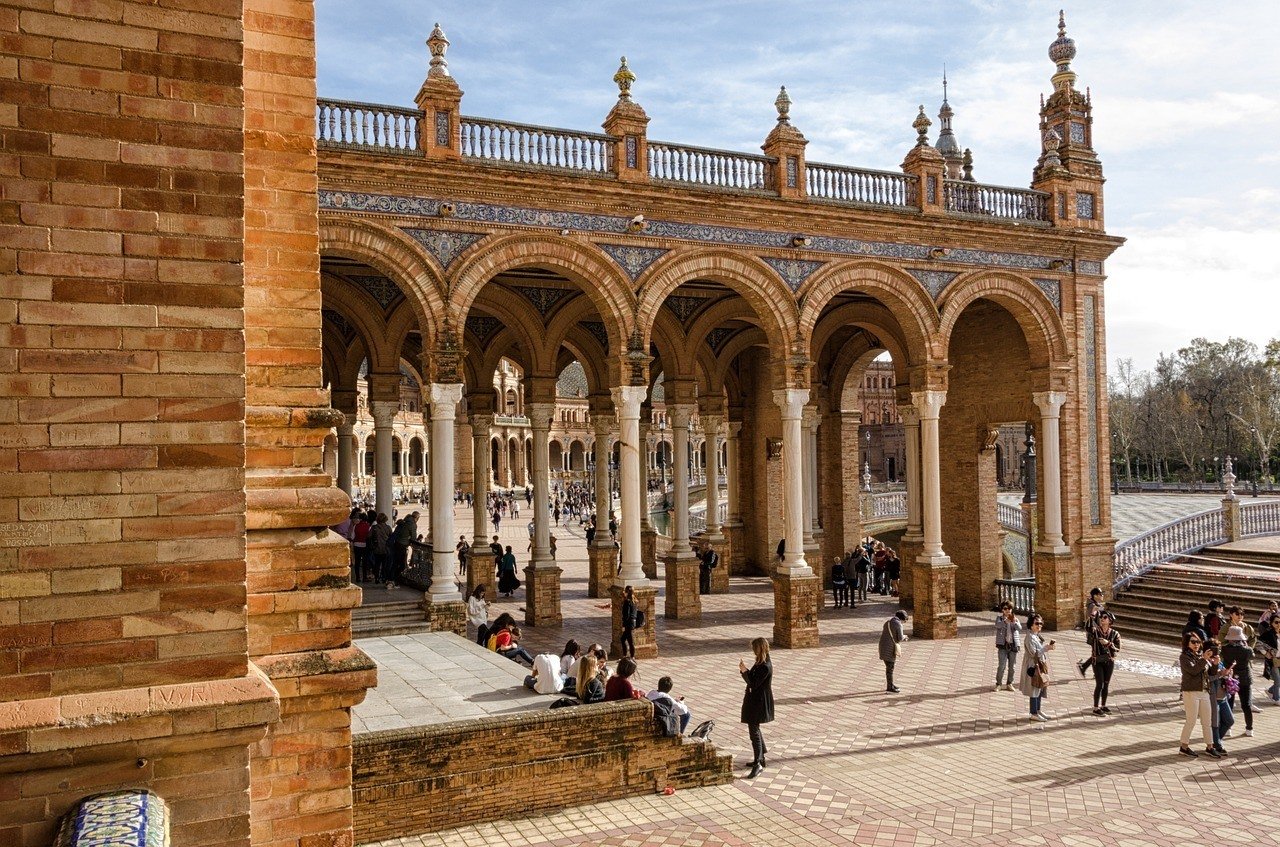
Triana and Los Remedios are the most trendy areas. They have tonnes of clubs, restaurants, and stores, making them full of fun and adventure! Despite the youthful atmosphere, it attracts people of all ages. Triana used to be a Roma neighborhood and remains energetic with flamenco clubs and bars. Los Remedios is very modern but quirky. It’s home to some of the best museums in Seville and some striking architecture!
The most popular neighborhood for visitors, though, has to be Barrio Santa Cruz. It’s the historic center of Seville that has most of the attractions on your Seville itinerary, such as the Seville Cathedral and the Real Alcazar. There’s a stylish, yet warm ambiance to this area. Narrow, cobblestoned alleys bypass towering Moorish-era landmarks, while orange trees are scattered around historic squares.
For more information, read through our AMAZING guide on where to stay in Seville in 2 days.
Best Hostel in Seville – Black Swan Hostel Sevilla
When you talk about quality for money, this is the place you should have in mind! The central location is top-notch and the hostel has a warm, stylish atmosphere. Each bed comes with a large locker, a powerpoint, and a lamp. Additionally, the hostel is also committed to eco-friendly practices!
There are some more INCREDIBLE options for hostels in Seville!
Best Airbnb in Seville – Room in renovated villa
This 500-year old beauty of a house is one of our favorite Airbnbs in Seville . It has three stories and is full of Spanish history and character. The room is your own private area, but the whole house is yours to explore and enjoy. Sit in the courtyard garden and enjoy your tea or coffee while listening to the trickle of the fountain. Enjoy a restful bath after a long day exploring the town.
Cook a meal in the rustic style, well-equipped kitchen. Take in the beautiful sunshine and orange-blossom-scented air of Seville on the rooftop terrace. From the house, you are a short walk to the major sights, such as Catedral de Sevilla (4 min walk), Jardines de Murillo (4 min), Museo del Baile Flamenco (6 min), Iglesia del Salvador (9 min), and many others – ideal base for a Seville City break.
Best Budget Hotel in Seville – Hotel Plaza
Hotel Plaza has to be the best place to stay in Seville if you’re on a budget! It’s centrally located, just 100m from the Plaza Nueva in Old Town. The rooms are spacious and comfortable, with modern and clean bathrooms. These kinds of facilities will set you up for a wonderful vacation in Seville!
Best Luxury Hotel in Seville – Hotel Palacio De Villapanés
This breathtaking combination of modern luxury and traditional features is the absolute best place to stay in Seville! It’s a converted 18th-century palace in Old Town that really lives up to royal standards! There’s a lovely rooftop terrace with a plunge pool and an in-house restaurant serving Andalusian food.
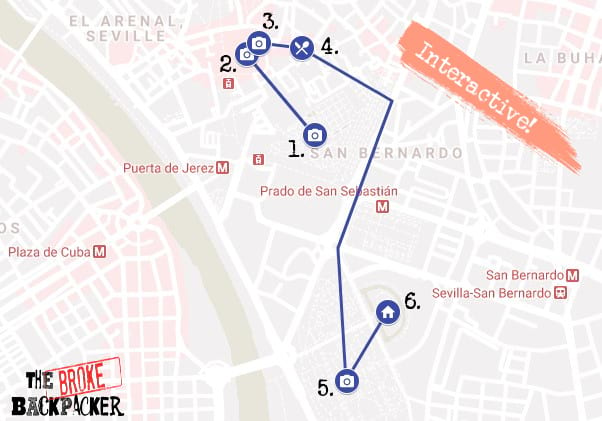
Today’s all about getting to grips with the most awesome Seville landmarks and soaking up the relaxed vibe of this city! With mosques that became cathedrals and colorful Moorish tiles giving way to Renaissance marble, you’ll see how various cultures and periods have left their mark on Seville.
Today’s itinerary is a packed one. It is doable but we suggest starting early and paying to skip the line at Real Alcazar.
9:30 AM – Real Alcazar
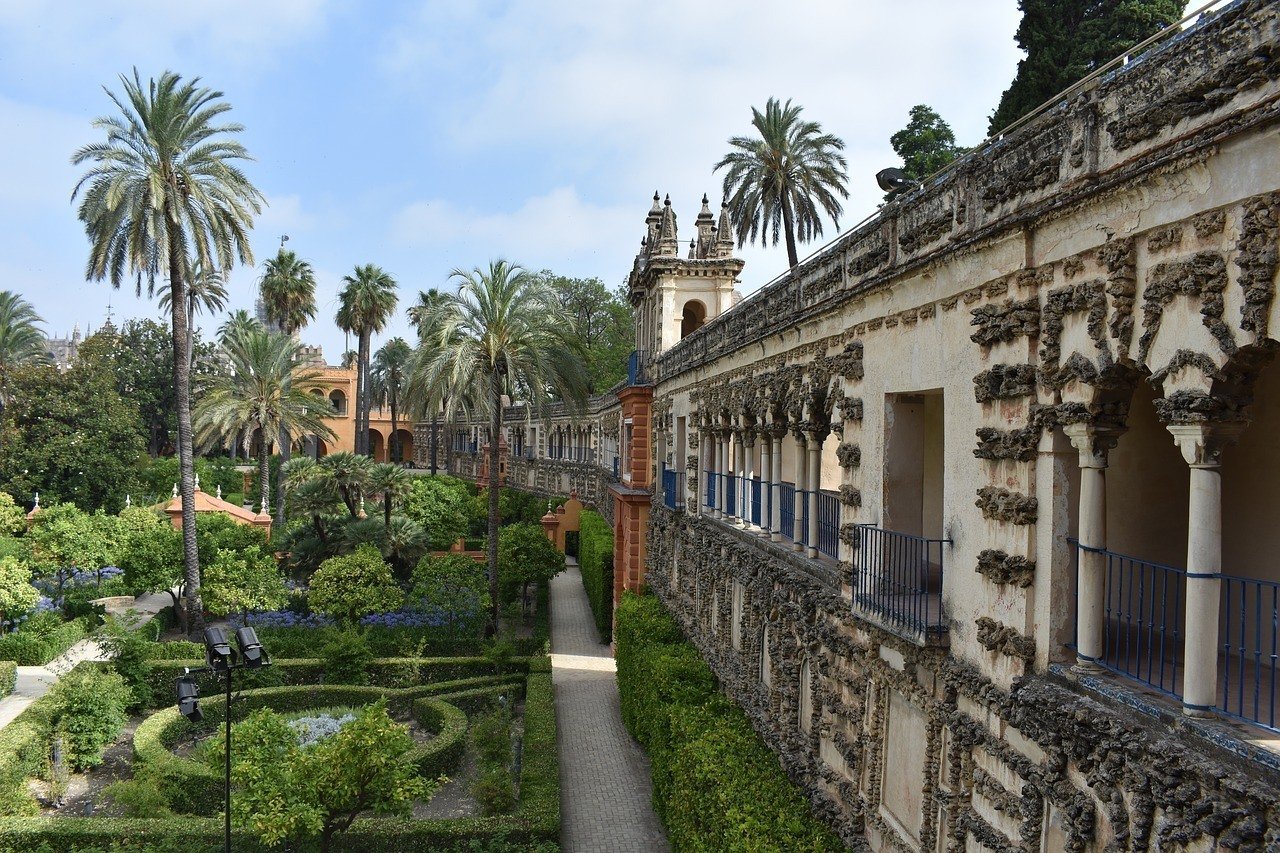
The Real Alcazar may be a historic site, but it is also one of sublime beauty! It was decorated with plasterwork, mosaics, and wooden coffered ceilings. These original features can still be seen, alongside Renaissance features. These include a tiled altar and a collection of tapestries depicting the Spanish conquest of Tunisia.
Be sure to find the dazzling Patio de las Doncellas, a courtyard renowned for its tiled pillars. Another beautiful courtyard is Patio de las Muñecas which features various decorated capitals. At the end of your visit, linger a bit longer in the spectacular palace gardens which boast impressive water features! If you’re looking for Instagram-worthy shots, you’ll find them here!
Only 750 people are allowed inside the palace complex at a time and preference is always given to those who have booked ahead. Buy your skip-the-queue tickets online. It’s also advisable to book a guided tour or add the audio guide for $7USD as there isn’t much information provided inside the palace.
- Cost: $13 USD for general admission and an extra $5 USD for entrance to the royal apartments
- How Long Should I Spend Here? 2.5 hours if you skip the line
- Getting There – Metro Line M1 to Puerta de Jerez
12:00 PM – Seville Cathedral
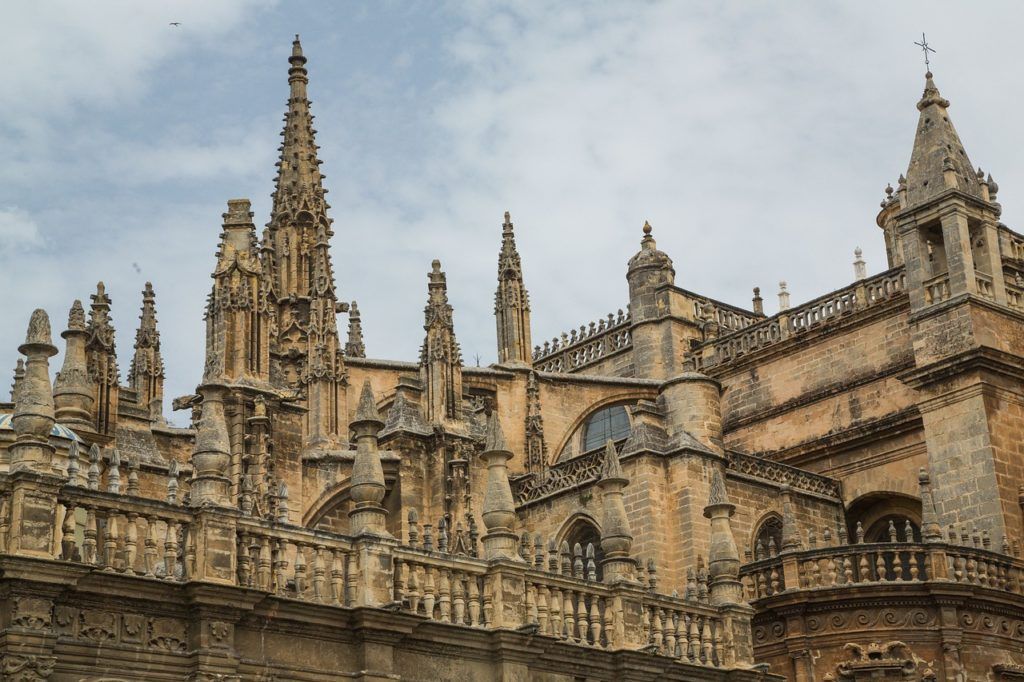
Seville Cathedral was originally a mosque until Islamic Seville was conquered by the Christian King Ferdinand III in the middle of the 13th century. He had the mosque converted into a church but the orange tree courtyard that you can visit today is a remnant of the original mosque!
The church was built in the Gothic style and was later renovated during the Renaissance and Baroque periods. The interior of the church is dark and spacious which gives it a serious hushed atmosphere! Your attention is immediately drawn to the dramatic vaulted ceilings and stained glass windows. One stained glass window, of the four evangelists, measures 9m and dates from the mid 16th century!
One of the highlights of the cathedral has to be the chance to visit Christopher Columbus’ tomb. That’s right, the great explorer’s here, too! His coffin is carried by life-size pall-bearers made of stone. It’s quite an impressive site!
In the Treasury, you’ll be left breathless by the sheer extravagance of the items, if not their beauty! Gold, silver, rubies, diamonds…you name it, it’s all here!
- Cost: $10 USD
- How Long Should I Spend Here? 1 hour will be plenty
- Getting There – It’s a 4 minute walk from the Alcazar
1:00 PM – La Giralda Bell Tower
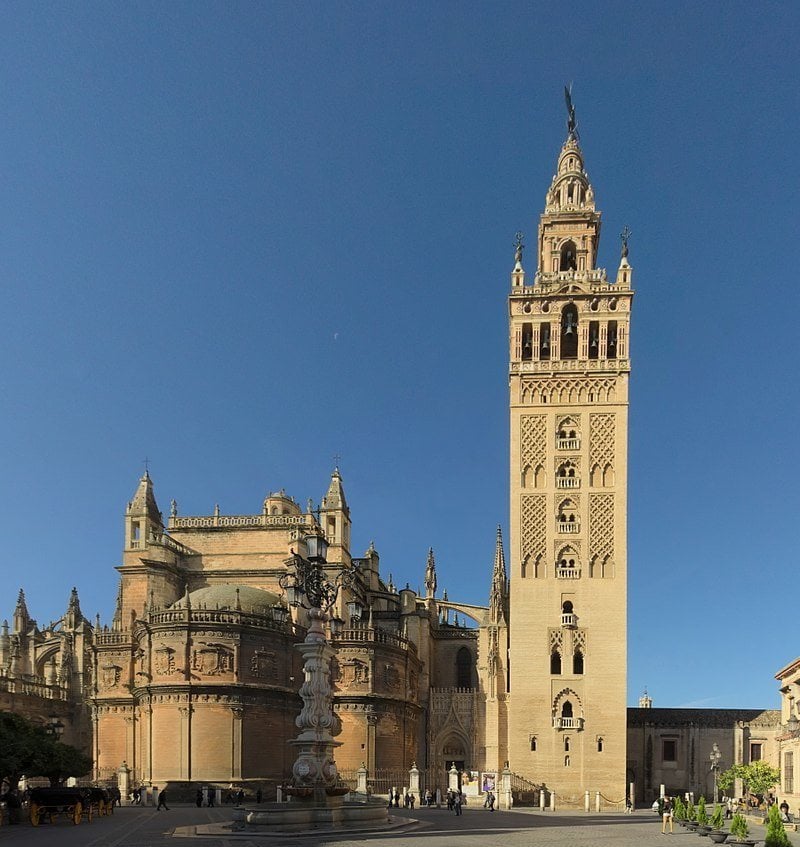
La Giralda was originally built in 1195 as the minaret of the Aljama Mosque but was later converted to Seville Cathedral’s bell tower. At 103m tall, it was the tallest building in Seville for over 800 years!
Look closely (perhaps with a camera zoom!) at the weather vane on the top of the tower. This is where this Seville landmark gets its name: girar means “to turn” in Spanish. This statue, called El Giraldillo, represents faith. It’s now a UNESCO World Heritage Site!
Walk up the bell tower for spectacular views of Seville attractions and the cathedral’s architecture! Don’t be daunted by its height there are ramps inside which allow for a fairly comfortable ascent! The Giralda Tower is a marvel.
- Cost: Admission is included in the $10 USD fee for the cathedral
- How Long Should I Spend Here? 30 minutes
- Getting There – It’s next door to the Cathedral
2:00 PM – Lunch!
Just behind the cathedral you can’t miss the winding cobbled streets. Take some time explore this quaint area and duck in to a some of the boutiques and souvenir shops. You will also notice the fine aromas drifting out of the many cafe’s and taperia’s. Presuming you have worked up an appetite by this point in the day, sick one and dive in for some delicious lunch.
In case you need more specific direction, then I suggest yummy montaditos, small local sandwiches, at Bodega Santa Cruz. Go easy on the vino though as we still have more cool stuff to see! If it’s your first time in Seville then the culinary scene will blow your mind.
3:00 PM – Parque de Maria Luisa
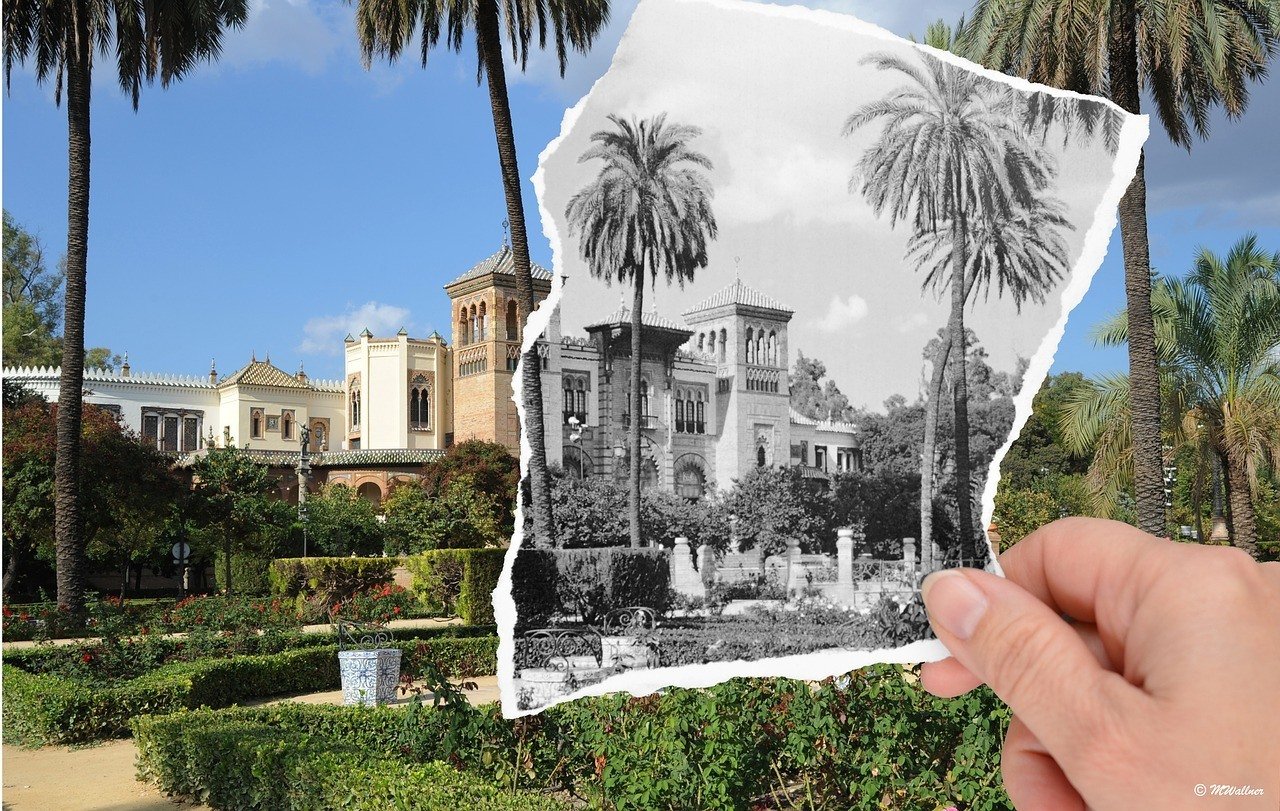
Alongside the meandering Guadalquivir River, French architect Jean-Claude Nicolas Forestier cultivated a lush public park to be the setting for the Ibero-American Exhibition in the early 20th century. The exhibition was intended to boost morale following the loss (of independence) Spanish colonies suffered by promoting the Andalusian industry. Times have since changed but the Parque de Maria Luisa does remain a cheering stop on any Seville itinerary!
The expansive park is perfect for a Seville walking tour of your own! There’s a pleasant, relaxing atmosphere as you stroll beneath the orange and palm trees beside the river. Be sure to find the statue of Miguel de Cervantes, the author of Don Quixote who was imprisoned in Seville, on the Plaza de America.
Bypassing colorful flowers, choose your favorite tiled bench or pavilion for a short rest to appreciate the gushing of nearby water features. Sit back and relax as one day in Seville begins to wind down. If you’re really looking to add some indulgence to your Seville itinerary, hail a horse-drawn carriage!
- Cost: Free!
- Getting There – Walk here – It’s 15 minute walk from the lunch stop
4:30 PM – Plaza de Espana
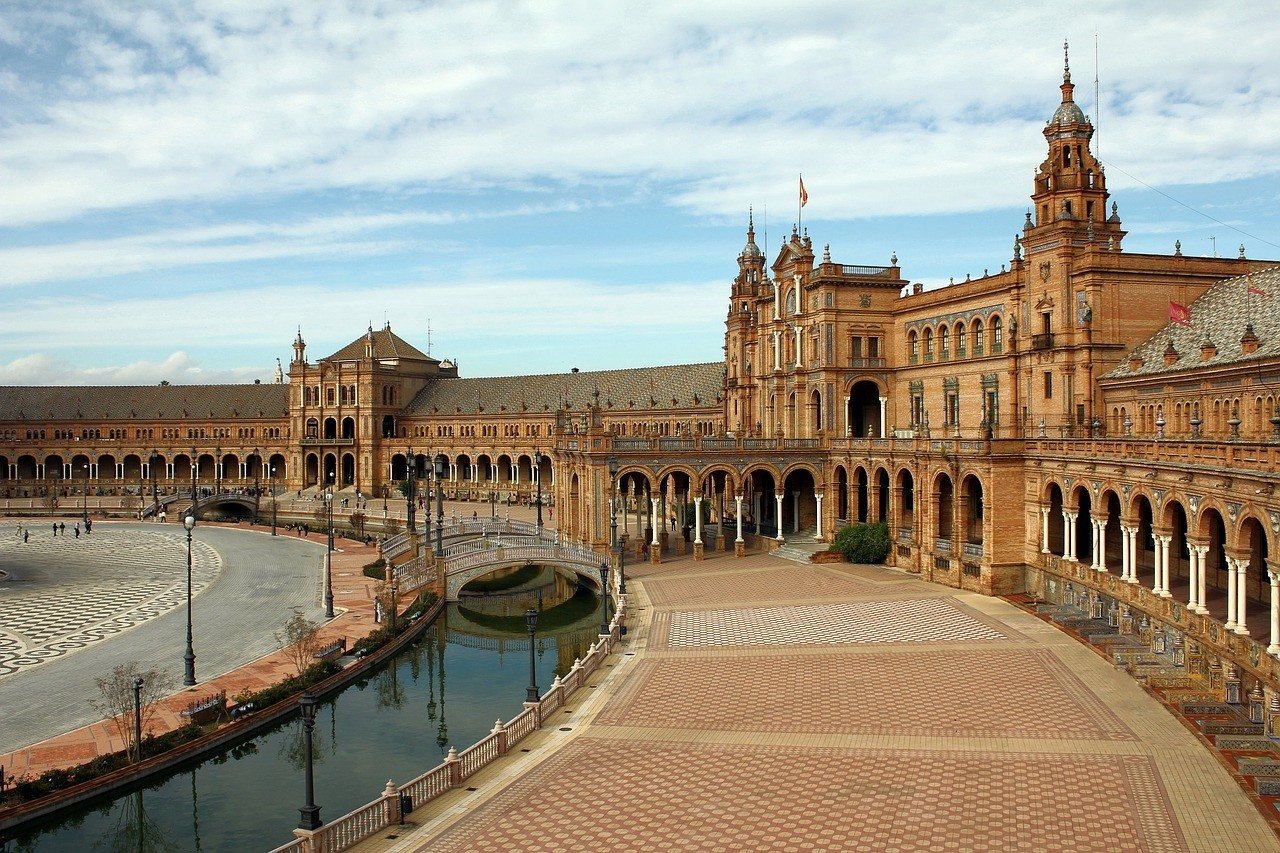
It may sound like a public square but Plaza de Espana is actually the monumental building you see in the midst of the Parque de Maria Luisa. It’s such an iconic landmark that you cannot travel to Seville without a visit here!
The monument may look centuries-old but it was actually only built in 1929 as the centerpiece of the Ibero-American Exhibition! It was designed to showcase Spanish accomplishments to the world.
Around the building is a moat on which visitors can row hired boats. There are four bridges crossing the water, each representing the old kingdoms of Aragon, Castille, Leon, and Navarre. 48 pavilions represent the 48 provinces of Spain. These are decorated with ceramic tiles to display Spanish craftsmanship.
This monument has since doubled as a film set and you may recognize it from Lawrence of Arabia or Star Wars: Attack of the Clones ! Regardless, it should definitely be on your Seville itinerary as a leisurely visit to it is one of the most pleasant things to do in Seville, Spain!
- Cost: Free admission; $6 USD to hire a rowing boat for 45 minutes
- How Long Should I Spend Here? 60 – 90 minutes
- Getting There – Walk here – It’s 15 minute walk from the park

Wanna know how to pack like a pro? Well for a start you need the right gear….
These are packing cubes for the globetrotters and compression sacks for the real adventurers – these babies are a traveller’s best kept secret. They organise yo’ packing and minimise volume too so you can pack MORE.
Or, y’know… you can stick to just chucking it all in your backpack…
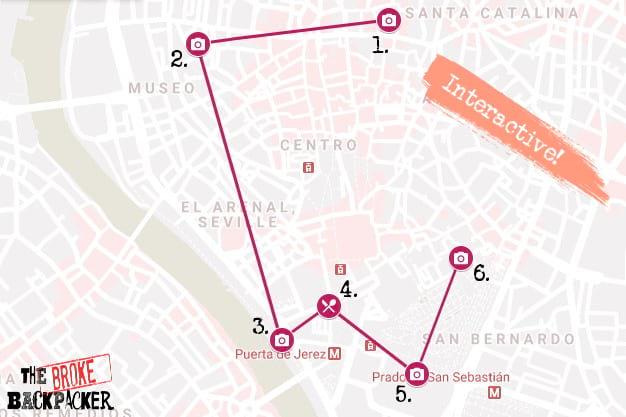
With our itinerary in Seville, it’s time to admire some more city views and to get up close to the cultural arena. You heard right, it’s Flamenco time!
10:00 AM – Metropol Parasol
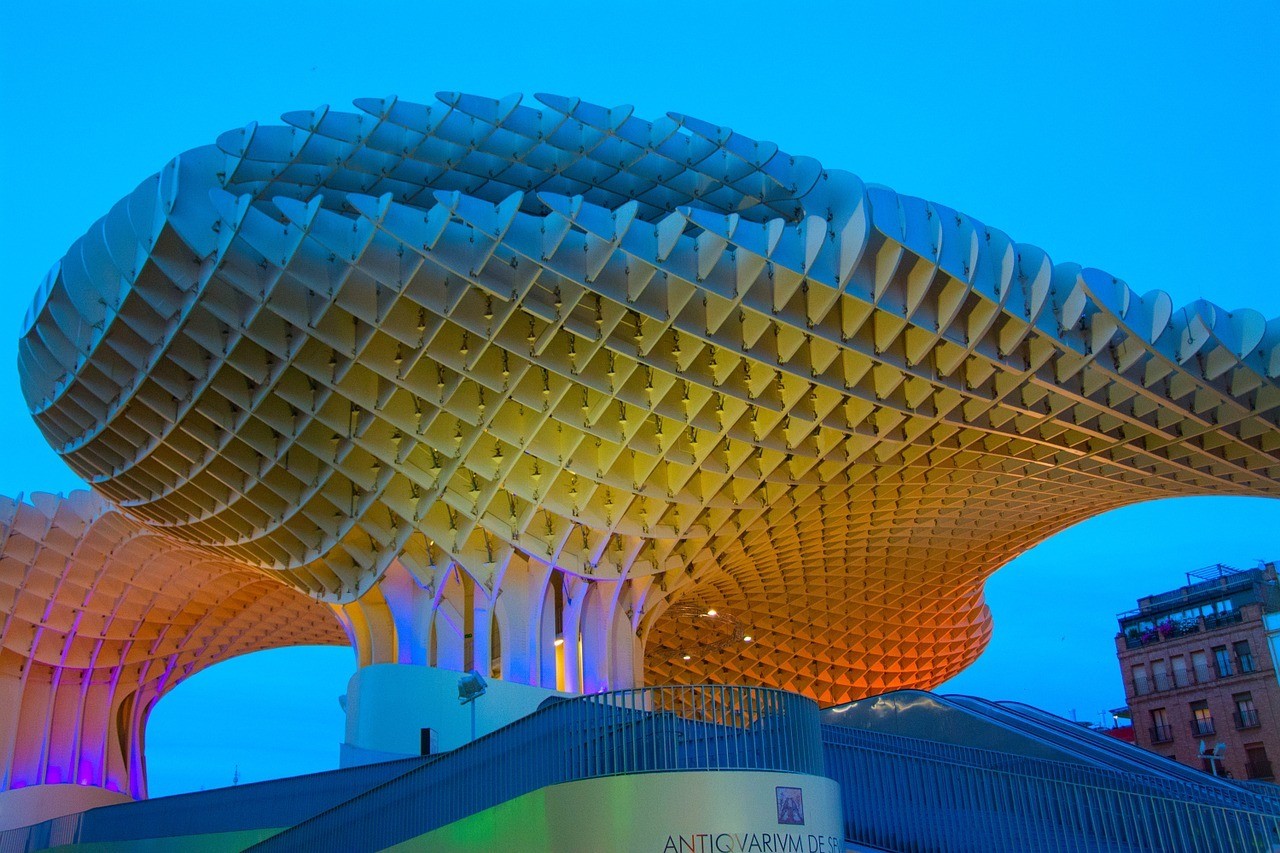
As thoroughly modern as the Seville cathedral is ancient, Metropol Parasol should be out of place in the historic Old Town. Somehow, though, it manages to fit right in! Its purpose is to provide shade but it’s also a popular monument in its own right that is a must see in Seville in 2 days.
It was designed by German architect Jürgen Mayer and completed in 2011. Ever since, Las Setas (The Mushrooms), as the locals call it, has been dividing opinion over whether it should even exist! You’ll likely be convinced of its worth, though, as soon as you take the elevator to the top level of the structure. The panoramic views are a highlight of any two-day itinerary in Seville!
On the ground level, Roman ruins and mosaics that were discovered on the site are housed in the Antiquarium of Seville.
- Cost: $3 USD
- How Long Should I Spend Here? 60 minutes
- Getting There – Walk here
11:30 AM – Museum of Fine Arts

Spain’s been home to some of the world’s most famed artists in history and with two days in Seville, it’s time you paid homage to some of their masterpieces! The Museum of Fine Arts was founded in 1835, and many think that the location alone is worth the entrance fee!
The museum houses a substantial collection of art from the Golden Age of Spanish painting in the 17th century. The most magnificent ones are hung in the former church. The star artist of this collection has to be Bartolomé Esteban Murillo. Look out for his Immaculate Conception which is a prime example of the physicality that’s typically present in Baroque art. Another luminous work of his is Saint Anthony of Padua with the Child .
Diego Velázquez, one of the most famous Spanish artists , was a local of Seville. Many of his early works can be found in the museum, most prominent of which is Don Cristóbal Suárez de Ribera .
As if that’s not enough, Spanish masters El Greco and Goya also have paintings here! If you have a weekend planned in Seville, Spain, this is a must-see!
- Cost: $2 USD
- Getting There – It’s a 20 minute walk from Metropol
1:00 PM – Torre del Oro
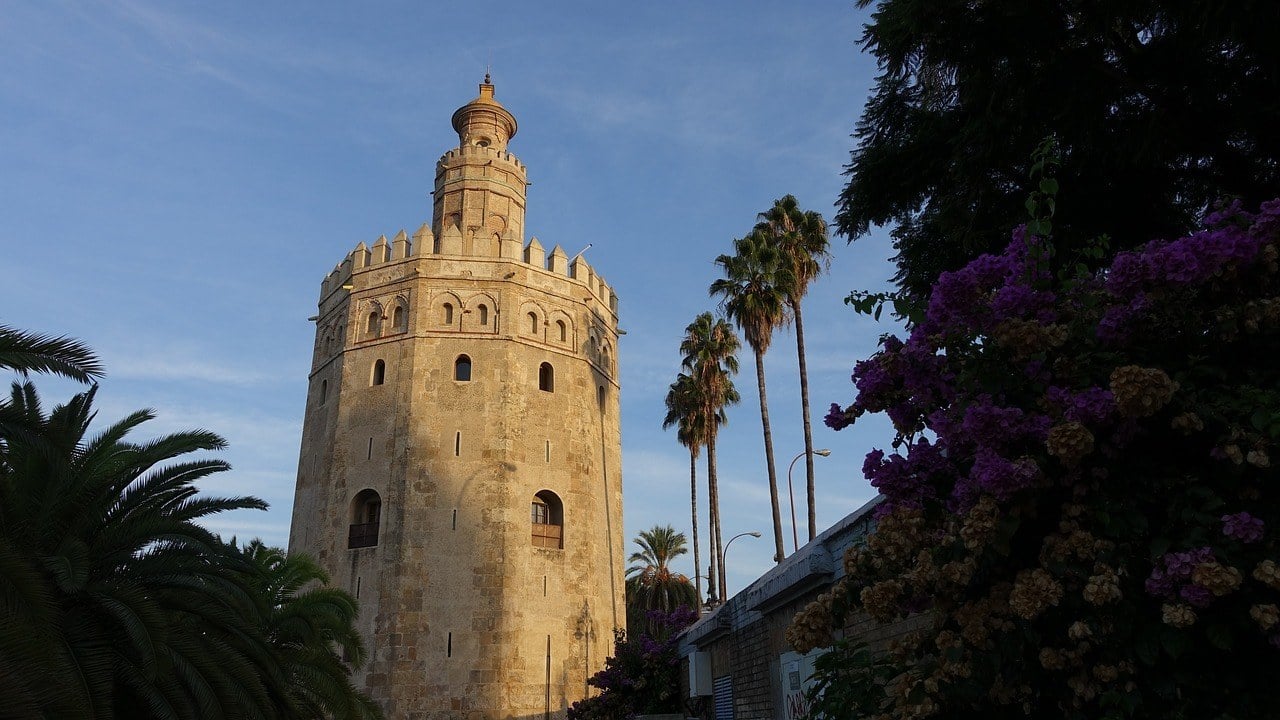
Torre del Oro means “Golden Tower” but this ancient landmark in Seville, Spain, is made of the usual brick! It was, however, coated in a mortar which, when hit by the sun, gave off a gold color. Sadly, this can no longer be seen but there are other treasures at the Torre del Oro!
Like so many Andalusian monuments, Torre del Oro shares both a Moorish and Spanish past. The tower was originally built under the rule of the Muslim Almohad dynasty as a part of the defenses along the Guadalquivir River. It was later conquered by the Christian Spanish. It suffered significant damage from an earthquake in 1755 and was restored by the passionate pleas of locals.
Today it houses the Naval Museum of Seville. There’s an exhibition on the history of the tower but the focus is on Spain’s glorious naval history. The rooftop terrace also boasts some of the best city views you’re likely to see while on your Seville itinerary for two days!
- Cost: $3 USD or free on Mondays.
2:00 PM – Lunch at Restaurante La Casa del Tesorero
By now you should be hungry. Happily, there are plenty of places to eat near to our destinations. These range from Burgee King & The Hard Rock cafe all the way to the sublime, Italian gem that is La Case del Tesorero. The risotto’s are not to be missed.
3:00 PM – Royal Tobacco Factory
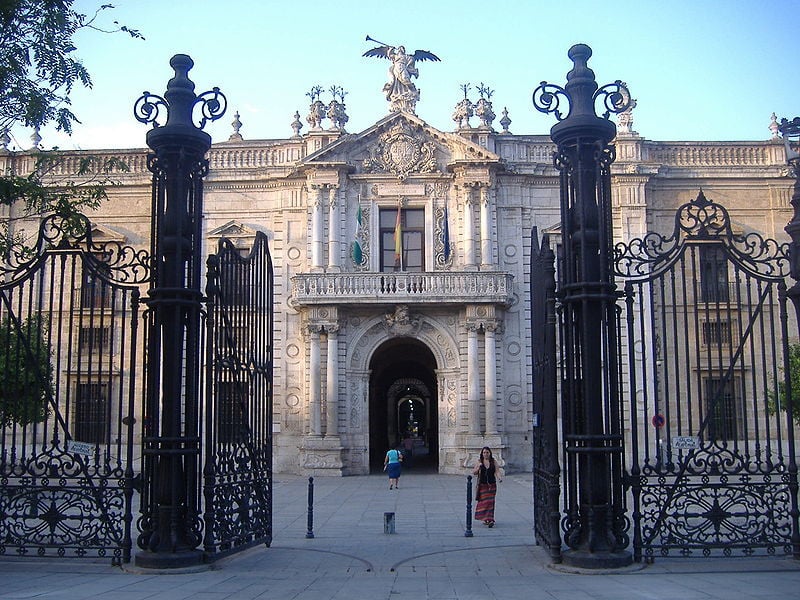
It may seem like an unusual attraction to put on your itinerary but trust us when we say you’ll regret it if you don’t visit the Royal Tobacco Factory! It was Spain that introduced tobacco to Europe in the 16th century and the demand just kept growing. The factory even expanded to such an extent that it was the second largest building in the country! 75% of all cigars sold on the continent were produced here!
This is one of the most popular Seville attractions because of the beautiful architecture. It resembles a fortified palace, with a dried moat on three sides of the building. This was necessary since tobacco was such a valuable commodity. There was even a prison for tobacco smugglers!
The factory is also known as the setting of the opera Carmen where the leading character works and falls in love with a guard!
The tobacco factory was moved in the 1950s and today the building is home to the Hispalense University.
- How Long Should I Spend Here? 60 minutes is plenty
6:00 PM – Flamenco Dancing & Dinner
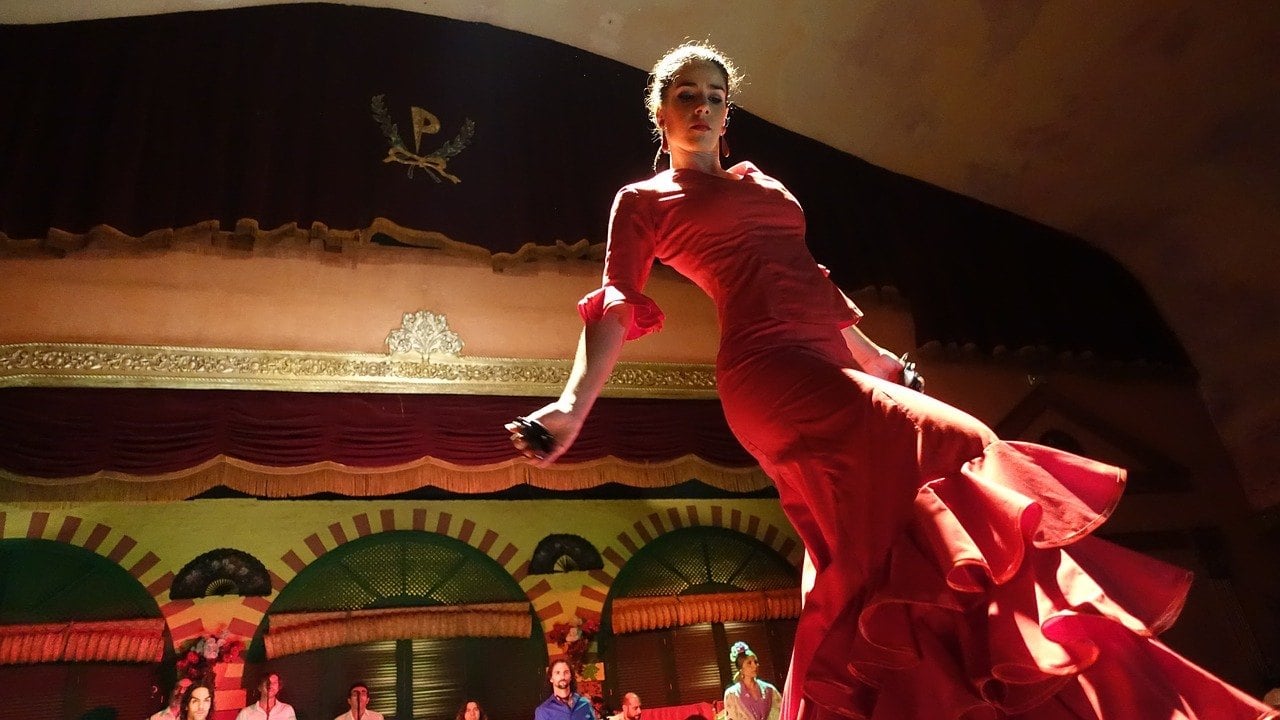
Flamenco originated in southern Spain and Seville offers visitors some of the best Flamenco dancing in the world! Originally, Flamenco involved only singing but it has since involved to include guitar and the flamboyant dance that’s loved around the world! Don’t fall for just any Flamenco show, though; make sure to follow our recommendations for an unforgettable celebration! This is one of the definitive things to do in Seville in 2 days.
Our favorite tablao has to be Los Gallos Tablao Flamenco. It’s one of the oldest in the city and is situated in a historic traditional house. This only enhances the authenticity of the Flamenco experience! For a modern twist, there are plenty of cocktails and sangria!
Casa de la Memoria is another sure bet for an epic Flamenco experience while touring Seville! The intimate environment is the setting for two shows daily and no day brings the same show! For those interested in learning, there are guitar and dance classes in Flamenco.
- Cost: Around $21 USD
- How Long Should I Spend Here? 2 – 3 hours
- Getting There – It depends which venue you choose
If you have 3 days in Seville or more, then there are a lot more must see’s. Let’s look at what to do with three days in Seville.
Archaeological Museum
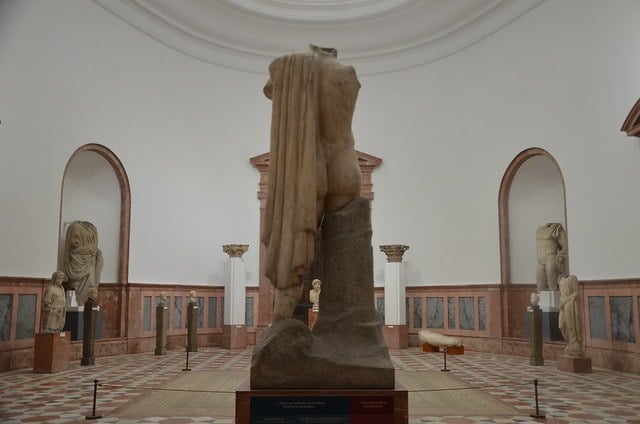
This airy building allows its various antiquities to speak volumes to an often mesmerized audience. The Phoenicians, Greeks, and Romans were all settlers of what is now Seville. Although the history of the area is traced through archaeological discoveries, the Roman period is the most well-documented.
Most of the Roman objects come from the nearby site of Italica. Look out for the Ecija Mosaic which dates from the 3rd century BCE! There are also sculptures of Emperors Trajan and Hadrian who were born in the region.
The Treasure of Carambolo is another popular collection in the museum. This dazzling collection replicates Phoenician gold artifacts made around 650 BCE!
Museo Palacio de la Condesa de Lebrija
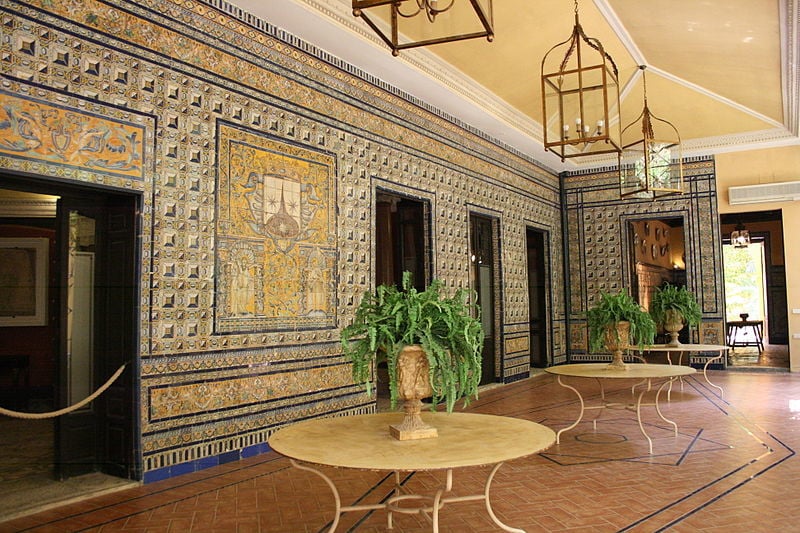
Merging Roman mosaics with Renaissance masonry, this palace is one of the most charming places to visit in Seville!
The ground floor houses the countess’ Ancient Rome collection which includes some of the best-preserved mosaics in Spain! The masterpiece of the palace is the Pan mosaic which awes visitors with its size. There are also marble statues and Etruscan ceramics.
To see the upstairs, you have to join a guided tour that’s included in the price since the family still use these rooms from time to time. It’s totally worth it for the chance to see Arabic, Baroque, and Spanish-style rooms! A bit of family history is also on display in the form of jewels and military medals.
Casa de Pilatos
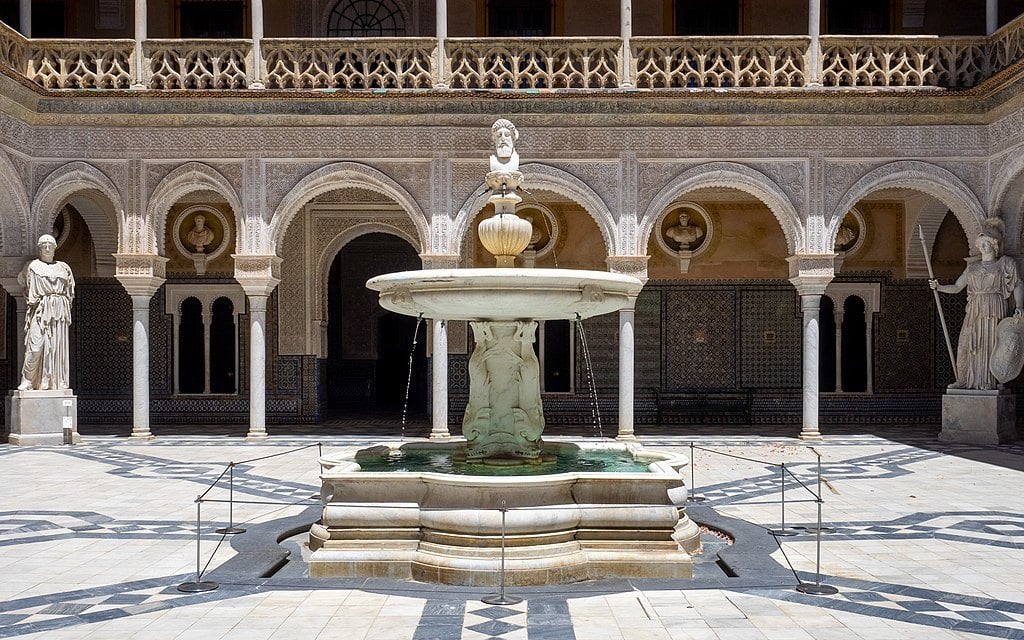
This large private residence was built between the 15th and 16th centuries for an Andalusian mayor after his pilgrimage to Jerusalem. His revitalized piety was the inspiration for much of the house’s decor!
As time went by, the family expanded the palace and today it offers prime examples of the different architectural styles that have influenced Seville.
Make sure to visit the Chapel of Flagellation which is considered to be the oldest room in the building. Although it’s a chapel, it often gives the impression of being a mosque or a pagan temple due to the intricate mosaics and Roman sculpture on the altar!
The Casa de Pilatos was the first private house in Seville to have a staircase. It’s situated beneath a magnificent dome and is a stunning representation of local craftsmanship!
Visit Triana
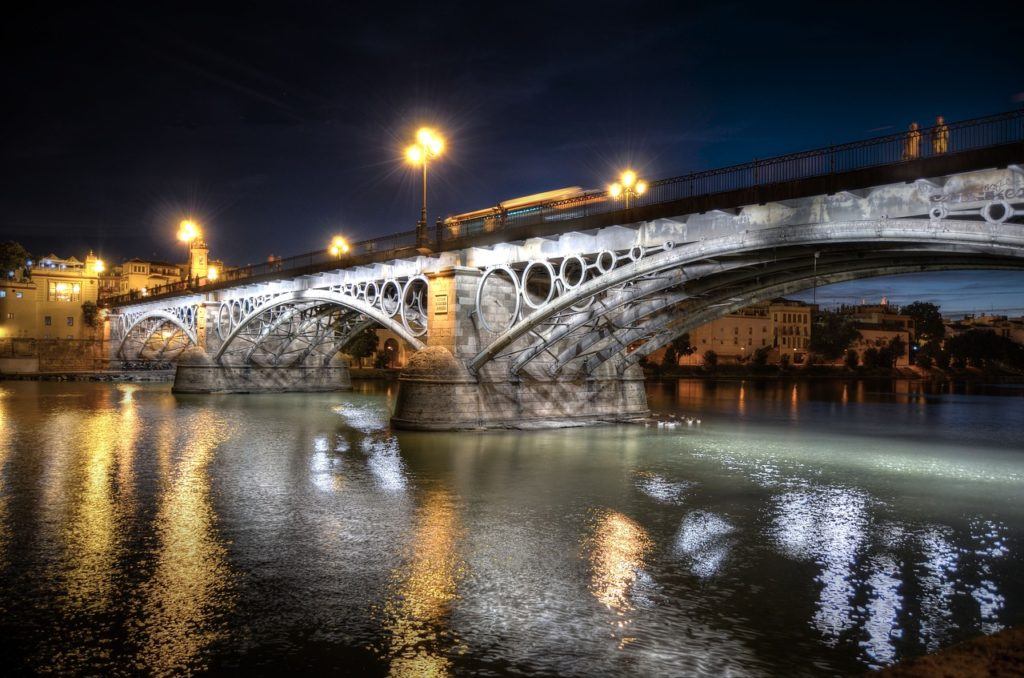
Start your Seville walking tour of Triana by crossing the Isabel II Bridge over the Guadalquivir River from Old Town. You’ll find yourself in Plaza Altozano. Here, a statue of local bullfighter Juan Belmonte stands before images of Virgin Mary painted on colorful buildings.
Triana’s home to a centuries-old ceramics industry due to the abundance of clay along the Guadalquivir River. It started with the Romans and flourished under the Moors who invented the azulejo, the little tile that used decoratively in nearly every grand building in Seville.
The business has since dwindled but there’s a lovely museum that continues to honor the craft. Centro Cerámica Triana not only documents Triana’s ceramic industry but also explains how various tiles were made. The city’s finest tile shop, Ceramica Santa Ana, is just next door. Having been in business for over 150 years, there’s not much chance of you leaving empty-handed!
Much of Triana’s historical population was Roma who would gather in communal courtyards forfestivities. When people say Flamenco came from Seville, it’s this tradition that they’re talking about! Triana has produced many brilliant Flamenco artists so pull up a chair and order a drink if you hear the music from a nearby bar!

Stash your cash safely with this money belt. It will keep your valuables safely concealed, no matter where you go.
It looks exactly like a normal belt except for a SECRET interior pocket perfectly designed to hide a wad of cash, a passport photocopy or anything else you may wish to hide. Never get caught with your pants down again! (Unless you want to…)
The weather in Seville, Spain, is generally quite lovely: think blissfully warm summers and mild winters. If you want to know when to visit Seville , bear in mind that the city’s sometimes called “the City for all Seasons” due to the mild climate!
Its inland location means that it’s one of the warmest cities in Europe. Come winter, many northern Europeans flock to the city, for this reason, Seville is seldom deserted.
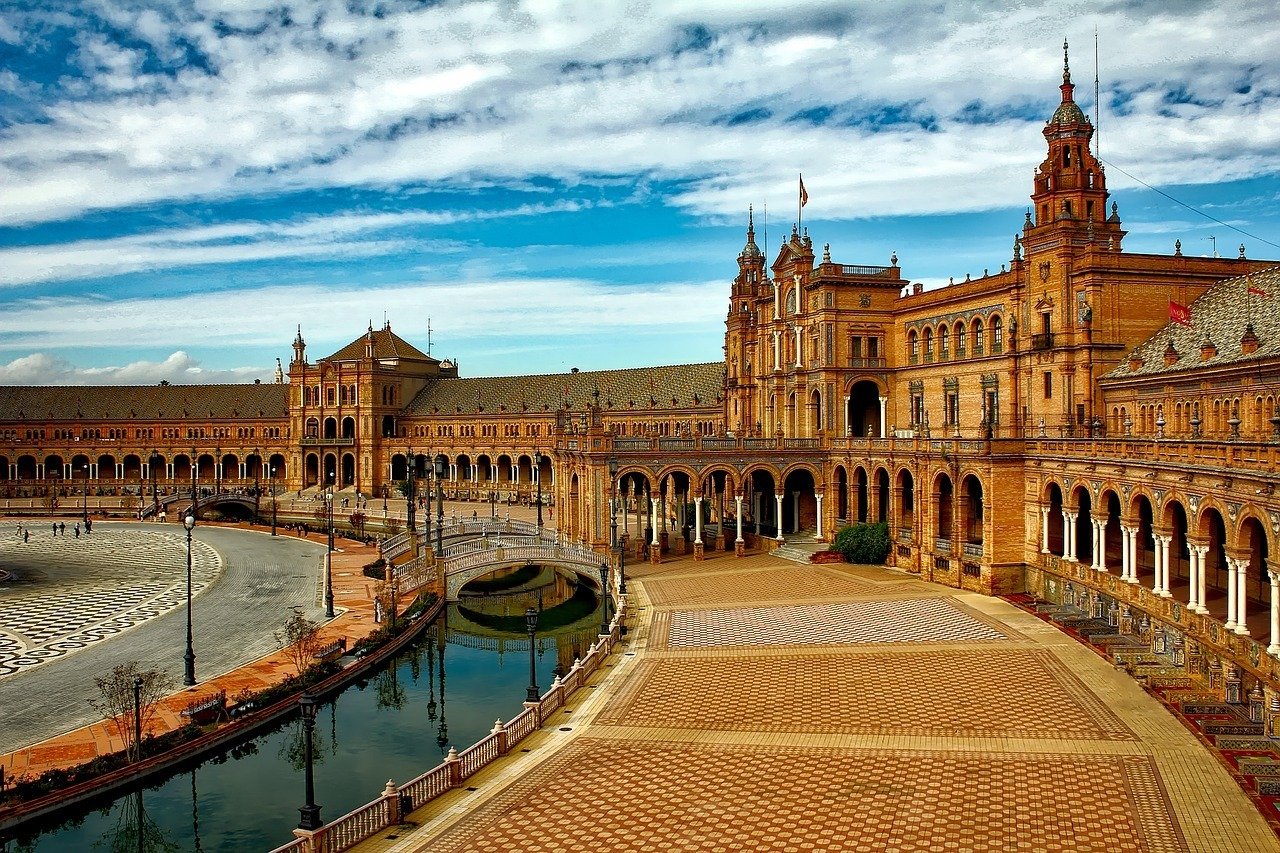
Peak season tends to run from April to August, although July and August can be unbearably hot. Things calm down in winter, except around Christmas festivities. When Easter falls at the end of March/beginning of April, the Semana Santa (Holy Week) and the Feria de Abril (a spring festival) cause crowds to swell and so do prices.
So, when should you visit Seville? Try to plan your trip to Seville so that you’re there in spring when the crowds aren’t too dense and the weather is pleasant!
Need a place quick? Here’s the best neighborhood in Seville
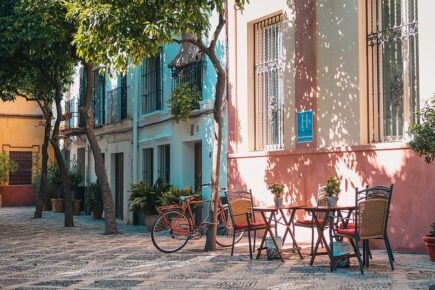
Santa Cruz is one of Seville – and Andalusia’s – most iconic neighbourhoods and one of the best area to stay in Seville. It is home to Seville’s most famous attractions, including the Real Alcazar, Seville Cathedral and the Plaza de Espana.
- Marvel at the Cathedral of Saint Mary of the See (the Cathedral of Seville), an impressive Roman Catholic cathedral.
- Climb to the top of Torre Giralda and take in the incredible views of the city.
- Explore the exceptional Real Alcazar, one of the finest examples of Moorish architecture in Spain.
Adding to the charm of your Seville itinerary, you’ll have to get around on foot for the most part! The abundance of tight alleyways and one-way streets make driving such a nuisance that few tourists bother to put up with car rentals. If you do, you’ll find the usual array of Avis and Europcar at the airport. Be warned, though, that parking is a nightmare unless your hotel comes with a garage!
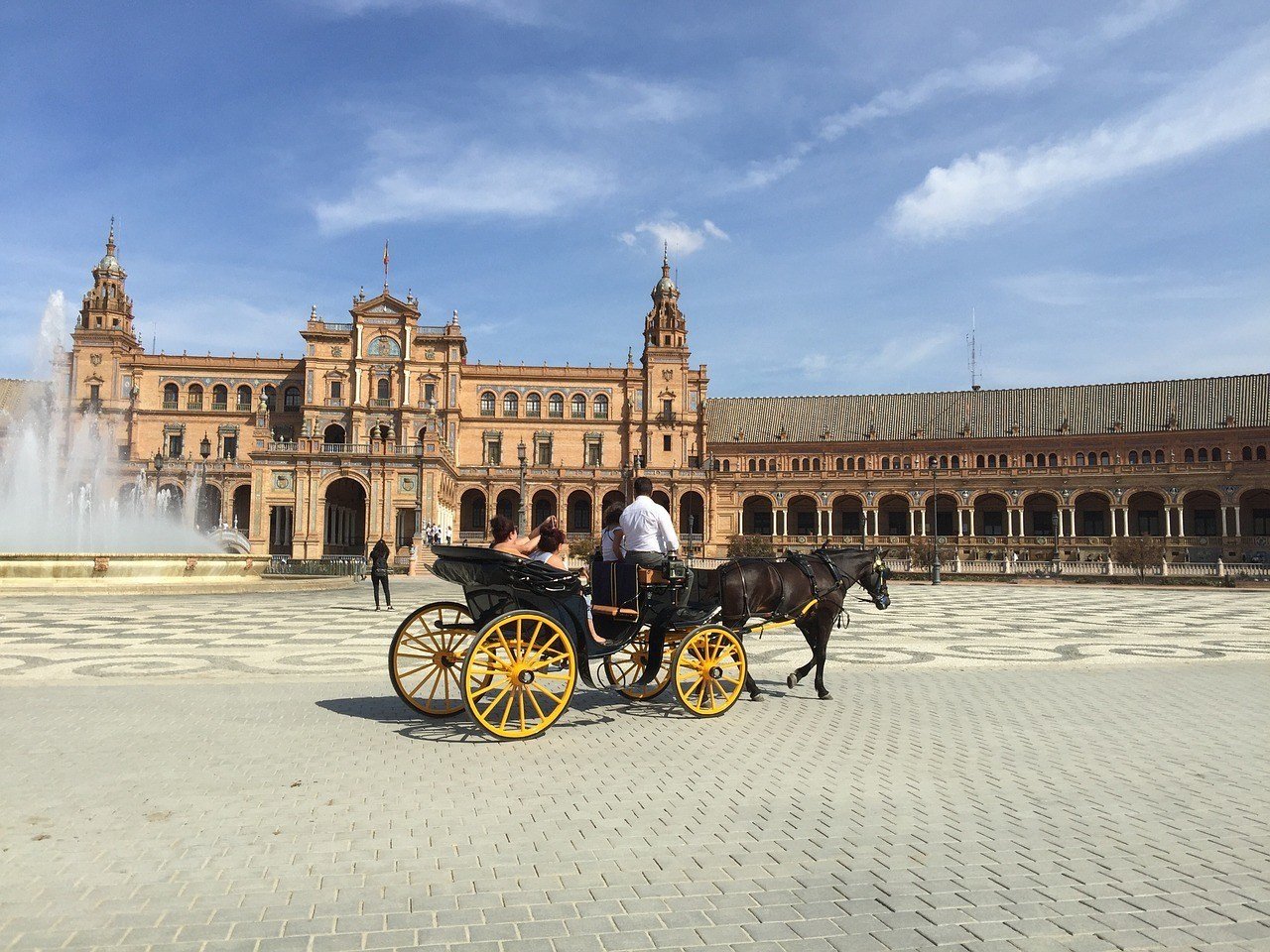
On the rare occasion that you can’t walk to an attraction on the Seville itinerary, turn to the city’s bus network. Tickets can be bought at stations, kiosks, or on the bus. It’s USD $2 for a standard ticket, but it’s more cost-effective to purchase a three-day pass for USD $12. This will cover all your transport needs as you hop around and wonder what to do.
Taxis are another reliable option to get around the city. You’ll find them across the city. It’s a flat rate of $29 from the airport to the city center.
Don’t worry too much about safety when planning a trip to Seville! There’s generally little violent crime but there are common scams and pickpocketing that you should watch out for.
When you’re in crowded places like the Seville Cathedral or the Real Alcazar, keep your valuables close to your person. Forget your back pockets and only use your front pockets. Avoid deserted ATMs that look broken – they may be rigged to steal from you. These are just a few of our tips that will keep you safe on your Seville itinerary.
To prevent being completely stranded if you are robbed, keep copies of all your important documents, like your passport, apart from the originals.
It’s also common for women to give you rosemary, offer to read your palm and then demand money. It’s rather a hassle, so say ‘no’ upfront if you’re not into it.
Don’t Forget Your Travel Insurance for Seville
ALWAYS sort out your backpacker insurance before your trip. There’s plenty to choose from in that department, but a good place to start is Safety Wing .
They offer month-to-month payments, no lock-in contracts, and require absolutely no itineraries: that’s the exact kind of insurance long-term travellers and digital nomads need.

SafetyWing is cheap, easy, and admin-free: just sign up lickety-split so you can get back to it!
Click the button below to learn more about SafetyWing’s setup or read our insider review for the full tasty scoop.
Find out what people want to know when planning their Seville itinerary.
What should you include on a Seville 3 day itinerary?
Don’t miss out on these top Seville highlights: – Plaza de España – Metropol Parasol – Seville Cathedral – Real Alcazar
Where should you stay if you have a full Seville itinerary?
Home to great accommodation options and many top attractions, Santa Cruz is the ideal base for exploring Seville.
What are some unique things to do in Seville?
Seville is full of awesome things to do. Check out the Tobacco Factory, walk up La Giralda Bell Tower, and enjoy an original Flamenco show.
When is the best time to visit Seville?
March-May are the best months to visit Seville, offering great weather and smaller tourist crowds.
Seville revels in rich history which has both spectacular architecture and cultural traditions. From the lavish Real Alcazar to the soaring La Giralda Bell Tower, there are many beautiful sites to see this in Seville!
The magic of Seville, though, lies in its charming culture! Church bells ring out across squares and the iconic Flamenco clap calls many to the nearest bar. From the vibrant hues of Triana’s buildings to the abundance of flowers in the Parque de Maria Luisa, you’ll be struck by the volume of color.
As you eat your way through tapas and inhale the nutty Andalusian wines, you’ll often have views of the medieval cathedral or the modern cityscape. This kind of sensory experience is the real attraction that will make Seville your new favorite city! Start packing for Spain and book your accommodation.
Combining the rich history of Seville with its equally rich cultural scene is no easy task but our selection of what to do will make your trip as effortless as possible! For even more Seville inspo checkout this guide by The Spain Travel Guru !

And for transparency’s sake, please know that some of the links in our content are affiliate links . That means that if you book your accommodation, buy your gear, or sort your insurance through our link, we earn a small commission (at no extra cost to you). That said, we only link to the gear we trust and never recommend services we don’t believe are up to scratch. Again, thank you!
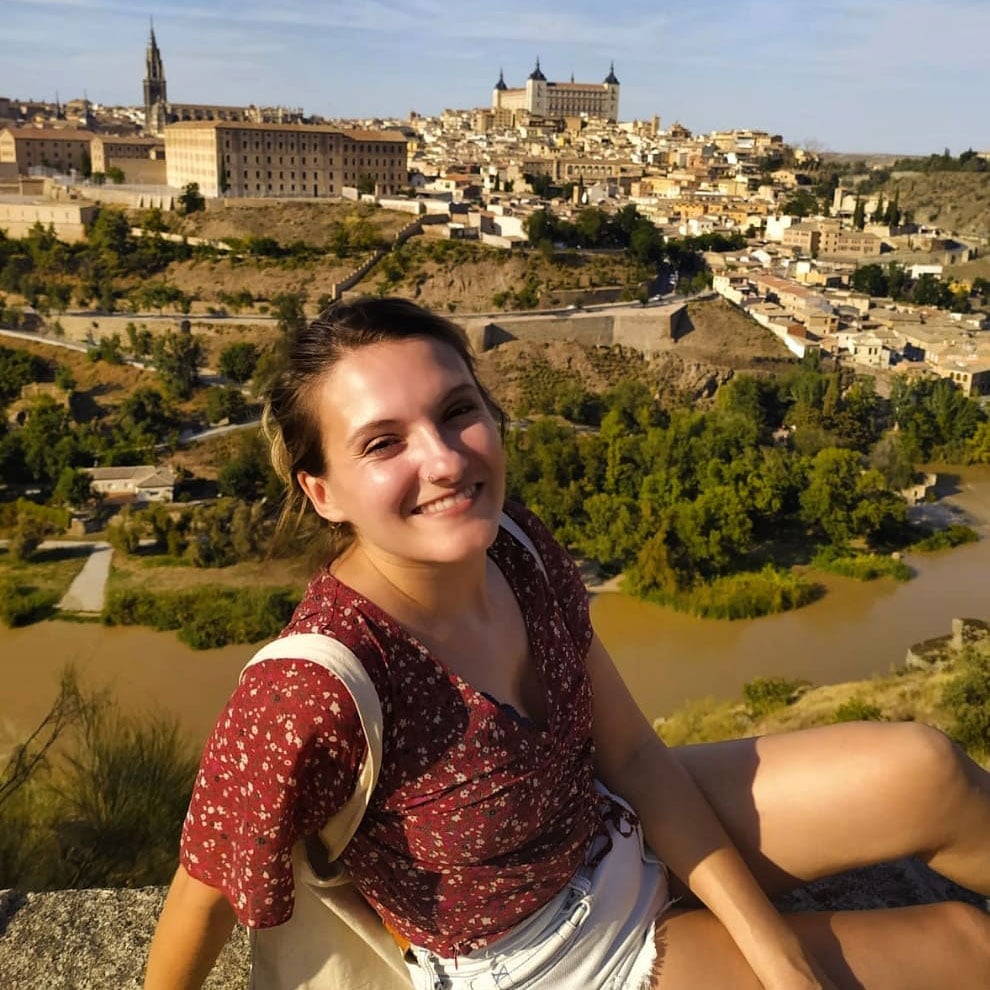
Mathilde Magnier
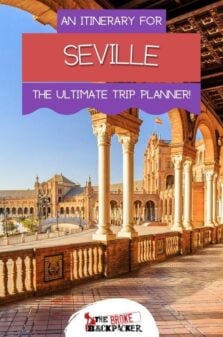
Share or save this post

Leave a Reply Cancel reply
Your email address will not be published. Required fields are marked *
Save my name, email, and website in this browser for the next time I comment.
Notify me of followup comments via e-mail.
The Ultimate Guide To Seville, Spain
Seville, located in the Andalusia region of Spain, is a charming city with incredible architecture, a rich history and a great food scene. There’s a host of wonderful things to do in Seville that are perfect for a long weekend city break.
In this post, I’ll share all the secrets and only the very best things to do for your next Seville trip including where to eat, drink and stay. I’ve travelled to this region of Spain several times and with the addition of a few up-market restaurants and hotels, not much has changed in 2024!
Find the hidden gems and epic roof terraces in my Ultimate Guide To Seville!
Why visit Seville?
With its jasmine-scented air, orange trees and magnificent monuments, Seville attracts visitors from all over the world and for good reason. For most of the year, you can sit in a sun-filled cobbled stoned square (even in January), enjoy traditional tapas, catch a flamenco show in the evening and immerse yourself in the vibrant culture, there’s a lot to see and do in Seville!
It’s one of the most appealing cities in Spain and probably one of the most affordable too when compared to other European cities. Seville also makes a great base for exploring other parts of Andalusia – in my opinion, the most attractive region in Spain – check out the best 7-day tours from Seville here .
Here’s what not to miss in Seville!

THINGS TO SEE & DO IN SEVILLE
Seville cathedral.
Seville Cathedral is the largest Gothic cathedral in the world and you’ll find it in the heart of the old town, its grandness is very hard to miss. Inside is just as spectacular, there are 80 chapels and many historical relics to explore. One of those is Christopher Columbus’s final resting place and you must also stop by the domed Chapter House to admire the paintings of Murillo, there is a great deal of history under one highly detailed Gothic roof!
GIRALDA TOWER
Don’t miss the Giralda Bell Tower climb (35 stairs, if you wondered) for epic panorama views over the city of Seville, it is well worth the effort. You can also book these queue jump tickets ahead of time, which will take you straight into the cathedral and includes the bell tower admission – it’s definitely one of the best things to do in Seville.
When to visit the Seville Cathedral?
A great time to visit the Cathedral is in the late afternoon – around 4pm, at this time there are fewer crowds and much better lighting.
REAL ALCAZAR PALACE
While the Cathedral might be the most striking landmark in Seville The Real Alcazar Palace is the most famous and wandering around it is one of the best things to do in Seville – despite the crowds it draws.
Discover intricate gold ceilings, gorgeous courtyards with colourful tiles, tall palm trees, fountains and exotic gardens as you walk from one attractive courtyard to the next. The restaurant’s terrace might be my favourite part of the whole experience, here you can take a coffee break with peacocks roaming the patio, so very dream-like.
Similarly to the Alhambra in Granada , the Real Alcazar is opulent, and decorative and shows many influences of Moorish Spain. Also, just like the Alhambra it draws a huge crowd and lines of people queuing to get in, to avoid a wait in the glaring sun, book your skip-the-line ticket here .

HISTORICAL GUIDED TOUR
If you’re looking for a historical guided tour of all three of the above main attractions; Cathedral, Giralda Tower, and Alcazar then I recommend this highly rated small group tour , you’ll get a private entrance and a local guide to show you where all the hidden treasures are in half the time! All three sights are just a short walk from each other, but there can be annoyingly long queues at each, if you don’t want to waste time, this is your best option.
Book: Seville: Cathedral, Giralda & Royal Alcazar Guided Tour
PLAZA DE ESPANA
Plaza de Espana next to Maria Luisa Park is another spectacular sight you cannot miss when visiting Seville. Created around a grande semi-circle with striking coral bricks and blue and yellow tiles, it’s a feast for the eyes.
Along the perimeter of the Plaza, you will find an emerald-green canal with fountains and bridges, there’s even paddle boats for hire if you wish to float your way around for a bit of fun. Most people just hang out here, take pictures, relax and have a breather from the bustling old town, sometimes there’s an impromptu (mini) flamenco show for entertainment as well – more on that below!
TIP! Arrive in time for sunset and take a walk through the lovely Maria Luisa Park on the way, at this time the sunlight will be beautiful, read this post for more sunset tips!

THE REAL MAESTRANZA
Seville’s bullring is a historic landmark dating back to 1762, it’s one of the oldest (and largest) in Spain and is just a short walk from Plaza de Espana. Bullfighting has a long-standing tradition in Spain and many of the cities have their own bullring, however, these days most are used for festivals or to showcase via a walking tour.
The Real Maestranza in Seville is I must admit pretty impressive, it is housed within a beautiful baroque building and the red and yellow colours are quite striking. If you’re looking to learn more about the culture of Spain and visit the museum, hop on a short guided tour – it’s run frequently throughout the day. You can also check out this guide for more Spanish Culture tips!
BARRIO SANTA CRUZ
Barrio Santa Cruz, also known as the medieval Jewish Quarter is the real heart of Seville and the most desirable area to walk around. A typical Spanish old town with a maze of winding cobbled streets and picturesque squares to lose yourself in.
The best thing to do is wander, find local tapas bars and enjoy a nice café latte in one of the pretty orange-filled courtyards, framed by the typical white and yellow houses of this region. Check out Plaza Alfaro and Plaza Dona Elvira, they are two of the best.
Historical sights in Barrio Santa Cruz:
- Rosina’s Balcony
- Casa de Murillo
- Palacio Duenas
- Casa de Pilatos

TAPAS FOOD CRAWL
Tapas hopping is the primary social event in Seville’s oldest quarter – Barrio Santa Cruz. There’s an overwhelming amount of beautiful restaurants, hole-in-the-wall places and traditional local haunts to take your pick from – and with such a variety, it’s hard to know where to start!
If you want to order more than a ham croquette staple and have a bit of fun doing so, then why not kick start your culinary adventures with a local guided tour with a few like-minded people? This highly rated small group tour will take you to three different neighbourhoods and markets in Seville.
Book: Seville: Tapas Crawl Tour
TRIANA NEIGHBOURHOOD
Exploring the local neighbourhood of Triana is one of the best things to do in Seville. Situated across the Guadalquivir, Triana is full of flavour and you’ll find some of the best local arts, crafts and ceramic stalls as well as authentic flamenco .
After exploring the streets you could go for an traditional bite to eat at Triana Market or check out the trendy Hotel Zenit rooftop terrace for a drink, it’s probably the most sleek in the whole of Seville!
SEVILLE FLAMENCO
One of the best experiences in Seville is spending an evening watching the live performances of enchanting musicians and flamenco dancers, it’s a must-do! Not all shows are the same, but one of the best options is a show at Casa de la Memoria – a very special little theatre dating back to the 15th century.
A good alternative is Los Gallos Tablao in the central historical district of Barrio Santa Cruz, watch the talented performers in an intimate venue and wonderful location. If you’re visiting in summer, the later shows are best.
HISTORICAL HOTELS
From former Palaces to stately Manors and luxury iconic stays, many wonderful historical properties in Seville have been converted into the most amazing hotels. Some of the best include dreamy courtyards, outdoor patios, roof terraces, traditional Andalusian tiles, arches and original ceiling beams – all the Old World character you could wish for!
Hotel Alfonso XIII , boutique Corral del Ray and Placido y Grata are three of the best examples. If you not lucky enough to be staying there, you can easily visit and check out the restaurants, roof terraces and lobby’s.
Book a stay at a beautiful Historic Hotel
LA TERRAZA ROOF TERRACE
What not to miss in Seville – the secret rooftop terraces! After a day of exploring enjoy a cool drink at one of Seville’s best rooftop bars with a special view. Stylish La Terraza at the top of EME Hotel has the perfect outlook over the Cathedral, a long bar with tall stools and a fab cocktail menu.
La Terraza is one of the best places to go to for sunset, head there early as it’s very popular- and the atmosphere is wonderful!
Love rooftop terraces? You can also check out the Pura Vida roof terrace at Los Seises Sevillia – this boutique hotel also is a popular sunset spot with a Seville Cathedral view.

TIME FOR A DAY TRIP?
Seville is well placed to visit some spectacular gems in Andalusia , from the local vineyards to the famous Pueblo Blancos (white villages). With gorgeous landscapes and white-washed photogenic houses set amongst rolling green hills, they are a must-visit.
There are dozens of these white villages across the Sevillian countryside, but a few of them are really outstanding namely Ronda and Arcos de la Frontera. If you have one spare day, book this small group tour to see the best of this area!
Book: Seville: White Villages & Ronda Small Group Full Day Tour
WHERE TO EAT IN SEVILLE
The food in Seville is delicious and inexpensive – even the fancy restaurants and it’s worth knowing where they are in advance to avoid the usual mediocre tourist fare. Some are well-known restaurants while others are hidden local gems or simply too beautiful not to be missed!
El Pinton is a beautiful restaurant, dine on the attractive terrace after a visit to the nearby Seville Cathedral for the perfect afternoon treat. It’s not all about looks though, the food is also presented well and delicious – I visited twice!
El Rinconcillo
El Rinconcillo is well known in Seville, dating back to 1670 it’s also the oldest and for that alone deserves a visit – if you can get in! It’s busy as a tourist hotspot these days, but you don’t have to wait for a table, you can stand at the bar with a drink and tapas.
La Chunga is a great option if you fancy a break from the old town, choose from a variety of tapas with a modern twist. I can recommend ordering around 4 or 5 dishes, especially the risotto, it was fresh and tasty.
Torres Y Garcia
Torres Y Garcia is another of my favourite finds in Seville, a hip restaurant serving delicious food and ambience. Make sure you arrive early, this restaurant is one of the busiest in town – grab a local wine at the bar while you wait for a table.
On Ovejas Negras
On Ovejas Negras is another well-located restaurant just a few steps from Seville Cathedral that serves modern tapas with a great atmosphere. The restaurant is quite trendy for the area and finishes late into the night.
Filo is one of the best coffee shops in Seville with two locations to choose from, both equally good. Head here if you are nearby, they also serve good sandwiches and smoothies and the surrounds are dreamy boho.
Best restaurant in Seville
El Pinton is the best restaurant in Seville, it has the aesthetics and tasty food to match – and the location couldn’t be more ideal. Just a stone’s throw from the Cathedral – seek El Pinton after your visit you won’t be disappointed!

WHERE TO STAY IN SEVILLE
Seville is a very walkable city and to be in the best possible location I recommend staying nearby the beautiful old town just moments from all the sights and sounds. Barrio Santa Cruz , Triana and El Arenal are all excellent neighbourhoods in Seville offering attractions on the doorstep and fantastic accommodations.
BEST ACCOMMODATION IN SEVILLE
When it comes to accommodation in Seville, you’ll find small boutique hotels with original character and charm and many stunning boutique hotels, some even have rooftop pools. Whether you’re looking for a luxury hotel, boutique or an apartment, this list has something for you!
Here’s my top picks for where to stay in Seville!
Luxury Hotels
- Hotel Alfonso XIII check prices
- Querencia de Sevillia check prices
- Hotel Mercer Sevillia check prices
Boutique Hotels
- Hotel Boutique Corral del Ray check prices
- Placido y Grata check prices
- Hotel Amadeus check prices
- Mylu Suites check prices
- Well Done Apartments check prices
- Suites Maestranza Santas Patronas check prices
SEVILLE TIPS
Seville is a popular European city to visit, I highly recommend booking your tickets online and in advance to avoid waiting in long lines, particularly the Real Alcázar, where the queues can be enormous!
Book at least a week in advance for the best flamenco show and the guided skip-the-queue tour of Seville’s top three attractions; Alcázar, Cathedral and Giralda – note this tour fills up fast, book it as soon as you can it’s one of the best things to do in Seville!
BOOK ACTIVITIES
How to get to seville.
Seville is a very accessible destination with good flight and train connections from other European cities and local trains to other places in Andalusia.
The nearest Airport to Seville is Sevilla International Airport (SVQ). Seville is fortunate to have an airport and it’s just a 20-minute taxi ride from the centre of town. There’s also an airport bus that runs approximately every 25 minutes to the station nearby Santa Cruz the journey time is around 35 minutes.
Costs: Taxi €25-30, Bus €4
The train is the best way to get to Seville if you’re already in Spain. Seville’s Santa Justa train station is well connected with high-speed trains to other major Spanish cities, including, Cordoba (50 minutes) and Malaga (2 hours). It is recommended to book in advance and check times before departure. Check rail travel here .
Seville has two centrally located bus stations, Plaza de Armas and Prado de San Sebastian. If travelling by bus around Andalusia you are in for countryside views and long and windy roads and the buses are relly coaches, you can look at the time table and reserve your seat here .
GETTING AROUND SEVILLE
Seville Old Town is very walkable, you can walk around pretty much everything in this guide in less than 40 minutes! Triana is just across the bridge and if you’re heading to the city centre it will be an extra 20 minutes to Macarena.
If you’re planning on exploring more of the region and the attractive towns near Seville; Cordoba or Carmona and the interesting smaller villages ‘Pueblos Blancos’ hiring a car will be a more convenient and flexible way to do it. Consider using Discover Cars , they provide a comparison of car rental prices from various vendors across Seville ensuring you find a great rate – it’s an effective way to secure a rental without the hassle!
SEVILLE FAQ
When to visit seville.
Seville has good weather all year around with mild winters and hot summers, where temperatures regularly exceed 40 degrees! March to May is the best time to visit Seville when the gardens are lush and green and the evenings are light. In these months there are also fewer crowds and better hotel prices – Seville is one of the best winter-sun destinations closer to home.
Is Seville warm in January?
Is Seville warm in January – yes! January in Seville is actually mild (16-18 Celsius) compared to other regions in Europe. Seville is always an attractive destination and the activities and accommodation can be enjoyed with appealingly low rates from January to March.
How many days in Seville?
A long weekend in Seville is perfect if you only plan on visiting the highlights, if you have 2 full days this is possible, but I recommend at least 3 nights to do it justice. In 3 nights you can absorb the vibrant culture better, wander around more and factor in a holiday-enhancing activity in Seville or nearby.
Is Seville expensive?
Seville is one of the more affordable cities in Europe, especially when compared to Paris or London. In Seville it’s possible to find quality budget-friendly options for accommodation, dining and entertainment, remarkably a glass of wine in a pretty orange tree-filled square is as little as €3 – and a tapas from €1.50.
Is Seville a good European city break?
Seville stands out as one of the best European city breaks. Boasting excellent connection links from most major European cities, a vibrant cultural scene, and abundant sunshine throughout the year, it’s the perfect choice for a cultural weekend getaway.
FINAL THOUGHTS
Seville is a stunning place to visit in Spain, with warm weather and plenty of amazing things to do, I love it so much that I have visited Seville four times. It’s a wonderful European city break or a great addition to a longer Andalusian road trip.
Plan your Seville Trip
Here’s my go-to list of resources for booking flights, accommodation, tours and more:
- Booking.com : For the best accommodation rates
- Trip Advisor : Check out the latest reviews & trips
- Get Your Guide : For incredible day trips
- Discover Cars : Best car hire price comparison
- Rail Europe: Best routes & prices across networks
- 5 Essential Things To Do In Granada
- Travel Tips For Ronda Spain
- 7 Wonderful Day Tours From Seville Spain
LIKED THIS POST? PIN IT!

Things To Do In Seville Spain | Pin For Later
This post contains affiliate links and I earn a small commission if you make a purchase using the link. This is at no extra cost to you and it allows the site to keep running.
YOU MAY ALSO ENJOY:
A guide to the best restaurants in old town dubrovnik, 7 wonderful day tours from seville, spain, escape the cold: 7 wonderful european destinations for winter sun, trogir: a wonderful day trip from split, leave a reply cancel reply.
Your email address will not be published. Required fields are marked *
Email address:

Visiter Séville en 3 jours : le guide complet
Nous avons effectué ce voyage de 3 jours à Séville au mois de novembre, la combinaison de billets d’avion pas chers et d’un climat doux et ensoleillée à cette période de l’année nous ont convaincus. Et l’on peut déjà vous dire que nous n’avons pas regretté ce choix, Séville est le genre de destination où l’on tombe tout de suite amoureux, impossible de ne pas avoir de coup de cœur pour la belle andalouse. Car visiter Séville c’est se plonger dans une ville au passé prestigieux , doté d’un patrimoine historique riche de diverses influences. Et pour compléter ce tableau Séville est également réputée pour ses festivités et sa vie nocturne articulée autour des bar à tapas, bref vous n’aurez pas le temps de vous ennuyer.
Que vous souhaitiez visiter Séville en 3 jours ou plus, il y aura toujours quelque chose à faire ou à voir. C’est la ville idéale pour un city trip entre amis ou un week-end romantique . Alors que faire et que voir à Séville en 2, 3 ou 4 jours ? Quels sont les sites à ne pas manquer ? Où manger et où dormir ? Cet article du blog sur Séville répond à toutes vos questions.
Visiter Séville en 3 jours : que faire et voir ?
Même si vous restez moins longtemps (en 2 jours on arrive à voir beaucoup de choses) ou sur une plus longue durée, vous pouvez vous inspirer de ce guide sur les choses à faire à Séville en 3 jours pour préparer votre itinéraire et visite de la ville. Il est possible de se balader au hasard pour découvrir la ville, mais honnêtement sans une bonne préparation de votre séjour à Séville vous risquez de passer à côté de beaucoup de choses.
N’hésitez pas à délaisser le quartier de Santa Cruz qui est le cœur historique de Séville, surtout si vous souhaitez voir la vie des vrai Sévillans et rencontrer des locaux. Le quartier de Triana, moins touristique, en est un bon exemple.
Séville étant une destination très touristique toute l’année, je vous conseille de faire vos réservations bien à l’avance , surtout pour l’hébergement (voir section plus bas « Où dormir à Séville »). Même chose pour les billets d’entrée des sites emblématiques, n’attendez pas le dernier moment sans quoi vous passerez par une longue file d’attente.
La Cathédrale de Séville et la Giralda
La cathédrale Santa Maria de la Sede (Notre-Dame du Siège) est l’une des plus grandes églises chrétiennes au monde. De style gothique elle fut bâtie au XV e siècle en lieu et place de l’ancienne mosquée du XII e siècle dont il ne reste que deux éléments : la Giralda et la Patio de los Naranjos .
A l’intérieur de la cathédrale aux cinq nefs se trouvent de nombreuses œuvres d’art et trésors (plus de 500) dont le mausolée de Christophe Colomb.
Pour prendre de la hauteur et visiter Séville sous un nouvel angle ne manquez pas de monter dans la Giralda, l’ancien minaret de la mosquée almohade reconverti en clocher de la cathédrale. Le point de vue sur le Patio et l’Alcazar est superbe, par contre il y a peu de place au sommet, cela peut être compliqué les jours de forte affluence. L’accès au sommet de la Giralda se fait grâce à 35 rampes depuis l’intérieur de la cathédrale. La visite se finit par le Patio de los Naranjos, une superbe cour à arcades plantée d’orangers et d’une fontaine, qui était la cour des ablutions de l’ancienne mosquée.

L’Alcazar de Séville
L’Alcazar (Real Alcazar) est un palais fortifié construit en 844 durant la période musulmane et converti en résidence royale après la prise de la ville par le roi Ferdinand III en 1248. C’est un bel exemple de transition entre islam et christianisme que connut Séville au XIII e siècle.
L’Alcazar est constitué de magnifiques palais et d’un superbe jardin qui mélange style arabe, Renaissance et moderne. C’est l’un des sites emblématiques à ne surtout pas manquer quand vous viendrez visiter Séville.

Plaza de España (Place d’Espagne)
La superbe Plaza de España fait incontournablement partie des sites à visiter à Séville . Elle a été conçue pour l’Exposition ibéro-américaine de 1929 par l’architecte local Aníbal González. De forme semi-circulaire dont le plus long diamètre mesure 200 m , elle est flanquée de deux tours, quatre ponts consacrés aux anciens royaumes d’Espagne et d’un canal où l’on peut se promener en barque. Des bancs et des ornements en céramique peinte (azulejos) sont adossés aux deux ailes. Ils représentent, par ordre alphabétique, les 48 provinces d’Espagne qui existaient à l’époque.

Parque de Maria Luisa
Avec ses 22 ha de jardins lacs et fontaines, le Parc Maria Luisa représente un véritable poumon vert pour la ville de Séville. C’est d’ailleurs une zone de loisirs prisée des habitants. N’hésitez pas à vous balader dans ses allées romantiques après votre visite de la Place d’Espagne, le parc est situé juste à côté.

Torre del Oro
Cette tour dodécagonale fut édifiée par les Almohades en 1221 comme élément défensif. De là une chaîne reliait l’autre rive du fleuve pour protéger le port de Séville, mais cela ne suffit pas à contenir la flotte espagnole, et Ferdinand III de Castille s’empara de Séville en 1248. La tour fut agrandit d’un second corps au XIV e siècle puis d’un troisième corps en 1760. Son nom viendrait du fait que l’or ramené de l’Amérique au XVI e siècle lors de la Courses aux Indes y aurait été conservé.
Aujourd’hui la Torre del Oro abrite le musée maritime (nous ne sommes pas entrés), à faire si vous avez du temps lors de votre visite de Séville. Vous pouvez également opter pour une croisière à la tour de l’Or (durée 1h – 15 €).

Visiter Séville : quartier Triana
Le quartier Triana se trouve de l’autre côté du fleuve Guadalquivir, à l’ouest de la ville. Il a longtemps été le quartier gitan de Séville mais aujourd’hui il est devenu plus touristique et reste connu pour son Mercado, un marché couvert près du pont en arc Puente de Isabel II où l’on trouve des stands de nourriture et de petites brasseries. Le quartier de Triana abrite également la jolie église Real Iglesia de Santa Ana construite en 1266 (entrée 2 €, ouvert de 10h30 à 13h30 et de 16h30 à 19h).

Metropol Parasol
Située sur la place de la Encarnación, Metropol Parasol est une structure de bois de 28 m de haut composée de 6 parasols en forme de champignons et dont les chapeaux sont reliés entre eux. La promenade, moyennant un droit d’entrée de 3 €, permet d’avoir une vue panoramique sur toute la ville de Séville.
Au sous-sol l’ Antiquarium abrite les fouilles menées avant la construction du Metropol Parasol qui ont mis au jour treize siècles d’histoire des Romains aux Almohades.

Casa de Pilatos
Ce palais construit dans le plus pur style mudéjar en 1483 fut réaménagé par ses propriétaires dans le goût Renaissance au XVI e siècle. Il est l’ exemple le plus remarquable de l’architecture des palais sévillans et andalou. La Casa de Pilatos est l’une des visite à faire absolument lors de votre séjour à Séville.
Le billet d’entrée pour la Casa de Pilatos est de 10 € et comprend uniquement le rez-de-chaussée. Pour un supplément de 2 € (soit 12 €) vous pouvez visiter l’étage avec un guide, ce que je vous conseille vivement car ce sont les pièces de l’étage qui sont aménagées et décorées (photos interdites). Cela permet également d’avoir une jolie vue sur le patio.
Sachez que les visites sont gratuites le lundi de 15h à 19h pour les Européens (pas de réservation possible et limitation à 100 personnes par heure).

Archives Générales des Indes
Ce bâtiment de style Renaissance construit en 1583 abrite des documents qui permettent de recréer l’histoire des rapports entre l’Espagne et les colonies d’outre-mer. En général il y a une exposition temporaire que l’on peut visiter gratuitement et qui met en lumière des documents autour d’un thème particulier. Lors de notre visite des Archives Générales des Indes l’exposition était consacrée au tour du monde du navigateur Espagnol Magellan.

Musée des Beaux Arts
Installé dans l’ancien couvent de la Merced Calzada de la Asunción (XVII e siècle) de style mudéjar, le museo de Bellas Artes est réputé pour ses œuvres d’art baroques. Il est considéré comme la deuxième pinacothèque d’Espagne. Nous sommes surtout venus visiter le superbe bâtiment plutôt que le musée, n’étant pas de grand fan des Beaux Arts.

Visiter Séville : quartier Santa Cruz
Le quartier de Santa Cruz est le cœur historique de Séville et le quartier le plus emblématique de la ville. Il regroupe la plupart des sites à voir et à faire comme la Cathédrale, la Giralda et l’Alcazar mais également de nombreuses églises et palais. Il est réputé pour le charme de ses étroites ruelles et de ses places ombragées qui en font un des lieux incontournables à visiter à Séville.

Visiter Séville : quartier Centro
Le quartier Centro situé au nord de la Cathédrale fait parti du quartier historique de Séville, l’un des plus étendus d’Europe avec ses 4 km². C’est dans ce quartier que vous trouverez toutes les boutiques pour faire du shopping mais également des palais et bâtiments remarquables.

Informations pratiques pour visiter Séville en 3 jours
Où manger et prendre un verre à séville .
Pour que votre expérience de Séville soit complète vous ne pourrez passer à côté de sa gastronomie, et les tapas en sont l’exemple le plus connu. Tous les plats de la cuisine sévillane se déclinent en tapas : plats en sauce, marinades, salades, fromages, poissons, viandes et bien sûr le célèbre jambon ibérique. Manger des tapas vous coutera moins cher qu’un restaurant, avec 3 ou 4 tapas vous pouvez faire un repas.
Vous trouverez de nombreux bars à tapas dans le centre ville de Séville et plus particulièrement dans les petites ruelles de Santa Cruz, quartier le plus touristique. Je n’ai pas vraiment d’adresses particulières à vous recommander, on y a été au feeling. Les sévillans ont l’habitude de passer d’un bar à l’autre, faîtes en de même.

Où dormir à Séville ?
La ville étant très touristique toute l’année je vous conseille de réserver votre hébergement à l’avance pour dormir à Séville (les meilleurs hôtels et appartements affichent vite complets). Afin de vous aider à trouver la meilleure adresse pour dormir à Séville, voici une sélection d’hébergements coup de cœur.
- 12 € – 47 € : Samay Hostel , très bon rapport qualité prix pour cette auberge de jeunesse située à 150m des jardins de l’Alcazar. Vous pouvez opter pour un lit en dortoir (12 €) si vous avez un budget très serré ou pour une chambre double avec salle de bain privé (47 €).
- 48 € : Casa Gloria Apartments , bien placés entre les quartiers de Triana et Santa Cruz ces appartements de 2 à 4 personnes tout équipés offrent un excellent rapport qualité prix.
- 63 € : Basic Hotel Sevilla Catedral , cet édifice réformé du XVIII e siècle situé à 100m de la Giralada offre des chambres confortables et un toit terrasse.
- 90 € : Puerta Catedral Indias Lofts , ces appartements et lofts pouvant accueillir jusqu’à 4 personnes sont très bien placés à proximité des sites touristiques à voir et des restaurants. Les appartements possèdent une vue magnifique sur la vieille ville de Séville.
- 97 € : El Rey Moro Hotel Boutique , situé dans le Barrio de Santa Cruz cet hébergement est un superbe ancien manoir datant du XVI e siècle avec son patio traditionnel. L’hôtel possède même un rooftop avec un jacuzzi. Un vrai coup de cœur pour dormir à Séville.
- 119 € : Hotel Posada del Lucero , cet hôtel 4 étoiles dans la vieille ville de Séville occupe un bâtiment du XVI e siècle classé monument historique. Superbes chambres à la décoration moderne et tout équipées. Le petit déjeuner est compris dans le prix.
Notre hébergement : Hôtel Boutique Casas de Santa Cruz
Suite à notre séjour je vous recommande l’ hotel boutique Casas de Santa Cruz pour dormir à Séville. Il est situé en plein centre ville dans le magnifique quartier historique de Santa Cruz à quelques minutes à pied de la Cathédrale et l’Alcazar. Les chambres sont situées dans une maison andalouse typique datant du XVIII e siècle, agrémentée d’une cour traditionnelle avec une fontaine. Le gros plus est son toit terrasse donnant sur la Giralda et le quartier de Santa Cruz (comme vous pouvez le voir sur la photo ci-dessous).
La chambre bien équipée n’est pas très grande mais cela suffit pour visiter Séville en 3 jours. Le très bon petit déjeuner buffet compris dans le prix de la chambre est servi dans l’hôtel 4 étoiles juste à côté.

Où se garer à Séville ?
Vous viendrez peut être visiter Séville lors d’un road trip en Andalousie. Dans ce cas la voiture vous sera inutile pour découvrir la ville et le mieux est de la mettre dans une aire de stationnement sécurisée pendant quelques jours. Afin de ne pas perdre de temps je vous conseille de réserver votre place de parking à Séville avec Parclick . C’est simple, rapide et en plus vous faites des économies.
J’espère que ce billet du blog vous donnera l’envie de visiter Séville en 3 jours ou plus ainsi que quelques idées sur que voir et que faire en 2, 3 ou 4 jours dans la capitale andalouse. N’hésitez pas à poser vos questions ou partager vos bons plans dans les commentaires.
Mes autres articles en Espagne
- Road trip sur Tenerife aux Canaries
- Randonnées et road trip sur l’île de la Gomera aux Canaries
- Où dormir à Tenerife : les meilleurs hébergements
- Que faire à Formentera dans les îles Baléares
- Où dormir à Formentera
- Que faire à Ibiza
- Où dormir à Ibiza
Portofino, village de pêcheurs sur la côte Ligure
Balade autour de saint jean cap ferrat, vous aimerez aussi, visiter budapest en 4 jours, visiter rome en 3 jours : 13 incontournables à faire, que faire à formentera : 15 plages et sites à..., visiter ljubljana en slovénie : que faire en 1 jour, visiter lisbonne en 3 jours avec visite de sintra, week-end romantique à bruges, 2 commentaires.
Bonjour Nicolas,
J’ai pris beaucoup de plaisir à lire ton reportage. J’ai eu la chance de visiter Séville en Septembre 2019 et je retrouve vraiment le charme de cette ville dans tes photos. Je ne sais pas si vous avez eu l’occasion de faire le Metropol Parasol également de nuit, car la vue sur Séville by night y est magnifique. Je le conseille donc à tes lecteurs. Ce que j’ai aimé en plus de tous les magnifiques monuments à visiter, c’est me ‘perdre’ dans les différents quartiers et tomber sur des patios plus beaux les uns que les autres.
A tous ceux qui souhaitent visiter Seville, n’hésitez pas à regarder les différents pass proposés sur internet qui permettent des coupes files pour les principaux monuments et pour les bus hop on/hop off.
Si vous pouvez passer quelques jours de plus à Séville, n’hésitez pas à prendre le train pour visiter les villes aux alentours car ça vaut vraiment le coup d’oeil (Cordoue par exemple possède un riche patrimoine architectural et culturel, qui conserve des vestiges des différentes phases de son histoire. et l’A/R dans la journée se fait très bien).
Pour le logement, je partage l’ Airbnb que j’avais réservé . Je n’ai jamais vu un hôte aussi arrangeant et l’appartement est vraiment très agréable. Il est situé dans le quartier San Lorenzo, quartier très vivant avec des bars et restos. Les arrêts de bus sont juste à côté, il y a des marchés, des supermarchés , ce qui est très pratique si vous ne voulez pas faire que des restos pendant tout votre séjour.
@ Nicolas, encore merci pour tous tes partages et la richesse des contenus de ton blog.
Au plaisir de découvrir ton prochain voyage.
Merci Céline pour ses bons conseils 🙂 Nous n’avons pas eu le temps de voir la vue de nuit depuis le Metropol Parasol mais j’imagine que ça doit être superbe.
Laisser un commentaire Annuler la réponse
Enregistrer mon nom, email et site internet sur ce navigateur pour les prochains commentaires
Nous utilisons des cookies pour vous garantir la meilleure expérience sur notre site. Si vous continuez à utiliser ce dernier, nous considérerons que vous acceptez l'utilisation des cookies. Accepter En savoir plus
Seville Travel Guide: Best Things to do and see
Seville – the perfect Andalusian flair. We daresay that a trip to Andalusia without visiting the capital of Seville would be incomplete. This city has so much character, so much history, and so much spark for life that we were left speechless on more than one occasion.
In the eyes of many, Seville is the most beautiful city in Spain . In this blog article, we will share with you what makes Sevilla so special and introduce you to the most beautiful sights and highlights in Seville – and, of course, our personal tips. Ready for a hit of the Andalusian flair? Here we go!
1. Sevilla: Interesting Facts & What to Expect
2. seville travel guide: what to do and see, 3. relaxing experience: aire de sevilla baños arabes, 4. food and drinks in seville: our tips for cafes and restaurants, 5. where to stay in seville: our accommodation tip.
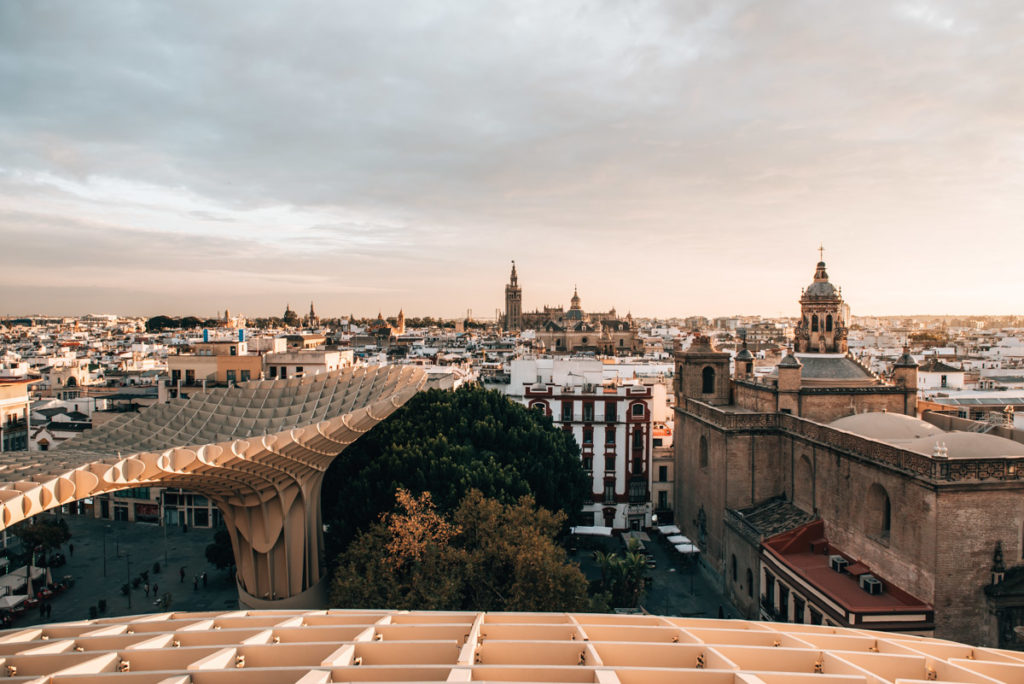
We have visited many Spanish cities but Seville has a very special vibe and character, which makes it stand out from many other cities. Seville is impressive, magnificent, lively and hot. Apparently in the summer months, the temperature often rises to over 40 degrees Celsius!
On a trip to Seville, you can look forward to countless sights – and we mean higher than the average number. Some of the most outstanding being the gigantic Cathedral and the Alcázar of Seville – which we will tell you all about in our Seville: Sights and Highlights section in this article.)
Seville is also a university city, meaning that there is a very young, buzzy vibe in contrast to all of the history and old buildings. There are countless bars and many hip cafes around the city.
How much time should I plan for Seville?
We ourselves stayed in Seville for three nights. While we had enough time to visit the most important sights, we would have personally preferred to stay longer. Since we also got a rainy day, we did find it a bit of a tight squeeze to fit in all the sightseeing.
If you prefer to take it a little slower and your itinerary (or time) allows, we would suggest four nights in Seville. If you are super rushed, then minimum of two nights, but we would not recommend it. Honestly, there is an incredible amount to see and explore in Seville!
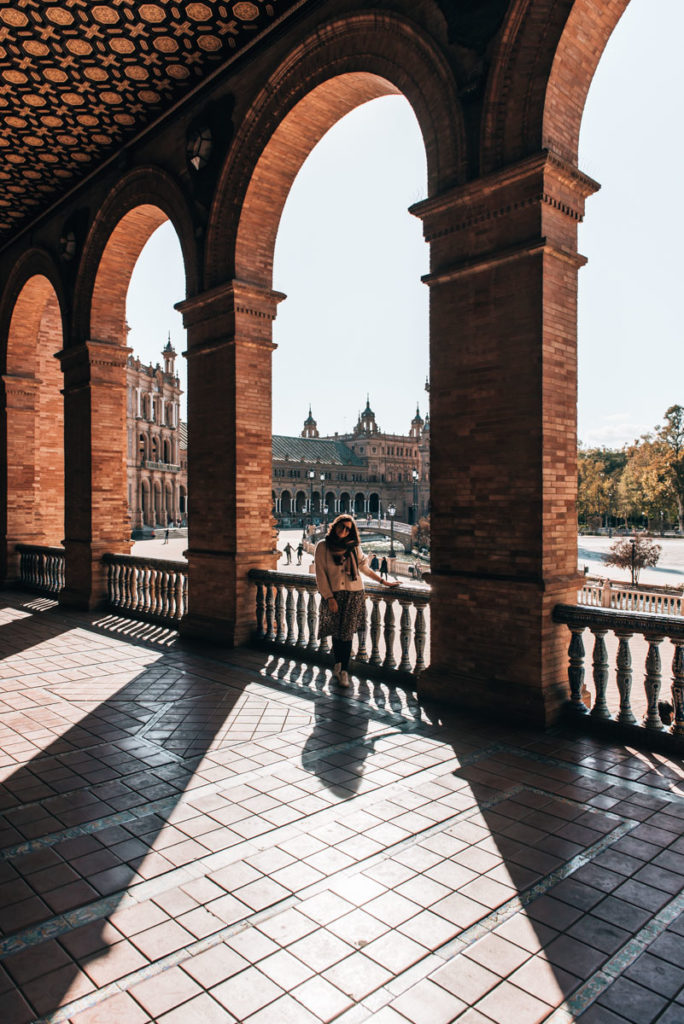
Explore the Old Town of Seville
Although many sights are located in the Old Town, we wanted to briefly share this part of the city to you separately. The Old Town of Seville is a charming labyrinth of streets in which you will most likely get lost in – which is not necessarily a bad thing!
In the Barrio de Santa Cruz (the former Jewish district), you’ll find it particularly narrow and winding around here. Located in the heart of the Old Town, just east of the Cathedral and the Real Alcázar – the alleys here are sometimes uncannily narrow and reserved just for pedestrians.
Quaint tapas bars, bodegas and small shops are located in the streets and squares of the Barrio de Santa Cruz. The best thing is to just let yourself wander around – without a city map. Don’t forget to look up once in a while to admire the flower-filled balconies.
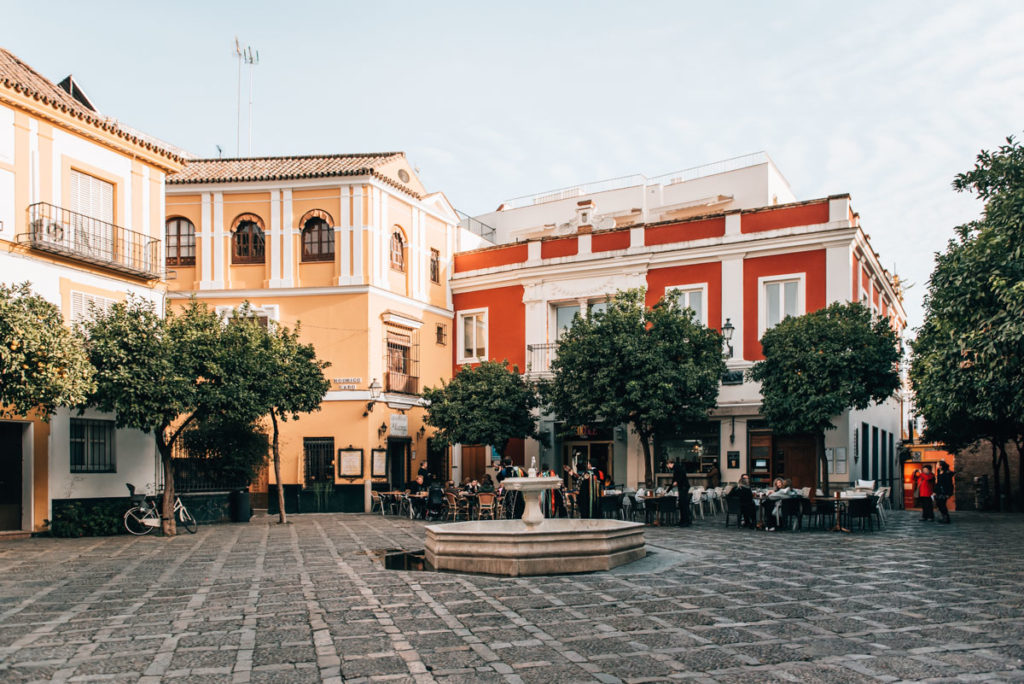
Seville Cathedral
Seville Cathedral is an icon. In fact, it is the largest Gothic church in Spain and one of the largest in the world. And believe us when we say: once you stand in front of it yourself, you will find it hard to snap out of your amazement. The cathedral is incredibly impressive from the outside already.
But wait till you go inside! It just never stops continuing to impress you! If there’s only one cathedral you should visit on your trip to Seville, let it be this one. (Oh and the Mezquita in Cordoba, which is definitely a must-see!). The size of this place is speechlessly enormous.
One of the highlights is climbing the bell tower called La Giralda. It was once the minaret of the mosque, hence the Moorish influence in architecture. The interesting thing about this tower is: instead of climbing stairs, you go up a total of 35, gently elevated ramps. One of the most famous views in Seville is waiting for you at the top.
Because there is a lot to see in the cathedral, we would recommend allowing at least 1.5 hours to explore. Our tip: Depending on the season, you want to get there as early as possible. We visited the cathedral at the end of November (i.e. in the off-season) during the afternoon and the Giralda bell tower in particular was very crowded.
Information about buying a ticket
The rush is enormous, especially in the high season. Therefore, we would strongly recommend that you buy your tickets online in advance during the busy months. You can easily do this on the official website of the Seville Cathedral. There are countless websites, which also sell tickets, but we would prefer to stay with the official site.
Official website: Sevilla Cathedral
Extra little tip: Since the ticket also applies to the Iglesia del Salvador, which is a little further away, you can also buy it there. The queues at Iglesia del Salvador are usually a lot shorter.
Price: 10 Euros (ticket valid for Cathedral, Giralda and the Iglesia del Salvador) Opening times: can be found on the official website (see above)
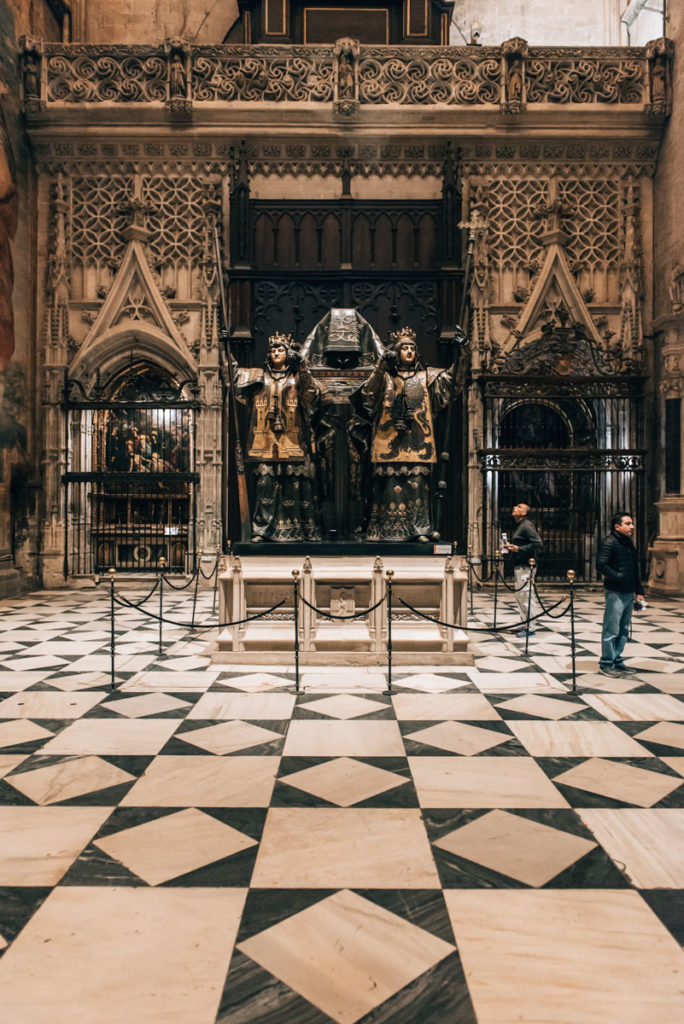
Real Alcázar
The entrance to Real Alcázar, the second major highlight in Seville, is directly opposite the cathedral. The Real Alcázar is a palace complex consisting of countless courtyards and gardens. This characteristic Arabic-Christian mix of styles is called Mudéjar.
The Real Alcázar is incredibly impressive. The most famous photo motif is the Patio de las Doncellas with its magnificent arcades. We were also very impressed with the filigree, gold-coloured ceiling of the Salón de los Embajadores.
Even if the Real Alcázar looks a bit overwhelming at first, you can find your way around with the map that you receive at the entrance. All courtyards, rooms and gardens are numbered, so you can just start at 1 and then explore everything on your own step-by-step. We would allow at least two hours for the visit.
Good to know: As you can imagine, the Real Alcázar is extremely popular and always a little crowded. Sometimes you need a little patience if you want to take a good photo. In any case, prepare yourself for lots and lots of people.
There is a maximum capacity of around 750 people, which is why you sometimes have to wait for hours during the high season. Therefore, we recommend that you buy your tickets online in advance. Although, you might still have to wait a little while at the entrance, there is a separate queue for pre-purchased tickets and online ticket holders get priority.
You can purchase the tickets from the official website (more on that in a moment). In addition, there are many websites also offering tickets (some with options for guided tours). We bought our tickets on the official website without any problems.
The ordering process is a bit confusing (sometimes the page changes to Spanish), but it’s really quite straightforward. For a “normal” tour, you should select the ticket named “Visita General” or “General Tour”. (Don’t be confused by the additional information “desde 1 Euro” (ie “from 1 Euro”) – this is the price for the (almost) free entry for under 16 year olds and other people.
This regular ticket does not include a visit to the Cuarto Real Alto (the apartments of the royal family). The Cuarto Real Alto is only accessible on a guided tour. You can also book this ticket option on the official website.
Official website: Real Alcázar
Information about visiting the Real Alcázar
Price: 11.50 Euros (12.50 Euros if you buy your ticket online) Opening times: October to March daily from 9:30 a.m to 5 p.m // April to September daily from 9:30 a.m to 7 p.m
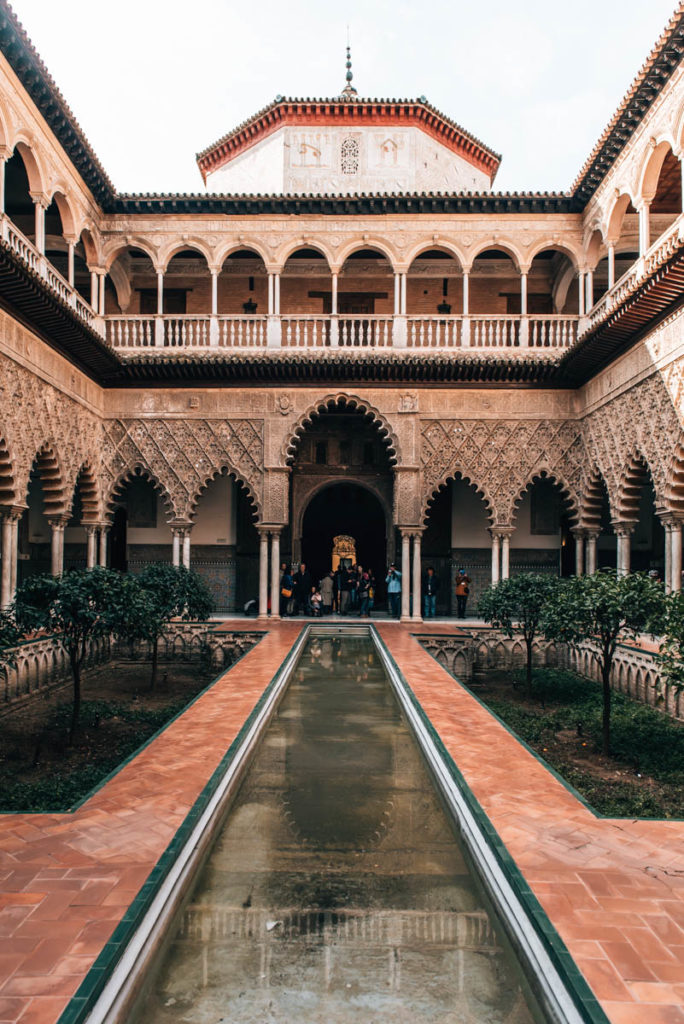
Plaza de España
Venice meets Andalusia! The Plaza de España with its water channels and bridges is simply a dream. The dimensions are enormous. We had read in advance that this place was huge – but we were still profoundly speechless.
We will cross our fingers for you that when you visit, there will be some talented street artists performing a few Spanish folk songs in front of the Azulejos. The nice gentleman in the photo actually gave us one of the most impressive performances in all of Andalusia – too good to be true and a very treasured memory of ours.
By the way: With a wink, the Plaza de España is also called the frying pan of Andalusia – because in the summer, the high temperatures make it rather unpleasant to endure the hottest part of the day. Therefore, an evening visit is often worthwhile, both during the hot season and in general. The Plaza de España is very beautifully illuminated at night.
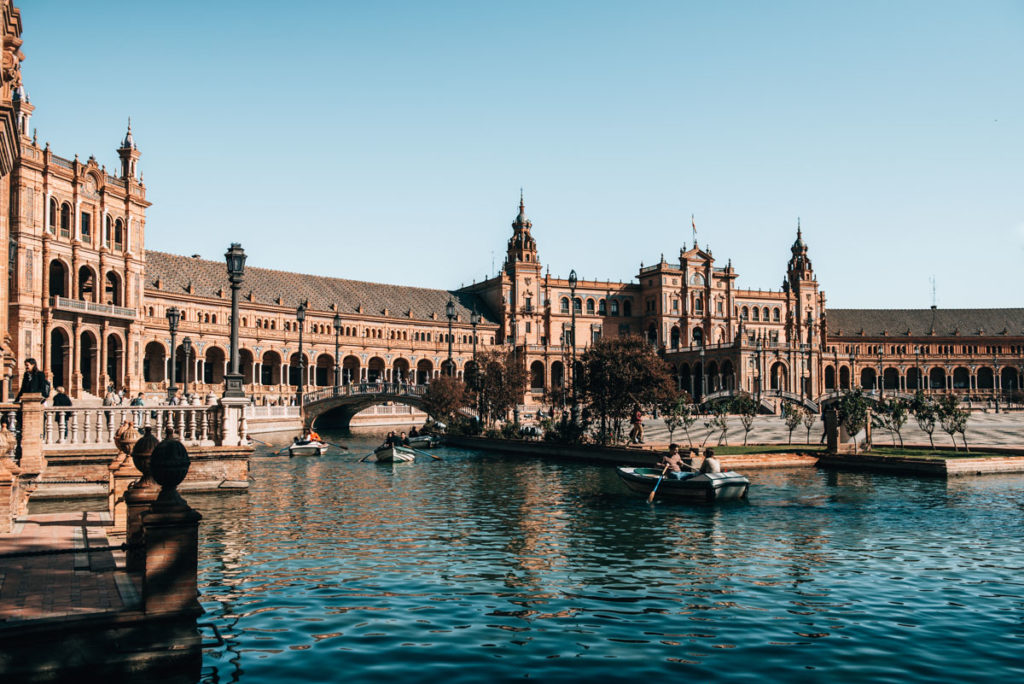
University of Seville
On the way from the Old Town to Plaza España, you can make a stop at the University of Seville. This is housed in the historic royal tobacco factory and is quite impressive.
The entrance portal on Calle San Fernando is particularly worth seeing. The university is freely accessible. So you can just walk in and look around. Our conclusion: not one of the major highlights in Seville, but definitely worth a short visit.
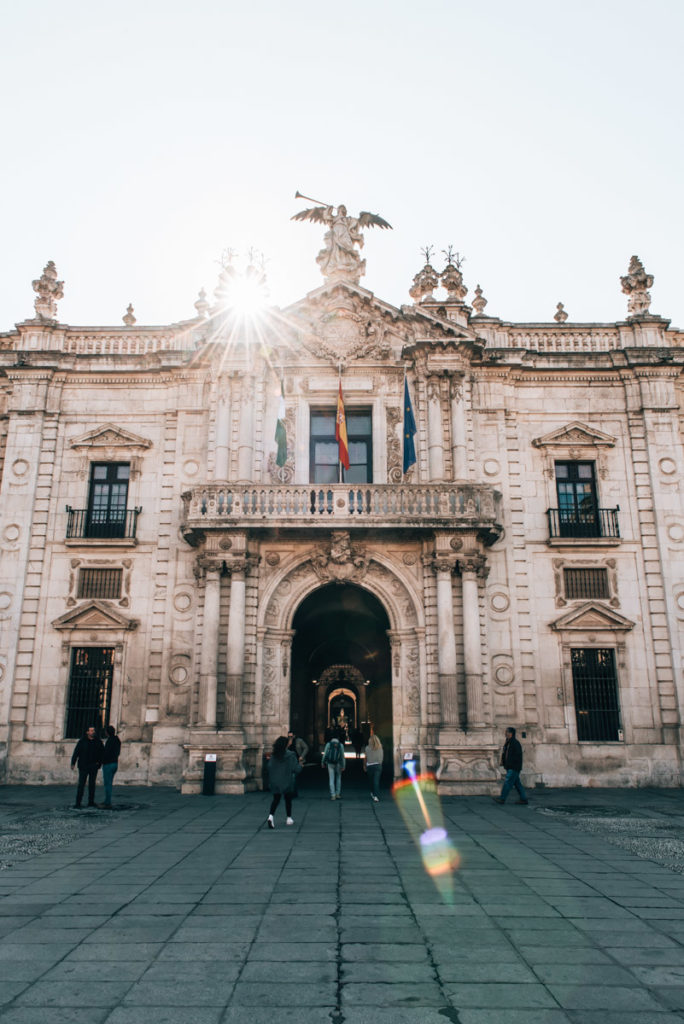
Palacio de las Dueñas
Seville is known for its magnificent, centuries-old palaces, some of which are hidden behind inconspicuous walls and gorgeous courtyards. One of the most famous in the city is the Palacio de las Dueñas. It dates to the 15th and 16th centuries and is a fine example of the mix of Gothic and Moorish styles. The spacious and well-tended garden area is definitely worth a stroll through.
Incidentally, the Palacio de las Dueñas has only been open to the public since 2016. Good to know: We happened to be visiting on a Monday afternoon and apparently it’s Free Entry on Mondays from 4 p.m onwards! Surprisingly, there weren’t a lot of people – granted, it was the off-season. We would imagine it to be much busier in the high season – and would probably avoid this time.
Information about visiting the Palacio de las Dueñas
Price: 10 Euros (audio guide 2 Euros extra) Opening times: April to September from 10 a.m to 8 p.m // October to March from 10 a.m to 6 p.m (last entry 45 minutes before closing), free of charge on Mondays from 4 p.m onwards.
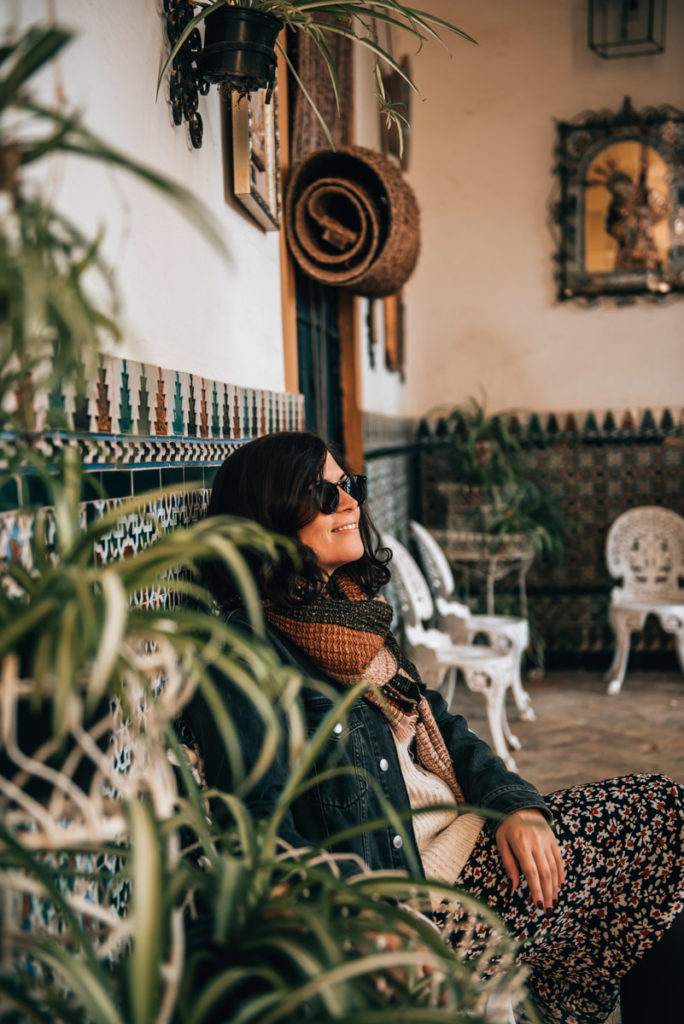
Casa de Pilatos
The Casa de Pilatos dates back to the 16th century and the architecture here was what really impressed us. The inner courtyard of this city palace is somewhat reminiscent of that in the Real Alcázar – a mini version of the Real Alcázar, so to speak. We loved the mix of different style elements. It’s incredibly impressive and photogenic.
There is free entry to the Casa de Pilatos every Monday from 3 p.m onwards. Unlike the Palacio de las Dueñas, there was a long queue during our visit (in November 2019). Especially during high season, you might be better off paying the price for a regular ticket.
Information about visiting the Casa de Pilatos
Price: 10 Euros (12 Euros including the upper floor – with a guide), free of charge on Mondays from 3 p.m. onwards Opening times: April to October from 9 a.m to 7 p.m // November to March from 9 a.m to 6 p.m
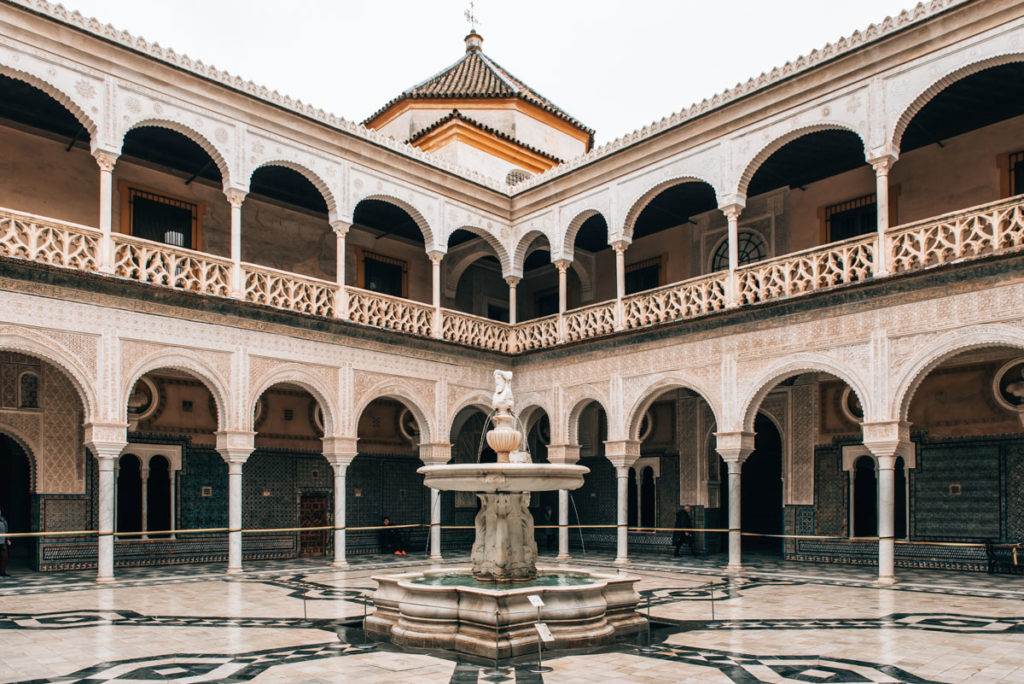
Metropol Parasol
At first glance (and probably also at second glance) the modern icon of Seville does not fit into the cityscape at all. A lattice-shaped construction made of wood, concrete and steel winds above the roofs through Seville’s old town. The futuristic shape is reminiscent of mushrooms, which is why the construction is also called Las Setas (“the mushrooms”) in Seville.
There is an archaeological museum in the basement, but the highlight is on the roof. There is a (short) circuit route with wonderful views over Seville.
Although it is probably the busiest at sunset, we of course chose to come at this time and did not regret it for a second. The Metropol Parasol is honestly the perfect place to catch the last rays of the day.
Information about visiting the Metropol Parasol
Price: 15 Euros Opening times: Sunday to Thursday from 9:30 a.m to 11 p.m // Friday and Saturday until 11:30 p.m (last entry half an hour before closing)
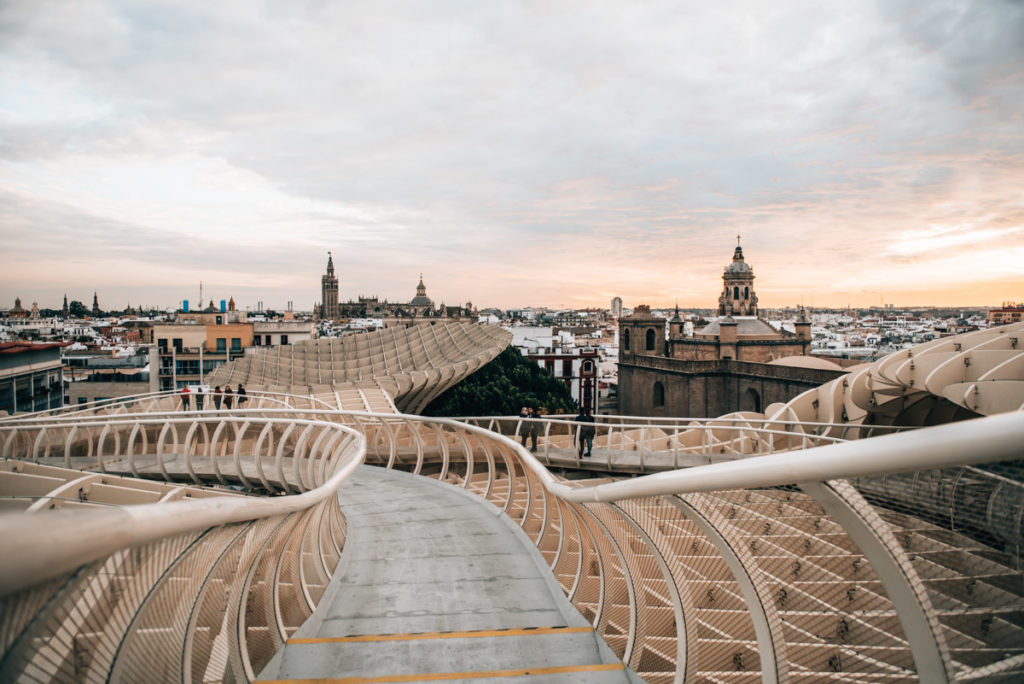
Plaza del Cabildo
This gem is hidden in a courtyard right next to Seville Cathedral. The Plaza del Cabildo is a semicircular square with a rather impressive architecture. The archways and beautiful frescoes give the place a very romantic flair.
Although Plaza del Cabildo is not an absolute must-see in Seville, we would recommend that you drop in before or after visiting the cathedral. Definitely worth it! Incidentally, it’s only accessible during the day (approximately between 10 a.m. and 8 p.m.), as the Plaza del Cabildo is closed at night.
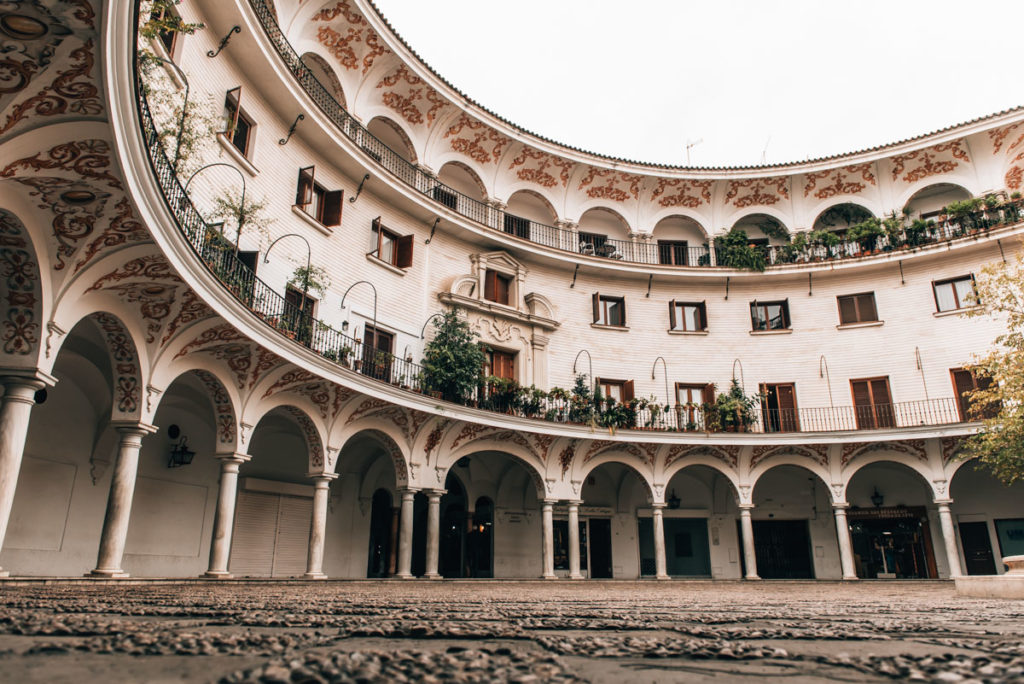
Beautiful Places by the River (Río Guadalquivir)
The river of Río Guadalquivir winds its way through the city of Seville and there are many places worthwhile seeing near the riverside. In this section, we will share with you some of the districts and highlights. You can easily explore these places on a leisurely walk. From the Old Town (Cathedral) you can reach the river bank by foot in about 10 minutes.
It starts with a walk over one of the most famous bridges in Seville, the iron Puente de Isabel II. It leads you more or less directly to the Triana district . Triana is considered one of the birthplaces of the flamenco. The small streets with their colourful houses are worth seeing. It is relatively quiet here during the day, but it should be much more happening at the bars in the evening.
Make your way slowly south to the San Telmo Bridge. The bridge itself is not a highlight, but from here you have a beautiful view of the Torre del Oro, a former defence tower. You can also climb to the top, but we had read from a few sources that it’s not super worth it .
The promenade at the Río Guadalquivir is also a great place to watch the sunset. Best way to end the day with something cool to drink from a supermarket and enjoy the relaxed atmosphere.
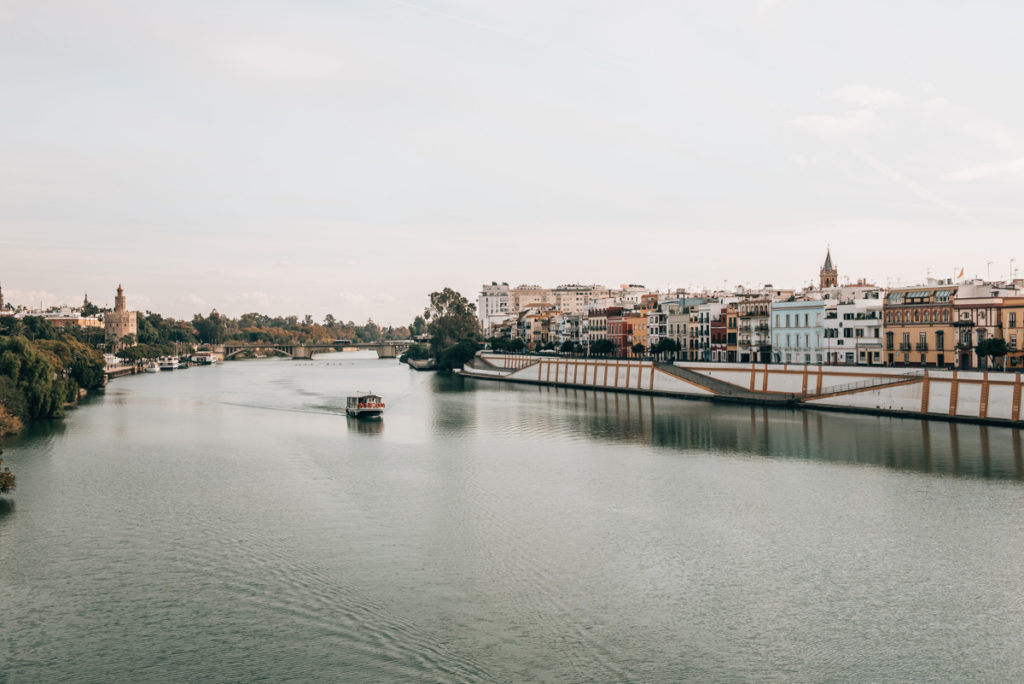
All throughout Andalusia, you will find hamams – where you can experience traditional Arabian bathing culture in a modern atmosphere. Seville also has several hamams, with the best known as “Aire”. It was just a stone’s throw away from our accommodation, which is why we did not think twice on a rainy afternoon and treated ourselves to a session in the hamam.
In the Aire de Sevilla, a dream of 1001 nights await you. Unlike in Moroccan hamams, you are not scrubbed, but bathed in water pools, which have different temperatures. There is also a salt water pool and a steam room.
A bathing session lasts 90 minutes. That is how long you have to bathe in the pool or use the steam bath. If you need a break in between, there is a room with seating and tea – but they don’t have your typical relaxation room with chair beds to lie down on.
There is also the option to book a massage with your visit and the massage sessions start from 15 minutes. (Good to know: The massage is done during your session. Although we were not asked to take off our wet swimming trunks, we did find it a bit annoying during the massage.)
In our opinion, they have a strange rule whereby you only get access to the roof terrace with a view of the cathedral if you have a massage booking of 45 minutes. We only have a photo of it because we could see it directly from the terrace of our accommodation. We did not take a photo of the baths themselves, because we locked our things up in the lockers.
Price: 37 Euros (90 minute session for the baths), 76 Euros (90 minutes bathing + 30 minutes massage), they offer many other options too.
You can book your visit to the hammam here (official website): Aire Sevilla
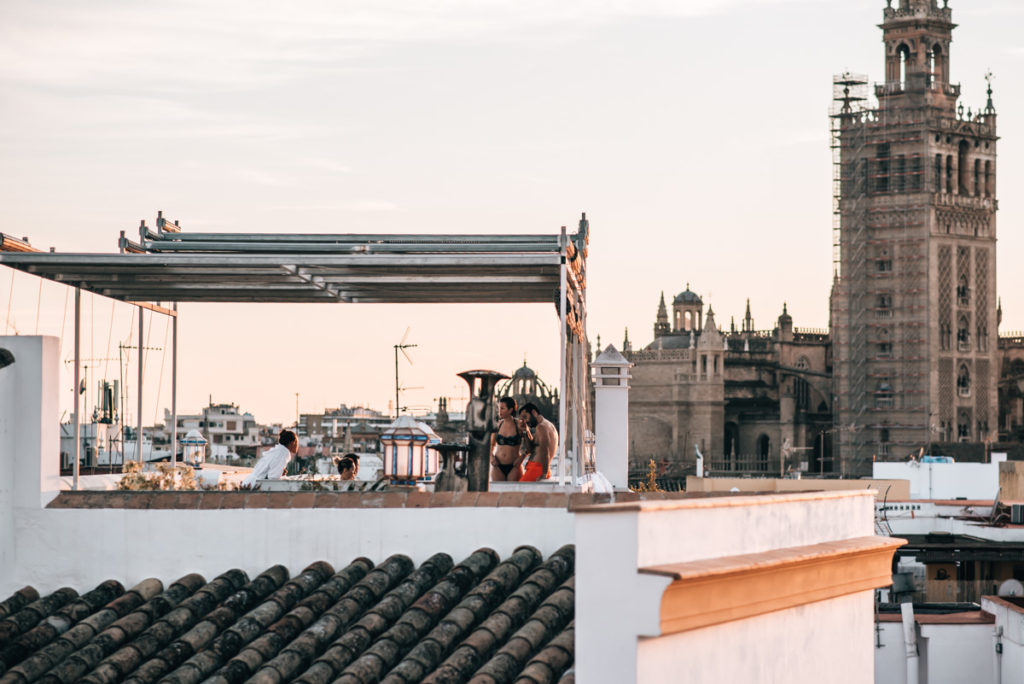
The culinary offer in Seville is huge and overwhelming to say the least. There are more eateries than you can count, making it rather difficult to choose a place – so we’ll share our favourites with you here.
Ovejas Negras: Whilst on the hunt for an authentic tapas bar that also offers vegetarian dishes, we ended up here. Our conclusion: delicious tapas in a great, young and modern atmosphere. The staff were also very courteous. It’s a very popular place but we managed to get a seat in the end!
Virgin Coffee: This small coffee bar, which is located right next to the Metropol Parasol, serves delicious espresso. Perfect for a caffeine-hit in between.
Paradas 7: Paradas 7 is a cozy, hip place for a healthy breakfast or lunch. It offers salads, soups and sandwiches as well as delicious cakes.
Bar El Comercio: a trip to Spain wouldn’t be complete without churros – the deep-fried dessert made from choux pastry. Supposedly the best churros from Seville are found in the bar El Comercio. Our conclusion: it was good, but personally a little too greasy for us. However, the ambience is really unique – a typical Spanish restaurant that’s a bit squished for space and lots of chatter. It’s best to take a seat at the bar – this makes the experience even more authentic.
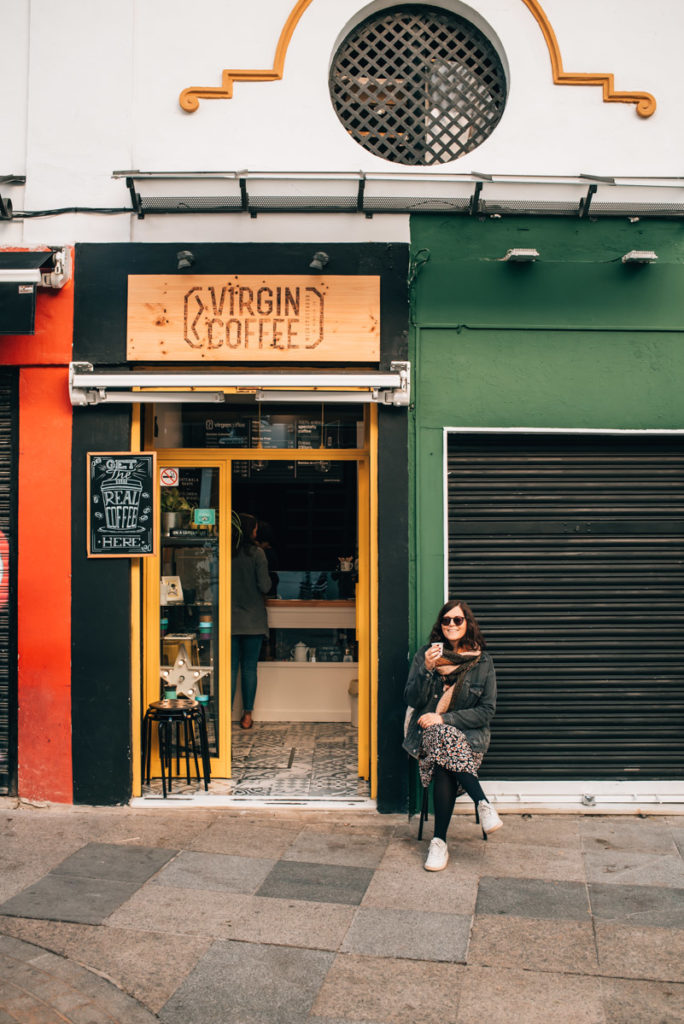
We spent three nights in the magnificent Palacio Marmoles , which is basically a beautiful historic city palace. The atmosphere is very special and unique – you feel like you’re in a museum. Despite the Palacio Marmoles being located right in the city center, it’s actually very quiet here.
There are only seven apartments in total. We were on the first floor in Apartment 6. Each apartment is individually and very thoughtfully decorated. If we had to find a fault, then we would say that the rooms were a little dark – but that’s due to the unique architecture of the house.
The biggest highlight is up on the roof terrace where you can catch a spectacular view of Seville including the cathedral. Honestly, sunset here with this view is simply magical. While it is a slightly more expensive place to stay (depending on the season), it’ll be one that stays with you for a long time.
You can book the apartment here: Palacio Marmoles
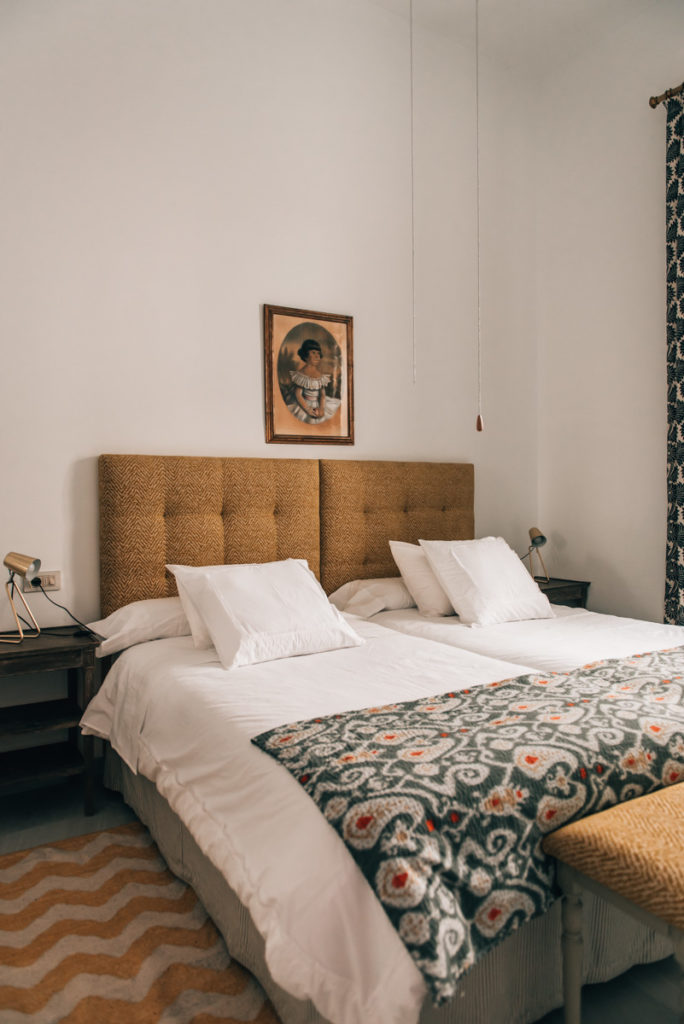
Tip: Parking in Seville
Here’s the not so good news: just like in almost every major city in Andalusia, parking can be rather tedious. You can basically forget about finding parking spaces in the old town itself. (Some streets are so narrow that we personally wouldn’t even dare to attempt driving though.)
If your accommodation does not have free parking spaces for you, then you will have no choice but to park your car in a public parking garage. The rule of thumb: the closer to the centre, the more expensive parking is. We ourselves parked in an underground car park on Avenida de Menéndez Pelayo. This parking lot was the most run-down but consequently, also the most expensive one on our entire trip to Andalusia. For 24 hours, we paid 25 Euros here!
We would recommend that you contact your accommodation in advance and ask for parking tips. It might even be worth parking on the outskirts of the city and then taking a taxi to the hotel.
Disclaimer: Affiliate Links
This blog article contains our personal recommendations in the form of so-called affiliate links. If you book or buy something through these links, we will receive a small commission. This does not change the price for you at all. Many thanks from the both of us!
Have you ever been to Seville? How did you like it? Perhaps you have some extra tips for us? We look forward to hearing your experience!
You might also be interested in this
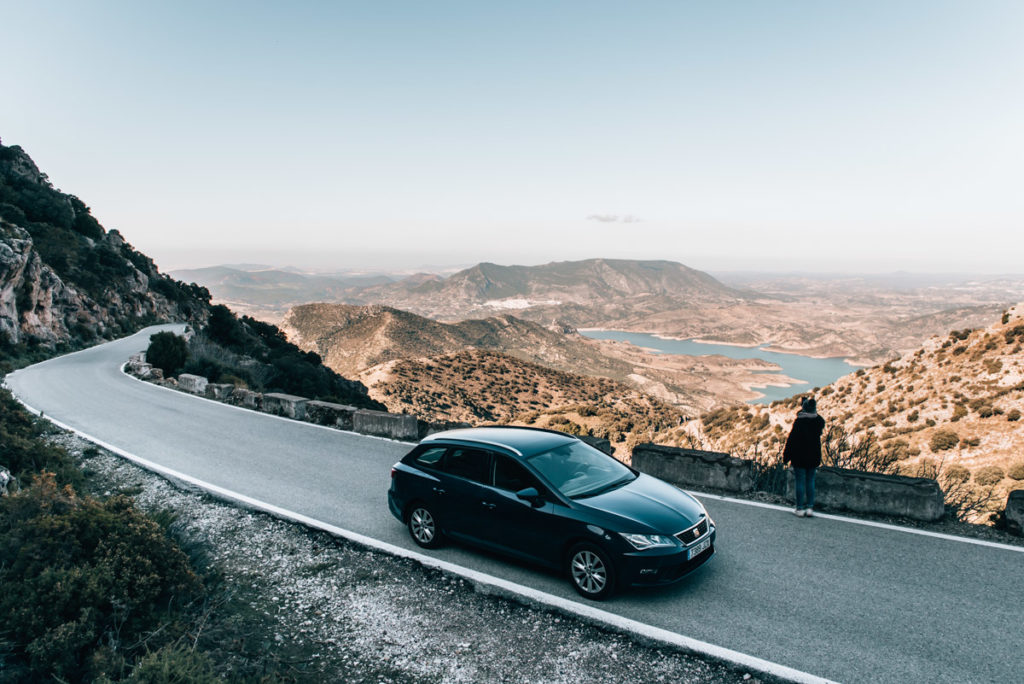
Two Week Road Trip through Andalusia: Our Travel Itinerary
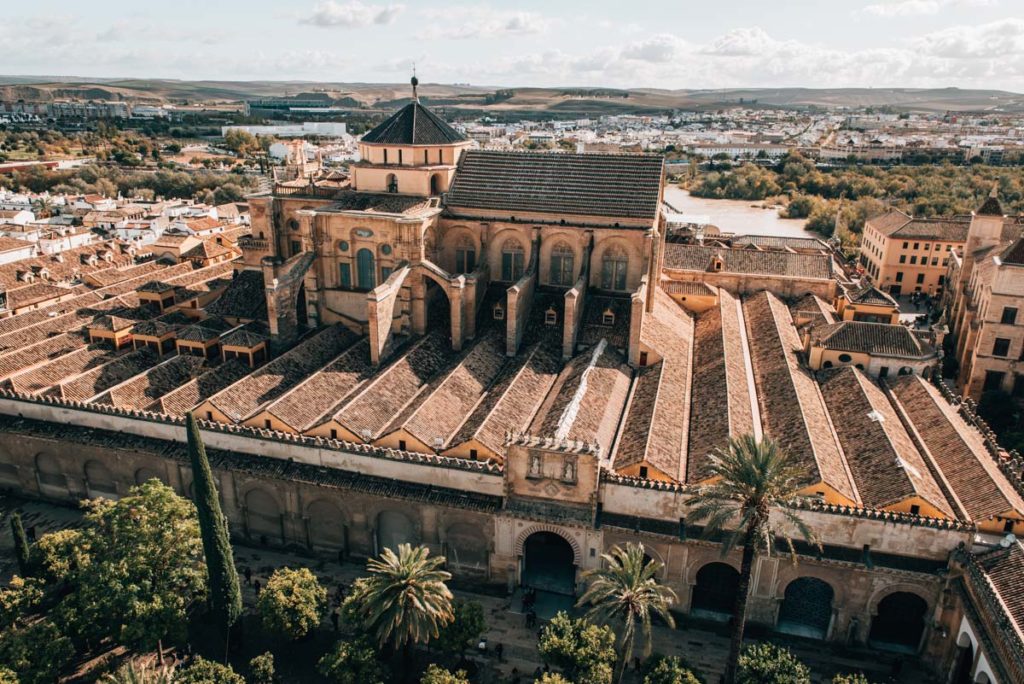
Córdoba Travel Guide: Our top Tips & Things to do
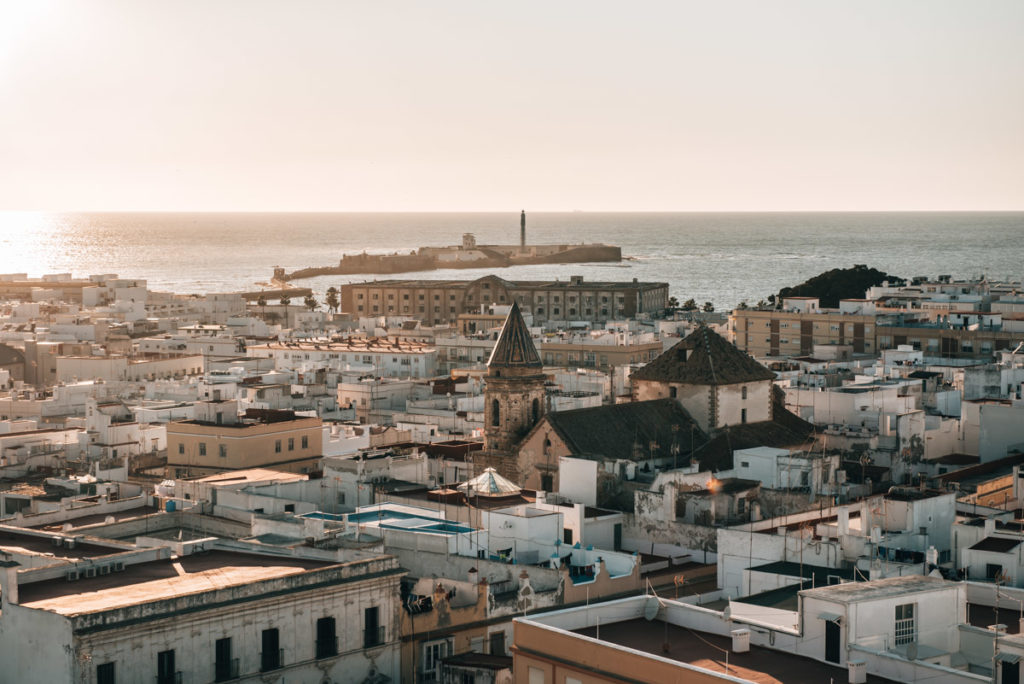
Best of Cádiz: Top Things to do and see
Leave a reply cancel reply.
Your email address will not be published. Required fields are marked *
- Privacy Policy
Seville Travel Guide - Sevilla Landmarks - What to visit, where to eat, what to see, how to stay in Seville Coming to Seville on holiday?
Seville tourist guide - what to visit, where to eat, what to see, how to stay in seville coming to seville on holiday we have written an intensive seville tourist guide for you to get to know seville first hand and find out what to do, what to see, where to go, where to eat, how to travel to seville and the best excursions from seville to your holiday destination..
With a wide tourist offer, Seville is the third most visited capital after Madrid and Barcelona. A city full of places to discover and to learn the history of this spanish capital.
Seville Travel Guide - Know all about Seville in one article
In our online Sevilla City Guide , we've compiled the highlights to make it easy for you to find what you're looking for and what you're interested in at a glance.
It covers all the must-see sights , and is perfect for discovering what to do and see in Seville whether you plan to visit at your own pace with this travel guide to seville
The History of Seville City

Seville is a municipality and a city in Spain, its capital and one of the three capitals of Andalusia. Its historic quarter is the largest in Spain and one of the three largest European urban centres on a par with Venice or Genoa (we can see the difference between the old quarters, which only include the historic areas prior to the Industrial Revolution, and the historic quarters, which include the post-industrial areas).
Seville's historical and monumental heritage , together with its numerous scenic areas and cultural attractions, make it a tourist destination for both the Spanish nation and Europeans. Because of its beauty and heritage, Seville is the third most visited city in Spain after Madrid and the city of Barcelona.
In the past, Seville was also once considered one of the most important cities in Europe in medieval times. The city was home to some of the greatest minds in history, such as Christopher Columbus and Miguel de Cervantes , author of Don Quixote, or Saint Leander of Seville (in Spanish: San Leandro de Sevilla), the one more famous Bishop of Seville.
Today, Seville is still a beautiful place that attracts tourists from all over the world and Seville's attractions have a good reputation.
If we go backwards, Seville was founded by the Phoenicians in 814 BC, and was originally called Hispalis. It became a Roman colony called Valentia before becoming an independent Visigothic kingdom in 554 AD when King Reccared I made it his capital.

They passed the Strait of Gibraltar and founded the three thousand-year-old Gades, or Gadir. They decided to settle in Ispal, a strategic area due to its access to the copper mines of the southwest Peninsula. This beautiful place was also located on a large river estuary, almost as it is now.
It is believed that the origin of the original nucleus of the city was on an island in the Guadalquivir River , where it still exists as part of present-day SPAIN. The first name of the settlement was "Spal". From the ancient Phoenician language, this word literally means "little island of Baal".
This would be important because he is one of the main deities of the pantheon in this civilisation.In 206 BC, the Romans conquered Spain normally and settled in Italica. Emperor Trajan and Emperor Hadrian grew up there in a village near Seville called Santiponce and now well known for being the thirsty Roman city of Italica which thousands of people visit every year.
In the 2nd century, Hispalis had a long wall and a protective forum dominated by maritime commercial activity. Here, where we know today as Plaza de la Alfalfa, was the route of the Cardo Maximus , which at that time started from the church of Santa Catalina towards c/Abades to arrive (passing through the church of San Esteban) at the Plaza del Salvador.
Christianity was widespread in the city. Saint Justa and Rufina were executed shortly after refusing to worship the queen of the sun Astarte. It is said that they were condemned by a law because of this.
Over the centuries, Seville has seen many changes in its architecture and culture. The Moorish invasion of Andalusia in the 12th century (The city was destroyed by the Moors in 1248) led to a massive building boom that created some of Spain's most impressive Islamic structures.
Visit the famous Seville monuments
The Moorish influence is still visible today, as evidenced by the city’s historic district with its mixture of Medieval, Renaissance style buildings and notable structures include the Alcazar Palace, the Giralda Tower and Seville Cathedral.
Seville was reconquered under the reign of Ferdinand III , who was buried in Seville Cathedral.
The celebrations of the Ibero-American Exposition of 1929 boosted the urban development of the city. The project included the construction of parks and buildings designed for the event.
The 1992 Universal Exposition left the city with a legacy of significant infrastructure improvements. Designs such as Seville's Alamillo Bridge, created by the Spanish architect Santiago Calatrava , a renowned architect of his time, other land and aeronautical communications, including the Centenary Bridge, and the AVE railway access to Santa Justa station helped to boost the city.
Where is Seville? Locate Seville on map
Seville is the capital and largest city of the autonomous community of Andalusia and the province of Seville in Spain.
Its inhabitants are known as sevillanos or hispalenses. Seville is located on the Guadalquivir River, the city was founded as Hispalis by the Phoenicians under King El-Xoqninto in around 814 BC.
It became a Roman city due to its proximity to Roman Carthage , Seville served as a centre for the gold trade for ancient Spain and many fine works of art were produced within its boundaries. Excavations have revealed large well-planned streets with a grid pattern.
Visit Triana neighborhood
Why go to Seville?
The city of Seville is rich in antiquities, historic buildings associated with illustrious names who lived in Hispalis or made its history.
It is full of works of art and its sumptuous royal palace triumphs in its splendour alongside its faithful cathedral, while other prestigious buildings await your visit.

Let's not forget that Seville coexists with the spirits of kings, warriors, explorers, authors, painters and famous poets who still fly over the neighbourhoods of Santa Cruz (We love so much barrio Santa Cruz Seville ??) or Triana or wait for a breeze from the Gualdaquivir River to rememorate their own history.
And you can feel it as you stand, slave to your imagination, in the alleys of the splendid cathedral, or as you dream even more among the roses and the tinkling of the fountains of the Alcazar gardens.
Don't forget the people of Seville are very friendly , and they love having visitors from around the world. They will be happy to show you their beautiful historical sites and tell you all about their rich culture. They love to show off their gastronomy, which is a mix of local and international.
Tourism in Seville is always of a high standard or provides hundreds of alternatives for a great time.
Things to do in Seville
What to do in seville ? That's a good question, that's true.
Seville is a beautiful city in Spain with a lot to offer. The city is known for its many historical monuments, such as the Alcázar and the cathedral. It is also a popular destination for tourists of all ages and interests, from children to adults.
The city and its surroundings are home a lot of monuments, parks and gardens. it´s so true! Seville has many places of interest.
There is also the Museo de Bellas Artes, which contains works from all over Spain from the medieval period onwards.
Seville has an infinity of places to visit and meet full of history, we propose you a TOP TEN:
- Real Alcazar of Seville, the oldest palace in use of Europe (part of Unesco heritage site).
- Cathedral of Seville, the world's biggest gothic cathedral.
- Archivo of Indias, declared World Heritage next to the Alcazar and Cathedral.
- Neighborhood of Santa Cruz (also called Barrio Santa Cruz O Juderia de Sevilla), which concentrated the second largest jewish community in Spain.
- The River Guadalquivir.
- Plaza of España, built for the Ibero-American exhibition of 1929.
- Real Maestranza of Caballeria, first bull square with a circular form.
- Museum of Fine Arts, with one of the most important art galleries of Spain.
- Casa Pilatos, declared National Monument in 1931.
- Seville Horse Carriage Rides.
- Hospital of the Charity, with artworks of Murillo, Valdés Leal or Pedro Roldan, among others.
- Palace of the Countess of Lebrija, with 580 m² of roman mosaics on the floor and walls.
Seville is a beautiful city that deserves your attention and it´s perfect to have A WEEKEND BREAK IN ;)
The downtown Seville
Before explaining the most interesting places in Seville, we'd better quickly explain the Seville's city centre. Seville's Centre district is without doubt one of the most touristy areas of the city. It is located in the heart of the historic centre of Seville. It is the meeting point of four of the city's main districts: El Arenal, Santa Cruz, Macarena and San Vicente.

It is located to the north of the Cathedral and extends from the Plaza Nueva and the Plaza de San Francisco along the three main shopping streets of the city: Sierpes, Velázquez and Tetuán . This is an old neighbourhood with many narrow streets.
If you are planning a short stay in Seville, it is important to know that this area is ideal, as the main monuments and attractions of the city are located in the direct vicinity of the different accommodation. In addition, as most of the streets are pedestrianised, it is very pleasant to walk around.
In this part of Seville there is a lot to see and visit. Whether you want to eat, shop or just walk around, you will be spoilt for choice!
As mentioned earlier, there are dozens of narrow streets in the centre of Seville. One of the most emblematic is Calle Sierpes. This has been a pedestrianised street since the 19th century and has a great deal of commercial and cultural activity.
All along this street there are numerous shops of all kinds. From international brands to more modest ones, there is something for everyone. You can find brands such as GUESS, Desigual, The Body Shop and Pompeii Sevilla. There are also small squares with tables and umbrellas where you can relax with a drink or a typical dish.

If you prefer big shops, you can head to El Corte Inglés o famous international store Zara . This is one of the best department stores in Spain and is very popular throughout the country. Located in the centre of Plaza del Duque, this is a great place to shop in a chic and pleasant setting. The range of goods on offer in this shop is very varied. You will find electronic products, make-up, children's toys,... as well as many clothes, both luxury and not.
- The Plaza Nueva is one of the most famous squares in the city. In the centre of the square stands the monument to Ferdinand III of Castile, inaugurated in 1924. The monument is neo-Gothic in style, but it has a certain eclecticism. It consists of two parts: a pedestal with four stone statues and a bronze statue of the monarch on horseback.
- The City Hall is located between Plaza San Francisco and Plaza Nueva is the Ayuntamiento (or City Hall). This building is public and dates from the 15th century. However, its façade was renovated in the 19th century in a neoclassical style. Opposite this impressive monument is the church of San Salvador I. This is the largest church in Seville after the cathedral. If you walk through the doors, you will discover that what sets the church apart is undoubtedly its numerous gold-plated woodcuts, its impressive wall and ceiling paintings and its main altar.
Although the central district is known for its many pedestrian streets, there are also some more impressive ones. One of the most impressive of these is the Avenida de la Constitución, which runs from the Plaza Nueva to the San Sebastian bus stop, past the cathedral and the Puerta de Jerez. It is one of the most important thoroughfares in the city and is where the city's metro runs.
Just a few minutes walk from Constitution Avenue you will find t he Metropol Parasol . This 28-metre-high, 150-metre-long wooden structure covers the Plaza de la Encarnación and passes over Calle Imagen. This modern building offers panoramic views of the city of Seville. If you climb to the top after dark, you will be amazed by the play of light and lulled by soothing music.
- The Metropol Parasol , also known as 'Las Setas de Sevilla', covers a covered market and houses the Antiquarium Museum, an archaeological museum where you can see Roman remains such as ancient houses, pottery and colourful mosaics.
If you want to have a good time with your family or friends in a unique place, don't hesitate to go to the Hard Rock Cafe . This concept, after having seduced people in London and New York, has now moved to Seville. This place, which has become a must for visitors and locals alike, offers a unique blend of music, entertainment and original, quality cuisine made from fresh produce.
Favourite dishes include the Balsamic Tomato Bruschetta, the Legendary Burger, slow cooked ribs and chicken grilled to perfection. In addition to its many dishes, what makes the Hard Rock Cafe unique is its wide selection of drinks. You can choose from alcoholic drinks such as Margaritas and Hurricanes to non-alcoholic drinks. Plus, they're all available in Hard Rock souvenir glasses.
- Hard Rock Cafe Seville for one of the best beer in Seville is the famous Hard Rock Cafe.
- Adresse :Av. de la Constitución, 21, 41004 Sevilla.
- Teléfono: 954 22 01 26.

33 possible interesting places to see in seville
Within Seville there are many beautiful historical monuments that date back to Spain's rich culture and heritage. The 15th century Seville Cathedral is a favourite with tourists, as is the 12th century Alcazar opposite the Cathedral. Alcázar is a wonderful blend of Moorish, English and Spanish Renaissance architecture. The imposing town hall dates back to the 16th century, while Torre del Oro , a squat tower with another turret on top to give it added height and importance, was built to protect the river from ships entering the port as they would wish.
Seville Unesco Heritage
And before that, take a look at the list we have prepared for you, we cannot forget the UNESCO HERITAGE SITES IN SEVILLE , as UNESCO has declared three monuments in Seville as "UNESCO heritage sites". These three sites are: the Cathedral, the Alcazar and the Indian Archives.
The Cathedral, the Alcazar and the Indian Archives together constitute a magnificent group of monuments in the heart of Seville. They are a perfect representation of Spain's 'golden age', comprising Islamic popular culture, ages of ecclesiastic authority, kingly sovereignty and the commercial influence Spain gained through its colonies in the New World.
33 possible interesting places to see in Seville.
Below is a list of 33 possible things to see and do during your visit to Seville:
1 – Visit the Seville Alcázar Palace

As Alhambra Palace Generalife Gardens, the Seville Alcázar Palace is a beautiful example of Moorish architecture. Once the home of Alcazar Royal Palace Seville is famous for its gardens, which were designed by Andalusian architect, Juan de Herrera.
The gardens are filled with fountains and sculptures and are surrounded by walls with intricate decoration.
The Seville Alcázar Palace is a beautiful example of Moorish architecture that has been preserved well through the years to this day.
It is now a protected UNESCO World Heritage Site, which means that it is illegal to alter or remove any part of it.
2 – Gardens of the Real Alcázar Palace in Seville
The Reales Alcazares Garden is located in the city of Seville , Spain. . The garden was conceived by the Muslim King Alfonso X of Castile and his Moorish Queen Beatriz da Silva.The garden is a typical example of the gardens created by the Moors in Spain and Portugal.

Additionallly, the garden is a great example of Islamic gardens in Spain. Alcazares Garden consists of three main parts: The first part is the rectangular pool, which was created in 1325 by King Alfonso X for his wife Queen Beatriz. This part can be seen from the gate and was surrounded by a wall with four towers. The second part is the square court, which was built around 1400 by King Henry II of Castile (1406-1455) for his wife Isabel de Portugal, Queen consort of Leon and Galicia. The third part is the alcazar or palace, which is situated at one end of the garden, between two walls that enclose it on all sides except for its western side where it has.
Commonly, gardens of this type were enclosed with a wall, but the Alcazares Garden is open on three sides because of the river at its back. The garden was surrounded by a wall with towers and ditches. The main feature of the garden is the water which flows in a canal from the Guadalquivir River. The garden also has two bridges, one over the canal and another over a stream that flows into it. In addition to the garden's water feature.
3 – The Famous Seville Cathedral
The Cathedral of Seville is one of the most recognizable cathedrals and it is regarded as one of the greatest works of Gothic architecture.

The Cathedral of Seville was built in the mid-13th century. It is one of the most recognizable cathedrals and is considered to be one of the greatest works of Gothic architecture. From 1172 until 1401, it had been a large mosque. After the Reconquista, Ferdinand III ordered its construction as his Royal Chapel for himself and his wife Beatriz de Suabia.
The church was built from what remained of the Great Mosque after an earthquake greatly damaged it. The rebuilding lasted from 1356 until 1506 and took seven years to complete.
The list of Master Builders of Seville Cathedral between 1386 and 1519.
- 1386-1396-Alonso Martínez
- 1421-1440-Pedro García
- 1439-1449-Maestro Carlin (Carles Galtés de Ruan)
- 1454-1472-Juan Norman
- 1478-1496-Juan de Hoces
- 1496-1511-Alonso Rodríguez
- 1513-1519-Juan Gil de Hontañón
In conclusion, the Cathedral is a masterpiece and largest gothic cathedral, which has been listed as one of UNESCO World Heritage Sites.
4 – Visit the Tomb of Christopher Columbus Seville Cathedral
The Tomb of Christopher Columbus is a mausoleum located in Seville. It is believed that Christopher Columbus died in Seville, Spain. He is buried within the Cathedral of Santa Maria la Blanca.

The story of Christopher Columbus' death is a myth. The city he was said to be buried in, Seville, Spain, has no record of his burial or even the fact that he ever visited the city. His remains were actually buried at sea during a stop-over in Palos de la Frontera (today's Puerto Rico). On October 14, 1506, Christopher Columbus died and was stripped naked by order of King Ferdinand II so that the ship's crew would not lose their dignity as they prepared him for burial at sea.
When Columbus' body was finally laid to rest on an unknown island off the coast of Puerto Rico on May 20th 1543 it was placed into a wooden coffin which had been constructed from salvaged wood from other ships he had previously encountered on his travels around the world searching for a route to Asia. It would remain there until 1892 when it was removed by Spanish authorities in order for its location to be found and sent back to Spain where it now, in the Cathedral .
5 – Giralda Tower
The Giralda of Seville is the former minaret of the great Almohad mosque of the city, but also the most emblematic monument of Seville. It was built between 1184 and 1198 and stands 76 metres high. Nowadays, it corresponds to the bell tower of the cathedral. In all, it has a total of 24 bells, making it the cathedral in Spain with the highest number of bells.

Each of the four façades is divided into three vertical sections covered with diamond-shaped networks. It is possible to venture to the top to enjoy a unique view of the Alcáza r , the Patio de los Naranjos and the gargoyles and pinnacles of the cathedral.
6 – Golden Tower (Torre del Oro)
The Golden Tower, commonly referred to as Torre Del Oro . This tower is located by the Guadalquiver, and provides a stunning view of the city and azure river beneath. The real meaning to the name isn’t that the tower itself looks gold under the sun, but because of the function of the tower.
Torre del Oro was used as storage for the gold plundered from the Incas and Mayans during the colonisation of America.
Within the tower itself, today you will find ship models, portraits, maps, and various other maritime items. There is a lot of information to learn about Seville’s history across each floor before reaching the top to get a splendid view of the outside.
During the 18th century, the tower suffered heavy damages from the Lisbon earthquake. The Marquis of Monte Real wanted to demolish the tower to make it easier for horse carriages to access the river and into Triana. However, the people of Seville wanted to preserve the tower which holds significance for the city. The King intervened and allowed for Torre del Oro to be repaired.
7 – The Archive of the Indies
The Archivo General de Indias, also known as Los Archivos de Sevilla , is a library located in Seville, Spain. The Archivo General de Indias de Sevilla was founded in 1785, by the will of King Charles III, by the Spanish Crown to store documents relating to the explorations and conquests. It is located in Seville, Spain, and contains more than one million pages of historical records.
These documents are the largest and most important collection of Spanish archives outside Spain itself, covering more than two centuries of Spanish imperial history.
The Archive of the Indies includes records and materials relating to the Americas, including those relating to exploration, colonisation and administration in Latin America; material relating to the Indies (the name given by Columbus to his discoveries); the work done by missionaries; treaties with European powers such as England, France, Portugal and others; and details of wars such as those against the Dutch or the English that eventually involved other parts of New Spain or its neighbours. The archive contains hundreds of thousands of pages documenting these events.
8 – Seville Santa Cruz District (Barrio Santa Cruz)

9 – Seville Triana District
It is the most special neighbourhood in Seville, known for its history, its character and its charm. Discover it little by little. Triana is definitely worth a visit.
A quick historical review. The origins of Triana go back to the Tartessian era. This populated nucleus on the west bank of the Betis river (the Roman name for the Guadalquivir), served the roman legions, who established an encampment there, close to Itálica and opposite Híspalis (the Roman name for Seville). It was the Almohads who constructed the first bridge that connected Triana to the city with a bridge made of vessels.
This original bridge was located where the famous Triana Bridge (Puente de Triana) is today.
In the 15th and 16th centuries, Triana played a role in the famous maritime expeditions that sought to discover new worlds. Its Escuela de Mareantes (School of Navigation) instructed many of the era’s sailors, who took part in the voyages like that of Christopher Columbus to America or Ferdinand Magellan and Juan Sebastian Elcano’s voyage around the world.
Triana has a really interesting history. One of the spooky chapters is the dark days of Spanish Inquisition. The people who were persecuted were sent to El Castillo de San Jorge, which is where they would be tortured and imprisoned. El Castillo de San Jorge is located next to the Triana Market (El Mercado de Triana).
Triana has new things to offer around every corner: you'll find them in the houses with their famous courtyards, in the bars or in the shops that are a reference point for the neighbourhood. If you come to Triana, you can enjoy an absolute neighbourhood experience .
10 – Triana Market
El Mercado de Triana is the oldest and most famous market in Seville . Located in the neighborhood of Triana. El Mercado de Triana traces its roots to 1410 when it was founded as an open-air market. Today, it has been converted into a modern covered market. Visitors can find all sorts of fresh produce, meats, seafood and spices at the market's stalls.

You can visit the Mercato de Triana when you're in Sevilla and both take a tour and eat during your trip . This is one of Seville's most characteristic places.
There are a lot of gastronomy options with typical Greek food, so you're sure to find some that suit your taste. If you want to stay in an apartment, and cook for yourself, maybe things would be easier if you bought them fresh first. A visit to Seville is still very recommended, not only to know about the history of this place but also for its way of life, culture and the people living there.
it's so easy to get here. From the center, you should go to the Bridge of Triana or officially called Puente de Isabel II and head right.
- Triana Market Hours To visit the Mercato de Triana, you should keep in mind the following hours.
- - Stores and shops:
- Monday to Saturday from 9:00am to 15:00pm
- - Area of catering and leisure:
- Monday to Saturday from 10:00am to 00:00pm.
- Sundays and holidays from 12:00am to 17:00pm.
11 – Seville Historical Centre
Seville Historical Centre is one of the best destinations in Spain for travelers looking to soak up a bit of Spanish history amongst delicious food and drinks . The city has a centuries-old architecture, cobblestone streets, and historic landmarks all within walking distance. You can stroll down to the the Gothic Cathedral, Alcázar palace, and the Archivo de Indias — UNESCO World Heritage Sites —. To get an idea of the beauty and the greatness of Seville, the Alcazar, the former palace of the Moorish kings , can be visited today. The huge halls are beautifully decorated with carved woodwork, arches, tiles and decorative stones. And when you've finished strolling around the palace grounds.
12 – Plaza Nueva
Beautiful square in front of the Town Hall
13 – Church of the Savior (El Salvador Church of Seville)
The Church of the Divine Saviour was built by order of King Philip II to be used as a school for noble children and as a place to house nuns from La Caridad Hospital.
The primitive building that occupied the site of the present one was one of the best mosques erected in this city by the Muslims. Converted into a Christian temple, it remained until 1670-71, when it threatened ruin and had to be demolished.
Remains of the first foundation are, in our opinion, the capitals that can be seen supporting some modern arches that are almost buried in the north wall of the courtyard of the Orange Trees in the aforementioned church. In our opinion, these are Visigothic fragments taken over by the Muslims. Three years after the date mentioned above, work began on the erection of a new temple which, due to the lack of skill of its architect Esteban García, fell apart, and he was succeeded in the direction of the work by Pedro Romero. The latter's lack of capacity led to a meeting of architects, and Pedro Roldán, in agreement with Eufrasio López de Rojas, master of the Cathedral of Jaén, following the latter's opinion, appointed Francisco Gómez Septier as Senior Master, whose death led to his successor Leonardo de Figueroa, who completed the work in 1792, by Diego Díaz.
Everywhere in this temple there are evident signs of the corruption of art, and the enormous altars that adorn it, bravely executed, but in bad Churrigueresque taste and like a true artistic delirium, should be mentioned in particular. The main altarpiece , a finished work of its kind, was designed in 1770 by Cayetano Acosta, and the paintings in the chapel, which are rather flimsy, are by Juan Espinal.
Among the sculptures on the altars, we will mention only that of the Christ of the Passion, executed by Montañés, and that of the Virgin of the Waters, about which there are pious traditions that trace its origin back to the times of Fermando III. The difficulty of examining this sculpture without the cloths that conceal it and the restorations that can be seen on its face and hands prevent us from forming an exact judgement about it. The ornaments that cover the entire exterior wall of the Sacramental Chapel can also be considered a model of baroque style. The room used as a sacristy is worth visiting, as it preserves architectural remains from the 16th century.
After visiting the church of El Salvador you can enjoy a coffee, a drink or a tapa in one of the many bars in the Plaza del Salvador, located in front of the church.
14 – The Duenas Palace
The Monastery of Santa María de las Dueñas , barbarously destroyed during the revolutionary period of 1868, is a remarkable example of the union of three styles, Mohammedan, Gothic and Renaissance, which can be considered as an irrefutable testimony of the transition from the Mudejar style.
It was founded by members of the illustrious lineage of the members of the Pineda clan, lords of Casa Bermeja,who was forced to sell it in 1483 to Doña Catalina de Ribera, wife of the Adelantado D. Pedro Enríquez, to rescue the valiant warlord D. Juan de Pineda, later passing to the house of Alba through the union of the Marquisate of Villanueva del Río, which began with Don Fadrique Enríquez de Ribera. It was formerly much larger, to the point of having eleven courtyards , with nine fountains and more than a hundred marble columns. Stripped of many magnificent artistic treasures that embellished and enriched it in its day, among which we remember the magnificent Mudejar dome of its staircase, now disappeared, we can now see its opulent rooms divided by partitions to form floors, a large courtyard that barely conserves on the pavement the brilliant bands of polychrome tiles that crossed it in all directions, forming whimsical lacework.
The first thing that catches the eye of the curious is the entrance arch, whose tympanum bears the ducal coat of arms of Alba , painted in flat tiles, a fine example of Triana ceramics, executed in the late 17th or early 18th century.
Past the garden that leads from here to the entrance hall of the house, there is a large courtyard surrounded by perpendicular arches, supported by white marble columns, from which pilasters decorated in the Plateresque style emerge, preserving several of the aforementioned capricious angular arches or triple lobes. Fragments of another Plateresque frieze can be seen on the inner wall of the courtyard. Continuing along the lower galleries , we find on the west side the beautiful floor that served as a chapel. The ornamentation of the soffit is noteworthy, as is the high tiled plinth and the ceiling of the chapel vestibule.
Before going up to the upper floors, we should note the arch that gives access to the garden, very similar to the one in the chapel, with a Plateresque arrabá and intrados, and also the remains in the courtyard of the eight large bands of tiles, forming stars and combinations of ajaraca or laceria. The stalactite or alboayre carved quicialeras, which support the immediate doorways, are a detail that shows us the tradition of Mohammedan art .
We have already mentioned that the superb ceiling that covered the staircase has disappeared, and in its place we see today the twisted and dirty alfardas and braces that supported it; however, on the upper floor, and in one of its most beautiful rooms, there is another octagonal ceiling with gilded alfarje, which sits on a painted arrocabe in Renaissance style, which reveals the former magnificence of this house, along with another large ceiling, which was hidden by a roof that was only discovered in 1910 .
Today, the dining room is located in the hall that covers it. For lovers of these places, we would like to point out some railings overlooking the garden, forged in the 16th century, of very good taste and execution. Finally, for the avoidance of doubt, we should add that most of the ornamentation that enriches this monument must have been carried out when the house already belonged to the Riberas lineage.
The Palacio de Dueñas is considered a masterpiece of Spanish architecture and an emblematic symbol for Seville.
15 – Basilica de la Macarena
On the key date of 18 March 1949, the Archbishop of Seville, Cardinal Pedro Segura y Sáenz, blessed the Basilica of La Macarena , the temple that houses the famous paintings of the Brotherhood of La Macarena, which were previously venerated in its chapel in the parish church of San Gil, which burnt down in 1936.
Declared a minor basilica in 1966 by His Holiness Pope Paul VI, the church has a basilica floor plan with a single nave covered by a barrel vault with lunettes and four side chapels, the work of Don Aurelio Gómez Millán.
The church was designed by its author in the Andalusian Baroque style, in accordance with the wishes of the Governing Council presided over by Don Francisco Bohórquez, and is accessed through a colonnaded portico with arches and arches supported by marble columns, above which is a niche with a semicircular arch that houses a statue of the theological virtue of hope . The façade is supported by an elegant bell tower, which was later extended.
The interior is decorated with marble of different colours and frescoes by Rafael Rodríguez, based on an iconographic programme centred on the Virgin Mary.
Both the presbytery and the side chapels are decorated with gilded wood carvings from the workshop of Juan Pérez Calvo . In the main altar, which houses the Virgen de la Esperanza, is the chapel of the Venerable Virgin, with gold and silver decoration by Fernando Marmolejo Camargo, one of the best works of his art.
In the four side chapels , the images of the Our Father, the Virgin of the Rosary, Christ the Saviour and the patron saints of Latin America are venerated.
On 18 March 1949, a key date, Cardinal Pedro Segura y Sáenz, Archbishop of Seville, blessed the Basilica of La Macarena, the church that houses the famous paintings of the Brotherhood of La Macarena, which were previously venerated in the chapel of the parish church of San Gil, burnt down in 1936.
Declared a minor basilica by His Holiness Pope Paul VI in 1966, the church has a basilica floor plan with a single nave covered by an arcaded vault with lunettes and four side chapels, the work of Don Aurelio Gómez Millán.
The church was designed by its author in the Andalusian Baroque style, in accordance with the wishes of the Governing Council presided over by Don Francisco Bohórquez, and is accessed through a colonnaded portico with arches supported by marble columns, above which there is a semicircular niche containing a statue of the theological virtue of hope. The façade is supported by an elegant bell tower, which was later enlarged.
Both the presbytery and the side chapels are decorated with gilded wood carvings from the workshop of Juan Pérez Calvo. On the main altar, where the Virgen de la Esperanza is located, is the Chapel of the Venerable Virgin, decorated in gold and silver by Fernando Marmolejo Camargo, one of the best works of his art.
In the four side chapels the images of the Our Father, the Virgin of the Rosary, Christ the Redeemer and the patron saints of Latin America are venerated.
16 – Story of Hermandad de la Macarena
It seems that in 1613 the Brethren of the Confraternity of Hope applied for going in procession during the Holy Week , but the Vicar-General (Provisor) D. Gonzalo de Ocampo, later Archbishop of Lima, did not think it was convenient and only authorized to go out after the Crucified Christ of Humility of that same Confraternity. The Brethren of Hope possibly went in procession from 1615 to 1622 after said Crucified Christ, but without being part of this Brotherhood, for they carried their own Banner, their robes, a Crucifix between their hands and an scapular round their necks.
The Brotherhood went out in procession , for the first time, without the obligation of accompanying another Confraternity, in the evening of Good Friday, April 5th, 1624, but soon, and it is taken for sure, in 1628, they changed the procession to the early morning of Good Friday. In 1654, the Brotherhood of Hope added new chapters to its Rules and since then its title will be OF THE SENTENCE.
We have evidence that in 1658 the Confraternity went out in procession with three platforms: Jesus Christ of the Sentence, the Crucified Christ and the Virgin of Hope Macarena, as stated by the accounting of that same year by the mayordomo of the Brotherhood D. Juan de Lineros y Bravo. From that same year we have the first documents about the existence of the "armaos", or Roman guard, escorting the Christ of the Sentence. This force was composed by about twenty-five men, neighbours of the quarter. Its cost was fifty reales de vellón and twenty-four litres of wine. The weapons were from the Spanish possessions Milanesado and Reino de Nápoles, in Italy, kept within an old ramshackle of the Alhóndiga and in the Tower of Triana Gate, where the brethren of the Sentence went in order to get the "armaos" ready.
At the end of the XVII C the hour for going out in procession was set at four a.m. From the Holy Week of 1720 the Crucified Christ stopped going on procession. The children of the Doctrine also accompanied carrying Passion attributes in their hands.
In 1763 there was an incident between the Brotherhood of the Three Necessities and that of the Sentence during the procession that same year, but it was not the first one to happen between both Corporations.
On March 22nd, 1807, at a meeting of the Board of Government it is agreed that the Confraternity: "on coming back from the Cathedral, goes out through la Macarena Gate , right to the Hospital de la Sangre to visit that tabernacle and without stopping, goes out from the roadway corner and straight on to its Chapel".
In 1820, the Holy Week processions were stopped, obeying orders of the domestic authorities which disposed that no confraternity should go out until daybreak, that the other should get into their temples early, and that the men accompanying the processions should do so with their faces bare, without robes or masks. The confraternities , opposed to said edict, agreed not to go out in procession, what made more difficult the relations with the Authority, who was thinking even in dissolving them.
In 1822, a year characterized by riots and turmoil, the Mayor, after having several meetings with higher authorities could check that the confraternities went on in their purposes of not going in procession, unless the normal conditions were re-established as stated in 1820. As the Authority kept firm in their dispositions, the brotherhood did same.
At twelve on Good Friday, April 13th, 1827, it started to rain, so this Brotherhood waited for the Great Power Confraternity to go out and at 5 a.m. they finished, sending the Leading Cross with four Nazarenes carrying candles, to the Cruz de la Cerrajería Street, so that the procession of the Sentence should not overpass them, as it happened, once together at Plaza del Duque, the confraternity of San Lorenzo went on. When the Confraternity of St. Giles arrived at Punta del Diamante, came back along Alemanes Street up to Placentines Street, and did not enter the Cathedral, returning ahead of the Confraternity of the Great Power.
According to the chronicles, on Good Friday, 1846, " The Brotherhood arranged for the Confraternity to get into the Hospital. As did the cortege and the float of Our Lord Jesus Christ, but when the platform of the Virgin tried to, the crowd started shouting and menacing and fearing a conflict if the Virgin went on, the Confraternity moved back to the Hospital door ". . .
By the chronicle of D. Félix González de León we know how were the confraternity in 1852. In the Holy Week of 1861 the ceremony of the humiliation made by the Confraternity with both platforms, consisting in (when the Confraternity returns to its temple in the morning) going to the esplanade of la Macarena and place the two platforms facing each other, then they are brought together among acclamations to the temple.
On April 10, 1864, an Extraordinary General Chapter was held in order to establish a force of "Armaos", taking in mind they already had the authorization of the Vicar-General, after not going out and in procession for fifty years. The motion is approved unanimously and the Book of Regulations by which they will be governed. It is agreed that from now on, the emblem Senatus will be a part of the "Armaos" force. The following year they went in procession during the Holy Week.
In 1878 it was agreed to change the belt of the robes of nazarenes, for a girdle with purple and green tassels. In the Holy week of 1889 the nazarenes robes designed by Juan Manuel Rodríguez Ojeda went out in procession for the first time.
In 1902, in the Chapter of Toma de Hora (the hours which every confraternity must comply with the instructions of the General Council of Brotherhoods and Confraternities), this Brotherhood asked for authorization to change its itinerary along a short part of its itinerary before entering the Official Route, committing itself to wait at Plaza del Duque until it was its turn. The application was not approved because of the denial of the representation of the Brotherhood of the Great Power, forgetting the preferential titles corresponding to our Brotherhood.
On Good Friday, 1905, H.M. King Alfonso XIII invited, after entering the Confraternity in the Parish Church of St. Giles, the Centuria Romana (the Roman Guard or "Armaos"), at the Royal Citadel; the Royal Guard, in parade, received the Centuria and was mustered by D. Alfonso at the Montería yard, saluting personally every one of its members, afterwards he invited them to a party.
The development of the confraternity along the XX C. was unceasingly. The number of Nazarenes, wearing showy robes designed by Juan Manuel Rodríguez Ojeda, was increasing, exceeding two thousand brethren; both the float of the Sentence as that of the Virgin of Hope Macarena have been changing up to the point of the perfection that today we can contemplate.; the popular fervour and devotion aroused by the images when they go out, make The Procession of the Brotherhood of la Macarena, in the night of Good Friday, one of the most expected moments of the Sevillian Holy Week.
The venerated image of Nuestra Señora de la Esperanza Macarena is an anonymous carving that has been attributed to various sculptors. What seems certain is that it is a 17th century work. In March 1881, Emilio Pizarro y Cruz carried out a restoration consisting of "fixing the body of the Virgin, making the mannequin and arms, eyelashes, fixing the tears and restoring some flaws in the face". In March 1884 a new restoration was carried out on the image of the Santísima Virgen de la Esperanza, which was fitted with new eyelashes. In 1978, Francisco Arquillo Torres proceeded to carry out a complete restoration of the image.
The belfry, the church's significant bell tower, was topped with vases of lilies and a beautiful cross.
Some decorative details on the main elevation of the Basílica de la Macarena, such as the bouquets of lilies, are drawn on the portico.
17 – Visit the Sevilla Museum of Fine Arts
The Fine Arts Museum of Seville is one of the most important art museums in Spain. The museum houses a large collection of paintings, sculptures and decorative arts from all over Europe. If you're interested in visiting this museum! It exhibits works by Spanish artists such as Francisco da Herrera, Murillo, El Greco, Velásquez and José García Ramos.
History of the Convent of the Museum of Fine Arts in Seville
The original Sevilla Museum of Fine Arts was inaugurated in 1839 in this monastery building, which had been renovated in 1662 in the Mudejar style. The monastic order of "La Merced" was expelled from the building in 1835, following the expropriation of the church estates.
The Sevilla Museum of Fine Arts has a rich history, beginning in the 11th century. But in the 20th century museums began to collect collections from private donors and from churches donating their old art pieces.
The Seville Museum of Fine Arts has had a permanent collection since the early 1970s. It has had a long history of exhibitions and attracts more than 800,000 visitors annually.
The Plaza del Museo is home to the Museum of the Arts. Next to it, you can see a bronze statue in homage to Bartolomé Esteban Murillo. The artist is one of the many important artists contributing to Spanish Baroque painting.
18- Stroll Palatial Pilatos Hous
Among the many grandiose buildings that were erected in this city during the 16th century, this one, which belonged to the former duchy of Alcalá before falling into the hands of the Medinaceli family. It is undoubtedly one of the most remarkable buildings remaining in Spain of those produced by the union of three styles, as different as they were pilgrimages. The Mudejar craftsmen who knew how to faithfully preserve the Muslim traditions , together with the ogival memories, left their exquisite taste and singularity faithfully perpetuated in its walls (many of the ceramic designs come from the workshops of the brothers Diego and Juan Pulido).
On 1 January 1660 the Pictorial Academy was established in this building, whose first presidents were none other than Bartolomé Esteban Murillo and Francisco de Herrera.
The courtyard of the Casa de Pilatos is remarkable for the incomparable brilliance of its enamels. In the centre of each of the squares that form it, you can see the coats of arms of the Dukes with beautiful metallic reflections. It is no exaggeration to say that this is the first collection of this type of ceramic that exists in Spain. It is to be regretted that the very modern mullioned windows that interrupt the tiled plinth partly destroy the remarkable ensemble, as they contrast laughably with the old masonry.
On the interior walls of the galleries , placed on simple corbels, are busts of Roman emperors, some of them beautifully executed, but almost all of them mutilated, as only the upper part of the torso has been preserved, and the heads have been added to them. Those representing Valerius, Tiberius, Vitellius and Cicero are very remarkable.
19- Climb Metropol Parasol (Setas de Sevilla)
A modern structure only just finished in 2011 by the German architect Jurgen Mayer, this magnificent mushroom was built in the La Encarnación square where the old quarter of Seville is located. From here you will be able to observe Seville’s stunning view from the top of the mushroom or observe the incredible structure from the outside.

You can go onto the mushroom’s lower level to hang around or cross by then explore the many shops and restaurants in the area. The building under the Metropol Parasol also houses restaurants with guests dining under the structure of the mushroom. If you ever want to go somewhere to eat while checking out one of Seville’s greatest structures, this is the perfect place.
Furthermore, you can explore further out where you will find two incredible churches: San Antonio Abad Church and La Anunciacion Church. Both Churches are covered in beautiful decorations with statues that represent a story. San Antonio Abad Church features paintings in addition to statues watching over you from high up of the walls, almost like you are being watched from heaven.
19- Real Maestranza de Caballeria de Sevilla
The Real Maestranza de Caballeria de Sevilla is a Spanish military horse riding school which dates back to the 16th century. It is the oldest and most prestigious equestrian school in Spain.The horses are divided into different groups such as the cavalry, carriage, saddle, and pack horses.
The Real Maestranza de Caballeria de Sevilla is a living symbol of Spanish culture that has been passed down from generation to generation, with each new generation learning from the previous one.
20- Hospital of the Venerable
The Hospital of the Venerables Seville was founded when the Brotherhood of Silence decided, in 1627, to care for the elderly, the poor and the disabled. A house was rented for this purpose, but it was not until 1675 that work started on the construction of the Hospital de los Venerables Sacerdotes, on the initiative of Canon Justino de Neve.
It is located in Seville, Spain and has been one of the best sights in Seville. The hospital has been visited by many notable people throughout its history, including Charles Darwin, Max Planck, and King Alfonso XII.
It was also used as a place for medical education during the 19th century when it became an international center for teaching and research. The Hospital is the setting for numerous films. It is now famous for being the headquarters of the famous Spanish Focus-Abengoa Foundation (the Hospital of Venerables were restored between mid-1987 and the end of 1991. This re-routing of the building was authorised by Cardinal Carlos Amigo Vallejo.
21- Palacio de los marqueses de la Algaba
The Palace of the Marquises of La Algaba is a historic building in the city of Seville, Andalusia, Spain. It is one of the finest examples of Renaissance architecture in Spain. The palace was built between 1474 by three generations of the Marquisate de la Algaba family.
The Palace of the Marquises is a fascinating place to visit, but it is not only an architectural gem; it also has a rich history and many mysteries.
On 11 January 2013, the mayor of Seville, Juan Ignacio Zoido, opened the Mudéjar Centre in the Palace of the Marqués de la Algaba. It currently houses a collection of 111 pieces related to this artistic style. Included are Mudejar jars, seals and baptismal fonts; polychrome canes from the 15th century; 3 arrocabeos (wooden pillars used as decorative elements); almizates (walls adorned with painted tile ornaments) or muqarnas (shapeless geometrical shapes); wooden muqarnas and fragments of plaster; tiles and Gothic tombstones.
22- The Church of Santa Ana
This monument was erected in the time of Altonso X and as a testimony of gratitude to the Almighty for having cured that King of an eye ailment that afflicted him.
The Church of Santa Ana offers some very remarkable archaeo-artistic features, as it contains eloquent traits of the union of three styles: Romanesque, Gothic and Mohammedan.
Due to its construction and layout, it is the most interesting of Seville's parish churches, despite the disastrous repairs it has undergone. It has three doors, two lateral ones and one at the foot of the central nave, the most curious of which is the one that faces Vázquez de Leca street, although it only conserves a series of corbels representing lions' heads in its upper part, and the primitive layout of the archivolt, of very low ogival shape and formed by concentric arches that start from columns, in the Romanesque style.
23- Iglesia de San Luis de los Franceses
The church of San Luis de los Franceses, which currently belongs to the Diputación de Sevilla, is an outstanding example of 18th century Baroque harmony. It was designed by the master architect L. de Figueroa and built between 1699 and 1730 for the Society of Jesus. After the expulsion of the Jesuits from Spain in 1835, it was used for various purposes.
24- Church of Santa Maria Magdalena
The Church of Santa Maria Magdalena is a Catholic temple and royal parish in Seville. It is one of the best examples of Asturias's architecture from the late 18th-early 19th centuries, evidenced by its richly decorated facade and interior stucco decorations. The Palacio Real was constructed by Leonardo de Figueroa and erected between the late 17th and early 18th centuries. It is an Asset of Cultural Interest, declared in 1970.
25- Maria Luisa park
The tropical Maria Luisa park cannot be ignored, because while Plaza de Espana portrays man made beauty, this park has plenty of natural beauty to show with its incredible palm trees, rich green plants and grass as well as a hill with a bench on the top, right above a small waterfall leading to the bottom of the hill.

Not only is there phenomenal natural beauty all around this incredible park, but there are stylish statues across the entire park. If you love sculpted pieces of historic art, this provides you with more reason to explore this adventurous park of wonder. Some of these statues, as glorieta poet Aldofo Becquer make great use of the nature around them for a heightened effect.

You will make plenty more discoveries within Maria Luisa Park and have the opportunity to see some of the greatest views you will ever find in a park filled with history, beauty and adventure.
26- Parque Amate
Amate Park is a public park located in the Cerro-Amate neighbourhood of Seville. It separates the neighbourhoods of Santa Aurelia, Rochelambert, Juan XXIII and Amate.
The park was planned in the 1962 General Urban Development Plan, but its construction encountered some difficulties. It was not until 1974 that the park received a budget for its construction and the first phase of the project could begin. Due to the lack of a municipal licence and illegal development, the initial project could not proceed.
In addition, several farms in the area had to be expropriated and another area of the future park that had been used as a waste tank had to be cleared, which increased the construction costs. The fencing of the area took place between 1979 and 1980 and the first planting did not take place until 1981. Planting continued and the park was inaugurated in 1987.
In 1983, the bullfighting school Sevilla-Amate started its activity in the area. This school had a wooden bullring which was dismantled in December 2012. Today, it survives without this infrastructure.
The park has two monumental fountains designed by Manuel Salado in 1988. The style of these fountains is very simple and geometric in form, with traits of the Viennese Secession, neo-plasticism and post-industrialism of the time.
27- Seville Aquarium

28- See old Tobacco Factory
Further down the road you will find the tobacco factory that was originally the source of all tobacco imported from America during the era of Christopher Columbus. It was closed down and now used by the University of Seville. The popular opera Carmen was set in the tobacco factory, so Carmen fans will be excited to see the location that inspired the play.
29- The Squares of Seville
The Plaza de España, located to the north of the María Luisa Park, was designed by the architect Aníbal González for the Ibero-American Exposition of 1929. Its semi-oval shape symbolises that it welcomes its former colonies with open arms. In the centre there is a fountain. There is also a canal in which it is possible to go boating. The palace is a mixture of neo-renaissance, gothic and Mudejar styles. It is separated from the central square by four bridges dedicated to the kingdoms of Castile, Aragon, Navarre and León.
30- Plaza de Espana
A clash of Islamic and Christian architectural design, Mudéjar. This wonderful plaza was built within the tropical Maria Luisa Park to host the incredible Ibero-American Exposition World’s Fair in 1929.

Across the plaza, you will find 48 colourful alcoves, each being based on the different provinces of Spain, they tell a history in the form of interesting illustrations for each province while revealing the elegant logo for their coat of arms.
There are four glorious bridges, each representing the former four kingdoms of Spain: Castile, Aragon, Leon and Navarre. Two majestic towers stand over the plaza from both sides with a clear blue moat and boats to travel around in, becoming known as the Venice of Seville. The floor of the plaza features a decorative mosaic design for more visual beauty. The whole plaza is comparable to the size of 5 football stadiums with a beautiful fountain right in the centre.

The balcony provides a memorable view of the park and plaza, the balcony can be reached from the centre of the plaza building in which you will find gorgeous stairs to climb and a luxury interior to provide an incredible atmosphere.

Regularly, you will find passionate flamenco dancers in the area who will dance to the tune of musicians while a group of spectators gather. Sometimes, there are talented performers in the area. You can find horse carriages and kiosks selling snacks during the day.

This significant political exposition took place from 1929 to 1930, when it ended it became one of Seville’s greatest and most stunning attractions, drawing in so many people to visit everyday.
This exposition was prepared by the people of Seville for 19 years to improve relations with Portugal, the US and South America.
Today, Plaza de Espana is used to provide offices for the government and armed forces. Due to its mesmerising architecture and beautifully natural surroundings, the plaza became the stage for the filming of Star Wars II, The Dictator and Lawrence of Arabia.
If you ever decide to watch those movies, you can always try to look out for the plaza.

There is almost no other place in the world that resembles this phenomenal Mudéjar structure. Plaza de Espana is a place highly recommended to those visiting that enjoy the sights of unique structures.
31- Monasterio de la Cartuja
Cartuja is a surreal town that makes you forget you’re in Seville, there is plenty to see and do in a beautiful environment that your eyes won’t be able to get enough of. In this town, you can find the Carthusian monastery where you can wonder across the bridge and into the entranceway to explore within the walls of this incredible architecture with splendid greenery and gorgeous Christian designs.

On the site you will find lifelike sculptures that will impress you. You might be in for a surprise when you realise a certain someone is actually a statue and not a living person. When you enter the walls, do take a look behind you. You will realise there is a titan living within the walls.

In the nearby area, you can also find a few other landmarks such as el Pabellon de la Navegacion, or some museums and art exhibitions including the CaixaForum, EPGASA and Van Gogh Alive. This is a great opportunity to explore Seville’s culture while you are there!
32- Plaza del Triunfo
The Plaza del Triunfo is one of the most emblematic squares in the city. It offers a magnificent view of many of Seville's famous buildings such as the Cathedral, the General Archive of the Indies, the Convent of La Encarnación and even the Alcazar. In the centre is an impressive statue dedicated to the Immaculate Conception. It has four statues of famous Sevillian figures: Bartolomé Esteban Murillo, Miguel Cid, Martínez Montañés and Juan de Pineda. Every year, during the night of December 7th, a floral offering is made.
33- Plaza de America
The Plaza América, located in the María Luisa Park, was inaugurated in 1916. It is surrounded by the Palace of Ancient Arts, the Royal Pavilion and the Palace of Fine Arts. In the centre of the square there is a beautiful pond covered with water lilies and a large fountain surrounded by wrought iron candles. The square also has a green area with geometric flowerbeds in which various types of plants are planted, ranging from roses to Japanese charcoal and tall palm trees.
The 2 most popular events in Seville
The two most popular events in Seville are the Seville Fair and Holy Week of Seville. Both of these festivals are highly anticipated by locals and tourists alike, so it is important to plan ahead when visiting this wonderful city.
- Seville April Fair, The Feria de Abril is, along with the Semana Santa, one of the most international and popular festivals in the city. For a week, the fairground is occupied by more than a thousand casetas where you can eat fried fish , drink and enjoy yourself with family and friends. A wide range of attractions is also available. In short, the music, the food, the dancing and the desire to have fun create a unique atmosphere that attracts young and old alike.
- The Holy Week of Seville Seville's Holy Week , apart from being the city's most important religious celebration, is also an impressive show that presents the public with the city's greatest sculptural and craft achievements. Like every year, it begins on Palm Sunday and ends a week later on Easter Sunday. During this week of festivities, numerous processions and floats parade through the streets.
Insights to see the best of Seville
Which activities can i do in seville? What is Seville famous for? Seville things to do ? List of the best places to see in Seville? Like we said, Seville is a city that offers lots and original possibilities.
How about a “Ride in the boat in the Guadalquivir River”? Nothing better than to relax and get to know Seville from another point of view. If you want to visit the Giralda and Cathedral or the Royal Alcazar? Make it a combo and visit them both with labelleseville.com .
Can't make up your mind? Don't worry. Read on for a special list of sightseeing places in Seville.
- Walking around the Plaza de España in Seville
The Seville Plaza de España is a beautiful public space in the Sevillan city center. It is surrounded by beautiful buildings and fountains, making it a popular tourist attraction. The Plaza de España was originally built as a monument to celebrate the 1929 Ibero-American Exposition, an exhibition that aimed to promote economic development throughout Spain's many colonies in Latin America and the Caribbean Sea at that time. Needless to say, this monumental plaza has not lost its popularity since it was first built over eighty years ago!
This park within a park can be found within the confines of Parque de María Luisa (another must-visit for lovers of green space).
- Visit Triana Market
- The Seville market of Triana is a good experience for a variety of reasons.
- Besides the fact that it is not overpriced, the market has many delicious fruits and vegetables that are perfect for culinary creations.
- There are also numerous vendors selling different types of food, art, and crafts.
- See a Flamenco Show
- Seville has a rich flamenco culture and history. It is the birthplace of this art form and home to some of its most renowned artists.
- A flamenco show is one of the most popular attractions in this city. It will allow you to learn about the rich history of Seville.
- A Seville flamenco show also give you the opportunity to enjoy one of the best dances in the world.
- Lose Yourself in Barrio Santa Cruz
- Barrio Santa Cruz is a neighborhood in Seville, Spain.
- It is the perfect place to lose yourself in and find all the Spanish culture that you could ever want.
- This neighborhood is full of cobblestone streets, Gothic architecture, and colorful buildings. It also has a lot of restaurants, bars, and cafes where you can try out traditional Spanish dishes like paella or tapas.
- One Seville's Most Charming Neighborhood.
Booking a Private Tour
- Roman Ruins Seville - Italica City
- The ruins of Seville are located in Santiponce, about 6 kilometers from Seville.
- The Roman city was originally founded in 206 BC.
- The city was founded by the Romans and was named after Santiponus, a local god and son of Hercules.
- The ruins include temples, theatres, amphitheatre and other buildings made of limestone, baths, and other structures that date back to the 3rd century BC to 2nd century AD.
- Pamper your inner child at Isla Mágica
- Isla Magica Seville is a magical place where the kids can let their inner child out and have fun.
- It has an amusement park, water park and many other activities that will make your day.
- A visit to Isla Magica Seville is like visiting a dreamland for children. This resort is a haven for the kids to let their inner child out with all the fun activities they can find in this resort.
- Kayak time or boat cruise ecotourism on the Guadalquivir river

- The kayak time in the Guadalquivir River is a popular activity among tourists who want to explore seville while having an exciting experience.
- The cruise boat ecotourism river Guadalquivir is one of the most popular attractions in Seville. It offers visitors an opportunity to explore the city from different perspectives, while experiencing its natural beauty and cultural heritage.
- Explore Seville city with a bike tour!
- Bicycle tours are a great way to explore a city. Bicycle tours are also an affordable way to get around.
- You can explore the city in a single day, or even in a few hours.
- It's a great way to explore this beautiful city without getting lost or tired of walking around.
- Here we provide you with our bike tour of Seville.
- What to see in seville spain in one day?
How many days in Seville ? Better one day, two days, one week ? Good question. Seville is a city that you should spend more than a day in if you can so you can experience all it has to offer. It hosts numerous attractions, such as its incredible architecture and many museums. If you want to see in Seville in one day, you need to know a perfect summary.
To help you get the most out of your visit to Seville, choose things to see in Seville, we tell you what you can see and do, what time of day, how long, etc.
The morning
- We should visit the Monumental area of the city. It includes a number of popular sights, including the Alcazar, Archivo de Indias, Cathedral and its surroundings, especially Santa Cruz neighbourhood. This should be done in a fairly short amount of time. A self-guided tour will not provide enough interest or entertainment to be worth your while. It’s better hire a profesional guide.
- Remember to get your tickets in advance, as long queues are common. For the day visit it is more than recommended to get a skip-the-line tour with labelleseville.com, for example.
- You can have lunch from 12:00/16:00. at any of the following buffet restaurants or tapas bars near Plaza Nueva, Plaza de la Constitución, Avenida de la Constitución and Plaza del Salvador (they have a good tapas bar in front of the Iglesia del Eslavador and it is a large square). These restaurant suggestions are just one of the many options to choose from in Seville.
The Afternoon
- Take a horse-drawn carriage ride around Seville in the early afternoon.
- Visit the Museum of Fine Arts, where you can admire Sevillian Baroque's best masterpieces and learn about its rich history.
- Enjoy shopping in some of Seville's streets or squares, mainly those mentioned above, or visit the commercial area to see what it is like before heading back to your hotel for a nice dinner and drinks with friends.
- Attend a show related to Sevillian flamenco (in Triana or in the city centre) in the evening. If you enjoy artistic dance, adjust your itinerary accordingly.
- It is worthwhile to go to Triana at lunchtime and see a flamenco show before eating in the neighbourhood. In Triana, you will find interesting tablaos and a variety of tapas bars such as Las Golondrinas, Bar Santa Ana, Casa Cuesta).
- This is a guide to a day trip to Seville for enthusiastic travellers. It is focused on the experience for a visitor who has no particular preference - those who have never been there before and have an open mind.
Seville travel tips
You now have a little bit of information to help you organize better your stay in Seville. Where to eat, what to do, what to visit... A little bit of everything! But, what else should you know about your destination? Here we will leave you some tips.
- Best Practical Tip.
Sevilla reaches high temperatures in spring season, which increases in summer, what means that if you visit the city in that time, remember to bring light clothes, something to protect you from the sun and water. Avoid going out at the hours where the temperature reaches it's highest.
The city is full of corners to discover, that's why we recommend you to do your visits with a guide. This way you can get to know even better the city.
If you come in high season (from spring to the end of summer) the city will be full of tourists. Take advantage of the first hours of the day to avoid large queues in the different monuments. You will enjoy a lot more of your day.
There are different point stops for tourist information. If you have any doubts, ask! They will be happy to help you make your visit as fruitful as possible.
- How to get to the center of seville?
Seville has a large urban transport network that will allow you move around the city in a fast and easy way.
As far as transport is concerned, it is important to know that it is quite easy to get around the city. You can choose between the bus, the metro and the tram.
-Seville Bus-
By bus, you can reach a large number of destinations in Seville. The most well-known station is the Prado de San Sebastián.
It is located in the centre of Seville, close to the Puerta de Jerez and Maria Luisa Park. The coaches that stop here come from or go to various municipalities in the province of Seville, other provinces in Andalusia and even other Spanish cities such as Madrid.
The buses you can take at this station are the following: C1, C2, 37, 25, 26, 38, 22, 28, 29 and the EA, among others. It is also worth noting that the C5 line only runs in the historic centre of Seville. It therefore provides quick access to some of the most touristy sites.
There are several bus routes to the centre. In addition, you have the "tourist cards" which last for 1 or 3 days. If you plan to travel by bus, this card will be your best ally. It is cheap and you can take as many buses as you like without limit.
If you need more information, you can find it in http://www.tussam.es .
-Seville Metro-
The Seville metro currently has only one line. It runs from the Exhibition Centre to the Olivar de Quinto terminus, passing through the Puerta Jerez, San Bernardo and El Prado de San Sebastián stations, all three of which are located in the city centre. The Puerta Jerez station is the most interesting, as it is close to major tourist attractions such as Seville Cathedral and the Plaza de España.
Currently, Seville has the Line 1 of the subway that will help you move. There are 6 subway stops near the historic center like “Plaza of Cuba” or “Puerta Jerez”. A subway ride costs 0,82 cents.
More information in http://www.metro-sevilla.es/es
-Seville Tramway-

Seville's tramway also has a single line. It runs between Plaza Nueva, where the city hall is located, and San Bernardo station, where it is possible to connect with the metro and regional trains.
It passes through 3 stations on its way:
- Archivo de Indias.
- Puerta de Jerez, where you can also take the metro on line 1.
- Prado, where you can connect with the metro and a large number of urban and intercity bus lines.
- How and where to park in Seville?
Parking in Seville is generally easy. Thankfully, there are plenty of parking options for tourists. The city has good car distribution, but finding one near a busy tourist attraction can be tricky, so it's worth considering options in nearby areas. Parking near the Macarena hospital, for instance, is usually easier to find. If you have a hand-held navigation device, look for the red icon on the map and then select the 'calculate route' option.
The best way to park your vehicle in Seville is to choose a covered car park. There are plenty of these, ranging from 10EUR to 35EUR per day. Check out the map from the Tourist Office to find the one that suits your budget and needs. The cheapest parking spot is in the INSUR Mirador de Santa Justa car park, which is also the closest to the historic city centre and a Metro station. Discounts are also available in some car parks. Alternatively, you could park your car in a private garage of a hotel.
You can also park outside of paid car parking spaces. While this option is more convenient and cheap, you should also consider the dangers of parked cars in the city center. You could damage your car, incurring a high fine, or even get towed away. If you need to leave your car in the city center, consider parking in a paid car park. This option is much safer than parking on the street and is a safer option.
click here and read all the tips for parking in Seville .
Markets of Seville
Seville has a lot of markets to visit for shopping and Seville is a wonderful city for shoppers. It is one of the most important cities in Andalusia, where fashionable people gather and shop in several markets. There are markets dedicated to fruits and vegetables, markets dedicated to jewelry and antique items, other collectible., and many more depending on what you are looking for. Here are some of the most famous ones in Seville:

- Mercado Plaza de la Encarnacion
Located in the central Sevillian square of the same name and in the grounds of the medieval convent of La Encarnación, this market was established in 1842. It originally had more than 400 "cuarteladas" (as the stalls were called in the old days), offering a wide variety of fresh produce. The market was founded in the 19th century.

Due to structural problems, the market was demolished in 1973. For about 40 years, the market was closed down, turned into a fenced-off enclosure, and the traders moved to another location to continue their work.
In 2004, an international ideas competition was held for the remodelling of the market, and the jury chose Jürgen Mayer's Setas de Sevilla project.
Inaugurated in 2010, the Encarnación market, also known today as the "mushroom market or the metropolitan market", is home to one of the most modern street food markets in the world. On 2,200 square metres, 40 stalls of almost 20 square metres are arranged in square islands. These allow each stall to display its products at right angles to each other.
Of the market's forty stalls (some open seasonally), nine are dedicated to fish and seafood, ten to vegetables or fruit, four to meat and sausages, four to poultry and four to groceries, charcuterie and cheese.
In addition, there are four other stalls housing a variety of uses, from a freezer shop, to a catering service, a café-bar and a jeweller's shop. And outside the market, there are modern bars ideal for tapas or a drink.
- Gourmet Market Lonja del Barranco
The Market is a historic and monumental space designed by Gustave Eiffel. From its construction in 1883 until 1970, it was used as a fish market and wholesale fish market, and is still the only iron market in Seville today.
The Mercado Lóndigo del Barranco is a new open space in the heart of the gastronomic and cultural district of Seville.
Here you can find a destination for all types of travellers, both cultural and gastronomic. It has become an essential stop for locals and tourists due to its location and offer.
There are several establishments that form part of the Mercado Lóndigo del Barranco and which are distributed over its two floors, offering a wide variety of food.

There are more than 20 establishments, but the total assortment of food is 150, making it a fun market to explore and enjoy.
After a guided tour, stepping out of the hotel or taking food kits outdoors is an option to consider if you're interested in trying some local dishes and the best food from the restaurants. You can try anything from the menus on offer, such as fried fish, grilled chicken, seafood and much more thanks to the varied and modern gastronomic menus.
- Gourmet Market Lonja del Barranco
- Adress: C. Arjona, s/n, 41001 Sevilla.
- Site Web: lonjadelbarranco.com
- Booking: covermanager.com
- Orders Online: glovoapp.com
- Duque la Magdalena Market
This market is where shoppers go to find fashion and handmade jewelry, hats, scarves, bags (I’ve found some wonderful leather goods there), sunglasses, soaps and perfumes (among other things). Though I’ve only been in the summer, I’ve heard that around the holidays, the market expands to accommodate other seasonal vendors and becomes the perfect place to do some one-stop Christmas shopping.
- Mercadillo del Duque la Magdalena
- Adress: Plaza del Duque.
- Seville Triana Market
At the end of the Triana Bridge, you will find the small market Castillo de San Jorge de Triana, or better known as the "Mercado de Triana".

Less touristy than the Mercado Encarnación (one of the main reasons is that this market is located underneath the Setas de Sevilla), you can buy a lot of fresh and different products according to your culinary preferences. And if your bag is already full, perhaps you can stop at one of the small restaurants in the market, many of which are still open in the evenings.
The Mercado de Triana has become one of the best meeting places in Seville. It's a great place for lunch, dinner and late-night drinks. You can even go for a stroll afterwards in the Barrio de Triana and enjoy the evening overlooking the Guadalquivir River.

- Seville Triana Market
- Adress: C. San Jorge, 6, 41010 Sevilla.
- El Postigo crafts market
The impressive walls of the former Weavers' Guild building house a unique craft market offering everything from jewellery, traditional ceramics, mosaics, paintings, leather, textiles, silk flowers and paper.
The building has 900 square metres of exhibition space, with more than 20 workshops and studios distributed over three floors around an atrium. It was designed by the Sevillian architect Juan Talavera y Heredia.
it's open Mondays to Fridays from 10:30 am to 5:30 pm on Saturdays and Sundays.
- Lonja de Artesania El Postigo
- Adress: C. Arfe, s/n, 41001 Sevilla.
- Feria Market
We love this market in Seville. It is one of our favourites. Different. Atypical. Authentic market. We love it!!!!
Feria Market is an incredibly vibrant and bustling marketplace located near the monumental Macarena Arch. There is a large amount of sellers with a variety of wares ranging from everyday household items or fresh fruits, vegetables and meat to antiques and crafts as well as used items such as books, games, toys and computers.

You may even find some incredibly intriguing items including tribal masks which would make for some great decoration at home or a nice souvenir to take back home with you as a keepsake or gift.
The market attracts so many visitors, with the street market normally being at its peak on Thursdays around noon before the sellers leave for their ciesta. You can also find many tapas bars and shops in the area, this place is very convenient for both local residents and tourists who are in need of something or want to take a gander at all the goods.

Once you are done with the market, you can easily check out the Puerto de la Macarena nearby, a monument of Seville in the shape of an arch as well as the walls which have existed since the era of Julius Ceaser. You can find restaurants, stores and supermarkets in the area as well as the incredible Andalusian Parliament.
Booking a Day Trip From Seville
The Best Day Trips from Seville
We have compiled the Best Day Trips from Seville, a list of places that can be easily visited on a day trip from Seville. These experiences are the best for day trips in Seville and very easy to book. See historical sites, fantastic location and great places.

List of the Best Day Trips from Seville
- Day trip to Gibraltar
- Go To The Top Of The Rock Of Gibraltar from seville . We recommend you what to see in a one day visit to Gibraltar and enjoy fully your Gibraltar Rock experience.
- Day Trip to Tangier
- It can be difficult to find time in the day to explore new and exciting places, but if you are interested in multiculturalism, this is the perfect experience for you. This full day tour will take you to Tangier . You'll even get your first taste of Morocco with this wonderful excursion from Seville.
- Day Trip to White villages and Ronda
- Enjoy a perfect itinerary to the White Villages of Andalusia and the city of Ronda with this day trip from Seville. See also the surroundings of Zahara de la Sierra, Grazalema and Ronda.
- Day trip to Cádiz
- Day trip to see in one day in Cadiz from Seville . This is one of our favourite day trips from Seville. Explore the history of Cadiz and the Caleta beach. And see the unique Central Market where you can eat some tapas and have a drink if you wish.
- Day Trip to Granada To See Alhambra
- Day trips to the Alhambra from Seville, it's so perfect! Escorted by an official guide, you will visit one of the most amazing monuments and explore the Nasrid palaces, Moorish halls, courtyards and pavilions of the Alhamabra with this beautiful excursion to Alhambra and Albaicín from Seville .
- Day Trip to Cordova to see Mezsquita
- See the Mezquita in Córdoba with this excursion and discover the most unique religious building you are likely to see on your trip and holiday in Andalusia.
- Day Trip to Jerez
- Day trips in Jerez from Seville. Organise your tapas tours and visits to wineries. Enjoy horses and flamenco in the beating heart of the province of Cadiz. You can spend a perfect day in Jerez, believe us!
- Day trip To Doñana Park
- Spot lynx, eagles, flamingos, perfect panoramic views of dunes, beaches and some of Andalusia's most iconic animals in the famous Doñana National Park. Explore the charming village of El Rocio and the ecosystem of the Doñana National Park: Without a doubt, a perfect day to marvel at Europe's largest wildlife reserve .
- Guided visit to Campo Bravo
- Visit this beautiful cattle ranch of Toros Bravos near to Seville.
The Seville Airport
The Seville San Pablo airport has a single runway. The terminal was designed with the Sevillian culture in mind. The airport is also home to Airbus Defense & Space facilities, part of the aerospace company Airbus Group.

These facilities are used for the assembly, revision, and maintenance of aircraft. In addition to the flights coming from and going to Seville, the airport offers car rental services. There are 42 check-in counters and fourteen boarding gates, as well as a VIP lounge.
There are several eating options available. Fast food and Spanish cuisine are both available in the departures lounge. There is also a duty-free store for passengers flying from the EU. Other amenities include ATMs, pharmacies, a lost property office, and a pharmacy. Additionally, the airport has a cafe and snack shop. Guests can also purchase souvenirs and sportswear from the airport's shop.
Parking is easy at the airport, with both long and low-cost spaces available. The airport also has a large selection of shops and restaurants. There are no currency exchange offices, but there are several ATMs and several credit card processing companies. In 2012, 4.3 million passengers passed through the airport.
Seville Airport is the sixth busiest airport in Spain. It serves 42 destinations in Northern and Europe, and handled more than seven million passengers in 2018. Low-cost carriers such as Vueling and Ryanair use the airport as their base. The airport is 10 km from central Seville and 110 km north of the Costa de la Luz. The airport also operates as an information desk, with staff able to answer travel queries and provide directions to hotels, restaurants, and other attractions in the area.
- Séville - San Pablo Airport
- Adress: A-4, Km. 532, 41020 Sevilla.
- Phone: 954 44 90 00
- More information: https://en.wikipedia.org/wiki/Seville_Airport
Flights to Seville, Spain
The flight to Seville Spain is a popular destination for many travelers. If you're looking for an affordable flight to this city, you can use the search engine below to find the cheapest flights .
Cheap flights to Seville are available from many major airports in Europe including London, Paris, and Amsterdam for example.
How to get from Seville
- how to get from seville to a city in the surrounding area.
If you are visiting southern Spain, you will probably want to see Seville. They are the two main cultural centres of the region. There are several ways to get to Seville from another city. By bus, by train, by car sharing or by personal transfer. Our company believes that these transfers are the most efficient way to get from Seville and back.
The first option for getting between the two cities is by train. Renfe runs four trains a day between Granada and Seville. These trains are well adapted and allow a smooth journey through the countryside. However, they are the slowest alternative, taking an hour longer than the bus. Also, the train terminals in both cities are a bit far from the historic centre, which means that you will have to drag your travel luggage around the city. So, this technique is not as convenient as it might seem at first glance and, combined with its slowness, cannot be considered the best way to go Seville.
Like the train, the bus stations in both cities are a long way from the city centre, which again results in journey after journey. In addition, the buses are confined and, in addition, the high-speed roads do not take advantage of the positive views of the train. However, buses are much more regular than trains, and much cheaper.

Nevertheless, we suggest that anyone who has the means to make the journey more pleasant should do so. The bus is by no means the best method of getting from Seville to Granada for example.
- Sharing a Car
Another option that fewer people know about is car sharing. BlablaCar is one of the most popular. These websites are quite simple. Drivers upload the journey they are going to make, you search for where you want to go and you also join the driver of the vehicle on their journey. It's a great way to meet people in the region, it's quick, easy and also the cheapest of all the options. However, there are disadvantages. The fact that locals often drive means they don't speak English, so many visitors will find it difficult to speak. It can also be a problem trying to arrange a pick-up point with the driver and, more importantly, most drivers do not book the trip until the eleventh hour. This indicates that trying to plan the journey can be a real challenge. Although an excellent method, these negative aspects mean that, in our opinion, it is not the most convenient way to go from Seville to Barcelona, for example, but it is a good option if you are coming from Cadiz (short journey, about 1h30).
- Private transfer (with friends or Family transfers from Seville)
In our opinion, the best way to get from Seville to another Andalusian city, or the other way around, is with a private transfer. Your guide will pick you up at your hotel and drop you off at the next hotel. This way, you don't have to cross the city with your travel luggage. It also takes away all the stress and anxiety: you can book as far in advance as you like, and you just relax! All the guides speak very good English, which means you'll be able to talk to the locals along the way and get first-hand guidance on what to do and where to go. However, the most significant benefit of these transfers, from our point of view, is that you usually have a dedicated driver for the day, so you can go anywhere you want.
You can consider these trips without any problem to get to Seville
- Seville to Alhambra (Granada)
- Seville to Jerez
- Seville to Cádiz
- Seville to Gibraltar
- Seville to Tangier
- Seville to Carmona
- Sevillle to Huelva
- Seville to Barcelona
- Seville to Lisbon
- Seville to Cordoba
- Seville to Madrid
Best Months to Visit and When to come to Seville exactly?
First of all, if you cannot stand the intense heat, it is advisable to choose other months than July and August. Coming in the middle of summer, i.e. during July and August, the temperatures can be very high (can reach more than 50º).
However, if you are heat resistant, these are the months of low tourist numbers when you can enjoy your visits away from the crowds. In our opinion, the best times to visit Seville are in mid-season: April to June and September to October.
In addition, the "semana santa" takes place in April, a local festival that brings together all generations for a whole week of lively festivities.
Remember to check which public and religious holidays are in Spain, and which ones will take place during your stay, as many shops, restaurants and/or museums may be closed on these days.
Seville and FootBall
We can't forget to talk a bit about football and the two Seville clubs. As another city. Seville has 2 important "religions" SEVILLA F.C and BETIS FUTBOLL CLUB..
Sevilla Fútbol Club
Sevilla Fútbol Club is a Spanish football club based in Seville, Andalusia. It plays in La Liga and has been one of the most successful clubs in Spain over the past 15 years. Founded on 25 January 1890, it was the first football club to be established in Seville, with its first match being played against Castellón de la Plana on 27 March 1891.

History of Sevilla FC.
On January 25, 1890 a British vice-consul, who is named Edward Farquharson Johnston, founded the club and its first president was Jerez born José Luis Gallegos Arnosa. The following year this club was officially registered in the General Association of Sports Clubs (Seville) and its name changed to Sevilla Football Club de Séville It’s history can be traced back to 1885 when sevillistas helped establish a football team at the Seville Cricket Ground (Campo de La Alameda). The latter played intermittently until 1890 before they were forced to relocate due to health issues caused by excessive playing. A club called Alumni SA was chartered on 27 April 1907 with Mr John Waddington as President, but it appears that after having money problems owing £500 bailiffs refused their permission for play on 2 September 1909 seeking damages against Sevilla Fútbol Club which had allegedly completely suspended them prior to 3 May 1908. After resuming its activities in Seville Cricket Ground the new secondary team joined two leagues simultaneously: Segunda División del Sur (Tercera Division - Third Division) from 1910–11 season included teams such as Real Betis B Sport de Sevilla Hacienda Deportiva Furache Linares and eventually folded just before World War I. On July 1921 both Senovillas players Ramon Trias y Juan Rivera knocked down a referee during a match.
Estadio Ramón Sánchez Pizjuán
Sevilla FC's home ground, the Estadio Ramón Sánchez Pizjuán, has been used since its construction in 1922. It was named after club president Ramón Sánchez Pizjuan in 1951. It is home to over 43,000 spectators and hosts more than 200 events per year including sporting matches, concerts, and cultural events.
The shield of Sevilla F.C
The shield was drawn up by Pablo Rodríguez and exhibited to the public on 16 October 1921 and the red and white colours are those of the club and the town. From the heraldic aspect, it is a Swiss coat of arms, half split and cut. On one side, in silver, the patron saints, seated. Secondly, in silver, the initials "S", "F" and "C" interlaced sable. And third, in silver, five staves of gules. Chord, in general, of two pieces of gules, one for each quarter. In the centre of the coat of arms is a traditional football from the 1920s.
Real Betis Balompie
Real Betis Balompié is a Spanish football club based in Seville, currently playing in La Liga. This video is perfect to learn about the history of this great club through its history and players.
Shield sevilla fc
Useful telephone numbers and tourist directions in seville.
- Emergency: 112
- Municipal Police: 092
- National Police: 091
- Ambulances: 061
- Attention number of the city hall: 010
- Health emergencies: 061
- Telephone of emergencies: 112
- Health emergencies: 902505061
- Firefighters: 080
- National Police Station (Center Seville): 954289557
- Airport of San Pablo: 902 404 704
- Bus Station Plaza de Armas: 954 907 737
- Bus Station Prado of San Sebastian: 954 417 111
- EuroTaxis of Seville: 954 476 060
- Subway of Seville: 954 540 785
- RadioTaxi of Seville: 954 580 000
- RENFE - Trains (information and reserves): 902 320 320
- Sevici: 902 011 032
- Tussam Urban Bus: 010
CONCLUSION SEVILLE GUIDE TRAVEL
We hope you love reading this comlplete guide about Seville and Seville Tourism.To sum up, if you decide to come to Seville, it is obvious that you will have unforgettable memories of your visit. The city, rich in historical places, but also in places whose main purpose is fun, will not leave you indifferent.
Resume how explore Seville in One Day: Unveiling its Rich Heritage and Must-See Sights
Discover the Gems of Seville in Just a Day with Our Comprehensive Guide
If you're captivated by history, culture, and architectural marvels, Seville stands as a captivating destination that must be on your travel radar. Renowned as one of Spain's most stunning cities, it boasts a treasure trove of monuments and historical landmarks. If you find yourself with a solitary day to immerse yourself in the beauty of this city, let Visitanddo.com be your guiding light. We present to you an indispensable itinerary to ensure you don't miss any nuances of what Seville has to offer.
Unmissable Seville: A Remarkable Day Trip from Malaga
Book Your Unforgettable Seville Excursion Here
Choosing the Optimal Time for Your Seville Adventure
Deciding the perfect moment to explore Seville is a matter of personal preference, deeply intertwined with your desired activities. Remember to consider two pivotal factors: weather conditions and significant events.
For those who relish mild temperatures and leisurely strolls, the ideal periods to visit Seville are from March to May and September to November. During these months, the climate is pleasant, with temperatures hovering around a comfortable 25 degrees Celsius.
However, if you revel in warm climates and your schedule aligns with the summer months, namely June, July, and August, with temperatures reaching the high 40s, you might find joy in visiting despite the bustling crowds.
If the scorching heat seems daunting, our suggestion is to opt for a guided tour excursion to Seville, including tickets to the exquisite Royal Alcazar. Reserve your spot now and evade the peak temperatures that summer brings.
As alluded to earlier, those who wish to immerse themselves in Seville's vibrant festivals and cultural events should prioritize the April Fair, Easter celebrations, and the enchanting Christmas decorations. While these periods attract bustling crowds, they offer an authentic taste of Seville's lively spirit. So, irrespective of the season, the city holds its charm.
A Perfect Day in Seville: A Mini Itinerary for Explorers
For travelers hailing from Malaga, the seamless way to experience Seville in a single day is by embracing a guided day trip. This approach guarantees you cover the quintessential sights. Whether you prefer an immersive tour with Royal Alcazar tickets or a more budget-friendly solo exploration, Seville promises an unforgettable journey.
But no matter your travel style, our mini itinerary will help you craft an unforgettable route throughout Seville's splendor:
Seville in a Day: A Mini Expedition in 5 Hours
- Maria Luisa Park: In the heart of the city, this park offers a serene escape. Adorned with captivating fountains, statues, and lush gardens, it's an oasis of tranquility.
- Plaza de España: A testimony to elegance, this square was constructed for the 1929 Ibero-American Exhibition. Its semi-circular edifice and a scenic canal with rowing boats make for a captivating stroll and photographic opportunities.
- La Puerta de Jerez: A relic of medieval times, this ancient entrance into Seville's walls is now a bustling epicenter. It's a perfect meeting point and a reference for city explorations.
- The Avenida de la Constitución: Your gateway to the city's tourist hub, the old town, bustling with captivating landmarks. Notably, the Archive of the Indies, a historic trading house linked to 'The New World.'
- Seville Cathedral and the Giralda: This awe-inspiring cathedral, a Gothic masterpiece, boasts the world's largest Gothic architecture. Its Giralda, the bell tower, is iconic. Don't miss the Royal Chapel's visit, where the tombs of Spanish monarchs, including Christopher Columbus, rest.
- The Royal Alcazar of Seville: Immerse yourself in Mudejar magnificence at this historic royal palace. Notably, it served as a backdrop for "Game of Thrones." A must-visit for any explorer.
- The Santa Cruz Neighborhood: A treasure trove of winding alleys, charming squares, and floral courtyards. A culinary haven, offering delectable meals and beverages.
- Plaza Nueva: Enveloped by orange groves and a magnificent sculpture of Alfonso X the Wise, it hosts Seville's City Council.
- Plaza de San Francisco: A neighboring square housing architectural wonders like the Banco de España and the Laredo building.
- The Seville Mushrooms: A venture down Calle Sierpes leads to the Las Setas monument. Venture upwards for a panoramic vista of Seville's heart.
- Torre del Oro: This ancient defensive tower by the Guadalquivir River now houses the Naval Museum, offering insights into Seville's maritime heritage.
While these destinations provide a glimpse into Seville's magic, remember that the city offers even more marvels to discover. To ensure you're fully equipped, here's a link to Seville's tourist office, offering invaluable insights if you're already in the city and crave more information.
Balade à cheval - Horseback Riding
39 €

Visit to the Iberian pig farm in the Sierra de Huelva
One day trips - Tangier
115 €

Day trip to Tangier from Jerez. Trip departing from Jerez
Doñana - Half day trips
25 €

Doñana National Park 4×4 Southern Area Tour from el Rocio
Best Seville Guided Tours - Seville private tours
135 €

Seville in 1 day : Private tour to discover everything about Seville
Best Seville Guided Tours - Ecotourism
79 €

Horse carriage ride in Seville – Prices and information
Day Trips - The King's Little Pathway
457€

Caminito del Rey from Seville Private Tour
- Summary of the privacy policy
- Cookies strictly necessary
- Cookies tiers
- Others Cookies
Basic Data Protection Information
Controller : Labelleseville.com Purpose : Online services User experience : Information and commercial communication Legal bases : Express consent and legitimate interest Recipients : No data is transferred to third parties, except legal obligation. Rights : You have the right to request from us access to and recti cation or erasure of your personal data, the right to restrict processing, object to processing as well as in certain circumstances the right to data portability.
At labelleseville.com we work to offer you the best possible experience through our products and services. In some cases, it is necessary to collect information in order to achieve this. We care about your privacy and believe we should be transparent about it.
For this reason, and for the purposes of the provisions of REGULATION (EU) 2016/679 OF THE EUROPEAN PARLIAMENT AND OF THE COUNCIL of 27 April 2016 (hereinafter “RGPD”) on the protection of individuals with regard to the processing of personal data and on the free movement of such data, and Law 34/2002, of 11 July, on Information Society Services and Electronic Commerce (hereinafter, “LSSI”), labelleseville.com informs the user that, as the party responsible for processing, it will incorporate the personal data provided by users in an automated file.
Our commitment begins by explaining the following:
- 1) Your data is collected so that the user’s experience improves, attending to your interests and needs.
- 2) We are transparent in relation to the data we obtain about you and the reason why we do so.
- 3) Our intention is to offer you the best possible experience. Therefore, when we are going to use your personal information, we will always do so in compliance with the regulations, and when necessary, we will ask for your consent.
- 4) We understand that your details belong to you. Therefore, if you decide not to allow us to process them, you can ask us to stop processing them.
- 5) Our priority is to guarantee your security and to treat your data in accordance with European regulations.
- 6) If you would like more information about how your data will be treated, please refer to the different sections of the privacy policy in policy page:
labelleseville.com has appointed a Data Protection Delegate or an internal contact person within your organization. If you wish to make a query regarding the processing of your personal data, you can contact us by email at [email protected]
This option must be activated at all times so that we can save your preferences for cookie settings.The storage or technical access is strictly necessary for the legitimate purpose of enabling the use of a specific service explicitly requested by the subscriber or user, or for the sole purpose of carrying out the transmission of a communication over an electronic communications network.
If you deactivate this cookie, we will not be able to save your preferences. This means that each time you visit this site, you will have to enable or disable cookies again.
Storage or technical access which is used exclusively for anonymous statistical purposes. Without a request, voluntary compliance by your Internet service provider, or additional records from a third party, information stored or retrieved solely for this purpose cannot be used to identify you.
This site uses Google Analytics to collect anonymous information such as the number of visitors to the site and the most popular pages.
Keeping this cookie enabled helps us improve our website.
Please activate the strictly necessary cookies first so that we can save your preferences. !
Technical storage or access is necessary to create user profiles to send advertising, or to track the user on a website or on several websites for similar marketing purposes. This site uses the following additional cookies : Google Ads. Google Tag Manager. Facebook Pixel

IMAGES
VIDEO
COMMENTS
QUE FAIRE A SÉVILLE EN 4 JOURS. | LE QUARTIER DE SANTA CRUZ. | LE QUARTIER DE FERIA ET ALAMEDA DE HERCULES. | QUARTIER SUR AU SUD DE LA VIEILLE VILLE. | LE QUARTIER D'ALFAFA. | LE QUARTIER DE L'ARENAL. | LE QUARTIER DE TRIANA. | VOYAGER AVEC UN BÉBÉ A SÉVILLE. | QUAND PARTIR A SÉVILLE.
VISITER SÉVILLE FACILEMENT AVEC BONJOUR SÉVILLE. Amoureux de la ville depuis 2010, au départ je voulais partager mes bons plans et découvertes avec mes amis et la famille. De fil en aiguille, après chaque nouveau voyage, j'ai écrit de nouveaux contenus pour faire du blog « Bonjour Séville » une référence pour découvrir la ville ...
Voyage à Séville : bien s'organiser - Informations pratiques. Mise à jour 2023 : Séville, la perle andalouse qui danse au rythme ensoleillé de ses ruelles colorées, où l'histoire et la passion s'entrelacent harmonieusement. Nous avons choisi de rédiger un article pour vous aider à préparer votre voyage à Séville.
Allez, on y va !! N'oubliez pas de lire le bilan budget de ces 4 jours à Séville à la fin de cet article ! Pour vous donner une idée des distances et emplacements des lieux que j'ai pu voir lors de mon séjour à Séville, je vous livre une petite carte dynamique : + −. Voir les calques.
Assister à un spectacle de Flamenco est un des incontournables d'un voyage à Séville. En effet, la danse et le genre musical qui l'accompagne ont vu le jour au XVIIIème siècle en Andalousie. Séville est donc la capitale du flamenco ! Nous vous conseillons de réserver en avance pour être certain d'avoir vos places.
Sachez, pour vos visites, que la majorité des sites touristiques de Séville (Alcazar, cathédrale, Las Duenas…) proposent des entrées gratuites le lundi, en fin de journée. N'hésitez pas à aller sur les sites officiels pour en savoir plus. Visiter Séville: Jour 1. La Cathédrale de Séville et la Giralda
Mon carnet de voyage à Séville. 2 février 2019. J'ai eu la chance, courant décembre dernier, de découvrir la jolie ville de Séville. Cela faisait quelques mois que l'idée de passer un long week-end à Séville me trottait dans la tête. J'avais prévu de partir en septembre, mais j'ai décalé la date et réservé un billet d ...
LA BELLE SÉVILLE. Nous avons passé 1 semaine en Espagne: 4 jours à Séville avant de partir pour une escapade de 2 jours à Grenade.Retrouvez ici toutes les infos pratiques (logement, conseils, bonnes adresses…). Si vous avez des questions, n'hésitez pas à me les laisser en commentaire, j'y répondrai avec plaisir.
Séville, que faire ? que voir ? Nos incontournables. Pour le premier voyage à l'étranger en famille, nous nous sommes envolés vers la belle andalouse, Séville.Sans doute, la pépite de l'Espagne tant par la beauté et la richesse de ses édifices aux influences arabes que par sa douceur de vivre. Et puis, elle semblait tellement faire l'unanimité auprès de vous.
Allow about two to three hours. If you go: Seville Cathedral, Av. de la Constitución, s/n, 41004 Sevilla, Spain Get skip-the-line tickets for the Cathedral and La Giralda!. Day 1: La Giralda, the Bell Tower. Next on your Seville sightseeing itinerary is La Giralda, the bell tower of the Seville Cathedral, and one of Seville's most iconic sights.
Visiter Séville en 4 jours : Jour 1 — Découverte de la Vieille Ville. Pour cette première journée au rythme sévillan, direction la vieille ville composée du quartier de Santa Cruz, cœur historique de Séville, du quartier d'Arenal, site de l'ancien port et du Centre-ville.Construite sur les vestiges de l'ancienne cité antique, Séville regorge de sites d'intérêt à découvrir.
The view from the top of the tower is well worth the climb — you get a splendid bird's-eye view of the cathedral and the city. The view from the top of the Giralda Tower. ⏰ Opening hours for Seville Cathedral + Giralda: Monday: 11 am - 3:30 pm | Tuesday - Satuday: 11 am - 5 pm | Sunday: 2:30 pm - 6 pm.
Overview of Seville (#seville blog) Known for its charming flamenco dance, tapas and endless sunshine with an area of 140.8 km² and a population of 702,386 people (March, 2021), Seville is one of Spain's top destinations.
Visite guidée Alcazar + Cathédrale : Optez pour une visite guidée en français des deux monuments emblématiques de Séville à savoir l'Alcazar, ses jardins, la Cathédrale et la Giralda. 57€. Acheter. City pass Séville : Ce pass vous permet d'accéder aux principales visites de Séville : la Cathédrale et l'Alcazar.
A. The Cathedral of Seville. You should start your 3-day trip to Seville with a visit to the cathedral, the city's emblematic monument. Listed as a UNESCO World Heritage Site, the cathedral, whose construction began in the 15th century, is ranked among the three largest in the world.
8- Visiter l'authentique quartier Triana. Quartier de Triana. Le quartier Triana se situe de l'autre côté du fleuve Guadalquivir (toujours ce nom qu'on arrive pas à mémoriser). C'est un quartier populaire et peu touristique pourtant autrefois, c'était le quartier le plus important de Séville.
Seville Travel Guide. Seville is the artistic, cultural, and financial capital of southern Spain. It's a city full of gorgeous architecture, vibrant history, and wonderful food. I loved my visit to Seville. Originally founded as a Roman city, Seville came to prominence after the Islamic conquest in 711. Today, the city is known for its ...
Day 1 of 2 day Seville Itinerary. Morning: take a food tour (or other tour of your interest) as an introduction to Seville. Afternoon: visit the big hitters; the Real Alcazar, Seville Cathedral and the Giralda. Walk through the streets of the Barrio Santa Cruz. Sunset: go for sundowners at a Seville rooftop bar.
Welcome to our EPIC Seville itinerary. On the rare occasion that you can't walk to an attraction on the Seville itinerary, turn to the city's bus network. Tickets can be bought at stations, kiosks, or on the bus. It's USD $2 for a standard ticket, but it's more cost-effective to purchase a three-day pass for USD $12.
Seville is fortunate to have an airport and it's just a 20-minute taxi ride from the centre of town. There's also an airport bus that runs approximately every 25 minutes to the station nearby Santa Cruz the journey time is around 35 minutes. Costs: Taxi €25-30, Bus €4.
10,4K. Nous avons effectué ce voyage de 3 jours à Séville au mois de novembre, la combinaison de billets d'avion pas chers et d'un climat doux et ensoleillée à cette période de l'année nous ont convaincus. Et l'on peut déjà vous dire que nous n'avons pas regretté ce choix, Séville est le genre de destination où l'on tombe tout de suite amoureux, impossible de ne pas ...
Real Alcázar. The entrance to Real Alcázar, the second major highlight in Seville, is directly opposite the cathedral. The Real Alcázar is a palace complex consisting of countless courtyards and gardens. This characteristic Arabic-Christian mix of styles is called Mudéjar. The Real Alcázar is incredibly impressive.
All Seville Hotels; Seville Blog; Close. Day Trips. From Seville. One Day Trip. ... This tourist area takes visitors on a journey back to the voyage made by Magellan in 1519. ... and its name changed to Sevilla Football Club de Séville It's history can be traced back to 1885 when sevillistas helped establish a football team at the Seville ...